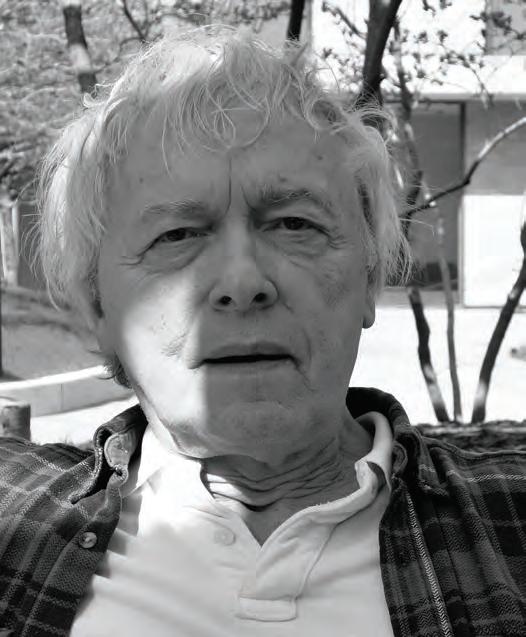

THE AT SIXTY
The Unlikely Rise of America’s Most Surprising Opera Company




The Unlikely Rise of America’s Most Surprising Opera Company

In memory of Wesley Balk, for whom life—and the lives he created on many stages—was both an adventurous journey and an expression of love
In appreciation for Lucy Rosenberry Jones, whose generosity and vision made capturing this history a dream come true
The MN Opera at Sixty © copyright 2025 by Michael Anthony. All rights reserved. No part of this book may be reproduced in any form whatsoever, by photography or xerography or by any other means, by broadcast or transmission, by translation into any kind of language, nor by recording electronically or otherwise, without permission in writing from the author, except by a reviewer, who may quote brief passages in critical articles or reviews.
ISBN 13: 978-1-63489-737-2
Library of Congress Number: 2024924333
Printed in Canada
First Printing: 2025
29 28 27 26 25 5 4 3 2 1
Design by Cindy Samargia Laun
Author photo by John Mihelic
Edited by Steve Woodward
Production editing by Victoria Petelin
Proofread by Elizabeth Farry and Abbie Phelps

Wise Ink PO Box 580195 Minneapolis, MN 55458-0195
Wise Ink is a creative publishing agency for game-changers. Wise Ink authors uplift, inspire, and inform, and their titles support building a better and more equitable world. For more information, visit WiseInk.com.
To order, visit ItascaBooks.com or MNOpera.org. Reseller discounts available.
CHAPTER 1
CHAPTER 2
CHAPTER 3
CHAPTER 4
CHAPTER 5
CHAPTER 6
CHAPTER 7
CHAPTER 8
Productions 4
Foreword 12
Prelude 14
A Tale of Two Cities 17
The Sixties 23
The Seventies 85
The Eighties 131
The Nineties 195
The Aughts 237
The Teens and Early Twenties 287
The Future 380
Acknowledgments 382
Index 384
Author Biography 392
2022—2023
Edward Tulane (Prestini)
Rinaldo (Handel)
The Daughter of the Regiment (Donizetti)
The Song Poet (Hagen)
Don Giovanni (Mozart)
2021—2022
Opera Afuera
The Anonymous Lover (Bologne)
Carmen (Bizet)
LEGEND
World Premiere/Commission
American Premiere
Tour Production/Education Production
Concert Version/Semi-Staged
New Music-Theater Ensemble Production
Opera in the Outfield
Albert Herring (Britten)
2019—2020
Elektra (Strauss)
The Barber of Seville (Rossini) Flight (Dove)
2018—2019
La rondine (Puccini)
Silent Night (Puts)
The Italian Straw Hat (Rota)
The Fix (Puckett)
La traviata (Verdi) NOOMA
The Gondoliers (Sullivan)
Brundibár (Krása)
2017—2018
Don Pasquale (Donizetti)
The Marriage of Figaro (Mozart)
Dead Man Walking (Heggie)
Rigoletto (Verdi)
Thaïs (Massenet)
Fellow Travelers (Spears)
Odyssey (Moore)
2016—2017
Romeo and Juliet (Gounod)
Das Rheingold (Wagner)
Diana’s Garden (Martín y Soler)
Dinner at Eight (Bolcom)
La bohème (Puccini)
The Nightengale (Raminsh)
2015—2016
Ariadne auf Naxos (Strauss)
The Magic Flute (Mozart)
Rusalka (Dvořák)
Tosca (Puccini)
The Shining (Moravec)
Memory Boy (Moya)
2014—2015
La faniculla del West (Puccini)
Hansel and Gretel (Humperdinck)
The Elixir of Love (Donizetti)
The Manchurian Candidate (Puts)
Carmen (Bizet)
2013—2014
Manon Lescaut (Puccini)
Arabella (Strauss)
Macbeth (Verdi)
The Dream of Valentino (Argento)
The Magic Flute (Mozart)
Griffelkin (Ross)
2012—2013
Nabucco (Verdi)
Anna Bolena (Donizetti)
Doubt (Cuomo)
Hamlet (Thomas)
Turandot (Puccini)
Noye’s Fludde (Britten)
Down in the Valley (Weill)
Shoes for the Santo Niño (Paulus)
2011—2012
Così fan tutte (Mozart)
Silent Night (Puts)
Werther (Massenet)
Lucia di Lammermoor (Donizetti)
Madame Butterfly (Puccini)
The Giver (Kander)
2010—2011
Orpheus and Eurydice (Gluck)
Cinderella (Rossini)
Mary Stuart (Donizetti)
La traviata (Verdi)
Wuthering Heights (Herrmann)
2009—2010
The Pearl Fishers (Bizet)
Casanova’s Homecoming (Argento)
Roberto Devereux (Donizetti)
La bohème (Puccini)
Salome (Strauss)
Tom Thumb (Werner-Henze)
2008—2009
Il trovatore (Verdi)
The Abduction from the Seraglio (Mozart) Faust (Gounod)
The Adventures of Pinocchio (Dove)
The Barber of Seville (Rossini)
Brundibár (Krása)
Iolanthe (Sullivan)
2007—2008
A Masked Ball (Verdi)
The Italian Girl in Algiers (Rossini)
Romeo and Juliet (Gounod)
The Fortunes of King Croesus (Keiser)
Rusalka (Dvořák)
The Nightengale (Stravinksky)
2006—2007
La donna del lago (Rossini)
The Tales of Hoffmann (Offenbach)
The Grapes of Wrath (Gordon)
Lakmé (Delibes)
The Marriage of Figaro (Mozart)
Ruddigore (Sullivan)
LEGEND
World Premiere/Commission
American Premiere
New Music-Theater Ensemble Production l l l l l
Tour Production/Education Production
Concert Version/Semi-Staged
2005—2006
Tosca (Puccini)
Don Giovanni (Mozart)
Orazi and Curiazi (Mercadante)
Joseph Merrick, the Elephant Man (Petitgirard)
Hansel and Gretel (Humperdinck)
2004—2005
Madame Butterfly (Puccini)
Maria Padilla (Donizetti)
Carmen (Bizet)
Nixon in China (Adams)
2003—2004
Rigoletto (Verdi)
Lucrezia Borgia (Donizetti)
Passion (Sondheim)
The Magic Flute (Mozart)
2002—2003
The Merry Widow (Lehár)
Norma (Bellini)
The Flying Dutchman (Wagner)
La traviata (Verdi)
The Handmaid’s Tale (Ruders)
2001—2002
Lucia di Lammermoor (Donizetti)
La clemenza di Tito (Mozart)
La bohème (Puccini)
Little Women (Adamo)
Don Carlos (Verdi)
2000—2001
Turandot (Puccini)
The Capulets and the Montagues (Bellini)
Street Scene (Weill)
The Barber of Seville (Rossini)
Pagliacci/Carmina burana (Leoncavallo/Orff)
The Barber of Seville (Rossini)
The Birds, the Beasts, and the Ball Game (Alcorn)
1999—2000
Der Rosenkavalier (Strauss)
Macbeth (Verdi)
Semiramide (Rossini)
The Marriage of Figaro (Mozart)
The Marriage of Figaro (Mozart)
The Cat That Walked By Himself (Alcorn)
1998—1999
Otello (Verdi)
Madame Butterfly (Puccini)
The Turn of the Screw (Britten)
Faust (Gounod)
Madame Butterfly (Puccini)
How the Camel Got His Hump (Alcorn)
1997—1998
Aida (Verdi)
Cinderella (Rossini)
Transatlantic (Antheil)
Tosca (Puccini)
Cinderella
1996—1997
La traviata (Verdi)
The Magic Flute (Mozart)
The Rake’s Progress (Stravinsky)
Carmen (Bizet)
Carmen (Bizet)
1995—1996
La bohème (Puccini)
Don Giovanni (Mozart)
Pelléas and Mélisande (Debussy)
The Tales of Hoffmann (Offenbach)
The Bohemians (Puccini)
1994—1995
Turandot (Puccini)
The Barber of Seville (Rossini)
Rigoletto (Verdi)
Bok Choy Variations (Chen & Simonson)
Figaro’s Revenge (Rossini, Paisiello)
1993—1994
Julius Caesar (Handel)
Diary of an African American (Peterson)
Il trovatore (Verdi)
The Merry Widow and The Hollywood Tycoon (Lehár)
Don Giovanni (Mozart)
1992—1993
The Flying Dutchman (Wagner)
Armida (Rossini)
Madame Butterfly (Puccini)
The Pirates of Penzance (Gilbert & Sullivan)
1991—1992
Tosca (Puccini)
The Pearl Fishers (Bizet)
The Marriage of Figaro (Mozart)
From the Towers of the Moon (Moran & La Chiusa)
The Magic Flute (Mozart)
Carousel (Rodgers & Hammerstein)
1990—1991
Norma (Bellini)
The Aspern Papers (Argento)
Carmen (Bizet)
Così fan tutte (Mozart)
Così fan tutte (Mozart)
Swing on a Star (Winkler)
1989—1990
La bohème (Puccini)
A Midsummer Night’s Dream (Britten)
Romeo et Juliette (Gounod)
Frankenstein, or the Modern Prometheus (Libby Larson)
My Fair Lady (Lerner & Loewe)
Snow Leopard (Harper & Nieboer)
Madame Butterfly (Puccini)
Where the Wild Things Are (Sendak & Knussen)
1988—1989
Don Giovanni (Mozart)
Salome (R. Strauss)
The Mikado (Gilbert & Sullivan)
The Juniper Tree (Glass & Moran)
Show Boat (Kern & Hammerstein)
Without Colors (Wellman & Shiflett)
Red Tide (Selig & Sherman)
Newest Little Opera in the World (Ensemble)
Cinderella (Rossini)
Tintypes (Kyte, Marvin, Pearle)
LEGEND
World Premiere/Commission
American Premiere
New Music-Theater Ensemble Production l
Tour Production/Education Production
Concert Version/Semi-Staged
Die Fledermaus (J. Strauss)
Rigoletto (Verdi)
Rusalka (Dvorak)
Cowboy Lips (Greene & Madsen)
Fly Away All (Hutchinson & Shank)
Book of Days (Monk)
Oklahoma! (Rodgers & Hammerstein)
Carmen (Bizet)
Jargonauts, Ahoy! ( McKeel)
1986—1987
The Pearl Fishers (Bizet)
The Postman Always Rings Twice (Paulus)
Ariadne auf Naxos (R. Strauss)
South Pacific (Rodgers & Hammerstein)
Hansel and Gretel (Humperdinck)
Jargonauts, Ahoy! (McKeel)
1985—1986
Where the Wild Things Are/Higglety Pigglety Pop! (Knussen & Sendak)
La traviata (Verdi)
The Elixir of Love (Donizetti)
The King and I (Rodgers & Hammerstein)
Opera Tomorrow
The Fantasticks (Schmidt)
The Magic Flute (Mozart)
The Music Shop (Wargo)
1984—1985
Animalen (Werle)
Casanova’s Homecoming (Argento)
The Magic Flute (Mozart)
La bohème (Puccini)
Meanwhile, Back at Cinderella’s (Arlan)
1983—1984
Hansel and Gretel (Humperdinck)
Madame Butterfly (Puccini)
La cenerentola (Rossini)
The Abduction of Figaro (PDQ Bach)
The Boor (Argento)
Chanticleer (Barab)
Don Pasquale (Donizetti)
1982—1983
Hansel and Gretel (Humperdinck)
Lucia di Lammermoor (Donizetti)
A Death in the Family (Mayer)
Kiss Me, Kate (Porter)
The Barber of Seville (Rossini)
The Frog Who Became a Prince (Barnes)
Zetabet (Barnes)
1981—1982
Hansel & Gretel (Humperdinck)
The Village Singer (Paulus)
Gianni Schicchi (Puccini)
The Barber of Seville (Rossini)
Feathertop (Barnes)
The Mask of Evil (Mollicone)
Hansel and Gretel (Humperdinck)
Rosina (Titus)
1980—1981
The Merry Widow (Lehar)
Black River (Susa)
Carmen (Bizet)
A Water Bird Talk (Argento)
Miss Havisham’s Wedding Night (Argento)
The Marriage of Figaro (Mozart)
The Threepenny Opera (Weill)
1979—1980
The Abduction from the Seraglio (Mozart)
The Pirates of Penzance (Gilbert & Sullivan)
La bohème (Puccini)
Rosina (Titus)
A Christmas Carol (Sandow)
1978—1979
The Love for Three Oranges (Prokofiev)
The Jealous Cellist (Stokes)
The Passion According to St. Matthew (J.S. Bach)
La traviata (Verdi)
The Consul (Menotti)
Viva la Mamma (Donizetti)
1977—1978
Christopher Columbus (Offenbach)
The Mother of Us All (Thomson)
The Marriage of Figaro (Mozart)
Claudia Legare (Ward)
The Voyage of Edgar Allan Poe (Argento)
1976—1977
The Bartered Bride (Smetana)
The Passion According to St. Matthew (J.S. Bach)
Candide (Bernstein)
Mahagonny (Weill)
1975—1976
Black River (Susa)
El Capitan (Sousa)
Così fan tutte (Mozart)
The Voyage of Edgar Allan Poe (Argento)
1974—1975
Gallimaufry (Minnesota Opera)
Gulliver (Blackwood, Kaplan, Lewin)
Eight Songs for a Mad King (Davies)
Music from the Court of George III
The Magic Flute (Mozart)
Albert Herring (Britten) Transformations (Susa)
1973—1974
El Capitan (Sousa) Transformations (Susa)
Don Giovanni (Mozart)
The Newest Opera in the World (Minnesota Opera)
1972—1973
The Threepenny Opera (Weill)
Postcard from Morocco (Argento)
The Barber of Seville (Rossini) Transformations (Susa)
Postcard from Morocco (Argento)
LEGEND
World Premiere/Commission
American Premiere
New Music-Theater Ensemble Production l l l l l
Tour Production/Education Production
Concert Version/Semi-Staged
AS CENTER OPERA COMPANY
1971—1972
Postcard from Morocco (Argento)
The Business of Good Government (Marshall)
The Rake’s Progress (Stravisnky)
Four Saints in Three Acts (Thomson)
The Good Soldier Schweik (Kurka)
The Marriage of Figaro (Mozart)
Postcard from Morocco (Argento)
Faust Counter Faust (Gessner)
1970—1971
Sir John in Love (Vaughan Williams)
Christmas Mummeries and Good Government (Marshall)
Faust Counter Faust (Gessner)
The Coronation of Poppea (Monteverdi)
The Mother of Us All (Thomson)
Faust Counter Faust (Gessner)
The Mother of Us All (Thomson)
1969—1970
Oedipus and the Sphinx (Marshall)
Punch and Judy (Birtwistle)
17 Days and 4 Minutes (Egk)
The Wanderer (Paul & Martha Boesing)
1968—1969
Così fan tutte (Mozart)
Horspfal (Stokes)
The Wise Woman and the King (Orff)
Bluebeard’s Castle (Bartok)
L’heure espanole (Ravel)
1967—1968
The Magic Flute (Mozart)
The Man in the Moon (Haydn)
A Midsummer Night’s Dream (Britten)
1966—1967
Opera Without Elephants
The Mother of Us All (Thomson)
To Hellas
-The Sorrows of Orpheus (Milhaud)
-The Harpies (Blitzstein)
-Socrates (Satrie)
Three Minute Operas (Milhaud/Hoppenot)
-The Rape of Europa
-The Abandonment of Ariadne
-The Liberation of Theseus
The Gondoliers (Sullivan)
1965—1966
The Abduction from the Seraglio (Mozart)
The Good Soldier Schweik (Kurka)
1964—1965
The Rape of Lucretia (Britten)
The Wise Woman and the King (Orff)
1963—1964
The Masque of Angels (Argento)
The Masque of Venus and Adonis (Blow)
Albert Herring (Britten)
On a cold night in January 1964—when Center Opera made its debut at the Guthrie Theater, premiering a witty new work by Dominick Argento paired with a Baroque one-act by the English composer John Blow—Harold Schonberg, chief music critic of the New York Times, was in the audience. “There are very few groups who engage contemporary opera with such flair, gusto, and imagination,” said Schonberg. Over the years he returned to Minneapolis several times to see the creation of this unlikely avant-garde offshoot of the Walker Art Center, a company whose unconventional productions were designed not by theater professionals but by young painters and sculptors hired for the boldness of their imagination.
Center Opera eventually became Minnesota Opera, which celebrated its sixtieth season with two new works— Edward Tulane and The Song Poet—bringing the company’s number of world premieres so far to fifty. In its inspiring and implausible history over the years since its formation, Minnesota Opera has charted an unusual path through the landscape of opera production. This is perhaps most notably marked by its championing of new works, but also by its training and
development of artists, its artistic philosophy rooted in bel canto (“beautiful singing”), and its commitment to equity, diversity, and inclusion. We’re proud to say that the company has not only survived but prospered, attracting an increasingly diverse and engaged audience and building on its legacy of presenting new and seldom-heard works that remains without parallel among opera companies in North America.
The tale of how Minnesota Opera became the company it is today is one worth telling. It’s a story that traces the growth of opera in the Upper Midwest, from the raggedy touring ensembles of the late nineteenth century to the formation of civic opera associations and the eventual rise of professionally managed local opera companies. It explores the impact of the annual weeklong visits to Northrop Auditorium by the Metropolitan Opera from the years 1945 to 1986 and articulates the opposing ways in which the performing arts developed in the cities of Minneapolis and St. Paul under their distinct ethnic and religious differences. It’s a story energized by large personalities, by conflicts and crises, and—of course— by unforgettable performances.
No one volume could capture every nuance of this epic journey, which includes countless performers, audience experiences, supporters, community and education initiatives, and points of view. However, this account by Michael Anthony, a close observer and longtime participant in the company’s history, is an illuminating account of the origin and growth of our company, offering never-before-published insights, information, and perspectives regarding Minnesota Opera’s leaders, performances, and evolution into one of America’s most forward-facing opera companies.
As we reflect on these untold stories from our past, we become aware that Minnesota Opera’s innovative, imperfect, and inspiring sixty-year history sets the bar for continued artistic exploration, growth, and expansion. It is now our challenge and our joy to imagine alternative visions of the future. Please join us in celebrating all that we’ve accomplished. We look forward to seeing you again at Minnesota Opera as we write the next chapter of our history together.
—Nadege Souvenir, MN Opera Board Chair
—Ryan Taylor, MN Opera President and General Director
As we reflect on these untold stories from our past, we become aware that Minnesota Opera’s innovative, imperfect, and inspiring sixty-year history sets the bar for continued artistic exploration, growth, and expansion.

One afternoon in 2002, I began my day at the Star Tribune in the usual manner: opening the mail and listening to phone messages, most of which required no immediate attention.
The sixth message was different.
“Hey, Mike, this is Wes Balk.”
The voice was frail, but I recognized it: H. Wesley Balk, a large figure in the opera and theater world, both locally and around the country. A stage director of singular wit and imagination, an author and teacher whose novel insights into the training of actor-singers influenced at least two generations of performers, Balk directed more than sixty productions for Minnesota Opera over the course of seventeen years, serving as resident director, co–artistic director, and finally as director of artistic planning. In later years, though he was suffering from Parkinson’s disease, he served as director of performer development for the New MusicTheater Ensemble, which became Nautilus Music-Theater.
“They tell me you mentioned me in a review,” he said. “You still remember me.”
Wesley, I wanted to say, no one ever forgets you.
He had enemies as well as friends, and he seemed to relish both. His iconoclasm wasn’t an act. He really did hate convention and tradition, especially in opera, where those qualities had ruled for so long. Reviews of his own work, especially from out-of-town critics, were usually raves. More conservative operagoers were often puzzled and irritated by his productions.
I knew Wesley first as a teacher. While I was doing graduate work at the University of Minnesota, where Wesley was a professor of theater arts from 1966 to 1993, I managed, though I wasn’t a theater major, to be admitted into his main course, Acting for the Lyric Stage. Students alleged this course was so hard to get into that no one was ever admitted. Not true, of course. The atmosphere that Wesley created in the classroom—a room with a tiny stage at one end—was like a party with everyone contributing, offering ideas, and trying things out. Everybody had a scene or a song they were working on and were eager to show the class. Wesley loved putting dissimilar things—and idioms—together. Mary Corrigan, who went on to become a speech teacher of international renown,
did a duet with me from the Off-Broadway musical You’re a Good Man, Charlie Brown, as if Noel Coward had written it. We were a hit.
Just a few years later, I was interacting with Wesley by reviewing his shows for the Star Tribune. What Wesley was referring to in the message was a comment I had made about him in a review of Minnesota Opera’s production of Lucia di Lammermoor that had just opened.
The audience on opening night had responded at the end with a standing ovation. While we know at this late date in our cultural evolution that just about everything gets a standing ovation, there was no doubt that the 2002 production, directed by James Robinson, was greeted more favorably than the Lucia Wesley directed during the 1982–83 season. Wesley’s was a high-concept production that turned the story into a therapy session wherein a young soprano is encouraged to sever her dangerous identification with the character of Lucia. The opening night audience booed Wesley when he walked onstage to take a bow with the cast.
I made light of this. Here was an audience of Lutherans— mostly—who had been instructed all their life to avoid drawing attention to themselves and certainly never to express disapproval in public, and they were booing lustily.
Considering the difference in audience reaction, I offered three explanations: (a) Wesley was ahead of his time, (b) the new production was simply better than the old one, and (c) opera audiences are nutty and impossible to figure out.
Going back to Wesley’s phone message, he said, “I’m in a nursing home. Can you get me a computer? I have so many ideas I want to write down.” I called some people at Minnesota Opera, explained the situation, and was told they could probably spare a computer. I called Wesley and left a message, saying a computer was on its way.
Wesley died six months later, on the morning of March 21, 2003. The cause was complications from Parkinson’s disease.
This book is dedicated to the memory of Wesley Balk, for whom life—and the lives he created on many stages—was both an adventurous journey and an expression of love.
—Michael Anthony

Fortune magazine went on an expedition to the Twin Cities in the early months of 1936 and took a long, hard look at the residents of these two towns. It’s possible that the writer— or writers—of the lengthy Fortune article were led astray by the citizens of St. Paul and Minneapolis, dozens of whom are quoted directly or indirectly, though much of what they wrote rings true.
Under the subheading “A Practical Guide to the Twin Cities,” the article provides advice on varied topics:
CLIMATE: Tough on strangers. Summers are burning hot, winters stinging cold. Last summer the temperature hit 104 degrees. Last winter it dropped to 33.5 degrees below zero. Psychologists have observed that such extremes make for emotional instability.
HOTELS (in order of quietude): The St. Paul has put in a cocktail room, but it is still stuffy. The Nicollet in Minneapolis is a typical Western hotel, better than the average. The bar is crowded and you may speak to unattended ladies. In the Radisson a few blocks away, they may speak to you.
AMUSEMENT: Minneapolis has three legitimate theaters in which, last winter, you could see anything from
Blossom Time to Tobacco Road. It has one grandiose cinema palace, the Minnesota, [and] many good cinema theaters. The excellent Minneapolis Symphony plays twice a week at the university. St. Paul has one legitimate theater, a few mediocre cinema houses. St. Paul uses its municipal auditorium for hockey, basketball, prize fights, opera, ice carnivals.
WHAT TO REMEMBER: The Twin Cities hate each other.
Concerning this last piece of advice, surely by the third decade of the twenty-first century the two cities—which were never Twins in any sense of the word—have more or less buried the hatchet. War’s over. There seems to have been, nonetheless, a certain amount of rivalry between the cities that continues. The rivalry at times was fierce, as when the 1890 US Census led to the two cities allegedly arresting and/ or kidnapping each other’s census takers to keep either city from outgrowing the other.
At other times the competition was genteel. Irma Wachtler, a prominent St. Paul arts administrator and enthusiast, once recalled, “Our father forbade us to have charge accounts at stores in Minneapolis, saying, ‘If you can’t find it in St. Paul, you don’t need it.’”
Sometimes it was simply a matter of who could put up a building faster. The St. Paul Grand Opera House, at Wabasha between Third and Fourth Streets, was dedicated on February 22, 1867. The Pence Opera House in Minneapolis was dedicated in June of the same year. After St. Paul completed its ornate cathedral in 1915, Minneapolis followed up with the Basilica of St. Mary in 1926. With opera the picture is more complicated. Which of the two is an opera town? For decades, the answer was St. Paul. John K. Sherman, veteran arts critic of the Minneapolis Star, said it in a review in the April 1967 issue of Musical America
Until four years ago, Minneapolis had never had much success in building up its own operatic ensembles; the town’s musical interest, money, and pride largely turned toward the sixty-year-old symphony orchestra. The spring visits of the Metropolitan Opera apparently slaked our opera thirst in one feverish week per year, usually drawing capacity crowds from the Twin Cities and the surrounding region. If Minneapolis wanted opera between times, they could drive across the river and attend the St. Paul Civic Opera, which offers operas and musicals.
Surely there is some demographic support for this. St. Paul, we’re told, was influenced by its early French, Irish, and German Catholic immigrant roots, while Minneapolis drew chiefly on its Scandinavian and Lutheran heritage. If, in the most general sense, St. Paul has been Catholic and Minneapolis Protestant, this ancestry links St. Paul to the Catholic countries of Europe—among them France and Italy— that have a long history of operatic expression, whereas in the Protestant countries of Northern Europe, opera has often been a hard sell. Concerning England, it’s common for historians to say that opera, meaning the homegrown variety, took time out for a couple of centuries, leaving a sizable gap between Henry Purcell and Benjamin Britten.
Protestants have often dismissed opera or at least shown that they can live without it. Theodore Thomas, the great German American conductor of the nineteenth century, said, famously, “A symphony orchestra shows the culture of a community, not opera.” (Perhaps he had relatives in Minneapolis.)
In Thomas’s view, orchestral music of the second half of the nineteenth century, especially German music, was not just good music. It was edifying. Listening to it makes you a better person. “The masterworks of instrumental music are the language of the soul,” he said. Opera was different. It was frivolous, and worse—it was decadent. And it certainly didn’t make anybody a better person. Opera houses were, at least metaphorically, on the dark side of town, where people flirted and made dates for after the show.
John Dizikes, in his excellent book Opera in America, recalls the Presbyterian pastor in Nashville who reminded his listeners that opera is “sinful, in league with hell and abetting Satan.” Bostonians thought opera to be a “showy hybrid,” a “breathless, exotic, passing excitement” while they took “the pleasures of the concert hall tranquilly, morally, and steadily.” Here’s John Sullivan Dwight, America’s first influential music critic: “Opera is inferior to pure instrumental music. Opera moves the feelings, not the mind.” And even worse, as time went on, opera became not just sinful but elitist.
We hear an echo of that censorious tone in the attitude of people connected to the young and feisty Center Opera toward that company’s competitor on the other side of the river, St. Paul Opera. “I never really knew anything about St. Paul Opera, and I’m sure I wouldn’t have been caught dead there,” said a former Center Opera board member, looking back on those early days. “It was that uptight crowd. They got all dressed up. They put on their pearls, and the women probably wore long gloves, whereas the Walker [Art Center] people were much more sophisticated. They were really smart. It was wild and wooly. It was really out there, and everybody loved it.”
To the Center Opera/Walker Art Center crowd, St. Paul Opera symbolized not just old-fashioned, empty-headed traditional opera and opera production but a way of life that the Center Opera audience with their graduate degrees and horn-rimmed glasses were trying to get away from. St. Paul Opera was Squaresville. It was “Ozzie and Harriet.” It was all about parties and dressing up and expensive dinners. In contrast, Center Opera people dressed down and, we would imagine, took dinner after the show so they could spend hours discussing it. To them opera was music theater, not
just singing. They didn’t even like the word “opera.” That was their poster: “Help stamp out opera!” Whatever it was they were doing, the critics loved it. Center Opera, wrote Bernard Jacobson in the Chicago Daily News, “has acquired a reputation as the most innovative, intellectually alive opera company in America.”
Opera in the old style—the St. Paul Opera style—could no longer be called sinful. (Sin itself was an unpopular subject by the 1970s.) But it could be brushed off as frivolous and wasteful, a pastime for the idle rich. That was the way Center Opera manager John Ludwig characterized the two companies— and their respective cities—in an article in Newsweek. St. Paul Opera was older and richer. Its annual budget was $750,000 compared to Center Opera’s measly $140,000. “They get more diamonds and furs,” said Ludwig. “We get the hip: beads and vinyl.”
To be sure, some of this was promotional rhetoric. St. Paul Opera, though it loved its candlelight dinners, was never as old-fashioned in its choices of repertoire as its detractors maintained. During its short life, 1969 to 1974, the company offered an occasional bold venture—George Antheil’s Venus in Africa , Carl Nielsen’s Maskarade , Carlyle Floyd’s Of Mice and Men —and in 1971 it gave the premiere of Lee Hoiby’s tender Summer and Smoke in a staging by Frank Corsaro, a work based on the play by Tennessee Williams with a libretto by a young Lanford Wilson, who would go on to become one of the nation’s major playwrights. (Williams showed up on opening night and pronounced the opera “beautiful.”)
It was odd, too, for St. Paul Opera to be thought of as the wealthy company. It was always underfunded, and just five years after its manager George Schaefer proclaimed “the New Era of the St. Paul Opera,” the company folded, owing $300,000 and canceling its 1975 season. (Orchestra members refused to play the last performance of the company’s final production, Wagner’s Siegfried, unless they were paid in advance—in cash.)
The following year, St. Paul Opera’s parent company, the St. Paul Civic Opera Association, paid off its offspring’s debt, which had risen to almost $600,000, and then went into a deep sleep, never to awaken. In an effort to expand its fundraising opportunities into the darker and wealthier regions
of St. Paul, Minnesota Opera, formerly Center Opera, invited a dozen or so board members of the now-defunct St. Paul Opera onto its own board. Certain people, chiefly residents of St. Paul, proclaimed this invitation a merger of the two companies—which was, of course, false. You can’t merge with a dead company, said Charles Fullmer, manager of Minnesota Opera. Whether the invitation actually brought in some extra funds from the eastern side of the Mississippi River has never been revealed.
The question remains: why were the two companies so different? St. Paul Opera and Center Opera were different, both onstage and backstage. If you liked one, you probably didn’t like the other. Karen Bachman, former board chair of Minnesota Opera and an experienced arts patron, traces the differences back to the founding of the two companies and to the founders themselves. “Center Opera and Minnesota Opera were founded and led by artists,” she said. “St. Paul Opera was founded, in my understanding, by volunteers. A lot of artistic organizations were founded by volunteers. The Metropolitan Opera was created by a group of wealthy people, Mrs. August Belmont, people like that, and then gradually they became more professional. Whereas with Minnesota Opera, it was, you know, Martin Freedman and Wesley Balk and Philip Brunelle and Kevin [Smith] and Dale [Johnson]. There was professional artistic direction, and I don’t think that was the case with the St. Paul Opera or Civic Opera.”
As it was, the entire episode—the death of St. Paul Opera, and the resulting “merger” that wasn’t—caused a resentment on both sides of the river that has never gone away. The complaint of the St. Paulites is that those board members who joined the Minnesota Opera board were treated as second-class citizens of the newly enlarged board. Their second beef: if this was really a merger, then Minnesota Opera should date its start in 1933 when the St. Paul Civic Opera put on its first show. Answer: there was no merger. Case closed. The complaint from Minnesota Opera regulars was that board members from St. Paul pushed Minnesota Opera toward more standard, “safer” repertoire and away from all that avant-garde stuff that many St. Paulites, at least those on the board, couldn’t tolerate. Answer: could be. But there were other reasons.
In 1980, a small company, Opera St. Paul, grew out of the ashes of St. Paul Opera but had little connection to the earlier organization, except that some of the same people were involved. In 1986, Opera St. Paul became North Star Opera, a small but lively company under the direction of the indefatigable Irma Wachtler that specialized in operettas. North Star Opera eventually became Skylark Opera.
Until 1964 when Center Opera began putting on shows at the Guthrie Theater, John K. Sherman had it right. If you wanted to see an opera in the Twin Cities, you had to go to St. Paul, to the St. Paul Auditorium or later to O’Shaughnessy Auditorium or the Crawford-Livingston Theater (eventually the History Theater)—that is, to one of the offerings of the St. Paul Civic Opera Association, which for more than four decades put on respectable productions featuring large casts of mostly local amateur performers. Some 3,000 people showed up for the company’s debut at the St. Paul Auditorium on December 8, 1933, a production of Samson and Delilah sung in English and featuring, according to the advertising, one hundred voices and forty dancers. Ticket prices ranged from 25 cents to $1.
The company was part of the “civic opera movement” that spread to many cities around the country. According to the articles of incorporation, the organization was formed “for the general promotion of civic and public interest in music, musical education, and culture, and the sponsoring and production of musical entertainments, operas and the like, thereby providing education and recreation for all classes.”
Performances continued at the St. Paul Auditorium, which was remodeled in 1936, just in time for the season-opener, Robin Hood, a popular comic opera by Reginald De Koven. Leo Kopp and Phil Fein, both from Chicago, were hired as the regular conductor and director. When attendance began to dwindle, the company reversed its policy of casting only local singers and began to hire stars—the first being soprano Rosa Tentoni to sing the lead in Madame Butterfly. And they also began to present light operas and musicals mixed in with the standard fare of grand opera.
After several financial crises, the City of St. Paul stepped in and agreed in the summer of 1955 to help support the company with an annual grant of $10,000. Glenn Jordan was named to the post of general director in 1961, the first year the company had a year-round, full-time executive.
When Jordan resigned in 1967, the board hired George Schaefer to replace him. Schaefer, who had been director of the St. Paul Arts and Science Center, charted a new course for the company. He dropped the musicals and returned the repertoire to opera and occasional contemporary works. He moved to professionalize the staff and to drop the word “civic” from the company’s title, as he thought the term connoted amateurism. And as conductor he replaced Leo Kopp with Ray Cutting, which forced the board to give Kopp $5,000 in severance. Schaefer’s first season, 1969–70, comprised six grand operas at the St. Paul Auditorium and four chamber operas at the Crawford-Livingston.
It worked for a while. Grants started coming in—$100,000 from the Gramma Fisher Foundation to do a new English version of the Danish opera Maskarade Summer and Smoke brought the company much-needed attention. But then, soon enough, it didn’t work, and it was all over. Schaefer resigned in January 1975. Most of the board members didn’t know the company was broke. No one had told them.
Meanwhile, across the river, in the opera sweepstakes, Minneapolis tried to catch up—and failed, mostly. The city had the Met, of course, performing at Northrop Auditorium for a week each year in May, and that went on until 1986. But as far as homegrown opera, the attempts were failures until Center Opera, under the aegis of Walker Art Center, began presenting avant-garde productions at the newly built Guthrie Theater.
The major player on the Minneapolis side of the river during these years was the Twin Cities Civic Opera Association, which made its debut with a program of excerpts from The Bohemian Girl at the Minneapolis Auditorium on October 4, 1933, just two months before its competitor, if we can call it that, the St. Paul Civic, made its debut with Samson and
Delilah at the St. Paul Auditorium. The company had been the dream, we’re told, of Mrs. Henry W. Jones, president of the Ladies' Thursday Musicale. The goal of the organization, according to its promotional material, was “to produce opera of real professional merit at popular prices. Only local directors, singers, and musicians will be employed. The company must be self-sustaining. The association is modeled after the European state theater and opera house.”
The similarity unfortunately didn’t include the heavy government subsidy the European opera houses were accustomed to, which made the Twin Cities Civic an especially ambitious undertaking and one that had to be well organized. Among the vice presidents of the board was Minnesota Chief Justice John P. Devaney. And despite its name, the organization was clearly a Minneapolis endeavor. No performances in St. Paul are documented. Offerings during the remainder of the first season were Faust, the standard pairing of Pagliacci and Cavalleria Rusticana, and Aida, all given at the Minneapolis Auditorium.
In 1935 the company began putting on shows at Lake Harriet, either at the bandshell or at some other facility nearby. The lineup for that summer offered a new show every week: Martha (July 9), H.M.S Pinafore (July 16), The Bohemian Girl (July 23), Lelewala or The Maid of Niagra (July 30), Blue Bandits (August 6). The season wrapped up with Rapunzel, A Fairy Extravaganza by Percy S. Williams, featuring “a colorful ensemble of one hundred artists and an orchestra of twentysix pieces.”
The company repeated some of these productions at Lake Harriet in the autumn of 1938, and then disappeared. There was apparently room for only one civic opera association at that time. Some forty years later, the same message appeared, as if written in the sky with diamonds: the Twin Cities couldn’t support two professional opera companies. One of them had to go, and that was St. Paul Opera. By 2021, this tale of two cities had shifted course more than once. St. Paul finally got an opera palace of its own in 1985, the Ordway, an edifice that promised to ease the city’s
lingering dismay and self-doubt over the failure of its own opera company a decade earlier. With the completion just a few years later, in 1990, of its Opera Center, Minnesota Opera now had feet planted firmly in both cities—a set of offices in Minneapolis and a production stage in St. Paul. And then in 2019 the company bought the Lab Theater (since renamed the Luminary Arts Center), a versatile space next door to the Opera Center. The Lab Theater would be a suitable environment for smaller, perhaps experimental productions aimed at an audience different from the company’s regular Ordway audience. In doing so, with productions going on in both cities, the question was no longer which one was the opera town. By now, they both were, and contrary to Fortune magazine, they no longer hated each other.

ON A COLD NIGHT in January 1964, Minneapolis, to quote the Chicago Tribune, finally got an opera company of its own. Center Opera, which would eventually become Minnesota Opera and would often be called America’s most innovative opera company, made its debut at the Tyrone Guthrie Theater, offering as a statement of artistic intention two one-act operas, one of them shiny and new, the other a littleknown gem from the seventeenth century.
Reviews the next day in both the Star and the Tribune, two separate and competing newspapers back then, were more than respectful; they were jubilant. “A consummate work of art” was the way the Tribune ’s Dan Sullivan described the new work, The Masque of Angels by the thirty-six-year-old Minneapolis composer Dominick Argento, who would go on to be widely acclaimed as the most important American opera composer of his generation. There was praise, too, for the work’s witty libretto devised by John Olon-Scrymgeour, who also directed the production. The story, which concerns a band of angels who contrive a romance between two young humans, nicely avoids being an operatic version of the ’40s movie Going My Way, as Sullivan pointed out. The companion
piece, The Masque of Venus and Adonis by the English composer John Blow, was lauded by the Star ’s Edwin L. Bolton for its “baroque charm and touching sentiment.” The success of the evening—a third performance was added to accommodate the demand for tickets—sparked an extra quotient of civic pride. How often does a city’s major daily paper publish an editorial commending the debut of an opera company and then go on to explain, probably for the first and last time, the differences between baroque opera and the later varieties?
The city was coming of age culturally. Minneapolis had been able to boast for quite some time about its major art museums, and the Minneapolis Symphony had been making important recordings since 1924. The city’s theater scene, on the other hand, was pallid, consisting chiefly of touring companies and amateur playhouses. But all that changed in May 1963, when the Guthrie Theater opened, and scores of correspondents and critics pounced on Minneapolis to report on what the Washington Post called “the year’s most exciting theatrical event.” It can’t be said that Minneapolis became an opera town the following January. The audience, first of all, was a fraction of the Guthrie’s audience. However, its reputation around the country as a center of operatic experiment and innovation was solidified by the third season, or even

earlier, with its production of Carl Orff’s The Wise Woman and the King, concerning which TIME magazine devoted a full page. That production also boosted the career of its director, H. Wesley Balk, who as co–artistic director would dominate the company and establish its performance style until the early ’80s.
Small as the company was in its first decades, its significance was undeniable. It offered local audiences an alternative to the tradition-bound, star-oriented Metropolitan Opera, which presented seven productions at Northrop Auditorium in the spring of each year, during “Met Week,” as it was called, and to the St. Paul Civic Opera Association, which became a professional company, St. Paul Opera, in 1968 and followed the same aesthetic principles as the Met. What Center Opera offered was almost the opposite: small-scale productions that emphasized dramatic values as much as musical, meticulously rehearsed and sung in English. Surely there was some overlap in audience, but each company attracted its own crowd. And as it happened, Center Opera—which became Minnesota Opera in 1971—eventually had the field all to itself. St. Paul Opera folded in 1975, and the Met stopped touring in 1986.


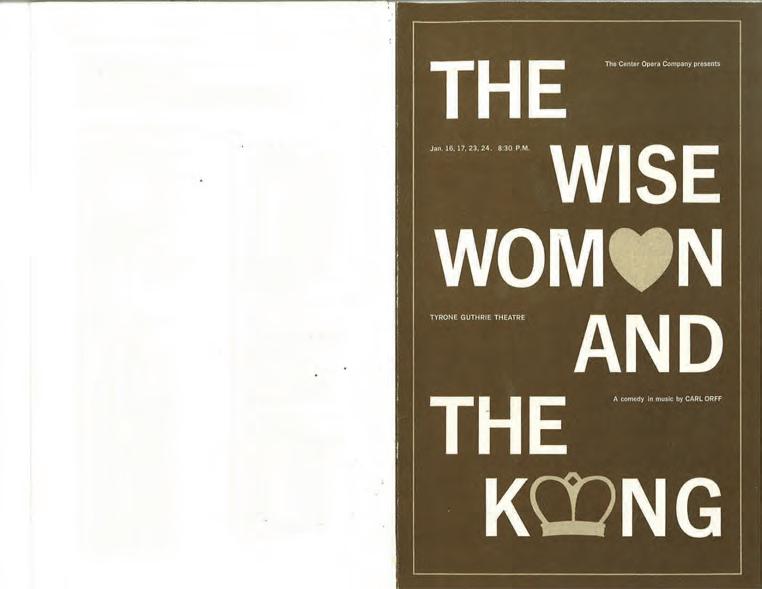


Center Opera, right at the start, was unique. It was the only opera company sponsored by an art museum, the Walker Art Center. It was the only company at that time performing chamber operas in English on a thrust stage. And while there was precedent for it—Picasso designed sets for the 1917 production of Erik Satie’s Parade —it was the only opera company at this time to engage painters and sculptors rather than theater artists to design its productions. Though the company abandoned that practice in 1969 when it separated itself from the Walker, it can be said that for five seasons Center Opera offered its audiences visual experiences of a most singular nature: bizarre, confounding, otherworldly, and at times strikingly beautiful.
More than two centuries ago, Samuel Johnson famously described opera as an “exotic and irrational entertainment.”
Dr. Johnson might have conceived that definition while observing Minnesota Opera’s unpredictable journey through the dark forest of modern opera production during the ensuing five decades. Years of high accomplishment followed periods of frustration and despair. The company at times seemed to lose its way, having somehow forgotten—or lost—its mission and the knowledge of how it’s possible to hold in balance artistic and financial success. The company almost folded in the early 1980s. Its devotion up to the present time to new work remains impressive—fifty world premieres. To be sure, not all of these were successes. A few of them were bombs of generous proportion. Others found favor and have entered the repertoire. In 2012 an opera titled Silent Night, which the company commissioned and premiered, received the Pulitzer Prize.
This is how it all began.

SOME SAY ONE OF THE NATION’S MOST innovative opera companies was born in Arnold and Helen Walker’s house in the Kenwood area of Minneapolis on a humid summer night in 1962. Walker, the sonorous voice for many years at KUOM radio and the host for almost as many at the Lake Harriet bandshell concerts—he led the children’s march at every concert—was also a singer, a baritone in the mold of Nelson Eddy. His wife, Helen Rice Walker, was an accomplished soprano who had given a well-received recital at Carnegie Hall and had played small parts in the original Broadway production of Wonderful Town starring Rosalind Russell.
Recalling the event some thirty years later, Walker said:
We were having a party of Center Arts Council people, and we were bemoaning the fact that there was such a limited outlet for local singers here. My wife and I were looking for opportunities to sing, as were other singers we knew. We didn’t have a good opera company available to us. Now when I look back on it, we sounded like Mickey Rooney shouting, “Let’s make an opera company.” Lo and behold, Norton Hintz was there, and he jumped up and said, “By God, we’re going to form an opera company.” The seeds of it, in other words, were planted that night. And the seeds kept growing because the fertile ground of the Center Arts Council was there.
The creation of an opera company was, in fact, a bee that had been buzzing around in Hintz’s bonnet for quite some time. A man of many parts—a nuclear physicist with a doctorate from Harvard, an accomplished photographer whose landscapes and urban scenes were in considerable demand, and a man who remained an avid and agile ballroom dancer well into his eighties—Hintz was born in Milwaukee and raised in Los Angeles. On leaving Harvard in 1951, he spent the next year on a postdoctoral fellowship at the Cavendish Laboratory in Cambridge, England, and the following year he accepted a position at the University of Minnesota, where he helped build the university’s proton accelerator and taught physics until his retirement in 1991.
Hintz had become interested in opera in 1959 during a year spent in Copenhagen on a fellowship. “There are two opera houses in Copenhagen,” he said, “and during the season both of them were doing shows six nights a week. It was like the way people here go to movies—or used to. So I saw a lot of opera, small and large, all sung in Danish. I came to like it a lot.”
On returning to Minneapolis in 1960, Hintz began talking to friends about forming a company to produce chamber operas—works requiring a small number of singers and instrumentalists. There was no sense, he thought, in trying to produce opera on the scale that the Metropolitan Opera
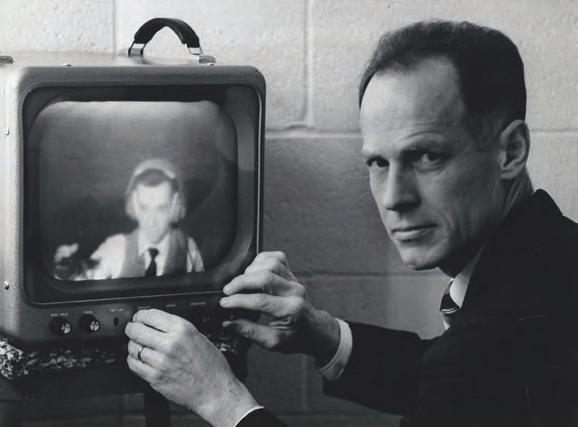

offered each spring at Northrop Auditorium nor even what the St. Paul Civic Opera had been presenting on a semiprofessional basis since the early 1930s. “We had no desire to compete with that, nor did we think we’d ever have the resources to do so,” he said.
Others began to share his enthusiasm for creating a small company, among them the conductor Tom Nee, the oboist Warren Cheston, and several faculty members from the music department at the University of Minnesota, among them George Houle, James Alifaris, and the composer Dominick Argento. Most were members of the Center Arts Council, a volunteer organization aimed at promoting cultural activities in the community that complemented Walker Art Center’s program of exhibitions and events.
Looking back many years later, Suzanne Weil said, “The Center Arts Council was one of the most amazing things that ever happened in Minneapolis—or anywhere. It was a volunteer organization, but you were a member only by invitation. Martin Friedman, who ran the Walker, gave it some money each year, but the council was very independent, though it was obviously in the spirit and aesthetic of the Walker Art Center.”
The council’s mission was to present events and sponsor activities—lectures, plays, and concerts of all types of music. Members worked on committees. There was a dance committee, a drama committee, other committees for folk music and jazz, another for architecture and design. Suzanne headed the jazz committee and later served as vice president of the council’s board.
Formed in 1952 by Walker director H. Harvard Arnason, the council’s two hundred or so members focused their efforts on the new and the unusual, though they didn’t shy away from traditional works such as a staging of Under Milkwood by council member Connie Goldman that was presented in the Walker gallery. The director was Michael Lessac, a young theater artist who later produced an album of songs titled Sleep Faster, We Need the Pillow.
More often, Goldman took a walk on the wild side. When the council invited Allan Kaprow to come to Minneapolis to stage one or more of his controversial Happenings, Connie was his assistant. A distinctly freewheeling ’60s phenomenon, Happenings were serious and yet whimsical theatrical events composed of a seemingly illogical collection of elements in which performers interacted with audience members in what was often a nontheatrical environment.
“I was totally enchanted with this crazy project,” Goldman recalled in an interview in 1995. She continued:
I loved experiments and breaking up theatrical forms. I did a lot of driving around looking for strange things. Allan wanted huge numbers of boxes that would fall down right in front of people and scare them half to death. One time we had the audience walk around in the mushroom caves by the river in St. Paul. The audience reaction was mixed. Some had a wonderful time and thought it was wild and adventurous and crazy and fun and, thank goodness, here was something different to do on a Saturday night. Others were deeply offended. “This is art?” I remember people stomping out and saying terrible things about Martin [Friedman]. They blamed him.
As a member of the council’s drama committee, Goldman hosted a symposium titled “How to Make Theater Seats More Uncomfortable,” which put forth the idea that theater ought to agitate and provoke. One year, she brought playwrights from around the country to the Walker, asking them to do whatever they wanted to do. Some read their plays to an audience.
One of them was actor and playwright Sam Shepherd, then unknown. “Somebody had said to me, ‘This guy’s hot. He’s really innovative,’ Goldman recalled. “He must have thought we were a bunch of dilettantes because he walked onstage, opened a box, and pulled out a bunch of balloons. He blew them up and let them go, and they flew up to the ceiling. That was his play. I got a lot of flak on that one. I thought Martin [Friedman] was going to kill me. But we all felt that we had a mission to nurture new artists and that that was what the Center Arts Council was set up to do.”
Norton Hintz, who was invited to join the council in 1955, saw the council as “a mix of fun things involving intelligent people interested in the arts and putting on programs and that allowed you to espouse some of your favorite ideas.” Hintz ended up being chairman of the music committee. The committee brought in people such as Arnold Dolmetsch, the early-music expert, and at one point put on an evening of songs by Hindemith with the soprano Helen Rice with Richard Zgodava at the piano.
Center Opera was CAC’s biggest and most expensive project—a little more than $40,000 for its first season. The company gave its first performances at the then-new Guthrie Theater in January 1964, and five seasons later it separated from the Walker and went off on its own, eventually changing its name to Minnesota Opera.
There had, in fact, been earlier efforts at opera production by the CAC. In November 1955, the council presented, for two nights, a double bill of chamber operas: a comedy from the eighteenth century by Giovanni Battista Pergolesi, The Maid as Mistress (La serva padrona) and a brief work from the twentieth century by Paul Hindemith, There and Back (Hin und Zuruck). The large staircase at the front end of the Walker lobby served as a stage. The audience sat on the stairs and in the balconies. James Alifaris conducted and George Amberg staged the two works. Alifaris and Amberg resumed their collaboration three years later in another double bill that included Menotti’s The Unicorn, the Gorgon, and the Manticore, a madrigal fable, as the composer described it, scored for chorus and an orchestra of nine players.
The choice of repertoire in these offerings was relatively bold. Clearly, the CAC wasn’t aiming at a mass audience. What this repertoire suggests instead is the sensibility manifest in Center Opera, just a few years in the future, an uncompromising stance that said: we think these works—and the way we interpret them—are clever and smart, we hope you like them, and if you don’t, come back again—or don’t. This essentially aristocratic point of view would successfully guide the company during its first decade.
By the start of the 1970s the CAC was fading. “The CAC was unique in its time,” said Connie Goldman. “I’m not aware of any situation like that, where a visual arts museum develops an elaborate performing arts program. [. . .] I think what we did made a difference to people.”

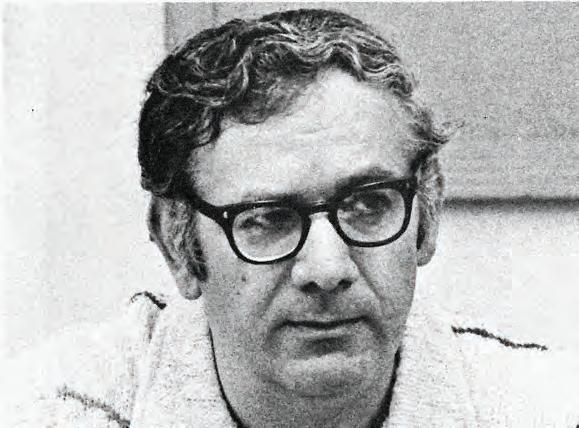
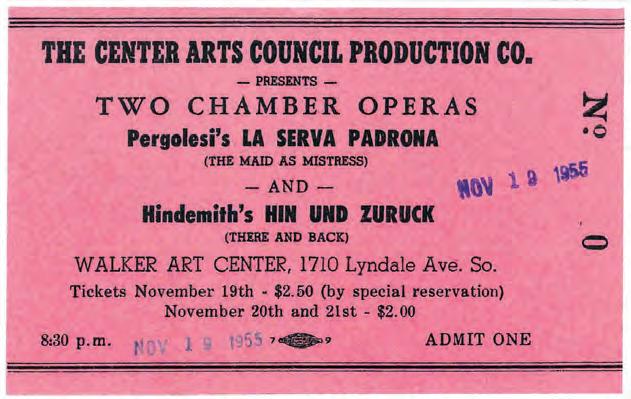
IT SHOULD BE NOTED that there are other versions of this creation story. Argento’s version starts early that same year at a concert given by the Civic Orchestra of Minneapolis that he and his librettist, John Olon-Scrymgeour, attended. Recalling the story in 2018, just nine months before he died at the age of ninety-one, Argento said that after the concert the two of them went backstage, where he introduced OlonScrymgeour to Nee, after which the three of them repaired to a nearby boîte for a restorative beverage or two.
“Benjamin Britten was the big thing in those days,” Argento recalled. “We all said, ‘We’ve got to do Albert Herring here.’ I had been looking at the score. ‘It’s such a great opera,’ I said, ‘but how can we do it?’ Tom said, ‘You get a sponsor like, say, the Walker. They might let us do it.’ I said, ‘You know anybody connected to the Walker?’ Tom said, ‘Norton Hintz is interested in doing something musical. I’ve talked to him about Kafka.’ So we sounded out Norton, and Norton joined our group. He said he would present the idea to the Walker Art Center board. So he did.”
In yet another version of the story—Martin Friedman’s— Hintz first sought the approval not of the Walker Art Center board but of the Center Arts Council, of which he was a prominent member and chairman of the council’s music committee. Hintz’s pitch to the council was that it sponsor a twoproduction season at the Guthrie Theater, which was scheduled to open in May of 1963. The council said yes, after which, in the fall of 1962, a delegation from the council—among them Nee, Argento, and Hintz—paid a call on Friedman, the
museum’s director, to seek the Walker’s blessing—and sponsorship—of at least an initial season of opera productions and perhaps more after that.
The Walker, it turned out, was not a complete stranger to opera performance. Under the aegis of the Arts Council the museum had presented two one-act operas in 1955— Pergolesi’s La serva padrona and Hindemith’s Hin und Zuruck staging them in the Walker lobby for two nights. Three years later the council offered, in the same modest circumstances, with colored slides projected onto the walls of the lobby, Menotti’s The Unicorn, the Gorgon, and the Manticore, which the composer described as a madrigal ballet. These were modest, low-budget productions that cried out for a theater. In just a few years there would be one next door.
DURING HIS TWENTY-NINE YEARS as director of the Walker Art Center, Martin Friedman, a Pittsburgh native who died in 2016 at the age of ninety, pulled more than a few rabbits out of his hat. Remembered for his sharp wit and compulsive attention to detail, Friedman exhibited Picasso’s private art collection before it debuted in New York, and he developed an eye-catching new public space across the street from the museum, the Minneapolis Sculpture Garden. Over the years he presented the best in contemporary art, gradually transforming the Walker from a regional museum into an internationally respected center of innovation. And in 1963 he did something slightly crazy, something museums don’t normally do: he formed an opera company. And it wasn’t your average
opera company. Its aim, to quote a slogan from later years, was to present “opera without elephants.” The programming would consist of chamber operas featuring small casts— chiefly local singers—backed by a small orchestra, and the focus was to be on new and unusual repertoire.
When the delegation from the Center Arts Council presented its case, Martin was dubious but intrigued by the idea of a museum helping to bring another artistic entity into existence. And there was an added—and rather enticing—factor that everyone present was aware of. The Walker would have use of the Guthrie Theater for up to a third of each year because the T. B. Walker Foundation, the museum’s main benefactor, had contributed $400,000 to the theater’s construction fund. The Guthrie’s acting company would use the theater the rest of the year for its own productions. According to the terms of the foundation’s gift, the theater would belong to the museum because it, too, would be on land owned by the foundation. Though he had little desire to involve himself in a bigger, more expensive performing-arts program than the one the museum already had, Martin had to admit that the Guthrie would be a promising venue for these chamber operas, which could be anything from Mozart to Benjamin Britten and perhaps new works as well. Opera at the Guthrie made sense. The theater’s seating capacity of 1,400 and its thrust stage would likely turn opera-going into an intimate experience. The downside was that the theater wouldn’t have an orchestra pit, which for opera is like a car without wheels or, at the very least, a car without shock absorbers. Either way, it was going to be a bumpy and perhaps exhilarating ride.
Warming to the idea, Martin said the Walker would participate if two conditions were met. One was that the museum would oversee the opera company’s finances and would work with the Center Arts Council on the company’s budget and on obtaining both public and private support. The other was that the Walker reserved the right to select painters and sculptors to design the sets and costumes in consultation with the new company’s managing and artistic directors, yet to be named. The involvement of visual artists, Martin thought, would go a long way toward explaining to the public why a museum of contemporary art would get involved in something so foreign to its mission, and surely the artists themselves would benefit from the collaboration. He brought those justifications up a couple of weeks later when he presented the Center Opera proposal to the Walker board. The board backed the idea with the stipulation that the project not interfere with the museum’s other programs. Martin said he swallowed hard and agreed.

“They suggested that the Walker use some of its time in the Guthrie to present chamber opera. And what exactly might that be, I asked warily?”
—Martin Friedman, Director, Walker Art Center
HAVING RECEIVED A GREEN LIGHT, the first step was to assemble a team capable of, first, putting an opera company together, and second, of putting on an actual opera production from time to time, something that audiences might enjoy. They had fourteen months to do it, and none of them had ever done anything like this before. The team was quickly agreed upon. Hintz would be company manager; Argento the artistic advisor (though he was listed as “artistic director” in an early news release); Yale Marshall, a local singer and composer, would be executive producer; and Tom Nee the music director. Nee, an associate professor of music at Macalester College who grew up in Albert Lea, Minnesota, and later studied conducting in Zurich and at Black Mountain College in North Carolina, was an obvious choice for the position. A champion of new music and a conductor much respected by local musicians, Nee, among his colleagues at the new opera company, was the chief proponent of Center Opera’s commissioning of new works. It was a loss to both the company and the city when, after four seasons of exceptional work with the company, Nee said goodbye to Minnesota winters and accepted a position on the faculty of the University of California, San Diego. He died in 2008 at the age of eighty-seven.
At the time of the agreement the only work under discussion was Britten’s comic opera Albert Herring, which would be staged in March of 1964. John Olon, also known, depending on his mood, as John Olon-Scrymgeour, would direct. The official sponsor would be the Center Arts Council, though it was clear that the Walker would pay the bills—minus whatever the Arts Council could raise on its own.
“We had a small amount of money to put it all together,” Argento said. “The truth is we were too ignorant to know we had to pay a hefty royalty to do an opera like Albert Herring We talked about financing the whole thing, and it got to be difficult, but we were committed to doing it. If they were going to let us do an opera at the Guthrie, it was too great an opportunity to pass up.”
The initial plan was that the company would make its debut in January of 1964 with Albert Herring. Then came a cautionary thought: perhaps a new, untested company shouldn’t start out with so complicated and delicate a work as Britten’s comic masterpiece. Perhaps that should be tackled in March. The premiere of the company could be something simpler that needed a chorus, since there are so many good choruses in this city. So what would that be?
Argento recalled:
I don’t remember who suggested it—maybe it was Tom or Norton—why don’t I write an opera for the occasion? I talked to John [Olon-Scrymgeour]. He said we could probably do a chamber opera. I said, "I know one that would be perfect for this. It’s by John Blow, The Masque of Venus and Adonis."
John said, "Well, for your work, I have this idea about angels." I wrote most of the music that summer at a cottage my wife and I rented in northern Minnesota. The John Blow opera didn’t cost any money to produce. There were no royalties, and I think they gave me $500 to compose the piece. So it was a double-bill, and John would direct.
Said Hintz:
One of the earliest bits of advice Martin gave us was to form a ladies’ auxiliary. Of course, nowadays, it wouldn’t be called that. But we needed an association, an opera guild. And he said, "I’ve got just the person for you. She has tons of energy that’s not being used, namely, Alice Smith, wife of Justin Smith." We approached her and she said, "Sure, great idea." She was a dynamo. She had been a prime mover in organizing what was originally called the Chamber Opera Guild. And they immediately started raising money, which was what we had in mind.
Guild membership was secured by buying a season ticket and contributing $7 or more. Ticket prices were low. Single tickets were available at $2, $3.50, and $4.50. Season tickets were $3, $5, and $7. The biggest funding success was announced just a few days before the debut season opened: a grant of $14,250 from the Rockefeller Foundation. The grant specified the formation of a chamber-opera company that would feature local singers in performances at the Guthrie Theater. The productions were to be guided by a guest director, two acting and singing coaches, and a choreographer, all from New York. As director, John Olon-Scrymgeour fit the bill. He was from New York. The acting coach turned out to be Mark Gordon, who died in 2010 at the age of eighty-four after a long, eventful career as an actor in television, film, and the stage. In 1973 Gordon made television history by portraying Chuckles the Clown in a famous episode of The Mary Tyler
Moore Show, which is set in Minneapolis.
The search for a cast began in the fall of 1963 when a call went out for singers in the Twin Cities interested in helping form an opera company. Several dozen singers showed up in the green room of the Guthrie. One of them was Vern Sutton, a tenor who would soon become the company’s most prominent and admired performer, appearing in nearly four dozen productions until 1985 when the company stopped hiring him. A year earlier, Sutton had sung a role in Argento’s Christopher Sly at the University of Minnesota, where he was

pursuing a doctorate in musicology. By then acquainted with Sutton’s characteristic light, flexible voice, Argento wrote a part for him in Masque of Angels.
“Dominick encouraged me, and the company sounded like a great idea,” Sutton said in 2018. “We were told there was no guarantee we would be paid, but they were going to charge admission, and if they made any money after paying expenses, they were going to divide it up among the singers, so we agreed to do it. And after we opened, they did divvy up the money. It wasn’t a lot, but it was fun.”
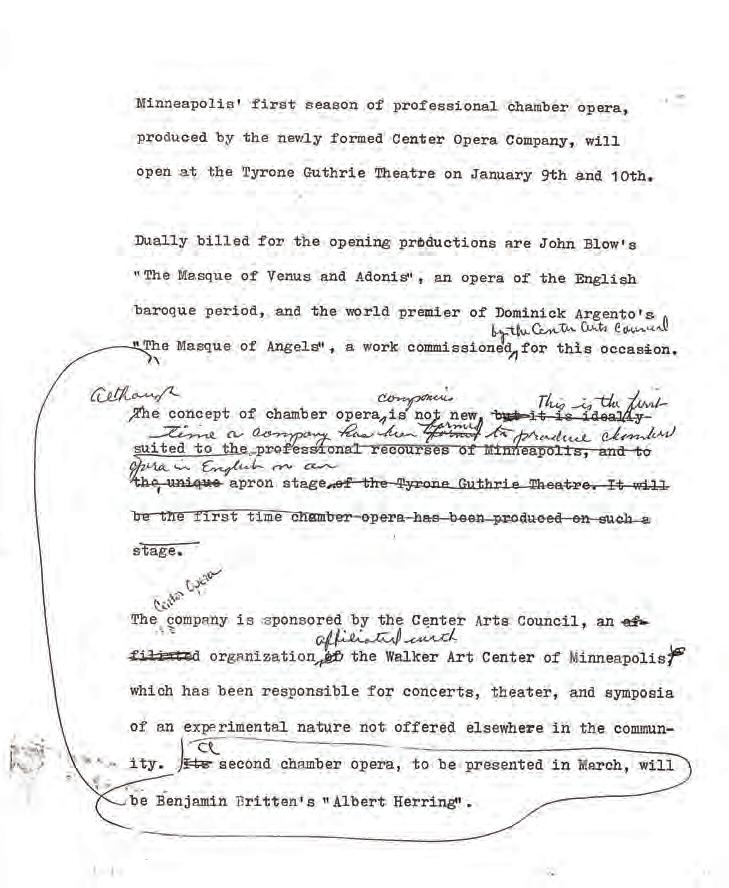
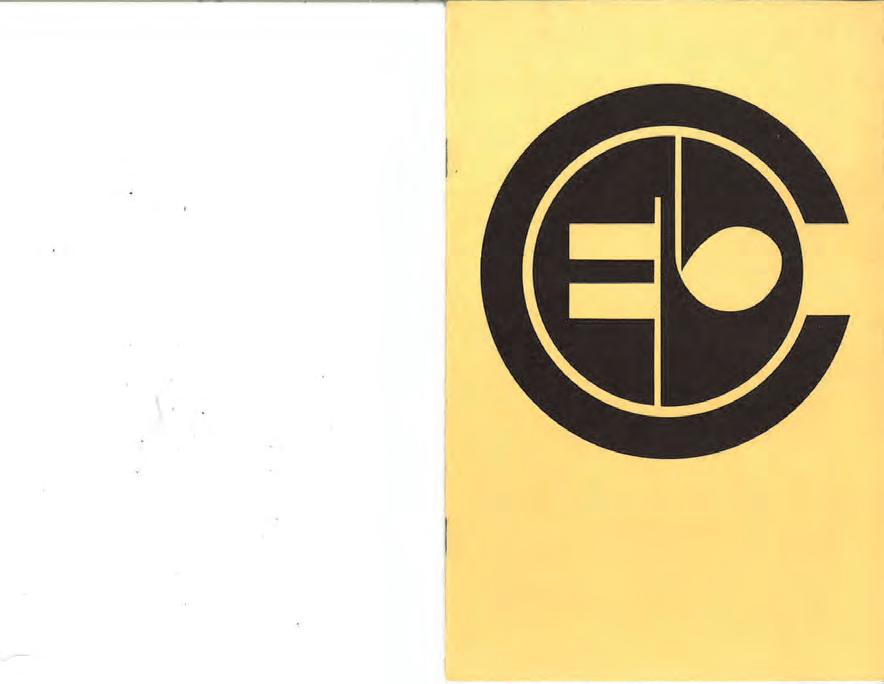


A good tenor is always in demand. In the case of Vern Sutton, the demand was so intense that a radical solution had to be devised. In the fall of 1969 Sutton was double-booked in Minneapolis and St. Paul on a Saturday night, and there was no way the trip could be made by car. So, as any sensible opera company would have done, the St. Paul Opera rented a helicopter, and within twenty minutes Sutton was standing in a dressing room at the St. Paul Auditorium putting on his costume.
Growing up in Oklahoma City, Oklahoma, Sutton came to Minneapolis in 1960 to do graduate study in voice at the University of Minnesota, and over the decades he successfully balanced two full-time careers, one as a performer and another as an educator, while earning acclaim as a director, staging more than 115 productions for the University Opera Theater, and becoming a widely recognized expert in the creation of concert staging or “semi-staging” of musical theater works. His lead roles as a member of the Stagecoach Players in Shakopee, Minnesota, especially his extravagant, almost Baroque-style villains—giving some 1,200 performances during the ’60s—remain the stuff of theatrical legend.
Sutton was a rather exotic bird, one not often sighted during the ’60s though perhaps not so uncommon today: a singer who can act. Sutton’s twenty-plus years with Minnesota Opera, first as a lead performer and then as a member of the company’s ensemble, sit on the top shelf of this busy man’s accomplishments. Sutton sang in the company’s first production in 1964, the premiere of The Masque of Angels by Dominick Argento, and twenty-one years later he performed his farewell, a role in Casanova’s Homecoming, the premiere of another work by Argento. And then, in a command performance, he returned in the spring of 2013 to sing the brief but challenging role of the Emperor in a production of Turandot, the occasion being two birthdays, the company’s fiftieth and Sutton’s own seventy-fifth.
Between these years Sutton produced a gallery of indelible characterizations: the innocent and oblivious Schweik in Robert Kurka’s antiwar opera The Good Soldier Schweik (1966, ’71), the menacing and murderous Punch in Harrison Birtwistle’s Punch and Judy (1969), the paranoid and terrified Mr. Owen in Argento’s Postcard from Morocco (1971, ’72), the demented King George III in Peter Maxwell Davies’ Eight Songs for a Mad King (1974), and, as an example of Sutton’s skill playing comedy, his portrayal of the wily Don Medigua in John Phillip Sousa’s El Capitan. Mezzo-soprano Janis Hardy, who joined the company in 1970 and over the years was Sutton’s most frequent singing partner, recalled seeing Sutton in Eight Songs at the Walker Art Center auditorium. “It was the most spellbinding performance I’ve ever seen,” she said. “He finished it by walking up the steps of the auditorium and out the door, giving out this haunting semi-scream. No one in the audience moved for a long time afterwards.”
John Ludwig, who was general manager of Center Opera during its first decade, recalled seeing his first Center Opera production in 1964: Albert Herring. “The first person I saw in rehearsal was Vern Sutton,” Ludwig said. “The quality of his acting and musicianship was fantastic.”
This is high praise for a singer who claims he never had an acting lesson. Sutton’s musical training came early, however. As is the case with most professional singers, he started out as a boy soprano. By the time he got to Minnesota, having graduated magna cum laude from Austin College in Sherman, Texas, his experience in musical theater had been chiefly in musical comedy, though he does recall a youthful portrayal of a dancing bear in The Bartered Bride.
Nonetheless, it wasn’t until 1963 that Sutton sang in an actual opera production in the Twin Cities, Christopher Sly, an opera by Dominick Argento based on Shakespeare’s The Taming of the Shrew. The production initiated a long and fruitful composer-singer relationship. Argento ended up writing a part for Sutton in his next opera, his fifth, The Masque of Angels, and he continued creating roles large and small for Sutton in operas (Postcard from Morocco, Waterbird Talk, The Voyage of Edgar Allan Poe, Casanova’s Homecoming) and concert works (Jonah and the Whale, The Revelation of Saint John the Divine, Letters from Composers).
Once Center Opera got underway, the renown of both the company and its singers spread quickly. Sutton was surprised to find that conductors, performers, and vocal coaches in Europe knew who he was, as early as the late ’60s, when he studied voice in Italy. “I mentioned my name,” he recalled, “and they said, ‘Oh, yes, you’re the tenor with the Center Opera company.’ They had read in the national and international publications my name associated with the company. We were better known in Europe than in the Twin Cities.”
Sutton named two roles as his favorites: Albert Herring and Mr. Owen in Postcard from Morocco. “And I loved Schweik too,” he said. “And, you know, to have composers write things specifically for me, I really liked that, though I’ve been cursed by other tenors because they have to do what was written for me—what was in the score—and they can’t all do what I do, especially in the case of Mr. Owen.”
By 1985, the year the company moved into the Ordway Center, Minnesota Opera was planning its twenty-second season and looking toward the future, which meant, in the view of some people close to the company, shutting the door on the past. Most of the performers associated with the company’s first two decades—the Balk-Brunelle era—were no longer being cast in the productions. Conspicuously absent were Sutton and Janis Hardy. Sutton, at any rate, continued performing in various venues and capacities throughout the ’90s and beyond. Sutton’s performing schedule is less frantic today than in earlier times. (No helicopter rides are scheduled.) Now in his early eighties—he has been a widower since 1998—he spends his winters in a condominium in Palm Springs.
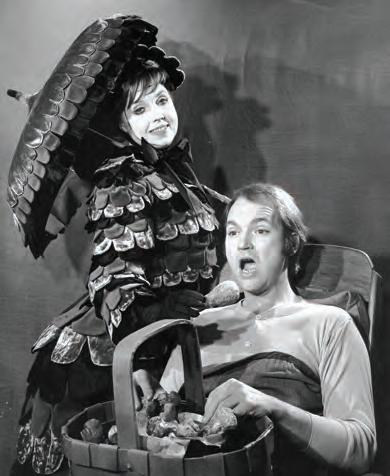
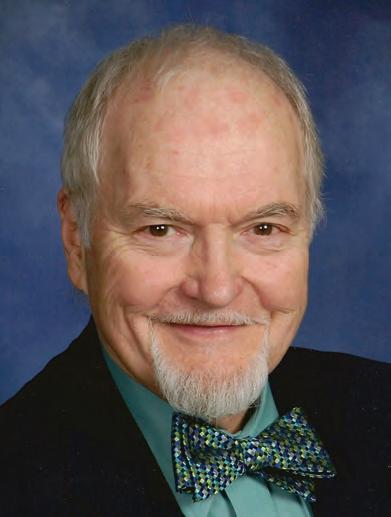

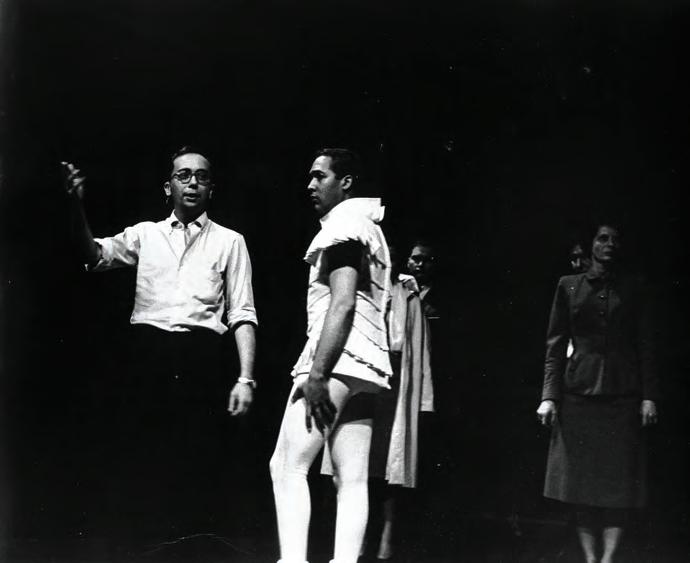
A COMPANY OF THIRTY-EIGHT SINGERS was formed. Frederick Hilary, a veteran choral conductor, was appointed chorus master, and Hilary’s own ensemble, the Minneapolis Madrigal Singers, was enlisted to sing the choral parts in both operas. Apart from Sutton, two of the singers performed in numerous later productions: tenor Yale Marshall and bass LeRoy Lehr, who eventually spent nineteen years singing solo roles at the Metropolitan Opera until his retirement in 2010. Peter Wexler, a twenty-seven-year-old designer who had earned acclaim in New York, was engaged to design the sets, costumes, and lighting. Argento’s wife, the soprano Carolyn Bailey, would sing the role of Venus and would be much praised for her interpretation of the poignant aria that concludes the work. The dancers in both operas were to be the members of the First Chamber Dance Quartet, alumni of the New York City Ballet.
Rehearsals began in early December, and most were held on the Guthrie stage. “That’s how we got to meet the Guthrie people,” said Sutton. “They came in to start their own rehearsals as we were finishing our season. I’ll never forget when I met Tyrone Guthrie in the green room. He had been observing some of our rehearsals for Albert Herring. I came in and he said, ‘Oh, you’re Mr. Sutton, aren’t you? Hello, I’m
Tony Guthrie. I must tell you how much I admire your work.’ He actually became a fan of mine.”
Opening night—January 9, 1964—was, for the most part, a rousing success. Onstage everything proceeded smoothly, both the singing and the dancing. Backstage, however, was pandemonium. For the designer, Peter Wexler, the set, being minimal and easy to assemble, was not a challenge. The costumes were another matter. There were eighty of them. They were nearly ready, but as opening night drew near, many of the costumes still needed sewing and ironing. A desperate call for help went out to members of the Arts Council and assorted friends. The legend, it turns out, is true: on opening night, costumes for act two were being sewn while act one was being performed on stage. Martin Friedman and his wife Mildred were members of the ad-hoc sewing committee, as was the city’s First Lady, Frances Naftalin, wife of Minneapolis Mayor Arthur Naftalin. A mad scramble during intermission got everyone into the right costume.
The small orchestra, positioned backstage, played well. Tom Nee conducted wearing earphones that were attached to microphones that picked up the singers’ voices. The situation was awkward. Singers and orchestra weren’t always in sync.
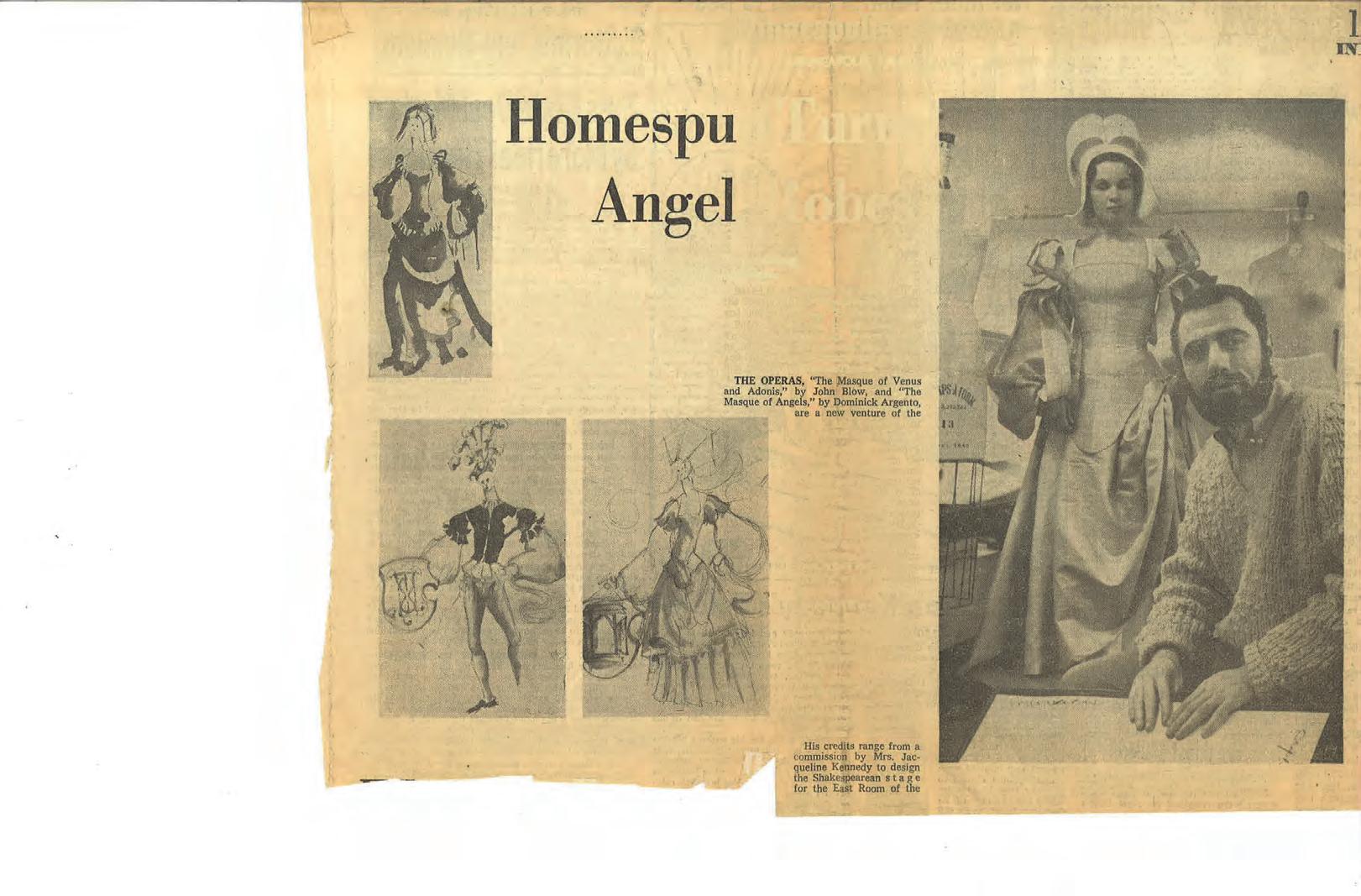

Nee always worked well with musicians. “Tom was a wonderfully supportive conductor,” said Cynthia Stokes, who played principal flute in the company’s orchestra off and on for several decades, including on opening night. “I think people really enjoyed playing for him. He was careful to give us notes at the start of each rehearsal. He knew how to get the most out of people.”
Buoyed up by enthusiastic audiences and favorable reviews, the little company soon began preparing for the second production, Britten’s Albert Herring. Great new comic operas were underrepresented in the twentieth century, perhaps because it was such a grim time. Albert Herring ranks high on anyone’s list, and by all accounts, Center Opera’s production, which closed the company’s first season (and


was revived in 1975) was close to perfect. There were several reasons for this high praise, but Vern Sutton’s impeccable performance in the title role was probably at the top of the list. That performance was, as Edwin L. Bolton put it in his review in the Star, “a show-stopper” in “a beguiling production, smart and well-paced.” Albert is a virtuous young grocery clerk who, despite his protests, is declared May King
when no suitably virginal Queen can be found in the village. Albert was the twenty-six-year-old Sutton’s first big showcase in the Twin Cities, and it led to further engagements. Shortly after the Center Opera production closed, Sutton was invited to repeat the role of Albert that spring at the Peabody Conservatory in Baltimore, Maryland, and at the Long Island Summer Festival at Hofstra University. Another plus was
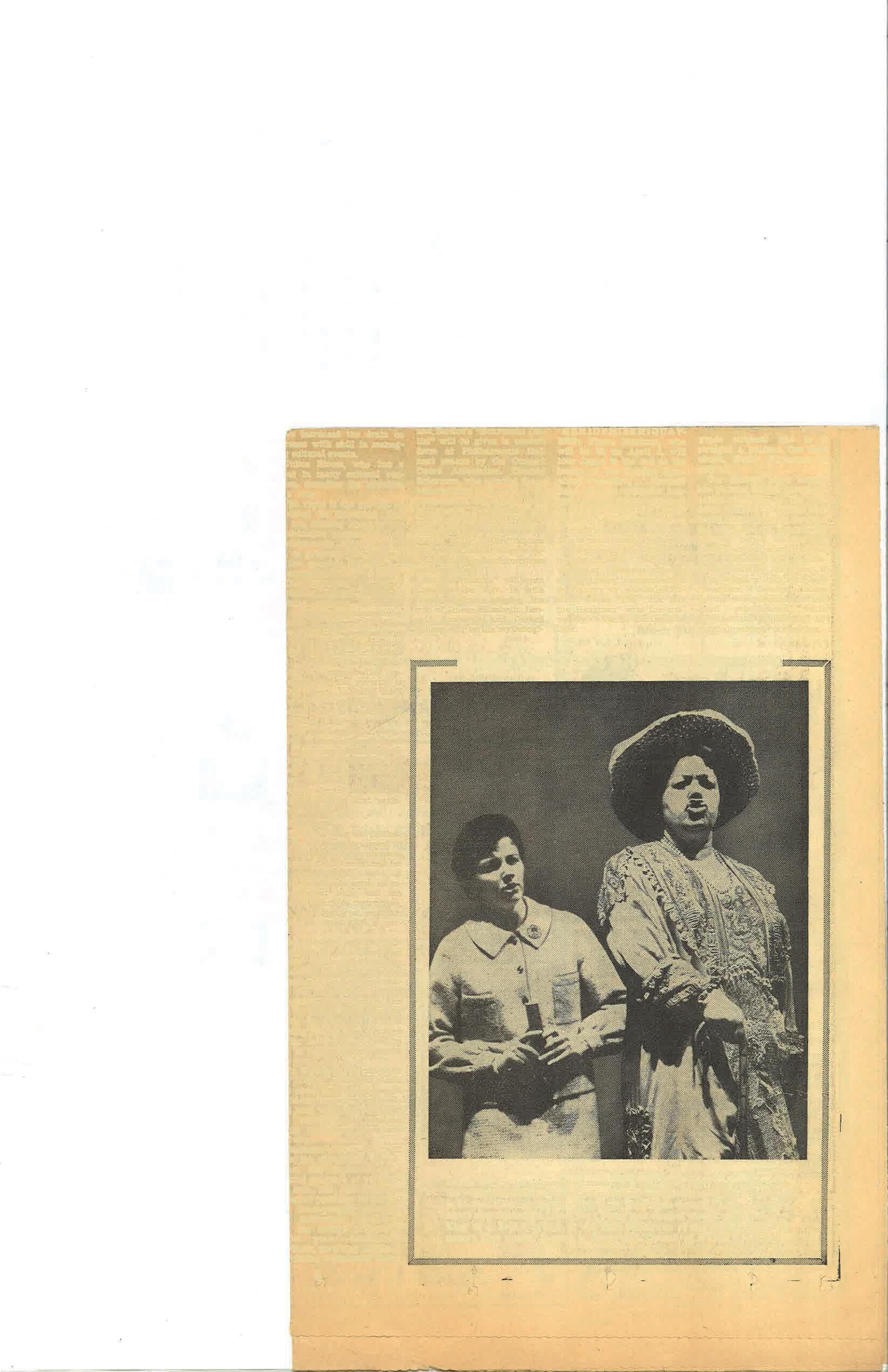
the colorful performance by soprano Ellen Faull, the only import in the cast, who portrayed Lady Billows, the town’s one-woman morals squad. Faull, a veteran of the New York City Opera, was a shrewd choice. She had played the part in the first US production in 1949. John Olon-Scrymgeour’s directing was much praised once again, as was Tom Nee’s conducting.
Though his attitude toward Center Opera would soon turn sour, Argento remembered this production of Albert Herring with special fondness. “For me it was one of the great opera productions of all time,” he said. “John was especially sensitive to Britten’s music, and Vern Sutton couldn’t have been better. As I recall, Guthrie himself attended a performance of it, and on the basis of that offered Vern a job in his acting troupe. I don’t think he was interested, but we could tell we already had an opera star.”
Everyone onstage and behind the scenes took a deep breath after the final performance March 14. Center Opera had been a success. By this point it was clear to just about everybody that this would be more than a one-season effort. Center Opera would continue, and it would do so, in part, Sutton thought, because there was a new energy in the city.
“It was because Guthrie had come here and put up this theater,” he said. “The whole spirit in the city was different than it had been in the first two years I had lived here. Suddenly this was going to be a hub of theater activity. When I came here the only theaters in town were the Old Log and Edyth Bush.”
An accountant’s tally put together at the end of the company’s first season showed a budget for the first two productions of $43,094. Ticket income and contributions totaled $36,840. The Walker made up the difference.
THOUGH THE COMPANY’S FIRST SEASON was a success, relations with the Guthrie management were strained. “We were always at war with them,” Norton Hintz said. “People like Oliver Rea and Peter Zeisler, two of the theater’s founders, regarded us as the rankest of amateurs who hadn’t the slightest idea what to do in the theater and were doomed to fail and to run into all kinds of problems. They ridiculed us and were sometimes hostile. But they came around, I must say. After the first opera season was over, I got a wonderful letter from Peter Zeisler in which he complimented everybody on the Arts Council for having pulled it off. He said he never thought we could do it and was truly impressed.”
By the spring of 1964, it had become obvious to Martin Friedman that the Walker needed someone on the staff to coordinate the museum’s ever-growing performing arts sector. As valuable as the Center Arts Council had been to the Walker and to the city the past decade, the age of enthusiastic volunteer committees was giving way to managers and arts coordinators who could bring a professional perspective and skill to what had become an increasingly demanding job that could no longer be done on a part-time basis. Friedman’s choice was twenty-nine-year-old John Ludwig, a native of New Orleans who just a year earlier had received a master of fine arts in theater production at Yale University and had been working at the Cleveland Playhouse on a Ford Foundation internship program. Ludwig’s title in Minneapolis was coordinator for both the Guthrie Theater and the Walker Art Center, a position he held until 1969. That year, when Center Opera left the sponsorship of the Center Arts Council/Walker Art Center, Ludwig also left and became general manager of the newly independent Center Opera Company, which is what he had been doing all along. In 1973, he left the company to become general director of the Wolf Trap National Park for the Performing Arts just outside Washington, DC, and he later joined the National Institute of Opera as general manager.
Ludwig was the right person at the right time: a tireless fundraiser, a passionate advocate of the arts with a deep knowledge of opera and theater, and a champion of new works. And he was eminently quotable, as every journalist would discover. Whether he was being interviewed in local newspapers or those out of town, his comments were the ones people remembered:
“We just want to drag opera into the twentieth century.”
“No young composer should write an opera over ninety minutes long.”
“We could run for twenty-five years on the Met’s operating deficit for a year.”
“We’re groping for new ways of doing things, for a new kind of lyric theater. Above all, we subscribe to the idea of opera as contemporary theater.”
In a survey published in 1970 of the more progressive American opera managers, critic and vocal coach Conrad Osborne described Ludwig as “probably the most astute and thoughtful general manager on the American scene.”

“Poised, outwardly reserved but with a fine sense of irony, [John Ludwig] had a debonair quality, ideal for dealing with patrons.”
—Martin Friedman, Director, Walker Art Center
“Posed, reserved sense Ludwig] quality, with Director,
ON ARRIVING AT THE WALKER , Ludwig began putting together the company’s second season. Trading ideas with Norton Hintz and a few others, he announced two relatively new, not often performed but quite serious operas: Britten’s The Rape of Lucretia and Carl Orff’s The Wise Woman and the King. Staff changes were also announced. Yale Marshall would move from executive producer to “role coach,” and Hintz would become head of the new opera committee, a branch of the Walker board. Tom Nee would continue as music director. James Wines, an artist and architect associated with environmental design, would create the set and costumes for Lucretia, and John Olon-Scrymgeour would return (for the last time) as director. A Yale classmate of Ludwig’s, H. Wesley Balk, originally from St. Paul, would stage Wise Woman, for which the design team would be Richard Randell (set) and Carolyn Parker (costumes).
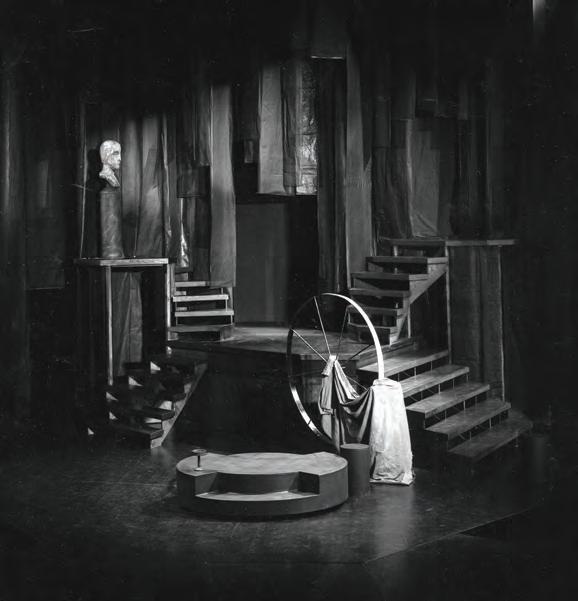
“People were very taken with John and his personality,” said Philip Brunelle, who replaced Tom Nee as music director in 1968. “He generated a lot of enthusiasm in people. He was kind of a bon vivant, the perfect person in those early years when we had to work with Martin and the Walker to make all this happen, and he encouraged people in both Minneapolis and St. Paul to get behind this and support it. I liked John a lot.”
Argento was no longer on the roster as artistic advisor. He had received a Guggenheim Fellowship, which would keep him in Italy the entire season. When he returned, he found a new cast of characters running the show. Center Opera had a manager in place, John Ludwig, and a resident director, H. Wesley Balk, which meant that John Olon-Scrymgeour, whom Argento had anticipated would become permanent director, was out, though he did stage the first production of the second season, The Rape of Lucretia
With new people in charge came a shift in the artistic direction of the company, the first of several shifts to come. What Argento had hoped was that Center Opera would become, in his words, “a place where one’s own works—along with other works one admired and respected—could be properly presented to a discerning and appreciative public.” The obvious model was Aldeburgh, the festival in England where Benjamin Britten premiered most of his works. Argento’s hope had been that he and Olon-Scrymgeour would run Center Opera together, with the company becoming a showcase for his operas.
Had Balk and Ludwig not taken control of the company, might Argento’s dream have been realized? The question has been mulled over in Twin Cities arts circles for decades. A reasonable answer is: probably not, given that Martin Friedman, as director of the Walker Art Center, was in charge, and Martin, looking back on all this in later years, said in an unpublished memoir that he wasn’t impressed with the first season’s productions. “I was especially glad that Balk would join the effort because, respectful as I was of the company’s initial productions, something was lacking: a sense of currency and the offbeat. I hoped,” he said, “that Balk would take the young company in lively new directions. I was not disappointed.”
Wesley Balk, whose bold, restless spirit defined Minnesota Opera in the company’s first two decades and whose innovative methods of training singer-actors have influenced generations of performers, died at the veterans' home in Minneapolis the morning of March 21, 2003. The cause of death was complications of Parkinson’s disease. Balk was seventy.
Born in St. Paul and educated at Bemidji State College and the Yale School of Drama, Balk directed more than sixty productions for Minnesota Opera, of which he became artistic director in 1965, when the company was Center Opera. He staged more than a dozen productions at the University of Minnesota, where he was a professor of theater arts from 1966 to 1993. Through the years his work was seen at the New York City Opera, San Francisco Opera, and the Santa Fe Opera, among others. In 1982, he received the Award for Service to American Opera from the National Opera Institute. To those who knew him and worked with him, Balk was charismatic, inspiring, relentless, daunting, stubborn, playful, provocative, enigmatic, single-minded, brilliant—and that was just the first impression. He had enemies as well as friends; he seemed to thrive on both. He loved limericks as much as he loved Shakespeare and Mozart.
“Wes was a true hero to me, a theatrical genius,” said baritone James McKeel, a composer and a professor of music at St. Olaf College who performed with Minnesota Opera off and on from 1976 to 1994. “Working with Wes was like working with a perfect blend of Robert Altman and David Lynch. He had such a fiercely original vision for productions and performance style but was also very collaborative in the moment. For me he was always a dream director because he welcomed you in the process and took you on an adventure.”
It’s no exaggeration to say that Balk, a thirty-two-year-old graduate student on leave from Yale University, became a star in the opera world practically overnight in January of 1965 when he made his debut with the Center Opera production of Karl Orff’s satiric fable The Wise Woman and the King. TIME magazine devoted a full page to the show, describing it as “one of the most engaging productions of the US opera season.” The opera’s resounding success is due in large measure, it said, “to the brilliantly imaginative staging of H. Wesley Balk, who views the fable as a discourse on spiritual realities, which run from earthy paganism to ethereal mysticism and back again, with lots of love, lust, violence and cruelty in between.”
Job offers quickly appeared, one of them an assistant professorship at the University of California, which he turned down in favor of a similar position in the theater department of the University of Minnesota. By then, John Ludwig, manager of Center Opera, had named Balk resident director of the young company.
Praise for Balk’s work continued when the company went on the road. Donal Henahan of the New York Times wrote of Balk’s staging of The Mother of Us All, “H. Wesley Balk’s direction, wittily contemporary and yet not offensively ‘with it,’ scored triumph upon triumph in underlining the sense of score and text.”
Not everyone was impressed. The loudest of Balk’s detractors was the composer Dominick Argento, who thought Balk’s stagings overemphasized dramatic values at the expense of music.
Philip Brunelle, who became music director in 1968, a position he held for seventeen years, thought similarly. “Wesley was a very strong person,” Brunelle said in an interview in 2017. “Working with him, you had to be equally strong or else you’d be just run over like a truck. The big challenge for me was to say, ‘Wesley, staging is really important, but you know what? So is singing.’”
Balk always claimed that he tried to keep drama and music in balance. Most opera productions, he said, lack sensitivity either to music or to theater. People who worked with Balk or studied with him noted how sensitive he was to music, a quality not shared with many stage directors. It might be remembered that opera production had been largely a musical phenomenon for a couple of centuries—a concert in costume—so that careful attention to dramatic values, a trend just getting started in Europe and the United States in the 1960s and 1970s, might have been thought unusual. By most accounts, the singing voices during the first few years of Center Opera were not of a high caliber. Reviewing the 1967 production of The Mother of Us All, Harold Schonberg of the New York Times wrote that the quality of the singing “ranges from good to downright amateurish.” What impressed critics, local and otherwise, besides the wild and crazy designs, were the dramatic values, the meticulous staging (an hour of rehearsal for each minute in performance, they claimed), and the physical freedom the singers displayed. All told, it was the sheer improbability of this whole enterprise hidden away in the frozen Upper Midwest that intrigued audiences and impressed visitors. It wasn’t the voices that impressed them, though by the early ’70s they were improving.
The company’s Opera Studio, aimed at the training of young singer-actors, gained momentum in the mid-’70s, and gradually began to draw more of Balk’s focus until, by the mid-’80s, training and education were his major activities. A young tenor, Gary Briggle, who had just graduated from St. Olaf College, was accepted into the program. The experience changed his life, he said. “It was clear that we were going to be guinea pigs in Wesley’s examination of the skills employed by the best singing-actors in the business—Maria Callas, Teresa Stratas. What was it that made these artists so sublime? Wesley was trying to devise exercises that took apart all those skills: acting, singing, movement, or, as he came to talk about it later, the face, the voice, the body, all of them expressive modes, as he called them. This had never been done before. No one had ever in an analytical way taken the watch apart, looked at all the pieces, cleaned them up, then put them back together to create the complete singer-actor.”
James McKeel, like Gary, started out as a member of the Studio. “The sense of ‘play’ in the Studio was so important. To take opera singers, who need a lot of technical grounding, and to unleash them emotionally, dramatically, and comically was very liberating. They even arranged for us to have Alexander Technique sessions to align our bodies and loosen up. It was amazing to see twenty-, thirty-, and forty-year-old people suddenly so relaxed that they would burst into tears or become aroused or break into uncontrollable laughter. Every adult needs this.”
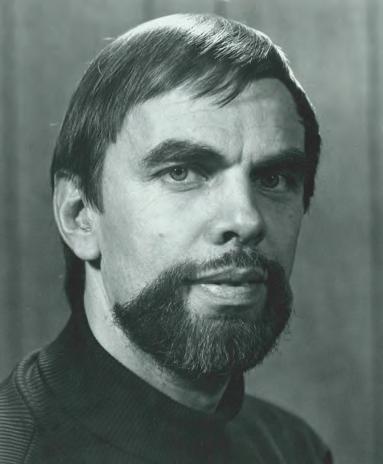
Balk said he kept encountering damaged singers. He wrote about it in the August 1990 issue of the New York Opera Newsletter. “They were damaged in the sense of being so traumatized judgmentally, and so afraid of exploring and opening to new experiences, I was horrified. They were giving about twenty-five percent of what they were capable of. I became more and more aware that we have a wide epidemic of judgmental, destructive, controlling ways of working. They’re so locked up that they literally can’t move their faces at first. Eliminating that tension is an important first step. It’s a self-acceptance issue. At its worst, it’s saying, ‘I’m not good enough the way I am, so I have to do something extra to be this model performer.’ That we have to change, and gradually we did change it for many singers.”
The other complaint about Balk, one seldom publicly acknowledged, was the frequent casting of his wife, Barbara Brandt, in most of the dramatic soprano roles from the late ’60s to the early ’80s. Perhaps this was the inevitable result of the ensemble system, whereby a group of singers is hired for the season, extra roles being hired out individually. Brunelle said he mentioned it to Balk on one occasion, saying that Barbara was sometimes cast in roles she wasn’t suited for. “He got furious with me. ‘Oh, I would never,’ he said, ‘never think of Barbara for a role she wasn’t suited for.’ Oh, yes, he would.”
The stories about Barbara onstage and the many mishaps that plagued her are legion. No one, however, denied her talent, the sheer beauty of her voice, or the intense commitment she brought to a role. “I idolized her,” said Janis Hardy. “I was about ten years younger than she. I’ll never forget her singing in Faust Counter Faust. I wept every night. It was glorious, the way she sang those high pianissimos. She was electrifying.”
According to Barbara’s son, Gean Halstead, Barbara was aware of occasional grumblings in the company over the fact that Balk cast her in most of the main soprano roles. “My mother was very sensitive about that,” Gean said. “She would take notes from Wesley, but sometimes it was tough for her, trying not to get too bent out of shape if he was critical of her. Wesley seemed almost immune to it, though I think he was less immune to it later. In my view, he did pay attention to what people said. Both Wesley and Barbara in their later years referred to their work with Minnesota Opera as their biggest moments in life, and that’s what they wanted to be known for.”
Barbara and Wesley met in 1965 when she won the Minnesota Metropolitan Opera Auditions. Though both were married at the time, a romance developed. They eventually separated from their spouses and were married in 1968. Gean’s father was given custody of the three children—Gean and his two sisters—who then moved in with their father, who had remarried and was living in northern Minnesota. As time went on, Gean’s visits to Minneapolis during holidays and in the summer to spend time with his mother and Wesley became more frequent, and so when he was fifteen, both families agreed—quite amicably—that Gean would be happier if he moved in permanently with Barbara and Wesley. He did so and eventually graduated from West High in Minneapolis and took a degree in music at the University of Wisconsin at Eau Claire.
By the early ’80s Wesley was losing interest in Minnesota Opera’s mainstage productions. The repertoire was turning traditional, which he didn’t care about, and even more so when the Metropolitan Opera tour ended in 1986. Wesley turned to his other great interest, the training of singers, which engaged him for the rest of his life. “He thought that would be his legacy,” Gean said. “The focus would be on the art form itself rather than on production and on the politics of it that had started to take over.”
Wesley spent a year in New York City teaching at the Manhattan School of Music, then returned to Minneapolis, where he continued on the faculty at the University of Minnesota until 1993 and also working with the New Music-Theater Ensemble. Starting in the 1980s, Barbara devoted herself to New Age therapies, most notably the Radiance Technique—an energy-balancing process, as Gean described it—and for a while maintained a studio in New York City.
They were a glamorous and brilliant and eccentric couple, Wesley and Barbara. At their peak—probably the 1970s, the Minnesota Opera years—they were stars, locally. They could light up a room. Wesley’s career, of course, extended way beyond the Twin Cities, and his influence lives on. What sustained their mystique well beyond the ’70s was that no one was sure where they were or what they were doing. It was all rumor and wild surmise: Barbara was down-and-out in Florida, Wesley was learning to levitate. Barbara changed her last name to Aurora. (That one was true.) We finally have Gean to tell us what really happened.
“The two of them bought a beachfront condo in St. Pete’s in Florida in the late ’70s, maybe the early ’80s. There was a question of how this could work financially. Then a hurricane came through and wiped out the beach. The property values dropped 40 percent. So they both lost the property, and in the process the marriage got lost too. And so they went their separate ways, and there was quite a lot of bitterness between them for a while. But over time, in about ten years, they remarried. But it was more a marriage of convenience. They were actually taking care of one another, and at the end that didn’t work very well, either.”
Barbara Aurora (Brandt) died of natural causes January 30, 2022, at a long-term care facility in Minneapolis.
Wesley’s Parkinson’s surfaced in 1984. He dealt with it with courage, fortitude, and wit. And he continued working with the New Music-Theater Ensemble (now Nautilus MusicTheater, headed by his protégé, Ben Krywosz) until a year before he died.
“It was heartbreaking for us to see Wesley steadily diminished by his disease,” remembers Gary Briggle. “Wesley danced with Parkinson’s for many years and outlived all the predictions of doctors who said, ‘Oh, you won’t live five years.’ Well, he went on and on and on. I brought him to Lyric Opera Cleveland in 1998 to teach a week of master classes with my apprentices, and you wouldn’t believe it. I would pick him up in the morning, and he was, literally, infirm in his bed. We would get breakfast and then start classes around one o’clock in the afternoon, and by that time he had rallied in such a dazzling way that he captivated twelve young artists just like he had captivated me in
1975 for three hours at a time. And then he was spent. But he would rise to any opportunity to see a human being fulfill and exceed their potential. And, you know, Wesley was a complicated man. When I first met him, he was an intimidating guru, and I think he sort of enjoyed that. But within a decade he had begun to dismantle the ego part of it. And part of his spiritual journey was to leave his ego out of the equation as a teacher and as a human being. It was quite a transformation. He seemed so unburdened when he began to face the power of ego and all that. He didn’t require it. I knew it gave him joy to be, as they say, the kinder, gentler Wesley that he really was in his later life.”
Balk’s memory and techniques continue each summer in the Wesley Balk Opera/Music Theater Institute founded in 1978. Four of Wesley’s books remain in print: The Complete Singer-Actor, Performing Power, The Radiant Performer, and The Dramatization of 365 Days.
On the evening of May 19, 2003, just two months after Wesley died, about 150 friends, students, colleagues, and family members gathered at University of Minnesota’s Rarig Center for a celebration of life featuring music and stories, with Charles Nolte, the playwright and teacher, acting as master of ceremonies. “Wesley asked for this before he died and stressed that it be a celebration not of him but of life,” said Ben Krywosz, a colleague of Wesley’s and a devoted friend for more than twenty years. To start it off, soprano Jennifer Baldwin Peden, mezzo-soprano Christina Baldwin, and baritone Bradley Greenwald, with Sonja Thompson at the piano, sang a favorite of Wesley’s, the “Farewell Trio,” from Mozart’s Così fan tutte (“May breezes blow lightly . . . As we say farewell”). Many stories were told, some funny, some sad.
“Wesley was a seeker,” Krywosz told the audience. “To him, the new was always better than the old, the innovative more interesting than the traditional, the unpredictable more engaging than the known.”
Krywosz recalled a lunch in 1986 at Calhoun Square with Wesley and music director Ann Baltz. They had just wrapped up the summer institute. “Afterwards, we were headed back to the parking lot,” said Krywosz. “In order to get there, we had to go up to the second floor. So Ann and I dutifully mounted the up escalator, only to turn around and see Wesley valiantly running up the down escalator, laughing triumphantly. Of course, he was met at the top of the stairs by a clueless young security guard, who chastised him for his transgression. Wesley just laughed, and that was his relationship to the opera field: he was always running up the down escalator.”
The evening ended with the entire audience singing “Make Our Garden Grow” from Candide: “You taught us well/But now you’re gone/You’ve left us on our own./So let us try,/ Before we die,/To make ourselves a home.”
Wesley’s own words were quoted on the back page of the program: “I offer my deepest love and gratitude that each of you have been in my life a deep and loving part of my journey. What a great adventure you and I have had, and what a privilege it has been to have known and loved you all.”

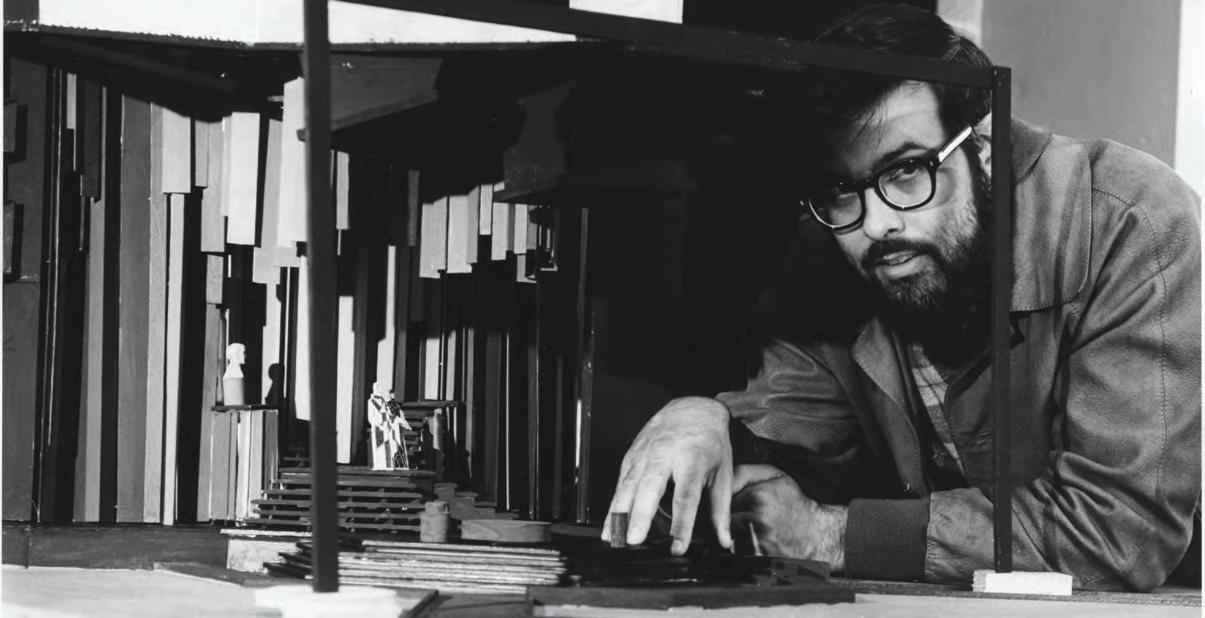
NORTON HINTZ SAID that first year he often found himself in the role of mediator in a group of strong egos: Friedman, Argento, Olon-Scrymgeour, and Ludwig. “These people didn’t have the same artistic views and sensibilities. I just wanted the company to survive,” Norton said. “That meant Olon-Scrymgeour had to go. Martin disliked him very much, his style. Dominick was loyal to John, so I was in this tugof-war, and I had to go along with Martin, basically, because otherwise we wouldn’t have survived.”
Not long after Balk arrived, the Walker’s artist selection process got started. For each production, Martin suggested the names of artists to Balk and Ludwig and would show them examples of the artist’s work. If they were interested, Martin would arrange for them to meet the artist. The artists were selected not only for their distinctive imagery but also for how that imagery might be put to use on the stage. Two of the five artists chosen were sculptors: James Wines and Richard Randell. The other three were painters: Nicholas Krushenick, Robert Indiana, and Robert Israel.
Wines, a New Yorker, was the first artist invited to the Walker. His predilection for cast-stone pieces whose relief-
like forms suggested the weighty facades of Roman and Renaissance architecture made him a natural for Britten’s The Rape of Lucretia, a tale of lust, betrayal, and violence set in the ancient Roman republic. With the help of the Guthrie’s technicians, Wines created a set that seemed like a mirage in motion. By means of light projected onto flat and rounded shapes of theatrical scrim, interiors evolved into exteriors, columns turned into trees, and trees became forests. Wines seemed to be saying that nothing is definite, that nothing could be taken for granted in the ever-changing world he had created.
Britten’s opera, premiered by the newly founded English Opera Group in 1946 and first staged here in 1953 by the University of Minnesota Opera Workshop, draws on the ancient legend dating back to the sixth century B.C. about the chaste Roman wife ravished by a prince of Rome, Tarquinius, who then takes her own life. In the view of the correspondent from Opera News, the opera was “beautifully staged by John Olon-Scrymgeour with an evocative three-level set by sculptor James Wines and the distinctly stylized costumes by Carolyn Parker and conducted by Thomas Nee.”
The hit of the season—the hit, in fact, of the first two seasons—arrived in January, a production of Carl Orff’s satiric fable drawn from the brothers Grimm, The Wise Woman and the King. This was Wesley Balk’s debut with the company, and what a debut it was. The rave reviews, including a full page in TIME magazine, offered unqualified praise for the junk-shop debris of sculptor Richard Randell’s two-tiered set, the clever army surplus costumes by Carolyn Parker, and the sprightly singing and acting by the accomplished cast. But it was Balk’s staging that dominated the focus.
According to TIME, “The opera’s resounding success is due in large measure to the brilliantly imaginative staging of director H. Wesley Balk, thirty-two, who views the opera as a discourse on spiritual realities,” the result being “one of the most engaging productions of the US opera season.”
Howard Klein of the New York Times lauded the company’s “Opera Without Elephants” motto. “The phrase means more than just Aida minus pachyderms,” he said. “It is Balk’s concept of opera as contemporary theater that may revive the artform.”
Writing in Musical America, John K. Sherman made an interesting point. A thrust stage like the Guthrie’s, as opposed to the more standard proscenium window, not only invites but demands strong, convincing acting. “In his staging, H. Wesley Balk responded inventively to the challenge of three-dimensional space, using a fluid and capering pattern of motion.” Another way to put it: it’s harder to hide bad acting on a thrust stage than it is on a proscenium. Perhaps the whole history of operatic performance since the start of the twentieth century, if not earlier, would have involved stronger acting from singers had the stages on which they were emoting been of the thrust design.
The score is typical of Orff, who at the time was Germany’s most famous contemporary composer—primitive rhythms and simple, rustic melodies interrupted by fanfares and sonic explosions. Orff believed that melody and speech belong together with neither one dominating the other. Balk reworked some of the couplets in the libretto, giving them an extra punch. For example: “Virtue is a precious dress / Do not wear it to excess” became, in Balk’s version, “Virtue is a pair of pants / You drop them when you get the chance.”
The opera’s raucous story—Grimm for grown-ups— concerns an irascible, tyrannical king who is easily outsmarted by his wife, the queen, and in the telling we run into a thieving mule driver and a trio of drunken tramps that, at least in this production, bear a resemblance to the Three Stooges.

Minneapolis Tribune feature, 1964, “Pop Go the Costumes”
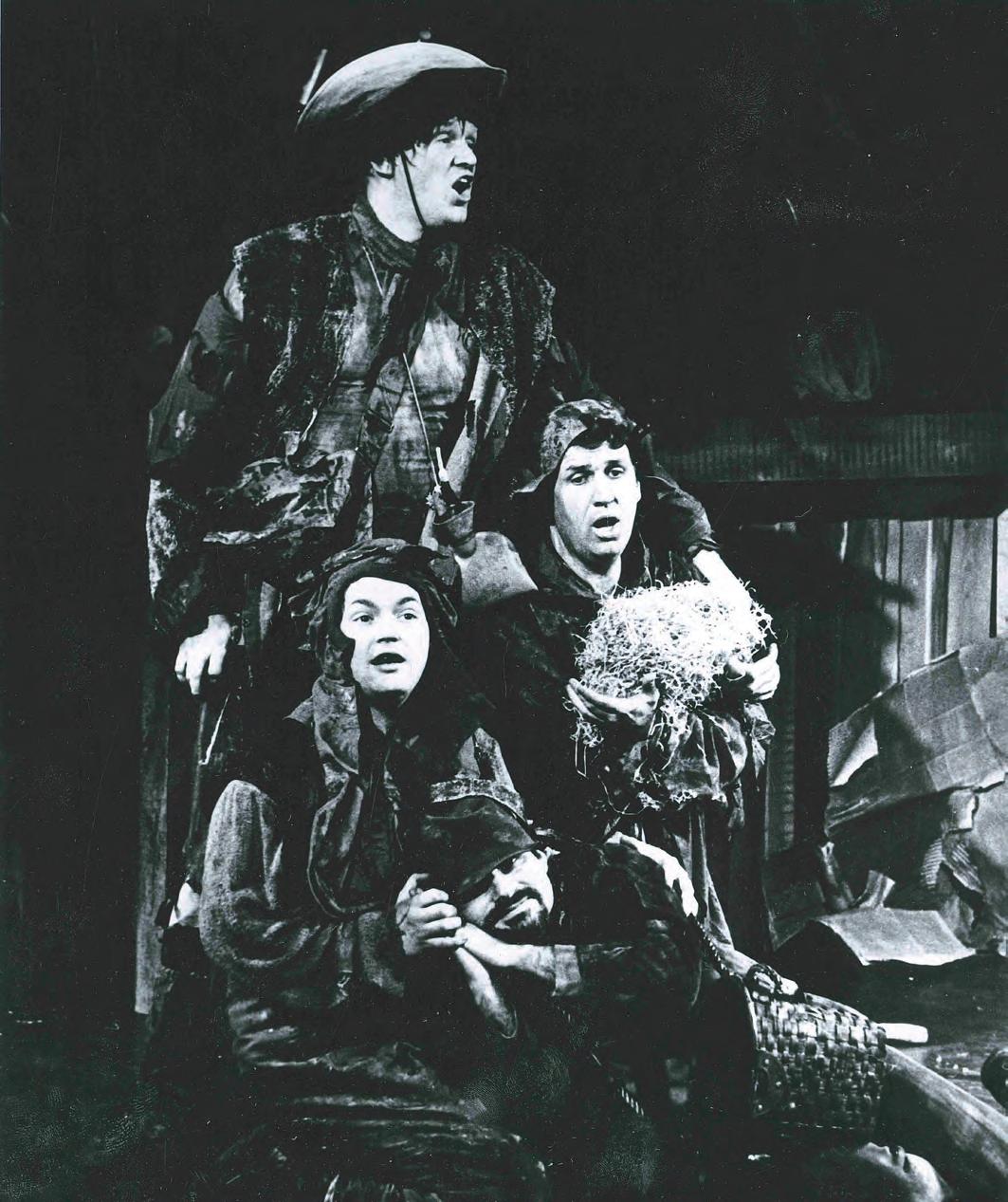


To represent this tiny country, which has fallen apart during the corrupt king’s rule, Randell, a member of the studio arts faculty at the University of Minnesota, used objects found in railroad junkyards, an approach he had been exploring in his recent sculpture. On the top level—the realm of the king—were castoff plastic HI-LEX bottles melted into chess men, a gilt-sprayed throne made from exhaust pipes, shock absorbers, and grease guns, and a royal scepter fashioned out of a three-foot-long eggbeater. On the lower level, where the common folk live, Randell gathered piles of railroad ties, packing boxes, oversized inner tubes pierced with spikes, and coils of baling wire. All of this, Randell said in a program note, was “the residue of industrial decay to show the decadent state of the kingdom, a kind of subterranean pop art.”


Randell prowled the St. Paul railroad yard looking for discarded steel and wood. He was a little too conspicuous one night, as it turned out. A security guard arrested him for stealing railroad property. He ended up in jail and was allowed just one phone call. He called his attorney, who happened to be Pierce Butler III, a member of the Walker board of directors. Butler bailed Randell out and arranged for a letter from the general solicitor of the Northern Railway Company to be sent that gave Randell permission to scavenge whatever he needed. In a similar fashion, most of Parker’s costumes were scrounged from thrift shops. The king’s crown was an accumulation of melted plastic forks.
Reviews were consistently positive. Don Morrison of the Minneapolis Star called the production “the purest delight.” Writing in the Tribune, Allan Holbert described it as “one of the most entertaining productions ever to take shape on the stage of the Guthrie Theater.” Howard Klein concluded his New York Times review by saying, “The singers were all local artists who combined solid vocalism with spontaneous and warm acting. As long as one finds youthful, imaginative, and daring work like this some one thousand miles from Broadway, the future of musical theater looks promising.”
The result of such acclaim was dramatic: Balk became a star almost overnight. (It is a fundamental law of physics that acclaim in Minneapolis and St. Paul, as is the case in most middle-size cities, carries special weight if it comes from outside the area. The out-of-town review makes board members happy and keeps them writing large checks.) Within a week of the show’s closing, the conductor Julius Rudel asked Balk to direct a production of Wise Woman at the Caramoor Festival in Katonah, New York, and there were offers to direct two productions of Mozart’s The Abduction from the Seraglio at Stanford University in California and, in the fall of 1966, at the New York City Opera, of which Rudel was principal conductor and general director. (The following year, Balk finished his PhD thesis at Yale on “The Mozart Operas and the Director.”) He was also offered an assistant professorship at the University of California, a position, he said at the time, he was interested in, though he had already taken a post in the theater department
of the University of Minnesota, given that his modest salary at Center Opera was not enough to live on.
The praise for Wise Woman had additional repercussions. First, it brightened the visibility of this scrappy little opera company located in the frozen North. People in the Twin Cities started hearing about it, as did the opera world around the country. Said Ludwig, “Since Wise Woman, people have written from as far away as New York and California to ask about auditioning for Center Opera.”
A second result was a promotion for Balk, whose title while staging Wise Woman was guest director. At the start of the following season, which opened with The Abduction from the Seraglio, he was listed in the program as resident director, the first of several titles he would hold with the company over the next seventeen years. Whether that had been Ludwig’s intention from the start—to hire Balk as a staff director—or whether it was the success of Wise Woman that prompted the move on Ludwig’s part, isn’t known and was never reported.
A final consequence of the success of Wise Woman and of Balk’s ascendance was that Center Opera became— unofficially—Regietheater, director’s theater, a post–World War Two approach to music theater that gave dramatic values a high priority, though not necessarily higher than music. The director—or the producer, as the term is used in Europe—is in charge. Adherents say they are simply treating opera as a form of contemporary theater, keeping opera and music in equal balance rather than letting it be chiefly a medium for music, which had been the attitude for several centuries. Opponents have long argued that opera is basically about the voice, and that directors shouldn’t take liberties with the stories and the settings of the operas they direct, and that in Balk’s case, he didn’t pay enough attention to the music in the works he directed.
Balk, to be sure, aroused arguments on these matters with every production he directed, and though he didn’t like being misunderstood, he seemed to thrive on those arguments. Balk probably had more admirers than detractors in his audiences. Singers, by and large, worshipped him. As for his few detractors, they had loud voices, among them that of Dominick Argento, who denounced Balk’s work for nearly fifty years.

Widely considered one of the most important opera composers of his time, a Pulitzer Prize winner (From the Diary of Virginia Woolf ) and Grammy Award winner (Casa Guidi), Dominick Argento has been a vital force in Twin Cities music for more than five decades—a composer for many productions at the Guthrie Theater, a composer laureate of the Minnesota Orchestra, a Regents Professor Emeritus at the University of Minnesota, and a cofounder of Minnesota Opera, a company with which he has had successful collaborations, but also numerous disagreements over the years.
Born in York, Pennsylvania, Argento had lived in Minneapolis since 1958, when he accepted a position teaching theory and composition at the University of Minnesota. The move to Minnesota, he thought at the time, would be “artistic suicide.” Careers in music— and all the arts—are on the East Coast, not the Midwest. However, Argento soon began getting commissions from Twin Cities arts organizations, and after four years he and his wife decided to make Minneapolis their permanent home. “It had been my fortune,” he reflected in his book, Catalogue Raisonné as Memoir, “to have landed in a state, namely Minnesota, in which the art I practice is widely viewed as an essential aspect of life, not merely an ornament or an embellishment.”
It was late morning. Argento and the author sat in the living room of his Kenwood apartment, looking out at a splendid view of the Basilica of St. Mary and beyond that the skyline of downtown Minneapolis. These two have known each other for forty years. There was talk of many things. It was a conversation but also, as it turned out, Argento’s final interview. He died nine months later.
Mike Anthony: You were one of the founders of Center Opera. The first season, which included the premiere of your one-act opera The Masque of Angels, was, by all accounts, a success. The second production, given in the spring of 1964, was Britten’s Albert Herring John Olon-Scrymgeour directed it, and Vern Sutton—quite memorably—performed the title role. What did you think of it?
Dominick Argento: For me it was one of the great opera productions of all time. John was especially sensitive to Britten’s music, and Vern couldn’t have been better. We could tell we already had an opera star on our hands.
MA: In the autumn of that year, you and Carolyn went off to Italy for a year. You had received a Guggenheim Fellowship. Your plan, on returning to Minneapolis, was to retain a position with the organization, and the model for the company would be the Aldeburgh Festival in England at which most of Britten’s operas had been premiered. Center Opera, in similar fashion, would be the birthplace of your operas. But it didn’t turn out that way. What happened?
DA: It was in that period that Martin Friedman decided that we had to have a company. We couldn’t just have an ad hoc company. John Ludwig accepted the job, and for director he had a friend named Wesley Balk. So for the second season John Olon-Scrymgeour directed The Rape of Lucretia and Balk directed The Wise Woman and the King. It became a contest between Olon-Scrymgeour and Balk as to who was going to become the future director. There was no question, I guess, based on what I heard from John, that the decision was loaded in favor of Wesley.
MA: What do you think would have happened if you hadn’t gotten that Guggenheim and stayed here instead? Would you have been able to throw some weight in the direction you thought it should go, that it might have become Aldeburgh West?
DA: No, I don’t know if I could have. John Ludwig was a very strong person, and he had a mandate from Martin Friedman to make this something that represented an artistic vision.
MA: The company premiered your Postcard from Morocco in 1971. You have said that in composing this opera you found your voice. How would you describe this voice?
DA: It’s what I wanted to see—and what thrilled me—not just declamation. New operas were coming out, and they were all sort of talky, not melody but recitative. I wanted to attempt to express all the emotions one gets in La bohème. What makes that possible is the full use of the voice. I think I achieved that in Postcard. There’s nothing like that in, say, The Masque of Angels, which is very contained, very disciplined. There’s a greater sense of freedom in Postcard.
MA: Would you say that Poe is the most unjustifiably neglected of your operas? Or are there others you would put in that category?
DA: I think Casanova is very underproduced and unjustly ignored. Both of them have a fault. They have huge casts, a big orchestra and chorus, lots of scenery and costumes.
MA: Your libretto for Casanova was much admired by Miss Sills and others. The advantage of being your own librettist is clear: fewer arguments. But is there any advantage to having someone to bounce ideas off of?
DA: Not really. In fact, that was the reason Miss Havisham was my big flop. I still believe that the best operas are those where the libretto was written to be an opera. It’s not an adaptation, in other words. In that case [Miss Havisham], the librettist pursued a certain idea. I didn’t like it, but it stayed in, and it wasn’t until the final dress rehearsal that I realized the opera was too long. If I had written my own libretto, I would have known better.
MA: What has been for you the greatest satisfaction? What is it in this long process that makes you say, “This is why I do this?”
DA: The writing. It’s when I’m sitting at the piano and finding a little phrase that tickles me. I used to test it with Carolyn. I’d say, “Which is the best part of this page?” I’d play it over, and she’d say, “Oh, those last couple of bars.” It’s that moment, in other words, when you’re writing.
MA: Is it like going into a trance?
DA: Yes. It’s clearing the mind of everything—all the appointments you have. You want a completely blank stage. It’s almost, like you say, putting yourself into a trance, because while you’re there you forget to eat, to drink, you forget what time it is and who you are. Nothing exists except the music. It’s almost like Homer’s siren who gets sailors in trouble. It woos you and you’re drawn in.

EVEN SO, THE COMPANY ended its second season in good financial shape and with a sense of optimism. Ticket sales rose to 8,300 from the first season’s total of 4,800, this being for eight performances rather than five in the first year, and attendance increased to 72 percent of capacity compared to 66 percent the first season. Increased ticket sales and attendance allowed the company to report earned income that was nearly double that of the first season, from $15,000 to $27,000, which meant the deficit dropped from $23,000 to $12,000. (Ticket prices remained the same.) The deficit was made up by another grant from the Rockefeller Foundation, this one for $10,000, with $5,000 promised for the following season. The Walker donated $2,000.
Moreover, during the second season there was a gradual change in the company’s attitude toward repertoire. What the founders of Center Opera planned to produce, they said repeatedly, was chamber operas—operas with a small number of singers and a relatively small orchestra. However, what Hintz and his colleagues found out, looking through scores and repertoire lists and talking to publishers, was that there weren’t many good chamber operas. “We found only about six that are worth doing,” Hintz told Allan Holbert of the Minneapolis Tribune in 1965. “So we changed our emphasis from chamber opera to music drama. We felt that the broader scope of music theater was more important. Limiting it to chamber operas was self-defeating.”
Since the Walker was paying at least some of Center Opera’s expenses, Martin, representing the museum, was allowed to
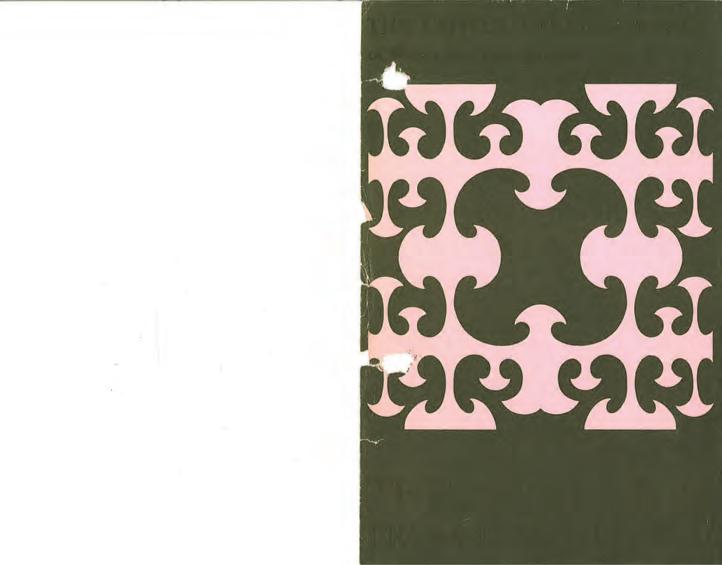
weigh in on repertory choices, and the decisions were not always unanimous. “I had some enormous arguments with Martin,” said Hintz. “Some were very painful because he was, by that time, a close friend. Our families were having Thanksgiving together and, on the other hand, we were having these nearly violent arguments about the company and its artistic policy and personnel involved. This was very painful for both of us.”
As the company moved toward its third season, with productions planned of Mozart’s The Abduction from the Seraglio and a contemporary opera by Robert Kurka, The Good Soldier Schweik, a technical problem of no small import had been solved: the difficulty of coordinating singers and orchestra in a theater with no orchestra pit, which meant that the orchestra for Albert Herring had to be placed backstage. The solution the first season was to put microphones on the stage with conductor Tom Nee picking up the sound on his earphones. This was unwieldy. Vern Sutton, who sang the title role in Albert, was asked to repeat the part in Baltimore right after the Center Opera production closed. “I remember the conductor was impressed with how well I knew my part, and I explained that I needed to know it because we were doing it, basically, without a conductor given that the orchestra was backstage. ‘Without a conductor?’ he said. ‘That’s impossible. Surely you jest.’ He said, ‘What you should do is put up television cameras that show the conductor so that the singers can see him.’ So I told them about that when I got back here, and that’s why they started using closed-circuit television during the second season.”

1965
TO KICK OFF its third season, Center Opera parachuted into the world of Mozart for the first time, offering a production of The Abduction from the Seraglio that looked like no other Abduction that had been seen in most parts of the civilized world. The Guthrie stage was bare except for two enormous folding chairs and three oversized coat hooks, none of which had anything to do with the opera’s Near Eastern setting. Some people, naturally, were puzzled by these anomalous set pieces, which were the work of Richard Randell, who had designed the junkyard setting for the prior season’s big hit, The Wise Woman and the King. Writing in the Tribune, Allan Holbert said he found the pieces “interesting, without helping the opera much.” Others were simply annoyed. A few saw the chairs as metaphors for a world that is topsy-turvy—the chairs were tipped over—a reflection of the opera’s story line: the virtuous Spanish maiden Constanza has been kidnapped by the Turkish pirate Pasha Salim, who carries her off to his seaside palace. After a considerable amount of frantic running from place to place and the singing of several longwinded arias, Constanza’s boyfriend, Belmonte, rescues her, and, since this is a comedy, everyone lives happily ever after. The tipped-over chairs, then, according to one theory, symbolized Constanza’s dire situation that needs to be fixed or uprighted. But since the chairs weren’t turned right-side-up at the end when all the problems were solved and the characters lined up onstage singing about how happy they were, this theory had to be abandoned.
Randell explained his design several decades later. The chairs weren’t symbols of anything. They were simply a way to provide the singers with a variety of spaces and levels to sing and emote from. And while there were no overt hints of Middle Eastern design motifs, Randell said he hoped that audiences would read the spaces created by the chairs as interiors and exteriors of Arabic architecture. On the other hand, he didn’t discourage the entirely plausible linkage of his chairs with the pop art of the ’60s, notably the sculptures of Claes Oldenburg that magnify the forms of everyday objects such as lipsticks and baseball bats.
Balk’s staging and the performances were enthusiastically reviewed. Said John Harvey in the Pioneer Press, “They turned the Guthrie’s thrust stage into a visually fantastic environment and enriched the action with sparkling stage movement and comic business. The result: smart, effervescent, and constantly entertaining theater.”
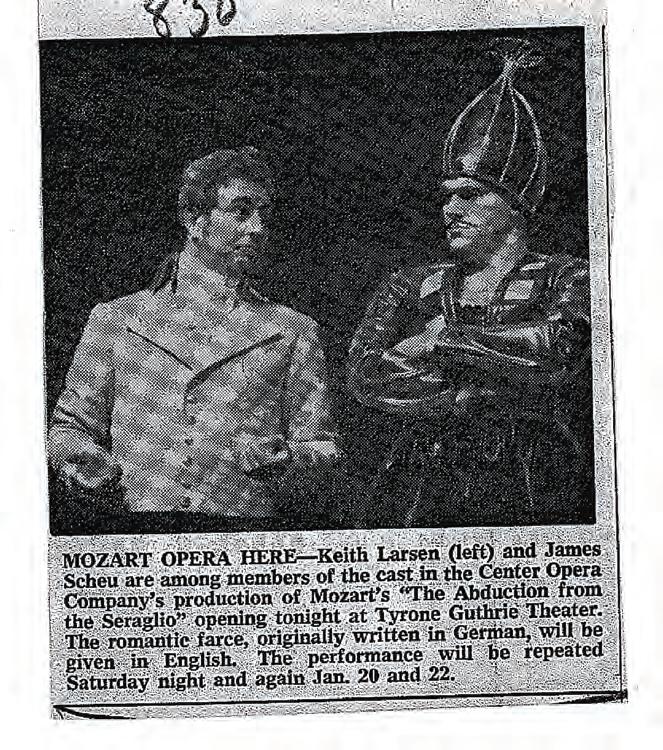
Probably the chief event of Center Opera’s 1966 season was the arrival of Robert Israel. Looking back to that time, Martin reflected, “I often wonder if the Center Opera Company would have had national visibility were it not for Robert Israel, its most prolific designer of sets and costumes.”
The Good Soldier Schweik by the Czech composer Robert Kurka, who died at thirty-five in 1957, is based on a novel of the same name by Jaroslav Hašek, who left his 752-page book unfinished at his death in 1923. Schweik is an Everyman, the classic amiable fool up against a world of injustice and trouble. In the story, set during World War One, Schweik is arrested for treason, clapped into an insane asylum and then into the army, where he becomes an orderly to a chaplain and is lost to a lieutenant in a card game. Time and again, Schweik’s superiors—along with audience members—are flummoxed because they can’t tell whether Schweik is an idiot or simply putting them on. The ending is enigmatic: Schweik is rolled off in a wheelchair, never to be seen again.


Writing in the New York Times, Raymond Ericson lauded Balk’s staging, which, he said, “achieved a miracle in maintaining the precise comic-tragic tone inherent in a war satire." (In later years Joseph Heller acknowledged the influence of Hasek’s novel on his own war satire, Catch-22.) Tenor Vern Sutton offered yet another vivid characterization in the title role. “Looking a little bit like Red Skelton,” Ericson said, “Sutton was always believable, accepting his misfortune with a welcoming smile, outwitting his tormentors through sheer innocence, saluting everything in sight, including the enema tubes in a hospital.”
Leaning more on the dark side of the story, Israel created nightmarish dreams onstage—everything in white, black, or blood red—as if we were looking at the world through Schweik’s eyes or peering into his dreams. His policeman was twelve feet tall, and his sinister psychiatrists wore shiny black nylon coats, a design idea influenced by German Expressionism of the 1920s, notably Robert Wiene’s classic film The Cabinet of Doctor Caligari. Writing in the Star, John K. Sherman said he thought the production was better than the opera itself. “Balk’s staging and the work of the singeractors, plus settings, costumes, and grotesque makeup are of a quality we have come to expect from Center Opera, where theater, music, art, and dance all mesh their contributions into a unified whole.”
Schweik was a hit, so much so that an extra performance was added. There were five in all. And when the books were tallied, the company remained small but healthy. Season attendance rose to 9,400 from 8,300 the previous year, which was 73 percent of capacity. The budget increased slightly to $43,600, as did ticket income: $32,600, leaving a deficit of $11,000—$1,000 less than the previous year. Contributions wiped out the deficit: $5,000 from the Rockefeller Foundation, $1,000 from the Walker, and a new source—$5,000 from local donors. In addition, the Center Opera Association, which by now had eight hundred members, had raised $10,000 to be held as an emergency reserve fund.
To an opera fan living in the third decade of the twentyfirst century, these numbers perhaps seem more like cab fare. Center Opera’s low budgets gave the productions a raggedy improvisational look that may have been part of their appeal. The soldiers in Schweik, for instance, wore long johns dyed a khaki color and helmets made of upside-down buckets topped with toilet plungers inspired by the spiked headgear of German World War One uniforms. For props such as desks and beds and for the interiors of beer halls and jail cells, Israel used cubes of various sizes on which the singers sat, stood, or reclined. Who can say for sure? Tiny budgets may have stimulated Israel’s creativity.
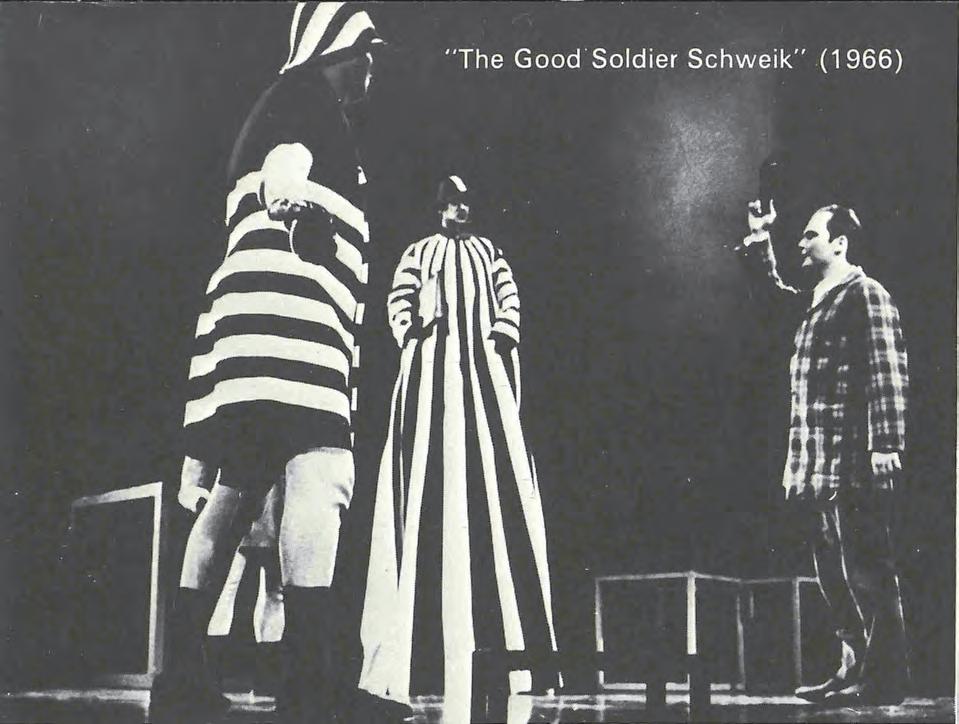
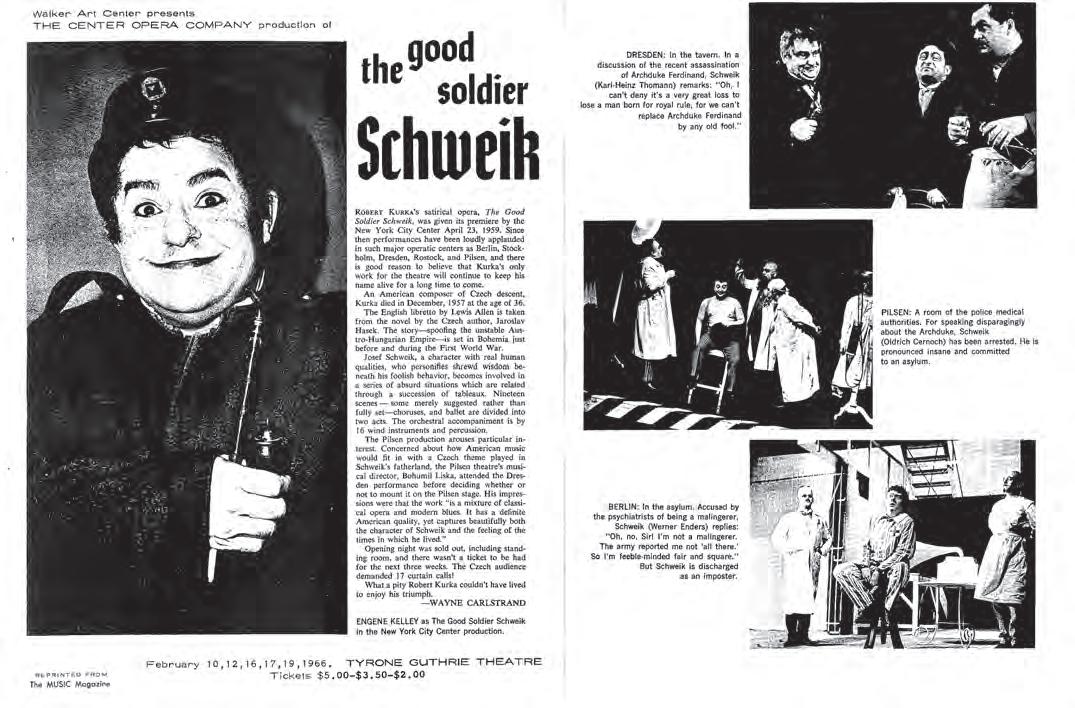
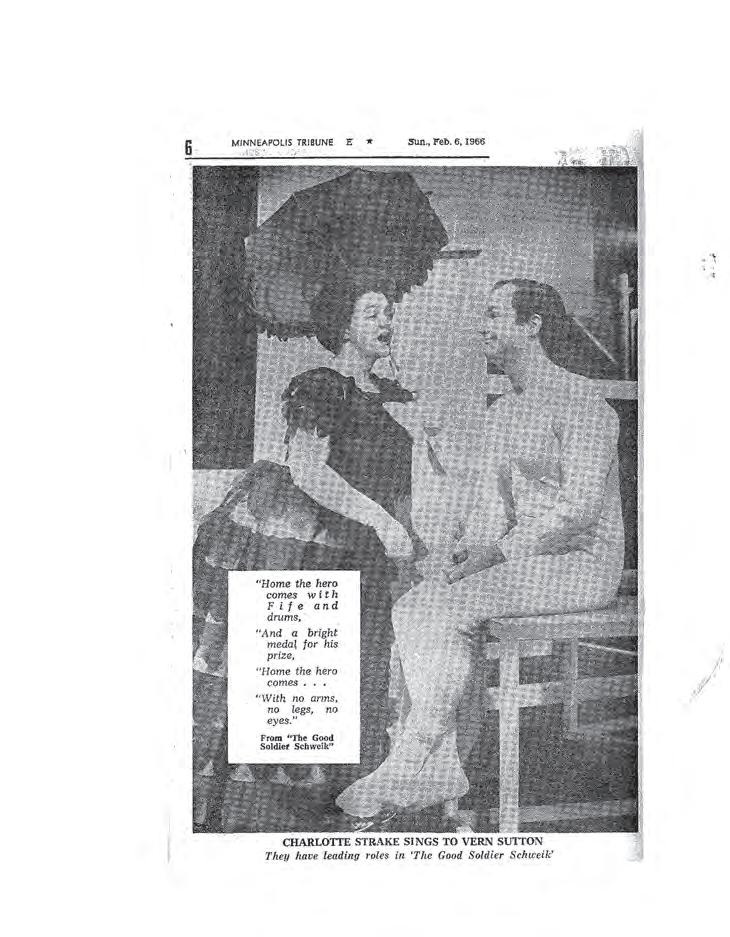
One of Martin Friedman’s favorite stories is how Robert Israel came to be a set designer. Friedman, director of the Walker Art Center, admired the work of Israel, especially Israel’s cartoon-like drawings in which organic sexual shapes collide and merge. He called Israel, who invited him to visit his studio.
Israel lived in a one-room apartment with an adjacent studio on the ground floor of an old mansion on Summit Avenue in St. Paul. Entering the apartment, Friedman saw stacks of records, and an opera played on a phonograph. They chatted, and Friedman asked Israel if he had ever considered designing for the stage.
“Why would I want to do that?” Israel asked.
“Why not?” said Friedman. He told Israel about the Walker commissioning artists to design opera productions, and a few days later Israel met with John Ludwig and Wesley Balk.
The result of that meeting in 1964 was Israel’s memorable design for the Center Opera production of Robert Kurka’s bitter antiwar opera The Good Soldier Schweik. Israel was soon given the title of resident designer, and in the next few years he designed four more productions for Center Opera and several others during the Minnesota Opera era.
Now in his eighties, Israel is today one of the world’s most respected designers for theater and opera. His work has been seen at the Lincoln Center Theater, the Metropolitan Opera, the National Operas in London and Tokyo, the Paris Opera, the Vienna State Opera, and many others. His costume drawings reside in the Museum of Modern Art in New York City, and he has designed the world premieres of four operas by Philip Glass. He is the former chairman of the Theater Department at the University of California, Los Angeles, and professor emeritus of UCLA Design Media Arts Department.
Speaking by phone from his Los Angeles home in May 2020, Israel reminisced about his Center Opera days. Were it not for the COVID pandemic, he would have been in France working on the premiere of a set of six songs by Philip Glass.
Mike Anthony: What was your first impression of John Ludwig and Wesley Balk on that day in 1964?
Robert Israel: My first impression was: I don’t know what I’m doing. My second impression was: these people know a lot more about theater and opera than I do, though I had listened to a lot of opera. It was kind of a way of escaping my upper-class Jewish background in Detroit. I wanted to get away. It started with a benign La bohème and morphed into Parsifal. I loved what I was listening to. I just sunk into it. I knew the operas, but I didn’t know anything about designing them. [. . .] The first few things I designed scared the hell out of me.
MA: Even so, there was nothing timid about your earliest work.
RI: Yes, there was nothing timid. But what I became conscious of is that because I didn’t know what I was supposed to do, I just went ahead and did what I thought I should do, which was much different than what was taught at places like Yale, which told you how things were supposed to be. So, while it wasn’t timid, I didn’t know what it was to be timid. I just did it. When we started I didn’t know upstage from downstage. I’m serious.
MA: The following year you designed To Hellas, six short operas on ancient Greek themes, mostly making fun of the characters and the situations. [. . .] Is it possible that with these pot bellies and baggy long johns the characters were wearing, you were alluding to burlesque comedy—a broad style that used to be called baggy-pants?
RI: I wasn’t thinking about it, but it’s there, sure. There’s always stuff that people find that’s not conscious but is definitely there, and I like that. I don’t like it when artists say, “Oh, no, no, no, that’s wrong.” In other words, if it’s any good, it’s going to be pregnant not only with the artist’s meaning but with specific meaning for the person who’s looking at it or hearing it.
MA: Vern Sutton, who appeared in major roles in many of your productions, Schweik and Punch among them, spoke appreciatively about your work. He said, “Bob never approached stage design from a logical, conventional point of view; nor did he ever give audiences or singers what they expected.” [. . .] Does that resonate with you?
RI: (laughing) Yeah, it scares me.
MA: The next production sounds beautiful. It was Britten’s A Midsummer Night’s Dream. You had pillows or balloons onstage.
RI: They were big pillow-like balloons that we sprayed with detergent—not to drink, by the way. And when the ultraviolet light was put on them they glowed, and they made the stage a kind of ethereal place. And Wes used that. The pillows were gently pushed into the moat around the stage, leaving the stage bare. It was beautiful to see that transformation.
MA: From the Romantic glow of A Midsummer Night’s Dream you moved a year later to the harsh surrealism of Punch and Judy by Harrison Birtwistle. Your design for that opera was much admired—and continues to be. What were you trying to get at with that design?
RI: All the characters there seem to be slightly psychotic. You can never trust them. [. . .] There was a craziness and a violence we wanted to put on the stage. I would design the costumes, then bring them to Wes, and he and I would sit down and talk about the characters. Some would stay the way they were, and some were revised because Wes wanted to do this or that. It was a wonderful, pleasant experience working with him. I absorbed a lot of what he was saying, and none of it seemed to restrict me. It just made me think in a creative way.

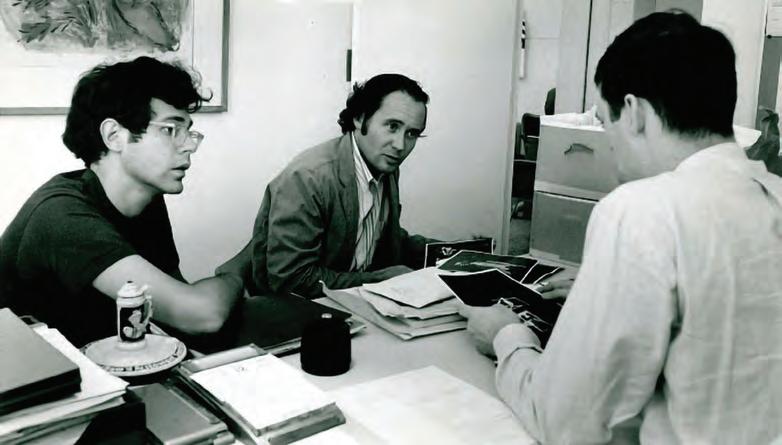
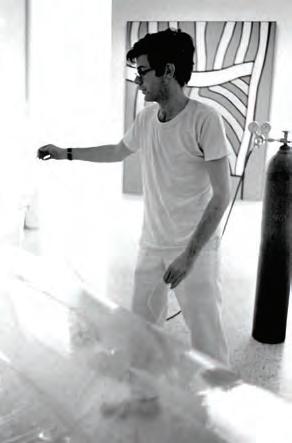

CENTER OPERA’S FOURTH SEASON , which opened January 27, 1967, was its first repertory season. Two productions alternated over the course of three weeks: the Virgil Thomson/ Gertrude Stein opera The Mother of Us All and a set of six short operas satirizing the theater of ancient Greece titled To Hellas. Despite the genuine success of the company’s past efforts, Balk sounded nervous when he proclaimed on opening night, “This is the toughest thing Center Opera has tackled. These are very different operas, and we don’t know how Minneapolis is going to like them.”
Minneapolis seemed to get on with them quite well, as it turned out, especially with The Mother of Us All, an important, seldom-performed work that became a signature production for Center Opera. Balk staged it again in an altered approach during the 1970–71 season and then took it on tour the following summer to Philadelphia, New York, and Washington, DC, where it got rave reviews at every stop. The opera concerns the life story of Susan B. Anthony, who pioneered political rights for women. Though Susan B., as she was known, lived in the nineteenth century, Stein’s libretto plays with time so that characters from different periods meet one another and take various positions on women’s suffrage. The tone of the text is whimsical and fits handily with Thomson’s all-American idiom: a mostly diatonic mix of waltzes, marches, and hymns drawn from the composer’s Southern Baptist Missouri heritage. The play’s content is typical of Stein’s writing. The ideas fly fast and in all directions. One character says, “If it weren’t so early, I’d be sleeping.” The chorus responds, “You’re absolutely right, but I don’t agree with you.” The jokes, however, aren’t incompatible with deep-felt social concerns and even patriotic feelings. In the final scene, set many years after Susan B.’s death, surviving friends in the suffrage movement gather near the Capitol in Washington for the dedication of a statue in her honor. Susan B.’s ghost enters, unseen even by her devoted friend Anne. When the crowd disperses, the statue sings mournfully of Susan B.’s great struggle in fighting for women to be able to vote.
Robert Indiana’s design had the feeling of a pageant, the unifying vision of which was a giant American flag that covered the back wall of the set. The brightly colored costumes were like three-dimensional figure drawings. Each singer wore a sash with the character’s name on it. It was history seen through a Pop Art lens.



The seventy-year-old Thomson was there on opening night. He hated the sashes and just about everything else he saw on the Guthrie stage, though he took his bows with the cast and looked very pleased. The critics loved it. In John K. Sherman’s view the production was “marked by broad comic touches, swift pacing and singing that made almost every speech intelligible.” Portraying Susan B., Janice Roche displayed “a strong, resonant voice in keeping with Susan B.’s characterization as a woman sometimes wrong but never in doubt.”
Harold Schonberg of the New York Times caught both productions, liked a lot of what he saw and heard, and ended up ruminating on the company’s future and its potential. What he found was “a bright, cheerful little production, praiseworthy more for its totality of effort than for any single contribution.” The quality of the singing, he said, “ranges from good to downright amateurish, and the same can be said for

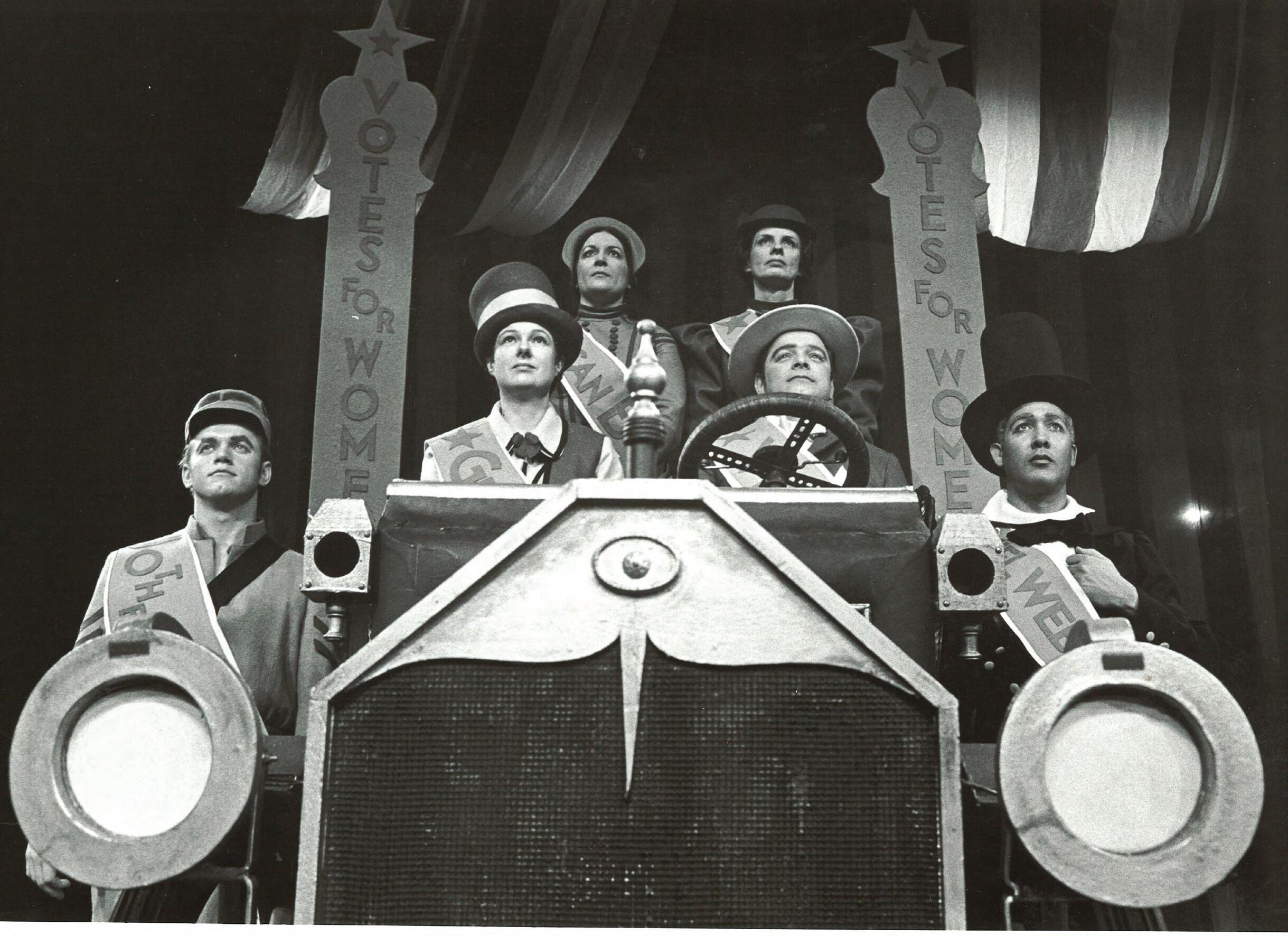
the quality of the acting.” He praised the “alert, responsive” orchestra under the direction of Tom Nee and said “that the company as a whole showed a fine grasp of Mr. Thomson’s charming opera.”
Intrigued by what he saw in Minneapolis, Schonberg took up the subject of Center Opera in a think piece that ran in the Times the following Sunday with the headline “Local Opera Is at the Crossroads.” The company, he said, “has reached a pivotal point in its existence. It’s trying to make up its mind about the direction it should take. It could continue doing new and unusual repertoire, which means the audience will continue to be relatively small; or it could move in the direction of more crowd-pleasing standard repertoire for which it doesn’t have strong enough voices and doesn’t have the budget to hire more expensive singers.” Here was a dilemma that would plague the company for decades.
In Schonberg’s view, even if it beefed up its orchestra and hired bigger voices, the company would be making a mistake delving into standard repertoire. “There are groups all over America who do that,” he said. “But there are very few who engage contemporary opera with such flair, gusto, and imagination.” If the company stayed on its current track while expanding its resources, Minneapolis, he said, “could be to modern opera what Buffalo has become to modern music,” a reference to the bold programming of the Buffalo Philharmonic and other musical organizations in that city. “Minneapolis could become an aesthetic and intellectual point that would adorn the country. It is clear,” he concluded, “that in the Center Opera Company the city has something unusual, even unique, and it would be a real loss if the group were not allowed to expand and flourish in line with the philosophy and aesthetic it has represented until now.”
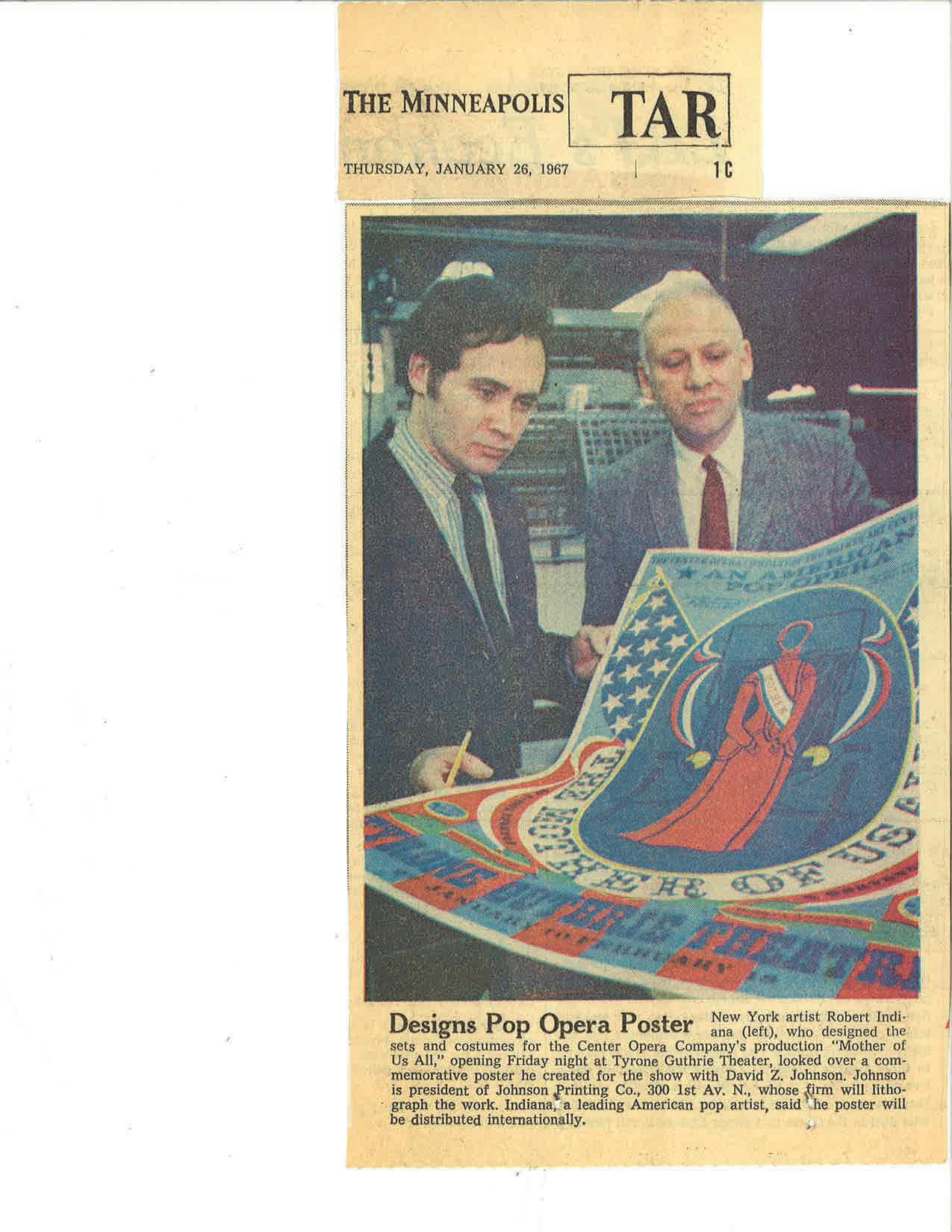
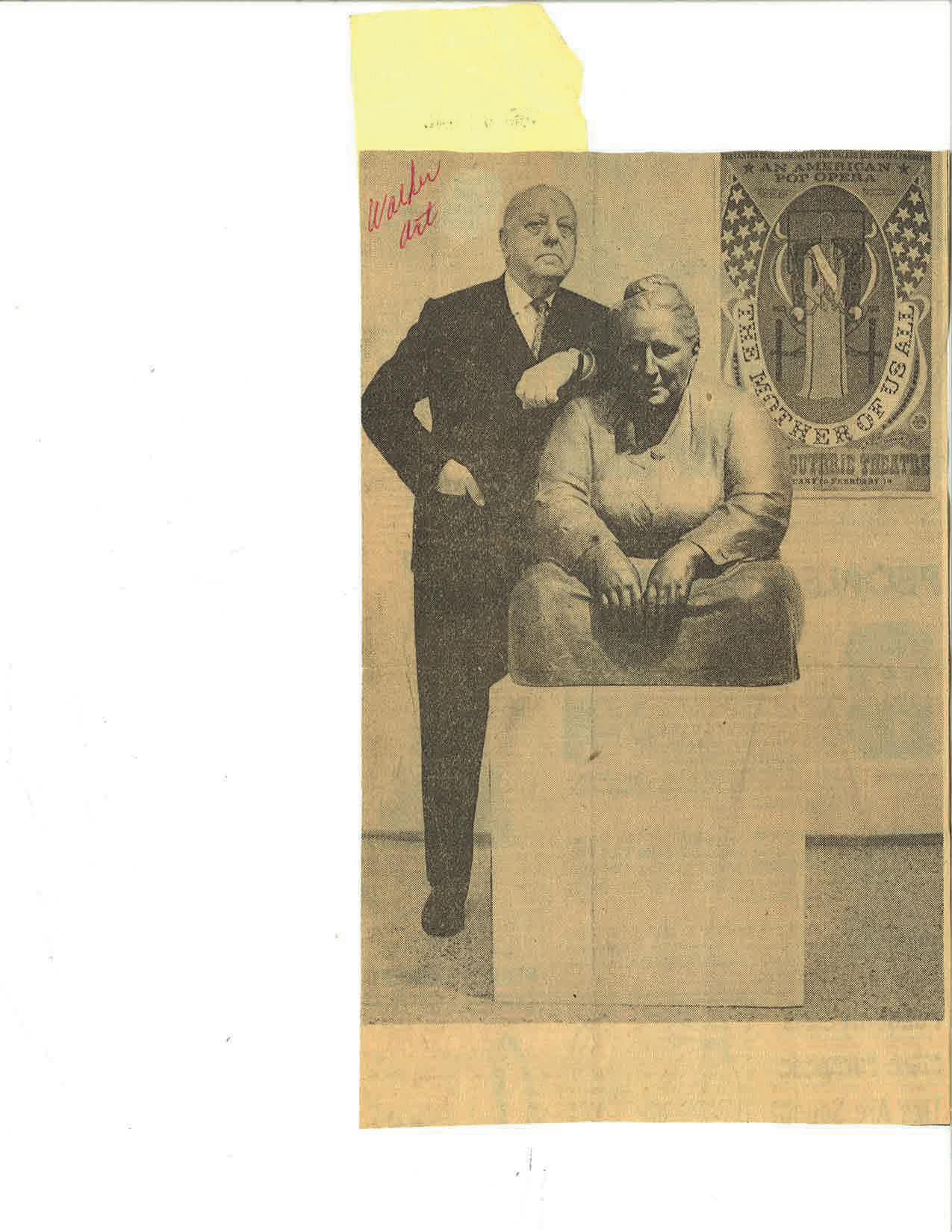
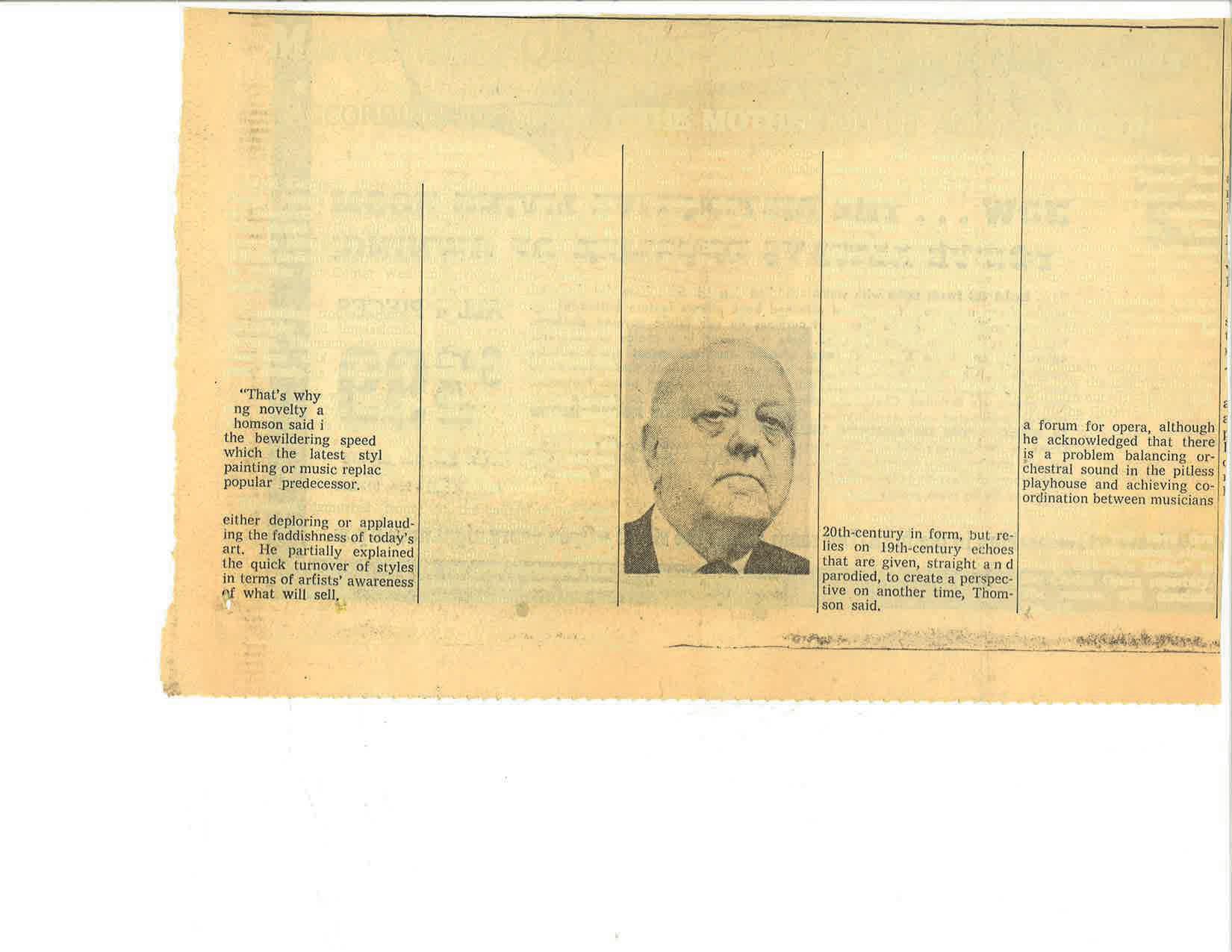
The company toyed with Schonberg’s formula through much of the ’70s but kept running into barriers, one of which was the increased cost of an ever-expanding staff and season. The other problem had already become apparent by the end of the fourth season. The company’s audience had ceased growing. Allan Holbert, critic for the Tribune, noted that the opening-night audience numbered about one thousand people, which was what it had been, he said, on opening night the previous season, which, in turn, was about twice what it had been the first two seasons, roughly five hundred. The company, in other words, had found its audience, and that audience most likely would stay the same for several seasons.
Center Opera wrapped up its 1966–67 season in April with a one-nighter at Northrop Auditorium, a concert version of Gilbert and Sullivan’s The Gondoliers, a collaboration
with the Minneapolis Symphony, that, said Mike Steele in the Tribune, “sparkles with spirit, vibrates with color and, above all, doesn’t take itself too seriously.” Wesley Balk staged the production, and George Trautwein conducted.
The company’s dour financial report for 1966–67 showed increased attendance but, because there were more performances, a drop in attendance for one of the productions. To Hellas drew only 49 percent of capacity for five performances. Payment of an $11,000 debt was put off till the following season.
On a brighter note, in a collaboration with the University of Minnesota, the company presented a six-week course in acting for singers, an effort led by Wesley Balk, who went on to devote a large part of his professional life to the training of singers for work in the theater. Yale Marshall served as role coach.

CENTER OPERA CONTINUED to attract attention around the country. In April the Chicago Tribune devoted several pages of its Sunday magazine to a feature article titled “The Young Lions of the Minneapolis Opera.” Reporter Peter Gorner opened by saying, “There is a little opera company in Minneapolis whose members average twenty-nine years of age. They are not awed by the opera monarchies to the east. They are bringing permanent opera to an area considered a wasteland by the bookers who handle touring companies.”
In June came the bad news that Tom Nee, the company’s admired music director, would take a position as assistant professor of music at the University of California, San Diego, and would leave Minneapolis in October. One of the founders of Center Opera, Nee had been associate professor of music at Macalester College and conductor of the Civic Orchestra of Minneapolis. The Center Opera production of The Magic Flute, scheduled to be presented in September, would be his farewell to the Twin Cities.
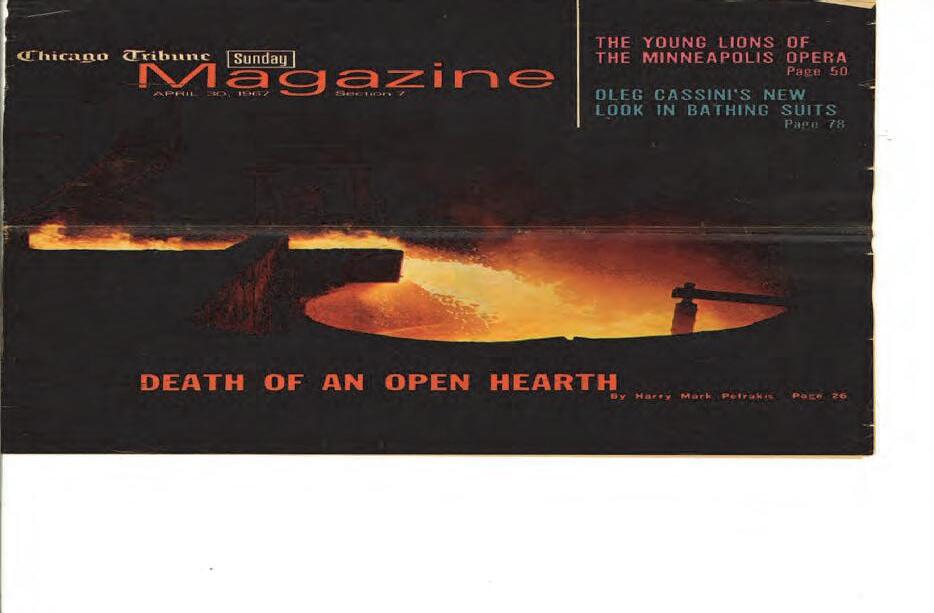
For Nee, the main attraction of the position in San Diego was the school’s commitment to the composition and performance of contemporary music, an area, he said, in which the Twin Cities is weak. “Around here we read all these glowing articles in Holiday and Harper’s and then pat ourselves on the back about being some kind of cultural mecca, a golden land of the arts. Actually, we shouldn’t be so smug. We’re deceiving ourselves,” he said. “There are exceptions, of course, but there’s very little done around here that’s really new or even slightly off-beat. Most of the music that’s played is pretty safe, time-tested stuff.”
Nee’s observations about the music scene in the Twin Cities in the late ’60s were valid, as a look at the programming of various ensembles back then will affirm. Ten years later, however, the music-making had turned considerably more progressive. In 1980, when the question arose in New York of which city should host the first annual New Music America Festival, a tenday extravaganza of new music of the more experimental— and frankly far-out—variety, no objections were raised when the answer emerged loud and clear: Minneapolis! And the Walker Art Center was the official sponsor.
The Magic Flute —four performances in September at Macalester College—was a collaboration with the Civic Orchestra of Minneapolis. The company engaged the soprano Eleanor Steber to serve as narrator and to devise the minimal staging for what was basically a concert presentation. In addition, two weeks before the performances, Ms. Steber worked with the twenty-two singers involved, giving them private voice lessons plus ensemble training. John K. Sherman gave fervid praise to the coloratura soprano Sarita Roche for her exciting portrayal of the Queen of the Night. In a smartly written review in the school’s Mac Weekly, twenty-year-old Chas Baxter—who, it’s worth noting, grew up to be the highly acclaimed novelist and short-story writer Charles Baxter—said the singing was better than the acting and gave credit to James Bowers (Papageno), Connie Barnett (Papagena), and, again, to Sarita Roche, who “sang several hair-raising arias.” He finished by lamenting the loss to the school of Tom Nee, who already had his bags packed for the trip to California.
In 2021, Charles Baxter reflected on that early review:
To be honest, I’d forgotten that I wrote that review. It was my first exposure to that opera, and I couldn’t make much sense of the libretto—too young and naive to recognize the Masonic initiation rites and all that. But I went over to the music building for the rehearsals and

have a very clear memory of Eleanor Steber coaching everybody, down to and including the way she wanted the sprites to walk onstage: heel to toe, heel to toe. She was smart but slightly imperious, as she probably had a right to be. Was Sarita Roche the Queen of the Night? She knocked me out. (I didn’t in those days recognize the sexism of the opera—more naivete on my part.) Sitting in on the rehearsals was pure heaven. For one of the actual performances, I sat six or seven rows back, one row behind the composer Eric Stokes and his frequent collaborator, the writer Al Greenberg. When Papageno played his glockenspiel and his jailers began to dance around, Eric started helplessly crying, breaking down, snot coming out of his nose—a musician’s purely visceral reaction. He was sobbing. I’ll never forget it; he didn’t care who saw him.
The main part of the season got underway on January 25, 1968, with a rarity, Haydn’s comic fantasy The Man in the Moon, which gives us that staple character of eighteenth-century
comedy, the old man who won’t let his daughter—daughters, in this case—marry the men they fancy. Meanwhile, the old man is trying to hook up with a young woman who detests him, and so, to solve the problem, these young sprites trick the old man into thinking he’s on a trip to the moon. Laughter ensues. At least that was the plan. Audience members did, in fact, appear to enjoy themselves on opening night, partly because of designer Richard Krushenick’s eye-filling set pieces, which included a flying machine that, according to Allan Holbert, “looked like a construction scaffold with wings and a moon machine that resembles a psychedelic steam bath.” “You’ve heard of Papa Haydn,” said Holbert. “Would you believe Pop Haydn?” Krushenick, who was associated with the Pop Art movement in New York, said the closest he had come to opera before this was a brief stint as a department store window dresser. It all came together nicely, nonetheless, including Balk’s lively staging. Holbert called The Man in the Moon “visually, the most exciting and entertaining production this five-year-old company has done. The sets are just as gassy.”
Another reason for the production’s success was the presence of Vern Sutton, no stranger to comedy, in the role of a pseudo-scientist, Ecclitico. Sutton recently recalled a mishap during a dress rehearsal:
There were four dancers, two men and two women. Their costumes, their tights, were covered with ball fringe. They were supposed to be outer-space creatures. I was the Wizard from Outer Space. I’ll never forget this. In dress rehearsal, they came onstage right in front of me during the introduction to my aria. You could see this fluff in the air, little balls that bounced as they landed and created these clouds. Well, of course, they thought this was such a nice effect, whereas I choked. It was one of the few times I put my foot down and had a fit in rehearsal. I couldn’t sing with this cloud around me. So they had to revise the costumes. That was one of the times when I thought, well, it’s great to have artists design the costumes, but they’re not always practical.
The 1967–68 season ended in March with five performances of Benjamin Britten’s version of A Midsummer Night’s Dream, for which the company imported from New York the countertenor John Ferrante to sing the high-pitched role of Oberon. Countertenors were rare birds back in the ’60s. In an interview with Ferrante, Allan Holbert estimated that there were only three or four of them in the United States. Today, there are hundreds, and most of them are busy, largely because
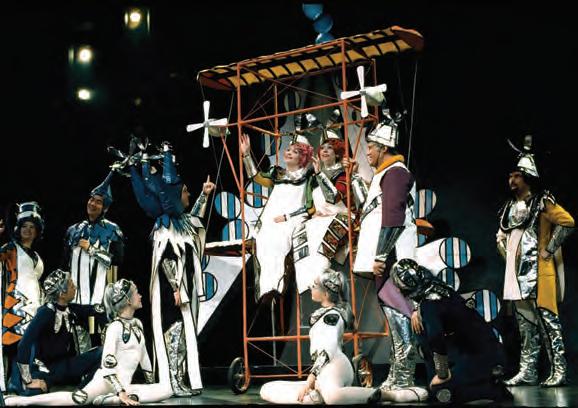
of the early-music movement, which didn’t really get rolling in this country until the 1970s. The opera itself wasn’t well received. Holbert described the event as a “most attractive production of a not-so-good opera,” a score he described as “pallid and dry.” The critics admired Ferrante, and they especially liked Puck as played by Tom Orth, who was, in John K. Sherman’s words, “a remarkable gymnast-dancer who came on like Tarzan at the end of a rope suspended from the ceiling and then carried on like Nijinsky.” But the star of the show was really Robert Israel, whose dazzling set consisted chiefly of clear, plastic pillows. Ultraviolet and other lights shining on them produced dreamlike reflections of multicolored light. The costumes were the traditional Elizabethan type but with stiff, puffed-out sleeves and pantaloons that made the characters look like human-sized puppets.
In the summer of 1968, the company’s board issued a report on its first five seasons. The picture portrayed was of an organization in good financial health with a scrapbook full of mostly rave reviews whose audience was no longer growing. The company’s newly stated mission included three goals:
• To present important but neglected works of the past and present to the general public.
• To bring to the theater—and music theater particularly—new concepts in visual design and stage direction.
• To provide a training and proving ground for the outstanding young professionals in this region.
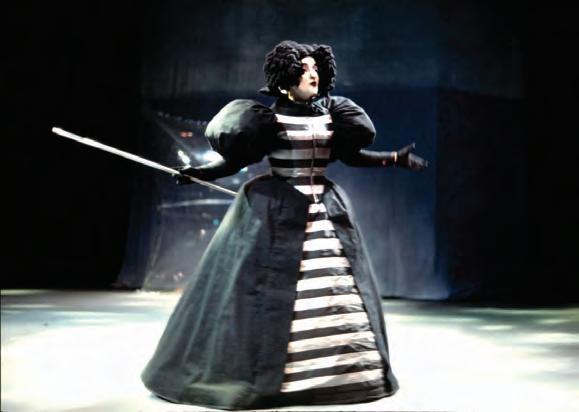
THERE WAS BIG NEWS in the autumn of the year as Center Opera prepared to launch its sixth season, a season that would include the premiere of a work by Minneapolis composer Eric Stokes, a serious satire titled Horspfal that would eventually be nominated for the Pulitzer Prize, and, as a finale, a double-bill of two one-act operas that would go on the road during the summer. Conducting the opening
production of the season, Mozart’s Così fan tutte, would be the company’s new music director, Philip Brunelle, a gifted, enterprising twenty-eight-year-old from Faribault, Minnesota, who had been a percussionist and pianist with the Minneapolis Symphony. Brunelle would spend seventeen seasons with the company and would go on to create his own internationally renowned concert series and chorus (VocalEssence), continuing a career as one of the most influential musicians in Minnesota.
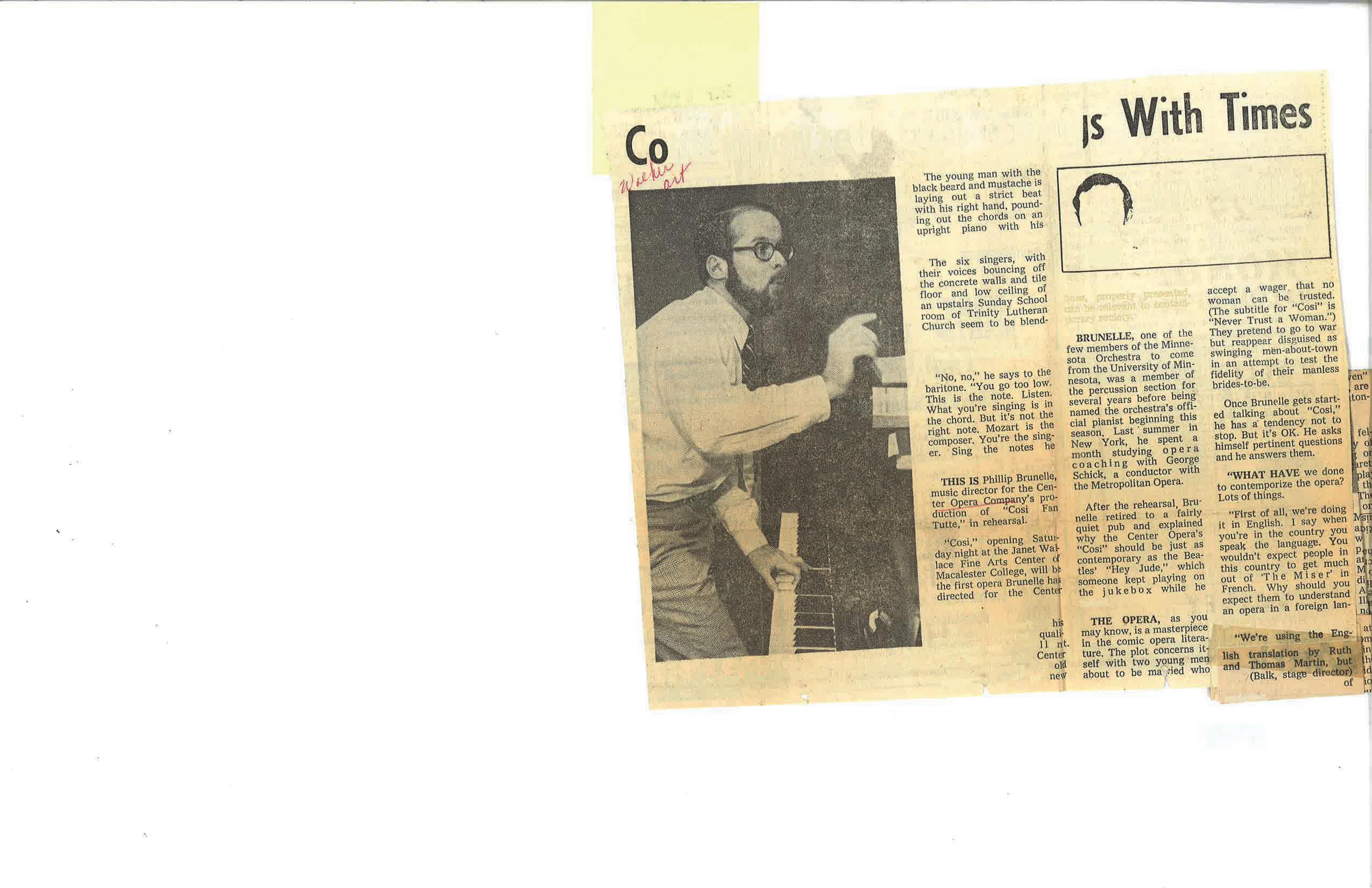
Born in Faribault, Minnesota, in 1943, Philip Brunelle has been a worldwide force in music, especially in the fields of opera and choral music. He started piano lessons at the age of four, and at nineteen he became a full-time member of the Minneapolis Symphony as a pianist and a percussionist. In 1969 he founded the successful Plymouth Music Series, now VocalEssence, which to date has commissioned more than 320 works. Brunelle first conducted for Minnesota Opera in 1968, a production of Così fan tutte, after which he was named music director, and then co–artistic director with Wesley Balk, a position he held until 1985. During those years, he conducted more than sixty productions, including many premieres. He has conducted operas and orchestras on six continents and has received five honorary doctorates as well as the Michael Korn Founder’s Award, Chorus America’s highest lifetime achievement award.
Seated in a conference room at Plymouth Congregational Church, where he has been choirmaster and organist since 1969, Brunelle reminisced about his seventeen years with Minnesota Opera—the trials and tribulations of a music director in an experimental opera company located in the frozen North.
Mike Anthony: Going back to your beginnings with the company, you were going from a full-time position with the Minneapolis Symphony to a part-time job with the opera company. Wasn’t this a professional risk for you and perhaps a personal risk as well?
Philip Brunelle: Both. And yes, it was. People told me I was crazy. They said, “You’re leaving the Minneapolis Symphony, the best-paying job in town for someone in the arts. How can you do that?” But I saw my future. I saw that my future was going to be in conducting and not playing percussion, though I’ve always kept up the piano.
MA: You studied conducting at the Metropolitan Opera in New York in the summer of 1968. How did that come about?
PB: In 1968, when the Met came to town, their assistant conductor, George Schick, called me up. “Mr. Brunelle, I am calling about your audition for the Rockefeller program at the Metropolitan Opera.” [. . .] He told me what to bring and to pretend that I was at the keyboard, playing the parts and coaching invisible singers. So I did it. At the end of the audition, he said, “Very good. Now in two weeks I will see you in New York.” [. . . ] I ended up spending the summer at the Met. It was a wonderful experience with him and the singers learning the standard repertoire.
When I came back at the end of the summer, John Ludwig called and said, “We’d like you to come and be music director of Center Opera.” And then he said, “By the way, I’m the one who recommended you for the Rockefeller program.” So then I started with the opera company, my first production being Così. Then I did Punch and Judy, which was a huge production at the Guthrie.
MA: Wasn’t this a dark opera with a lot of violence?
PB: It was very violent. Several of the set pieces were ten feet tall, and there was someone inside them, and they had to move around the stage and sing. It was quite dazzling.
MA: Doing opera at the Guthrie was a challenge. The standard joke was that the singers were onstage at the Guthrie and the orchestra was in downtown Osseo. Some thought the balance between orchestra and singers was sometimes uneven.
PB: It had a lot to do with the sets. If the back wall of the set was hard, that would keep the sound from going out, which is why I always pushed for as porous a backdrop as you can get. I recall productions there before I was involved where I could barely hear the orchestra because the set had been designed with no thought to the sound.
MA: Not only that, the singers had to contend with Bob Israel’s wild costumes.
PB: Oh, there were all kinds of outfits. We had everything from almost nude, with Vern doing Faust Counter Faust, to elaborate costumes like the ones in Punch and Judy. Actually, some of them were really sensational because in that era there was a real desire to bring together first-rate music, first-rate design, first-rate costuming, the whole bit.
MA: You conducted a number of new works during your years with Minnesota Opera. Which of them do you recall most fondly?
PB: Fondness? Well, there are several. Definitely, Argento’s Postcard from Morocco. Oh, what a wonderful piece. And at the same time came Transformations, Conrad Susa’s opera. Those were both great pieces. And then from both of them we got one magnum opus, from Dominick, The Voyage of Edgar Allan Poe, which is filled with great melody. I had the privilege of conducting it later in Gothenberg, Sweden. And then there was Conrad Susa’s Black River, another big production. And certainly when we had the opportunity to do some of the Mozart operas, it was a joy to do them too.
MA: People on the staff, younger people, mostly, ask: Why wasn’t Brunelle, with his vast amount of experience—some sixty productions—invited to guest conduct from time to time?
PB: In the years after I left and after Wesley left, it was a decision by the board and the staff that they needed to move in a new direction and forget about the past and move as if it were a new company. Many people, to this day, are surprised to learn that there was an opera company here from the ’60s on. They think of it as having happened only from the time the company moved into the Ordway.
So I left in ’85. And you know what? It was a great time to leave. I was there seventeen years. I had a wonderful time. The years that Center Opera was in existence put the name of Minnesota Opera on the map.
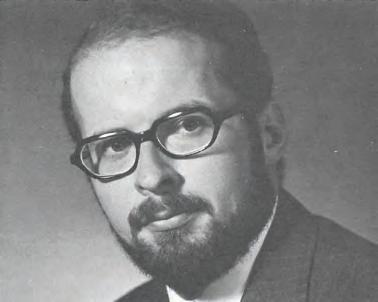

THE FINAL NEWS ITEM was a jaw dropper: Center Opera would end its association with the Walker Art Center. “This was when the old Walker Art Center was coming down,” said Gale Sharpe, a key figure in the company’s history who at the time was John Ludwig’s secretary and would eventually become company manager until her resignation in 1980. As Sharpe recalled it, “Martin said, ‘You know, this has been an amazing experiment that has been way more successful than any of us anticipated. However, I need to use our funds to buy art, not costumes.’”
Said Hintz, “Martin realized that the opera company was getting too big, and it wasn’t appropriate for there to be a large opera company growing up inside a museum. So he gently pushed us out, and we left the protective cover of the Walker Art Center, set up our own independent board as a nonprofit foundation, and John came with us.”
Though the split, by all accounts, was amicable, there was no denying that this was a bold move for a small opera company barely five years old. “It was a huge risk for us,” said Philip Brunelle. “But at that point John felt he had enough financial support in the community and also from corporations to do it.”
“We could have said ‘It’s been nice’ and shut the door, and that would have been the end of Center Opera,” Sharpe said. “Or we could go off on our own, create our own board of directors, raise some money, and become whatever it is we would become. John asked me at the time if I was willing to do this with him. He said, ‘I can’t guarantee you two weeks or two months or two years. I have no idea what’s going to happen. But would you do this?’ I said, ‘Give me the weekend to think about it.’ I came back the next day and said, ‘I want to do it.’ And we created a new board and Bucky Weil (Fred Weil Jr.) was our first president.”
Center Opera’s departure from its parent organization was announced in the autumn of 1968 but didn’t take effect until a year later, and the name of Minnesota Opera wasn’t adopted until 1971. While the new museum was under construction, the staff moved into temporary quarters over the State Theater in downtown Minneapolis. Sharpe and John Ludwig, who were still employees of the Walker, moved downtown with them. The Walker covered their payroll that first year so they could devote themselves to fundraising. That’s when the Ford Foundation became the company’s major benefactor. “I don’t think we would ever have made it without the Ford Foundation grant,” Sharpe said.
In November, just before the season opened, Balk spoke in an interview about the company’s departure from its patron, the Walker, saying that it was a positive move, and that it would allow the company more freedom to choose repertoire. “The company,” he said, “realizing that it doesn’t have the range for Verdi, will continue to focus on the eighteenth century and on contemporary works, but the recent operas may be less avant-garde and less oriented to the visual arts.” He mentioned doing Vaughan Williams’s Sir John in Love, which, he said, “would never have interested the Walker.”
The mention of Sir John in Love is revealing. Surely just about anything that Vaughan Williams composed would lack the “edge” that Martin looked for in contemporary art. Moreover, the fact that Balk would suggest such a conservative opera as Sir John, which the company did present in a concert version during the 1970–71 season, indicates that he was hardly the firebrand aesthetic radical that many people considered him to be.
BALK’S TAKE on Mozart’s Così fan tutte was performed in English and retitled Never Trust a Woman, which gave it the aura of a spicy Rock Hudson–Doris Day film comedy. It was updated from eighteenth-century Naples to Vermont in the late 1960s. Costume designer Jerre Hollander dressed the men in Nehru jackets, medallions, long hair, and drooping “New Left” mustaches.


John Harvey described the production as “bright, ingenious, imaginative, fast-moving, smartly sung, and fun.”
When Balk staged Così at the Santa Fe Opera the following summer, he returned the setting back to eighteenth-century Naples. It may be that the management in Santa Fe—John Crosby at that time—insisted on the original setting, or that Balk simply wanted to compare the two versions. He seldom updated the settings of the operas he worked on, a common practice among directors these days. Balk wasn’t a postmodernist. He didn’t mix period styles of costume or setting, nor did he try to tell two stories at one time. His detractors thought his focus on the theatrical values of the operas he directed came at the expense of the music. Balk thought he was keeping music and drama in balance, that he was simply taking a fresh look at the more familiar works he directed. His view prevailed, and then, in later years, it didn’t.
The production had a longer life than anyone anticipated. After the six performances at Macalester, the show moved to the one-hundred-seat Cricket Theater, where they did eight more performances. Manager Bill Semons tore out the theater’s rear wall to accommodate the singers and musicians.
THE EVENT OF THE SEASON —perhaps of the decade—was Horspfal by Eric Stokes with a libretto by Alvin Greenberg, given its premiere in four performances at the Guthrie Theater in February in a brilliant and provocative production staged by Balk, designed by Robert Israel, and conducted by Tom Nee. The subject is the Native American, the theft and ultimate destruction of his land, the land symbolized by a huge bed covering the entire stage. The Native American’s home is soon invaded, respectively, by missionaries, ethnomusicologists, census-takers, exploiters, camera-laden tourists—even Betsy Ross and, on film, John Wayne. He is eventually booted out of his once pleasant home, which is now covered with beer cans and billboards and signs saying “Beautify.”
The work’s title we take to mean horse opera plus Parsifal, referring to the pure fool of legend. Horspfal was satire and social protest in the form of a pageant structured as if it were a film. Audiences and critics from everywhere were impressed. One of those in the audience was a young Libby Larsen, who would eventually become one of the most important composers of her generation. Here’s what she remembers.
My seat for the premiere was about ten rows from the thrust stage and just to the left of center—whatever center was. There was no center stage in this production. There was a one-set design dominated by a gargantuan bed with a headboard extending so high above it that you had to crane your neck to view the action on top of it. Designed in this were two or three designated playing areas set at odd angles. The theater’s entrance ramps were integrated into the set and used as playing areas and there were two large movie screens mounted above the bed. The moment you took your seat, no matter where you were sitting, your sight lines defined your unique perspective. Every seat was to be inhabited by an individual and every individual’s perspective was true. What has remained with me all these (fifty) years is this: if you were in the audience for Horspfal, without your suspecting it, you participated in the opera in the role of spectator/witness/protagonist/antagonist. You were responsible to (not for) your own perspective. The piece was conceived, designed, and produced to do exactly this. Brilliant, and some people say maybe ahead of its time. But who knows what the time is?
Cynthia Stokes, Eric’s wife, served as principal flute in the opera orchestra for several decades, starting with the company’s premiere in 1964. She played in the orchestra for Horspfal and said it was a challenge. “Eric used three conductors,” she said. “The music would be in one tempo here and another tempo over there. It was a difficult work to produce, which is why it didn’t get subsequent productions, though it did go to New York for a few performances at Hunter College. Various people contacted Eric later, and they would say, ‘If you could just rewrite one of the arias for a big-name singer, we’d put it on.’”
The sixth season ended in a scramble of last-minute changes. Plan A was that the company would present a tour show, a double bill of one-acts—Bartok’s Bluebeard’s Castle and Ravel’s L’heure espagnole —that would also serve as a season finale. By spring, however, it was clear that there wasn’t enough money to do either of them. The Rockefeller money had run out and the Walker was no longer in a position to make up the deficit. Plan B looked more feasible: revive the company’s biggest hit, The Wise Woman and the King, do it on the cheap with a reduced orchestra and Richard Randell’s junkyard railroad ties, put it on at Macalester College for four nights in June, and the result would almost look like a season finale.
It worked.
Balk added more pieces of what he described as “technological junk” to the set, which was supposed to represent a society in decay under its corrupt King. And they kept the King’s crown from the first production—plastic picnic forks melted together. Barbara Brandt played the Queen and James Bowers the King. “The cast is fully as able as in the 1965 production (in some instances, better),” said John Harvey, “and, all in all, it’s a whale of a show.” He missed the sound of the brass instruments, he said, “but the reduced orchestra worked surprisingly well.” There were just three players: Philip Brunelle on percussion and Yale Marshall and Celeste O’Brien on keyboards.
Wise Woman brought to a close the company’s sixth season and the first phase of its life—its adolescence, one could say, since it seems to have skipped childhood. Center Opera had achieved considerable—and in a few cases, international—renown, and attracted a small but devoted audience, and it did so on a tiny budget. Moreover, it walked away from its parent, the Walker Art Center, with no debts. It owed nothing, except maybe a thank-you to the Walker, the Center Arts Council, and to all those volunteers, among them the city’s first lady, Mrs. Arthur Naftalin, who ironed costumes on opening night.


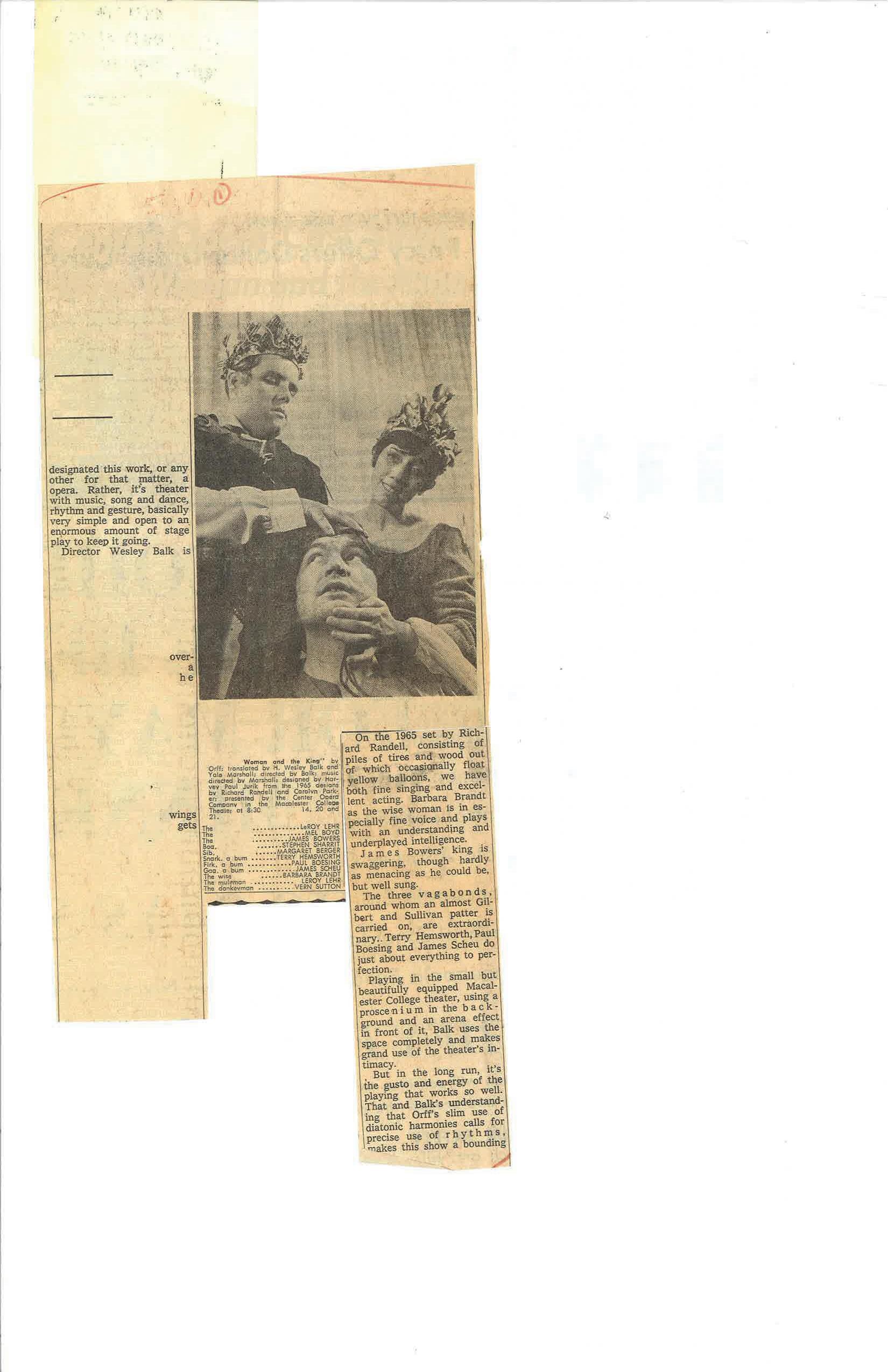
Looking back on the Center Opera saga some forty years later, Martin Friedman wrote that the whole venture seemed to him like a dream. “Did it really happen? Yes,” he said.
Did a contemporary art museum really help launch a chamber opera company next door? Yes. And was it worth the effort? Definitely, yes. The Walker Art Center’s association with the Center Opera Company was a felicitous aberration. It was a vivid period not just in the evolution of the opera company but also in that of the museum. The formation of the opera company greatly expanded the Walker’s artistic purview. While it had previously sponsored new works by artists in music and theater, as well as the visual arts, this was the first time it brought these disciplines together, and on such a scale. Everybody gained: the singers, the directors and, of course, the painters and sculptors who tried their hand at theater design. The Walker Art Center certainly gained in that this was a prime example of bringing young artists in various disciplines together. The audiences for these collaborations also gained by experiencing opera in new ways. The Center Opera Company was more than a dream. It was a singular moment in the history of the Walker Art Center.
“The Center Opera Company was more than a dream. It was a singular moment in the history of the Walker Art Center.”
—Martin Friedman, Director, Walker Art Center
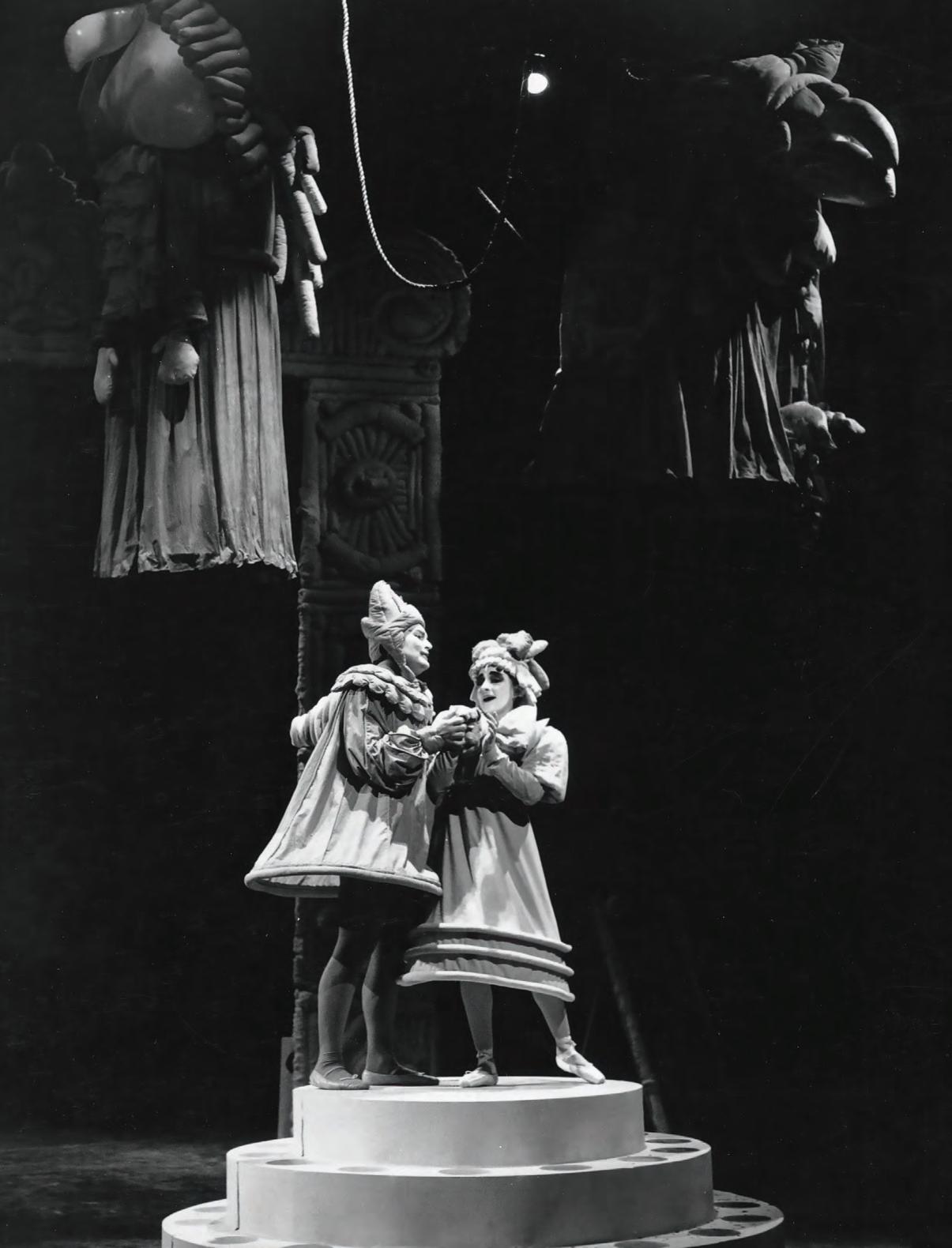
Season Seven
Season Eight
Season Nine
Season Ten
Season Eleven
Season Twelve Season Thirteen Season Fourteen Season Fifteen
Sixteen
WHEN CENTER OPERA hit the ground running in January 1964, its success came as a surprise. This wasn’t opera country, or at least it hadn’t been thought of that way. And the productions neither looked nor sounded like what the Metropolitan Opera had been presenting at Northrop Auditorium each spring or what the St. Paul Civic Opera had been putting on since 1933. The shows were small, and they seemed intimate on the thrust stage of the Guthrie Theater. The sets and costumes were bizarre, and the works themselves were new or not commonly performed. And yet people responded favorably and were intrigued. The reviews were positive, and critics came from all over and heaped praise on this small company with its tiny budget.
“It is hard—no, it is impossible—to think of an opera company in America that has this particular approach,” said the New York Times. The Chicago Sun-Times echoed this praise, saying, “The group has acquired a reputation as the most innovative, intellectually alive opera company in America.”
It soon became clear that the company would face a brighter future—or at least some kind of future—if it separated itself from its patron, Walker Art Center. The company at that
point had formed a board of directors, had named Bucky Weil board president, and was spending the year raising money. In its short life, Center Opera had presented twentyone productions, of which four of were commissioned world premieres and two American premieres, a record for that period only surpassed by New York City Opera.
Looking back, it makes sense that an experimental opera company would be founded in the freewheeling ’60s, a time of social change, student unrest, peace marches, bell bottoms, happenings, hippies, acid rock, and the counterculture.
The ’70s, it was commonly said, was a quieter time, more introspective. It came to be called the “Me Decade,” a term coined by the journalist Tom Wolfe to refer to a period when self-development and a heightened individualism seemed to replace political and social concerns and the search for community. Generally, the opera world floats along blithely unconcerned with passing trends and social movements. Opera, after all, began as a diversion for aristocrats, and though opera composers from Verdi up to the present time have written works with political themes, the form has never shaken its elitist image. Center Opera fought that image, and its initial audience was less a moneyed elite than an educated, intellectual segment of the population. It was a varied group,
to be sure, but these weren’t, by all accounts, the fans who dressed up for the Met tour in the spring and at the end of the show threw bouquets of roses at Joan Sutherland.
Balk’s productions were seldom overtly political, though his instincts leaned toward the iconoclastic and the irreverent. He wanted to shake things up and make people see the world in new ways. His stance could be called anti-bourgeois even though he worked in the most bourgeois art form of all: opera. He identified with outsiders. His Don Giovanni in the 1973 production was no villain. He was a hero, a rebel, a life force. He was Marlon Brando on a motorcycle. The squares like Don Ottavio plotted to take him down, and they had to do so or else they might lose their comfortable place in society. In the end, they won.
Balk explored these ideas throughout the “Me Decade,” and with varying success. For Center Opera, soon to be Minnesota Opera, the ’70s was a time of accomplishment and expansion. The company premiered four major new works along with two others that were soon forgotten. It hit the road in a big way, taking its most inventive productions to both coasts and to Texas and Chicago, getting mostly rave reviews. This fulfilled one of Balk’s longtime goals, the establishment of a resident ensemble, with all that format’s pluses and minuses. Soon after that, Center Opera devised the Opera Studio, a training program for young performers, many of whom went on to substantial careers. The company found comfortable, roomy office space on Grand Avenue in St. Paul and spent the decade trying—with no success—to find a permanent performance space, one that didn’t have leaking and noisy water pipes like the Cedar Village Theater, or deadly dry acoustics like O’Shaughnessy Auditorium. And then, halfway through the decade, the always recklessly managed St. Paul Opera went belly-up, leaving Minnesota Opera the One and Only Opera Company in the Twin Cities.
composer Werner Egk, 17 Days & 4 Minutes, and another, by the Englishman Harrison Birtwistle, Punch and Judy, was an abrasive study in violence and mayhem. At the work’s premiere in England a year earlier Benjamin Britten disliked it so much that he walked out before it was over. The results were provocative but not necessarily the right choice for a company looking to attract a new and larger audience. Of the low turnout, Gale Sharpe said, “That was the year we initiated SCOFF, ‘Sample Center Opera for Free,’ because there were, like, seventeen people in the audience, and that was at the Guthrie, where it was hard to hide a small audience.”
Punch, in the Birtwistle opera, embodied in another tourde-force performance by Vern Sutton, begins the action by burning his stuffed-doll of a baby. He then proceeds methodically to do away with his wife, his doctor, his lawyer, and even the narrator while pursuing Pretty Poll, a ballerina-like creature played to perfection by the coloratura soprano Sarita Roche, who, it is alleged, hit a high G-sharp every night of the run. Birtwistle’s score, described as “ninety minutes of squealing and screaming” by Donal Henahan of the New York Times, was “the most difficult we’ve ever done,” said Philip Brunelle, who conducted it and ran up a considerable phone bill talking to Birtwistle in England about mistakes in the score. Robert Israel adorned the stage with puppets nine feet tall, adding an extra element of strangeness to the production. Harold Schonberg of the New York Times lauded Brunelle’s
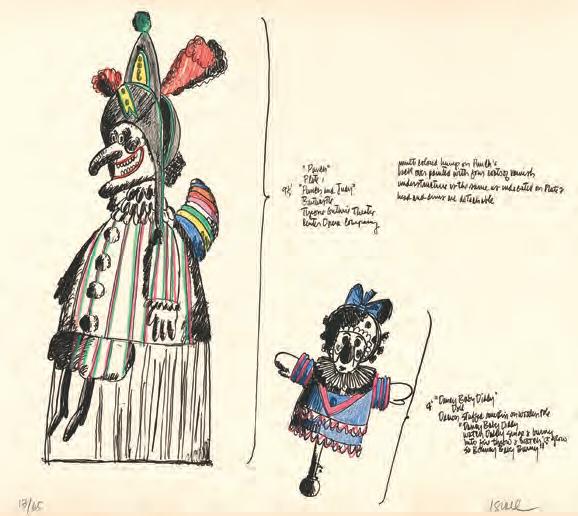
Minnesota Opera gained prestige and visibility during the ’70s. Behind the scenes, financial problems remained a growing source of anxiety, though the threat of bankruptcy didn’t appear until the early ’80s. And there was a nagging concern about the audience—it wasn’t growing. Given these challenges, most companies would likely have gone into crisis mode and put on a long run of La bohème just to balance the books and attract more conservative opera fans. Instead, Center Opera dug in, remained on course, stayed true to its mission, and for 1969–70, its first season of independence from Walker Art Center, put on its boldest lineup ever: two new operas and two recent works that were receiving their American premiere. One was a lighthearted piece by the German Punch and Judy set designs by Robert Israel, 1970
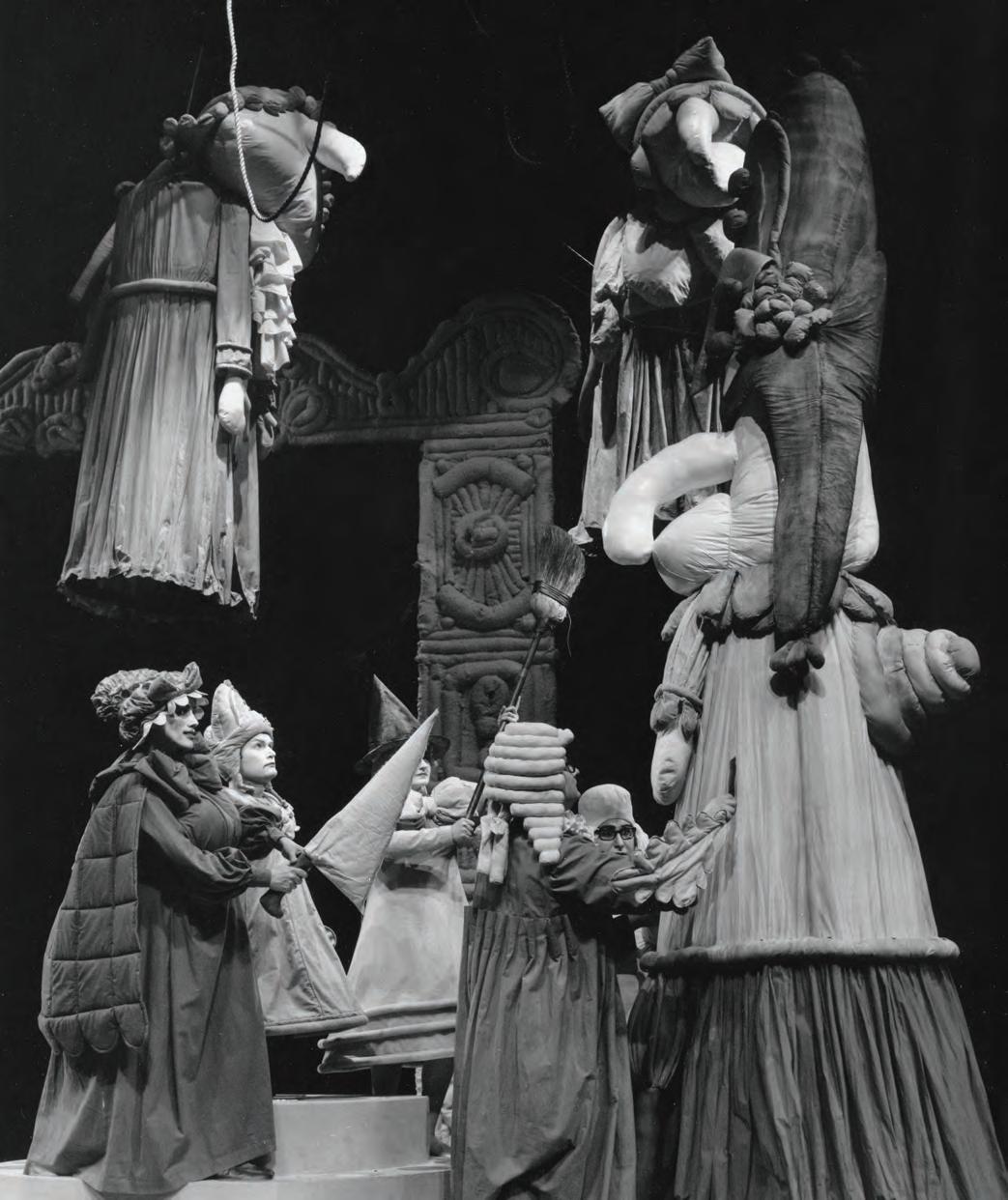
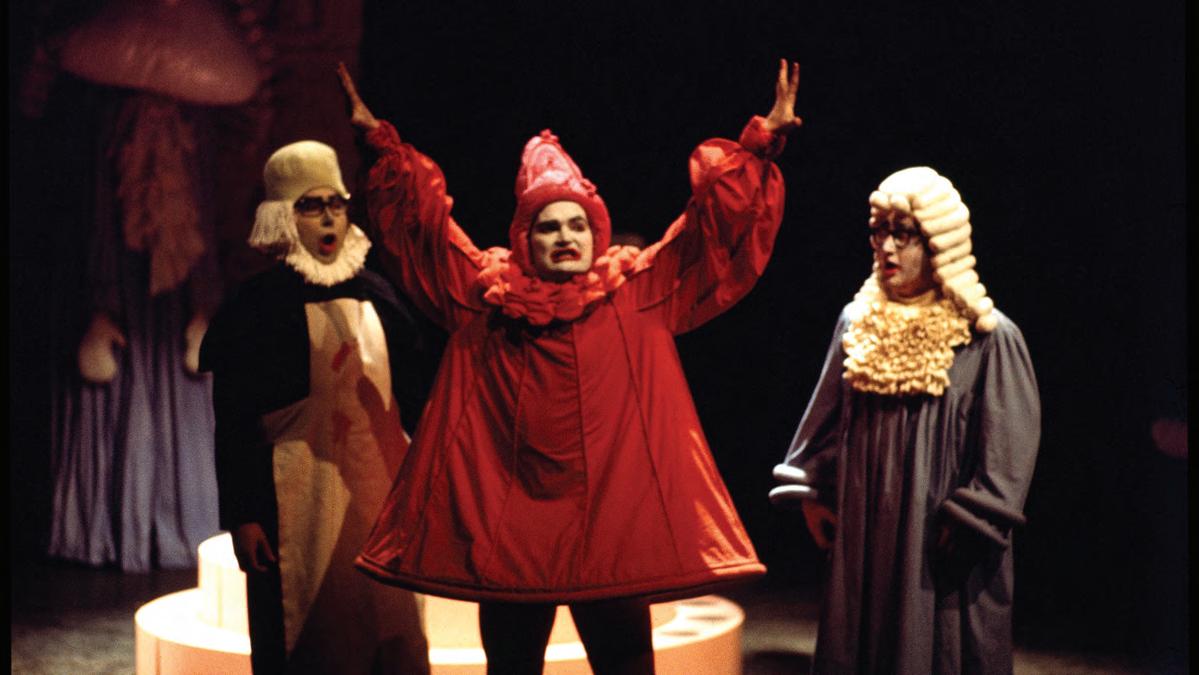
conducting and said, “Only a small company with plenty of rehearsal time could have achieved this superior kind of presentation in so difficult a work.”
The season opened on December 5 at the Cedar Village Theater, the company’s least favorite venue, with a new work, Oedipus and the Sphinx by Yale Marshall and Wesley Balk, a retelling of the Oedipus story by Sophocles, followed by a bawdy satire on the same story. Certain sections of the score were left blank so that the singers could improvise on the text. The idea of opera singers improvising became an obsession of Balk’s and would culminate in an entire opera being made up on the spot in a piece called The Newest Opera in the World, given during the 1973–74 season. Then came Werner Egk’s popera, as it was called, 17 Days & 4 Minutes, a good-natured look at the Circe story in Homer’s The Odyssey, followed by The Wanderer, an amateurish folk opera by Paul and Martha Boesing. Roy Close in the Star found The Wanderer ’s subtitle, “A Ballad of Now,” pretentious. The cast, it seemed to him, was more “then” than “now,” while the younger singers onstage fell in the category of “not yet.”
More important than the individual works in the 1969–70 season was the creation of the company’s resident ensemble, the first in the nation to specialize in contemporary repertoire. The group of seven was hired to work from November
1969 through March 1970. They were paid $80 a week for twenty-six performances. The budget called for roughly one hundred hours of rehearsal for every hour on stage, a ratio unprecedented in the opera world, except in selected opera houses in Europe such as Walter Felsenstein’s statesupported Komische Oper in East Berlin, a big influence on Balk. The members of the first resident ensemble were Sarita Roche, Barbara Brandt, Vern Sutton, Bonita Gilbert, Frederick Rees, Paul Boesing, and Leroy Lehr.
Later that summer, Ludwig told the Philadelphia Enquirer that the Center Opera audience was getting younger. He mentioned Punch and Judy, a score the singers found to be “harsh.” “Opening night was a drag,” he said, “but by the fourth performance the kids had found us, and they loved it. It’s not rock and it’s not commercial music, but they loved it. In its bleakly humorous way, I guess the piece is contemporary.”
The kids may have loved it, but there weren’t enough of them. Punch and Judy drew only one thousand people over the course of four nights at the Guthrie, which was 17 percent of the house, not a healthy number for any theatrical enterprise. “I think we have to admit,” Ludwig told the Tribune, “there were mistakes in repertory choices.” He added that he hoped the upcoming eighth season would offer evidence of better choices.
THE EIGHTH SEASON would include two commissioned works: an amiable holiday show by ensemble member Yale Marshall and a collaboration between Wesley Balk and the composer John Gessner titled Faust Counter Faust, which combined music and text from the various Faust legends. The two other works scheduled were Monteverdi’s The Coronation of Poppea and a revival of The Mother of Us All, which had been a big hit for the company in the 1966–67 season. And for the first time in its short life the company hit the road, taking its most important productions to significant places in the spring and summer. The nation was ready and waiting, according to Harold Blumenfeld of the Los Angeles Times, who wrote, “The Center Opera is unique. It is high time its major productions are toured to our major operatic centers, for American opera entrepreneurs and buffs have much to learn and enjoy from its work.”

The season opened with a one-nighter on November 21 at the Guthrie, a concert version of Vaughan Williams’s Sir John in Love, based on Shakespeare’s Falstaff tales. The concert was a collaboration with the St. Paul Chamber Orchestra, led by its new assistant conductor Edouard Forner. The performance was warmly praised, especially Forner’s conducting and the portrayal by baritone Clyde P. Walker of Falstaff. Walker, in the words of Peter Altman of the Star, sang “with warmth and wit, taste, and security.” Walker’s only fault: he wasn’t fat enough to portray this famously rotund character. Another debut was that of the Opera Chorale led by Dale Warland, which Allan Holbert called “the finest opera chorus I’ve heard locally.” The critics’ only complaint: the production was given just once.
The company opened the main part of its eighth season on December 12 at Hennepin Avenue United Methodist Church with an opera aimed at the holidays, Christmas Mummeries and Good Government. The show was based on two dramatic


works: a short medieval mummers' play, St. George and the Dragon, and a contemporary drama by the English playwright John Arden, The Business of Good Government, which tells the Christ story as realistic drama. Marshall added music of his own and arrangements of carols and folk songs. The result was not much of an opera nor really a theater piece. The singing, though, was much praised. Making her company debut in the role of the Virgin Mary was Janis Hardy, a young mezzo-soprano from Roseau, Minnesota, who would go on to perform with the company for seventeen years, becoming one of its most accomplished and popular performers.
Faust Counter Faust, which opened at the Guthrie Theater on January 30, 1970, and later performed in San Francisco, New York City, Washington, DC, and elsewhere, was Balk’s most ambitious work to date. The production itself was probably ahead of its time in its use of multimedia effects. The
settings were flashed onstage by fifteen projectors using five hundred slides, each appropriate to whatever scene was going on. Sets and costumes were pure white, emphasizing the atmosphere of madness and dangerous experiment.
The work is an opera-within-an-opera, the setting of which is an insane asylum, where the latest Faust, named John, who believes himself to be the reincarnation of the original, is incarcerated along with all the past Fausts of literature and legend. (Loudspeakers at the start identified the show as “an experiment in psychodramatic therapy.”) John, played with fierce intensity by Vern Sutton, is trying to prove that previous Faust stories are inventions of the devil to obscure the real harm in Faust’s diabolical pact. Faust sought not love or riches, but the power of knowledge, which has led to the menace of unchecked technology and the ruin of the environment. Faust, the opera

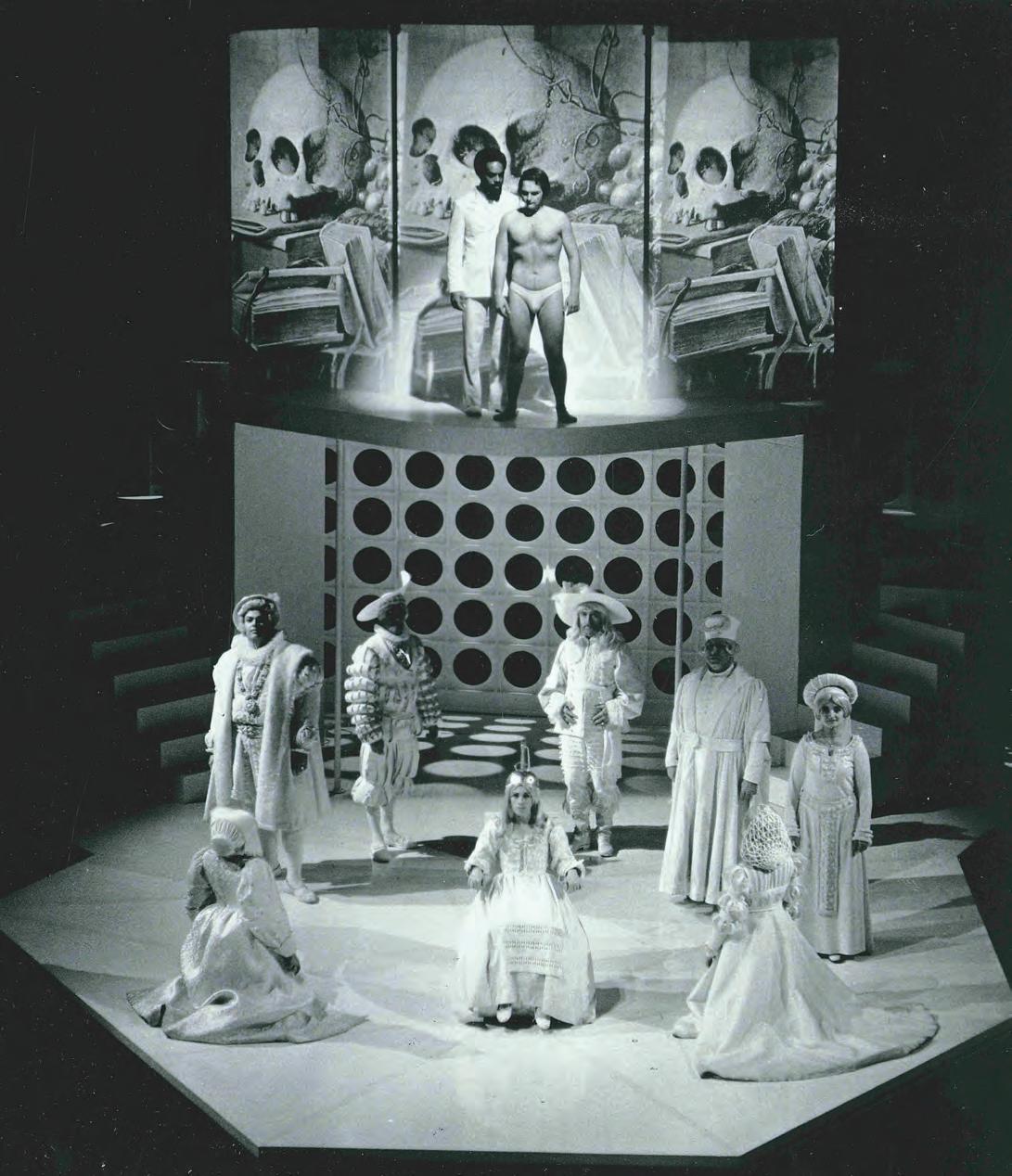
concludes, is responsible for the atomic bomb. At the end, the hospital attendants give the new Faust a sedative and carry him out.
Reactions both locally and in the various tour cities were mixed, ranging from unbridled enthusiasm to bewilderment to one opening-nighter in San Francisco who stood and booed loudly all during the curtain call. The critic of the San Francisco Examiner called the opera “sharp, nervy, and interesting.” Reacting to the performance in August at the Lake George Opera Festival in New York state, the critic there called the show “mad, beautiful, shocking, droll, serious, and funny.” John Rockwell of the Los Angeles Times called the opera “a pretentious bore.” Paul Hume of the Washington
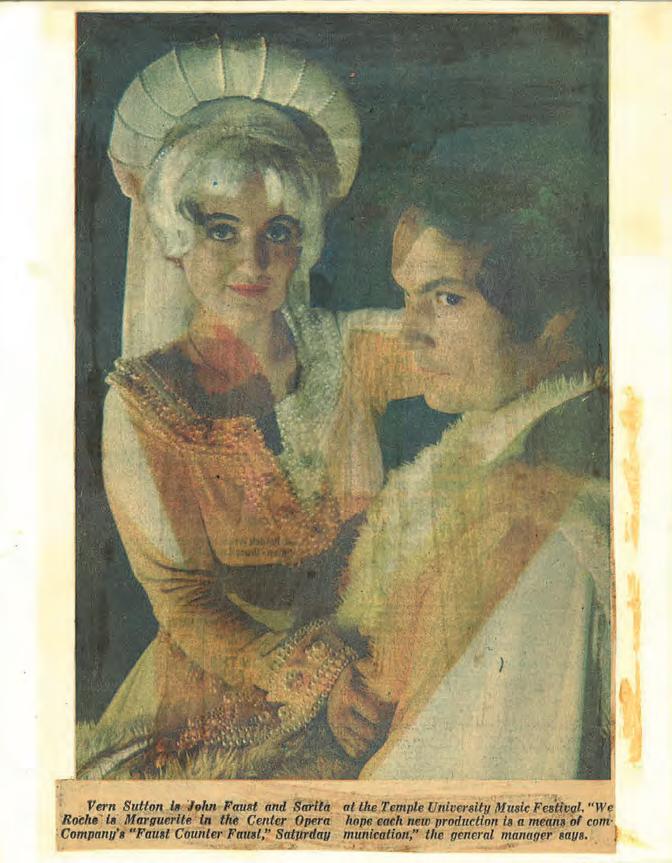
Post described the cast as “one of the most perfectly disciplined troupes to be seen on any dramatic stage.”
The season ended with Balk’s revival of The Mother of Us All, presented in six performances at the Cedar Village Theater and then taken on the road, alternating with Faust Counter Faust, and performed in Baltimore, the Lake George Opera Festival, New York City, and Washington, DC. This was a smaller production, more suitable for touring than the one given in 1966–67, with fewer singers, a smaller orchestra, and a staging that, rather than a pageant, was dreamlike and surreal.
On August 5, 1971, board president Bucky Weil got a telegram from New York City. It said,
NEW YORK PERFORMANCES GET STANDING OVATION. STOP. TIMES SAYS “GREAT WIT AND PANACHE.” BALK SCORED TRIUMPH UPON TRIUMPH. BRUNELLE ASTONISHING . . . LUDWIG “ONE OF COUNTRY’S MORE ASTUTE MANAGERS.” PHILADELPHIA OPENING FRIDAY. HOME SUNDAY. REGARDS. GALE SHARPE.
In June, while Center Opera was performing on the East Coast, the Twin Cities’ other opera company gave the premiere of Lee Hoiby’s Summer and Smoke, an opera based on the play by Tennessee Williams. This was without doubt the short-lived St. Paul Opera’s finest hour. The play lends itself to musical treatment, and Hoiby was a good choice to do it. He was a master of word-setting, and his predilection for a gentle lyricism capable of rising to passionate outbursts in the manner of Samuel Barber gave an emotional weight to the story and a feeling of compassion for its characters. The result was a lyrical, gracefully written treatment of a wistful story about life in Mississippi around the time of World War I. Lanford Wilson, soon to become an important playwright, wrote the poetic libretto, adhering closely to the play. The soprano Mary Beth Peil, who in later years returned to play the lead in Minnesota Opera’s Kiss Me Kate, created an indelible portrait of Alma Winemiller, the straitlaced, sensitive minister’s daughter who can’t realize her love for the young Dr. John Buchanan until it’s too late. John Reardon displayed his resonant baritone in the role of Buchanan. Frank Corsaro, one of the country’s most distinguished directors, staged the opera, showing an assured sense of movement and space. Igor Buketoff was the conductor. Tennessee Williams showed up at O’Shaughnessy Auditorium on opening night, looking happy. “It’s just beautiful,” he said at intermission when asked about the opera.
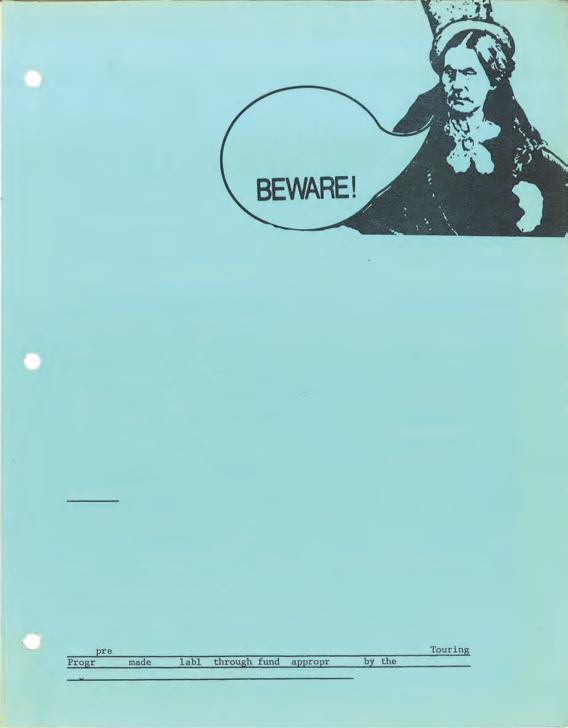
SEVEN ODD-LOOKING CHARACTERS sit in a railway station in Morocco—“or someplace hot and strange, like the interior of a glass-covered pavilion or spa.” They begin to probe each other’s fears and vulnerabilities while guarding their suitcases, which contain “some secret or lack of secret.” The time is 1914. On this thin thread of a setting John Donahue’s surreal text was spun, and on that text Dominick Argento wove ninety minutes of beguiling music, a score rich in allusions and etched in a rainbow of styles—sultry tangos, impressionism in the manner of Ravel, Viennese operetta, some of it eerie and much of it captivating.
Postcard from Morocco, premiered at the Cedar Village Theater on October 14, 1971, became one of Center Opera’s most lasting contributions to contemporary American opera. It has received numerous productions around the world. It was the work that made Argento’s reputation nationally, and it was the opera, Argento said, in which he found his voice as a composer. The production, which Donahue directed, was sensitive to every nuance and gesture in the music and in the text. The seven characters are meant to be symbols (of what is never clear), and yet, in the premiere production they came across as undeniably human, lonely people hiding behind their defenses, fearful of contact. The singers, all in fine vocal form, were Barbara Brandt, Barry Busse, Michael Foreman, Janis Hardy, Yale Marshall, Sarita Roche, and Vern Sutton. The performance was astutely paced by Philip Brunelle, who drew precise playing from the eight-member orchestra. Postcard was recorded in Minneapolis shortly after the premiere and was taken on tour the following spring and summer.

In January the company collaborated with the St. Paul Chamber Orchestra in a concert version of Stravinsky’s The Rake’s Progress, presented at O’Shaughnessy Auditorium. According to reports, the orchestra’s playing, with Philip Brunelle conducting, was rough. Beverly Siebert in the Tribune said Janis Hardy, playing the bearded lady, gave “the only really operatic performance of the evening— full-throated and dramatic, yet lyrical and sympathetic.”
Apart from some coordination problems between singers and orchestra—always a potential problem at the Guthrie— the company’s production of The Marriage of Figaro, which closed the season, was a success in nearly all respects. The attractive sets and costumes were designed by John Conklin. Robert A. Buckley did the lighting. Philip Brunelle’s pacing of the music was shrewd, and the St. Paul Chamber
Orchestra played with energy and grace. Three of the principal roles were sung by imported performers: Timothy Nolan (Figaro), Carol Wilcox (Susannah), and Nancy Deering (Cherubino). All gave satisfying performances.
The company was intent on proving with this production that they could do standard repertoire in a smart and stylish manner but without any heavy concepts. Balk said as much in an interview that appeared right before the show opened. Experimental works such as Oedipus and the Sphinx, The Wanderer, Faust Counter Faust, and Postcard from Morocco, though they were of national importance, have led Center Opera too far away from audience appeal, he said. “We have to balance our need to be creative with the needs of our audience and our potential audience. Figaro is an attempt to gain back some of those people who shied away from our more experimental work. Also, young singers or actors need to work on the classics to grow.”

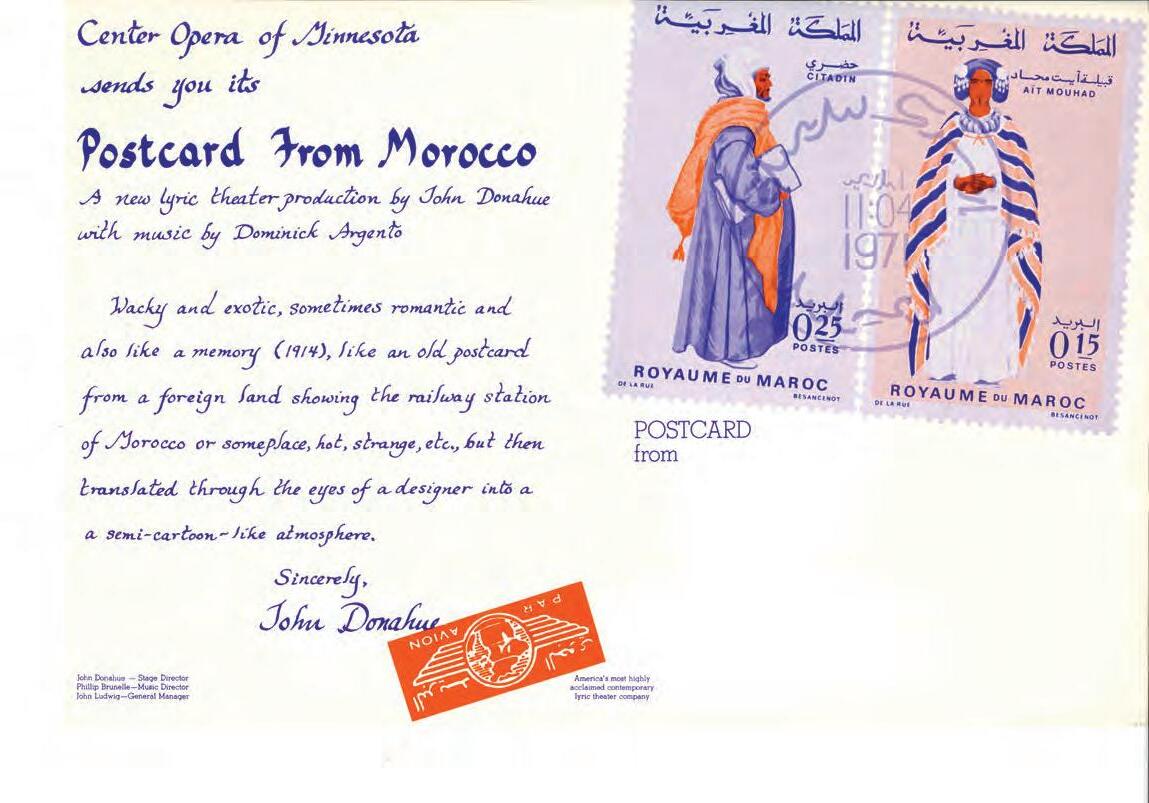
It was clear that the company had been playing to too many empty seats in recent seasons. Balk, Ludwig, and Brunelle were worried, and so they had planned a season that was more audience friendly. And the surprise is, it worked. Ludwig glowed as he went over the figures for 1971–72. Total attendance was twice that of 1970–71.
Ludwig’s reaction: “Things are looking up after nine years.”
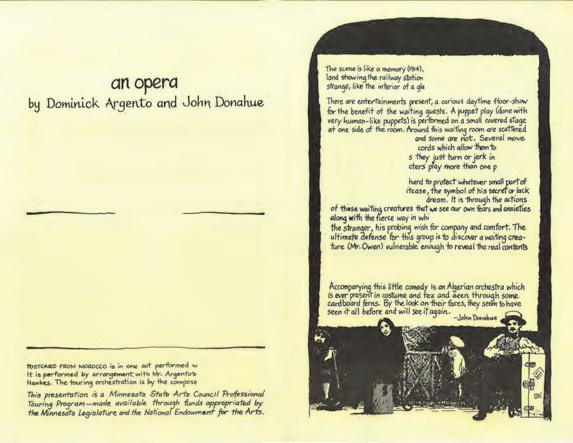
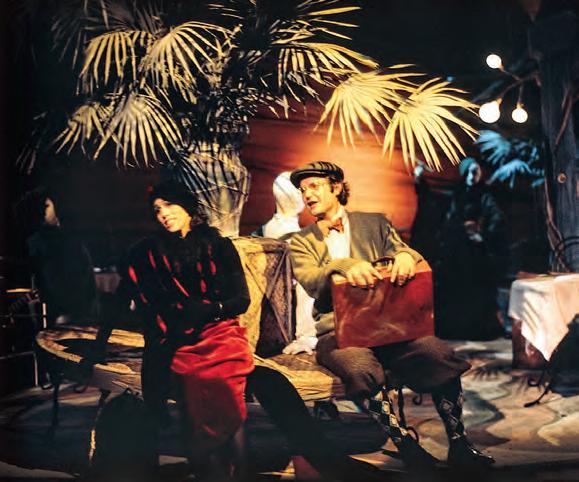
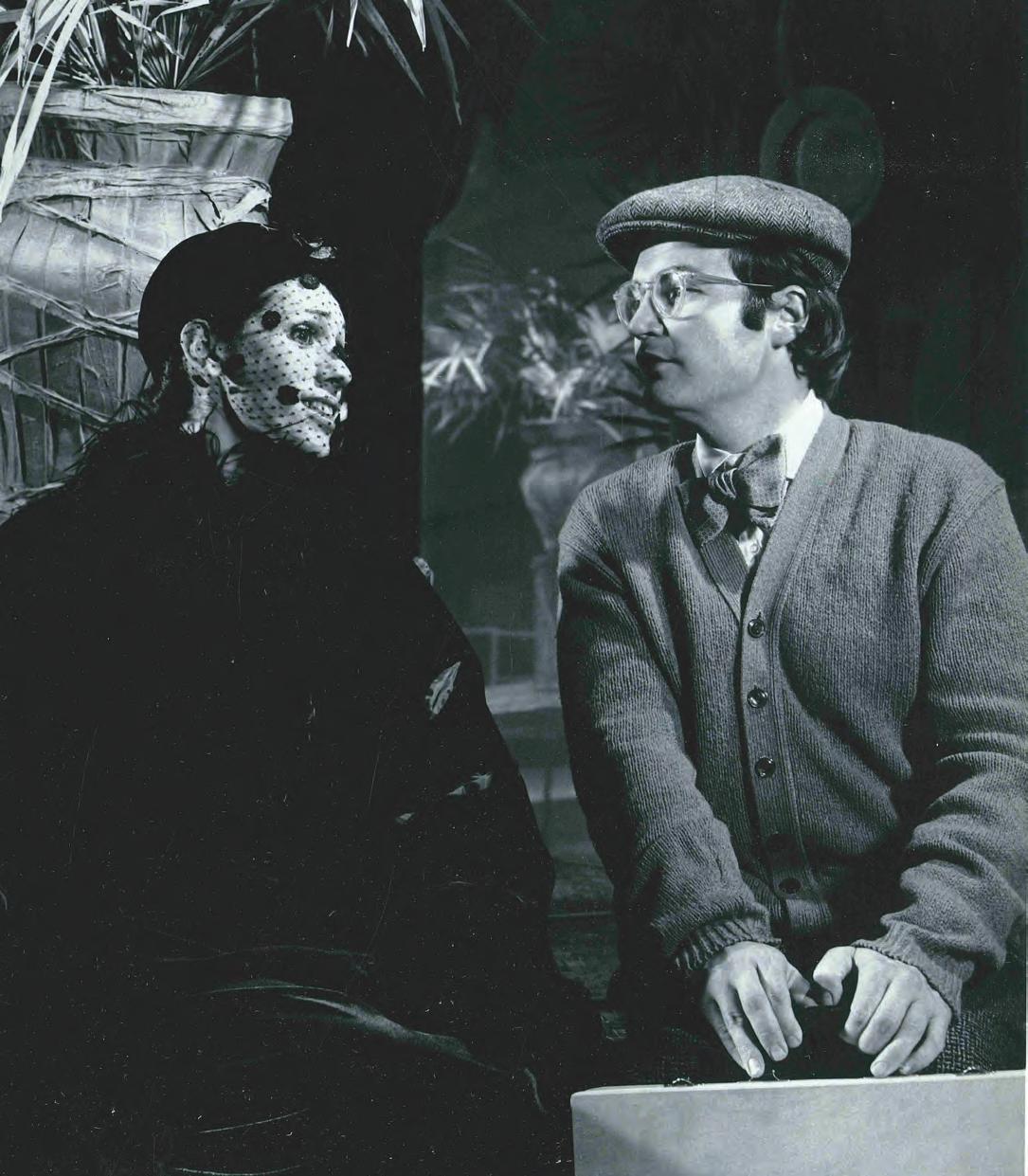
THE TENTH SEASON was chock-full of events and razzledazzle. First of all, this was no longer Center Opera; the name, as of October 1972, was Minnesota Opera. With the increase the past three years in touring, the opera board thought the company needed to be identified more with the region than with a certain museum and hoped that this change would enhance fundraising throughout Minnesota. It had become clear that portions of the public still thought of the company as part of the Walker Art Center or, possibly, given all those performances at the Guthrie Theater, that it was somehow an offshoot of the Guthrie. The change was not without risk. Ludwig and the board were no doubt aware that the Minneapolis Symphony’s name change to the Minnesota Orchestra just a few years earlier had caused problems along with resentment among the musicians that lasted for decades. The board’s view was that the situations were different. The Minneapolis Symphony was a name that had been known around the world for sixty-five years, largely due to the continued sales of its recordings on the Mercury label, whereas the Center Opera name was barely a decade old, and in retrospect the name change doesn’t appear to have caused any confusion.
Later in the season the company launched its Opera Studio, a program offering professional training for American opera directors, conductors, and singers. The National Opera Institute funded the program—three weekly sessions of three hours each—and it was to be supervised by William Huckaby as music director and David Shookhoff as stage director.
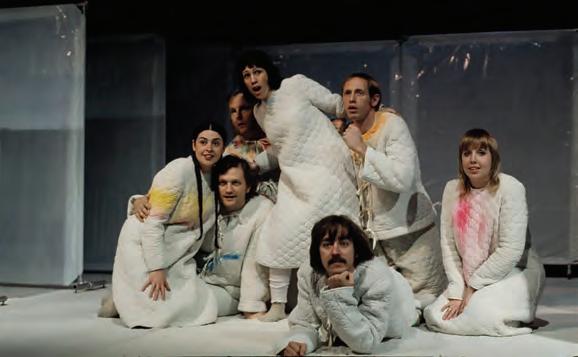
The first participants were mainly graduate students at the University of Minnesota. In later years the program was aimed more at the training of young professionals, and Wesley Balk was in charge.
The highlight of a strong season—and one of the most cherished new works in the company’s history—was the premiere in May of Transformations, an opera by Conrad Susa based on a book of poems of the same name by the Pulitzer Prize–winning poet Anne Sexton. The poems were intensely personal meditations on fairy tales by the brothers Grimm, many of them familiar, such as "Rapunzel," "Rumpelstiltskin," "Sleeping Beauty," and "Snow White and the Seven Dwarfs." Susa, working with Sexton, selected ten of the book’s seventeen poems. Sexton gave the company permission to stage only eight performances—five at the Cedar Village Theater and three on tour. According to the agreement, if she didn’t like what she saw on opening night, she would deny them permission to do it after the initial run. “Well, she came,” said Philp Brunelle, who conducted the show. “She sat in the front row and wept. She was so overcome with delight.” “The page came alive,” said Sexton afterward. “I’ve never seen that before in my work.” She said she would contact her agent immediately, telling him to initiate negotiations with Susa and the company about additional performances.
Wesley Balk had suggested the book as a possible basis for an opera at a staff meeting in early 1972. Ludwig and Brunelle read the poems and agreed. Balk then asked three composers he thought would be right for the project: Stanley Silverman, Richard Peaslee, and Susa. The first two were busy with other commitments. Susa, who had composed music for
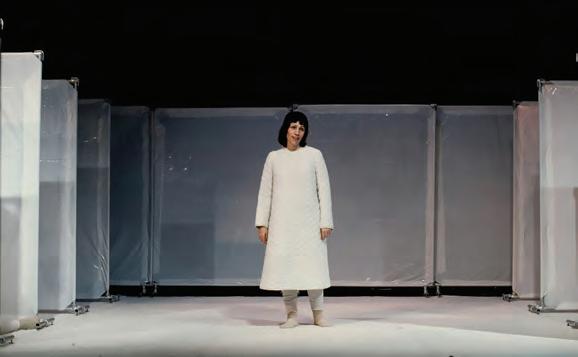
three Guthrie Theater productions, said yes. As it turned out, Balk and the singers, all of them members of the resident ensemble, had a hand in the creation of the opera.
Vern Sutton said of this opera:
I think Transformations was the quintessential work that we did with Wesley. Conrad joined us several times in a residency he had with us, and we sat around with the book of poetry and improvised on it, and then we had to get up and do something with it. I was to be the character called Wonderful Musician. I got up and I started singing and dancing. "Consider me . . . the wonderful musician . . ." And I started doing this samba. And then everybody got up and we did it as a conga. If you look at the score, what is it? It’s a conga. It all started with what I improvised.
Susa took notes during these sessions, then went home to San Francisco and in just under five months wrote the opera, delivering the orchestration ten days before the opening.
Robert Israel’s costumes for the production were made of white cotton batting in shapeless forms that resembled hospital gowns. The sets were screens covered with sheets of white plastic that were moved around by the performers, giving the impression that the opera takes place in a mental hospital. Susa’s score, which calls for just nine instrumentalists, is a fluid blend of popular and classical idioms passing seamlessly into duets from solo numbers and ensembles. In “Rapunzel,” where Sexton portrays the witch as a lesbian in love with Rapunzel (“a woman who loves a woman is forever young”), a captivating duet evolves into a trio for female voices that brings to mind a similar trio at the end of Der Rosenkavalier This is followed by “Godfather Death,” which explores the simultaneous desire for and fear of death. Susa turned it into a grand pop aria in the soaring manner of Harold Arlen, sung, in this case, microphone in hand, by the soprano Barbara Brandt in an exhilarating performance that ranks among her finest moments with this company. Transformations, which premiered May 5, 1973, at the Cedar Village Theater, continues to be performed in the United States and Europe. In August 1978, the opera—and the Minnesota Opera production—received its US television premiere when it was performed on the PBS network, a coproduction of WNET and KTCA. Sadly, Anne Sexton did not see the production, as she took her life on October 4, 1974.
THERE WERE THREE OTHER notable productions that season. Balk’s Threepenny Opera, which opened the season and played four performances at the Cedar Village Theater starting January 12, 1973, got wildly differing reviews. Philip Gainsley, writing in Opera, the British magazine, said this was “one of the best productions in the company’s history,” while Mike Steele of the Tribune called it “horrible” and Mary Ann Feldman at Opera News said it was “a two-penny performance for those who prefer propaganda at a discount.” Balk’s restaging of Postcard from Morocco, prior to its going on tour, presented in four performances at the Cedar Theater starting February 16, wasn’t a major revision of John Donahue’s original direction but a paring down and simplification of what might have seemed cluttered the first time around. Catherine Malfitano, soon to become a star at the Metropolitan Opera

Barbara Brandt press feature, 1973



after her year with Minnesota Opera, made a big impression as Rosina in the company’s season finale, The Barber of Seville. Her Rosina was foxy and believable, and she handled the part’s florid high passages with sparkle and ease. Timothy Nolen was a sly, strong-voiced Figaro. John Conklin’s sets and costumes brightened the stage with color and flair, and Philip Brunelle, leading the St. Paul Chamber Orchestra, proved to have an unerring sense of Rossini’s special wit and momentum. The production, given in five performances at the Guthrie starting March 29, broke the house record for ticket sales.
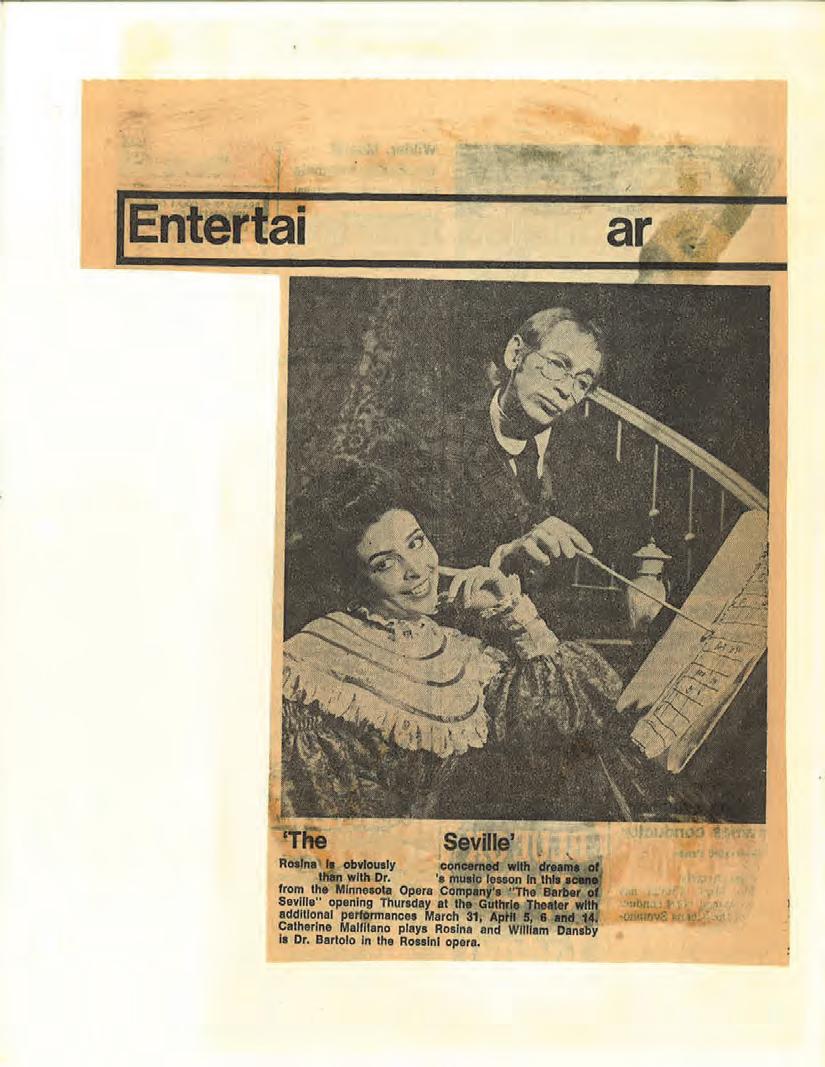


THE BOMB DROPPED on September 4, 1973. John Ludwig resigned effective November 24 to become general director of the Wolf Trap Foundation, the governing body of the Filene Center at Wolf Trap National Park for the Performing Arts near Washington, DC. It was by most reckonings a step up. It was obvious that someone with Ludwig’s flair, energy, and organizational skills would be hard to find. On the bright side, he was leaving a stable ship. The past year Ludwig had overseen a name change, along with increasing singers’ salaries to a minimum of $135 a week with contracts extending as long as thirty-five weeks. The budget went from $148,000 in 1969 to $291,500 for the fiscal year 1972–73. Foundation support rose from $55,000 in 1969 to $97,500 in 1972–73. And with the always shrewd help of Gale Sharpe, he engineered extensive national tours that gave the company increased exposure and acclaim.
In its first years as Center Opera, the company reflected the interests of its founders—Tom Nee, Norton Hintz, Dominick Argento, and others. It was a chamber-opera company doing contemporary and occasionally traditional, especially baroque, works. “We were working in the Guthrie Theater then,” said Ludwig, “and the need to fill that theater made baroque opera unrealistic. Then contemporary opera became our focus. The Walker Art Center defined the company at that time. Martin Friedman looked on it as an extension of the museum’s activities, and we thought that was reasonable. But when we wanted to do something like Sir John in Love, Martin thought Vaughan Williams was reactionary. And with his policy of having studio artists design the sets, there were times when the design took over the production.” Ludwig’s replacement wasn’t announced until the end of the season.
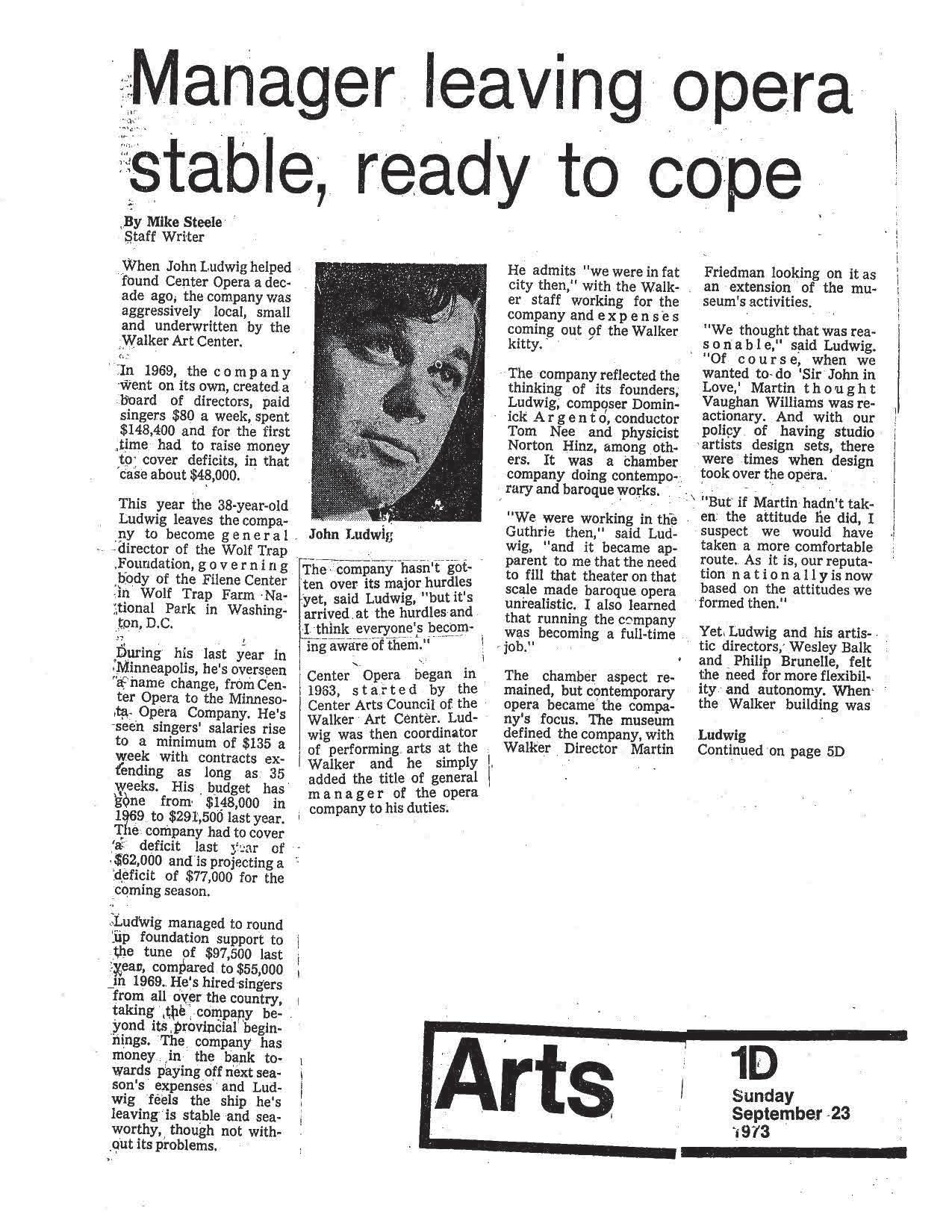


Minneapolis Tribune article, 1973, from
CEDAR AVENUE WAS NOISIER than usual the night of December 28, 1973, and the sidewalks were jammed. When the Minnesota National Guard Band from the Forty-Seventh Division kicks in with its own version of “The Stars and Stripes Forever,” it can be heard, some say, all the way to Lake Street. The National Guard Band had been engaged by Minnesota Opera to add a festive note to the start of the company’s eleventh season. The band’s presence was also linked to the comic operetta that the audience would see that night on the cramped stage of the Cedar Village Theater, El Capitan by John Philip Sousa, the March King. Sousa wrote at least one hundred marches, and he toured the world with his band for decades. Sousa and his seventy-five-piece band performed at the opening of the Foshay Tower in downtown Minneapolis in August 1929, and in honor of the occasion he wrote the “Foshay Tower Washington Memorial March.”

Sousa composed eleven operettas, one of which, El Capitan, hadn’t been staged since its premiere on Broadway in 1896. The story concerns the cowardly Viceroy of Peru, Don Medigua, who disguises himself as the rebel leader, El Capitan, to save his regime until Spanish forces can arrive with help. This potentially funny production had several things going for it. One was the gifted comic actor Vern Sutton in the title role. Another was the effervescent playing by the orchestra led by Philip Brunelle, who wrote his own orchestration of Sousa’s bubbly score. And wisely, Minnesota Opera engaged Robert Moulton, the city’s wittiest director, to stage and choreograph the show. Moulton, who knew the turn-ofthe-century performing style as well as anybody, sensibly had his actors play their parts straight, as if we were seeing it back in 1896, and he had his designer, Bruce Miller, devise sets and lighting in the style of the period. The top-notch cast included Janis Hardy as Estrelda, the amorous Lady Soldier. The result was a hot show on a really cold night.


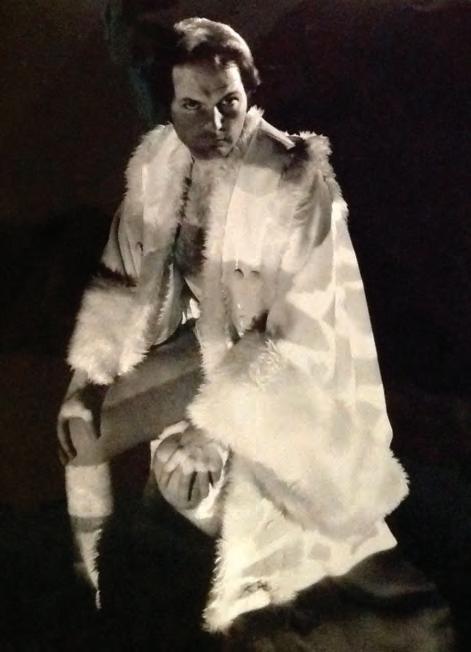
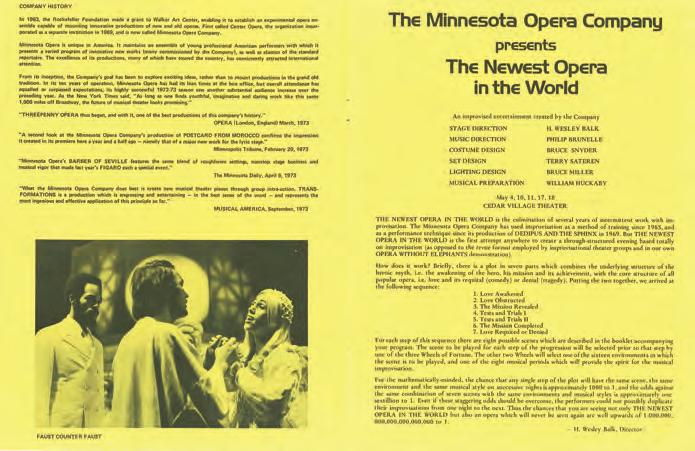
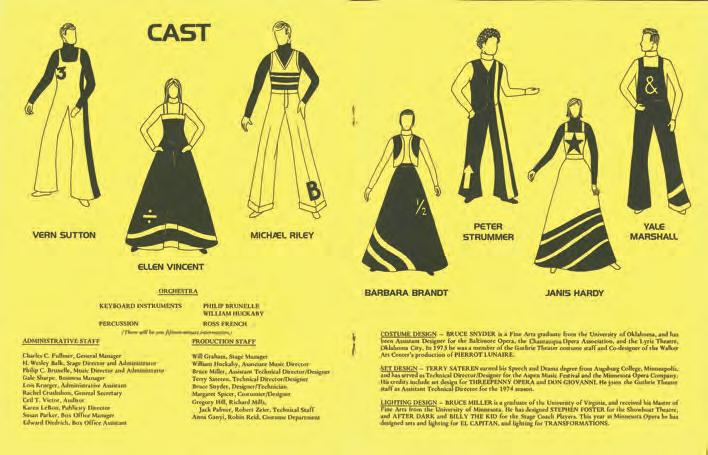
BY NOW MOST PEOPLE know what improvisation is. We see it in movies, on TV, and in comedy clubs. But improvised singing is a special challenge, especially in the field of opera. That’s what the intrepid members of Minnesota Opera’s resident ensemble did for an entire evening in The Newest Opera in the World, the season finale given four performances at the Cedar Village Theater starting May 4, 1974. Balk had been using improvisation as a method of training since 1965 and as a performance technique since Oedipus and the Sphinx in 1969. The Newest Opera was, we presume, the first attempt anywhere to create an entire opera based on improvisation. Onstage were three giant multicolored wheels of fortune that were spun in front of the audience before the show began. One determined the plot, the second named the setting, and the third defined the musical style of each scene,
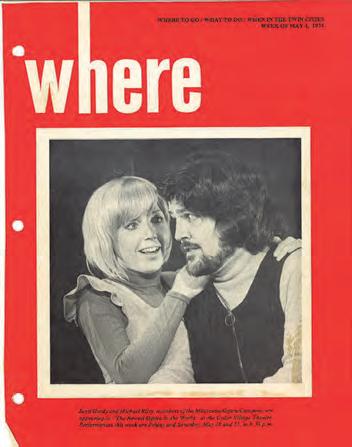
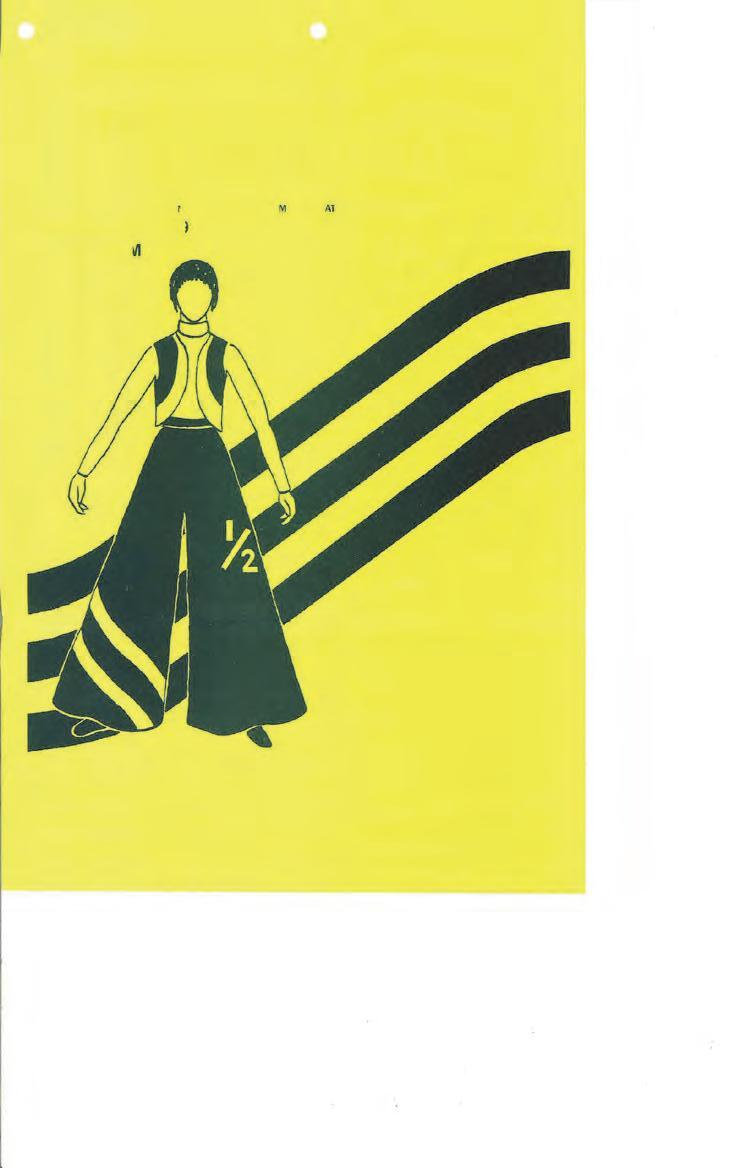
the styles ranging from 1640 to 1930. An audience member would spin the wheels. “The difficulty of it is staggering,” Balk said. “And it isn’t just music. They have to make up words, too. The cast was terrifically apprehensive before we started.”
Philip Brunelle and Bill Huckaby had coaching sessions with the singers, working on the styles of each period—Handel verses Mozart, for example.
Singer Vern Sutton said, “If you weren’t onstage you had to be in the wings all the time listening because if you heard your name—we used our own names—that meant the singer out there was in trouble and didn’t know what to do or how to end a scene, and one of us would rush out to help.” And Janis Hardy said, “People came more than once because they thought it was rigged, that it wasn’t really being improvised. But, of course, it was.”
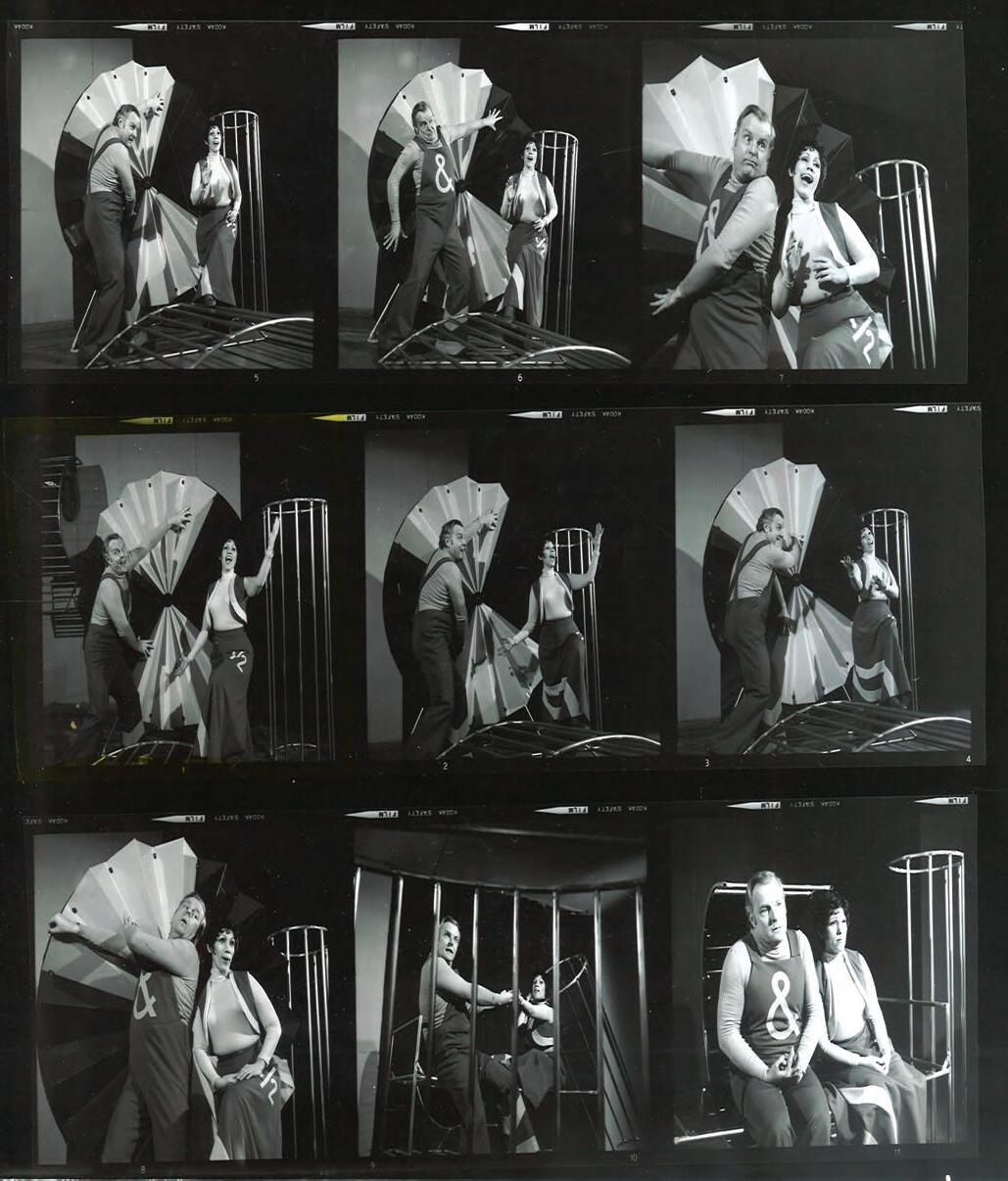
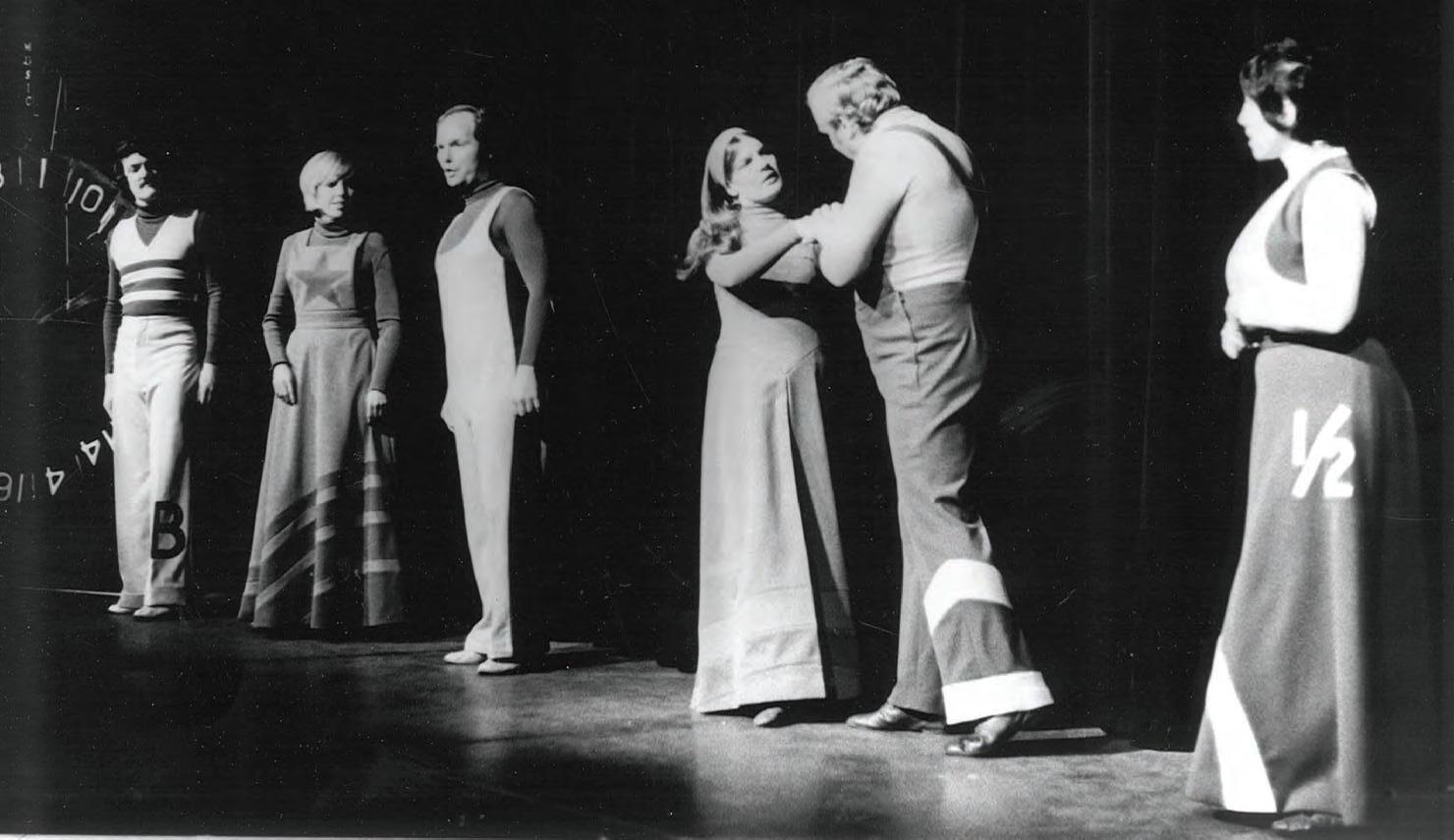
IN JANUARY, the company announced that forty-seven-yearold Charles Fullmer, executive director of the Upper Midwest Regional Arts Council and former director of development for the Minnesota Orchestra, would become general manager effective June 1, replacing John Ludwig. In an interview, Fullmer named three goals. One was to increase local exposure, which meant tapping into the large audience of opera fans who attended the Metropolitan Opera at Northrop Auditorium every spring. Another was to find a new home. “Having to perform at the Cedar Theater has hurt us,” he
said. He also hoped that the company would do more touring and that the programs would begin to include more “classic” works, such as those by Mozart, “though this will never be a La bohème company,” he added. (The company did do La bohème in the 1979–80 season and several more times in later years.) He announced that season ticket sales, never a high priority with this company, rose this year from 100 to 900, and overall attendance reached 85 percent of capacity, easier to achieve at the 500-seat Cedar Theater than at the Guthrie, which seats 1,437.

All was not calm at a certain conference room at the College of St. Catherine on the chilly morning of January 29, 1975. The board chairman of the St. Paul Opera Company had called an emergency meeting. A financial crisis was exploding, and most of the board members—important men in town—didn’t know anything about it.
In 1969, St. Paul city officials ruled that the Civic Center Authority, which manages the St. Paul Auditorium, would only accept cash in advance from the opera company when it rented the auditorium for its productions. According to the Civic Center Authority, the opera company hadn’t paid rent for two seasons and owed the Authority $34,000.
Edward Clapp, the company’s financial vice president, said the company hadn’t signed contracts with performers or directors, which it usually does in December, because the company hadn’t received any contributions from its usual funding sources. The company is broke, Clapp said, laughing. “We call it dynamic insolvency.”
Somebody made a motion to cancel the season, and the motion passed.
The decision to cancel was made without an opinion from George Schaefer, the company’s general manager, who wasn’t at the meeting. According to board members, Schaefer had anticipated receiving a large grant from the Gramma Fisher Foundation to help pay for the 1975 season. With that in mind, he asked several board members to cosign a shortterm bank loan for $50,000 to cover expenses until the Fisher grant came in. But the grant fell through.
“So all of those notes were called,” said Alvina O’Brien in 2018. Elvina’s husband Thomond was one of the board members who cosigned the loan, as was Thomond’s brother Terence, who was board vice president. “Everybody who had goodwill for St. Paul Opera did it,” O’Brien said, with a tone of disgust. Clearly this was a sour memory she had lived with for nearly five decades. “It was a lot of money, and they still owed more money,” she said. “The company had exhausted both the pocketbooks and the goodwill of their most established supporters. That was $50,000 out of our pockets.”
It was obvious that Schaefer hadn’t communicated well with board members, many of whom didn’t know the company was in arrears. And he handled the crisis badly, first by not attending the crucial board meeting on January 29 and then by being coy about his resignation. He told the Minneapolis Tribune that he had announced “officially” that he would resign after the 1975 season and that he had not been informed that the season had been canceled.
Camilla Heller played principal cello in a number of the St. Paul Opera productions, including Wagner’s Siegfried, which was the last production the company ever did. “I remember that summer so well,” she said, “because all our checks were bouncing.”
“We were doing the productions in repertory, rehearsing during the day and playing at night. I’ll never forget the last show. Joe Longo, the clarinetist, being Italian, loved opera. We were in the basement of O’Shaughnessy. Everybody was madder than heck because our paychecks were no good. So Joe stood up on a chair and said, ‘Listen up, gang. Last show tomorrow night. They’re sold out. We’re not playing until we’re paid in cash.’ Everybody went ‘Yaaaa!’ So, by George, the last show, the manager of the company showed up and went up to the lighting booth carrying a large briefcase. Each player followed him up to the lighting booth and got paid in cash.’ So we played the show, and that was the end of St. Paul Opera.”
The board passed two additional resolutions at the January 29 meeting. One was “to continue our existence as an opera company.” The other vowed “to explore the possibility of a merger or other means of continuing our existence.” The first was a way of acknowledging that the association was obliged legally to pay off its debts before folding. The second is a matter that has been argued about for nearly a half century.
Was it a merger of the two companies or wasn’t it? Of course, it wasn’t. As Peter Myers of the Minnesota Opera staff told the Minneapolis Tribune in December 1976, “We hesitate to call it a merger. That implies we’re assuming St. Paul’s indebtedness, which isn’t the case.” In other words, there was nothing for Minnesota Opera to merge with.
And yet, despite all the evidence, there was no stopping the creeping merger myth. It oozed into the local newspapers—“Two Companies Merge . . .”—into the New York Times, into Opera News and Musical America. The merger myth persisted because people wanted it to be true. It sounded good, and funders liked the idea. A St. Paul Opera board member said the Bush Foundation told him “some doors could reopen if there were a merger.” In December 1975, the St. Paul Foundation offered St. Paul Opera $100,000 to be awarded if and when it merged with Minnesota Opera.
What happened was that fifteen or so board members of the deceased St. Paul Opera were invited onto the Minnesota Opera board as a goodwill gesture in the vein of hands across the border and also in the hope that, again, additional funding sources might appear. St. Paul Opera died on that chilly morning of January 29, 1975, and a year later, the parent organization, the St. Paul Opera Association, having paid off its debts, closed its office and went to sleep.
IN MAY, having wrapped up its most successful season, the company looked forward to an even brighter twelfth season that would start in October with productions of The Magic Flute and La traviata, cooperative efforts with the Kansas City Lyric Opera and the Lake George Opera Festival, a new project titled Co-Opera. Then they would do a Christmas show and Douglas Moore’s Giants in the Earth, which won the Pulitzer Prize in 1951, followed by a new work, Gulliver, and ending with a new one by Conrad Susa titled Black River
By late summer the plan had fallen apart. O’Shaughnessy Auditorium, where The Magic Flute and La traviata were to be staged, was suddenly unavailable. Traviata was canceled and Magic Flute was pushed back to later in the season. A newspaper report alleged, without substantiation, that O’Shaughnessy’s last-minute withdrawal “reflected antagonism to Minnesota Opera by backers of St. Paul Opera.” Then, St. Olaf College, which was to have a hand in producing the Douglas Moore opera, pulled out, and so that too was canceled. The revised season opened with a Christmas show, Gallimaufry, a collection of songs and sketches given at the Prom Center in St. Paul, a ballroom where the big bands of an earlier day played for dancers.
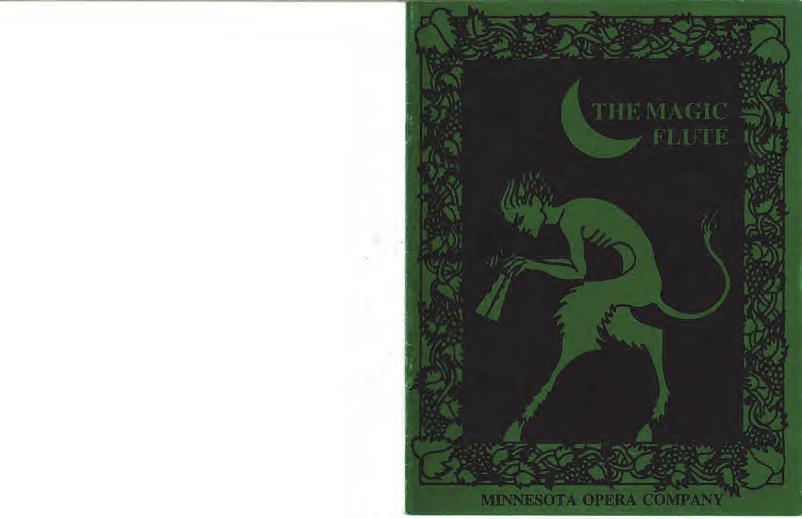
In January, for two nights at the Walker Art Center auditorium, Vern Sutton gave an indelible performance as King George III in Peter Maxwell Davies’s monodrama Eight Songs for a Mad King, one of those portrayals that is still talked about. Sutton, looking like an escapee from a mental ward, unleashed the full range of both his light, flexible tenor and his chameleonic dramatic skills in a performance at times funny, at other times terrifying, as the mad king consorted with the demons and phantoms flying around in his fevered brain. The shriek at the very end, as the king walked out the exit followed by a musician playing a bass drum, left the audience stunned into silence, after which came tumultuous applause. Philip Brunelle led the small band of musicians, all of them wearing Halloween masks. As a companion piece, another monodrama, Schoenberg’s Pierre Lunaire, surely an influence on Davies’s Mad King, took up the first half and turned out to be a wise choice. Schoenberg’s tone is much more inward, more mysterious and hidden than is the case in the Davies work, and Barbara Brandt, displaying an assured command of Schoenberg’s Sprechgesang —speechsong—evoked vividly the eerie, nighttime, wispy aura of these poems while adding an extra sinister touch. Wesley Balk staged the two works, and Robert Israel designed the apt costumes.


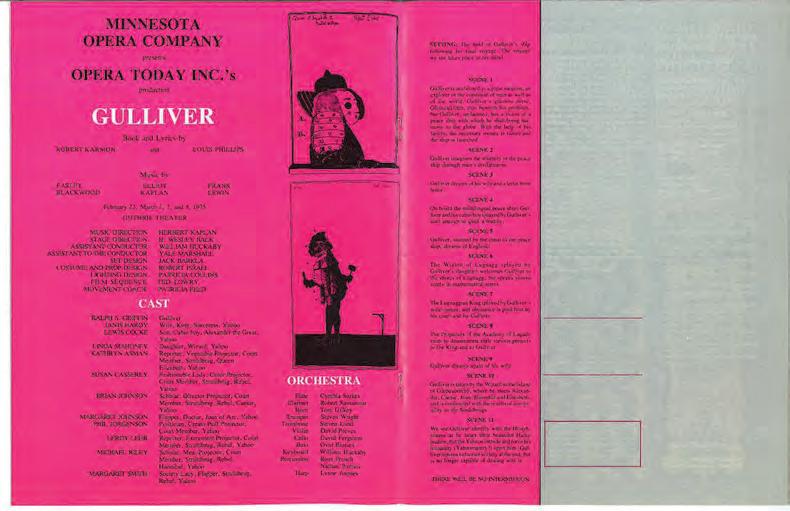
The company returned to the Guthrie for its February offering, the premiere of Gulliver, an opera created by a carload of people: two librettists (Robert Karmon and Louis Phillips) and three composers (Easley Blackwood, Eliot Kaplan, and Frank Lewis). The source was, of course, Swift’s Gulliver’s Travels. The production was funded by Opera Today, Inc., a service organization that put a disclaimer note in the program, saying, “We found it necessary to trim the ship in order to get it in the air,” which meant they ran out of money and, as a result, the show wasn’t ready, neither the work nor the production. This is not the sort of thing one wants to read in the program on opening night. It was a work in progress, an opera not quite ready for prime time. Focusing on Gulliver’s final voyages, the text by Karmon and Phillips was mostly unintelligible. At the end, when Gulliver is sickened by all the misery he has encountered on his travels and loses his mind, the Yahoos assault him, displaying their floppy genitalia, and the audience was sickened as well. The strong cast was highlighted by Robert S. Griffin in the title role and Janis Hardy as Gulliver’s wife. The always inventive Jack Barkla conceived a wildly surreal ship onstage, and Robert Israel designed the thirty-five fanciful costumes the show calls for. Janis Hardy named Gulliver her least favorite production, though she liked the costume Israel designed for her. “It was this body suit,” she said.
I was supposed to be naked with this great big pot belly and a yellow wig. One shoe was in a globe. Three composers wrote the opera. As a result, there was no continuity or concept. It was terrible. A lot of people came thinking it was a children’s show. We were booed every night. There was an education convention going on, and my mother was coming down from Roseau with some young people, and she was encouraging them to see the show. She came to the dress rehearsal and saw me afterward. She was crying. She said, “Would you tell them at the box office that if someone with a young voice calls for a ticket, they should say the show is sold out.”
The company rounded out the season with revivals of two of its best productions: Albert Herring, with Vern Sutton repeating his winning portrayal of Albert, and The Magic Flute, enhanced once again by Robert Israel’s imaginative costumes. The two Armored Men, said an audience member, looked like “ambulatory espresso machines.” Both productions were given at O’Shaughnessy Auditorium.
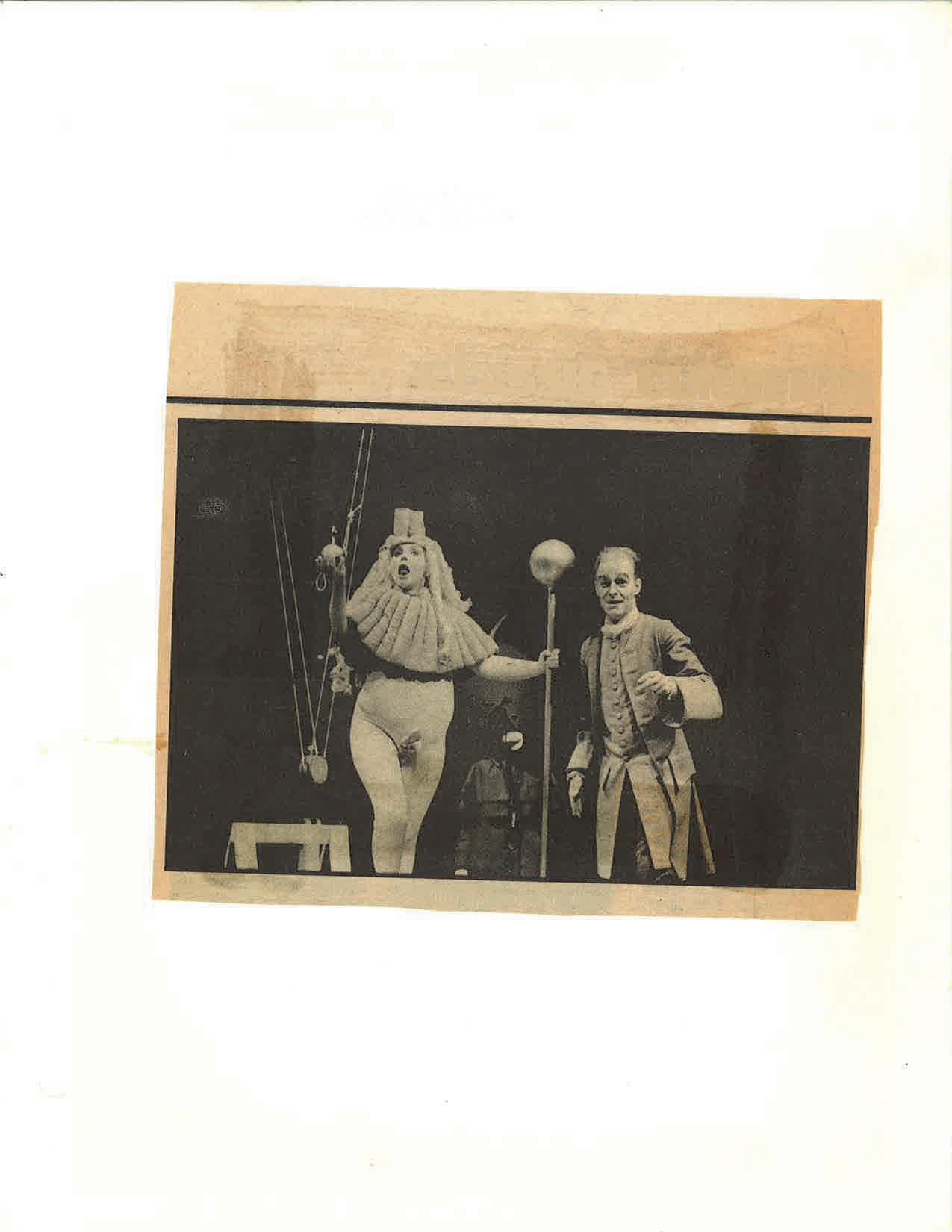


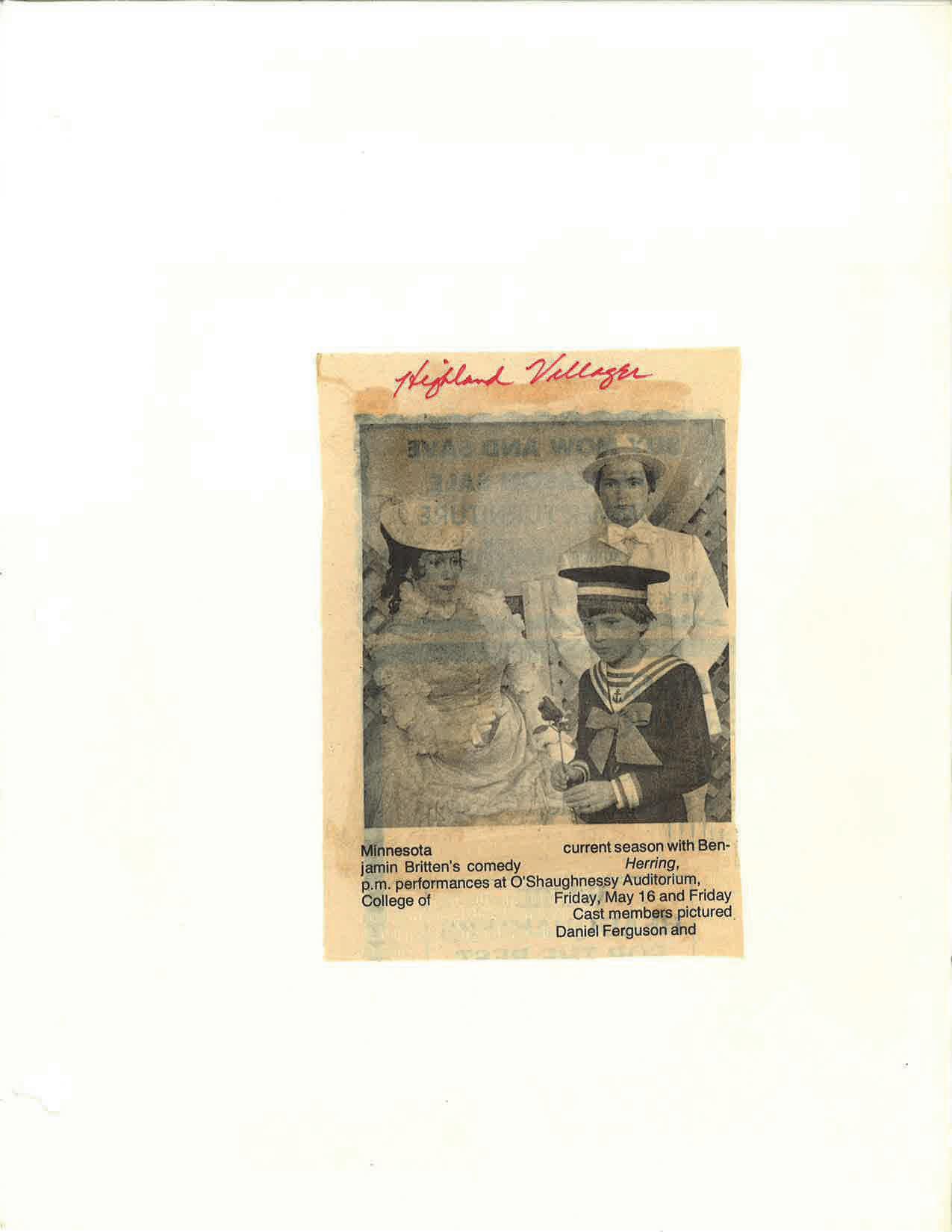
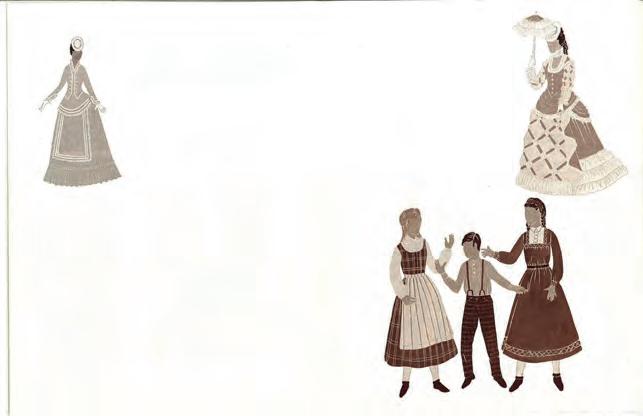
MINNESOTA OPERA’S THIRTEENTH SEASON gave the world two new operas, large, ambitious works that tell of despair, madness, and death in a distinctly American musical idiom. These were Black River by Conrad Susa with a text by Richard Street and Wesley Balk, performed in November at O’Shaughnessy Auditorium, and The Voyage of Edgar Allan Poe by Dominick Argento with a libretto by Charles Nolte, presented in April also at O’Shaughnessy. Susa, whose Transformations was a success for this company in the 1972–73 season, based his Black River on Wisconsin Death Trip, Michael Lesy’s much discussed book about life in a small Wisconsin town, Black River Falls, during the nineteenth century. Rather than a Little House on the Prairie picture of rural life (hardworking but happy people who often say “shucks”), Lesy’s book with its many grim photographs projected images of despair: people driven to suicide, insanity, and acute depression by the hopelessness of the world they inhabit. The opera mixes fictional characters with people from the book. The main characters are three women: Clara Gray (Janis Hardy), her daughter Lucy (Margaret Smith), and Pauline L’Allemand (Barbara Brandt), an opera singer who retired to Black River. Clara loses her infant son, Lucy watches her young husband die, and Pauline laments her lost career. At times, most often in the third act, Susa’s music reaches heights of lyrical ardor, but the action is static, chiefly because the work is structured more like an oratorio than an opera. The women speak




only to themselves or to the audience. The cast, especially the three main women, sang on opening night with graceful intensity. Balk’s staging fused sensitivity and compassion for these characters, and Philip Brunelle, no stranger to Susa’s work, drew an elegant, carefully detailed performance from the orchestra.
Janis Hardy recalled an odd moment during the final rehearsal. “At the end of Black River, Clara self-immolates. I was supposed to start the fire with a lighter, and then the stage light would come up with a glow everywhere. I guess they wanted it to start with a single flame. But this time I dropped the lighter on my dress, and it caught fire. I thought, ‘I really am setting fire to myself.’ Fortunately, we managed to put it out.”
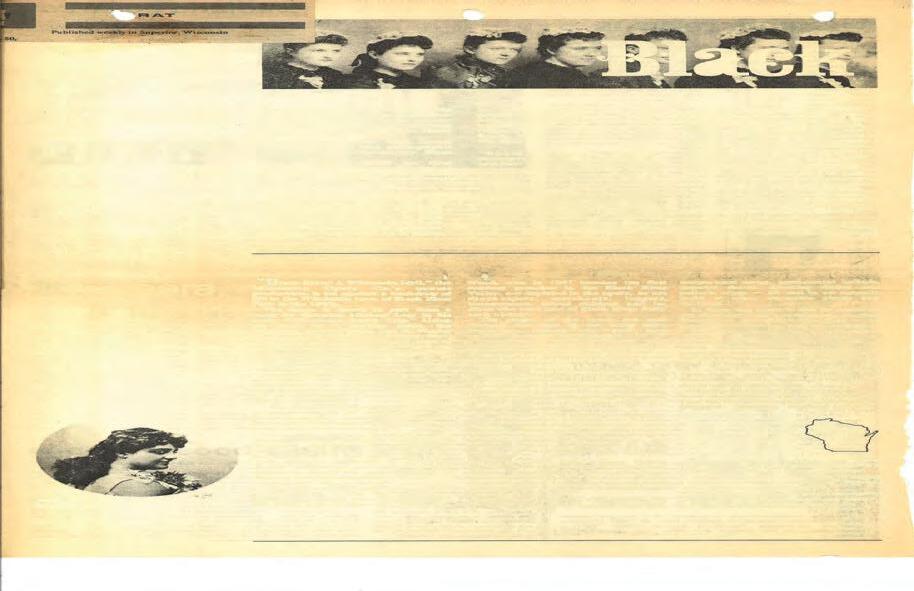
Susa was chronically late in delivering his scores. Peter Myers, the new guy on the staff, was assigned the job of picking up Susa’s manuscript pages each morning at Yale Marshall’s house, where Susa was staying. “Between the door and the storm door would be another two or three pages of the manuscript,” Peter said. “I would pick them up, bring them to our office and give them to the copyists for the orchestra. It was the orchestration he was still working on. Phyllis Sutton, Vern’s wife, was one of the copyists. She did the most meticulous writing. This was before computers. It was a scramble. Literally, the ink was still drying when the musicians would get their parts on the music stands for a rehearsal. I remember thinking, ‘This is chaotic. Is this the way it works with a new opera?’”
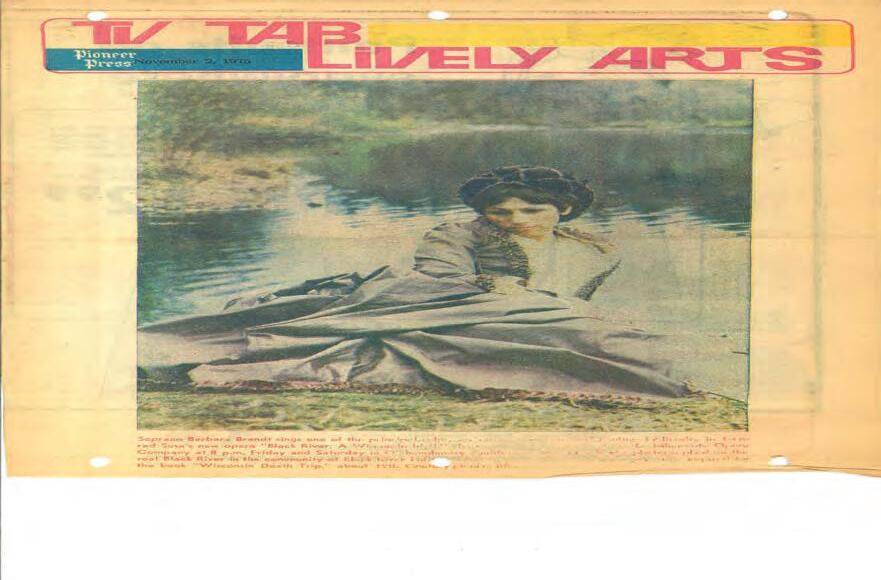
THE CLOSEST ARGENTO CAME to writing a “grand opera”—full of fantastic dream sequences and shifting perspectives—was The Voyage of Edgar Allan Poe, a commission by the University of Minnesota to recognize the American bicentennial. He chose to explore the disappearance in October 1849 of author Edgar Allan Poe, who went missing for six days after he boarded a boat in Richmond, Virginia, bound for Baltimore. He was found lying in a gutter in Baltimore, disheveled and dangerously ill. He died just a few days later. Argento and Nolte filled in the gap with the notion that Poe’s enemy, Rev. Rufus Griswold, takes Poe on a voyage of self-discovery, making him relive scenes from his life and realize that the death of members of his family had been the source of his poetic strength.

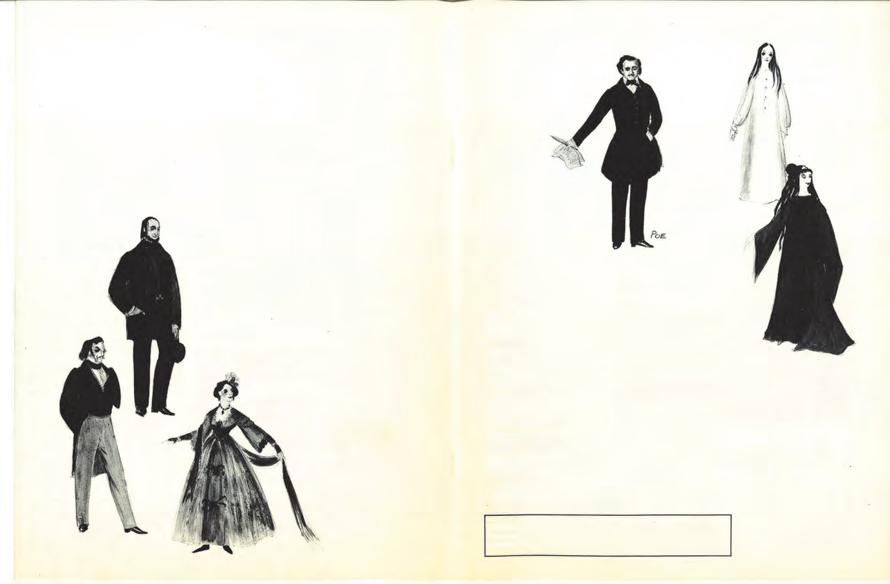



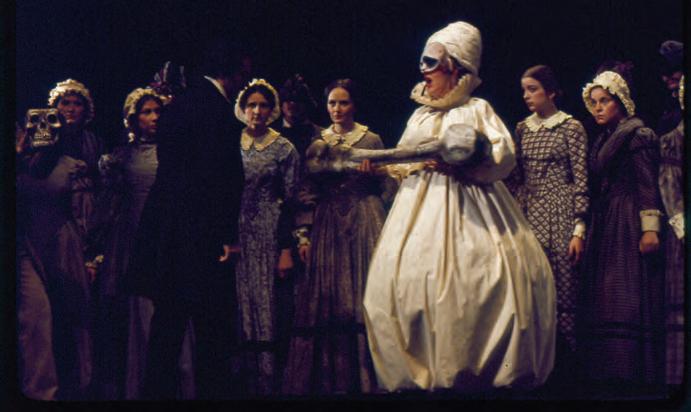
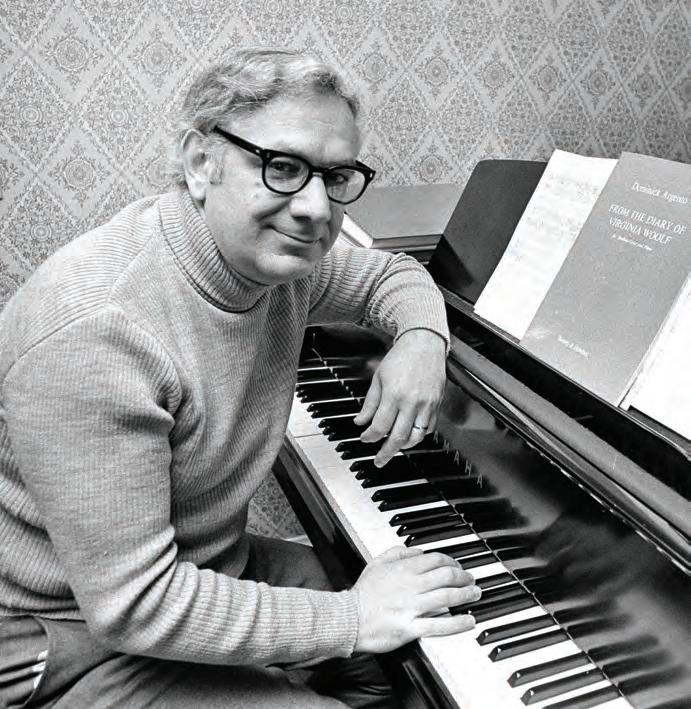
This was one of Argento’s most imaginative scores, filled with elegant writing for solo voices, ensembles, chorus, and orchestra. Directing it, Balk gave the staging a cinematic sweep along with careful attention to detail, especially in his ingenious blocking of the crowd scenes, which had the flavor of similar scenes in Boris Godounov. The pacing and nuances of the score were handled with exemplary care by the conductor, Philip Brunelle. The cast was excellent. Tenor George Livings made a credible, sympathetic Poe, his singing well focused and opulent in tone. Karen Hunt gave a sweet portrayal of Virginia, Poe’s young wife. The production received attention from newspapers and magazines, including TIME and Newsweek. Reviews were consistently positive. Managers of many of the major opera companies were also present on opening night. There was special interest in Argento, who just a couple of months earlier had received the Pulitzer Prize in Music for his song cycle From the Diary of Virginia Woolf, premiered by Janet Baker a year earlier at Orchestra Hall.
AT THE COMPANY’S ANNUAL board meeting in June 1976, Judson Bemis, an important figure in the local arts community, was named board president, succeeding Stephen Pflaum. Pflaum reported that the company had finished in the black for the sixth consecutive year and that the thirteenth season, just ended, was the company’s most successful ever. The budget for the upcoming fiscal 1977 was $499,500, roughly twelve times the budget for the company’s first season.
THE ADVERTISING SLOGAN for Minnesota Opera’s fourteenth season—“From Bach to Bernstein, something for everyone”—surely wouldn’t have been considered during the ’60s, the Center Opera years, when the company’s confidently modernist, avant-garde stance earned critical acclaim from practically every critic in the country while its small audience would continue to diminish until it was appropriate
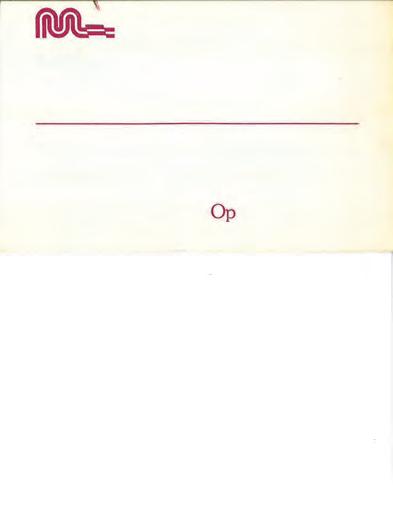


to quote Samuel Goldwyn: “If audiences won’t come, there’s no stopping them.” The ’70s presented a different landscape. Ever-bigger budgets demanded better fundraising and bigger audiences. The productions could be—and would be—provocative, the company was quick to affirm, but they wouldn’t be quite so abrasive as, let’s say, the teeth-gnashing Punch and Judy of the 1969–70 season. The fourteenth season, in contrast, promised to offer a healthier, perhaps even an audience-friendly, balance. That, at least, was the hope.
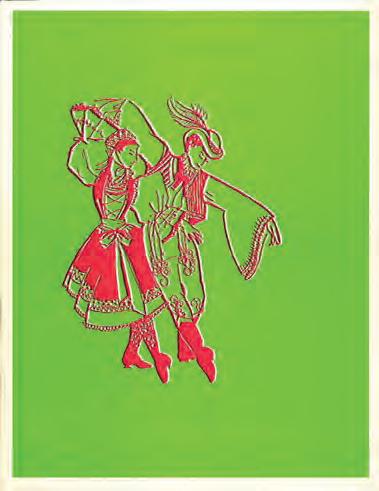
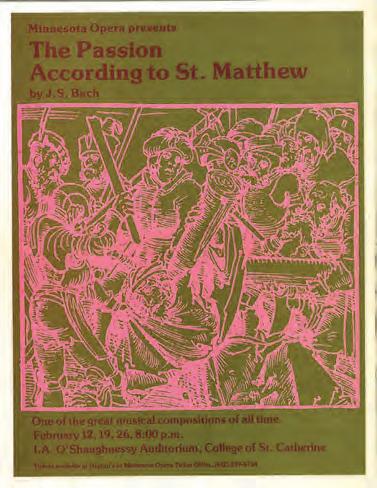
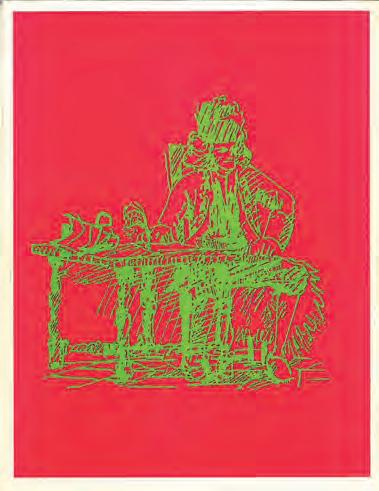

The season opened at O’Shaughnessy Auditorium on October 9, 1976, with a lively and imaginative production of Smetana’s The Bartered Bride, a comic tale about a marriage broker and a potential bridegroom who stutters. Wesley Balk’s staging underlined the lighthearted and basic humanity of the work, and the visual element was greatly enhanced by Bruce Snyder’s authentically detailed folk costumes and Jack Barkla’s brightly colored sets. Choreographer Patricia Feld worked up comic dance numbers with the Czechoslovakian Folk Dancers of St. Paul, adding energy and movement to the show, though the tiny stage platform in the third act made the dance numbers look overcrowded at times, as if Barkla were reminding us what a small country Czechoslovakia is.

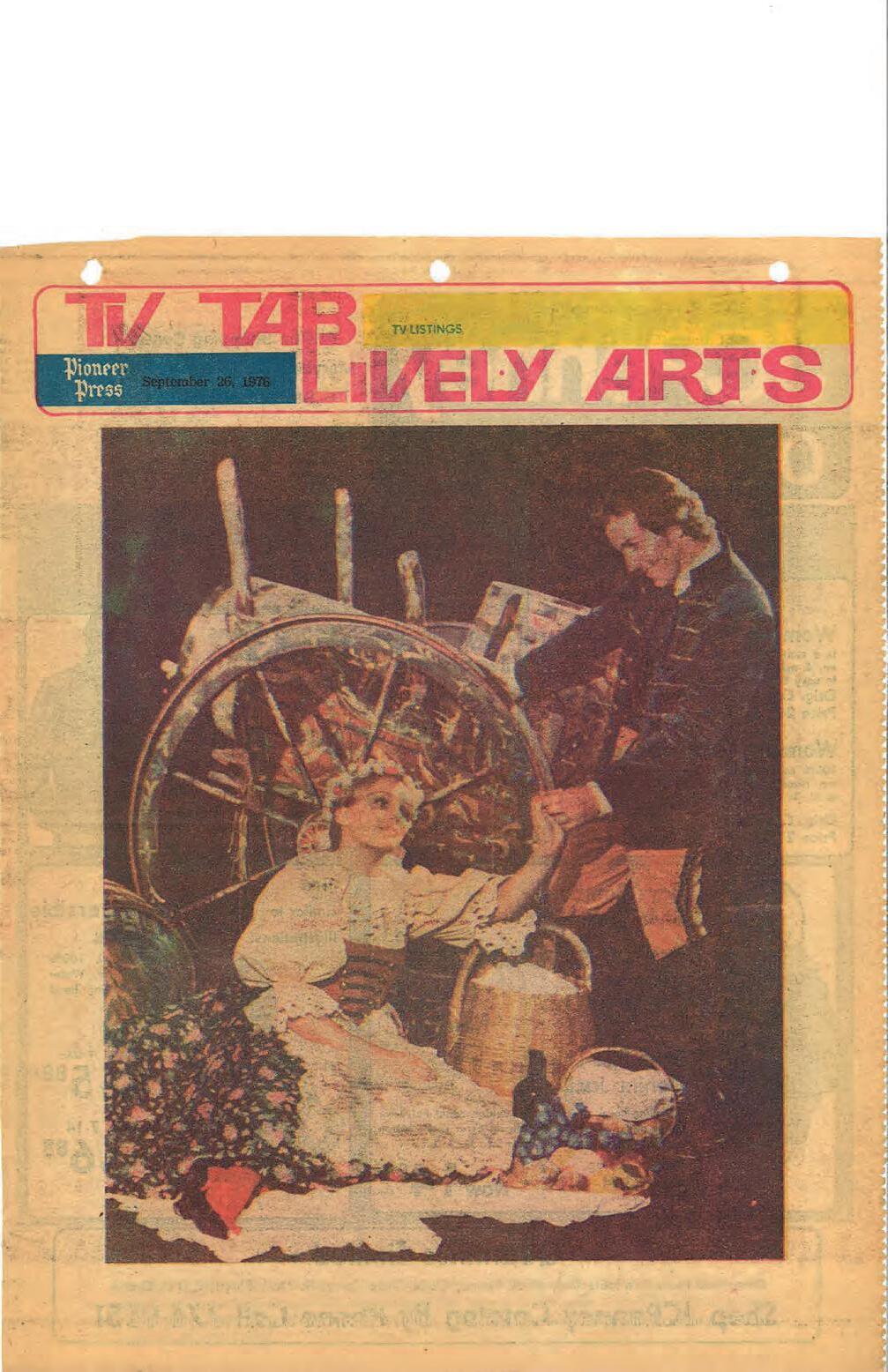

The Bach referred to in the ad was Gerald Freedman’s staging of The Passion According to St. Matthew, first presented in 1972 at the Spring Opera in San Francisco and viewed here in three performances at O’Shaughnessy Auditorium starting February 12, 1977. The work is basically an oratorio, not a drama, given that the action is described (by the Evangelist) rather than enacted. Freedman turns the proceedings into a ritual, which becomes, if not drama, at least dramatic, in that the soloists, the Communicants, come to live the Passion story themselves. The result was quite moving, an evocation of the mystery at the heart of the Passion and, thanks to James Waters’s sets and Ming Cho Lee’s costumes, visually stunning. Though tenor Donald Hoiness (the Evangelist) had a voice neither large nor lustrous, his handling of the declamatory style was direct and expressive, and the singing of the Communicants (Barbara Brandt, Clifton Ware, and Janis Hardy) was assured and meaningful. Michael Riley, rich-
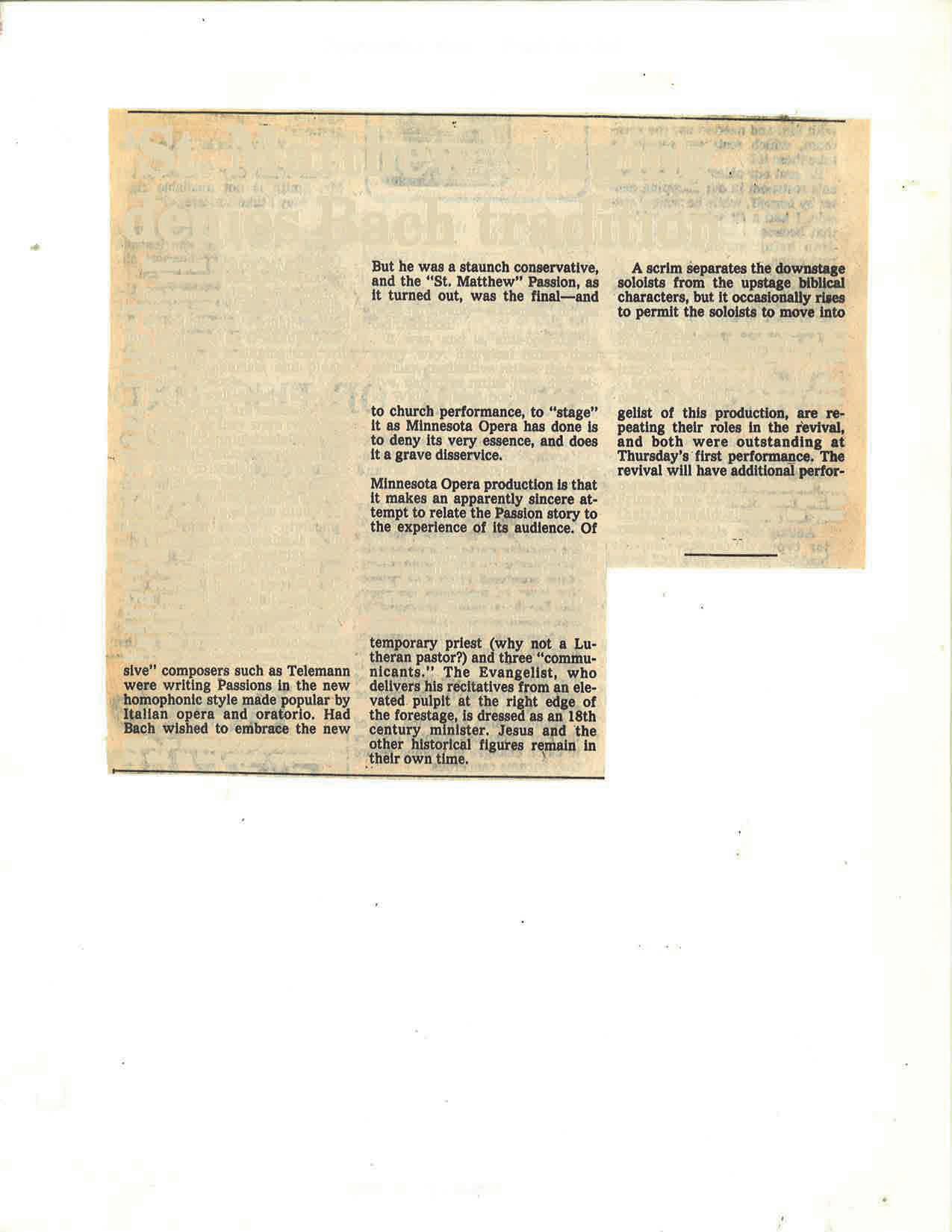
voiced and steady in tone, stressed the human side of Christ and was an imposing presence on stage. Philip Brunelle, no stranger to the oratorio form, led the Dale Warland Singers and the Minnesota Boychoir with a deft touch, infusing both drama and a sense of structure into the performance, evoking what Albert Schweitzer called the “epic tranquility” of the chorales.
Balk’s Candide, which opened at the Guthrie on March 18, 1977, wasn’t the best of all possible productions of Bernstein’s comedy but was close to it. He used a sensible mix of the original satiric operetta of 1956 with Hal Prince’s musical comedy revival, the result being a wildly visual jamboree in which the sight gags and extravagant props almost became the stars of the show. Brian Johnson, an alum of the company’s Opera Studio, was an engaging Candide, not so much the little guy put upon by a heartless world than an earnest, wide-eyed Tom Jones (the Fielding character, not the British pop singer).

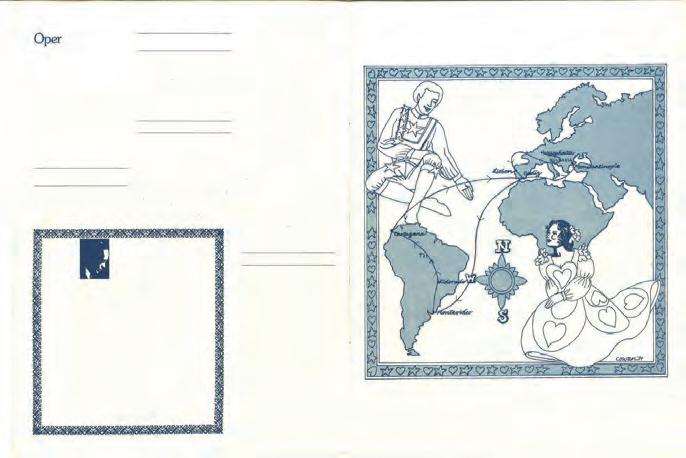
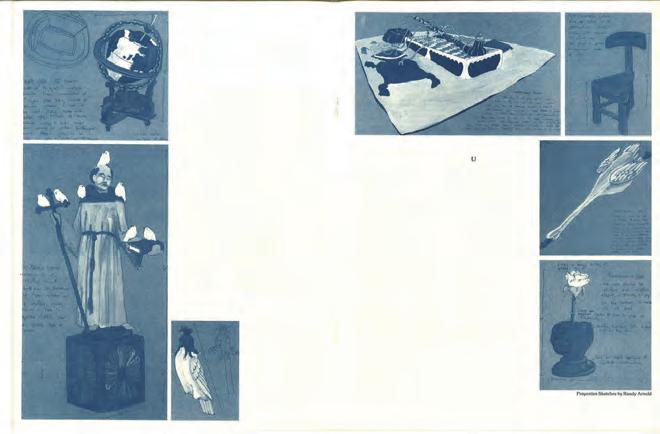
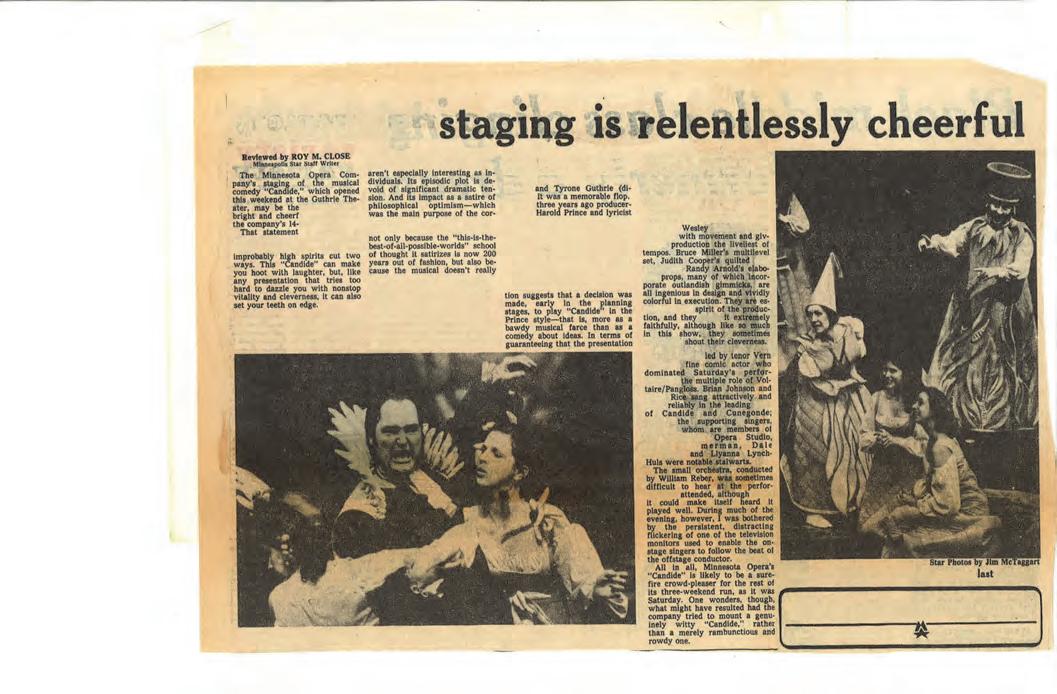


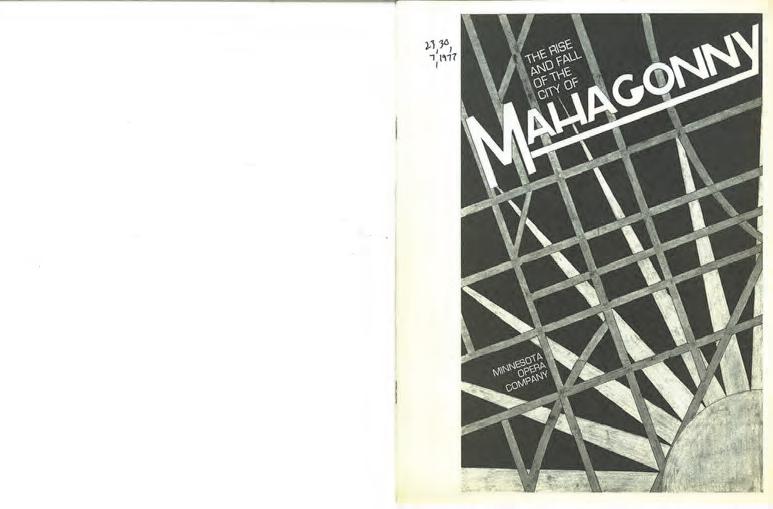
The season finale, Balk’s The Rise and Fall of the City of Mahagonny, presented in April at O’Shaughnessy, made the usual points about a corrupt society devoted to the ethos of sex and booze, brutality, and greed, but it made those points not with acid, as Brecht and Weill intended, but with a kind of essence of acid that might smart slightly but doesn’t penetrate the skin.
Even so, the cast was impressive. Playing Jimmy, Pietro Pozzo conveyed much of the wild, driven quality of the character, and Barbara Brandt made a strong Jenny—fragility under a tough veneer—without doing the standard Lotte Lenya impression.
Just a few months earlier, the company moved its headquarters from the West Bank of Minneapolis to what had been a Ford dealership at 850 Grand Ave. in St. Paul, raising their usable space from 9,000 sq. ft. to 21,000.
That’s progress.



THE FIFTEENTH SEASON was like an expensive Swiss watch: a perfect balance of interlocking wheels and gears ticking away in intricate counterpoint. And then the ticking stopped.
The perfect season would have been two classics, one of them little known, the premiere of a new American work, and the American premiere of a British work. The last of these was The Knot Garden by Sir Michael Tippett, who was much in vogue in the ’70s. On the day in December when set construction for the opera began, general manager Charles Fullmer got a call from a young baritone who said he was withdrawing from the production. He had just become a “born-again Christian,” he said, and this opera went against his newfound principles. Fullmer tried hard to find a replacement, but he had no luck. So he, Brunelle, and Balk took a meeting and came up with a replacement, a revival of The Mother of Us All, the Gertrude Stein–Virgil Thomson opera that had been a big hit for the company in two prior productions. The new one, Balk figured, would be a smaller production with eight singers portraying twenty-seven characters and with Janis Hardy playing the central role of Susan B. Anthony, the crusader for women’s rights. A special guest at the opening night performance at O’Shaughnessy Auditorium was Susan B.’s grandniece, Susan B. Anthony II, who lives in Florida and continues her great-aunt’s fight for women’s rights by lecturing around the country in support of the Equal Rights Amendment. As in the second production in 1971, Balk treated the opera as Susan B.’s dreams of her past in her old age, when her public image had come to dominate her private self. Janis Hardy, producing bright gleaming tones during the opening night performance, conveyed Susan B.’s courage and determination but also her warmth and sympathy. Brunelle conducted a bigger orchestra—thirty players—than had been used in the earlier productions, which gave the score extra color and buoyancy. Brunelle expressed hope to do The Knot Garden in a later season, but it didn’t happen. As a result, a perfect season became a semiperfect season.

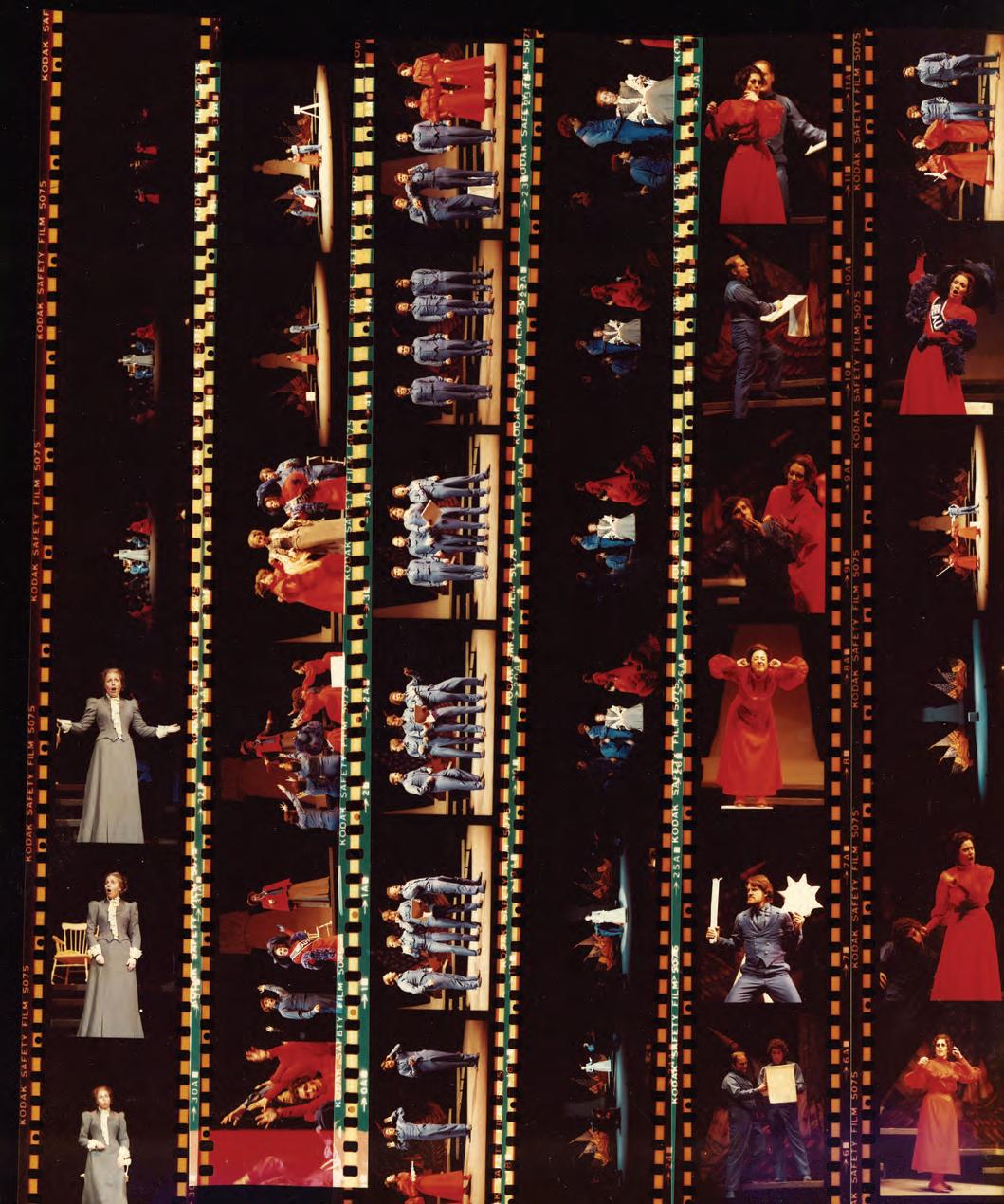
First there was Christopher Columbus, an Offenbach operetta no one had ever heard of until an Englishman named Donald White whipped up a libretto for a score that Offenbach intended to be a spoof on Columbus but didn’t finish. White’s Chris Columbus is a rogue and an avid skirt-chaser who already has three wives when he starts an affair with Queen Isabella. When he’s caught in a compromising position with the Queen, he explains, “I was showing her a new route to the East.” When Ferdinand sends him on a search for the Indies, he is joined by members of the Flat Earth Society and ends up in a forest in lower Manhattan where he invents Coca-Cola. Think of it as the Marx Brothers meet Gilbert and Sullivan. With Wesley Balk’s imaginative staging, Jack Barkla’s eyefilling sets, Maurice Palinski’s bright costumes, Patricia Feld’s adroit choreography, and Philip Brunelle’s effervescent conducting combined with exuberant performances by Evan Bortnick as Columbus and Janis Hardy as Isabella—with all this, Columbus turned out to be a great season-opener.
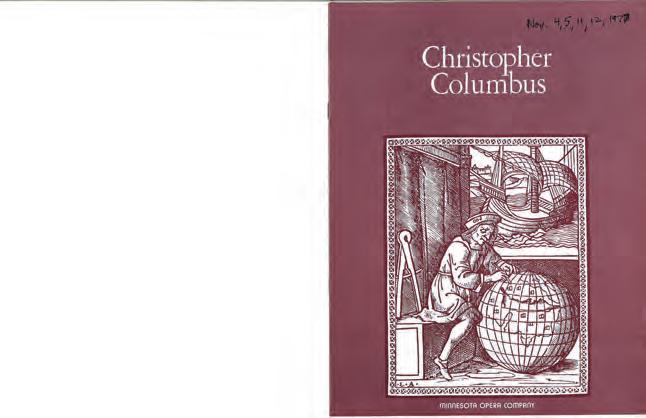


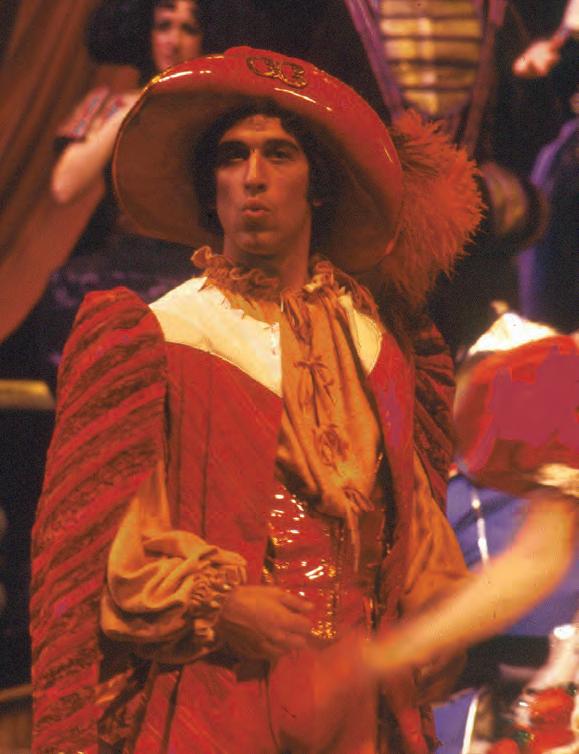
The season concluded at the Guthrie in April with two productions in repertory: Mozart’s The Marriage of Figaro and a new work by Robert Ward, Claudia Legare. By now it was obvious that the company had a winner in baritone Michael Riley— an accomplished singer with a commanding stage presence. Riley’s Don Giovanni a couple of seasons earlier was a force of nature and a brainy rebel, and his Figaro this season was clever and quick-witted, perhaps the Don’s younger brother. Roy Close at the Star thought this Figaro the finest staging of a classic work seen here in many years. Balk hit some kind of a peak during this season, as did Janis Hardy, whose vivacious Cherubino combined a restless charm with a comic boyishness, and she sang beautifully. Vern Sutton’s comic Don Basillio almost stole the show. Marsha Hunter was a foxy Susannah, Barbara Brandt a vulnerable Countess, and backstage, Philip Brunelle drew clean, incisive playing from the orchestra.
Claudia Legare was an adaptation by Robert Ward and Bernard Stambler of Ibsen’s Hedda Gabler, set in Charleston, South Carolina, just after the Civil War. The opera was commissioned by Julius Rudel and the New York City Opera, but they turned it down, and Minnesota Opera picked it up. Stambler’s libretto, structured in four acts, follows the play closely. The central conflicts remain the same: old vs. new, imagination vs. pedantry, with Hedda—Claudia—representing the liberated modern woman. With the exception of a few Civil War songs, Ward avoided music of the period, opting instead for a generalized kind of American Romanticism that never rises to any peaks of emotion. The music is bland. The story and the characters didn’t inspire Ward to write the passionate sort of music that infuses his often-performed opera version of Arthur Miller’s The Crucible. Perhaps City Opera was expecting another Crucible, and not finding it, they passed on it. Balk’s smart staging was of a piece with James Waters’s detailed period set and Deborah M. Dryden’s bright costumes. The cast contributed adequate singing and nearly always convincing characterizations, though soprano Barbara Brandt’s nervous Claudia was overacted—Bette Davis in a Civil War dress.
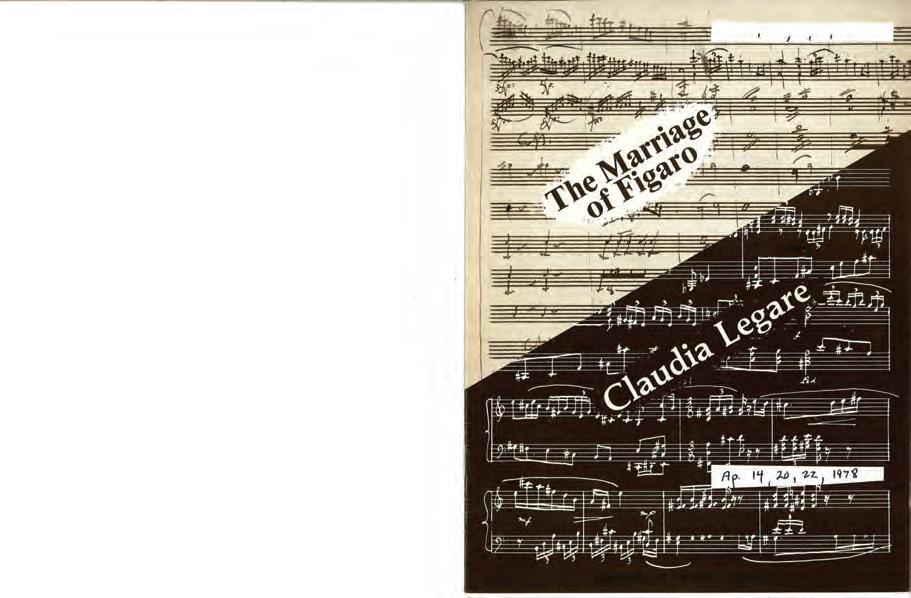


When the receipts and contributions were tallied at the end of the summer, the company showed a surplus of $113,151. The additional good news from Charles Fullmer was that the number of private contributors had risen to 558. The previous record was 330. Fullmer reiterated his lament that the company lacked a permanent home. There was adequate office space on Grand Avenue but no theater they could call their own. Fullmer was no doubt especially irritated by this situation because the previous fall there had been serious discussion of the State Theater on Hennepin Avenue being renovated for use by Minnesota Opera. The theater, an old movie palace, had been vacant since the end of 1975. A corporation was formed, the Greater Minneapolis Arts Center, to facilitate the project, which would cost $838,000. Federal money and community development funding was anticipated but never appeared.
“Because we don’t have a home of our own, many don’t know who we are,” lamented Fullmer. “The company’s audience base remains small. We haven’t reached the hardcore opera audience, meaning the Met audience and the more tradition-oriented St. Paul crowd. We’ve been doing one traditional opera a year. I think the operas we start adding to our season will be more traditional ones, which will give us more of a mix.”
Be that as it may, the upcoming season was no help.
THE LOBBY OF O’SHAUGHNESSY
Auditorium at the opening night of Minnesota Opera’s sixteenth season looked like a protest rally at a nuclear power plant. Picket signs were held high, and short, snappy speeches were delivered to incoming audience members. The signs said things like “Ban Avantgarde Opera,” “English Fractures the Music,” and “Bring Back St. Paul Opera.” This was the start of the company’s production of Prokofiev’s The Love of Three Oranges, which opens with a debate among five groups over the nature of opera: the Tragedians, the Comedians, the Lyricists, the Empty Heads, and the Eccentrics. The argument usually takes place onstage; for this production it began in the lobby. This was a nice touch, in that the prologue is made a more active part of the production, though a few people were mystified by the goings-on. “Jerry,” said a matronly lady to her companion as they entered the auditorium, “Are they serious or is this just a fun thing?” None of us wanted to put words into Jerry’s mouth, but it was both. Prokofiev’s prince is no hero. He’s looking for three oranges because he has fallen in love with a princess who lies asleep in one of the oranges. Wesley Balk’s production had the expected sparkle and surprise, and at the podium Philip Brunelle drew spicy, dissonant colors from Prokofiev’s score. The prince was played by a gifted young lyric tenor, Dean Shoff, who sang with special grace on opening night. Sam Kirkpatrick designed the clever sets and costumes, and David Thayer was responsible for the evocative lighting. And amazingly, every word could be understood. These were examples of that rare breed: American singers who know how to sing clearly in their native language.

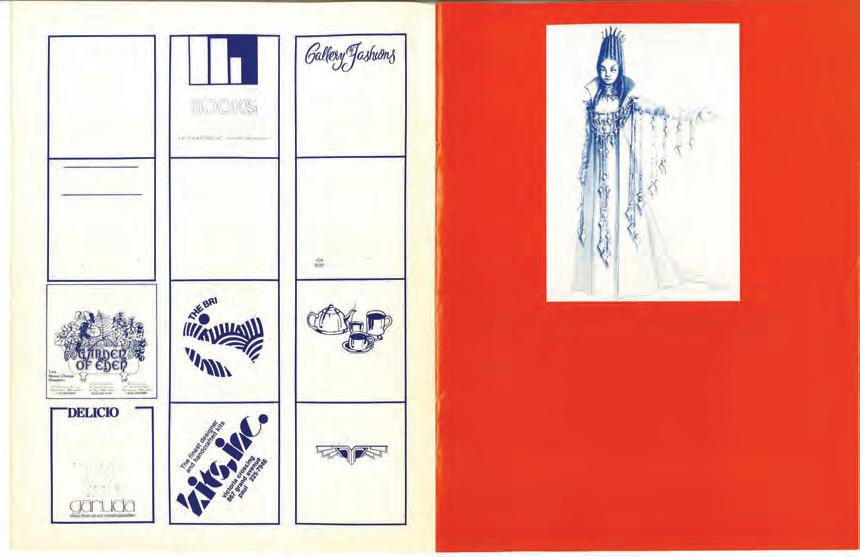
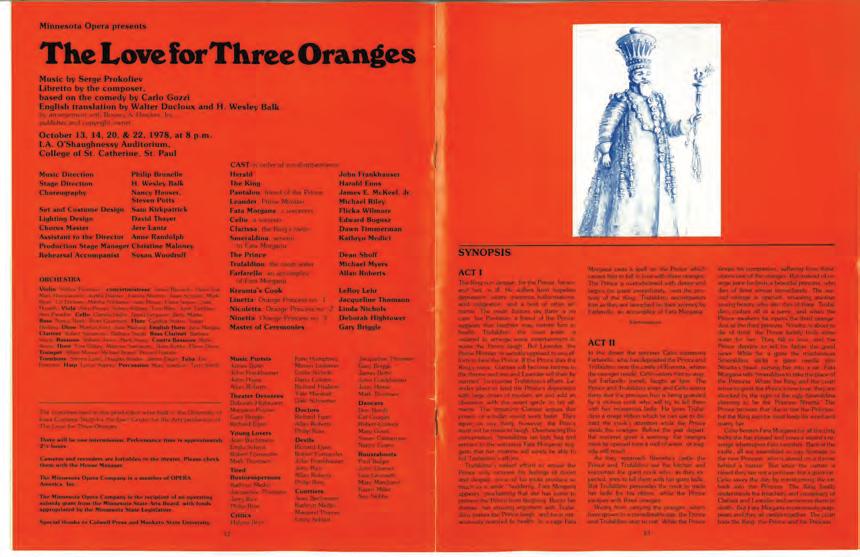
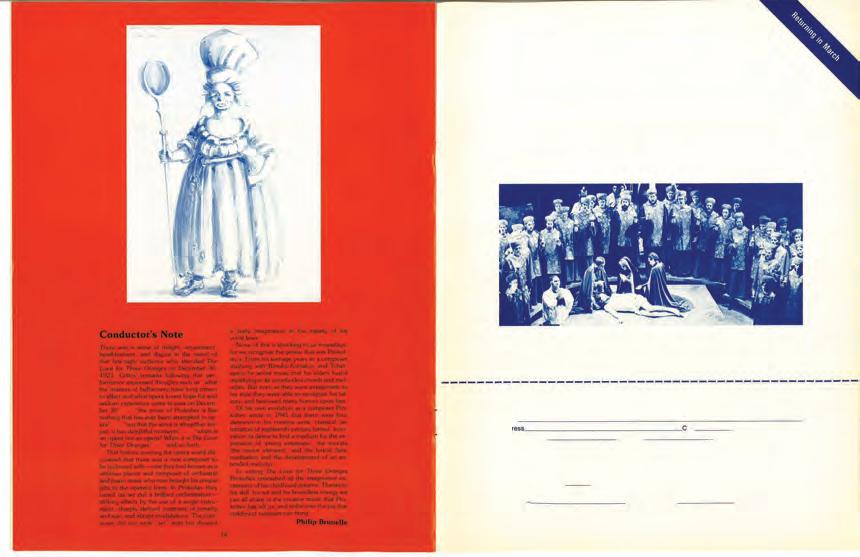
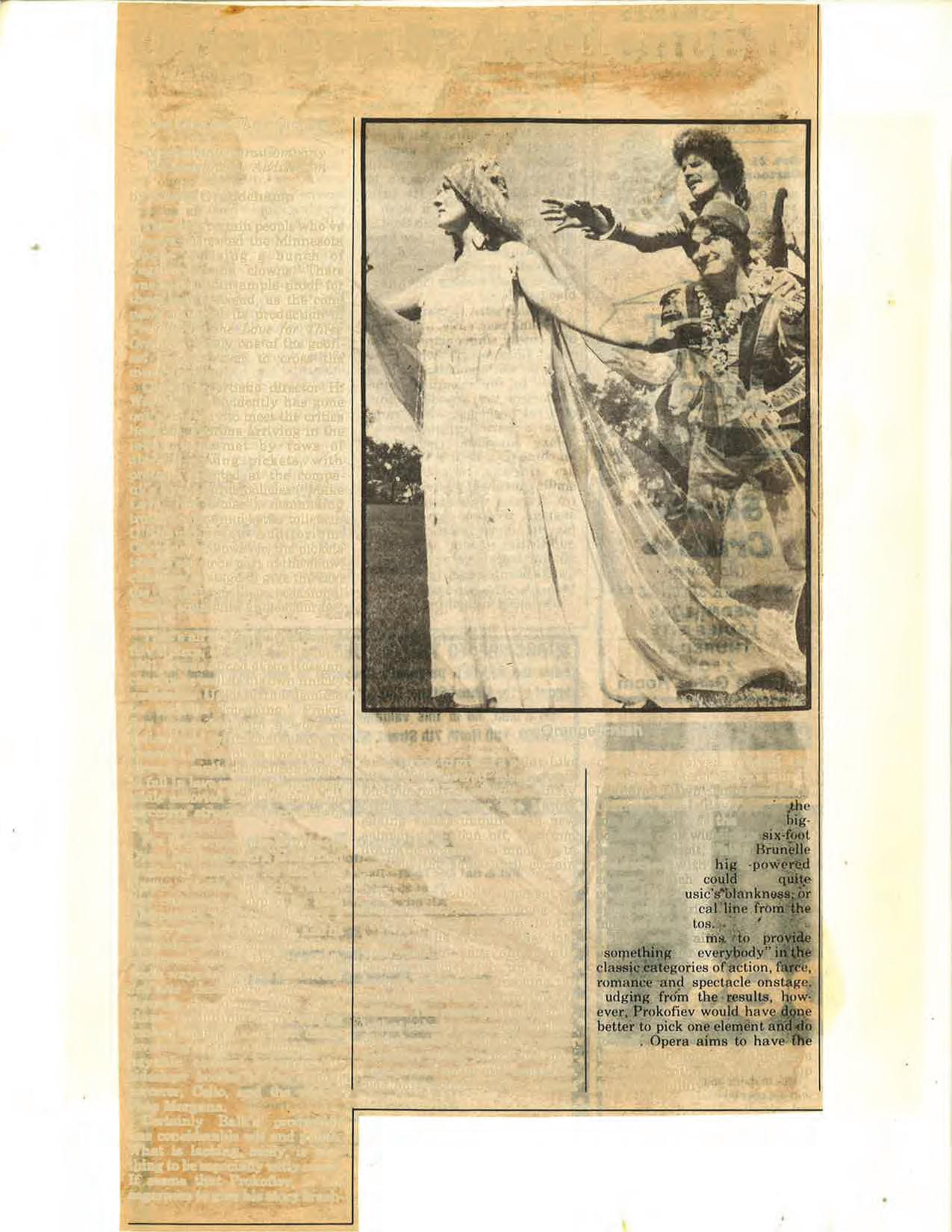
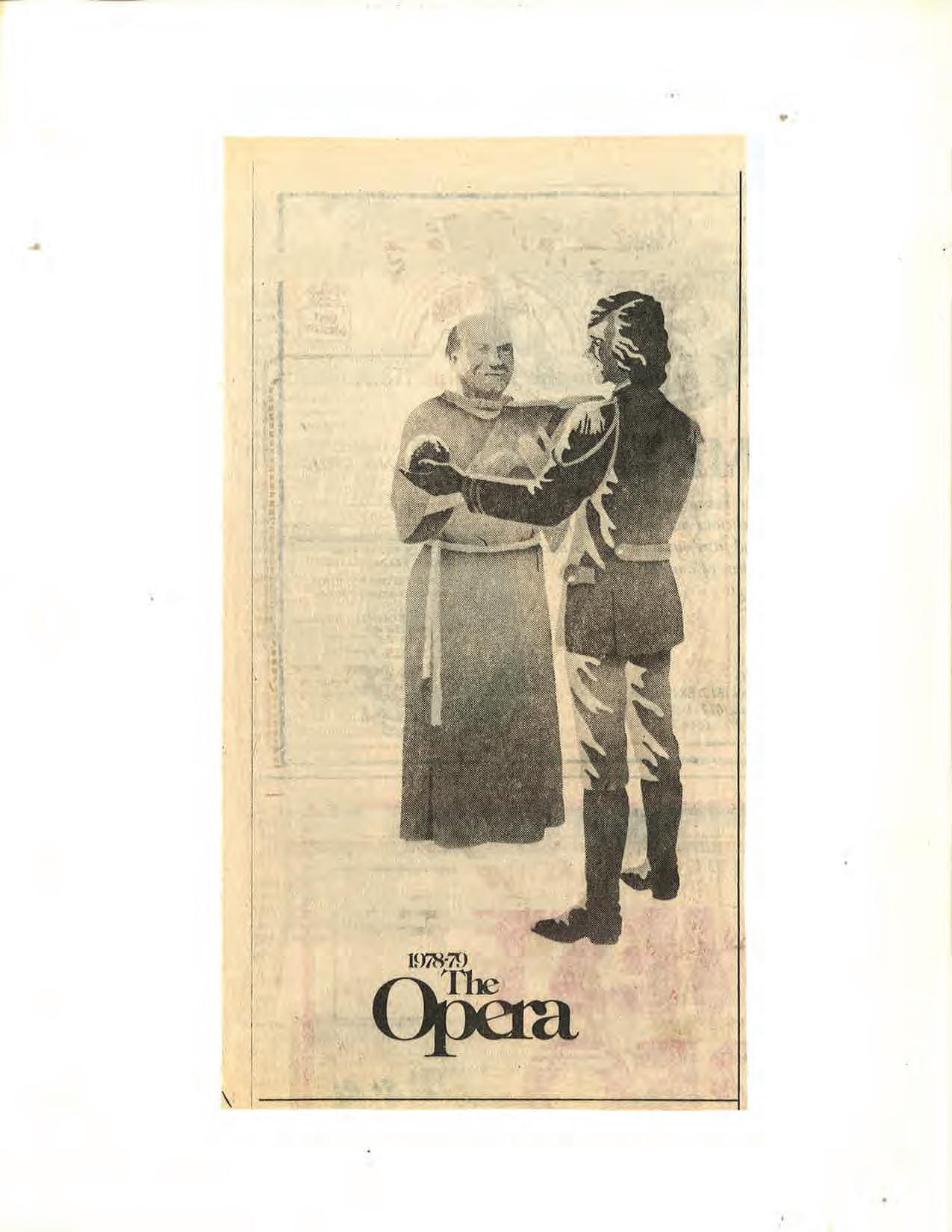
ERIC STOKES AND ALVIN GREENBERG’S first collaboration, Horspfal, premiered at the Guthrie in 1969, was a success. Its subject was both a protest and a satire about the white man’s theft of the Native American’s land and the destruction of the environment that resulted. It traveled to New York City two years later, was widely praised, and was nominated for a Pulitzer Prize.
The best that can be said about their second effort, The Jealous Cellist and Other Acts of Misconduct, which premiered February 5, 1979, at the Anwatin Middle School in suburban Minneapolis, is that at some point it must have seemed like a good idea: an opera designed not just to travel but to involve musical groups from the communities being visited, an opera that addresses the notion of roots and the need for a sense of place. But the work turned out to be dramatically weak, contrived at best, and the identities of its characters only half realized. It turned out to be a comedy that wasn’t funny and a message drama that didn’t persuade or engage us. What could have been the emotional center of the opera, Stokes’s beautifully scored “Song of Place,” near the end of the second act, seemed sewn onto the tapestry of the piece, and it was a badly sewn tapestry to begin with. The production, nonetheless, was cleverly staged by Wesley Balk and conducted with authority by Philip Brunelle (with Jere Lantz conducting the strings upstage). Clearly, it was too elaborate a production to be carted around to schools, as was the plan. Reviews were uniformly negative.
Stokes, a revered teacher for many years at the University of Minnesota, spoke over lunch one day in 1994 about the failure of The Jealous Cellist. It was a subject that still pained him. He and Greenberg wrote the opera as a vehicle for touring with the idea that it would be put on in high schools throughout the state and would involve the St. Paul Chamber Orchestra. “But the whole collaboration started to break down in the middle of the production. It was agony,” Stokes said. “The Chamber Orchestra people washed their hands of it completely. And by that time, Wesley was difficult to work with and wasn’t really helpful. He was sort of accusatory all the time. The show failed. Wesley was beyond being unhappy with it. He cut about two-fifths of the show before we even got a chance to try it. It built up terrible bad vibes everywhere, certainly on my part. I’ll tell you what it did. It killed my chances with Minnesota Opera for the rest of my life. It really hurt.”
Stokes and Greenburg collaborated on a third opera, Appolonia’s Circus, that premiered at Ted Mann Concert Hall in June of 1994. It was well received, but this was to be the last Stokes contribution, as Stokes died in a car accident in 1999. Cynthia Stokes, his widow, who was principal flute in the opera orchestra for many years, said her husband died a disappointed man. “Throughout his life I think he felt he never got the recognition he deserved,” she said.
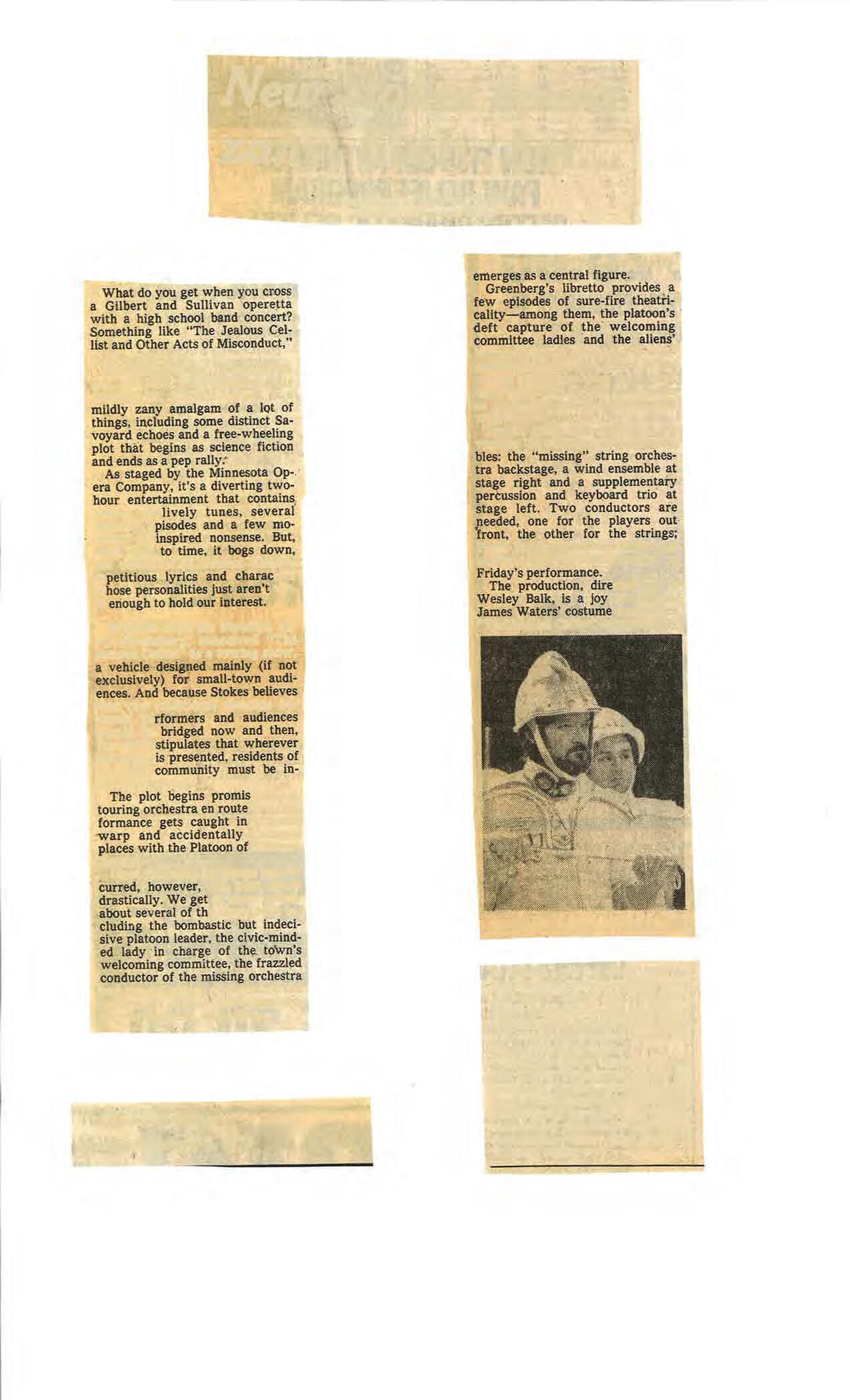


MINNESOTA OPERA PRESENTED its first Verdi opera, La traviata, in four performances at the Guthrie Theater starting March 30. The director, Charles Nolte, a professor in the Theater Department at the University of Minnesota and an experienced playwright and actor, had never staged an opera before, though he had ample experience directing nonmusical plays. Any trepidations that La traviata, usually considered to be grand opera, might suffer on the Guthrie’s thrust stage were laid to rest. Wisely, Nolte gave this famous story a small-scaled, intimate, naturalistic staging, giving special attention to visual and emotive detail to a degree that was almost painterly. Robert Johnson’s Alfredo and Pamela Myers’s Violetta were acted with a sensitivity and nuance that one rarely sees on an operatic stage. John Brandstetter was a sympathetic Germont. Philip Brunelle paced the music expertly and coaxed a colorful performance from the orchestra.

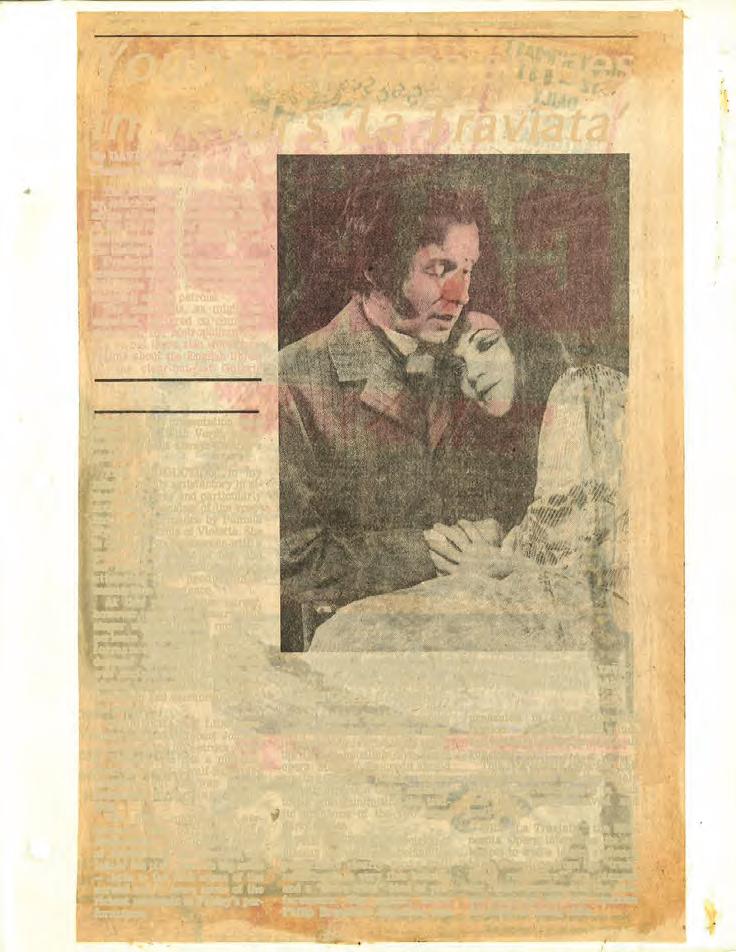
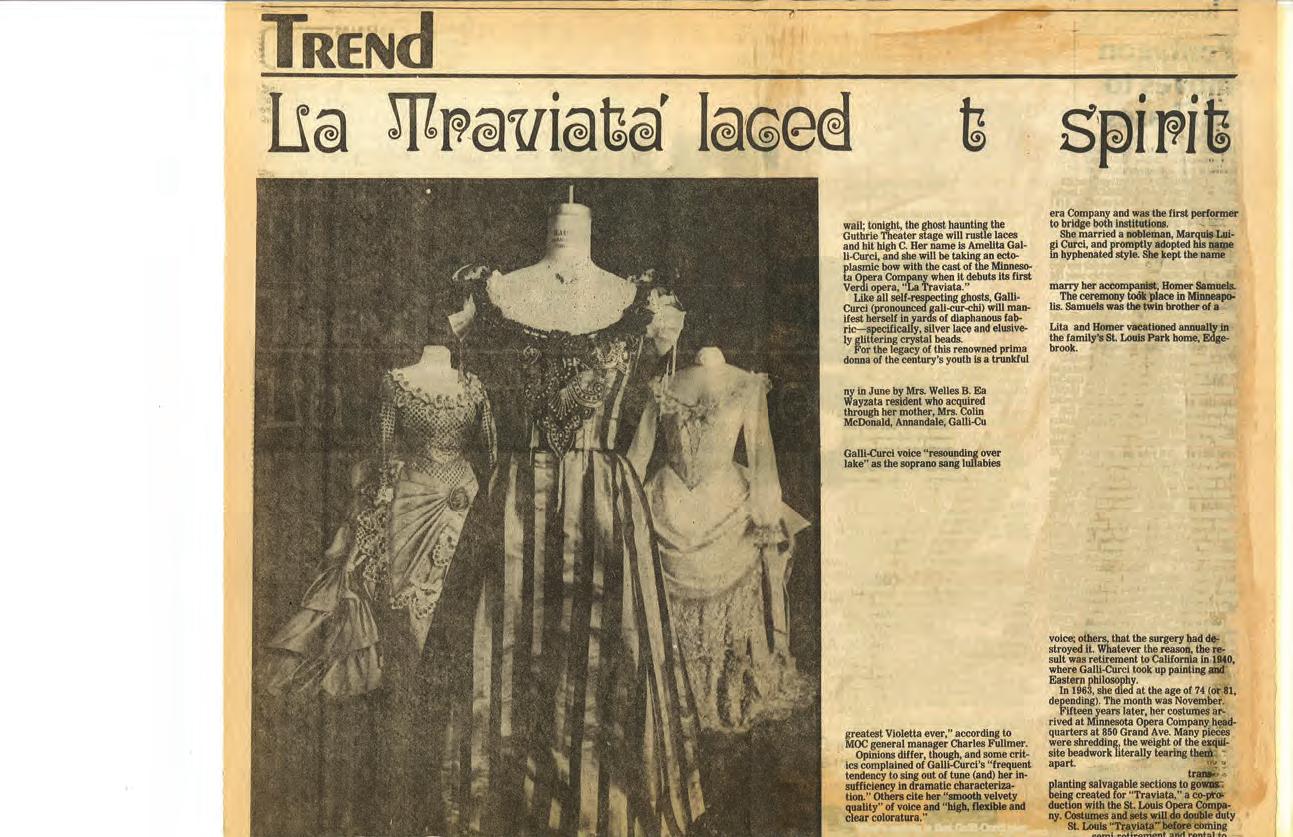
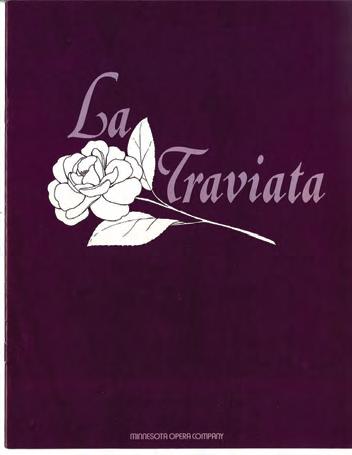

The season closed at O’Shaughnessy Auditorium with a production of Menotti’s The Consul, a Cold War drama about a woman, Magda, desperate to get a visa so she can leave her native country and join her husband, who has already fled to avoid imprisonment for illegal political activity. Unable to flee to freedom, Magda commits suicide. In Balk’s conception, the action takes place in Magda’s mind at the moment of her death, with the result that all the events are seen as flashbacks during that moment. The flashbacks have a paranoid, nightmarish quality; friends become enemies, events flow into each other and overlap, the innocent become guilty. Balk’s concept was provocative and certainly a challenge to stage, though the original story, which pits the individual against the state, is perhaps more meaningful, and has a clarity that wasn’t evident in Balk’s version, where it’s Magda versus her demons and fears. The cast couldn’t be faulted. Barbara Brandt gave an intense portrayal of Magda, and the always impressive Michael Riley played her husband, John, as a character both desperate and idealistic. Bruce Ferden, a gifted young conductor, drew a vivid and exciting performance from the orchestra. Ferden, born in Fosston, Minnesota, showed every indication of a brilliant career ahead of him when he died in 1993 at the age of forty-four.

La traviata was the only box office hit of the 1978–79 season. Its four performances at the Guthrie were almost sold out. Sales were weak for everything else, an indication of trouble ahead, even though there were things to celebrate. The company made its national television debut at the start of the season with its production of Transformations. And the company started touring again, this time with a company formed especially for touring, Midwest Opera Theater and School, headed by Peter Myers.
But the low ticket sales came as a surprise. There was reason to think that the reprise of Gerald Friedman’s staging of Bach’s Passion According to St. Matthew, which had drawn big audiences two seasons earlier, would do the same or better this year, especially since it played during the Lenten season. Not so. “On opening night the cast almost outnumbered the audience,” said general manager Charles Fullmer. The season-opener, Prokofiev’s The Love for Three Oranges, did almost as poorly. “The attitude was that it was a modern thing and people weren’t encouraged to see it,” said Philip Brunelle, who conducted the production. “If we could have gotten them in the door, they would have had a wonderful time. As it was, we didn’t.”

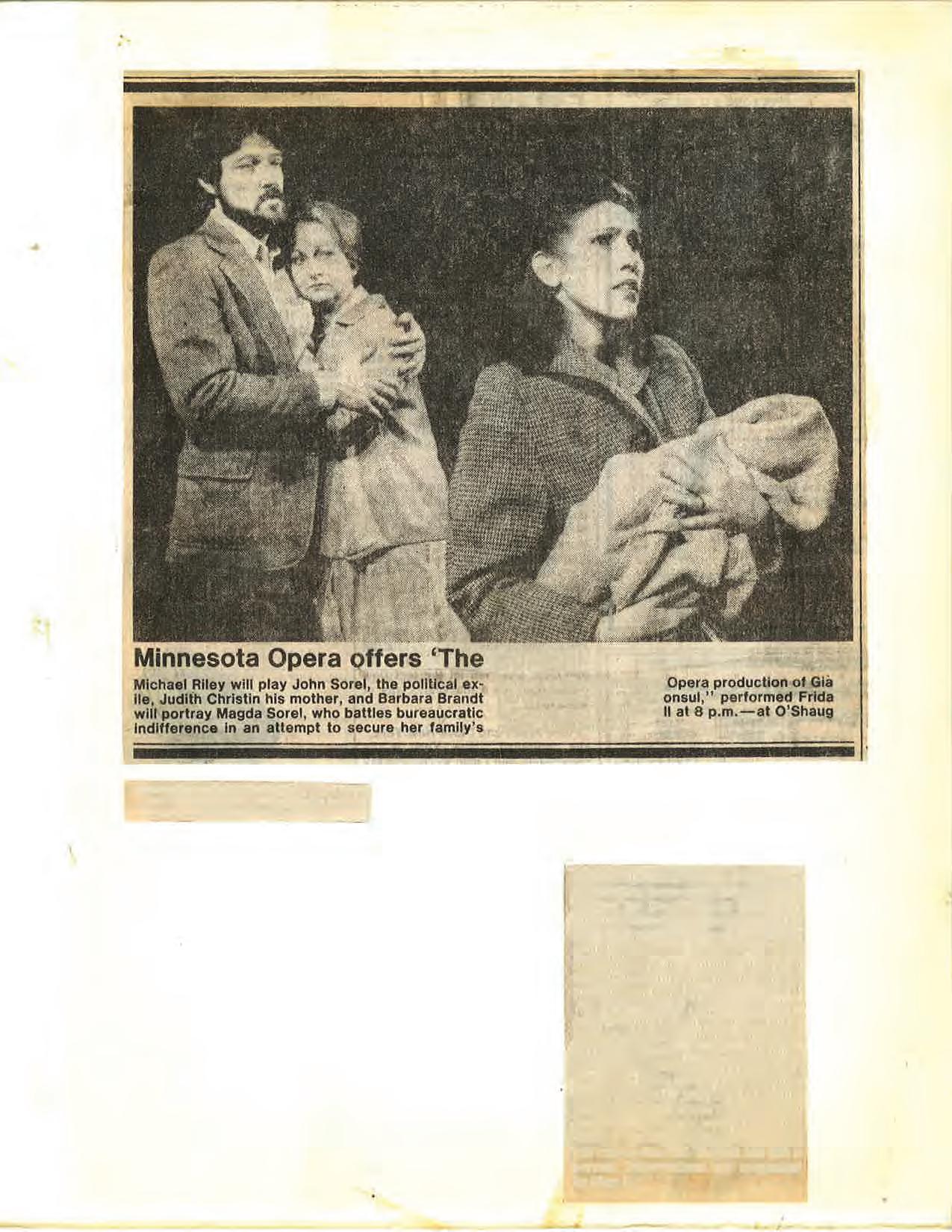

Then came the disaster, The Jealous Cellist. “It was a huge marketing mistake,” a board member told David Hawley at the Pioneer Press. “Just try selling a $12 ticket when you have to tell people they’ll be sitting on a folding chair.” (A $12 ticket was a big expense in 1979.) Fullmer promised a more audience-friendly roster of operas for the upcoming season. There was desperation in the air.
And then in April came exciting news, and not a moment too soon. That month the company announced plans to build a performing arts center alongside the river on Main Street under the Third Avenue bridge. A 1,200-seat theater was to be made out of the Crown Iron Works Co. building and two adjacent structures. The owner of the properties would give them to the company provided the properties were renovated. If an architecture firm were to say the buildings were large enough to house an auditorium, dressing rooms, storerooms, and a library space, the company would seek federal funds to do the project.
More than a few fingers were crossed.
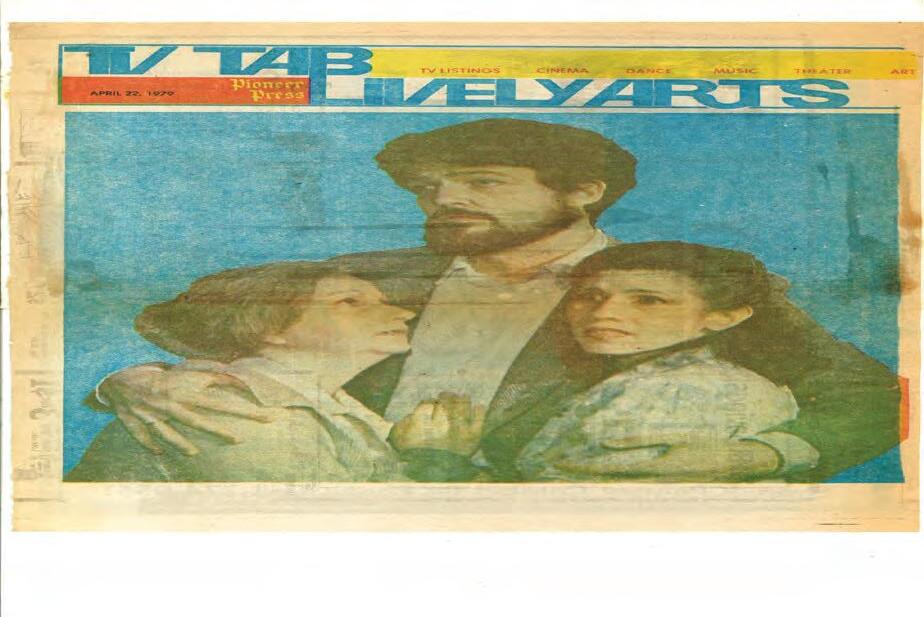

Season Seventeen
Season Eighteen
Season Nineteen
Season Twenty Season Twenty-One Season Twenty-Two Season Twenty-Three Season Twenty-Four Season Twenty-Five Season Twenty-Six
THE EIGHTIES—the Age of Reagan, the greed-is-good decade, the flowering of Yuppiedom—was a roller-coaster ride for the little opera company in the frozen North that wasn’t so little anymore. Two years into the decade, Minnesota Opera found itself close to extinction, a step away from turning out the lights the way that St. Paul Opera had done in 1975. And yet, it was also the decade that saw the opening of the Ordway Music Theater—the company’s first permanent home—and perhaps equally important, the shutting down of the annual Metropolitan Opera tour, which suggested the possibility of attracting some of the Met’s audience. This was the decade, moreover, in which the company restructured its overlarge, unwieldy board of directors while, at the same time, starting an endowment fund and, at the end of the decade, moving into a big new office space in Minneapolis. The eighties also offered a new cast of characters. Some didn’t stay long. Others took off their earmuffs, put their feet up on the desk, and called it home. We speak of Ed Corn, Kevin Smith, George Manahan, Joan Dornemann, Dale Johnson, and Ben Krywosz. They enter stage left.
The most intriguing news at the start of the decade was the announcement that the opera house on Main Street alongside the Mississippi River would be finished in eighteen months, probably by the fall of 1981. The price had risen to $10 million. The company had applied for a $6 million grant from the US Housing and Urban Development Deptartment, while board chairman Sandy Bemis, who had been a prime mover in securing funding for Orchestra Hall, would chair the local fund drive. The project eventually collapsed. For one thing, it dawned on people that the proposed theater’s capacity of 1,200 seats wasn’t big enough to ensure growth. And then when certain people realized that the semipopular Pracna restaurant would have to be demolished to make way for the theater, the resulting brouhaha put an end to the project, burying it in a foot of snow.
Another development that had become apparent by the late ’70s was the demise of the ensemble system, a method of casting that had influenced the company’s style of performance for at least a decade. Wesley Balk believed in the ensemble system fervently, as did one of his mentors, Walter Felsenstein, the famed director of the Deutsche Oper in East Berlin. Felsenstein argued for “the synthesis of singing and
acting techniques,” to be achieved by specially trained singeractors through long rehearsal within a permanent ensemble. The aspect of performance that most impressed out-of-town critics during the Center Opera and early Minnesota Opera years was the high level of acting and the physical freedom the singers displayed, all the result of long days of exercise and rehearsal over a period of many months and years.
Given the direction of the company, the change was inevitable. Minnesota Opera had worked hard to develop a national reputation for spectacularly innovative work and had paid a price for it at the box office. The prior season, 1978–79, had been a disaster. The solution, Fullmer and his staff surmised, was to soften the repertoire, make it more audience-friendly, and do more familiar works. Fullmer called 1979–80 “the most popular season we’ve ever done, and we’re going to stick with it for a while. We have to.” Even Balk reluctantly agreed to the change. “We’ve been surprising people for so long,” he said. “We’d like to see, if we don’t surprise, would
more people come to see us.” The audience-friendly 1979–80 season comprised three familiar works—The Abduction from the Seraglio, The Pirates of Penzance, and La bohème —plus a new commissioned opera, Rosina, by Hiram Titus and Barbara Field. And this, Balk made clear, sounded the death-knell for the ensemble system. “With a familiar opera,” he said, “audiences expect a familiar sound,” which meant importing singers for specific roles. Or, to be precise, hiring expensive singers with big voices of the sort that one might hear on the Saturday afternoon Met broadcasts. The locals, in other words, would no longer suffice. Fullmer admitted he had a specific audience in mind, “the St. Paul crowd,” those who “so vigorously supported the old tradition-oriented and now-defunct St. Paul Opera. We’re hoping,” he said, “to get back some of the old St. Paul support.” Whether Minnesota Opera ever had that support is a question to ponder. Nonetheless, the change paid off. By November 1, 1979, the company had sold 2,000 season tickets. A year earlier, the tally was 1,150.

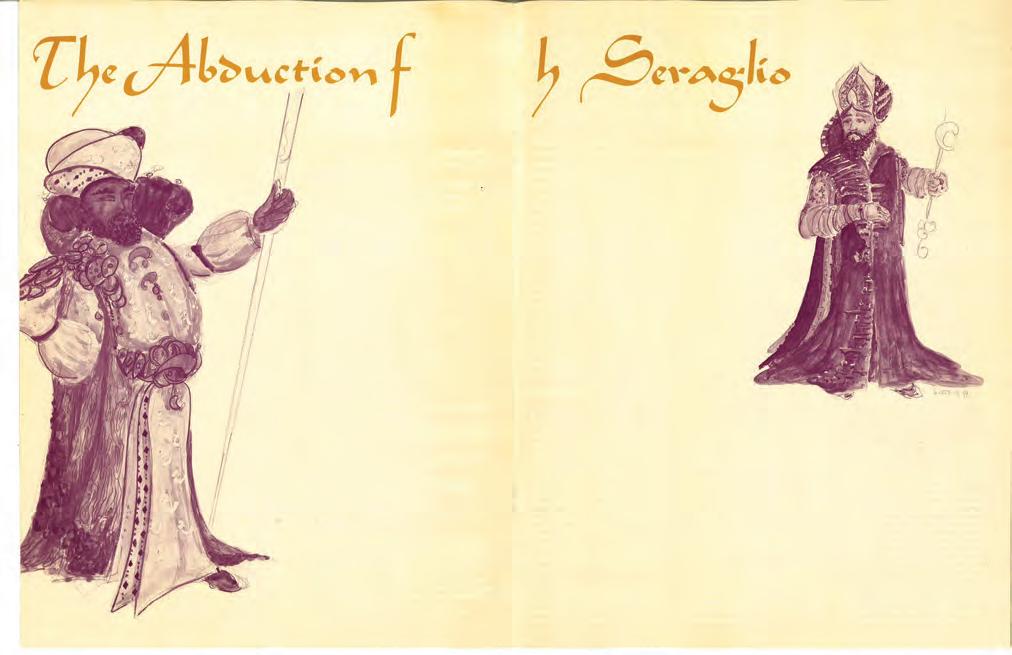

THE SEVENTEENTH SEASON opened November 3 at O’Shaughnessy Auditorium with a new production of Mozart’s The Abduction from the Seraglio, which had been a success for the company in 1966. Apparently, Minnesotans have a special fondness for operas about trouble in the Middle East, because they liked this one too, with its new staging by Wesley Balk. A visual surprise leaped out at every turn thanks to set designers William Saltzman and James Waters and the whimsical talents of the staff costumers. The set—giant gilded pea pods—looked like it belonged on the lawn of the Walker Art Center. The costumes were equally lavish—turbans and jewels, flowing robes, bare-chested Turkish guards, and a haremful of scantily dressed maidens. The cast was strong. Soprano Roseann Del George and tenor Neil Rosenshein were the impressive lovers Constanze and Belmonte. Soprano Marsha Hunter was Constanze’s saucy maid Blonde, and tenor Gary Briggle was Belmonte’s sharp-witted valet Pedrillo. Conductor Bruce Ferden demonstrated a firm grasp of Mozart’s comic style.
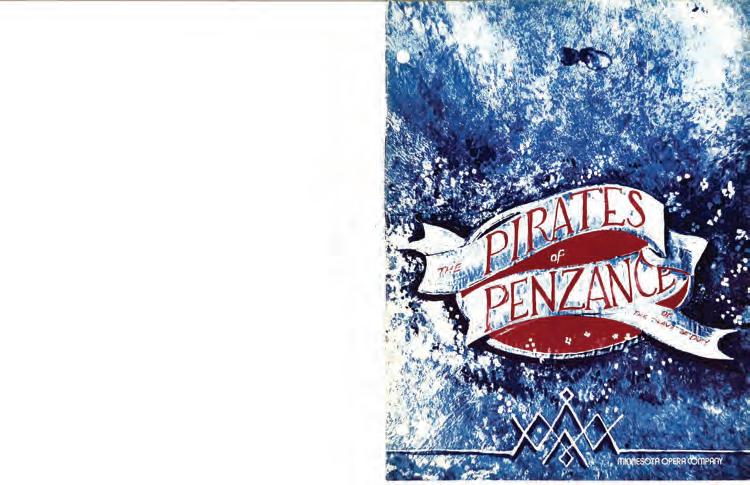
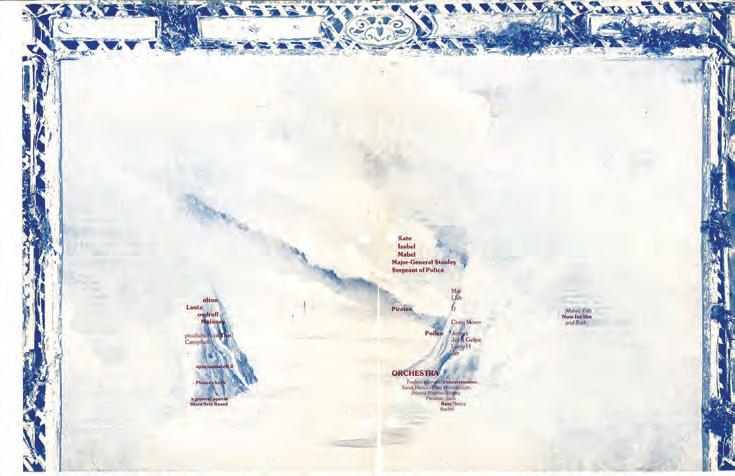
One of the highlights of Minnesota Opera’s 1975–76 season had been Robert Moulton’s staging of John Philip Sousa’s comic operetta El Capitan . Wisely, the company re-engaged Moulton for its first venture into the brightly lit world of Gilbert and Sullivan, the ageless Pirates of Penzance . Proper G and S style is never all that proper. Its essence is a certain playfulness and theatrical excess, and a refusal ever to let reality intrude. And for their part, the performers must sing and speak beautifully and not bump into the furniture. Moulton, it might be said, wrote the book on this style, as anyone will attest who saw the melodramas he staged each summer at the Stagecoach Theater in Shakopee, Minnesota, with Vern Sutton as his music director and star performer. Moulton’s production, smartly conducted by Philip Brunelle, was close to perfection.
One of the keys to Moulton’s style could be seen in his production numbers. There were times when it looked as though things might not all fit together, when, for example, a particularly complex line of choristers starts moving and fanning out, Busby Berkeley–style, and must meet in exact sync with another line now slowly forming something suspiciously close to an inverse tetrahedron. One leg out of place and the whole thing could topple, but it never did. Nor did the principals, a particularly winning crew, topple at any time. Voices were first-rate. Tenor Michael Myers (Frederick) had a voice big enough to give special
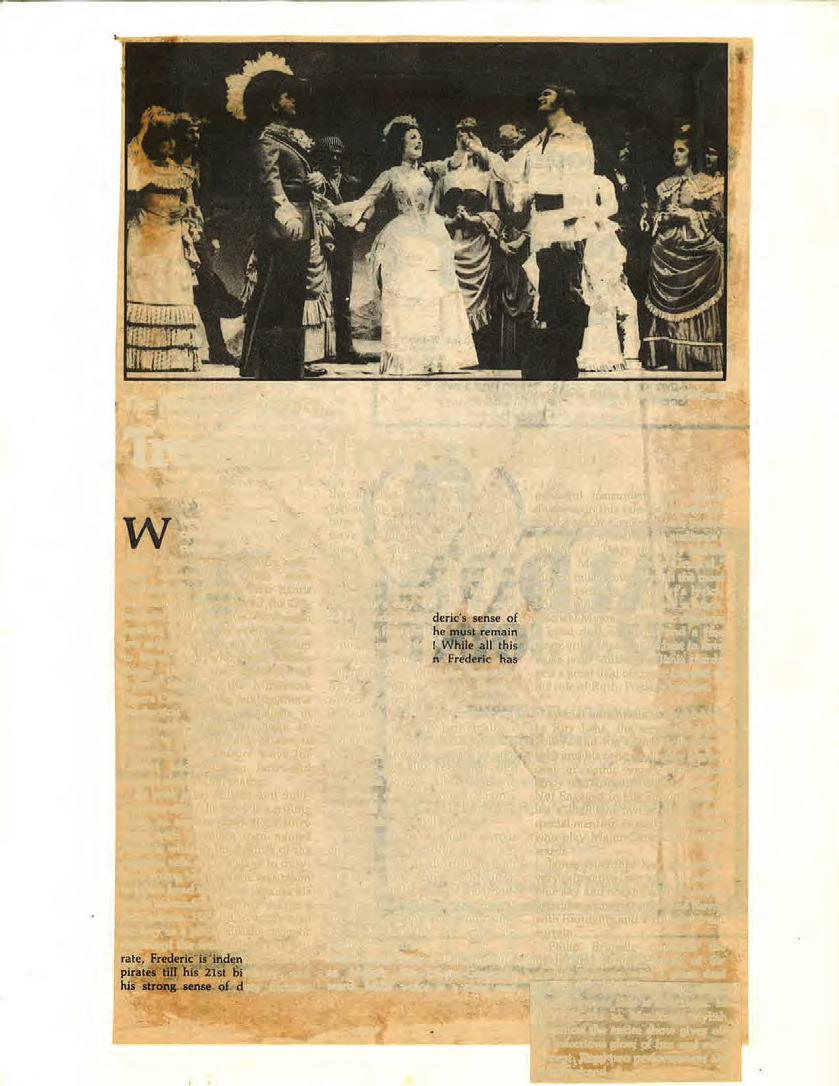
heft to operatic numbers like “Now to the Pirates’ Lair,” while Erie Mills was an especially engaging Mabel, strong in characterization and easily equal to the coloratura demands of the role. This was a G and S hero-heroine team to contend with: steadfast, firm in their ideas, their eyes always on the horizon. G and S heroes and heroines hear a different drummer. And the rest of the cast contributed mightily—Janis Hardy as Ruth, Edward J. Crafts as the Pirate King, and, by no means least, tenor Vern Sutton as the Major-General, as funny and trippingly articulate as any Major-General could hope to be.
VOICES WERE EQUALLY IMPRESSIVE in the company’s first production of La bohème, which opened at the Guthrie on March 15, 1980. Soprano Sherri Greenawald was a fragile and poignant Mimì, her voice able to soar even in the Guthrie’s dry acoustics, and her counterpart, Vinson Cole, who played Rodolfo—rather stiffly— displayed one of the finest tenor voices heard from this company in many seasons. Gloria Capone was a saucy Musetta. Writing in the Tribune, Bob Lundegaard noted the “creeping conservatism” of the company’s repertoire choices while lauding Balk’s staging as a “model of economy that almost made a virtue of the Guthrie’s tiny stage.” Philip Brunelle conducted this famous score, showing a firm grasp of Puccini’s emotive style.
The production continues to be referred to in certain circles as “the bohème from hell.” Cast and director, it is said, were at odds during much of the rehearsal period, though the actual performances failed to suggest any disharmony, musical or otherwise.
Janis Hardy recalls the disarray of the production. “My kids were in that bohème,” she says. “I remember being shocked when I arrived early to pick them up one day. Wesley was talking but being largely ignored by the principals, who were chatting amongst themselves. I was stunned and aghast!”
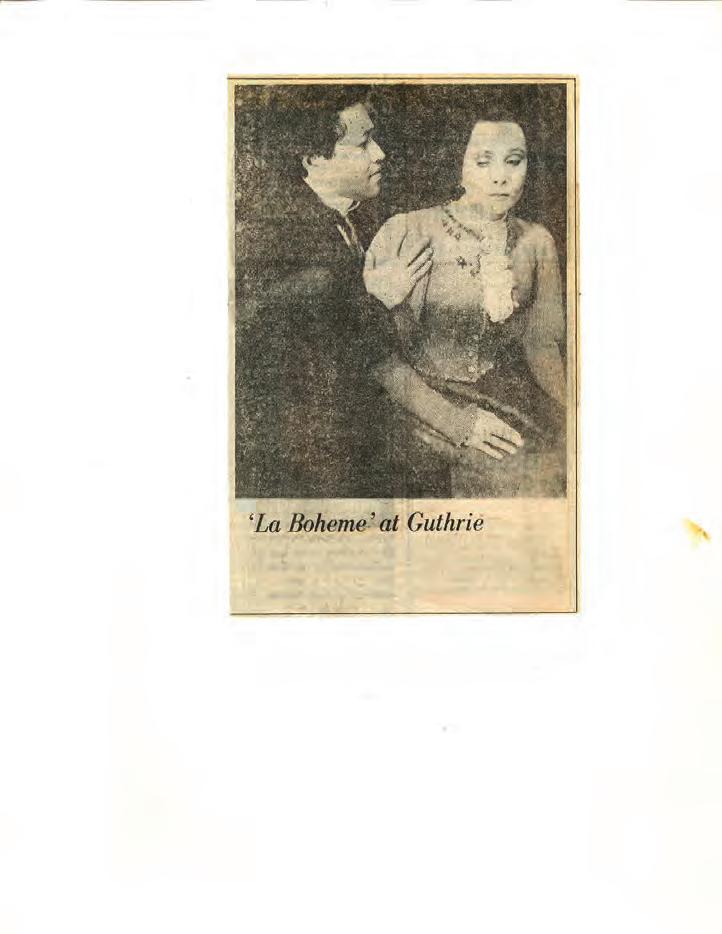
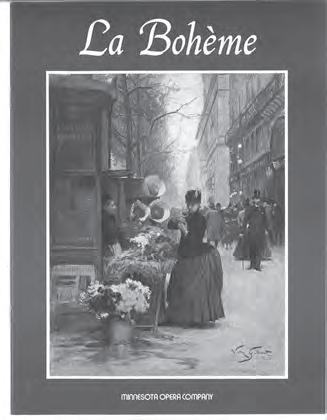
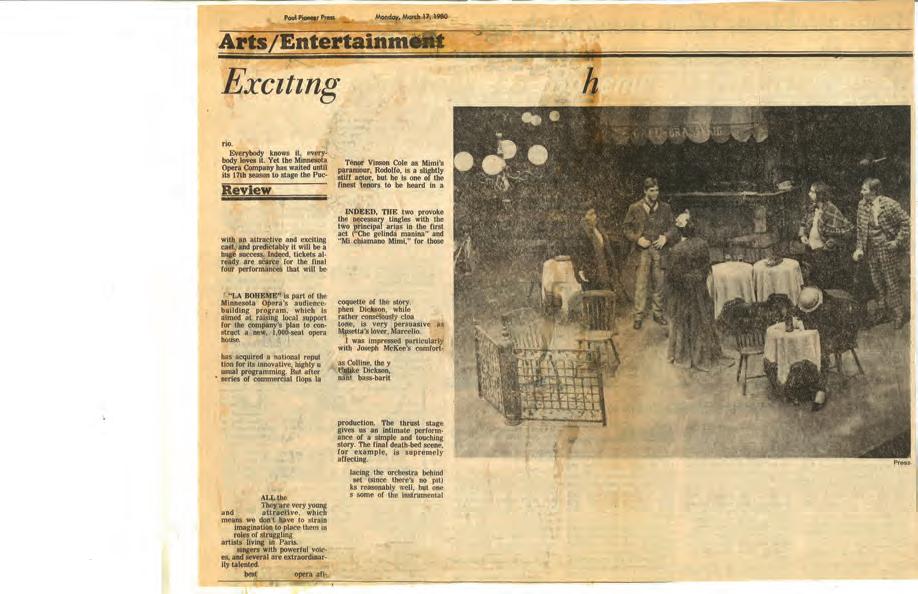
James McKeel, who sang the role of Schaunard, had similar reflections: “What was so crazy about that bohème was that they lifted the cast from a production at the Opera Theater of St. Louis, which had been a success, and transplanted it, like it was a repertory group, to Minnesota. It was a sticky situation to be in because I really enjoyed the experience in St. Louis, and I so admired Wes and felt for what he was trying to accomplish with a group that already had a version stuck in their minds.”


Another incident connected to this production concerns the indefatigable Philip Brunelle. It’s his story to tell.
When I finished conducting the dress rehearsal of bohème at the Guthrie, Nigel Redden, the Walker’s performing arts coordinator, was standing backstage and asked what I was doing that evening. I told him I was thinking about coming to the Walker to see the Napoleon film because the noted silent movie pianist Arthur Kleiner was accompanying the film. "Well," Nigel said, "Arthur has a temperature of 101 and cannot perform. The only person we know who can improvise like him is you." I then asked if I could see the film—it was 3:00 p.m.—and he said the film is five hours long. So I asked if he could give me some kind of synopsis of the story and tell me whose music accompanied the original film. It was Honegger. I told him I knew Honegger’s music and he gave me a synopsis. However, I told him I couldn’t play the second night because of the premiere of bohème. He said that wasn’t a problem. They would record me and play the recording. I went home to change, and my wife Carolyn asked me where I was going. When I told her I was going to accompany Napoleon, she said, "It’s five hours long. You’ll fall asleep!" I promised her I would stay awake. It was quite an experience, playing improv for a film I had never seen. Things like a storm at sea lasted about thirty minutes, so you didn’t want to get too stormy too soon.
The next night, at the Guthrie, when Brunelle gave a downbeat for the orchestra to start La bohème, the Walker sound technician across the hall was already playing the recording of Brunelle’s improvisations to Abel Gance’s Napoleon
PHILIP BRUNELLE SPOKE at the start of the 1979–80 season of finding a balance as far as repertoire. The balance that season leaned toward the popular and, as a result, attendance rose. The management, not in a mood to rock any leaking boats, played it safe once again in 1980–81, offering two guaranteed crowd-pleasers—The Merry Widow and Carmen —plus a rewrite of Conrad Susa’s grim Black River and a double-bill of one-acts by Dominick Argento: A Water Bird Talk and Miss Havisham’s Wedding Night
Bad news came in the autumn of 1980. Company manager Gale Sharpe resigned. Sharpe had been the spine of the organization for more than a decade. She started as John Ludwig’s secretary, then became production manager, then business
manager, then, in her last years, company manager. “It was time,” she said. “There was a lot of pressure on the company at that point to go sort of middle of the road. And I wasn’t as interested in that as I had been in the new works. But, you know, we never had a deficit. It was in ’82 that they got into financial trouble. When I left, I remember a couple of people saying, ‘Can I go with you?’ It just wasn’t . . . the dream was over.”
Just a few months after Minnesota Opera abandoned the Main Street theater project, the company’s board of directors sent a letter of intent to the Ramsey County Council of Arts and Sciences expressing its interest in a proposed multipurpose “music theater” that it would share with the St. Paul Chamber Orchestra and other organizations. This time the builders would make certain that no semipopular restaurants would get in the way.
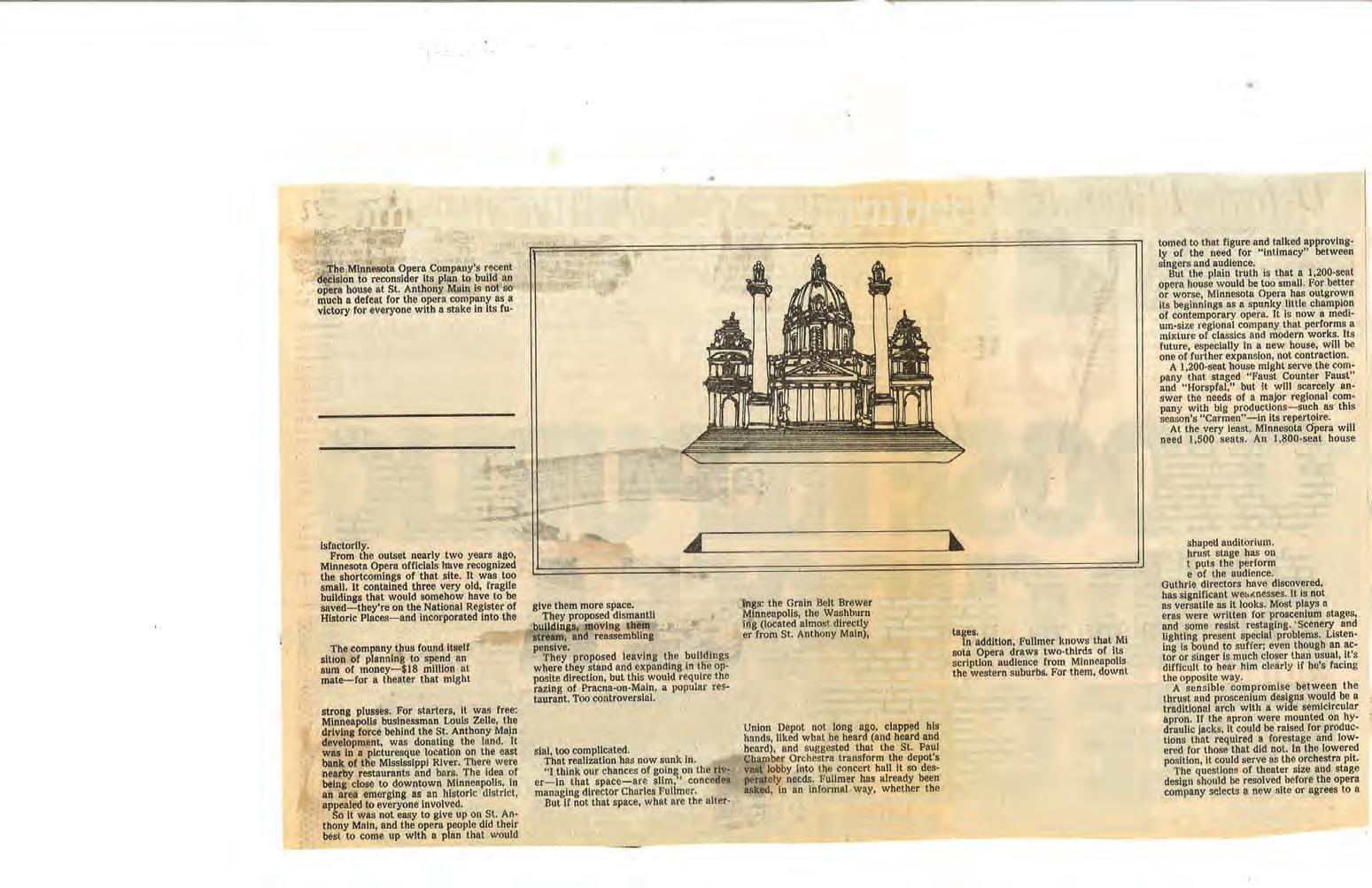
MINNESOTA OPERA OPENED its eighteenth season on November 7, 1980, with Robert Moulton’s sprightly but not altogether successful staging of The Merry Widow, the highlights of which were Barbara Brandt’s fun and foxy widow and Vern Sutton’s Danilo, a paragon of guile and temperament. On the downside was the young American tenor Vincenso Manno who, as the ardent Camille, tended to lunge at his top notes and missed quite a few of them. Radio personality Charlie Boone, playing the embassy adjutant Nisch, seemed ill at ease on opening night, a man in search of both a character and the dance steps in act two. The sets by the usually inventive James Bakkom lacked the grandeur and opulence one hopes for in this show. The act three set with its intestine-like curvilinear lines looked more like a strip club than the fabulous Maxim’s. Two numbers were added from the original production, one of them the exquisite Butterfly Dance. Philip Brunelle orchestrated them, as the original orchestration disappeared long ago. Despite the mistakes in casting and design, Moulton’s characteristic playfulness was displayed amply and aptly throughout the evening.
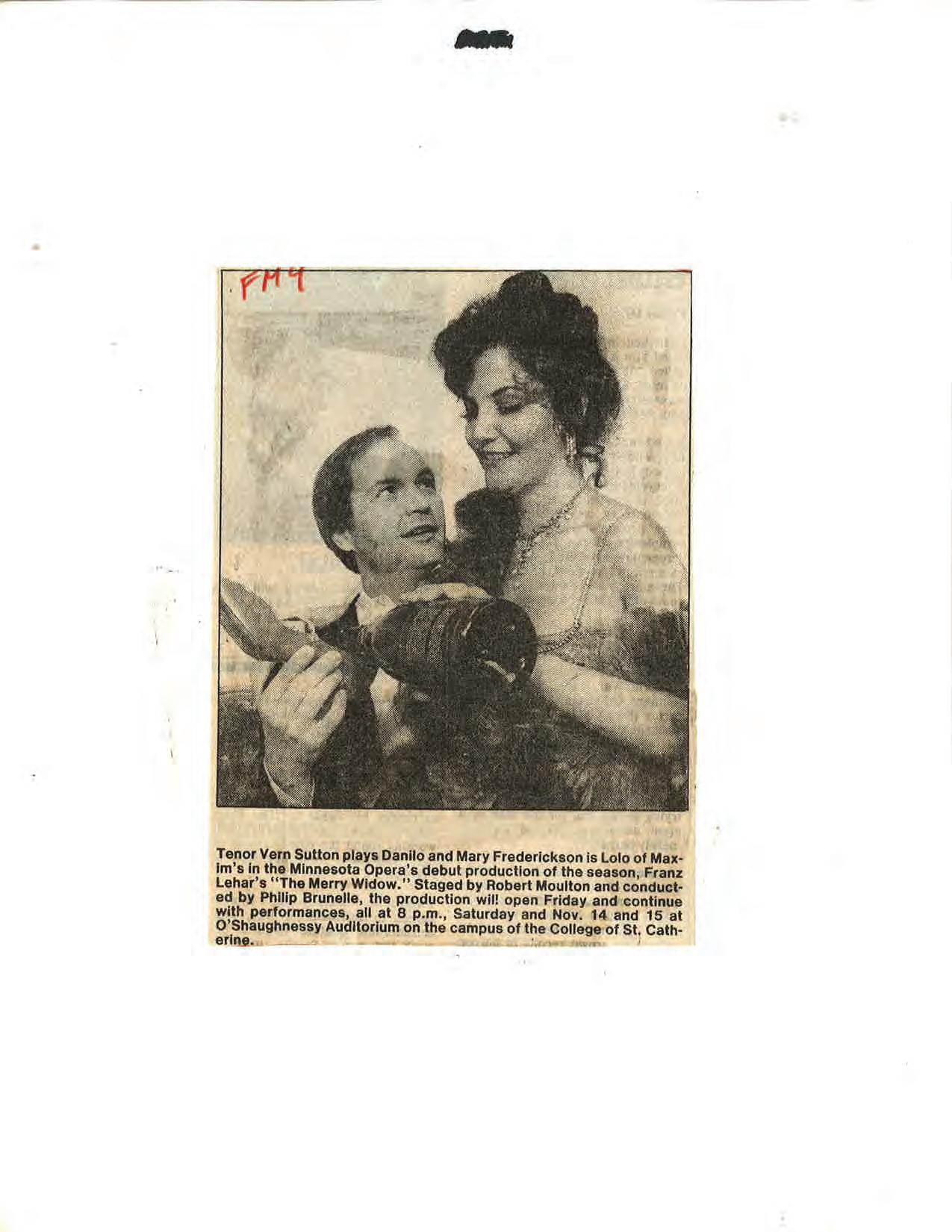


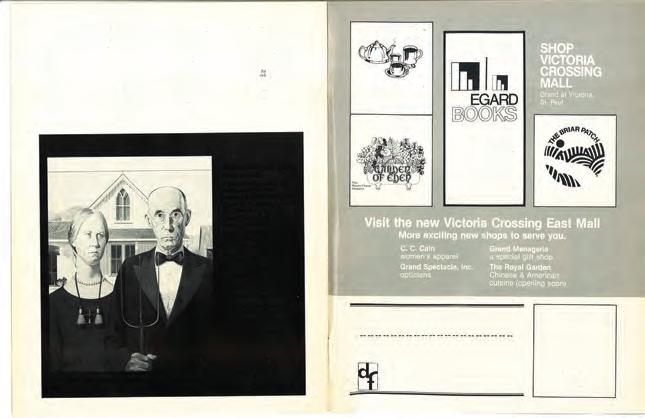
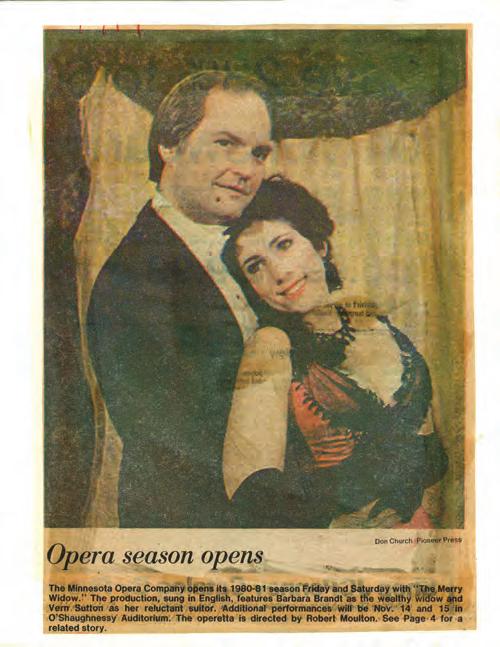
The ads for the new version of Black River were spooky: “What made the people of Black River Falls burn down houses, go insane, and commit suicide in record numbers?” The much-praised Protestant work ethic—the violence it can do to relationships and the environment—was one of the answers that Conrad Susa and his librettist Richard Street offered in their grim but sensitive portrait of tortured lives in nineteenth-century Wisconsin, a work premiered at O’Shaughnessy Auditorium on February 21, 1981. Christianity was another source of woe. The repressive small-town variety—in which “sin is never dealt with lightly”—offered believers little consolation other than the hope of dying as soon as possible.
Susa and Street’s rewrite of Black River turned out to be a significant improvement over the version premiered at O’Shaughnessy in 1975. What seemed back then to be an interesting but overly complex and static work about smalltown life a century ago—a bramble-bush libretto festooned with lots of pretty, flowery music—had been turned into a work of depth and, at times, intense feeling, a fusion of music and words as dramatic as it was thought-provoking. The form remained cinematic, with frequent flashbacks, flashforwards, and dissolves, and the basic content a series of dreams and memories. But the narrative now was less murky, though the first act still contained too much exposition. The remaining two acts flowed along effortlessly and consistently. And it was all tellingly staged by Wesley Balk and featured impressive multidimensional performances by Janis Hardy, Jennifer Ringo, and Barbara Brandt in the principal roles, with superb conducting by Bruce Ferden.


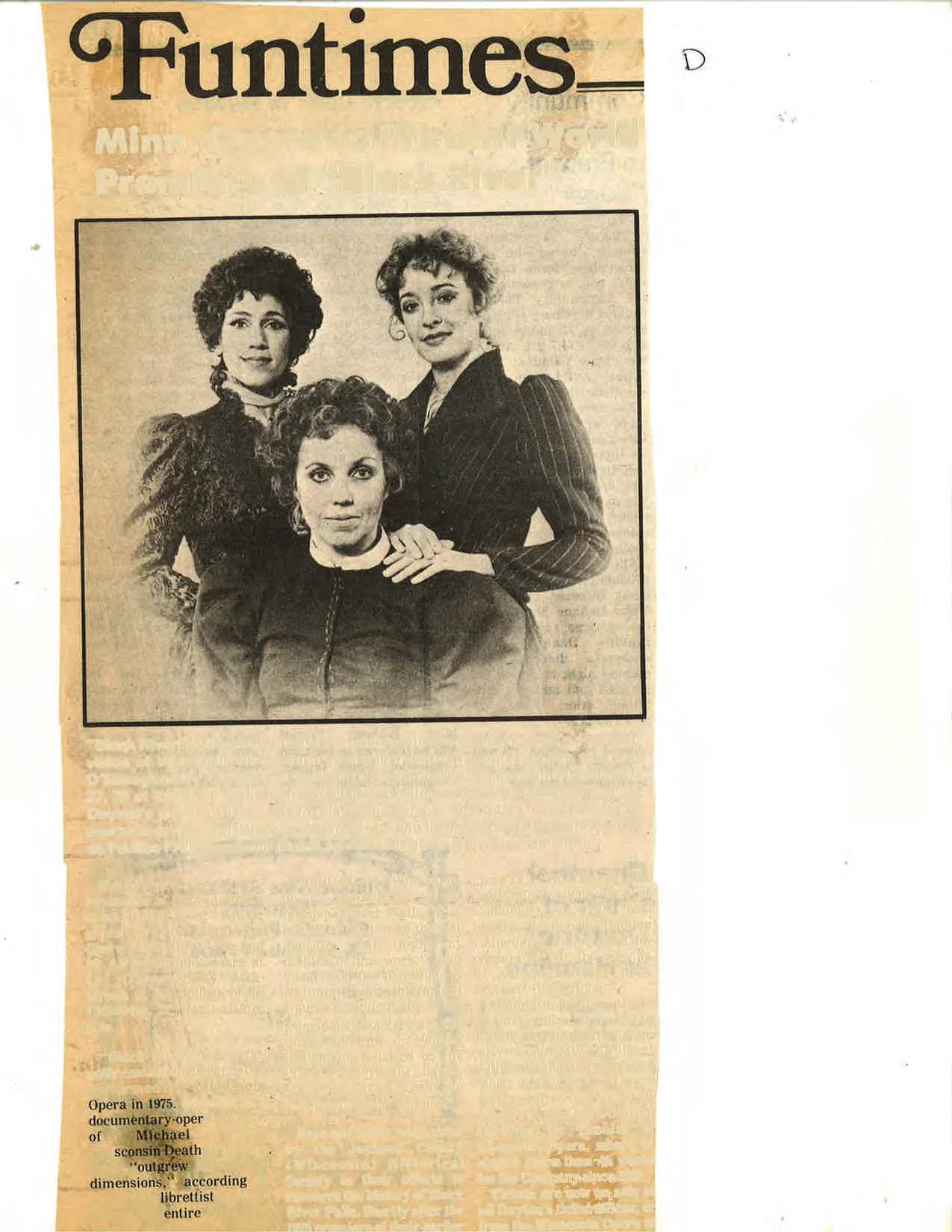
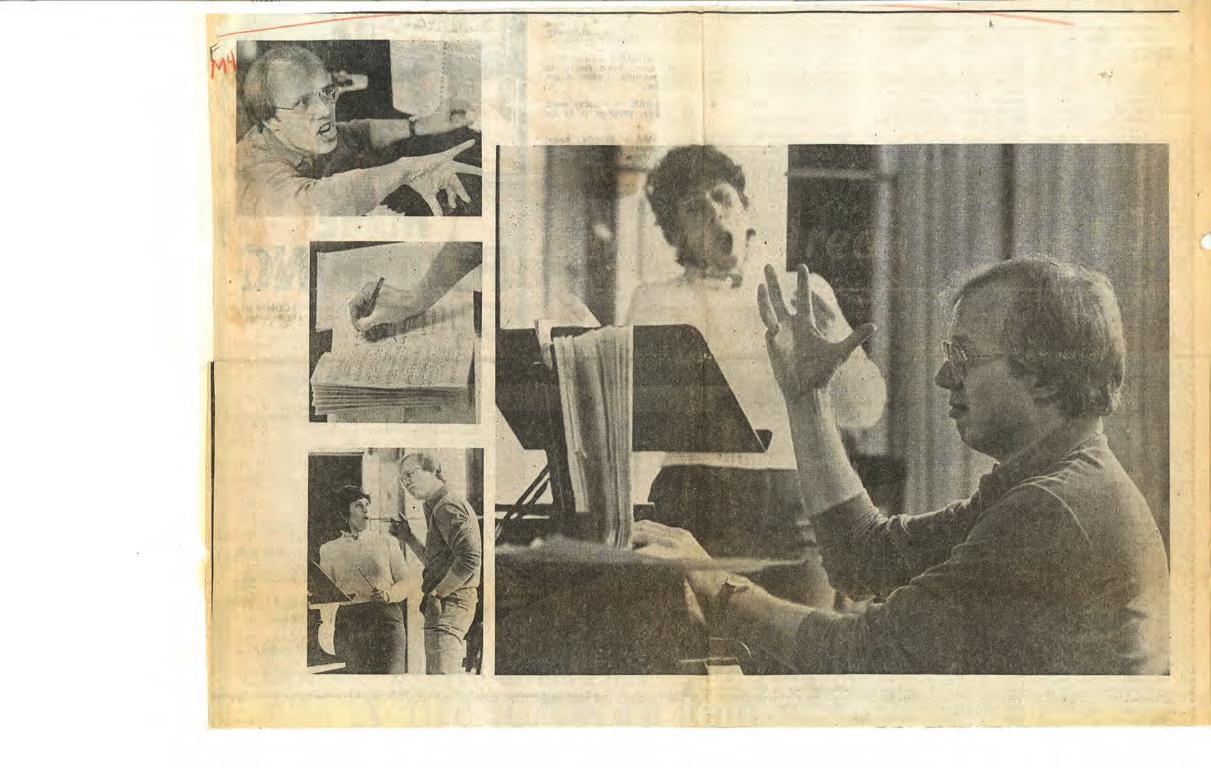
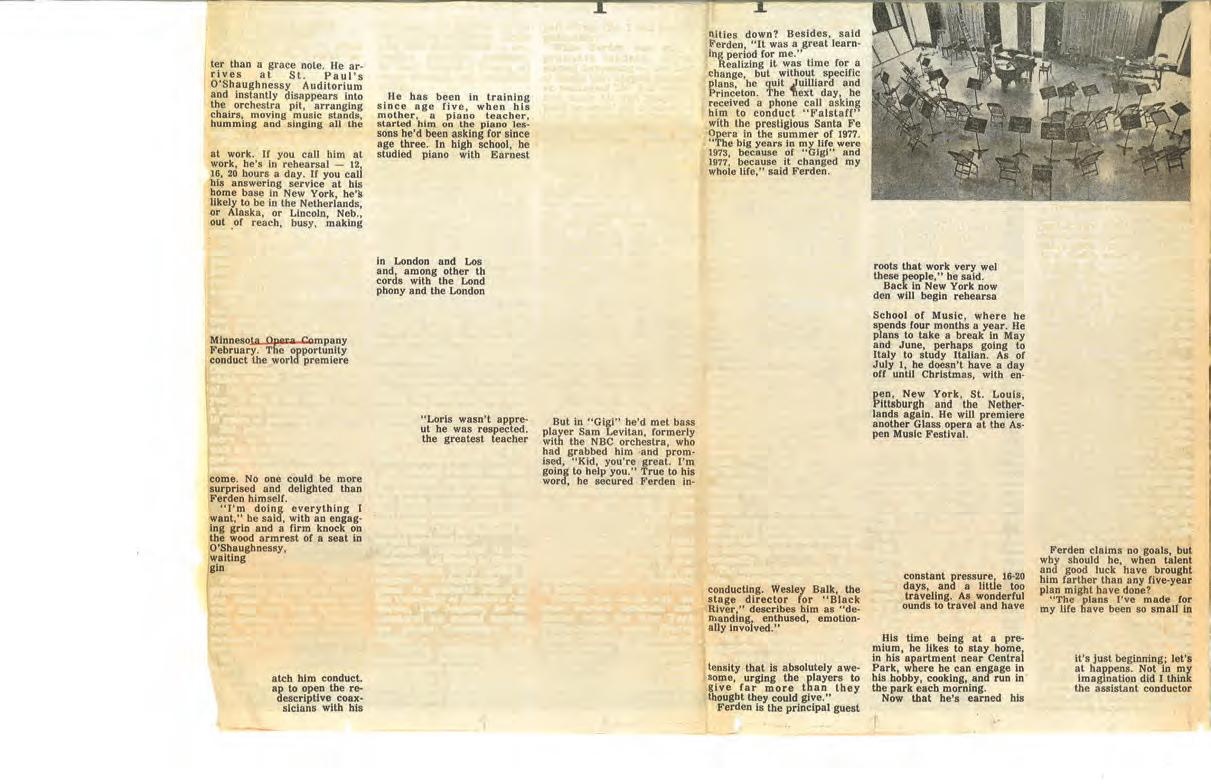
FEW DIRECTORS GRASPED the demands and peculiarities of the Guthrie stage as thoroughly as Balk did. The theater’s thrust stage and the closeness of the audience to that stage demanded realism, a sense of intimacy, and a threedimensional placement of performers quite different from the pretty stage pictures of the traditional two-dimensional proscenium arrangement. Besides that, the performers on a thrust stage must be in almost constant movement so that everyone in the audience can see them and hear them. In a more reasonable world, no one would try to stage an opera at the Guthrie, and especially not any sort of grand opera. Operas were staged at the then-new Guthrie starting in 1964 simply because it was next door to the Walker Art Center, which was sponsoring the new opera company and had rights to the theater for a certain amount of time each year. That much said, Balk delivered an effectively scaled-down Carmen at the Guthrie in March—intriguing and thoughtful—with carefully detailed characterizations rather than grand gestures. The result was a fresh look at this famous tale of doomed love under the hot Spanish sun, at the center of which was a striking performance from Cynthia Munzer in the title role: sexy, flirtatious, petulant, earthy, ill-mannered, and often quite funny. And Munzer had the voice for the role too: rich tones in the lower middle range, assured top notes, and an ability to play off registral colors one against the other. Lisbeth Lloyd was a suitably innocent Michaela, but Howard Hensel wasn’t up to the task of Don José, either vocally or dramatically.


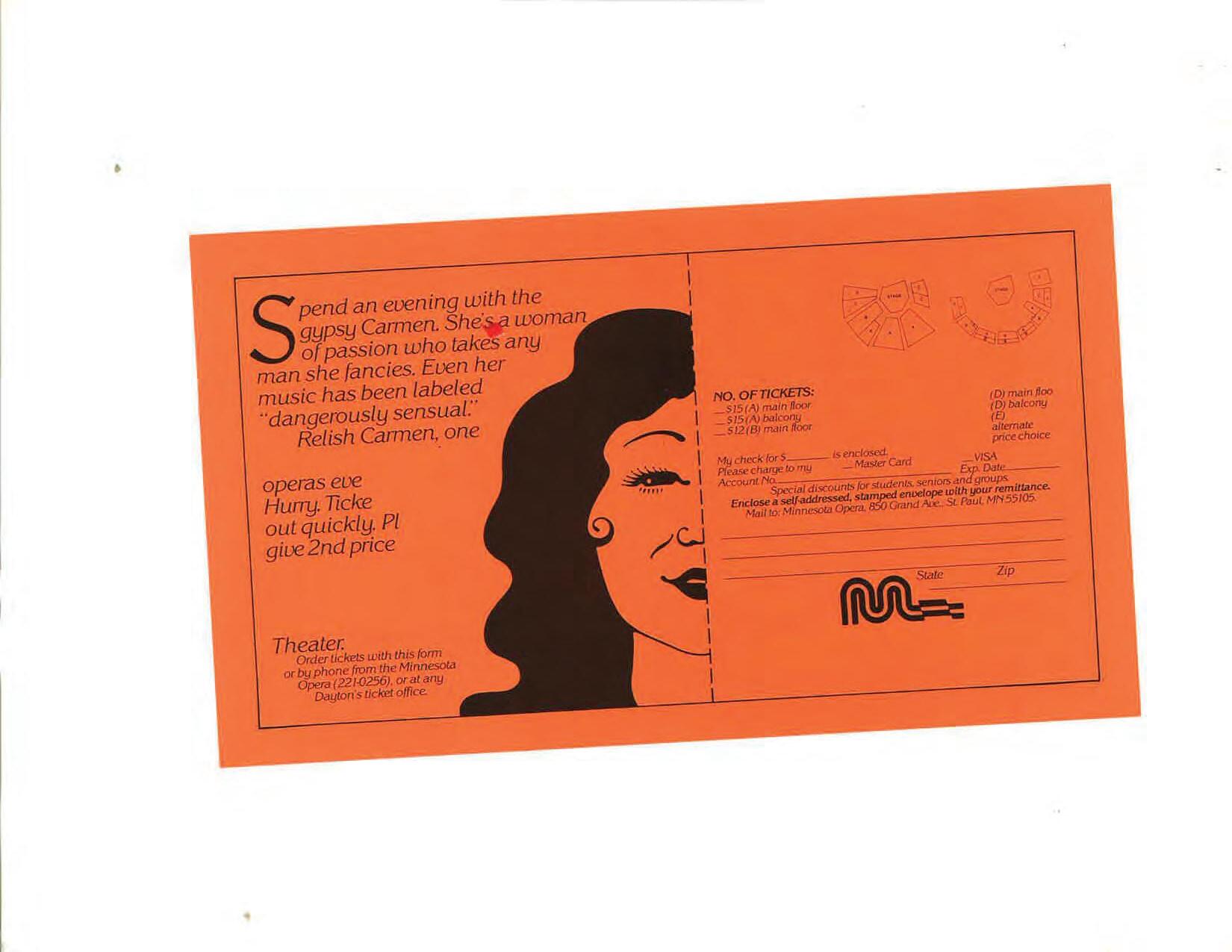
Dominick Argento provided the season finale: two one-act operas, both monodramas, Miss Havisham’s Wedding Night and A Water Bird Talk Havisham, which received its premiere in these performances, was drawn from Argento’s opera Miss Havisham’s Fire, a treatment of Dickens’s Great Expectations that was premiered by the New York City Opera in 1979. The opera was not well received. Argento often called it his “biggest bomb.” The current piece was an expanded version, running about a half hour, of a large aria from the opera in which Miss Havisham, by then an old lady, tells how she was jilted on her wedding night and has never gotten over it. Basically out of her mind, she rants at the universe, hurling thunderbolts of venom at the order of things and at her main target: men. The work, sung with intrepid skill by soprano Rita Shane, who also sang the role in the opera—Argento called it “the mad scene to end all mad scenes”—is almost as hard to listen to as it is to sing. As an epilogue to the opera, the mad scene was a still life: redundant dramatically, verbose musically. Standing on its own, and threatening to fall over, the scene is one long shriek with no climax.
As for A Water Bird Talk, it’s everything Havisham is not: funny, subtle, and ultimately quite sad. Set in the form of a lecture, the work is derived from Chekhov’s “On the Harmfulness of Tobacco,” which Argento turned into a presentation on birds. His bird enthusiast is a severely henpecked husband who gradually goes to pieces in front of his audience. But it happens gradually. Without knowing what he’s doing, the husband talks about himself, and the audience catches on before he does. When he’s looking at the roseate tern—drawings of the birds are projected on a screen behind him— he says, “You can always identify them by their beautiful rosy breasts. Did I tell you my wife has a school for young ladies?” The music is structured as a theme and variations. The variations, for various instrumental duets, mark the escalations in the lecturer’s self-revelations. Argento composed the piece for Vern Sutton, who premiered it in Brooklyn, New York, in 1977, with Philip Brunelle conducting. Sutton and Brunelle repeated the work for these performances, displaying impressive dramatic and musical insight.





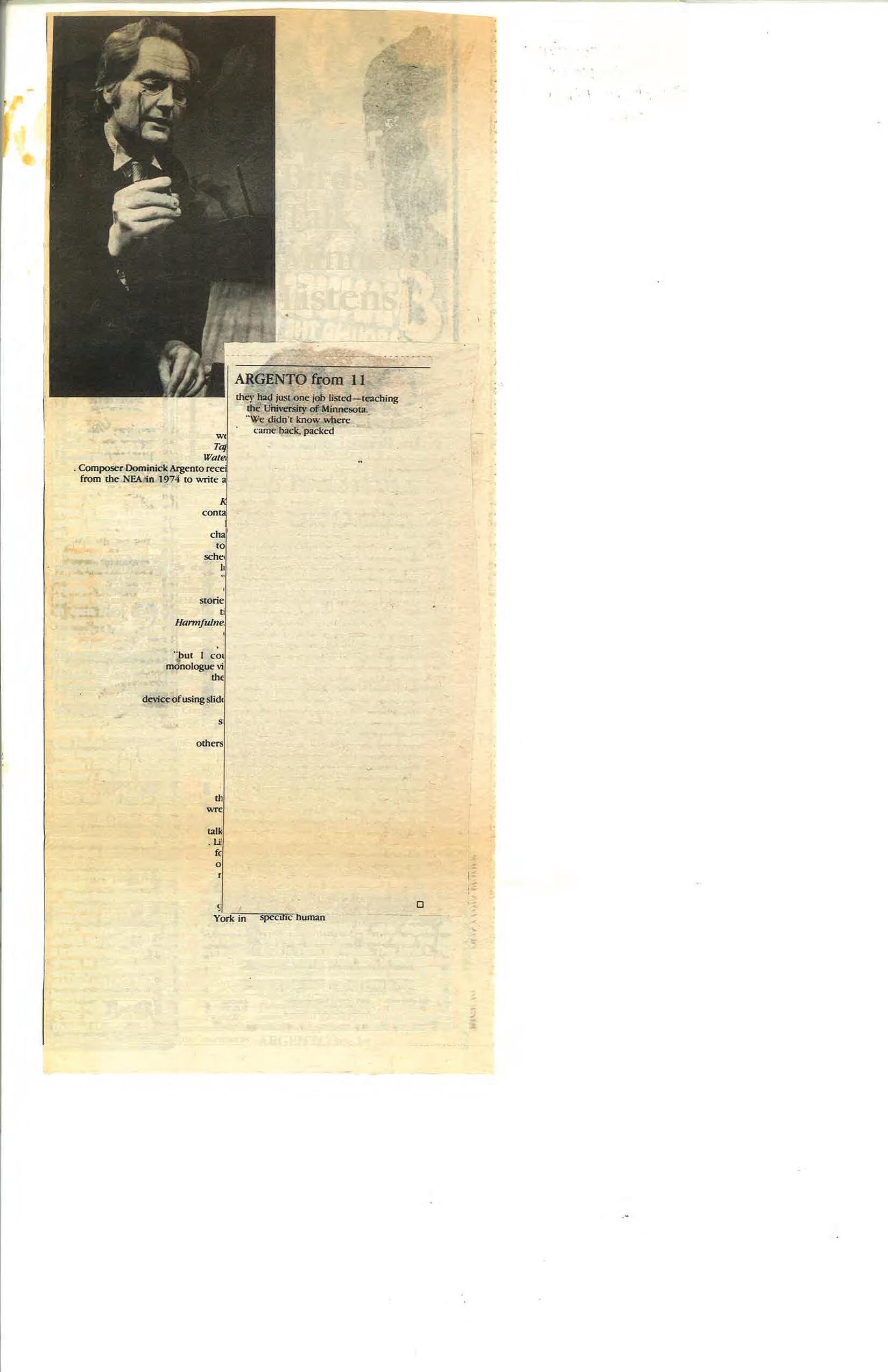
THE COMPANY ENDED its 1980–81 season and the fiscal year ending May 31 with a surplus of $17,000. This reversed a pattern of annual deficits that had plagued the company for some time. A fund drive that raised $225,000—$25,000 more than its goal—made the difference. That was the only good news the company would generate during the next eighteen months.
Dolores Johnson, who became general manager in the autumn of 1980, replacing Charles Fullmer, said in an interview a year later that the company had an identity problem—an old complaint. Is Minnesota Opera simply a bigger, more expensive version of the feisty little avant-garde company once known as Center Opera, an entity devoted to the new, the rare, and re-examined traditions—opera without elephants—as their ads proclaimed? Or is it a company that is evolving in the direction of the big houses like Chicago and San Francisco, with stellar names in flashy productions of standard works, but just hasn’t gotten there yet?
Johnson soon presented a three-year plan to the company’s board that created what she called a split season. This was similar to what the San Francisco Opera had been doing with its Spring Opera—that is, a main-stage season augmented by a smaller, more experimental season of operas. The hope was that the two separate seasons, each with its own identity, would give the public a clearer idea of the company’s artistic intent than had been the case before.
Johnson’s plan wasn’t realized until the Ordway Music Theater opened four years later. The first experimental season, as she called it, was Opera Tomorrow, headed by Ben Krywosz, an ambitious presentation at the Ordway’s McKnight Theater of ten one-act operas in April of 1986. An additional offering, Broadway musicals put on in the summer, expanded Johnson’s two-part season to three—and possibly four, if one added the company’s touring arm, the Midwest Opera Theater, run by Peter Myers. Johnson, however, wasn’t present for any of these developments. She resigned from the company just a few months later, in February 1982, to become director of development at the Walker Art Center. Her job at Minnesota Opera had become “unworkable,” she said. The board had hired her away from the Houston Symphony, where she was general manager, and given her the same title at Minnesota Opera, with the understanding that she would manage the company’s day-to-day operations, while Charles Fullmer would concentrate on fundraising and plans for the upcoming Ordway Music Theater. After Johnson left, the board made an awkward situation worse by removing Fullmer from his position as executive direc-
tor, which made it look as if he were being fired, and then announcing a national search for his replacement.
Fullmer “is definitely not being asked to leave,” said board chairman Judson (Sandy) Bemis in an interview with the Minneapolis Tribune. Fullmer had asked the board for a position with less responsibility, “with less stress,” Bemis said. “Chuck has been our number-one guy for close to ten years and wants very much to stay involved.”
The company faced two problems, Bemis said. Subscriptions—1,800 this season—were down 25 percent, and there would likely be a deficit of about $100,000 at the end of the fiscal year. “Ticket sales are so dependent on the repertoire,” he said. “And there’s no question that this year’s repertoire isn’t as appealing as it was last year. And that isn’t Chuck’s fault.”
THE GIFTED COMPOSER Stephen Paulus, who died in 2014 at the age of sixty-five of complications from a stroke, was born in New Jersey but lived most of his life in the Twin Cities. Paulus wrote prolifically in numerous genres—songs, choral works, chamber music, orchestra pieces. Of his eleven operas, two were given strong productions by Minnesota Opera: The Village Singer in 1982 and The Postman Always Rings Twice in 1987.
The Village Singer, Paulus’s first opera, is based on a story by Mary Wilkins Freeman about a church soloist in a small New England town, Miss Candace Whitcomb, who is getting on in years and whose high notes aren’t as secure as they used to be. The other members of the choir throw her a surprise party, and they give her an album of photographs. Miss Whitcomb is much gratified until she reads a note in the album telling her that her services are no longer needed and that a younger soprano has been engaged to replace her. How Miss Whitcomb reacts to her dismissal—her devastation—is the substance of Freeman’s story and the sensitive libretto that Michael Dennis Browne made of it, the story of “an obscure woman,” for whom “singing in the village choir had been as much as Italy was to Napoleon.” When the Opera Theater of St. Louis premiered The Village Singer in the summer of 1977, Andrew Porter wrote a review in the New Yorker that gave a considerable boost to the twenty-nine-year-old Paulus’s career. “What was striking about The Village Singer, Porter wrote, “is how little its composer still has to learn about dramatic timing, balancing musical forms and theatrical
discourse, creating melodic curves that reveal character or convey emotion, and the other specifically operatic skills. His score is at once fresh and masterly.”
Minnesota Opera opened its own production of The Village Singer at O’Shaughnessy Auditorium on February 6, 1982, as part of a double bill with Puccini’s Gianni Schicchi. Wesley Balk’s sensitive staging underlined the poignance of the story without sentimentalizing it, and James Guenther’s scene designs, along with Gail Bakkom’s smart turn-of-the-century costumes, adorned the stage with rich, autumnal color. Barbara Brandt was a vivid, strong-willed Miss Whitcomb, and James McKeel a thoughtful and persuasive choir leader, William Emmons. Robert Carter Austin was the excellent conductor.
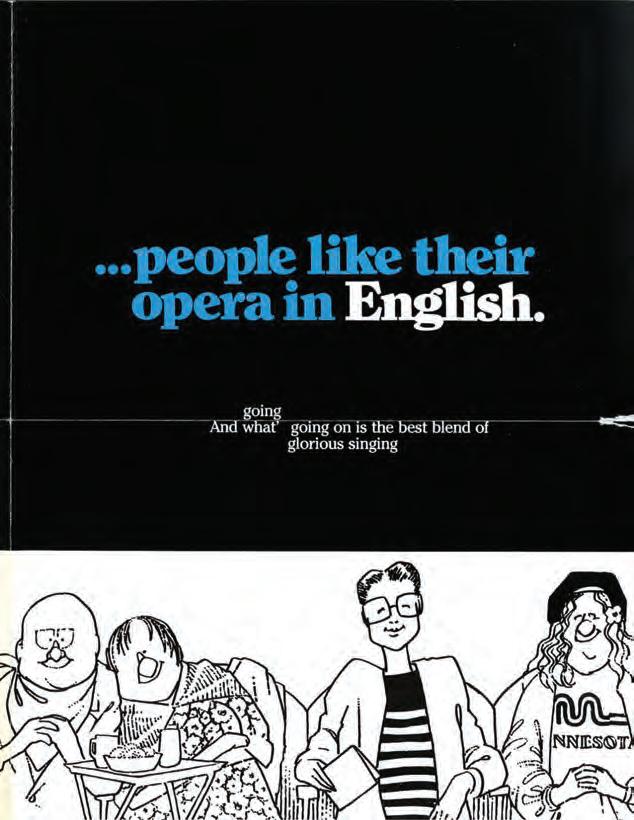
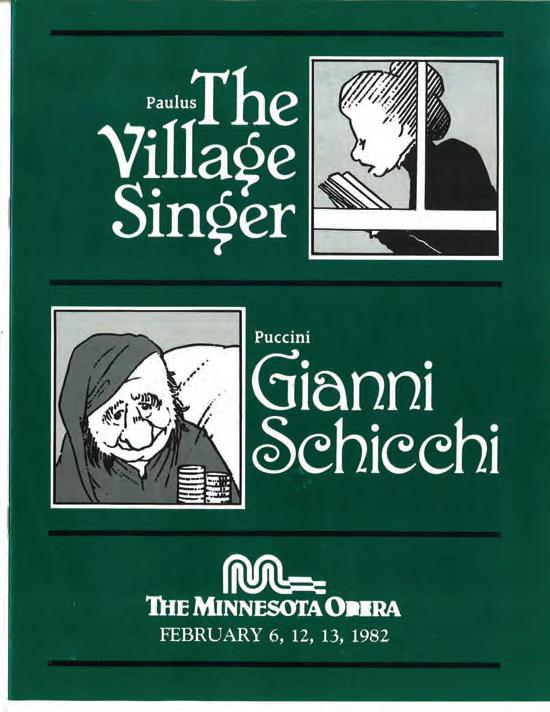
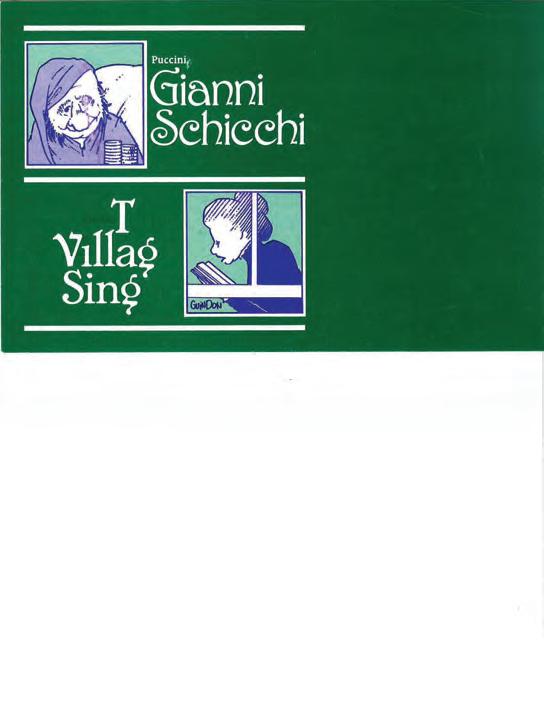

Gail Bakkom is one of the area’s most revered costume designers. She learned her craft at the Guthrie Theater in its earliest years and later worked as costume shop director at the Front Street theater in Memphis and served as director of costumes at the University of New Mexico. Closer to home, she was costume shop director at Heartland Productions in Marshall, Minnesota, and the Minnesota Dance Theater in Minneapolis. But it is at Minnesota Opera, where she worked off and on for forty years, that her legend burns brightest, going all the way back to the Center Opera days and her introduction to the company, the 1966 production of The Good Soldier Schweik. Robert Israel designed the production, but Bakkom did everything else. She shopped, she made patterns, she sewed, she did fittings, plus, she managed the budget, which, if she remembers right, came to about $200. At the other end of the cost spectrum was the 1994 production of Turandot, a visual extravaganza that required nearly one hundred costumes at a cost of between $80,000 and $100,000. Anna Oliver designed the costumes. Bakkom was costume shop manager.
Bakkom cautions: a big budget doesn’t necessarily mean a better show. “I think that when you don’t have so much money, you have to be more creative,” she said. “For Schweik, it was mostly long underwear and dyed lab coats and then a few specialty pieces. One of them I remember so distinctly. Bob drew a picture of a woman in a blue dress with little feathers because she was supposed to be a bird. And then he drew her with an extended bustle that ended with wheels at the bottom, and somehow we made it happen.”
In the final tally, Bakkom designed costumes for eighteen mainstage productions and seven touring shows, and from 1979, when she returned to the company, until 2006, when she retired, she worked on every show in just about every capacity: shop director, designer, draper, seamstress, stitcher, budget calculator. (Drapers create the patterns and then cut the actual fabric. Someone else in the costume department stitches it together.) “I always considered myself first a manager and then a designer,” she said.
At full force, the costume shop, with Bakkom in charge, was a busy place. “Well, there was myself and my assistant, and we both created,” Bakkom said. “I created costumes and she did hats and footwear and some dyeing. And then we had three or four drapers, and each draper had two assistants. And then sometimes we had to overhire, which, in the case of Turandot, we definitely had to. But the budget was even harder with a coproduction because if we went over in expense, we would have to make it up because there was a contract.”
Occasionally, a show wouldn’t be quite ready on opening night. There was the Emperor’s costume, for instance, in that same production of Turandot. For three nights
into the run of the show, Bakkom worked on the costume. “The Emperor was supposed to be way up in the sky,” she said. “I would crawl up there when I got to the theater and work on it. It wasn’t finished until the third performance, but the audience couldn’t see it because it was so high up. And I had to finish it because the entire production—sets and costumes—was leaving shortly to go to another company.”
And then there are the inevitable crises and emergencies that occur during the run of a show. Some can be anticipated. Brenda Harris, for instance, had a killer costume change in the 2000 production of Semiramide. She had exactly ninety seconds backstage to get out of one elaborate costume and into another, and yet she made it every night.
Other crises can’t be anticipated. Bakkom was backstage at the Ordway one night during the run of the famous 1991 Carmen starring Denyce Graves. Act two had just started when Bakkom heard the kind of announcement no one in the costume business wants to hear: “Wardrobe to stage immediately with a thread and needle.” Bakkom ran. As she recalls it, “Denyce had on a very tight pair of leopard skin pants, and the zipper in the back had broken. So I was there stitching it up so she could go on. She made it.”
Then there was the case of the crumbling kimonos. This concerns the 2004 production of Madame Butterfly, for which the designer, David Woolard, insisted on having the kimonos hand-painted by a company in New York. “The thing was they had to be steamed before the fabric could be shipped to us,” Bakkom said. “So we got this fabric and we started working with it and it started falling apart in our hands. So I contacted David immediately, and he talked to the company, and there were three different processors, and one of them did something wrong. Some chemical had been added that wasn’t supposed to be there. And so they redid it all and, I mean, we just barely got it done in time because the fabric was so late in getting to us.”
The task of putting together an opera production usually starts with the director, who comes up with a concept and then consults with the set designer. Between them, they establish the look of the production and the individual scenes, and then, as Bakkom sees it, it’s the costume designer’s job to fit his or her ideas into what’s been established.
Bakkom’s last show for Minnesota Opera was Joseph Merrick, The Elephant Man, presented at the Ordway in 2006, forty years after her debut with the company. Costume design changed during these years, she said, from a focus on historical accuracy to something more conceptual.
Since leaving Minnesota Opera, Bakkom has devoted much of her time to Minnesota Quilts, an organization devoted to preserving and encouraging quilting in all its manifestations.
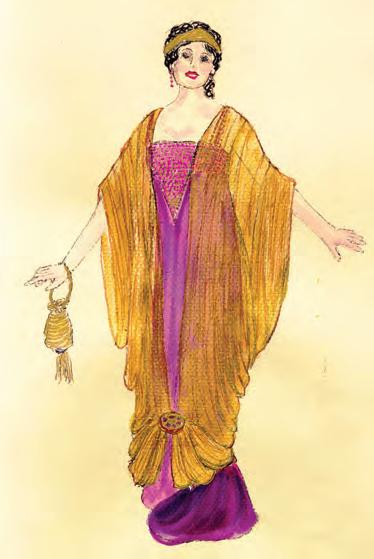

SOMETIMES A STAR SINGER is almost enough to justify a new production. The Met did it often. In the case of Minnesota Opera’s production of The Barber of Seville, which opened March 20, 1982, at the Guthrie Theater, the presence onstage of an almost perfect portrayal of Rosina, the female lead, by a young Erie Mills, nearly made up for the weakness of the production. Sensible people, nonetheless, remained puzzled as to why the company’s livelier and more graceful Barber from the 1972–73 season wouldn’t have sufficed; if used, it would have saved money at a time when the company was almost broke. Richard Canfield Hudson’s staging of the new production raised questions, such as why, in the first-act finale, did a band of soldiers enter the home of an aristocratic family and start beating people up? The libretto doesn’t call for this. And Hudson’s interpolation of a mime to jump around and make faces during Berta the maid’s aria was worth neither the trouble nor the distraction it caused.
Some of the cast rose above all this mayhem. Carroll Freeman certainly had the look and bearing of our romantic hero, Almaviva, as well as a warm lyric tenor, but he didn’t have the vocal stamina for the more elaborate music, at least not on opening night. Robert Galbraith was a conventional Figaro but played with robust energy and more than a hint of cunning. And then there was Mills, who stole the show. One would have to go back to the early days of Roberta Peters’s career to find a Rosina as fetching and foxy, a Rosina sung with such agility and purity of tone. This was the beginning of a great career.
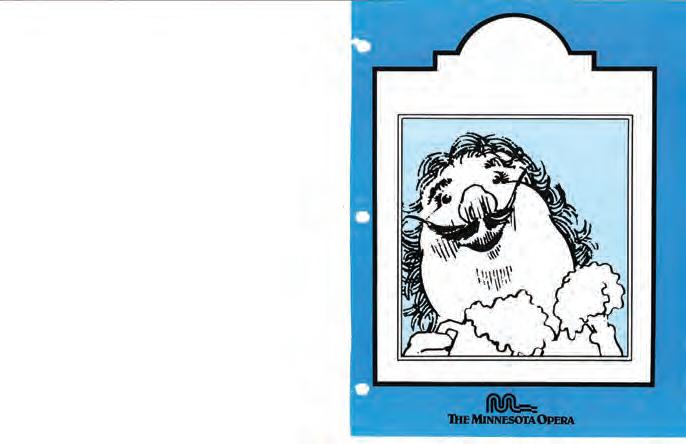
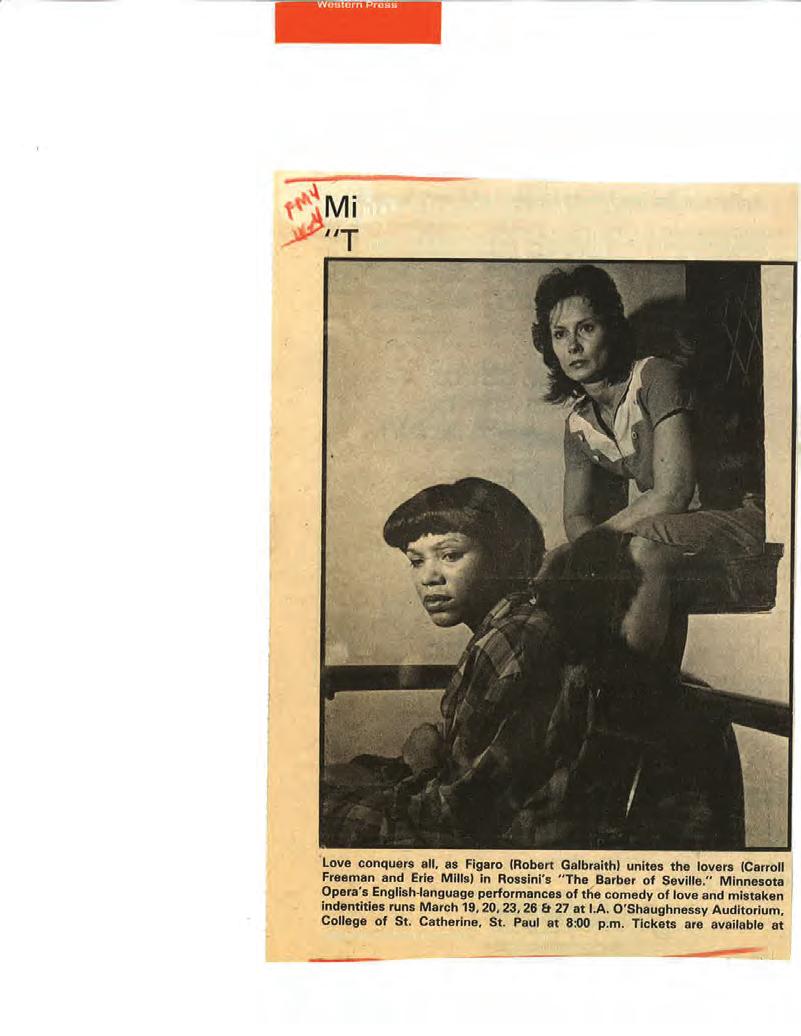

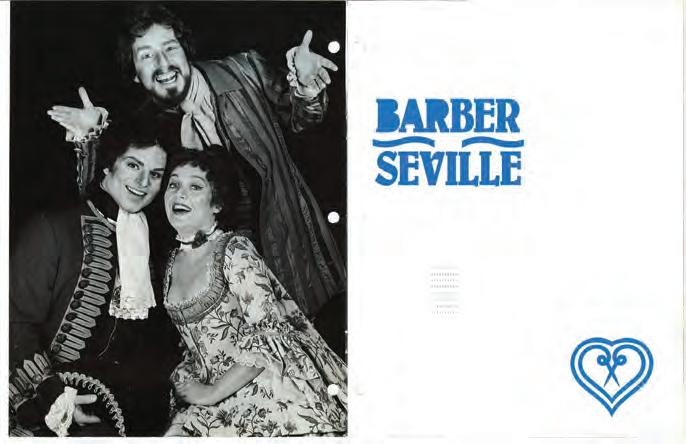
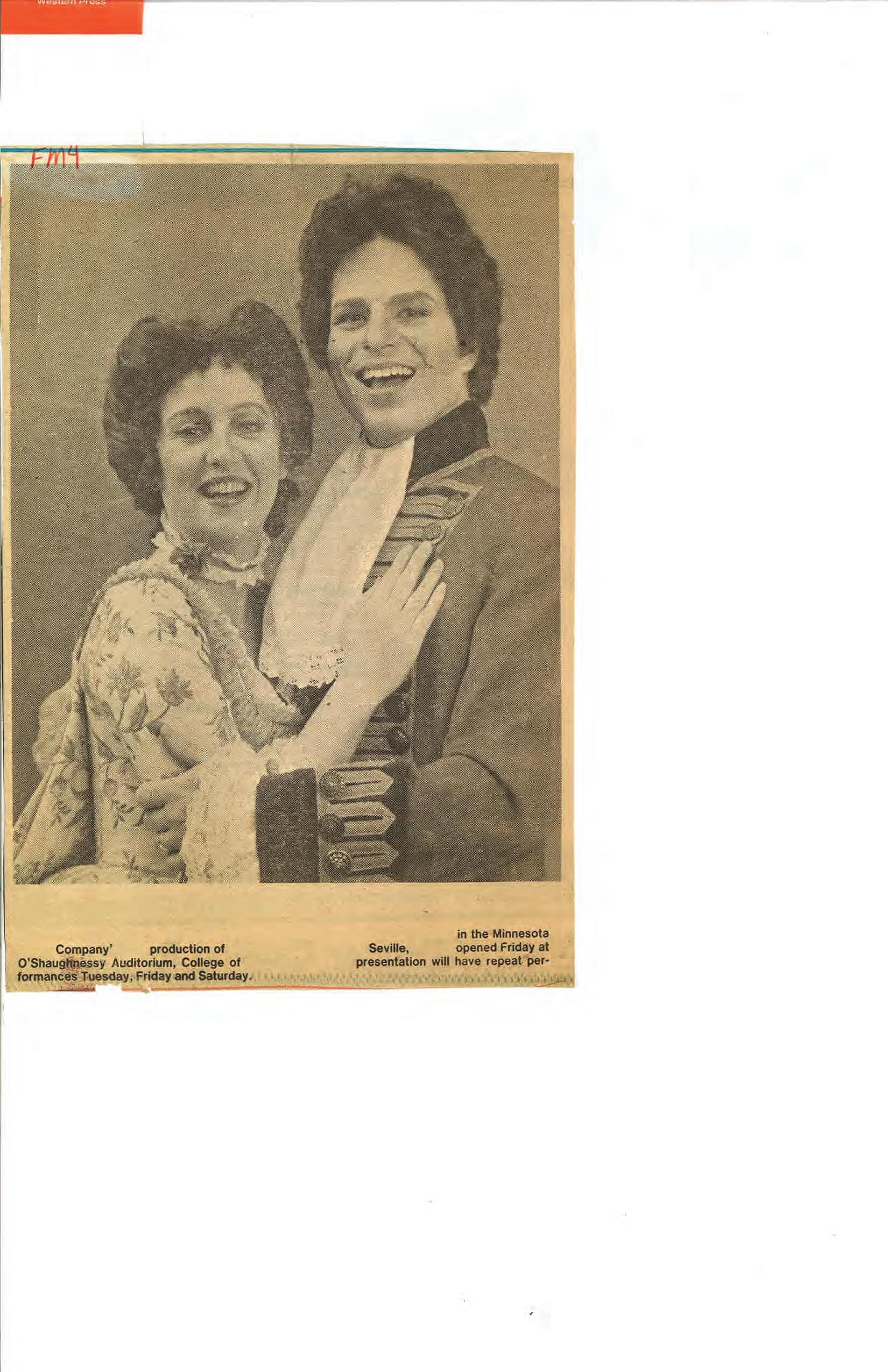


EDWARD BARNES WAS JUST TWENTY when he composed the opera Feathertop, which is based on the mordant Nathaniel Hawthorne story about a scarecrow who is brought to life but ultimately decides that being a scarecrow is better. Wesley Balk staged the premiere of a two-act version of the work at the Julliard School in 1980, and he also directed a new one-act version to serve as the finale of Minnesota Opera’s nineteenth season. It was premiered April 30, 1982, at the Guthrie Theater and was paired with another one-act, The Mask of Evil, composed by Henry Mollicone to a libretto by Kate Pogue.
In Hawthorne’s story, a witch brings the scarecrow to life in order, she says, “to take his chance among the other strawmen.” As it happens, the scarecrow is thought by the social-climbing townsfolk to be a wealthy and titled European,
hence, a man to emulate. He falls in love, but eventually it all comes to a dour end as the people realize that they were admiring a scarecrow. Convinced that humans are a vicious, pitiful breed, Feathertop returns to the witch, who puts him back on the scarecrow rack, never to return to human life. It’s a dark vision of life and society, and it works as an opera. The librettist, Maurice Valency, tells the tale clearly and simply, providing scenes that move and build toward a climax. And Barnes’s score is full of spare but effective touches, music— some of it for off-stage chorus, some alluding to the period before the Revolutionary War—that tellingly delineates the characters as well as the actions. Balk moved his singers about the stage wisely and kept a nice balance between the eerie and the comic. The opera was played behind a scrim on which were projected various pictorial effects—sets and lighting were by Peter Perina—and this heightened the show’s sense of unreality and fable. John Brandstetter was a touchingly pathetic and firmly sung Feathertop and Judith Christin a fearsome and cunning Witch.
The Mask of Evil, concerned with vampires, was one of the company’s biggest mistakes. It was heavy, ponderous, slow-moving, shrill, and even worse: unscary.
THE COMPANY’S FINANCIAL SITUATION , revealed in the annual report on June 24, was scarier than the vampires in The Mask of Evil. In May, faced with a cash shortfall of $90,000, the company laid off the entire staff except for two people, Peter Myers and a young man named Kevin Smith, who had been hired the previous autumn as a production stage manager and would eventually rise to company president. According to its annual report, the company ended its fiscal year May 31 with an operating deficit of $153,000. In an effort at belt-tightening, the board announced salary cuts for the staff and approved a budget for the upcoming year of $938,213, compared to the prior year’s $1,150,144. And the number of performances would be reduced to eighteen. An emergency fundraising campaign to cover the deficit would begin immediately. Richard Kepp, an executive with Northwestern Bell who was named board president at the annual meeting, said, “We are in production four months of the year. We can no longer afford twelve months of expenditures for a four-month operation.” Staff positions such as accountant, box office head, and secretary would become part time, said Kepp. Kepp replaced past president Frank Sorauf and assumed the duties of board chairman, a position created two years earlier for Judson Bemis, who was heading fundraising efforts and acting as liaison between the com-
pany and planners of the Ordway Music Theater, then scheduled to open in the autumn of 1984. Kepp said several years later that the deficit for the 1981–82 season—the fiscal year ending May 31, 1982—was much larger than was reported— about $500,000 rather than $153,000.
BIG NEWS CAME in the middle of August. Ed Corn, fortynine, general director and executive vice president of the Wolf Trap Foundation for the Performing Arts, was appointed to the newly created position of general director and would take over December 1. Peter Myers, one of the two remaining staff, said of Corn’s hire: “The company almost went out of business in the summer of ’82. It was hanging by a thread. Then the board hired Ed, who came in with great promise because he had a reputation for being able to turn around tough situations. Kevin and I were enthusiastic.”
By January, the new general director had his work cut out for him. Judson Bemis and his committee had retired the debt from the prior season. That was the good news. Everything else was bad. Season ticket sales continued to slide, from about 2,400 in 1980–81 to 1,800 in 1981–82. The goal for the current season had been 2,000. Two weeks before the opening of Lucia, only about 1,350 season tickets had been sold. Worse, the repeat performances of Hansel and Gretel earned approximately $40,000 less in ticket sales than had been budgeted.
“We’re in trouble,” said Corn during a lunch interview. “But I think it’s short-range trouble. We have to almost kill ourselves this year to try to hold down expenses. If we can survive this year, we’re potentially in good shape.” Corn was the first person to run the company who brought to the position an extensive background in opera management. And he was definitely running the company. The triumvirate arrangement, whereby decisions were made in a pooling of ideas among stage director Wesley Balk and music director Philip Brunelle and whoever was manager (first Charles Fullmer, then Dolores Johnson), had been abandoned. Indeed, most of the major opera companies of the past had operated with just one powerful, but not necessarily autocratic, leader.
Corn looked like a middle-aged accountant. He spoke so fast it was hard to keep up. If ideas were a dime a dozen, Corn could drop at least ten bucks' worth during lunch. He talked with enthusiasm about opera, about the theater, and about longtime personal interests: bringing opera to television and breaking down the barrier between opera and the Broadway—or Off-Broadway—musical, barriers that seem to exist only in the United States. He talked about Minnesota
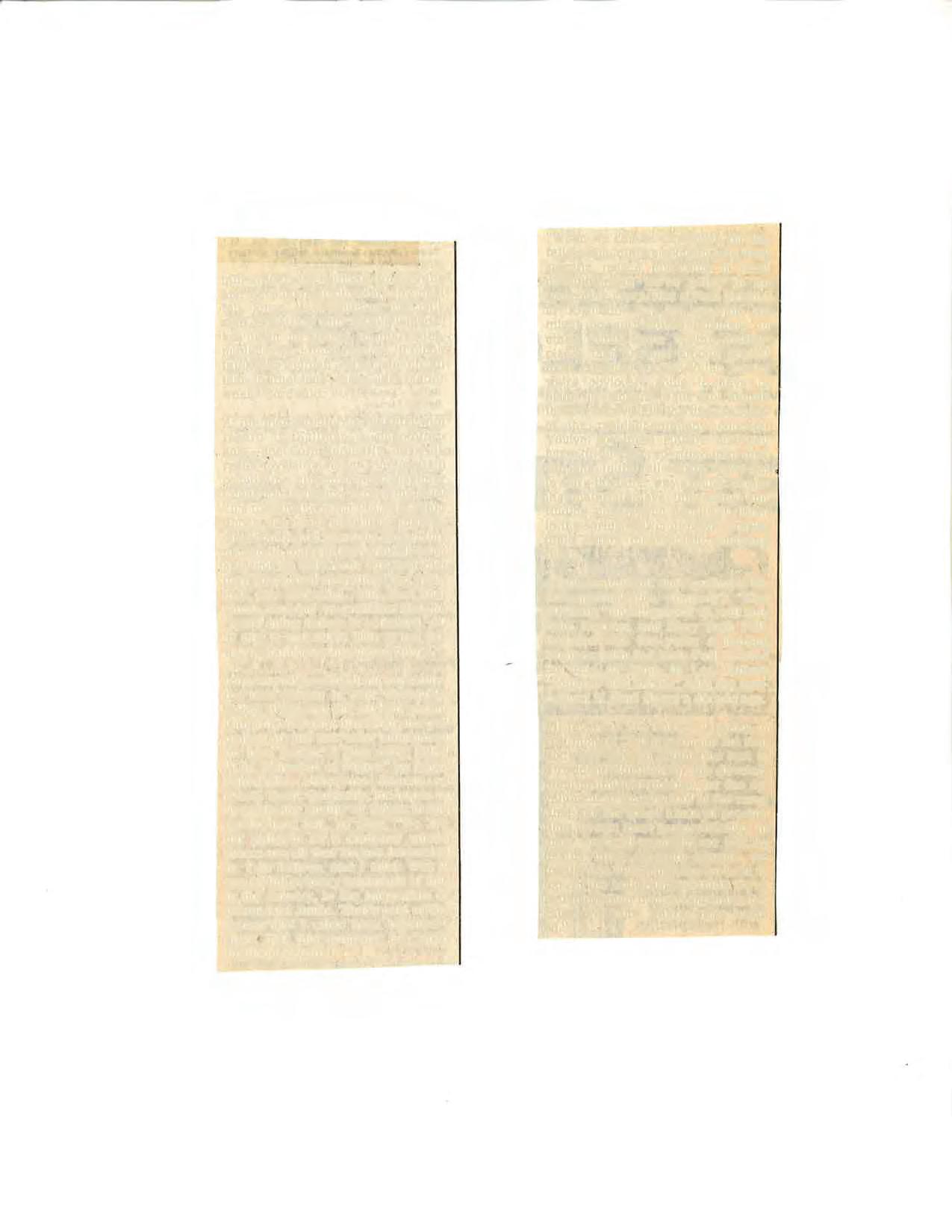
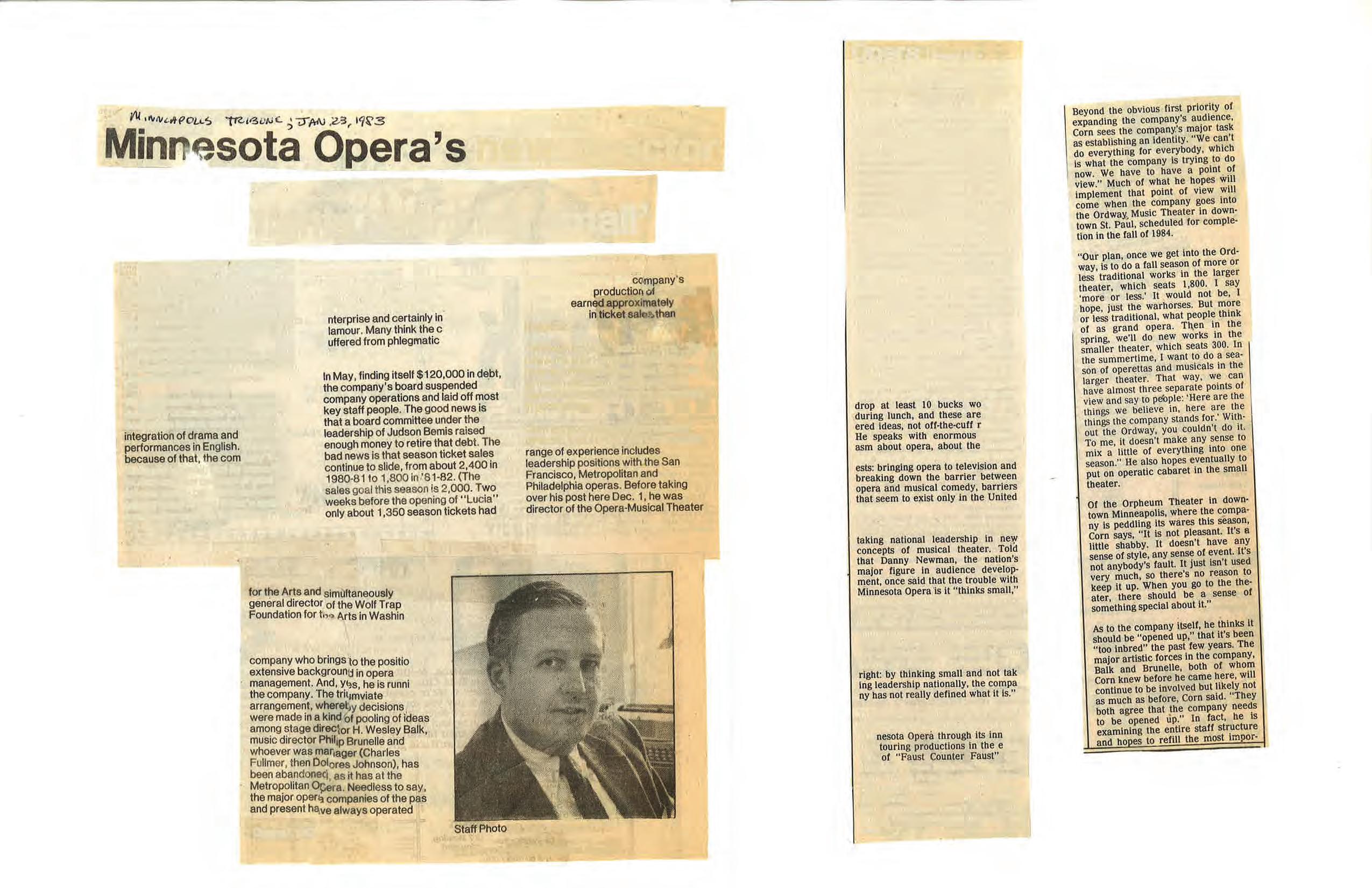






Opera taking national leadership in new concepts of musical theater. Told that Danny Newman, the nation’s leading figure in audience development, once said that the major trouble with Minnesota Opera was that it “thinks small,” Corn’s eyes brightened. “He’s absolutely right,” Corn said. “That’s exactly the problem that I sensed when they first approached me about coming here. He’s right. By thinking small and not taking leadership nationally, the company has not really defined what it is.”
Like a lot of opera people around the country, Corn came to know Minnesota Opera through its innovative tour productions in the early ’70s of Faust Counter Faust and Postcard from Morocco. Corn saw them in San Francisco. “They were brilliantly integrated, but the voices just weren’t there,” he said. That earlier reputation hasn’t been sustained. “We’re living on the past,” he said. Beyond expanding the company’s audience, he saw the company’s major task as establishing an identity. “We can’t do everything for everybody, which is what the company is trying to do now.” His plan, once the company moved into the Ordway Music Theater, was not unlike what Dolores Johnson had talked about a year earlier: traditional grand opera on the main stage in the autumn, experimental operas in the smaller theater in the spring, and a musical or an operetta on the main stage in the summer. Corn’s programming scheme, in fact, became reality after the Ordway opened and after he left the company, but it didn’t last long. New leaders offered a contrary view: the public is more responsive to a single type of offering—opera done by an opera company—rather than a mixed menu.
Finally, Corn said the company should be “opened up,” as it had become “too inbred.” The major artistic forces in the company, Balk and Brunelle, would continue to be involved, but not as much as before. “They both agree that the company needs to be opened up,” Corn said. Not surprisingly, within a few years, both were gone. Balk took a sideways move into performer training and working with the company’s new music-theater wing and its subsequent iterations.
IF YOU DON’T COUNT the battles between the board and the artistic team, the booing, the instances of disharmony, and other random explosions, Minnesota Opera’s twentieth season was relatively uneventful, an island of calm and equanimity in the frozen North country.



The shouting didn’t start until after Hansel and Gretel had come and gone. Premiered during the 1981–82 season, the revived Hansel and Gretel, which opened December 10, 1982, at the Orpheum Theater, in a staging by Wesley Balk, conducted by Philip Brunelle, with sets by Jack Barkla and costumes by Jared Aswegan, was a handsome, thoughtful effort the first time around, and it continued as such this year. In at least one respect, it was a better production. Tenor Gary Briggle’s Witch, alias Rosina Daintymouth, remained the star of the show, but it was a bigger, more detailed, and funnier portrayal this time around, something like a cross between Margaret Hamilton’s Wicked Witch of the West in The Wizard of Oz and Waylon Flowers’s character Madame. Marilyn Florez and Kathryn Wright remained as winsome and believable as before, and both avoided the exaggerated cuteness that makes us root for the Witch, in large part because the
characters were played as young adolescents rather than children. Mary Boyd Frederickson portrayed the stepmother as a woman burdened with problems rather than the conventional mean stepmother, and James McKeel came across as a sympathetic father. The entire production, enhanced by Brunelle’s well-paced overture, was played in a simple, unforced, uncluttered, naturalistic style. The lovely final tableaux of the first act—the children asleep on the staircase, the leaves falling, the fairy godmother smiling from above, the angels gathered below—took us briefly beyond fairy tale into a timeless, archetypal world of childhood dreams and wish fulfillment that was truly magical.
THE TROUBLE STARTED back in April when Balk and Brunelle wrote a letter to the board titled “A Statement of Artistic Concerns.” The board, the letter states, is considering decisions that “threaten the artistic quality, reputation and
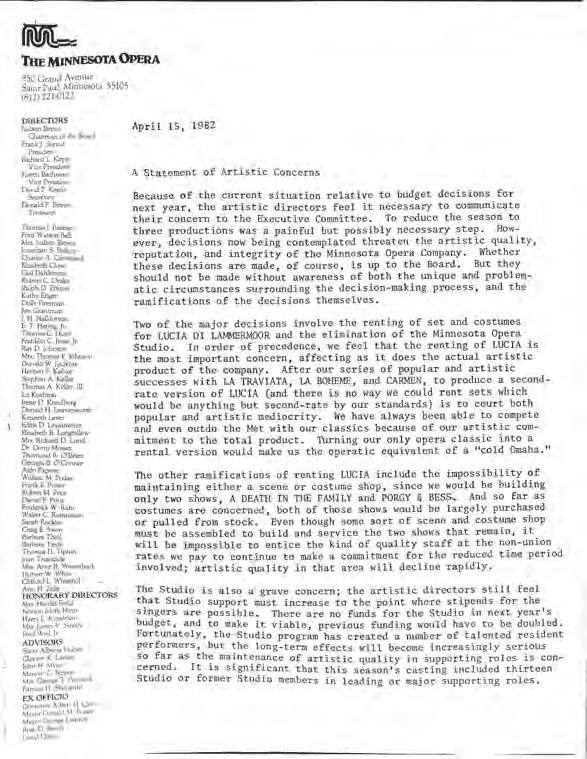
“A Statement of Artistic Concerns,” 1982, courtesy Minnesota Opera Archives
integrity of the Minnesota Opera Company.” One of those decisions called for the renting of sets and costumes for the upcoming production of Lucia di Lammermoor. The practice since the company’s debut production in 1964 had been to create its own sets and costumes, which, in Balk’s view—and in the view of the opera world in general—was one of the hallmarks of a first-class production, a production in which all the elements—visual, musical, dramatic—are conceived as one fully integrated entity. Resorting to rented properties, Balk argued, would result in an inferior production “and would make us the operatic equivalent of a ‘cold Omaha.’”
The other point of contention was the board’s defunding of the company’s Opera Studio, an innovative training program for singers that was close to Balk’s heart. Singers from all over the country applied for acceptance into the program, which offered performance-oriented classes every day and the chance to appear in both the Studio’s own productions and in small roles and chorus parts in the mainstage productions. Though they claimed to be sensitive to the company’s financial difficulties, Balk and Brunelle noted in passing that the administrative budget was increasing while the artistic budget was being reduced; moreover, they had been told they weren’t invited to the board’s committee meetings. As it turned out, the company did present a production of Lucia in January 1983. Balk staged it and Brunelle conducted. It was possibly the most unusual Lucia anyone had ever seen.
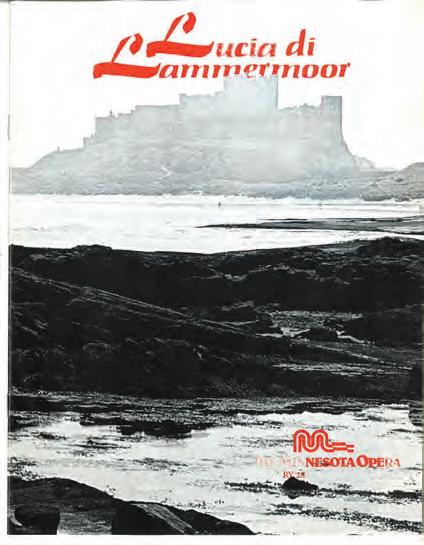
Ten years later, Balk wrote a reminiscence of the entire affair in a letter he sent to no one, but has been circulating ever since. He noted the fragile balance between the artists and the bursars, referring to the fundraisers and contributors on the board and other sources of funding. If the artists dominate, the resulting imbalance, he said, could result in financial death, whereas domination by the bursars could mean artistic death. The managements of most American opera companies today boast that their boards never interfere with artistic decisions on such matters as repertoire and casting, though board committees do discuss production costs and artists’ fees and in doing so exert an influence. Repertory decisions during Minnesota Opera’s first decade, Balk says, were made by him, the manager John Ludwig, and the music director (first Tom Nee, then Philip Brunelle), with a committee from the board acting as consultants. “Without this artistic freedom,” he says, “we would not have produced some of our most important work.”
Then came the cash squeeze of the early ’80s. “The board, having assumed control over repertory choices, informed me, indirectly, that we would do Lucia,” Balk said, “and on a bare-bones budget. . . . The wise course would have been for me to resign and let whoever it was do whatever the board desired. Instead, I saw an opportunity to return to the Faust Counter Faust concept,” he said, referring to his production of the early ’70s that explored the mind of a modern-day Faust who is confined to a mental hospital. “That excited me,” Balk says, “and given my hurt and anger at the way I felt the artistic staff was being treated, it allowed a little nose-thumbing: ‘You want a Lucia? I’ll give you a Lucia, but the kind of Lucia I’m interested in, and I have a feeling that’s not what you have in mind.’”
As for sets and costumes, according to Ben Krywosz, who was the assistant director on the production, Balk asked James Bakkom, who had designed many of the company’s productions, for assistance. “Wesley said, ‘Jim, I need your help. We need to figure out how to do Lucia using some of the materials we have in stock.’ So they created this thing on a very low budget,” Krywosz said. “Wesley didn’t intend to do it badly. What he intended was to show them that even if they cut the budget, they couldn’t control him. He was going to do an innovative production.”
In Balk’s concept, a young soprano, Mary Becker, who has suffered a mental breakdown, asks her acting coach, who becomes her therapist, to help her prepare for the role of Lucia. As time goes on, Mary comes to identify with Lucia as she watches the opera being performed and as parallels
develop between the two women’s lives. Audience members are asked to be observers in this therapeutic process. As in the opera, Lucia dies, but Mary, having finally separated herself—psychologically—from the Lucia character, revives and is cured.
The production registers at least a nine in the catalog of Minnesota Opera lore, partly because Balk was booed on opening night when he joined the cast onstage at the end. Much was made of this. Lutherans, it was said, are trained from childhood not to boo or show any disfavor in public. It was thought that many who booed had to go home immediately and lie down. The other part of the legend is that Balk was thrilled by the audience response. “At least I know they’re paying attention,” he is reported to have said to a stagehand. Balk was obviously on his way out. His last mainstage production would be Cenerentola during the 1983–84 season. He tried to resign in 1982, but Corn insisted he stay on as director of artistic planning, which he did for the next two years. He reconnected with the company in 1986 with the creation of the Minnesota Opera New Music-Theater Ensemble, which evolved into Nautilus Music-Theater, for which he was director of performer development.
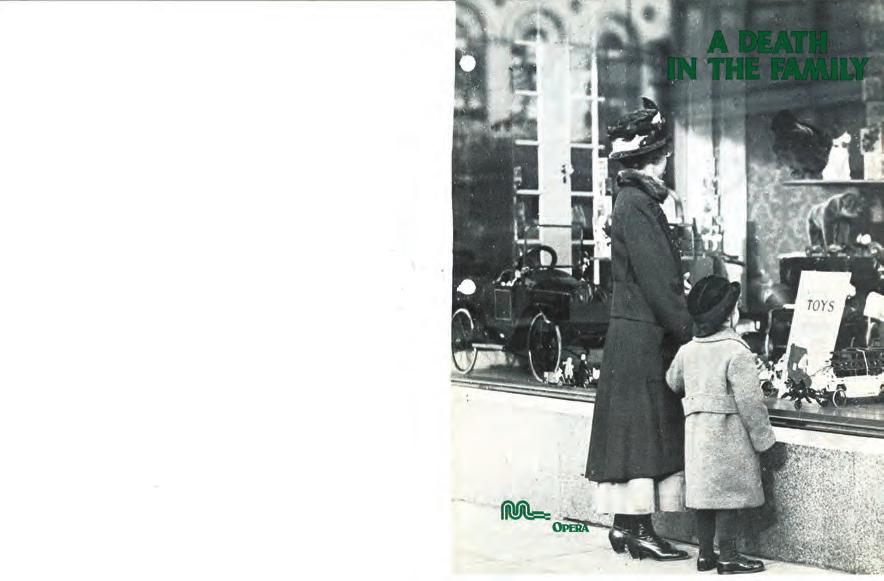
The company faced serious problems. Karen Bachman, then board vice president and a board member since the early ’70s, resigned in protest. “I was in a meeting with Sandy Bemis,” she said of the time. Bachman continued:
I remember the question was what we could do to raise more money because we were in terrible financial shape. I said that I really believed that the company was very badly managed and that I felt I could not go out and ask for money because I didn’t think it was going to be well used. I said, “I guess if I feel that way, I should resign from the board,” which I did. I said I didn’t see how the company could survive.
MEANWHILE, THERE WAS the rest of the season to finish: the premiere of William Mayer’s A Death in the Family and the company’s first musical, Kiss Me Kate, which took the place of the originally scheduled season finale, Porgy and Bess, which was canceled to save money.
William Mayer made a bold move writing an opera based on a beloved novel, James Agee’s A Death in the Family, which was eventually turned into a successful play by Tad Mosel, All the Way Home, both of which won the Pulitzer Prize. Mayer had the advantage of knowing that the basic material had struck a responsive chord in both readers and theater audiences. On
A Death in the Family program, 1983, courtesy Minnesota Opera Archives
the other hand, the very human strength of the story and its popularity can sometimes intimidate a composer, who might as a result compose something closer to background music rather than letting the drama be told through the music. Happily, in what was his first full-length opera, Mayer avoided this pitfall. His music was deftly shaped, more than merely a voice in the distance. Writing his own libretto, he simplified the characters while retaining their essences. His scenes have life, and the essential warmth and sincerity of the story was retained and often enhanced. He set language so it could be understood, and he made good use of Agee’s more poetic flights to create lyrical expansions, arias, and ensembles, as Samuel Barber did in his concert work for soprano and orchestra based on the same text, Knoxville: Summer of 1915 In telling of the tragedy that befalls a southern middle-class family—Mary and Jay Follet and their six-year-old son Rufus— when Jay dies in a car accident, Mayer’s use of folk tunes and rags is especially evocative, as is his brief infusion of electronic bloops and bleeps during Rufus’s dream scenes. The first-act ending is limp, however, and Mayer’s pervasive lyricism and his warm tunes of consolation, so effective in the early scenes, seem dogged and unrelenting by the middle of the second act. As a result, his big choral apotheosis at the end, aimed at tear-wiping and catharsis, produced nei-
ther. Nonetheless, the production, staged by Wesley Balk, conducted by Philip Brunelle, and framed by James Waters’s attractive set, was beautifully and thoughtfully enacted. At its best, the production evoked the essential emotions of the story, the isolation and grief of a family who was, quoting Agee, “inconceivably lonely, drawn upon itself as tramps are drawn to a fire in the cruelest weather.”
A year later, the National Institute for Music Theater gave A Death in the Family an award for artistic excellence. Mayer’s opera shared the award with Satyagraha by Philip Glass.
PART OF THE ALLURE of the twentieth season finale, a superior production of Cole Porter’s Kiss Me Kate, was the return of Mary Beth Peil and John Reardon in the lead roles of Fred Graham and Lilli Vanessi, a formerly married pair of Broadway actors who can’t stand each other but find themselves cast in a musical of Shakespeare’s The Taming of the Shrew. In the summer of 1971, Peil and Reardon played the main parts in St. Paul Opera’s premiere production of Summer and Smoke
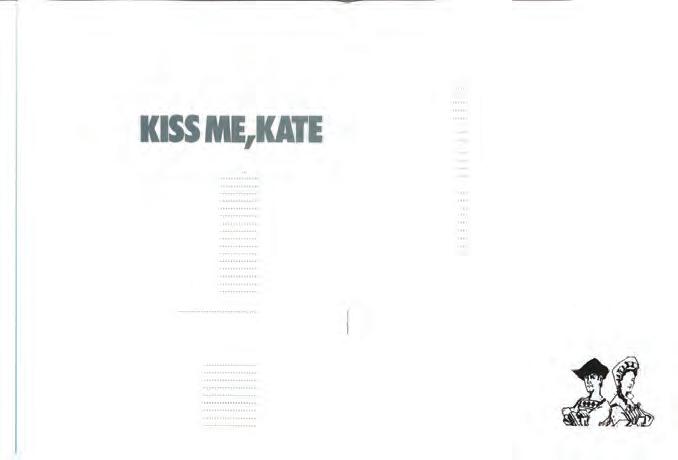
by Lee Hoiby. The opera, as it turned out, lasted longer than the company that produced it. St. Paul Opera folded in 1975, while Hoiby’s tender, beautifully written opera lives on, having been produced in several cities and on public television. They were a great team, Peil and Reardon. These two not only could act; they had the opera-size voices required of Porter’s demanding and literate score. Reardon’s Fred Graham was a vivid portrait of a desperate, down-and-out actor, and his big numbers, “I’ve Come to Wive It Wealthily in Padua” and “Where Is the Life That Late I Led,” were firmly sung, every word articulated clearly. And for her part, Peil sang engagingly and managed to make the volatile Lilli/Kate into a sympathetic character. The production’s big advantages were that its director, Dorothy Frank Danner, understood and respected the musical comedy form and that the conductor, Paulette Haupt-Nolen, knew what a Broadway pit orchestra should sound like. The supporting cast contributed mightily. Merriann Gleason’s Lois Lane was just right—a combination of Vivian Blaine and Judy Holliday—and Luther Fontaine did a nimble tap dance during “Too Darn Hot.” Should opera companies do Broadway—or Off-Broadway—musicals? Of course. Opera houses in Europe do them often. In Italy Kiss Me Kate is known as Baciami, Caterina.
AFTER A YEAR OF FINANCIAL DISARRAY and gloomy forecasts, Minnesota Opera’s streak of bad luck continued when its office building caught fire late one night in August, causing $250,000 in structural problems and severe smoke damage to the nine hundred costumes that were stored in the building at 850 Grand Avenue in St. Paul.
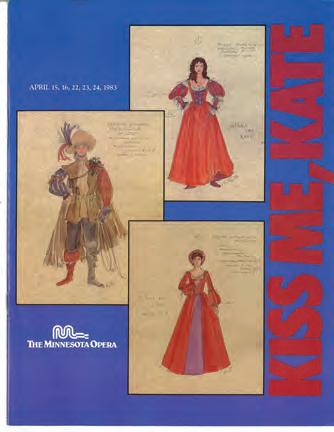
Kiss Me Kate program, 1983, courtesy Minnesota Opera Archives
It turned out there was a silver lining hidden in those dark clouds. Hayber Associates, a private real estate development firm, offered Minnesota Opera $500,000 for the building, a former Studebaker dealership in a neighborhood with growing commercial potential thanks to the Victoria Crossing shopping mall across Grand Avenue. Smith said it was determined—or at least surmised—sometime later that the fire was brought about when a janitor late one night threw a cigarette butt into a waste basket, not knowing it was still lit.
“We found that the building was worth more to us sold than when we were occupying it,” said Kevin Smith, who was then a company administrator. The sale enabled the company to pay off its debts of about $400,000. “We’ve solved our financial problems,” Smith said at the time. “Now we can start fresh.” The company moved its administrative offices to Park Square Court in downtown St. Paul and its technical facilities to 1010 Currie in Minneapolis.
JUST A FEW YEARS AGO, we are told, the existence of The Abduction of Figaro was only a hunch buried in one of the deeper caverns inside Prof. Peter Schickele’s mind. Then one night the professor was summoned into the sewers far beneath the city by a man known only as “Deep Note,” who informed the soggy scholar that there was indeed such a work, but that it would require extensive editing, partly because the fictional composer, P. D. Q. Bach, had forgotten to number the pages. The result, after much late-night teeth-gnashing by the professor and his earnest, poorly paid copyists, was, courtesy of the intrepid Minnesota Opera, a full-scale premiere production of Figaro that opened April 25, 1984, at the once attractive Orpheum Theater in downtown Minneapolis.
As it turned out, The Abduction of Figaro was a wonderfully funny show and a substantial piece of music. The opera is full of gags, both musical and visual. The reason the musical jokes work so well is because of Schickele’s considerable familiarity with the eighteenth-century idiom, Mozart’s style: those sighing string figures and whirling woodwind passages. His quintet at the end of the first act recalls the similar quintet in Così fan tutte. The music isn’t Mozart’s; it’s Schickele’s, and it’s quite lovely, except that as the scene progresses you notice that the strings have slipped momentarily into “Ta-Ra-Ra Boom-De-Ay.” As with much of Schickele’s work, it’s funnier for those who know the characters and the specific situations in the Mozart opera he is satirizing: that Donna Donna is (more or less) Donna Elvira, Schlepperello is
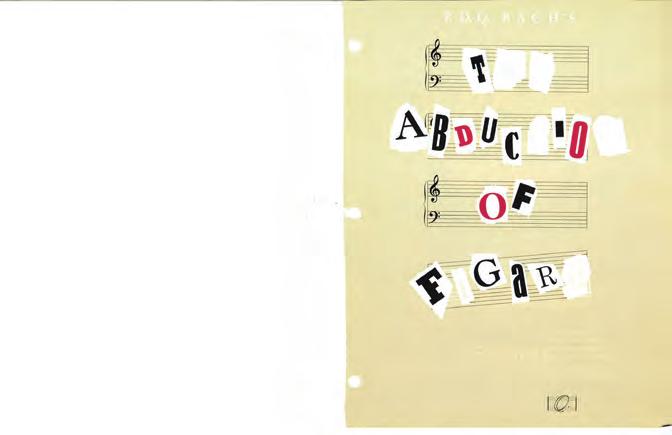
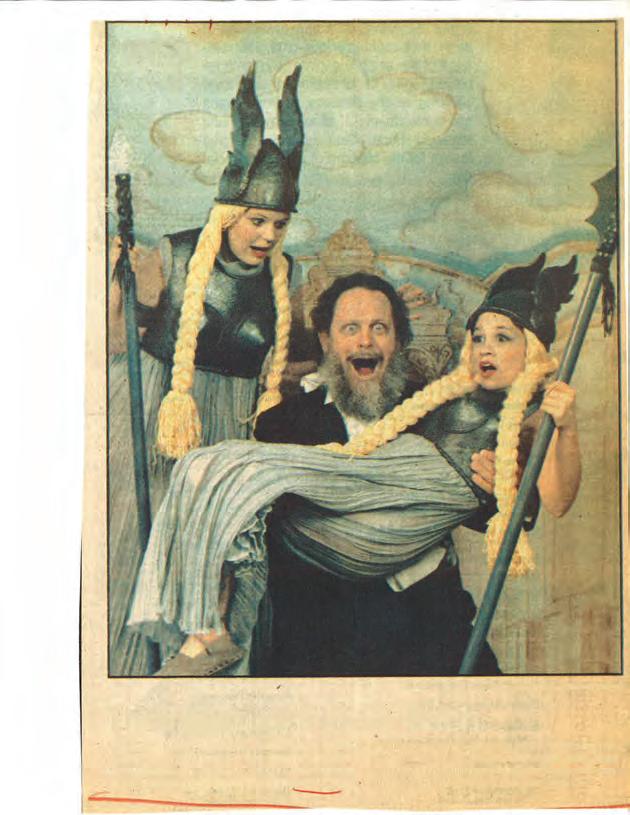
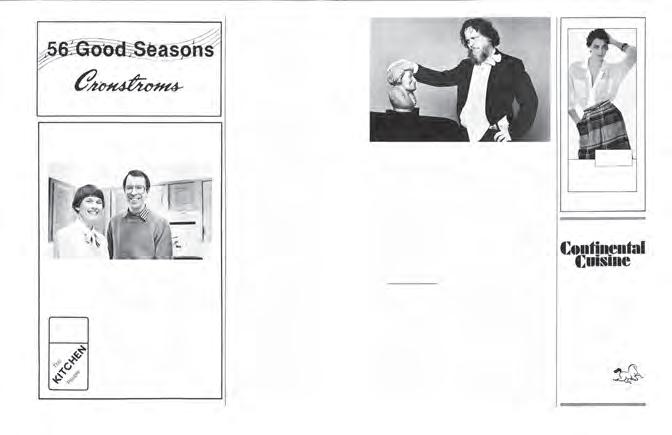
Leperello, and that Susanna Susannadanna is Susanna, who is now a bit long in the tooth and married to Figaro, who is dying, having swallowed a peanut. Seeing the show, I felt the nagging suspicion, sacrilegious though it may be, that some of Schickele’s characters are just a wee bit more interesting than Mozart’s. Donna Donna and Blondie (superbly sung by Marilyn Brustadt and Lisbeth Lloyd) were given a terrific duet in the second act during which they said things one imagines these characters have always wanted to say. After two hundred years, Blondie can finally tell Donna Donna what she thinks about men: “You show me a man who’s faithful, and I’ll show you a man who’s impotent.” Blondie then does an aria that alludes to “Macho Man” by the Village People and concludes with a vocal cadenza in eighteenth-century style but with a jazz feeling in the orchestra, a showstopper if there ever was one.

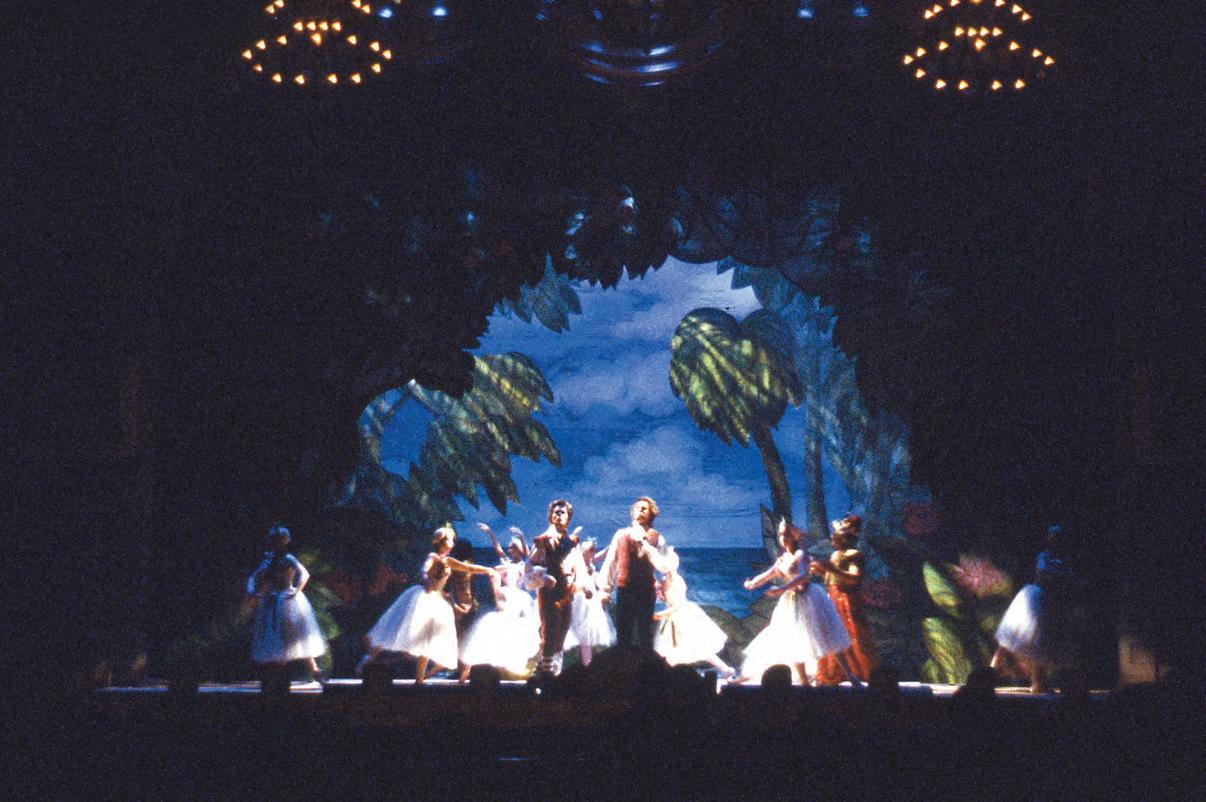
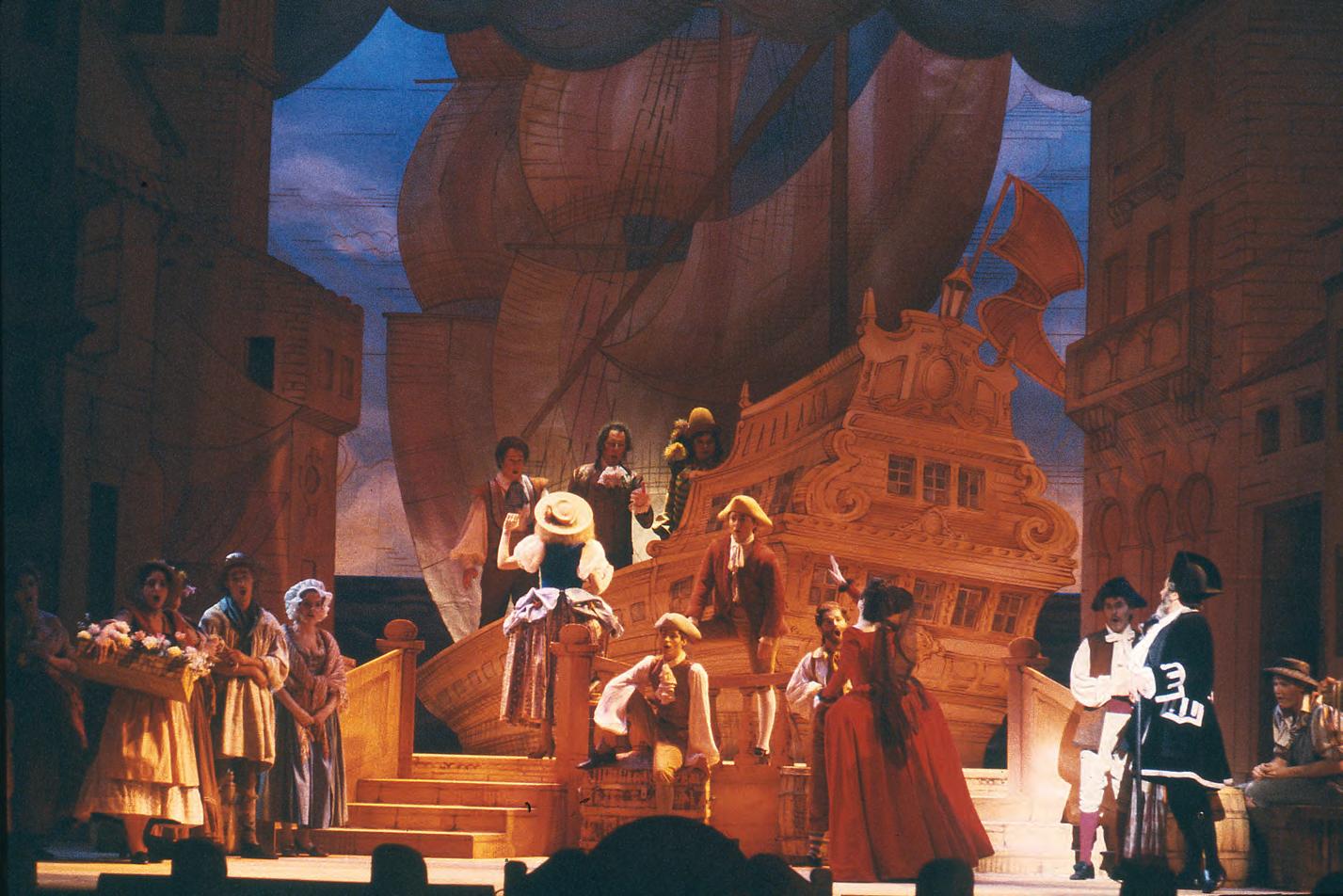
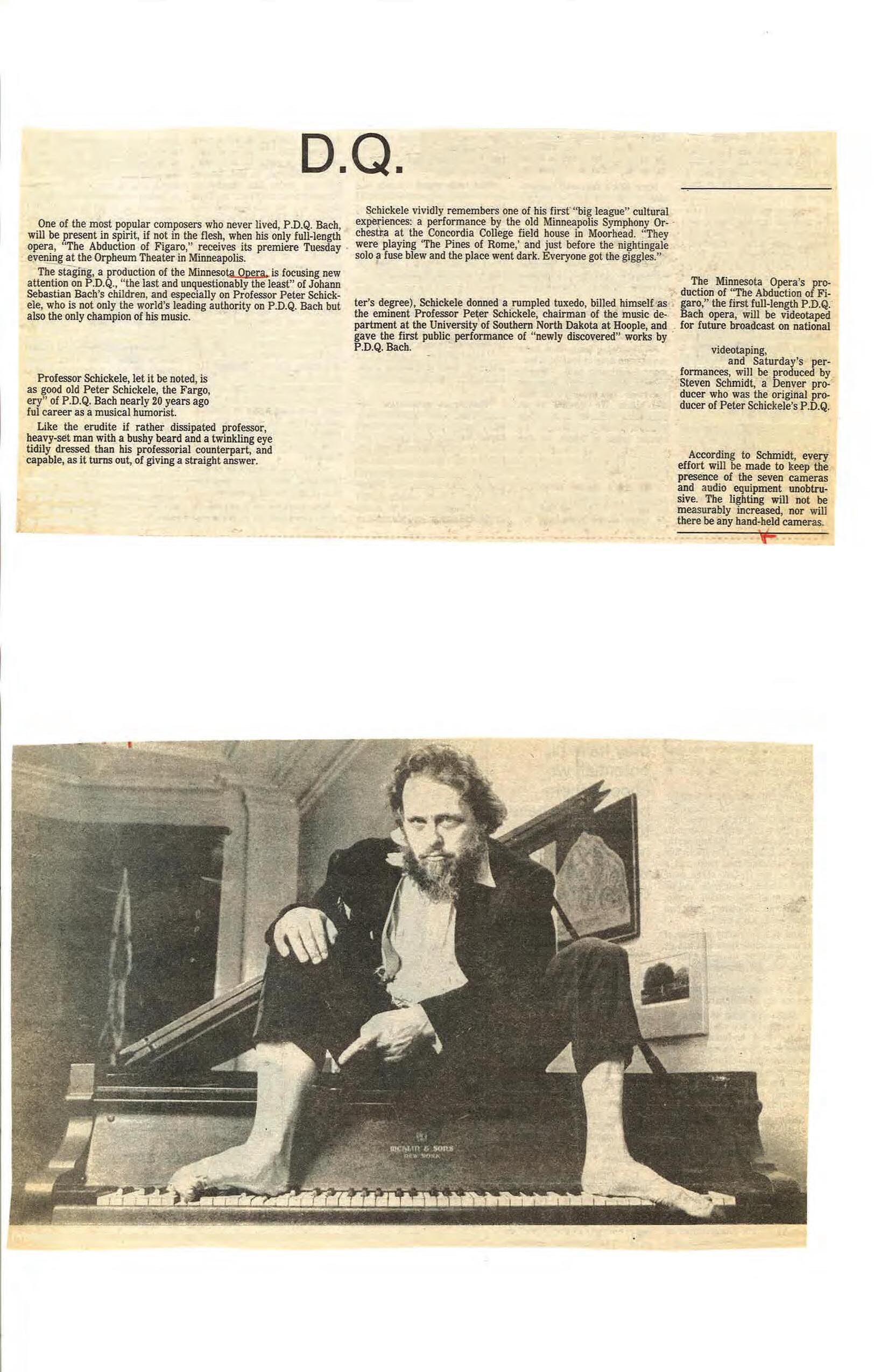

Despite financial problems and interoffice stress, the company rallied and put on one of its best seasons ever in 1983–84, Ed Corn’s first season. He had arrived in the autumn of 1982, when that repertoire was already planned. Schickele’s Figaro was a project close to Corn’s heart, something he had wanted to put onstage for a long time.

Newspaper advertisement for 1983–1984 season
The company’s first production of Madame Butterfly, which opened on January 31, 1984, at the Orpheum Theater, was a first for its director, the composer Carlyle Floyd, who had staged a number of his own operas but never one by someone else—Puccini, in this case. Floyd took a fresh and original approach to this oh-so-familiar saga of Cio-Cio-San, the geisha who is abandoned by an American naval officer and ultimately takes her own life. Floyd treated the story lovingly, with obvious sincerity and a concern for dramatic truth. He didn’t update the story to World War Two; he didn’t see it as a polemic against imperialism. He saw Butterfly, Puccini’s most realistic opera, as a believable dramatic situation inhabited by real people, an attitude rare today in opera production. The quality of the production suggested that Floyd had the makings of a first-rate director.

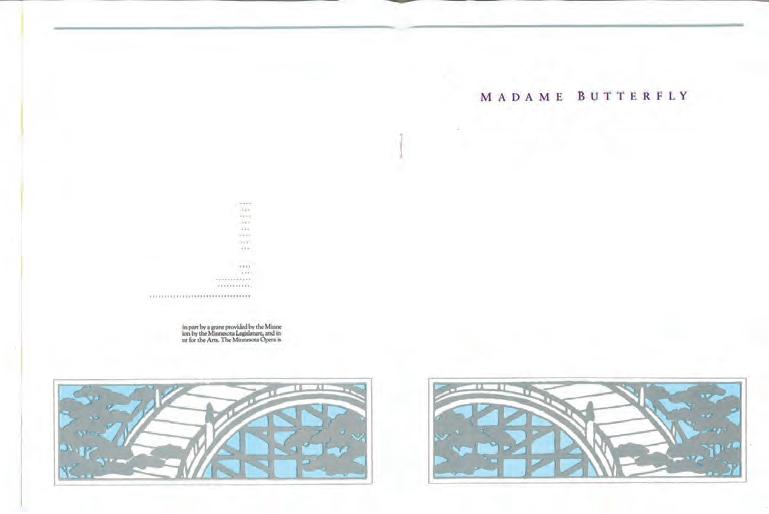
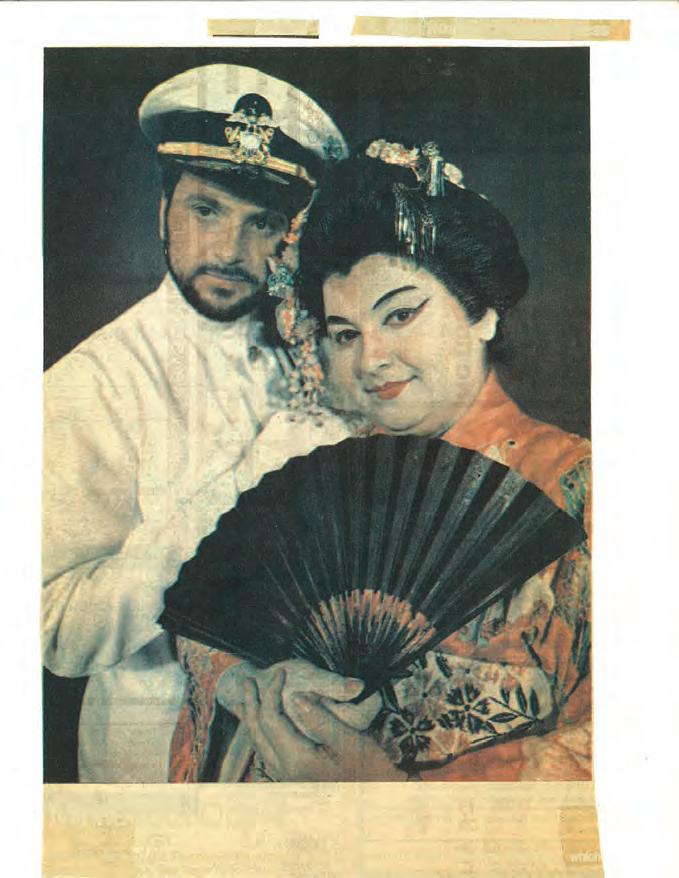
A strong final contribution to the season was a production of Rossini’s La cenerentola, which opened at the Orpheum March 6, 1984. It is not often noticed that back in 1817 Rossini’s librettist, Jacobo Ferretti, took out all the supernatural elements from the story to humanize the tale. In place of a fairy godmother, Ferretti put Alidoro, a wise old philosopher and tutor to the Prince, who takes pity on Cinderella, seeing her kind character, and then guides her to the ball and ultimately to the prince’s hand in marriage. In the Minnesota Opera production, Balk reintroduced the supernatural, making Alidoro a magician who orchestrates the events onstage, putting characters in trances. By Balk giving Alidoro supernatural powers, the story lost a certain poignancy it has when he is simply a kindly old man who comes to Cinderella’s aid. This Don Magnifico, John Fiorito, could definitely carry the number. The whole role rested easily on his shoulders. Fiorito was wonderful. He avoided the blustering and storming that are standard for Magnifico, creating a character who is instead sly and desperate, and he managed even the most tongue-twisting numbers with clarity and ease. Barbara Martin’s Cinderella was attractive and vulnerable, and though her chest tones were bland at times, she sang the coloratura passages as if they meant something. And Adam Morales was that rarity, a handsome Prince. Morales surmounted the vocal hurdles skillfully, even the treacherous high notes, if not always with commanding style. All told, this was an ensemble performance of the best sort, with singers who know how to deliver the English language clearly and with
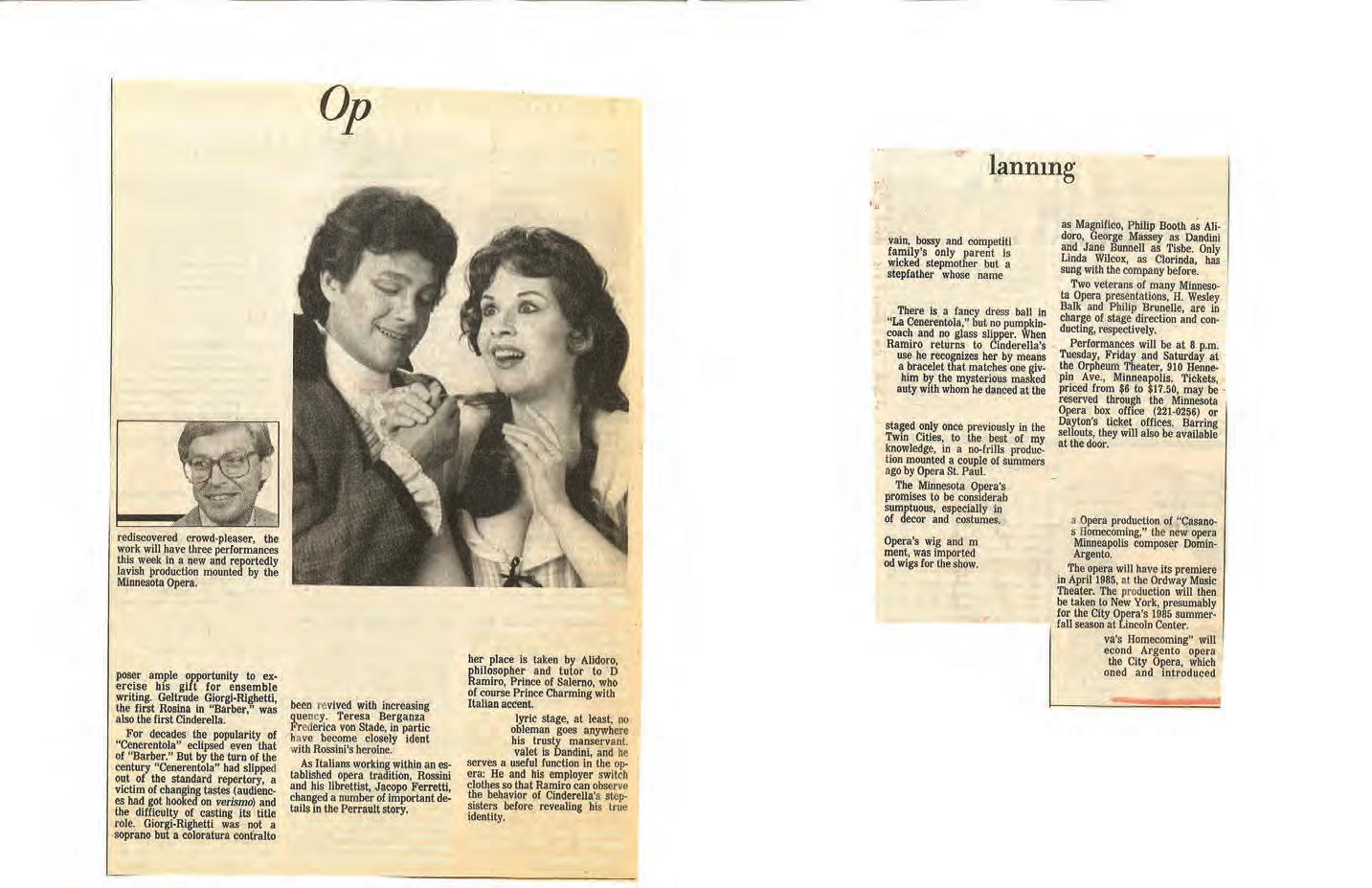

La cenerentola program, 1984, courtesy Minnesota Opera Archives

characterizations that would have held up well had the cast been playing a non-musical version of the story. And throughout the evening, Philip Brunelle conducted the proceedings in airy, high-spirited fashion, though it sounded as though his orchestra could have used a few more string players. And finally, not to be forgotten are the wildly imaginative wigs created by Richard Stead. One of them was a two-foot-high headpiece for Clorinda, one of the stepsisters, a confection that would have made a Las Vegas showgirl envious.
The 1983–84 season ended in April with a feeling of anticipation. Change was in the air. All roads— and all thoughts—led to the Ordway, the new theater scheduled to open the following January, finally giving this itinerant company, this band of strolling players, its first permanent home and along with it a marketable identity, a banner, a calling card that would make not just a few people but perhaps everybody on the planet say, “Oh, look, there’s Minnesota Opera over at the Ordway. I know them. They’re good. Let’s go.”
There were other hints of change ahead. For more than a decade Wesley Balk and Philip Brunelle had been listed in the programs as Artistic Director: Theater (Balk) and Artistic Director: Music (Brunelle). By the 1982–83 season, Balk was listed in the programs as Resident Stage Director and Brunelle as Resident Music Director. A year later, the titles had changed again. Balk was now Director of Artistic Development, and Brunelle had become Principal Conductor/ Director of Artistic Planning. By the summer of 1984 it was obvious that both were on their way out, or, more bluntly, were being pushed out. Balk
had resigned in 1982, having found the company’s increased reliance on traditional repertoire to be uncongenial. Nonetheless, Ed Corn convinced him to stay on for two more years in the vague position of Director of Artistic Development, which would allow him to stage a few more productions and then ride off into the sunset. Cenerentola in the 1983–84 season was Balk’s last mainstage production for the company. His dominating influence on Minnesota Opera’s ideology and style of production had come to an end. He would return a few years later to work with Ben Krywosz’s New Music-Theater Ensemble and pursue his lifelong interest in the training of performers, an effort that continued until his death in 2003 of complications from Parkinson’s disease. Brunelle held on for another season, conducting two productions during the first Ordway season and returning as a guest conductor in 1994 to conduct a production of Handel’s Julius Caesar, his sixty-sixth production for the company.
A final change, announced in December, involved both Corn and Kevin Smith. Corn, who had been general director since December 1982, would become executive producer, a new title, and Smith, who had been company administrator, would become general manager. Smith would take on some of Corn’s responsibilities: supervising the company’s administrative and production staff, scenery and costume shops, and business office. Corn would be involved chiefly in artistic planning, programming, and special projects. Board president Donald P. Brown hastened to say that these changes didn’t reflect a loss of faith in Corn, whom he credited with turning the company around after its financial crisis of 1982. The idea was to free up Corn to let him focus on artistic matters.
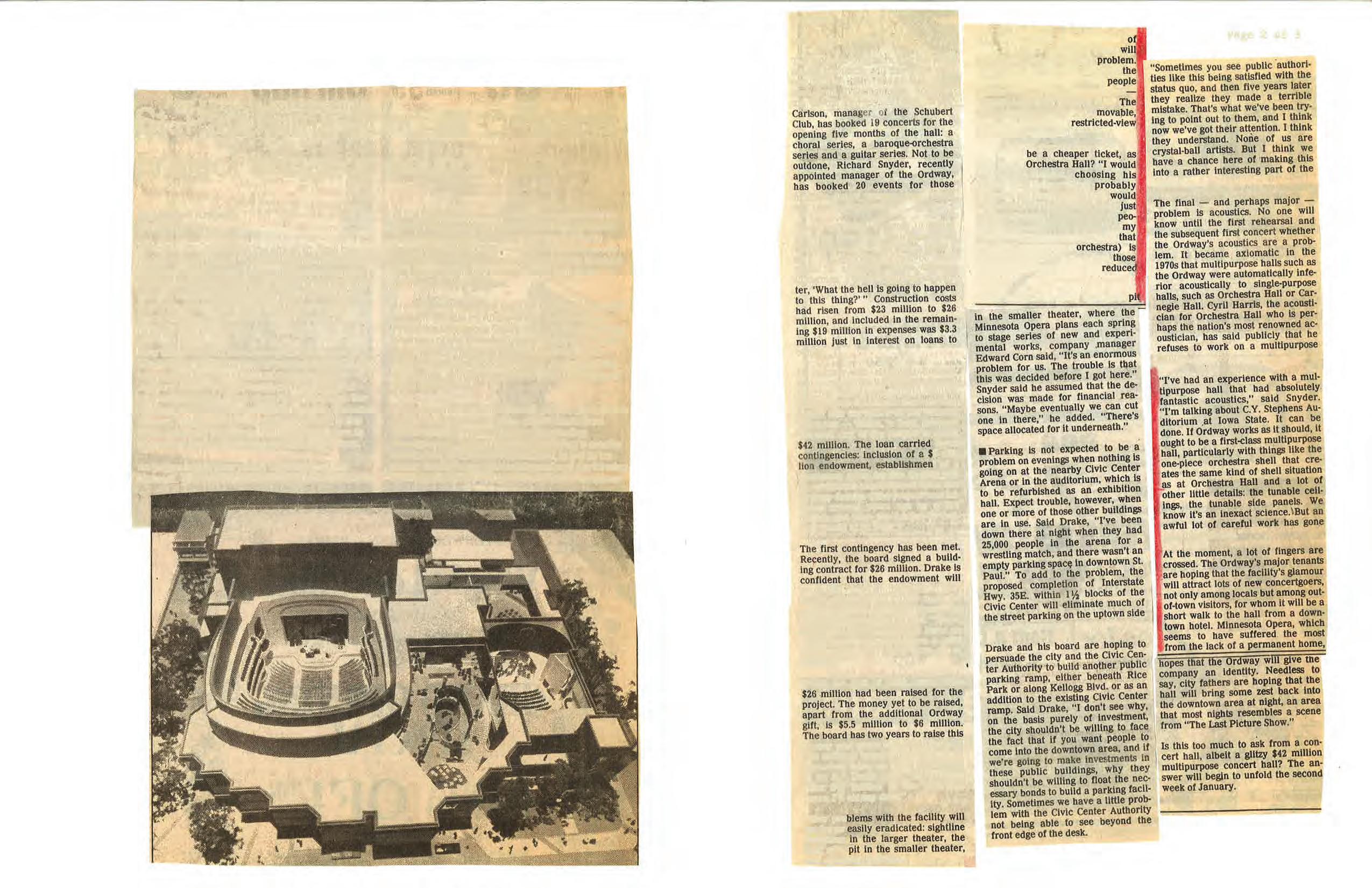

Minnesota Opera almost folded in the summer of 1982. The entire staff, with the exception of two people, was laid off for the month of June. One of the two was Peter Myers, managing director of the company’s touring arm. The other was Kevin Smith, a rock ‘n’ roll songwriter from California who had recently been promoted to the position of operations manager. In a little less than five years, Smith was running the company.
Smith grew up in West Covina, twenty miles east of Los Angeles. He and a high school friend kicked around in Los Angeles as a songwriting team, trying to sell their songs and playing in hotel lounges. One day, en route to Los Angeles from the San Joaquin Valley during a dust storm, the band’s van was rear-ended by a semitruck and everyone was injured.
“That was a signal to me that my rock ’n’ roll days were at an end. I was twenty-five,” Smith said. “I had no idea what to do with myself.” He hitchhiked north to Santa Barbara, where he stayed with friends and began playing piano for dance classes and helping build sets for the opera productions at Lotte Lehmann Hall at the university there.
“I thought, ‘Opera’s kind of a cool thing,’ and so I went in that direction.” The school didn’t offer a degree in opera, so Smith entered a master’s program in conducting. This didn’t last, however, and after dropping out and working a string of stage manager jobs, he started as Minnesota Opera’s production stage manager in September of 1981.
In December 1982, Ed Corn came aboard as general director and promoted Kevin to company manager. “I wasn’t sure what a company manager did,” Smith said, “but basically I was still on the production side, whereas Ed was an artistic and executive type. So I found myself doing anything and everything.”
Then Corn named Smith general manager, a title he held for three years. Meanwhile, Smith said, “Ed kept threatening to quit, and after the seventh or eighth time hearing that, the board got tired of it and said to him, ‘Okay.’ And then they said to me, ‘Kevin, you seem to be able to run the organization.’ [. . .] After a year of mentorship from Paul Parker, formerly of General Mills, I became the head of the staff. I became general director in ’86.”
Under Smith’s leadership, Minnesota Opera prospered. There were crises, to be sure, but by the time Smith retired in 2011, the company had grown from three to five productions a year, attendance had doubled, and the annual budget had increased to $9 million from $1.5 million. Assets rose from a minus $36,000 to a plus $28.8 million. Among his other accomplishments was the creation of the company’s Opera Center in the warehouse district of Minneapolis. Smith was instrumental, too, in the creation of the Arts Partnership, a collaboration with the St. Paul Chamber Orchestra, the Schubert Club, and the Ordway Center that brought an end to the scheduling conflicts that had plagued these organizations since the Ordway opened.
Two other factors contributed to the company’s growing success during Smith’s reign. One was the restructuring of the board in 1992, which chiefly meant reducing its membership. It wasn’t easy. Smith did a governance review. At the time the board consisted of forty voting members and forty associates. This was brought down to a single board of thirty. “They realized that it had to be done,” Smith said. “And that’s when people like Ken Dayton and Tom McBurney and Dan Kunin joined our board. Then, all of a sudden, although we weren’t really big, we had power and focus. And that was a big turning point for Minnesota Opera.”
A second factor contributing to the company’s success during these years was the creation of what the soprano Brenda Harris called the “dream team,” which is to say Smith and Dale Johnson. Both, it could be said, grew into their jobs after relatively modest beginnings. Smith started in 1981 as a production stage manager; Johnson arrived three years later as a rehearsal pianist and vocal coach and became artistic director in 1994. Between 1994 and 2011, when Smith retired, just two months before his sixtieth birthday, these two, Smith and Johnson, were the pillars of the company.
When one was removed, the structure lost its balance and fell. In the space of just three years, the board hired two replacements for Smith, both of whom were quickly let go amid growing deficits and staff desertions.
After he left the opera company, Smith began a more leisurely schedule of mentoring opera company leaders, including Arizona Opera’s Ryan Taylor, who would later become president and general director at Minnesota Opera. A surprise came in May of 2014 when the Minnesota Orchestra announced that the successor to the departing president and CEO would be Kevin Smith. Even though it was an interim position, this was a bold move for Smith, who was forsaking retirement for the most difficult reclamation project in the American orchestra world: putting the orchestra back on its feet after a devastating twoyear labor/management war that included a sixteen-month lock-out.
By 2015, Smith had secured significant new donations and balanced the budget. He had engineered a level of harmony between the orchestra and its board, signed new contracts with the musicians and their music director Osmo Vänskä, and, in an impressive coup, arranged for the Minnesotans to be the first American orchestra to tour Cuba after President Obama moved to restore diplomatic ties.
On Labor Day weekend, 2018, Kevin passed the torch of leadership to Michelle Miller Burns, who had been an executive with the Dallas Symphony. Just a month earlier, the orchestra had returned from another historic trip, this one to South Africa. On leaving the orchestra, Kevin and his wife moved to New Jersey.

For St. Paul, the week of January 8, 1985, was a burst of cultural fireworks lighting up the sky and informing the world that Minnesota’s second-largest city was in the big leagues now. No longer did St. Paul have to linger in the shadow of that arrogant city on the other side of the river. With its eye-filling copper and glass exterior, sweeping spiral staircase, and spacious promenade areas, the Ordway Music Theater was described as a $45 million jewel plopped down into the center of downtown St. Paul, a city not known at the time for either its cultural pursuits or its nightlife. The theater was intended to be the home of its principal users—the Schubert Club, the St. Paul Chamber Orchestra, Minnesota Opera, and the Minnesota Orchestra—each of which, in turn, night after night during the opening week, was given a platform, a chance to shine, to offer the public the best it was capable of with no expense spared. On opening night, the Schubert Club, a leader in the recital field for more than a century, presented the soprano Leontyne Price, at fifty-eight, who still proved to be a great operatic star capable of delivering exquisite moments in a wide-ranging program.
Thursday night was Minnesota Opera’s time in the spotlight. There was some extra anticipation about this because the company was presenting the American premiere of
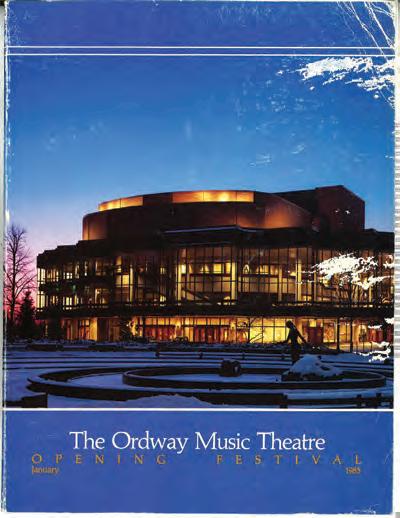

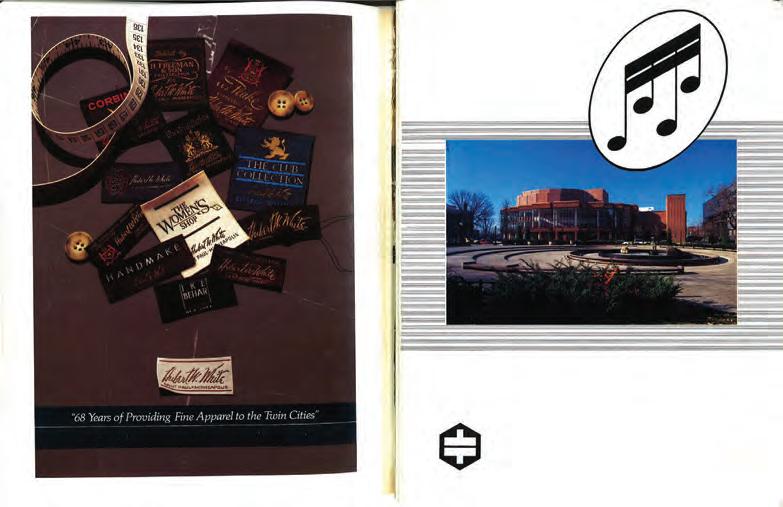




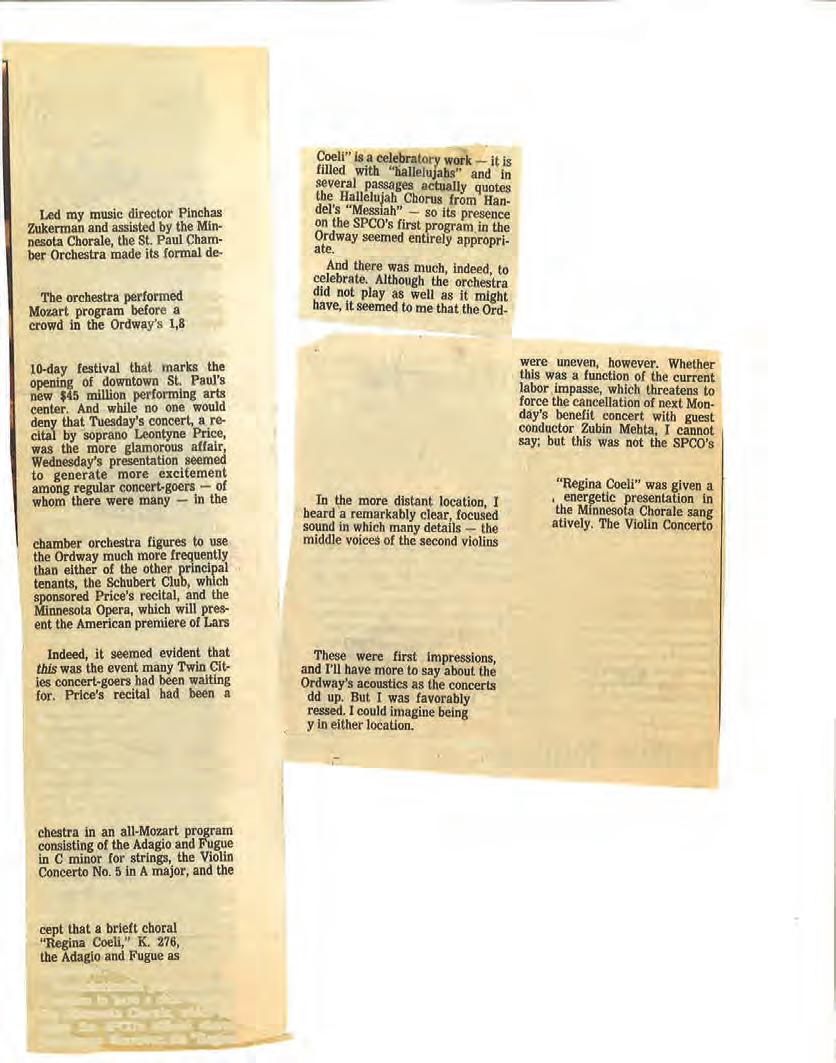

a Swedish opera that hardly anyone had ever heard of, a satire titled Animalen with music by Lars Johan Werle and libretto by Tage Danielsson that told of the animal kingdom’s attempts to mediate between two superpowers bent on mutual annihilation. Though just six years old, the work had received some five hundred performances in West Germany and Sweden, and that prompted the reasonable expectation—and hope—that it would be greeted with equal enthusiasm in the United States. As it turned out, this was a bad guess: Animalen was a major failure. The mushroom cloud projected onto an upstage screen several times during the show (the atomic bomb figures importantly in the story) was an image not totally irrelevant to the entire evening—the staging, the performances, and the show itself. No one liked it. The New York Times called it “exceedingly trivial.” TIME magazine said it was “more a musically jejune cabaret than an opera.” (It’s actually an operetta.) The show had been billed as the first Swedish opera to be staged in the United States. Now we know why there haven’t been more, said Newsweek
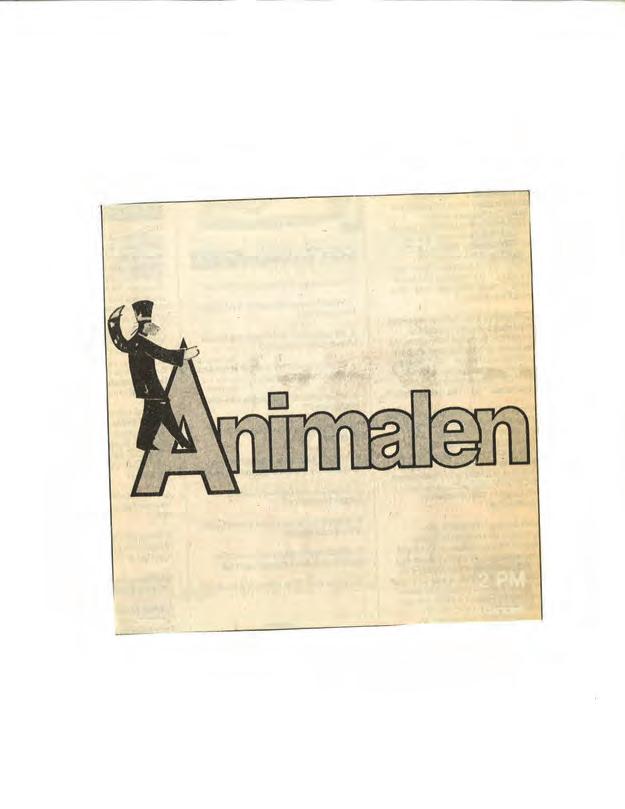


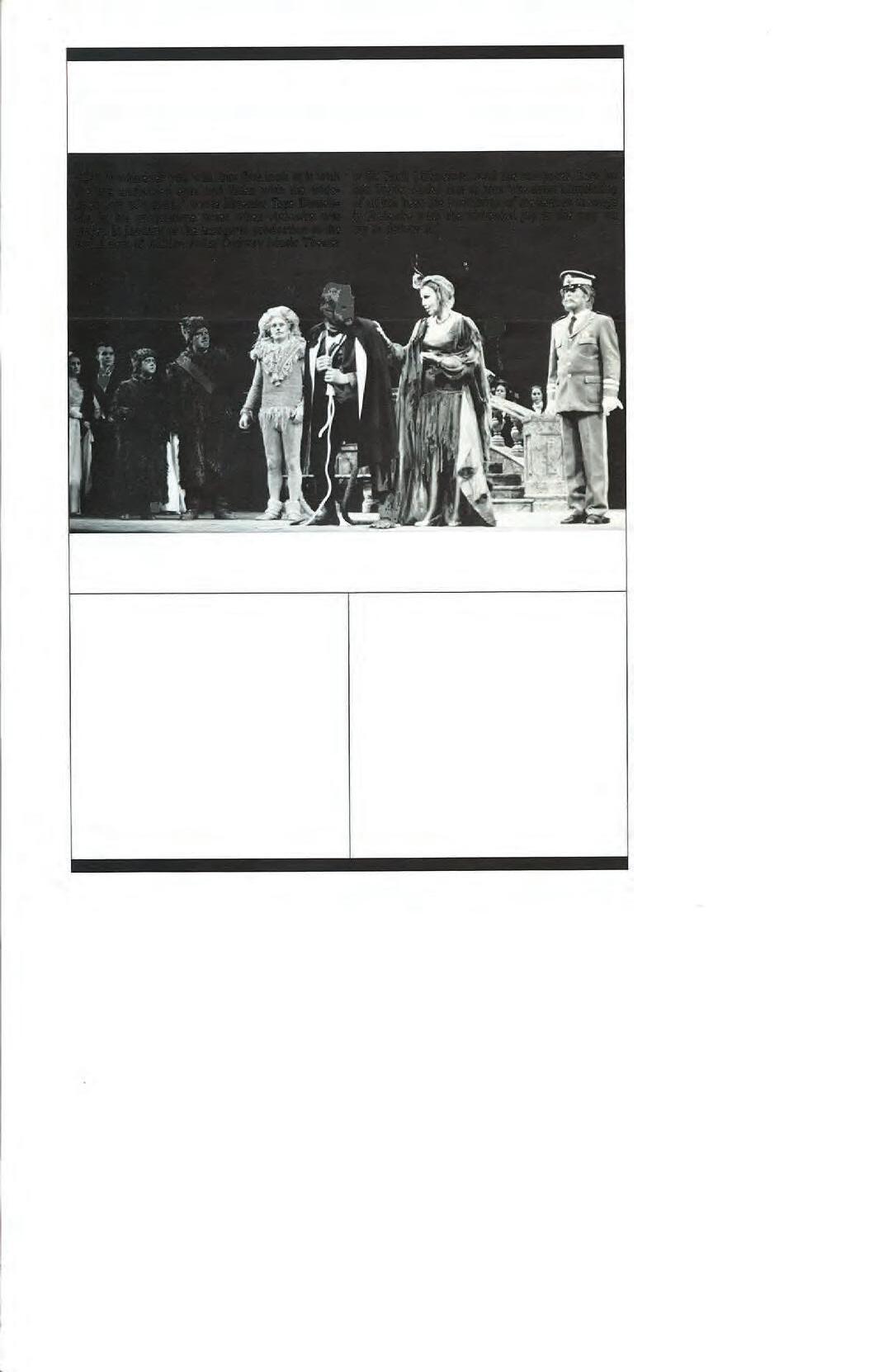

Danielsson’s libretto tells a simplistic fable. An American boy—a Las Vegas–style lounge entertainer—loves a Russian girl, a chanteuse. The diplomats of both countries try to separate them. Love, with the help of the animal world, conquers all, and the show ends, appropriately, in a wedding. Werle’s parodies of American lounge acts and Russian folk songs were inept, and Grethe Barrett Holby’s staging and choreography brought few surprises. Folksinger Sven-Bertil Taube came from Sweden to play the part of Lord Nelsen and sang amusingly, while two singers familiar to local audiences—Janis Hardy, who played a peacock, and Vern Sutton, who portrayed Smirnoff, a militant Russian— brightened the stage whenever they appeared. Philip Brunelle led a fine performance from the orchestra.
The major players all agreed that the show was a bomb. Janis Hardy said, “Animalen was a disaster in every way, and it’s a wonder the company survived it.” Vern Sutton added, “And politically it was a huge mistake. It may have worked in Sweden, but you can’t bring that particular approach to democracy versus communism to the United States. It was a really bad idea.” Dale Johnson, who had just been hired as pianist, vocal coach, and conductor, arrived right at the time the Ordway opened. “It was horrible and symptomatic,” Johnson said in an interview in 1987. “No one was really in charge. There was no overview. There were a lot of cooks in the kitchen. There was no thought given to what kind of opera this company should do. It was clear that we just weren’t ready to move into a house of the size and opulence of the Ordway. We weren’t artistically or financially ready to fill that space.”
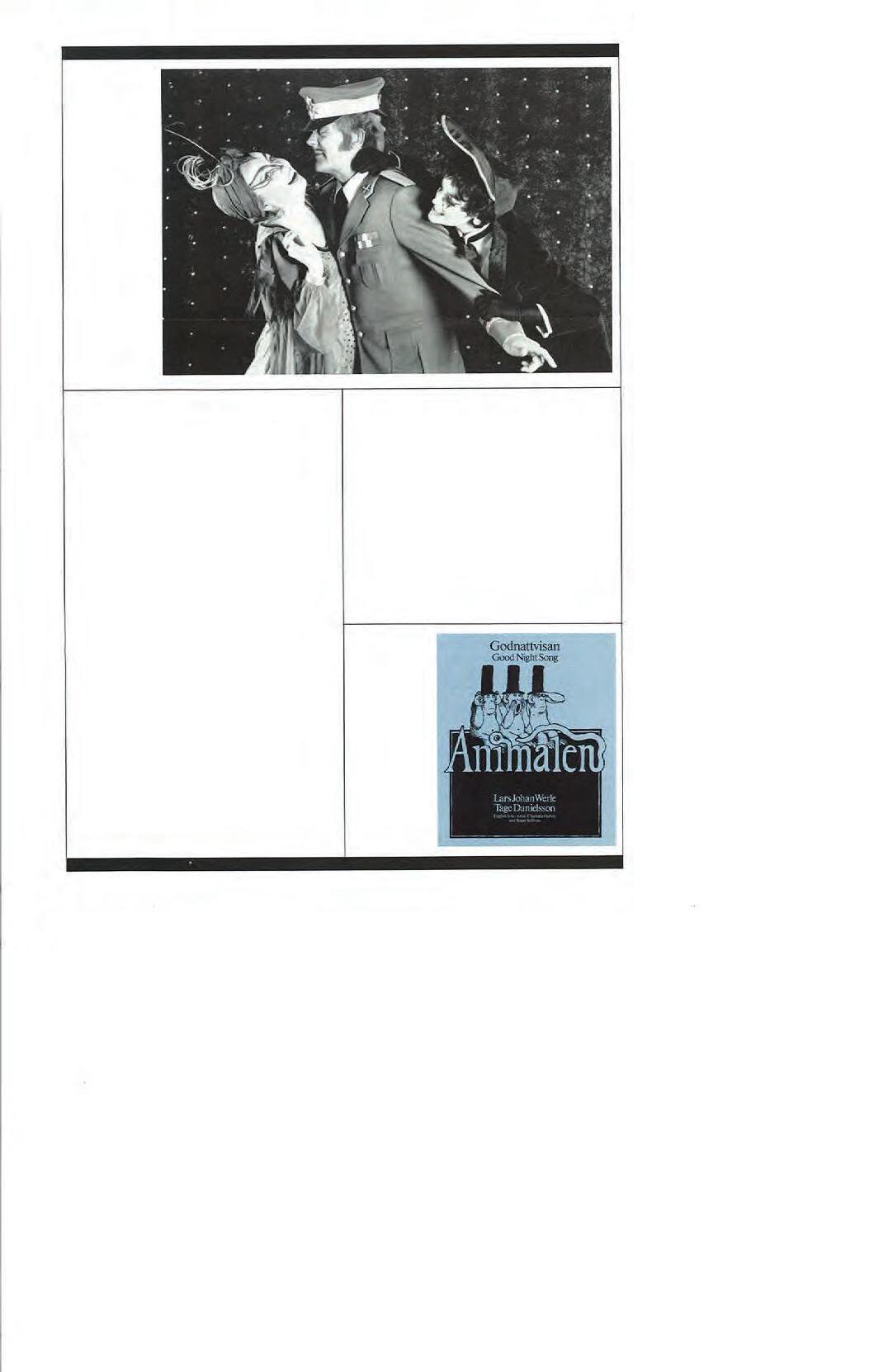

IN A BIT OF BEHIND-THE-SCENES drama, the composer Dominick Argento claimed that he had been promised the inaugural spot, that a work of his would be premiered on the Ordway stage as Minnesota Opera’s debut in the new theater. He and the company had determined some years earlier that this would be a comedy drawn from the memoirs of the eighteenth-century writer, rake, and rapscallion Giacomo Casanova, titled Casanova’s Homecoming. And it couldn’t be more perfect: casa nuova in Italian means “new house.” The substitution was made some time later. Animalen would be first at the Ordway, and Argento’s opera, which was to be repeated at the New York City Opera the following season, would be performed at the Ordway in April of that year. In his memoir, Catalogue Raisonné as Memoir: A Composer’s Life, Argento called the switch “an outrage.”
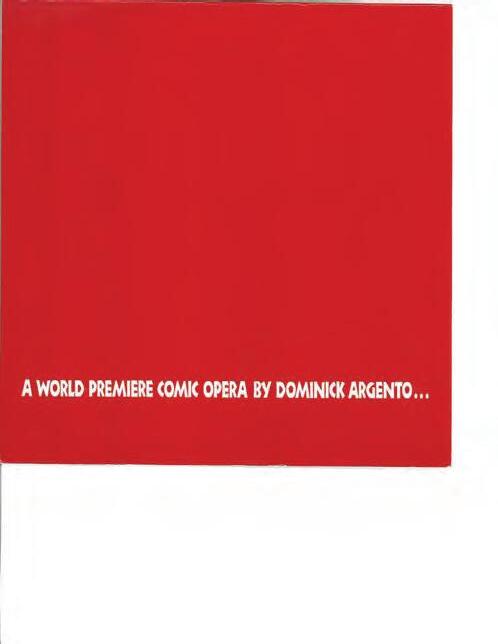
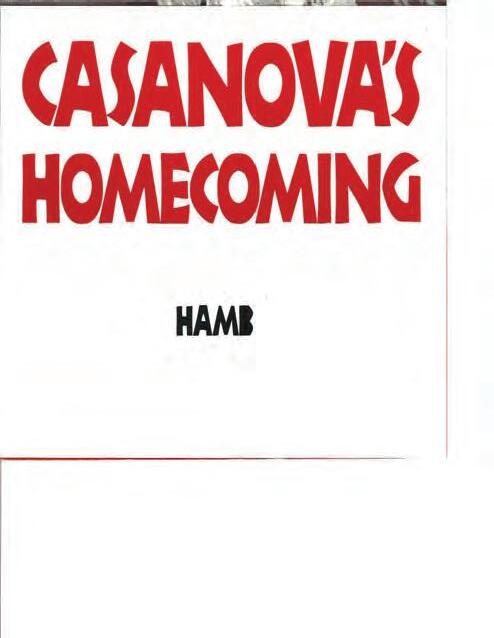
Casanova’s Homecoming, Argento’s thirteenth opera, for which he wrote both music and libretto, celebrates the life force: “The most important thing is to live, to love and, most of all, to love living.” The quote is from the preface to Casanova’s twelve-volume memoir. Argento uses the quote in the opera’s final aria to suggest that Casanova’s homecoming is not only a return to Venice, the city of his birth, from which he had been banished for twenty years, but a return to life for the aging voluptuary and the realization that he must make the most of the years he has left. Wisely, Argento didn’t try to dramatize the whole life but cleverly combined several of the livelier incidents from the memoir, Including the wacky tale of Madame d’Urfe, whom Casanova tries to bilk by concocting a mind-body transference. To live forever, the old woman’s spirit is to be transferred into the body of a male infant. Casanova, broke and defeated in spirit when he returns to Venice, falls in love with a singer who, in a kind of Venetian version of Victor/Victoria, turns out to be not what he/she seems. Much laughter ensues, and eventually all the complications of the plot are sewn together, and several couples pair off at the end, looking forward to everlasting bliss.
It’s a wonderfully playable, singable libretto, the first fulllength opera for which Argento wrote his own words. The score is full of the sounds of Venice—street singers, gondola balladeers, and church bells (bells being a special fixation of Argento’s). Beautifully orchestrated, the work makes use of traditional operatic devices: arias, duets, recitatives, and ensembles (a nimble quintet at the end of the first scene). And throughout the work Argento deftly blends eighteenthcentury harmonic ideas with his own modern, slightly dissonant style. And it was, all told, a splendid production that was well received the following season at the New York City
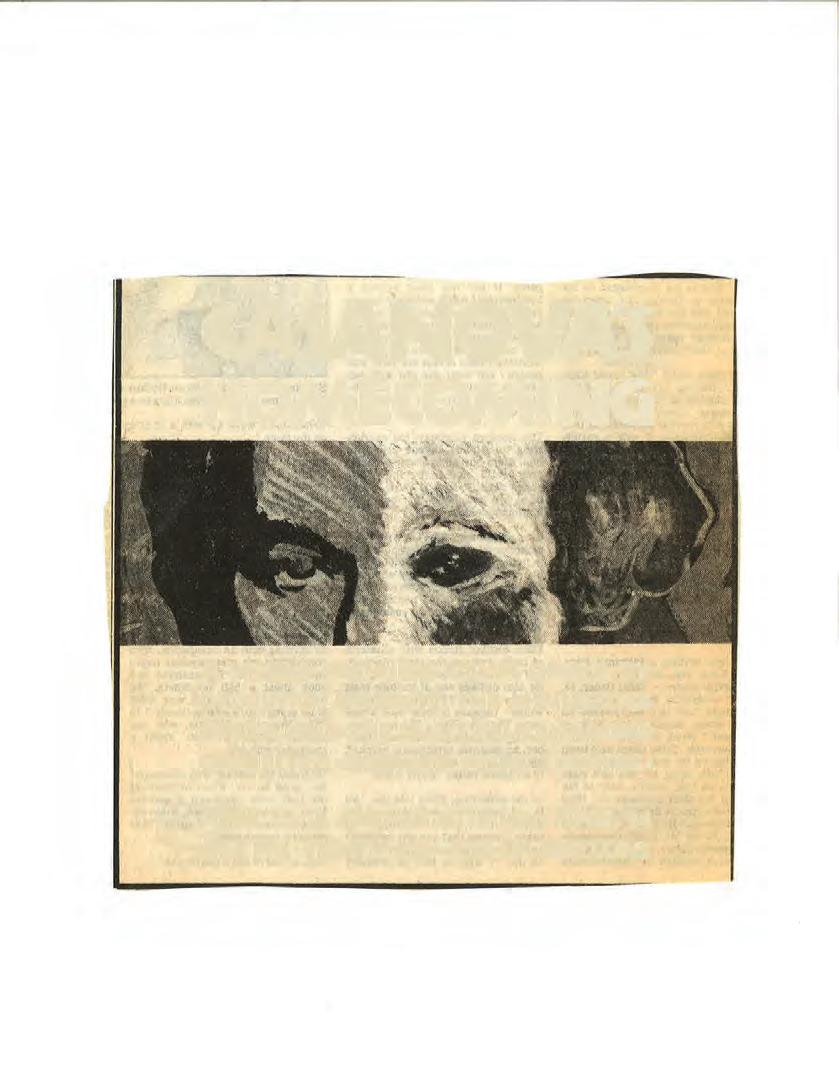

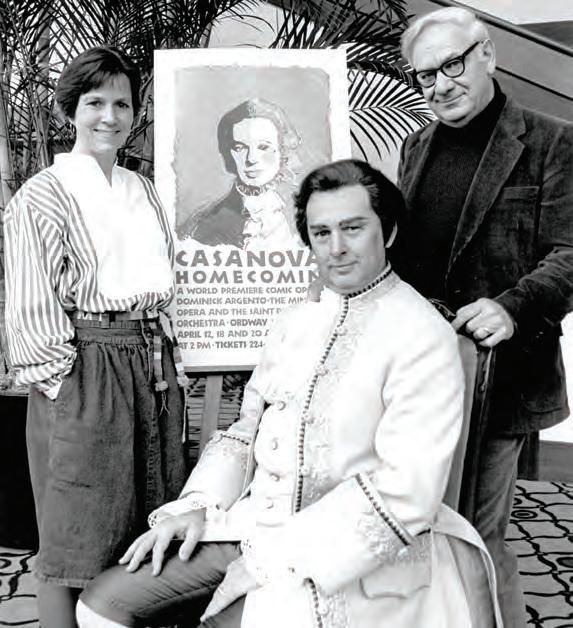


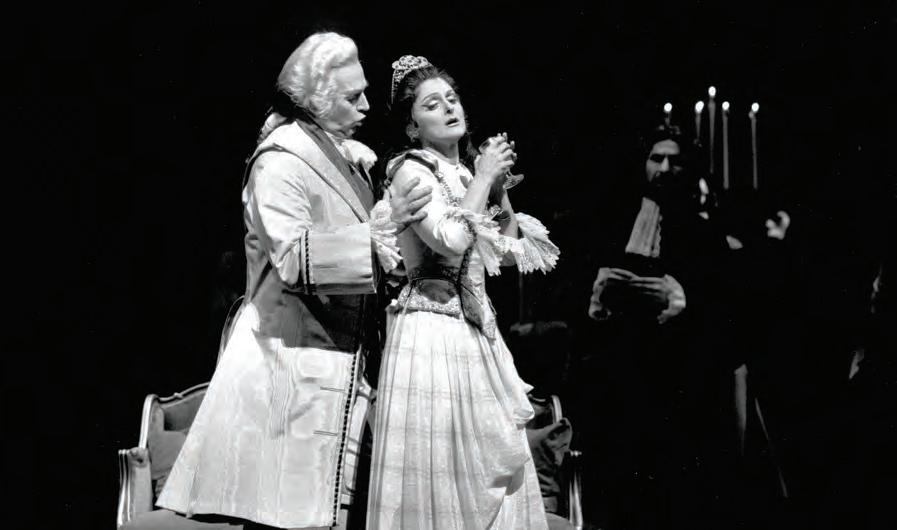
Opera, one of the coproducers of the show. Beverly Sills, manager of the New York City Opera, attended the opening night performance at the Ordway. Having heard Argento’s score, she told him afterward he must promise to write his own librettos from now on.
All the elements of the production contributed their best: Arthur Masella’s flowing but detailed staging; the eye-filling but always evocative sets and costumes by Franco Colavecchia and Lewis Brown; the atmospheric lighting by Duane Schuller; bright, witty choreography Larry Hayden; and the amazing wigs by Richard Stead.
A lovely, serene production of The Magic Flute closed Minnesota Opera’s twenty-second season with four performances at the Ordway starting June 11, 1985, that featured John Conklin’s elegant designs, along with thoughtful staging by B. Rodney Marriott and sensitive performances from the cast: Bruce Edwin Ford (Tamino), Pamela South (Pamina), James McKeel (Papageno), and Nancy Lillis (Papagena).
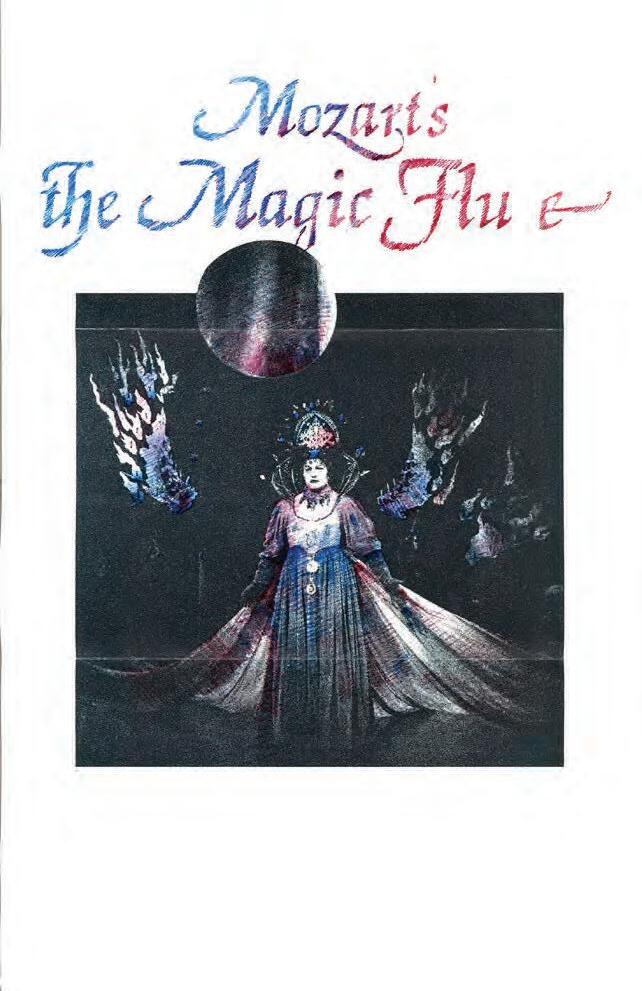
MINNESOTA OPERA ENDED its first Ordway season with a sense of guarded optimism. All of the company’s productions had sold out. True, one of them, Animalen, was a disaster that no one wanted to talk about. Casanova’s Homecoming, on the other hand, proved to be a triumph, one of Argento’s finest— and funniest—works, an impression that the revival in 2017 did nothing to alter. Clearly, Minnesota Opera had entered a period of change; some of those changes would be smooth, some awkward. Certainly, the resignation of Philip Brunelle was a jolt to a lot of people. The resignation was announced in April, but May 31 was Brunelle’s last day. He had joined the company in 1968, an eager and multitalented twenty-eightyear-old, initially as music director, then as co–artistic director with Wesley Balk, and finally as director of artistic planning. The last title, which coincided with the arrival in December 1982 of Ed Corn as general director, was seen by some as a demotion, even though Brunelle continued conducting most of the productions during his last period with the company. Corn, it seemed, wanted both Balk and Brunelle out. At the time Brunelle left the company, he cited artistic differences with the management. In 2018, he said it was more a matter of Corn’s temperament. “I couldn’t work with him,” he said.
Some of the other changes were painful too. Gary Briggle, a tenor who sang with the company for ten years and eventually went on to a busy career as a director and actor, said he offered early in the Ordway period to audition for roles in upcoming productions but got no response. “There wasn’t a callback. There wasn’t a letter of rejection. There was nothing,” Briggle said. He eventually got an answer from both Kevin Smith and Dale Johnson. “They said, point-blank, ‘We are severing ties with the Balk tradition. We don’t want anyone who was associated with that approach moving forward. We want national and international artists.’ The suggestion was clear and literal,” Briggle said. “You need to go to New York and get a New York [address] for us to consider you.”
“I can’t imagine why I would have said that,” said Kevin Smith in 2018. “There wasn’t any policy of not hiring these people, but it’s true that at that time we had started working with Joan Dornemann, and you could argue that we were getting into a whole new era of casting. But even in the Dornemann years, we were hiring local people. Beth Comeaux came aboard in ’85. She was in Casanova. And for years we used Dan Dressen.”
Two other singers, Vern Sutton and Janis Hardy, both veterans of the ancien régime, felt they were snubbed in the post1985 era. “I didn’t do anything with them for a long time until Casanova,” Sutton said, “and that’s only because Dominick
had written a role for me in that opera, and he insisted that I sing it. They didn’t want me to sing it. And then on the fiftieth anniversary, the reason I sang in Turandot was for publicity because I had sung in the first show in the first season.”
“I didn’t feel as if I were being blackballed,” said Janis Hardy in 2017. Her last role for Minnesota Opera was Orlofsky in the 1987 production of Fledermaus. She continued on, “They just didn’t want to use me, and, really, that’s their prerogative.”
Dale Johnson, too, denied that there was a policy of not using singers associated with Balk/Brunelle, and he also mentioned the frequent casting of Dan Dressen, though Dan, who arrived in 1981, wasn’t really part of that earlier group. “I used people who I thought could perform at the Ordway,” Johnson said in 2018, as he was leaving his position as artistic director. “That’s a big space, and it’s got funky acoustics. You need a certain kind of singer there. You know, companies have to keep moving and growing. Otherwise, they get stuck in the past. It’s like now. I’m gonna be moving out. Things have to change. There have to be new thoughts.”
The elephant has left the room. The actual departure didn’t take place until May 1986, at which time the Metropolitan Opera packed up its trunks, waved goodbye, and never again performed its stunts at Northrop Auditorium. Bruce Crawford, the Met’s general manager, had made it official on June 22, 1985, with an announcement to the four cities that the annual spring tour was canceled. The fact that only four cities were involved—Atlanta, Minneapolis, Cleveland, and Boston—when once there had been a dozen, was an indication of the declining market, not for opera, but for what the Met tour had been offering in recent years: tacky-looking, all-purpose productions with fewer and fewer star singers at a cost that the cities could no longer afford—$915,000 for the final tour. And the Met itself, Crawford claimed, lost $1 million on the tour every year.
Surely the Met’s departure presented an opportunity for Minnesota Opera to attract at least some of the Met’s audience, which at its peak numbered some 30,000 people who came from as far away as Montana and Saskatchewan. Irma Wachtler, general manager of North Star Opera and a seasoned operagoer, said there were people who went to the Met and never went to anything else, “and I’m not sure they were all opera fans,” Irma said. “I remember a woman saying to me, ‘Oh, wasn’t Pavarotti wonderful last night?’ It turned

Press feature, “Grand Opera Makes Its Last Stand”
out he had canceled. She hadn’t heard the announcement, and apparently, didn’t know what he looked like.”
“Obviously, with the passing of the Met a large gap will exist in operatic service in the Twin Cities,” said Ed Corn in an interview in the summer of 1985. “How Minnesota Opera will want to fill that gap, if at all, I don’t know how to answer at this point. Are we going to start bringing in big-name stars? Are we going to do a longer season of standard operas? Obviously, we can go too far in trying to be all things, operatically, to all people. I don’t think anybody has had much time to think about this yet. We should all have been thinking about it before this.”
Asked about his rumored impatience with Minnesota Opera’s board of directors, Corn, never one to beat around the bush, said:
Minnesota Opera’s board is not the equivalent of the boards of other major institutions in the community—the two orchestras, the Guthrie, the two museums. There’s no point in kidding ourselves about that. Minnesota Opera is not perceived by this community as a major institution. There was an ad in Variety three or four weeks ago that contained a letter from Gov. Perpich. Perpich mentioned every major organization here you can think of but not Minnesota Opera. It’s a paradox that Minnesota Opera is considered the most innovative opera company in the United States, but in
the Twin Cities people think it’s minor league or amateur or whatever, and there’s an important historical reason for that. For its first fifteen years, Minnesota Opera did what Wesley Balk wanted it to do. The company was appealing to a narrow range of the population. The company didn’t need a huge board, it didn’t need a lot of funding, and it didn’t need a lot of ticket sales because it was performing in small theaters.
Hearing Corn’s assessment in 2018, Smith said he agreed with everything Corn said. “I don’t know about whether the company was respected or not—I wasn’t networking in that area—but I know it wasn’t a strong board,” Smith said.
But the bigger issue was the Met tour. For forty years everybody got their opera fix in May of every year. Minnesota Opera, when it was Center Opera, was a counterculture approach to opera, and it really complemented the Met. When we tried to plan repertoire, and we had to do a certain amount of standard rep, everyone’s heart was still in the new works. When we were going to do, say, traviata, and then all of a sudden the Met, who wouldn’t announce what they were doing until a couple of months in advance, would say, "Hey, we’re doing traviata." Within a three-year period they would cover the entire canon of the most popular operas. So why would you go to Minnesota Opera to see traviata or Carmen when the Met’s doing them? [. . .]
It wasn’t until the Ordway opened and the Met tour ended in ’86, all of a sudden the world opened up for a [local] opera company here.
Corn acknowledged that there were problems at the Ordway right from the start, but he denied rumors that Minnesota Opera was seeking an alternate venue in downtown St. Paul. “It’s true that when we moved in, the orchestra pit didn’t work, the lighting system was unreliable, and the acoustics weren’t what they should be. In moments of anger, we might have said, ‘Oh, the hell with it. We’re going to find someplace else. But the Ordway is Minnesota Opera’s home,” he said, “and, as far as I know and as far as I’m concerned, it always will be. The Ordway isn’t perfect. But what hall is perfect? The main problem with the Ordway,” he said, “is that it’s a multipurpose hall.”
Indeed, multipurpose halls fell into disfavor in the 1970s and ’80s, the charge being that no hall can be suitable acoustically for every kind of performance. The Ordway, its found -
Ordway Music Theater rendering with variable acoustics
ers hoped, would be a shining exception to that rule. And to most ears this $45 million jewel has served adequately various forms of dance, recital, and music theater, including opera (allowing for discrete amplification, which is supposed to be a secret). Where the hall fell short was as a venue for orchestras. The Minnesota Orchestra, which started an Ordway series in the hall’s second year, sounded dim and one-dimensional at the Ordway, especially compared to the sounds it made on the stage of its hi-fi home base, Orchestra Hall in Minneapolis. Sir Neville Marriner, during his years at the helm of the orchestra, was the chief whistleblower on this issue. The sound of an orchestra—any orchestra—playing on the Ordway stage goes straight up, he said, not out into the audience. It’s in the nature of a proscenium stage, which has two rooms—the stage and the audience area—whereas the best concert halls, like Orchestra Hall, are made up of one room only.
Despite Sir Neville’s reservations, audiences flocked to the Ordway in ever greater numbers, and the Minnesota Orchestra maintained its concert series there until the Osmo Vänskä era. The St. Paul Chamber Orchestra didn’t leave until 2015 when the $42 million Ordway Concert Hall opened. For Minnesota Opera, the Ordway was the home the company had been seeking for more than two decades, though there were problems right from the start. It is alleged that early in the construction phase when Ed Corn found out that the
Studio Theater, later named the McKnight, would not have an orchestra pit—thereby rendering it practically useless for music theater—Corn let out a yell that was heard all the way to Selby and Dale.
Occasional slipping and sliding could be seen during Minnesota Opera’s 1984–85 season, but nobody drove off a cliff, and the good news was that season ticket sales rose 25 percent over the prior year and most of the performances were sold out.
THE 1985–86 SEASON looked promising. Besides the standard works— La traviata, The Elixir of Love, and The King and I —there were two items of special interest. One was the American premiere of English composer Oliver Knussen’s Where the Wild Things Are, a setting of the popular Maurice Sendak children’s book; and there was a mini festival of new works called Opera Tomorrow.
A full moon hovered over downtown St. Paul the night of September 27, 1985, which happened to be the evening that Minnesota Opera presented the American premiere of Knussen’s Where the Wild Things Are at the Ordway Music Theater. Was this a coincidence? Perhaps. Consider the fact that the opera, which has a libretto by Maurice Sendak, author of the bestselling picture book on which the opera is based, concerns itself with spooky things—the monsters that live in the imagination of a six-year-old boy. Consider,

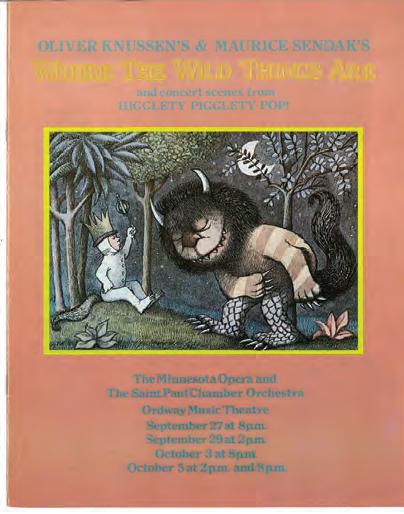

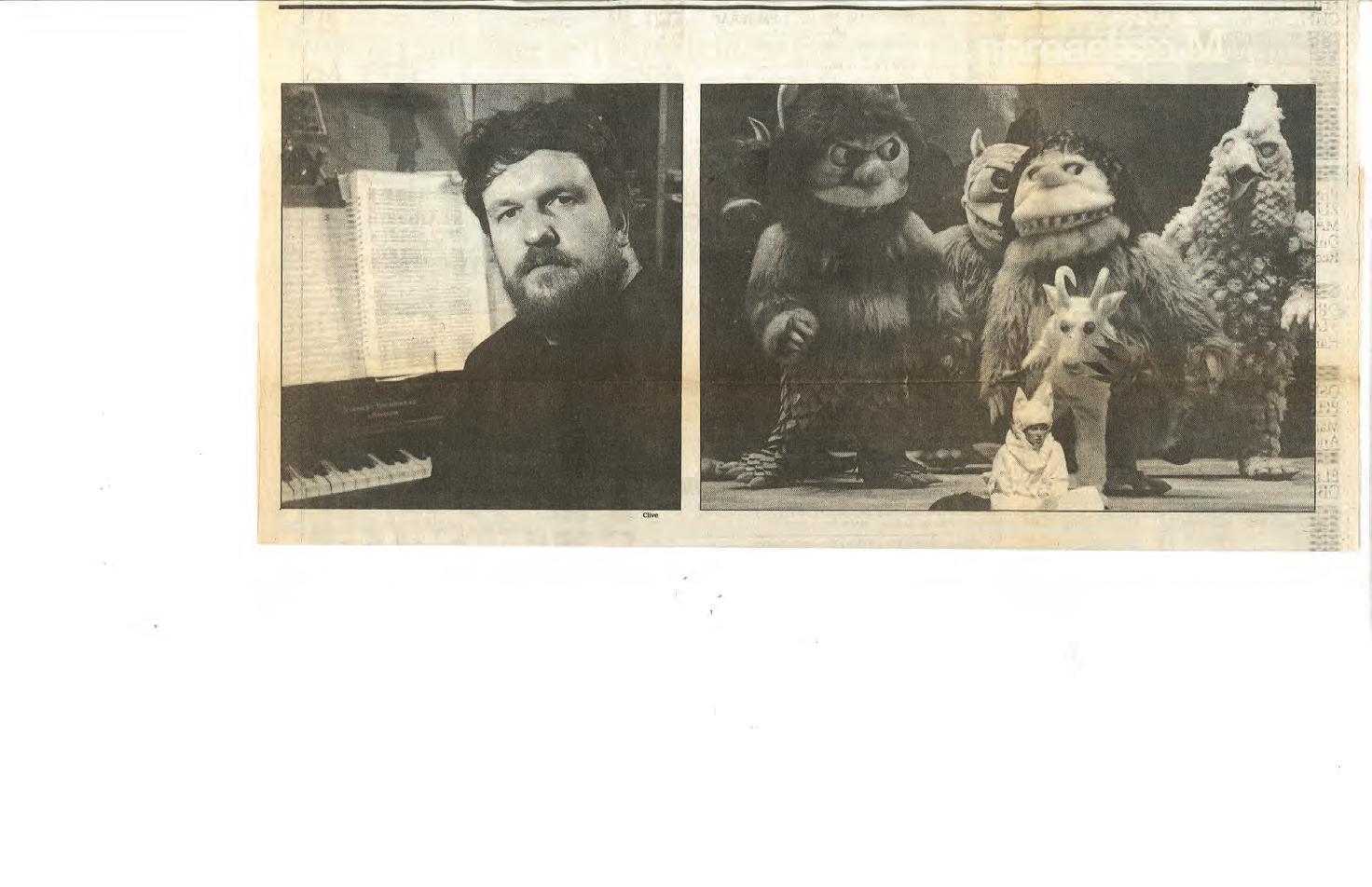
too, that it is the appearance of a full moon on an upstage screen in this wickedly inventive production that signals our journey into the mind of the boy Max. The moon moves sideways, then drops a few feet and turns pale red. The nighttime revels begin, and soon we come to the heart of the matter, an uninhibited, rather pagan dance (Knussen called it a rumpus) in which Max and the twelve-foot-tall wild things cavort ecstatically to music of the most jazzy and anarchic sort—an update on what Duke Ellington called jungle music. What was refreshing about Wild Things was that it drew no heavy moral lessons, as do most tales for and about children. And Max—no Shirley Temple—isn’t an idealized child eager to please his parents. Nor is Wild Things a parable about
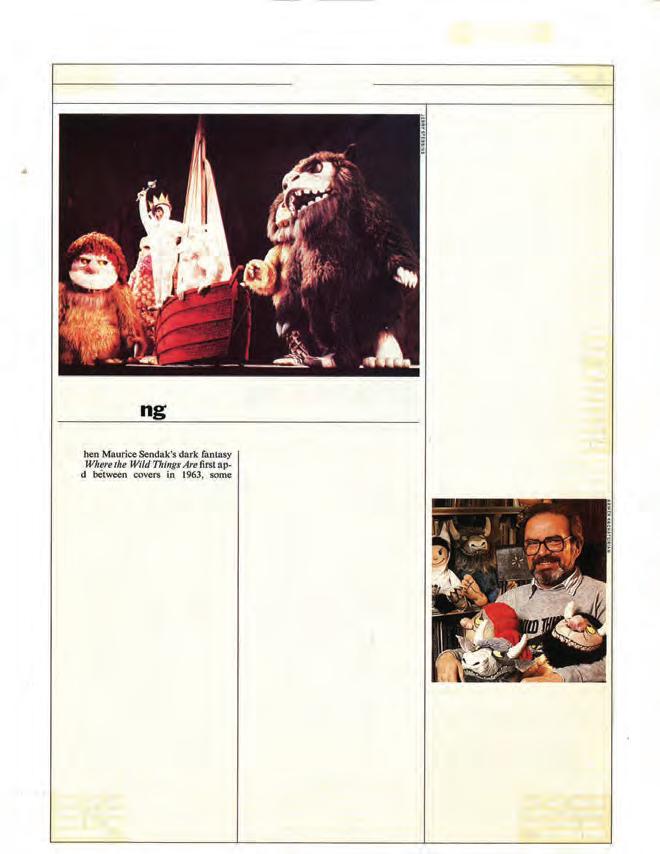
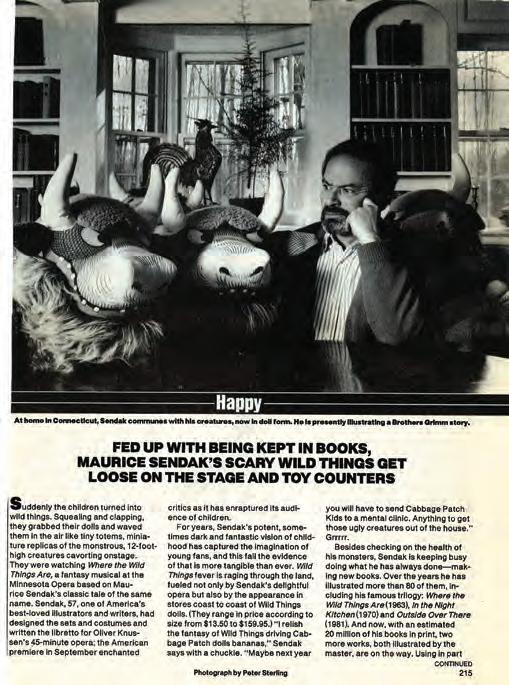
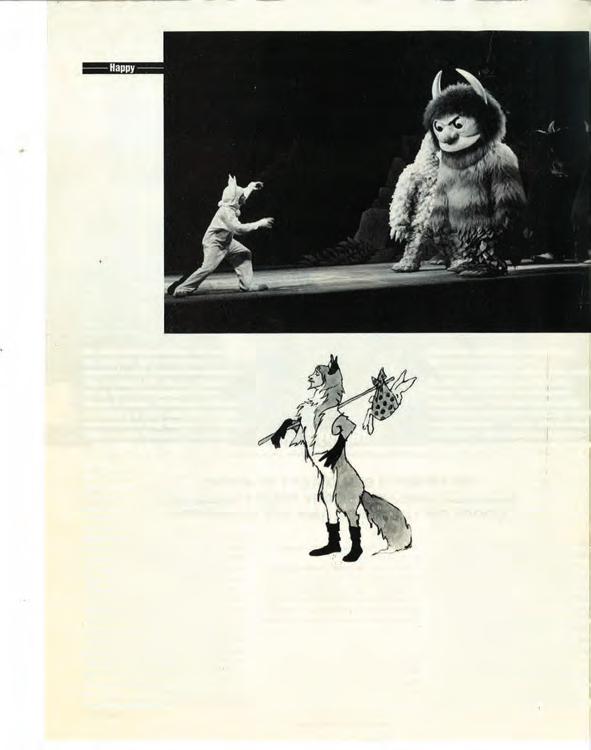
the limits of the imagination, nor a cautionary tale about what happens to bad boys. Max has a whale of a good time with the creatures. He tames them and they crown him king. Knussen’s score, commissioned originally by the Brussels Opera, is itself a wild thing—hammering percussion parts, shrill, almost scary woodwind writing coupled with the primitive chanting of the wild things. The flaw is in the overly high-pitched vocal writing for Max and his mother. The words couldn’t be understood. The production, which came from the Glyndebourne Festival in England—Cengiz Saner was the director and Sendak the designer—is exuberant and imaginative. Soprano Karen Beardsley (Max) and mezzo Mary King (the Mother) sang and acted in properly uninhibited fashion. Pinchas Zukerman, making his operatic debut, led an expanded St. Paul Chamber Orchestra, drawing color and rhythmic verve from the score.

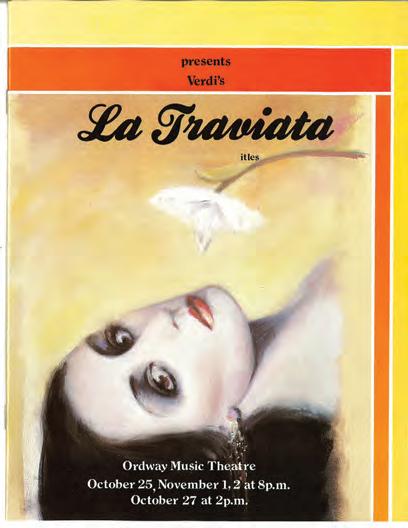

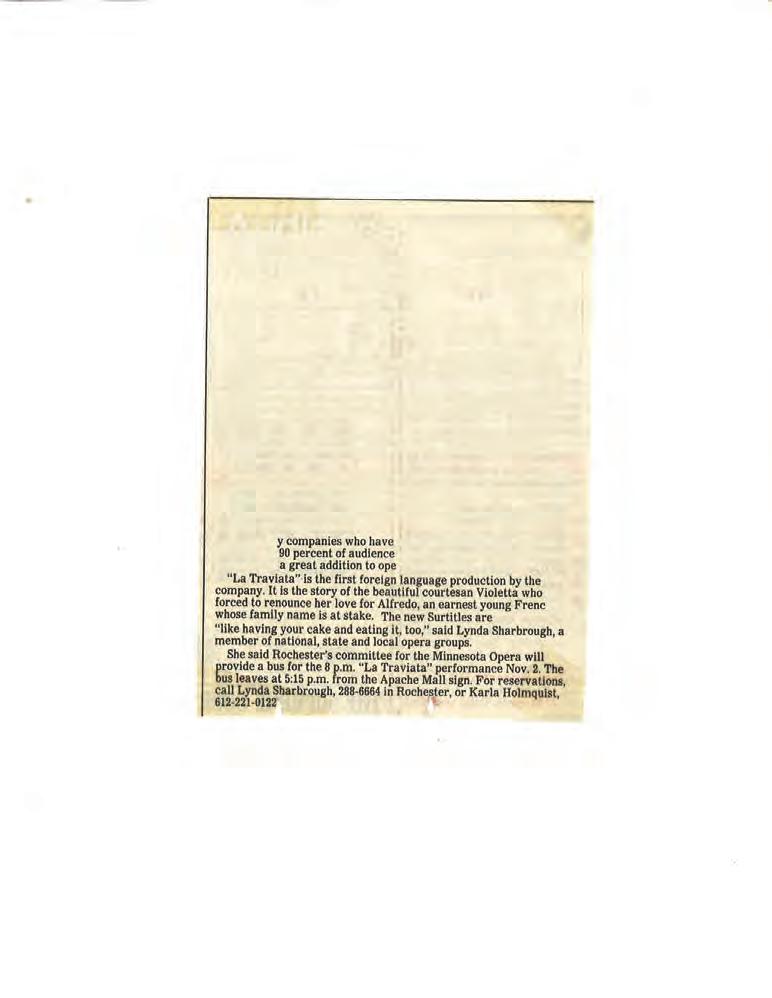

Where the Wild Things Are proved to be a lively way to open Minnesota Opera’s twenty-third season. The production of La traviata that followed, though not very good, was notable, given that it was the company’s first production sung in a foreign language. As had already been the practice with several opera companies, surtitles projected above the stage

gave the text in English. Soon it would become common practice, and audiences would begin to understand much—or at least some—of what was being sung, and that surely would be a benefit in comic operas. For Minnesota Opera, singing in a foreign language was a movement toward tradition. A company once devoted to the new and the unusual now could more fully embrace the old and the common. Minnesota Opera moved to where most opera companies begin: traviatas and bohèmes in Italian. This shift did, of course, satisfy those who had never liked opera in translation and weren’t all that crazy about new works. Beyond that, the hope was that this step backward, if it was that, would allow the company to hire better singers—meaning bigger voices. That goal remained in the distance, judging by the traviata that opened October 25, 1985, at the Ordway Music Theater. As staged by the much-admired actor Ken Ruta with sets and costumes by John Wright Stevens and John Conklin and conducted by Gerhard Samuel, this was a strictly traditional traviata, pleasant to look at, safe, and unexciting. The surtitles, using Sonya Friedman’s apt and succinct text with no glitches or quirks, were more reliable than the cast.
The production of The Elixir of Love, which wrapped up the company’s first fall season at the Ordway, was loaded with charm and humor. Anne Ewers staged it, offering an unusually well-rounded, dramatically sensitive telling of the story, making it both amusing and endearing.
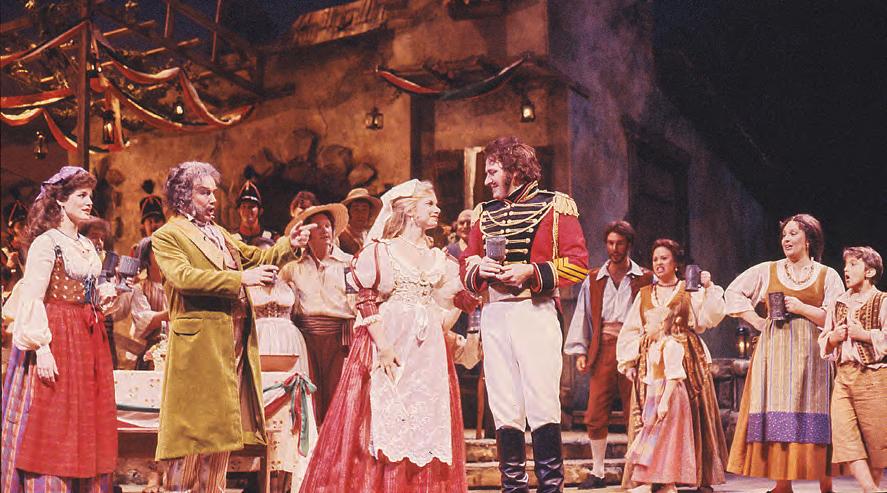
GIVEN MINNESOTA OPERA’S history of boldly going where no opera company has gone before, it made sense that this would be the company to present the most extravagant festival of new music-theater works that anyone had ever seen or even imagined they might have seen. This was Opera Tomorrow— eleven works by composers, theater artists, and video artists performed between April 11 and 19, 1986, at the Ordway Studio Theater. Two of the participants, the composers Libby Larsen and Jan Vandervelde, were based in Minnesota. Others were from Milwaukee, Baltimore, San Francisco, and New York City. General director Ed Corn came up with the festival idea the prior summer, thinking of it as a showcase for works that had evolved out of the company’s Composer-Librettist Opera Studio, a workshop wherein librettists and composers are paired together to see what might develop. Corn, however, had to drop out of the project when he got a chance to manage a tour of the Off-Broadway musical Once Upon a Mattress to several Asian and Middle Eastern countries, an enterprise cosponsored by Minnesota Opera and the US Information Agency. Corn turned management of the festival over to Ben Krywosz, a protégé of Wesley Balk’s who had spent much of the past five years with Minnesota Opera directing occasional mainstage productions as well as guiding the creation of new works. A former lightshow artist for rock concerts who discovered opera in the early ’70s in San Francisco, Krywosz was at that time project director of Opera America’s “Opera for the ’80s and Beyond,” a program designed to encourage new music-theater, a broad category that includes opera. Explaining his role, Krywosz said, “I go around to these
companies and say, laughingly, ‘I’m on a mission from God. I’m sort of the Rambo of the new music-theater world.’” He sees the “music-theater impulse” as a universal human characteristic that dates back to prehistoric people dancing around campfires and telling stories. The Italian response to that impulse gave us the operas of Verdi and Puccini. America has yet to fully realize its own response, though the ingredients are handy, Krywosz argued, in the Broadway musical, in pop music, and in the new technologies, especially video. He hoped,
he said, that some of the new works on display at the Ordway—many of them works in progress—would show how those elements can be used— and fused.
Four on the Floor, seen on opening night, was a collaboration between Libby Larsen and filmmaker Sandy Smolan that started out as a piece for chamber ensemble, a harddriving, percussive work with a prominent piano part that Larsen composed for the Minneapolis Artists Ensemble and was premiered in 1982. Thinking that the piece should be visualized,

Minneapolis Star & Tribune review of Opera Tomorrow, 1985
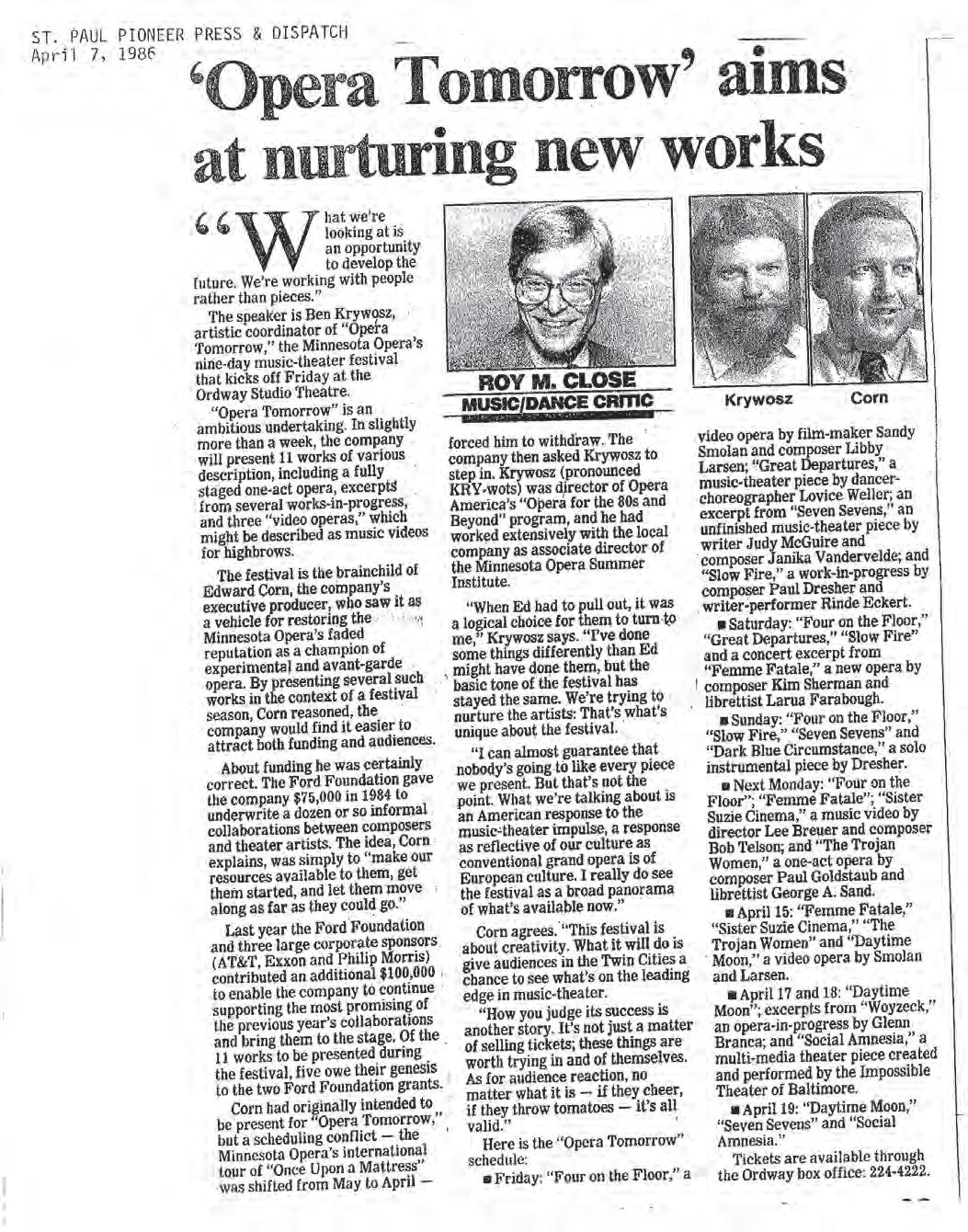
Larsen approached Smolen, who liked the music, and wanted to do it. They got funding from Minnesota Opera, and the result was a whimsical film that started out in a graveyard for pianos. As the music heated up we saw images of highways, and we ended up in an automobile salvage yard as a piano was picked up and thrown into a giant crusher by a wrecking yard crane. The tone was tongue-in-cheek, but the message was clear: we live in a disposable society. Even pianos become junk. Maybe people are next.
With Glenn Branca’s Woyzeck, the festival moved closer to traditional music drama, in this case a work based on the play by George Buchner that Alban Berg turned into one of the most admired twentieth-century operas. Branca used an orchestra of forty-eight strings, producing an unusually rich sound that drew from the overtone series, similar in effect to this composer’s works for electric guitar. Branca’s vocal writing—solo voices moving slowly in ascending and descending patterns—takes some getting used to, but the ultimate effect was engrossing: a feeling of dramatic weight, as if the characters were speaking from the depths of their troubled unconscious minds. Veteran opera conductor Henry Holt conducted the excerpts with great care. The strong singers were James McKeel and Janet Gottschall.
Even more traditional were The Trojan Women and Social Amnesia. Paul Goldstaub’s score for the former, which is based on the play by Euripides, makes use of traditional operatic forms—arias, ensembles, and recitatives—though his idiom is contemporary. Social Amnesia, a creation of the Impossible Theater of Baltimore, derives in form from the satirical revue: a series of thematically connected sketches. Both were
low points in the festival. Goldstaub writes ungratefully for the voice. His librettist, George A. Sand, updated Euripides to some time in the future after a nuclear war—an operatic Mad Max, but without engaging characters or situations that evoke the necessary pity and terror. Social Amnesia substitutes long-winded and tedious hectoring for satire. It was performed in amateurish fashion to an audience that diminished in number as the piece went on and on.
Clearly, the hit of the festival was Paul Dresher’s Pale Fire. Rinde Eckert’s text gave us an alternately fearful and whimsical portrait of Bob, a young American of the ’80s whose chief devotion is to sheepskin seat covers and whose ultimate direction in life is political terrorism. Dresher’s rock-oriented score underlined the character’s volatility and paranoia. Rinde’s portrayal of Bob, as charismatic as it was vocally powerful, probably remained for quite some time in the memory of anyone who saw it.
Opera Tomorrow was a success, despite its weaker entries. The festival displayed a range of forms and techniques that was often dizzying. But, as Krywosz put it, “Our investment is in people rather than pieces,” meaning composers and librettists rather than masterpieces. Maybe the masterpieces will follow.
ED CORN, EXECUTIVE PRODUCER at Minnesota Opera, returned to his office on April 27, having piloted the company’s production of Once Upon a Mattress to India and Sri Lanka, and found that his job was gone. After a week off, he found that his job had been eliminated. Isn’t this every executive’s nightmare?
Right away there was disagreement over whether Corn’s position had been eliminated or he had simply been fired. Kathy Graves, director of publicity for the company, adhered to the view that the position had been eliminated. “Ed wasn’t fired. His position was terminated,” she said at the time. “What Ed was doing, special projects, is being incorporated into the organization.” She denied that this reflected disenchantment with Corn’s work. “No,” she said. “I think the board appreciates what Ed has done, but there’s just no need for that position anymore.” Paul Parker, president of the board, shared her view. “With the new organization, there doesn’t appear to be a viable opportunity for us to work together, although we’re hopeful that Ed will stay in the Twin Cities,” Parker said. In the new organization, general manager Kevin
Smith became general director, and Joan Dornemann of the Metropolitan Opera became music director. “We’ve extended the invitation to Ed to be in touch with us on any occasion when he might have one of his typically great ideas. He’s an extremely creative person,” Parker said.
Corn took the view that he had been fired. “Let’s not kid ourselves,” he said just a few days after he returned from the tour. “Kathy can make up any words she wants. Terminating the position and terminating me is the same thing. If they wanted me, they’d make another position, right? Clearly, the company’s going in a different direction. They’re going to be doing more things in the original language. In my opinion, all this points toward making this a star-oriented company, where they’ll be emphasizing singers rather than the nature of the production itself.” Parker said he doesn’t see a difference in direction for the company. “We remain consistent in our commitment to new work,” he said. “And we haven’t changed our commitment to artistic excellence.”
Corn, who came to Minnesota Opera in December 1982, brought vision and energy to a company that had lacked both qualities for a number of years and was demonstrating considerable financial disarray. It was Corn who conceived the company’s three-part season (traditional works in the fall, new and experimental repertoire in the spring, a musical in the summer), and it was Corn who engineered the company’s most recent investment in new works, via a grant from the Ford Foundation. Corn said he proposed three operas for the 1986 fall season at the Ordway: Wagner’s The Flying Dutchman, Stravinsky’s The Rake’s Progress, and Puccini’s La bohème. “These were accepted by the board,” he said. “Then, all of a sudden, it was changed.”
What the company actually presented was Bizet’s The Pearl Fishers, Stephen Paulus’s The Postman Always Rings Twice, and Richard Strauss’s Ariadne auf Naxos. “To me that indicates a different direction for the company,” Corn said. “Certainly I have expressed for quite a few months my disagreement with the direction the company is going, so I can’t say all this was a complete surprise. I don’t hide my opinions. I express my opinions strongly. I believe in a particular kind of leadership for a music-theater institution. Clearly, I was unable to sell my vision here.”
Corn’s departure was Minnesota Opera’s loss. He certainly had more to contribute than Joan Dornemann did. Dornemann lasted only two years, after which Kevin Smith decided not to renew her contract. It should be remembered that the company was in a state of near-collapse when Corn arrived but was in considerably better shape, at least finan -
cially, when he was let go three and a half years later. True, his programming scheme, the three separate seasons, lasted only a few years. Had he remained here, at least for a while, he might have come up with any number of useful and creative ideas that would have benefited the company. The word colleagues used so often in describing him was “brilliant,” but the stories they told—and still tell—about him concerned his temper. Kathy Davis Graves said something similar, saying, “What a complicated person Ed was. He was mercurial, to say the least, and [as I was] a young person, he scared the shit out of me. He really did.”
Kevin Smith, on the other hand, said, “I loved Ed. I thought he was brilliant, but he was also his own worst enemy. His diabetes was problematic, and we didn’t realize it at the time. But as it got worse, you could see he really had a terrible time controlling himself. He just couldn’t manage the day-to-day life of an arts organization at that point in his life.”
Smith said Ed threatened to resign so often that the board finally said, “OK, go.” Ultimately, that may have been what Corn really wanted— to go off and work on his own projects. Corn’s departure coincided with the board’s promotion in June of Kevin Smith from general manager to general director, which put him in the chief administrative position alongside Paul Parker, whose title—short-lived, as it turned out—was president. At the same time, Ann Baltz, who had been music director of the summer Opera Institute, was named music director of Midwest Opera Theater, the company’s touring arm. She replaced Steven Stucki, who left to join New York City Opera as an assistant conductor.
After leaving Minnesota Opera, Corn served as founder and president of Arts Pacific, an organization that fostered coproductions of opera and music theater in China. He died in 1997 at the age of sixty-four. The cause was complications from diabetes. He was survived by his wife, Jane Wu Corn, and two children, Sophia and Jason Joseph.

THE MOST EAGERLY AWAITED PRODUCTION of the season was Stephen Paulus’s The Postman Always Rings Twice, an opera with a libretto by Colin Graham based on James M. Cain’s steamy novel about murder and lust on sweaty nights in the deep South. Reviews of the work at its premiere in 1982 by the Opera Theater of St. Louis had mostly been raves. James Wierzbicki of the St. Louis Globe-Democrat wrote, “If The Postman Always Rings Twice doesn’t make Stephen Paulus one of the most sought-after opera composers of the 1980s, I’ll turn in my music critic’s badge and forevermore keep my opinions to myself.” The Postman story is sordid— Frank, a drifter, kills Cora’s husband, Nick, so Frank and Cora can continue their affair—and the characters in Cain’s novel are flat. Even so, Graham’s libretto brought the story to life, and Paulus showed, in what was his second opera, his strong theatrical instincts and his gift for writing pungent, often sensual music with shapely vocal lines and inventive orches-
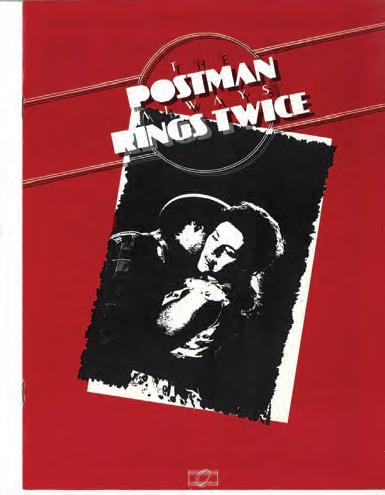
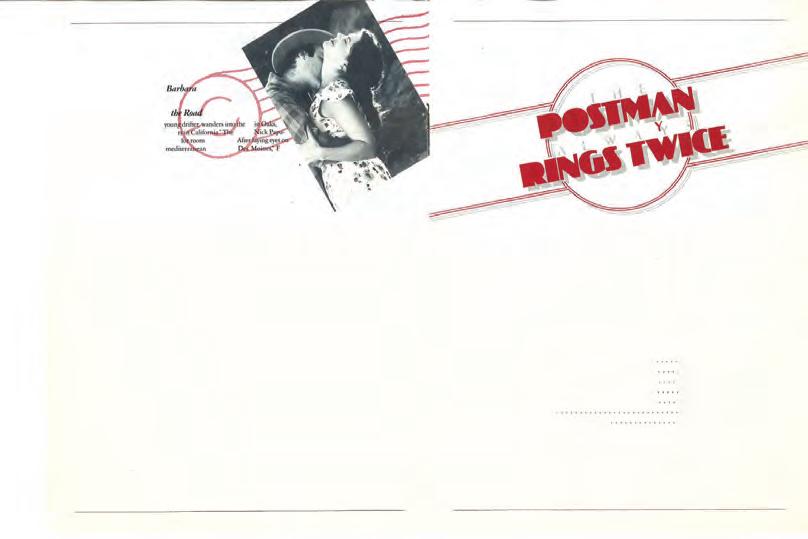
tration. Stephen Wadsworth’s staging, enhanced by Kevin Noteboom’s atmospheric set and Gail Bakkom’s smart mid’30s costumes, emphasized the dark and shabby character of the story. Pamela South (Cora) and Paul Kreider (Frank) were a lusty, convincing pair. Peter Kazaras acted sensitively and made beguiling tenor sounds as Nick.
Presiding in the pit, drawing persuasive, elegant playing from the orchestra, was thirty-four-year-old George Manahan, who on this occasion was initiating what would turn out to be a long and productive relationship with Minnesota Opera. A native of Atlanta with bachelor of music and master of music degrees from the Manhattan School of Music, Manahan, at a relatively young age, was already establishing himself as an important conductor in both opera and the concert hall and a conductor with a special interest in new music. Manahan would be named Minnesota Opera’s principal conductor in 1988.
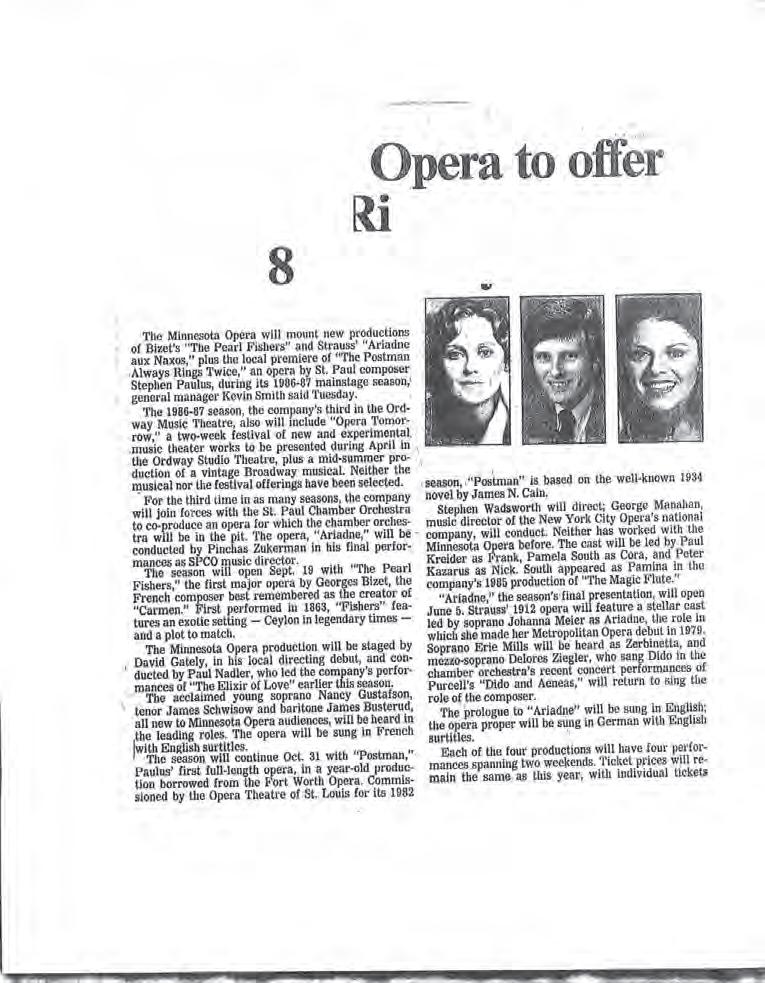
THE TWENTY-FIFTH SEASON achieved a near-consistent level of disappointment and something very close—in a few cases—to inept. Best was the season-opener, Dorothy Danner’s Fledermaus, with soprano Sherri Greenawald as a dramatically impressive and vocally assured Rosalinda. Greenawald, no stranger to this role, gave us a well-defined character, one of those figures from French farce who is always trying to be dignified but for whom life is a street full of banana peels, and she sang on opening night with firm control and warm tone. A few of the small roles were miscast, but tenor Enrico di Giuseppe was a fine Alfred, as narcissistic as Alfred must be; Tracy Dahl, with her peppy manner and bell-like tone, was a perfect Adel; and Janis Hardy managed to make the perpetually bored Orlofsky interesting rather than boring while giving rhythmic bounce to the second-act couplets. Dave Moore, a familiar face from WCCO-TV and an experienced actor, did an amusing turn as Frosch, the inebriated jailer.
Kathy Davis Graves said, “And then the Twins were in the playoffs of the World Series while we’re doing Fledermaus. And these poor people were dragged to the opera, when all they wanted was to be home watching the Twins on TV. People brought transistor radios with them to listen to the game during the opera, and the ushers were running up and down the aisles telling them to turn off their radios.”
The road from Fledermaus to Rigoletto was down a steep hill. The staging in this Rigoletto was sloppy, the sets illconceived, and, at least on opening night, February 5, 1988, the chorus had trouble staying together. Except for a couple of traviatas a few years back, Minnesota Opera had stayed away from the operas of Verdi, which are the bread and butter of most opera companies. The reasons were both ideological and practical. In its earliest form, as Center Opera, the company committed itself to the new and the unusual and to the notion that opera could be thought of as serious theater rather than a low-brow circus act. And since this was a small-budget enterprise, there wasn’t money—or a big enough stage—to mount an Aida or a Don Carlos. In other words, when Center Opera boasted that it was doing “Opera Without Elephants,” it wasn’t kidding. It couldn’t have put elephants onto the Guthrie stage even if it had wanted to— elephants, in most people’s minds, referring to Aida.
As for Anne Ewers’s staging of Rigoletto, there were lapses. The opening scene was a mess—badly blocked, badly conceived. What is supposed to be an elegant party looked
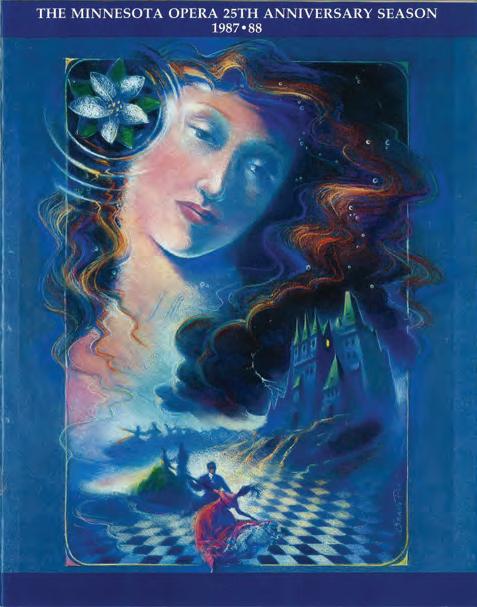
like a weekend orgy in a seventeenth-century frat house, all the action squeezed into Lloyd Evans’s dingy set. One more: Rigoletto spends much of his first-act duet with Gilda standing awkwardly on a staircase. Wouldn’t he naturally move toward her? Undaunted by these lapses, several in the cast put on something of a show to remind us that Rigoletto remains, at least potentially, one of Verdi’s most moving operas.
The Minnesota Opera production of Dvořák’s Rusalka opened at the Ordway April 22, 1988. It was well directed and performed by an able, attractive cast, but plagued with the same problem that dragged down Rigoletto: an ugly set. This poignant tale drawn from the writings of Hans Christian Andersen concerning a water sprite who falls in love with a human prince and becomes human in order to live with him needs a production both poetic and magical, qualities sadly lacking in the dull, abstract sets borrowed from the San Diego Opera, with their all-purpose silver streams and outmoded, upturned disk in the style of the Bayreuth productions of the ’50s. Kirk Bookman’s lighting designs worked wonders, however, and director Nicolas Muni staged the tale with a deft and sensitive hand.
WE HAVE NO EMPIRICAL EVIDENCE for it, but it’s reasonable to think that when a composer knows for whom he or she is writing and understands that performer’s quirks and characteristics, everybody benefits. Mozart often had that advantage, as did Verdi and Cole Porter. And so perhaps the best of the three music-theater pieces that Minnesota Opera’s New Music-Theater Ensemble presented May 20, 1988, at the new Theater Garage benefited from the fact that its creators, composer Brenda Hutchinson and lyricist Theodore Shank, wrote Fly Away All, their one-act opera, with certain singeractors in mind. And they were an experienced, talented bunch: Dan Dressen, George A. Sand, Cynthia Lohman, Janis Hardy, Paul Boesing, and Stephen Kalm. Set in the waiting room of a mental hospital, the piece suggests ideas that are hardly new: psychiatry as coercion, normalcy as conformity. But Hutchinson’s score—evocative electronic sounds mixed with Benjamin Britten–like vocal lines—blended well with Shank’s tensely dramatic text with its surprising and ambiguous ending. The performances were compelling, as was the staging by Shank and Ben Krywosz, the ensemble’s artistic director. The problem with the first piece, Cowboy Lips, was that it was overdirected. The five songs by Richard (Bob) Greene and Gunnar (Bob) Madsen that make up Cowboy Lips were part of the repertoire that these two—the “Bobs,” as they call themselves—perform in concert and have recorded. The problem is the songs resist staging of the elaborate, busy sort that director Ron Peluso forced on them. They’re funny songs: tales of urban anxiety set to a cappella “doo-wop” accompaniment. The humor is in the lyrics and the music; it needs minimal staging. Meredith Monk’s Book of Days, which took up the second half of the evening, was almost the opposite. Its music is more abstract, less specific than in the other two pieces. Its staging could be just about anything. Its music—layers of vocalized rhythmic patterns—is a vessel that needs to be filled. Monk, who staged it herself, evokes ritual and the passage of time—a dance to the music of time. Each singer wears the costume of a specific historical period. Off to the side of the stage, a man dines, watching the dance, then slowly joins it. He becomes history. In what was its first presentation of fully staged works, the New Music-Theater Ensemble made a good impression.
SPEAKING, Minnesota Opera’s twenty-fifth season was a success. Ticket sales jumped, and so did contributions. As a result, the company ended its 1988 fiscal year in the black. In figures released at the annual board meeting June 15, subscription sales for the 1987–88 season rose 38
percent to 3,000. Attendance averaged 92 percent of capacity with a record 60,200 tickets sold for 45 performances. Every performance of Fledermaus and Rigoletto sold out. In addition, 62,000 people of all ages saw the company’s touring and educational activities during the season, a 21 percent increase over the preceding year. Grants and contributions amounted to $1,275,000, an 18 percent increase over fiscal 1987. In addition, the board elected Robert M. Howard board chairman, replacing Barbara Tiede. A final announcement was that Paul Parker, who had been a significant force in the company’s financial recovery, would retire as board president July 1 and would become vice chairperson, a new title. Still more positive figures were revealed in August with the final performances at the Ordway of Rodgers and Hammerstein’s Oklahoma!, which played to more than 50,000 people in thirtyfour performances. Seven more had been added to accommodate the demand for tickets. All three of the summer musicals—The King and I in 1986 and South Pacific in 1987—had been box-office bonanzas for the company. According to Kevin Smith, revenue from the summer musicals equaled that of all the company’s other productions combined.
MINNESOTA OPERA TOOK A DEEP DIVE into its second quarter century and came up for air at the Ordway on October 21, 1988, offering a distinguished, thoughtful production of Mozart’s Don Giovanni in not just one but two versions. Take your pick. Mozart, in fact, wrote two versions of the opera. Audiences in Prague were the first to see Don Giovanni on October 29, 1787. Prior to the second production, which was to open in Vienna seven months later, Mozart had to keep peace with his singers, who were making demands and asking for changes. The tenor, for one, couldn’t handle the technical demands of “Il mio tesoro”—too many notes—and asked for something easier. There were other changes—small ones. The difference between the two, one seen at the Ordway each weekend, is more a matter of pacing than anything else. Vienna got Elvira’s impressive “Mi tradi” and the less impressive Leporello-Zerlina duet in act two, a number best left out of any production. This was an interesting idea, but there can have been only a handful of people who coughed up enough money to see both productions. Nicholas Muni, who staged both—Vienna was seen on opening night—came up with a production more conventional than the one Wesley Balk staged for this company in the mid-’70s, which was


full of conspiracies against the Don, who in this case was a free-spirited rebel taunting the squares who were all about repression and conformity. Even so, Muni’s production was perhaps more striking, more carefully detailed, both funnier and more chilling. And Muni avoided cliches at every turn.
The Don’s "Champagne Aria," usually an exercise in forced levity—and a big yawn—was instead an expression of menace and calculation. As he sings, the Don walks slowly downstage plotting his seduction of Zerlina. Most Don Giovannis, even the great ones of recent decades—Pinza, Siepi, Milnes—play him as coltish and earthy, a Spanish Zorba the Greek. William Schimell’s Don was cool, cerebral, smooth, conniving, and, as most singers forget, very much an aristocrat. Schimell sang elegantly, with force, where needed, and with flowing legato in “Là ci darem la mano.” As Don Ottavio, Mark Thomsen sang beautifully and played the role with winning sincerity. Without doubt, Don Giovanni was a strong curtain-raiser for the company’s twenty-sixth season. But more was yet to come. In January the company offered an intriguing production of Richard Strauss’s Salome. The soprano Julia Migenes gave a riveting performance in the title role of the teenage princess of Judea who develops a perverse romance with John the Baptist and ultimately makes love to his severed head during the famous Dance of the Seven Veils.
Migenes at that time was a star of some magnitude. Her Carmen opposite Placido Domingo in the 1984 film version of Carmen had been widely praised. The question was whether this svelte, attractive lyric soprano could meet the prodigious vocal demands of a role associated with Wagnerian sopranos such as Birgit Nilsson and Hildegard Behrens. The answer, delivered on the Ordway stage the night of January 29, 1989, was yes, most of the time. The voice was certainly big enough to soar over the orchestra—and capable of rising to a drunken frenzy in the final moments. To be sure, there were passages where the voice needed more amplitude, but the singing never sounded thin or forced, and dramatically, it couldn’t have been more compelling. Clearly, this was a princess aware of her royalty and allure.
The elements of awakening sensuality and potential derangement lingered beneath the surface, and the great final scene of the opera, with Salome rolling on the floor of the palace, conveyed just the right aura of depravity and moral despair that Strauss had in mind. The Dance, too, was effective, an improvisatory mix of libido and camp in which Salome’s mind, as well as her clothing, starts to unravel. Richard Cowan was an impressive Jokanaan (John the Baptist), a burly figure full of moral fervor and grim rectitude. The brief hint, as Salome attempts to seduce him, that
he might give in and that Jokanaan himself is engaged in a moral struggle was a novel touch that added depth to a one-dimensional character. Staged by the film director Peter Medak (Migenes’s husband at that time), with sets by Richard MacDonald and costumes by MacDonald and Ruth Myers, this was a Salome both stylish and dramatically telling. Making his operatic debut, Medak showed a sense of dramatic economy and just the right amount of dramatic flair.
BY THE LATE ’80s it was common for directors such as Jonathan Miller and Peter Sellars to take a revisionist approach to The Mikado, Gilbert and Sullivan’s most popular operetta, altering the setting, updating it, adding gags, and imposing a heavy “concept.” Colin Graham’s staging for Minnesota Opera, which opened April 21, 1989, at the Ordway Music Theater, a reworking of his 1985 production for the Opera Theater of St. Louis, was more traditional, and it made for an enjoyable evening. The look of the show was Kabuki, the traditional music theater of Japan, with gorgeous
costumes and minimalist but evocative sets by Jay Ferger and Andrew Marley enhanced with sensitive lighting by Peter Kaczorowski. The Kabuki element served to strengthen the basic joke of The Mikado, which is that we’re supposed to be in Japan, but we’re really in Victorian England, and our characters are very, very British. Graham’s people are amusing, sweet, or sincere, as needed, but there wasn’t among them that one great comic personality, whether it be Ko-Ko or Pooh-Bah or the Mikado himself, that makes a Gilbert and Sullivan show take off. Three of them came close. Jon Whittier’s Ko-Ko was the frantic little guy who’s always one step ahead of the law. He looked like a cockney Martin Short in Japanese drag, while Marietta Simpson, as Katisha, might have been an Asian Wicked Witch of the North, hitting just the right sad, almost tragic note in “Alone, and Yet Alive.” James McKeel was good, too, as Pooh-Bah, the prototype of the corrupt politician. Conductor Stephen Lord’s sleepypaced overture boded ill, but things picked up thereafter, remaining buoyant and bubbly till the end.
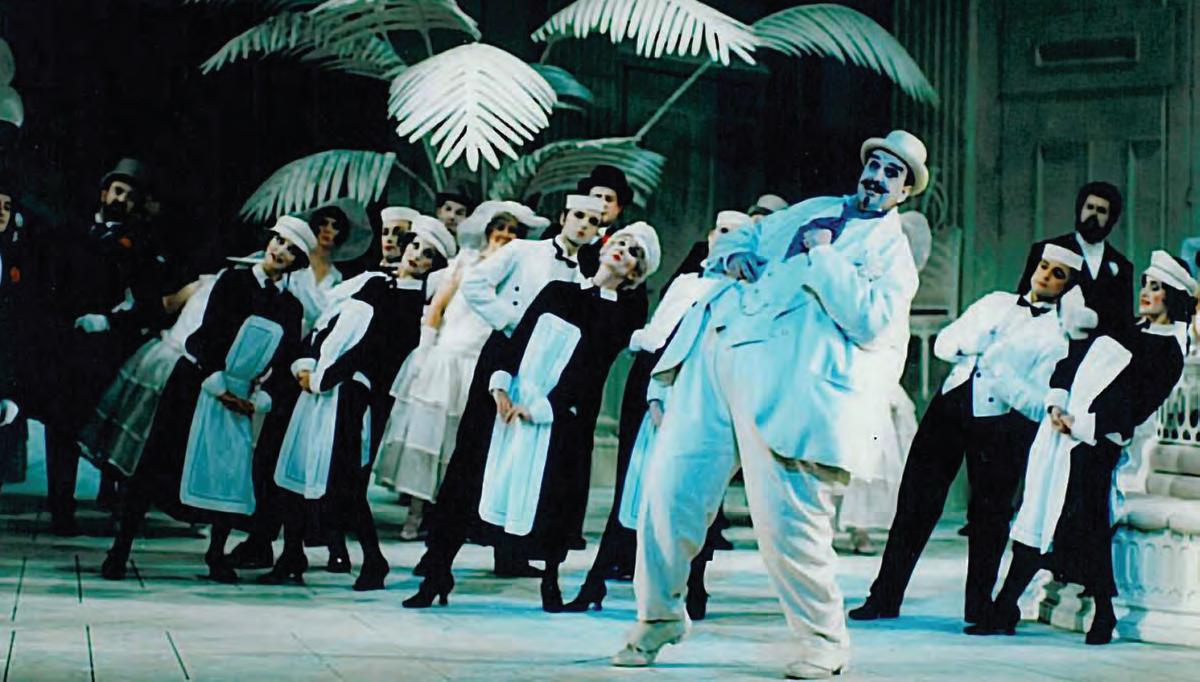
BY THE SPRING OF 1989, Minnesota Opera had commissioned nineteen new operas and given the world or American premieres of thirty-two operas. Given this history, it perhaps wasn’t a surprise that the company’s New Music-Theater Ensemble added three more commissioned new works to the list in a series of performances at the Minneapolis Theater Garage starting March 24, 1989. The ensemble’s artistic director Ben Krywosz said in a program note that he thought of the ensemble as a “living laboratory” in which composers, librettists, and performers could collaborate and create new works and explore new techniques, with the singer-actor as the chief source of creative energy, an idea long espoused by Wesley Balk, Krywosz’s mentor and the ensemble’s director of performer development.
The ensemble format, an echo of the company’s first decade, was short-lived, and not many of the works performed seemed destined for immortality. In fact, of the program at the Theater Garage, it could be said that the performers were more interesting than the works they performed, though in the case of The Newest Little Opera in the World, an improvised opera, the performers and their imaginations were the content of the show. When Balk devised this idea in the mid-’70s, using an onstage wheel to select the variables, the focus was on different musical styles. The attempt in this later version was to build scenes out of words contributed by audience members. Some of the scenes worked; some didn’t. The highlight was a manic ’40s-style swing number. Gregory Thiesen was the adroit accompanist.
Maria Jette, soprano, recalled the production:
Audience members would write words on bits of paper and put them in boxes, one box for characters (novelist, pig farmer), one for situation, and one for setting (Mars, a bunker). Six singers would be characters and the other four would be the chorus. Each of the character singers would pull a word out of the boxes and improvise a little aria on it. Then they would disperse into the wings and someone would start the opera. Janis and Jim were masters at this. I was new enough as a theatrical performer that I felt constrained by feelings of right versus wrong. I’ve often wished I could try it again, now that I don’t care about anything.
One of the other works, Without Colors—music by Melissa Shiflett, text by Mac Wellman—was based on a story of the same name by the Italian writer Italo Calvino set in a prehistoric world without atmosphere—hence, without colors—in which a young man, Qfwfq, fancies a young woman named
Ayl. (This world is also somewhat short of vowels.) Shiflett’s music is pretty but undramatic, rather in the mode of New Age background music.
Kim D. Sherman, on the other hand, for Red Tide, contributed music in a quasi-Broadway style that was both dramatic and involving. Handicapped by Paul Selig’s dreary text, Red Tide concerns a teenager searching a sandy beach for a lifeguard who once saved his life. An angel-of-death figure finally lures him into the algae-infested water—and not a moment too soon, in the view of at least one audience member.
THE COMPANY’S TWENTY-SIXTH SEASON ended at the World Theater in downtown St. Paul with Philip Glass’s intriguing opera The Juniper Tree, given a mostly fine staging by Ben Krywosz and featuring a strong cast. Glass composed only three of the opera’s six scenes; Robert Moran, director of the New Music Ensemble of the San Francisco Conservatory, composed the other three. The result, with a libretto by Arthur Yorinks, was not nearly so disjointed as one might expect. Glass’s trademark devices—whirling arpeggios, unrelenting rhythms, and slowly shifting harmonies—blended easily with Moran’s more traditional, more lyrical style. Dramatic tension was sustained effectively, as were the gentler moments. Instead of underscoring each subtle shift in the text—the usual approach in opera composition—the music etches the general tone of a scene, gradually intensifying it and infusing the whole score with a feeling of wonderment, all appropriate to an opera based on a fairy tale by the Brothers Grimm. And this is one of the grimmer tales.
As the psychiatrist Bruno Bettelhneim pointed out in his influential book The Uses of Enchantment, the original folk tales the Grimms published in the early nineteenth century were more violent—more terrifying—than the children’s literature of today. There’s nothing cute and perky in The Juniper Tree. Not only does the wicked stepmother cut her son’s head off, she cuts the boy up and, in an echo of Greek myth, feeds him to her husband, the boy’s father. The boy, transformed into a bird and out for revenge, flies over the stepmother and drops a millstone on her, killing her. Father, son, and daughter live happily ever after. These are not easy scenes to stage. Krywosz deftly balanced the reality of the story within the fantasy, and his designer, Victoria Petrovich, created a kind of visual analogue to the precise geometry of Glass’s music; panels moved on- and off-stage, the action unfolding in a series of square frames, one inside the other. The stylized beauty and symmetry of the production were carried through in Vicki Blake’s shimmering choreography.
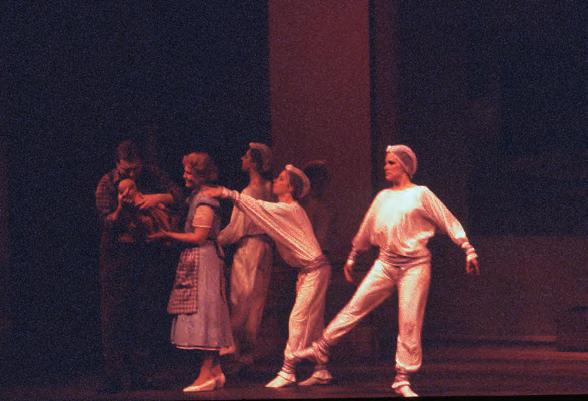





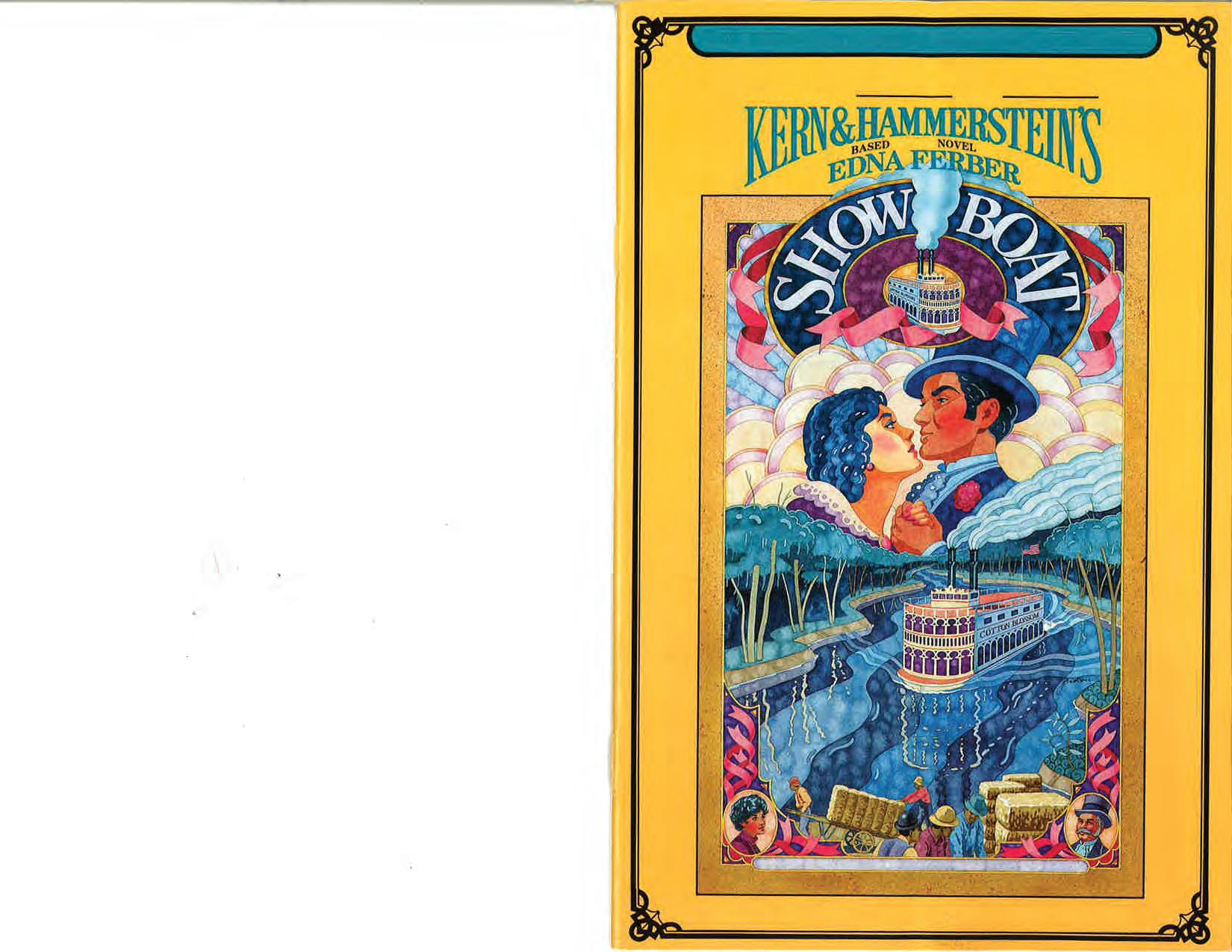
The Juniper Tree was presented in four performances over just one weekend, a rather short run in a small theater, given Glass’s fame. According to reports, the company was worried that an avant-garde opera like The Juniper Tree wouldn’t sell. In fact, all four performances were sold out.
THE COMPANY’S SUMMER MUSICAL, Show Boat, which played four sold-out weeks at the Ordway in July, was an even bigger hit than The Juniper Tree. According to Bob Lundegaard of the Star Tribune, “The voices were glorious, the costumes were gorgeous, and the production lavish. If an opera company insists on doing musicals, this is the way to do it.”
After another successful run of Broadway musicals the following summer, My Fair Lady and Carousel in 1992, the company stopped producing musicals. Some were puzzled by this and said that perhaps the company didn’t know what to do with all the income the musicals produced. (Kevin Smith corrected that notion. The company will break even on shows like Oklahoma!, he said, but they’re nothing like a bonanza.) More likely, it was that the Ordway began to produce its own musicals and started bringing in touring shows, which pushed Minnesota Opera’s efforts aside. Another reason was that the company, after considerable soul-searching, revamped and rearticulated its image and its mission. But that’s a story for the next chapter.

Season Twenty-Seven Season Twenty-Eight Season Twenty-Nine Season Thirty Season Thirty-One Season Thirty-Two Season Thirty-Three Season Thirty-Four Season Thirty-Five Season Thirty-Six
“BASICALLY, WHAT THE ORDWAY DID was kick us out for the summer.” Kevin Smith, the former rock ’n’ roll songwriter who was named Minnesota Opera’s general director in 1987 and president and general director two years later, was explaining how it was that the company stopped presenting Broadway musicals at the Ordway in the summer. Starting with The King and I in 1986, then in successive years, South Pacific, Oklahoma!, Show Boat, and My Fair Lady, these shows had been money-makers. Each of them, in fact, over the course of a four-week run, routinely sold more tickets than all the company’s opera presentations combined. The musicals made sense right from the start, given that the Ordway wasn’t scheduled in the summer. And conceptually the musicals gave a coherence to a programming scheme put together by former general director Ed Corn, a three-legged stool, as some described it: traditional grand opera at the Ordway in the autumn, experimental and new works in the spring at the smaller McKnight Theater (and other venues), followed by Broadway musicals in the summer. The company’s touring arm, Midwest Opera Theater, though its days were numbered, added a fourth leg to the stool.
That plan worked reasonably well for a half decade until the Ordway and its enterprising new president, Bill Connor, decided they could make more money putting on their own shows instead of copresenting them with Minnesota Opera. And right about that time, a number of big Broadway shows began to tour, and the Ordway, though it had fewer seats than comparable venues around the country, including two in downtown Minneapolis, hoped to book as many of these shows as possible, which is why Minnesota Opera got pushed out and ended up producing just one more musical, in 1992, a production of Carousel at the newly remodeled State Theater in Minneapolis. In hindsight, it is possible to see the company’s move to the State as a foreshadowing of the future of large-scale commercial theater activity in the Twin Cities. Many of the big touring shows would eventually abandon the Ordway for the State and the Orpheum, both on Hennepin Avenue. They had more seats than the Ordway, and more tickets could be sold.
“The other problem for us,” Kevin said, “was that we were running out of Rodgers and Hammerstein shows to do, and we were starting to see our sales drop and our costs go up, and so it was probably a good thing for us that the Ordway went ahead and took over the summer and we got out of the musical business.”
“The three-pronged model was sort of a marriage of convenience,” said Dan Berg, who was the company’s director of development for twelve years starting in 1985. “With the commitment to new work we were keeping a tenuous connection with the old Center Opera crowd, who still had influence in the company. At the same time we were trying to earn the love of the standard-opera fans with the operas in the autumn, and we were also trying to make money with the summer musicals, and that whole thing worked for several years.”
Berg thinks the company might have stopped producing musicals even if the Ordway hadn’t taken over the territory. “I think people like Dale Johnson didn’t value the summer musical in an artistic sense,” he said. “It was a financial tool, and they tried to opera-fy it, doing it without mics and trying to rationalize why an opera company should be doing this. But I think the reality was that when the Ordway started bringing in touring productions, Minnesota Opera frankly couldn’t compete.”
And then in 1988, the three-legged stool lost another leg. Joan Dornemann, who had been named music director in the autumn of 1986, was let go, as Kevin Smith decided not to renew her contract. As some saw it, the appointment never made sense. She continued as vocal coach and prompter at the Metropolitan Opera and flew to the Twin Cities as needed for auditions and repertoire meetings. Her taste was decidedly conservative. She said in an interview when she arrived in the Twin Cities that Minnesota Opera’s 1986–87 season—The Pearl Fishers, The Postman Always Rings Twice, and Ariadne auf Naxos—was too unconventional.
It became evident that the three-part season, which had seemed a good idea in the late-1980s, needed to be reconsidered. Said Kevin, “We soon figured out that instead of making the season work for everybody, it wasn’t working very well for anybody—it was confusing the public—and we should start focusing more. The other thing we learned through some research was that our audience didn’t want the operas so close together. We started out with all three operas in the fall and then slowly started adjusting that. We moved one to January and another into spring, and it finally started working. The audience began to grow. And we were also putting on better productions.”
A think tank, created informally around the water cooler— Kevin, Kathy Graves, Dan Berg, Dale Johnson, Ben Krywosz— probed the key question: what is this company with its counterculture beginnings, its motley history and wavering ideals, its lugubrious failures and unscheduled triumphs? What child is this anyway? People kept saying the company
had lost its direction. Dan Berg, for example, said, “I can hear Sandy Bemis saying, ‘We’ve tried this long enough. The Met’s gone and they’re not coming back. We can put together a stronger board with [former board president] Paul Parker’s help, and we need to admit that we’re an opera company, dammit.’ To a certain extent the company had been in denial for decades about wearing that mantle.”
Not everyone applauded this particular path to the future. Ben Krywosz, artistic director of the company’s New Music-Theater Ensemble, argued that the company should instead become an expanded version of what it already was, not merely an opera company, but, as he described it, “a full-spectrum music theater organization that does many kinds of music theater, including opera, for many different audiences.” The company should think of itself, not as a buggy whip manufacturer, but as a maker of transportation accessories, Krywosz said. If the demand for buggy whips— opera, that is—dried up, the company could continue doing a brisk trade in the newer travel devices, meaning new forms of music theater. Opera in the European tradition—the standard repertoire—is a dead end, Krywosz argued. Drawing on one of his favorite metaphors, he likened the American opera world to the second-to-the-last page of La traviata, wherein our heroine, Violetta, rallies briefly before she dies. “She’s been sick, she’s in pretty bad shape, but now she’s reviving. She feels great. She’s thrilled. She stands up and says, ‘I’m OK now.’ Then you turn the page, and she collapses and dies.” Opera based on the European model, in other words, has had a short-lived restoration of vitality thanks to generous arts funding and aggressive promotion. But traditional European opera lacks the natural connection to American culture that the Broadway musical and other popular forms have, and so, like poor Violetta, it will die.
Krywosz’s view didn’t prevail, though his New MusicTheater Ensemble continued to explore new varieties of music theater and in just a few years would split off from Minnesota Opera and continue on its own as Nautilus Music-Theater. What Krywosz envisioned for Minnesota Opera, a direction that resembled the company’s earliest experimental efforts as Center Opera, was not what the management and board of Minnesota Opera wanted, which was to fill the void left when the Metropolitan Opera stopped touring. That became clear in 1986, the year the tour ended. The question was: what, if anything, should replace the Met? To explore that question, the local liaison, Metropolitan Opera in the Upper Midwest, brought in Schuyler Chapin, the company’s former general manager, for advice. They looked at the possibility of bring-
ing in other companies—the Chicago Lyric, the San Francisco Opera, the New York City Opera—and concluded that touring was no longer an option. It had become too expensive, which was one of the reasons the Met stopped. The unanimous conclusion was “invest in your own company.”
“At that point,” said Kevin Smith, “that’s when we reinvented ourselves. We reinvented the board. We did a governance review in ’89. We had just raised money. Sandy Bemis and Paul Parker had cochaired a campaign to do the Opera Center. We did a $5 million campaign. We ended up doing the center for just $3 million. And we retired our debt with most of the remaining money.”
For the governance review, Smith and the board remembered Ed Corn’s criticism a few years earlier: the board was too large and too unwieldy. “At the time we had forty voting members and forty of what we called associates,” Kevin said. “We brought that down to a single board of thirty. I met with every one of these people. Everybody understood the problem. There were some disappointed people, but no one was angry. They realized it had to be done. And that’s when people like Ken Dayton and Tom McBurney, people who populated the boards of other major arts organizations, joined our board. Then, all of a sudden, although we weren’t really big, we had power and focus. That was a big turning point for Minnesota Opera.”
Paul Parker, retired executive at General Mills, was named president of the board in late 1985. “The company did not have a first-class board of directors,” said Dan Berg. “Paul was supposed to draw a blue-chip board to the company. He knew nothing about opera, but he had gray hair and good connections in the corporate world and a Minneapolis Club membership. The perception was that he could open doors that Kevin couldn’t. Even so, the company never achieved the level of governance that the other major arts organizations had.”
MINNESOTA OPERA OPENED its twenty-seventh season on October 13, 1989, with a production of La bohème and a new face in view, or, more accurately, a new view of the back of that person’s head. Presiding in the orchestra pit at the Ordway was George Manahan, the company’s new principal conductor, a position he would hold until 1996. Though just thirty-seven, Manahan had forged a significant career in both opera and the concert hall, and his interests were wide-ranging, especially in the area of new music. During his tenure as music director of the Richmond Symphony, the orchestra received five ASCAP awards for “Adventurous
Programming of Contemporary Music.” Manahan made his Minnesota Opera debut in 1986 conducting the premiere performances of The Postman Always Rings Twice by Stephen Paulus. Manahan got on well with the musicians here, and the orchestra’s sound and cohesion improved markedly during his time with the company. His conducting of bohème proceeded with flow and grace, showing a flair for Puccini’s emotive idiom.
The production—thoughtful in most regards and well cast—came from the Welsh National Opera. Director Rennie Wright and designer Michael Yeargan aimed at a small-scale, detailed depiction of Parisian poverty among the young Bohemians. Puccini’s most realistic opera works best with this kind of attentive eye and doesn’t lend itself to heavy psychological concepts. The production’s only flaw was Yeargan’s set—or lack of it—for act two. When the curtain went up, it looked as if the set hadn’t been rolled out yet. Where was the Café Momus? What we saw in unattractive lighting was a large ugly canopy and a few tables for what is supposed to be a festive Christmas Eve in the Latin Quarter. Where was the party? For his part, Wright did well, avoiding cliches, moving his singers about the stage sensibly but dramatically, allowing characters and relationships to develop.
ONE OF THE MOST FABLED productions of Minnesota Opera’s first decade was Britten’s A Midsummer Night’s Dream, which focused chiefly on Robert Israel’s ingenious design. To convey the look of the enchanted forest that is the home of Tytania, Oberon, Puck, and the rest, Israel had air-filled plastic pillows floating slowly over and gently piling up on the side of the stage. The pillows were sprayed with a detergent that under ultraviolet light glowed in the dark. Israel described the setting as a “dreamscape.” “I wanted everything to look as if it could disappear in an instant,” he said some years later. Israel’s work shows what a brilliant designer can do on a tiny budget.
Did anyone think of reviving Israel’s imaginative concept? What a loss. Maybe it wouldn’t have worked at the Ordway. As it was, the new production, in a staging by Albert Takazauckas, which opened at the Ordway January 26, 1990, went in a different—and quite interesting—direction. Rather than the usual fairy kingdom with twinkling lights and gossamer nymphs, this was a hideous, distorted world in which huge tree trunks—and all of nature—are bent out of shape due to the quarrel between Oberon and Tytania, king and queen of the fairies. A “progeny of evils” had entered the world. Oberon, usually played as vain or simply frivolous, was
here more than a manipulator. He’s menacing. He’s the evil figure in dreams. It was as though nature’s return to normalcy in the final act was a thwarting of Oberon’s plans rather than a fulfilling of them.
Takazauckas nicely contrasted the three worlds the characters inhabit. He gave the four mismatched lovers an unusual dimension of physicality and vigorous horseplay that served to emphasize the fragility of human life. His “rustics,” on the other hand, were less broadly played than is customary. They’re real people trying to put on a play as best they can, and the play they put on in the third act was truly funny with all the usual schtick and then some. Rodney Hardesty, no stranger to the role of Oberon, gave the character an air of glacial meanness. His countertenor had great clarity in the upper register on opening night. Kathryn Gamboroni made an effective Tytania, playing her as an overly pampered ditz. Conductor George Manahan coaxed both virtuosity and chamber-music transparency from the orchestra, rendering Britten’s imaginative effects in delicate but bold colors.
Minnesota Opera’s third production of the season, given in five performances at the Ordway starting April 20, 1990, turned out to be a weak staging of Gounod’s Romeo et Juliet. Writing in the Star Tribune, Mike Steele took note of Michael Anania’s “relentlessly wrong-headed” design, which included a “giant beached whale of a set,” and he found director Leon Major’s notion of having a modern-day rehearsal take place during the Prologue and having our two star-crossed lovers already dead at the start of the opera to be unwieldy and far-fetched.

The event of the season was the premiere of Libby Larsen’s multimedia opera Frankenstein, or the Modern Prometheus, first seen at the World Theater in three performances starting May 25, 1990. The work—Larsen’s seventh opera and Minnesota Opera’s thirty-second premiere—was generally well-received by critics— USA Today named it one of the most important classical music events of 1990—and the capacity audiences responded to the opera enthusiastically each night. Larsen, who wrote her own libretto, adhered closely to the novel by Mary Shelley on which the opera is based. It is a different story than is to be found in the dozens of dramatizations, including the most famous, the 1931 James Whale film with Boris Karloff playing the Creature. Shelley and Larsen portray the Creature as intelligent and articulate, an innocent being who becomes dangerous only when he is rejected by his maker, Victor Frankenstein, who runs away from him. What the Creature seeks is companionship—and ultimately, love— first from his creator and then from the others he encounters, all of whom, except an old blind man he spends time with, are repulsed by him because of his hideous appearance. The opera underscores Victor’s arrogance and his heedless ambition. It sees his—and our—faith in progress and technology as problematic. These are hardly new themes, but they remain relevant and in their own way were much in the air at the time Mary Shelley’s book was published, in 1820, when the use of alchemy and electricity to create life was much discussed and when the church was vehemently opposed to experiments that tampered with religious doctrine.
Talking about the opera in an interview in Minneapolis in the summer of 2021, Larsen stressed that she’s not antitechnology, as seems to be the thrust of most of the dramatizations of the Frankenstein story. (“This time, Doctor, science has gone too far!”) She’s not a Luddite, she said, nor does she oppose advanced medical procedures such as stem cell research. “I’m actually quite excited about technology,” she said. “But I’m not so excited about mankind dealing with technology. We move too fast. Our brains are much faster than what we’re able to deal with.”
1989–1990 Minnesota Opera season program, courtesy Minnesota Opera Archives
Larsen grew up thinking—and talking—about such matters. Born in Wilmington, Delaware, and raised in Minneapolis, she is the third of five daughters of Robert Larsen, who was head of research at Pillsbury. As a result, Larsen’s childhood dinner-table discussions were about putting chemicals in food and genetically altered plants. “But then,” she said, “my dad got into computers and re-tooled himself, and so our dinner table conversation switched from altering food to artificial intelligence. And I was getting upset because no

one was thinking about the consequences of this because my dad’s generation was enamored with the word ‘progress.’ Then at the dinner table we’d say, ‘But what happens when you put all those chemicals in the food?’ And he would say, ‘Well, that’s the problem your generation’s going to have to deal with.’ Then he’d say, ‘Progress is what this country was built on.’ I’d say, ‘But what are the consequences of that?’ So that’s what Frankenstein meant to me. I saw it as completely topical.”
She had picked up the annotated Frankenstein while browsing in a bookstore in Washington, DC, when she was serving on the National Endowment for the Arts new music/ new opera panel. She had read Mary Shelley’s book before, but rereading it gave her a jolt. “I’ve been wondering why the book hit me so hard,” she said. “This was 1986, maybe ’88. I just knew I wanted to do an opera on Frankenstein.”


Larsen’s aim, an obsession that not everyone seemed to grasp, was to present Mary Shelley’s book on the stage as an opera, which had never been done before. Larsen thinks the book, despite all the adaptations, is underappreciated. “Mary Shelley was a genius,” Larsen said. “I think her book will be more appreciated as the culture learns to appreciate a feminine perspective.”
If Mary Shelley’s book was ahead of its time, the production of the opera, as far as technical aspects, was definitely advanced. The use of live and recorded video projection wasn’t new in the theater world of 1990, but opera production, especially in the United States, lagged behind in such matters. For the production at the World Theater, video monitors were hung on each side of the theater relaying closeups of the action on stage. At the back of the stage was a larger video screen, showing what was taking place off-
stage or in the imagination of the characters. We never hear the Creature speak, but—in perhaps the production’s most intriguing touch—we see on the video screen what he sees, often blurred or upside-down, an idea that has since been used repeatedly in the Alien and Terminator movies, among others. Christian Swenson’s Creature—chalky-white, shaved head, dressed in what looked like swaddling clothes—was a cool menace, moving quickly on and offstage. Steven Tharp’s Frankenstein was less a mad scientist than a troubled intellectual. Tom Schumacher was Victor, his alter-ego. Both sang with skill and intensity, and Elisabeth Comeaux, playing Elizabeth, one of the Creature’s victims, sang beautifully.
The score skillfully blended electronically synthesized sounds with the acoustic accents of a fifteen-piece orchestra, ably conducted by Dale Johnson. Jazz and rock elements can be heard in a variety of ensemble numbers, including trios and quartets. Larsen sets words expressively so that they can be clearly understood, and her scenes have a natural and dramatic flow. An important point for her was that the multimedia aspects of the production and the sound mix weren’t simply add-ons, aspects of production separate from the work itself, which is often the case. They were integral to the work. “It’s the whole opera,” Larsen said. She continued:
I wanted the video screens so we could see the world from the monster’s point of view. So you had the proscenium perspective, which distances you, and the video perspective, which is you. Multimedia was still rare back in 1990, though rock concerts were doing it. Kevin and I actually wondered: could we put this in a stadium? By now we’re used to it, the close-up and the long shot. Think how far audiences have come in the integration of perspectives. The production team on this, especially Terry Simpson, was just spectacular. I was also interested in the revolution in sound that has taken place in our lifetime. And I was thinking that if we’re going to get through to opera audiences, we’ve got to meet them where—and how—they hear. Everywhere they go, people are hearing mixed sound, whether they know it or not. It’s very hard these days to hear pristine sound— acoustic sound.
Again, Frankenstein was ahead of its time. It is common now for sound designers and engineers for Broadway shows and various musical presentations, including opera, to mix sound as if an audience member is hearing the show on earphones. That was the goal in Frankenstein
Among the stories that have circulated about this premiere production of Frankenstein is the one concerning the electrocution of Steven Tharp during a rehearsal. We should simply let Larsen tell the story:
It was tech week, and the design was set up for the awakening of the monster, who was suspended above the stage, and there was this beautiful vitrine being slowly lowered, and the smoke was smoking and the lights were blinking and the electricity was going “zzzzz.” Steve leaned over and grabbed one of the ropes and started to scream. He was being electrocuted because the hook-up was wrong. And Nick Muni, who was sitting in the audience—I still don’t know how he did this—ran across the top of the seats in front of him and jumped onstage and body-blocked Steven. Otherwise he would have been dead. There was electricity hooked up to the lowering of the vitrine and the lighting of the vitrine, and somehow the AC-DC of the poles got switched. Steven was taken to the hospital, and they kept him overnight. And we all thought, “Well, that’s it. The show is toast.” But he came back the following day, pretty shaken up, and he performed all the shows.
Elisabeth Comeaux, who played Elizabeth, Victor Frankenstein’s fiancé, recalled: “I was offstage. We heard a lot of shouting. It was terrifying. And Kevin Smith, true servant leader that he is, came to us afterward and talked about what we were feeling and how we felt about continuing the show. He sat down with each one of us, and we all agreed that with safety procedures in place we could do it. Kevin is absolutely the best.”
Frankenstein is gradually finding a new audience. The University of Miami did scenes from it in 2011, and West Edge Opera in California did a full production in 2020. “They had the monster vogueing and twerking—very stylized dancing,” Larsen said. “Some people just loved it and others hated it, which made me very happy.”
IN THE OPERA WORLD, bad luck is always lurking around the corner prepared to pounce. Minnesota Opera had engaged the Italian soprano Maria Dragoni to sing the demanding title role in Bellini’s Norma for the season-opener. Ten days before rehearsals were to begin, Ms. Dragoni’s agent called
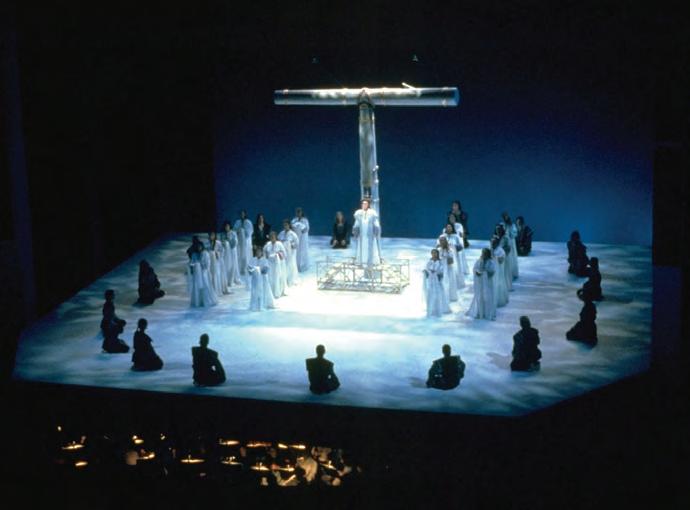
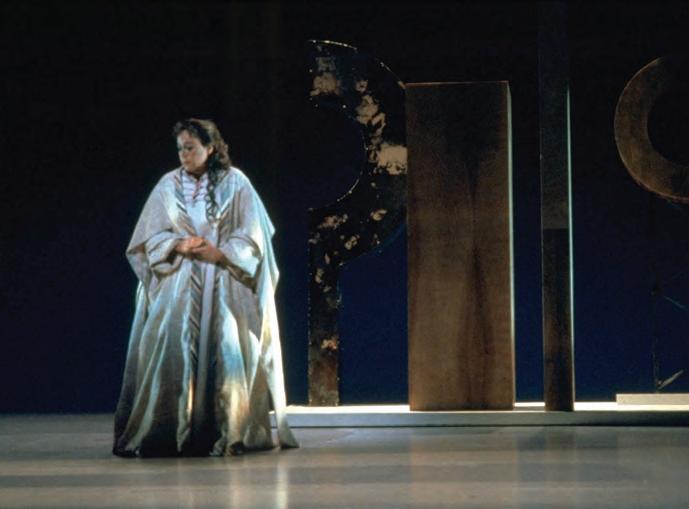
to say that the soprano would have to cancel because of an ear infection. Singers of Norma caliber are usually booked at least two years in advance, so this was a real problem. Neither Kevin Smith nor Dale Johnson wanted to cancel the production, so both practically lived in their phones the next few days, and they managed to engage the Irish soprano Suzanne Murphy. Mezzo Emily Manhart, who sang the role of Adalgisa, delivered “her part in real phrases, each a full musical thought,” according to Pioneer Press critic Michael Fleming. The second instance of singers canceling was for a production of Stravinsky’s The Rake’s Progress. It had been planned for January 1991, but two of the principals asked to be let out of their contract, having gotten better offers. This may have been good luck, because the substitute was a worthy one, Dominick Argento’s The Aspern Papers
PARAPHRASING HAROLD ARLEN AND JOHNNY MERCER , we might say that “Any place I hang my spear is home.” Minnesota Opera secured a home to perform in in 1985, and that place, the Ordway Music Theater, had worked out reasonably well. And now, as of November 11, 1990, the company had a home where it could do everything else it needed to do: build sets and props in a scene shop thirty-five-feet high, sew costumes, hold conferences and meetings, provide sufficient office space for staff and administration and—at last!—allow the company to rehearse the next show with ample room for
chorus singers and an orchestra. The previous arrangement had become untenable. Administrative offices were in Park Square Court in downtown St. Paul; the costume shop and storage could be found in a building on Chicago Avenue in Minneapolis; and the scene shop was in south Minneapolis. The new facility, to be named the Minnesota Opera Center, was housed in a trio of rehabilitated buildings on North First Street near the Minneapolis riverfront, part of the old Itasca Warehouse, put up in 1886. The buildings, originally five- and six-story structures, had been abandoned, gutted by fire, and some of the upper stories had been razed. Chuck Leer, a Minneapolis real estate developer, knew that Minnesota Opera was looking for office and rehearsal space, and so he asked Kevin Smith and Kathy Davis Graves to take a look at the warehouse buildings on North First Street, which Leer thought had great potential for what Minnesota Opera needed.
Kathy Davis Graves, marketing and public relations director, said of Leer’s involvement: “Chuck Leer was hugely instrumental in the development of the Opera Center. He took us to see this property, and it was a burned-out shell and a hole in the ground. I’m like, ‘You’ve got to be kidding me.’ There was pigeon poop everywhere. But Chuck’s vision was really big. He was so creative about this, and he came at a pivotal time.”
Eventually, Leer’s vision prevailed, and then it was a matter of raising the money. Funds for acquisition and renovation were financed by a capital campaign headed by Sandy Bemis

Opera Center Grand Opening, 1990, courtesy Minnesota Opera Archives
that soon raised $5 million. The new facility sat next door to the Guthrie Lab, which eventually became the Lab Theater, a popular performance space for theater, music, and dance under the management of Mary Kelley Leer, Chuck’s wife. The Opera Center was dedicated November 11, 1990. In 2019, the Leers sold the Lab Theater to Minnesota Opera, which renovated the space and renamed it the Luminary Arts Center. Roxy Stouffer-Cruz, company manager, spoke about the impact of the Opera Center:
Before the Opera Center, rehearsals were sometimes held in the Ordway Drake Room, but often in the opera scene shop, which was on Currie Avenue in Minneapolis (the main room of the Salvation Army Building), very close to the bus depot. The costume shop was also there for a while. Mind you, this was the pre-Internet age, and no one had cell phones. If I or anyone else needed to communicate with stage management, artists or anyone in production, we had to take two or three hours out of the day, get into the car, drive to Minneapolis and take care of whatever communications were needed. Our shops eventually had to disperse when they needed the space back in the Salvation Army building.
So the costume shop relocated to the top floor of a building across from the Metrodome. Twins and Vikings memorabilia was sold on the bottom floor of the building. The scene shops were moved to a warehouse space in south Minneapolis. Finally moving into a building that housed all of us together was such a welcome change.
Kevin Smith loved the Opera Center. “Moving into a new home enabled us to cut costs and to put more into production,” he said. “Also, there’s something neat about the Center. In addition to being a functional building, it has a kind of charm. We’re dealing with an art form that is very tradition-oriented, and it’s nice to be in a building that has a sense of continuity with earlier times.”
Lani Willis, former director of marketing and current vice president, advancement: “I think Kevin [Smith] felt a certain ownership of the Opera Center as the company’s home, and he tried to instill that in all of us. Every summer, we would have not only a clean-up day, we would repaint the entire place. He would be up on top of the beams on the third mezzanine level, vacuuming the beams, barefoot, eighteen feet above the ground.”
THE USUALLY ASKEW musical world found a proper balance onstage at the Ordway Music Theater the night of January 25, 1991, as the cast of The Aspern Papers formed a line onstage and took a bow. Applause that had been generous turned nearly tumultuous when a final figure walked onstage, the composer of the opera, Dominick Argento. This was a refreshing reversal of the usual state of affairs in which performers get most of the adulation (and money) while composers are left waiting in the wings wondering where their next grant will come from. The question, of course, doesn’t come up often in opera, since the composers of most operas put on stage have been dead for at least a century. Minnesota Opera, on the other hand, had—and continues to have—a better record than most companies of presenting works by living composers, and more than a few by Argento, who had lived in Minneapolis since 1958. In the case of The Aspern Papers, for which Argento also wrote the libretto, the company deserved special credit, this being the opera’s fourth production, even though this one didn’t do the work full justice. Dallas Opera gave the premiere in 1988, and it was broadcast later on PBS. It is surely a major work and one of Argento’s finest operas and certainly his most effective libretto, which is based on the novella of the same name by Henry James.
James’s Aspern is a poet (loosely based on Shelley), long dead, who is survived in Venice by a mysterious old lady and her spinster niece. The old lady had once been Aspern’s mistress. An Aspern scholar seeks lodging in the old lady’s house,

suspecting that she possesses important documents relating to Aspern. He eventually pretends to woo her to obtain the documents. Argento turns Aspern into a composer (Bellini, more or less), and the old lady becomes a former prima donna. The missing manuscript is an opera score thought to have been destroyed—or was it? Argento’s music is a deft blend of tonality and atonality, with moments of austerity along with sonorous Romanticism and passages of striking beauty. Minnesota Opera’s production, staged by Albert Takazauckas, was stronger musically than dramatically. Admittedly, it would be hard to beat the original cast, which had Elisabeth Soderstroem (Juliana), Frederica von Stade (Tina), and Richard Stillwell (the Lodger) in the principal roles. The production at the Ordway lacked mystery and shading, especially at the end, when Tina burns Aspern’s score, page by page. Martha Sheil’s Juliana had good moments, and her voice was strong. Luretta Bybee, though looking too young to play Tina, the niece, gave an appealing performance, nonetheless, sung with warm, opulent tone. As the Lodger, Ron Baker displayed a firm baritone throughout. Conductor George Manahan and an expanded St. Paul Chamber Orchestra in the pit delivered a subtle interpretation. The unerring dramatic point and voluptuous detail of Argento’s orchestral score, with its crafty weaving of early nineteenth-century and modernist idioms, emerged with maximum impact, as did the shimmering choral parts.

THEN THERE WAS the 1991 Carmen, one of the most revered productions in Minnesota Opera’s history. Here was the foremost Carmen of her generation, the young mezzo-soprano Denyce Graves. And here was a vivid staging by Keith Warner with provocative sets by Marie-Jeanne Lecca, evocative lighting by Kim Davis. And a production that seemed to signal Minnesota Opera’s coming of age, an effort that pointed toward the kind of smartly directed, dramatically informed, and musically adept but not avant-garde productions that the company hoped to present in upcoming seasons. There was, to be sure, trouble ahead, but it seemed to observers that this was no longer a company in perpetual transition. And for the time being, there weren’t going to be any more identity crises. Carmen, it seemed, was the future.
The only problem was you couldn’t get a ticket.
Kathy Davis Graves recollected the demand. “So Denyce Graves comes in, and she is a star,” she said. “She is a diva but in a great way. I loved working with her. And literally, it’s the first and only time people bribed me for tickets. They told me they would pay double. Usually, in opera, it’s not like that. But people were just . . . everybody wanted to see that show. We could have sold another month of tickets. People still talk about Denyce Graves and that yellow dress and the whole set and stuff. Yeah. It was a shockingly good show.”
What the audience saw onstage before the show started was a huge white wall running diagonally from the back left of the Ordway stage to the front right, like a giant sculpture that in various guises dominated the evening, becoming at one point snow-covered mountains, and in the final scenes a bullring. Kevin Smith explained the decision, saying, “We had this production planned with a design concept that was different. It was in a bullring. But we couldn’t afford to do it. So I had to come up with something else. I came up with the red deck and the white wall.”
Warner injected an epilogue into the opening prelude. During the overture Denyce Graves entered dramatically from the only door in the big wall. She walked down to a scale model of the stage set encased in plexiglass. As she did so, Don José entered, blindfolded, and suddenly, silhouetted against the wall, we saw rifles aimed at his head. It’s a firing squad, and on the final dissonant notes of the prelude, he is shot. As the music ends, Carmen throws her head back and breaks into sadistic laughter. This is Carmen’s world. In this arena, she is the master, and this worked because in Graves, who was doing this part for the first time, this was a singer who fit the role perfectly. Not only did she possess an unusually expressive, abundant voice, a fluid style of moving, and
an air of bold, unbuttoned sensuality, she could also act with great clarity and intensity. She’s a woman in revolt. Her sexuality is her way of manipulating and controlling the oppressors around her.
Stephen O’Mara’s Don José was her perfect foil. A sexually repressed and potentially dangerous low-ranking soldier, he is easily led into obsessive jealousy and ultimately to madness as Carmen dumps him for the toreador Escamillo, played with impressive swagger by the baritone Donnie Ray Albert. The final battle between Carmen and Don José, normally outside the bullring, takes place in this case inside the arena, and we, the audience, are the spectators as she presents herself to his knife, daring him to kill her so she can expose his brutality and derangement. This riveting production was enhanced by Elizabeth Knighton Printy’s sweet-toned portrayal of Micaëla. Conductor Stephen Stein guided the chorus, orchestra, and principal singers in a performance that was electric from start to finish.
Word travels fast in the opera world. Graves, just twentysix, began to get offers to do Carmen all over the world: to fill in for Agnes Baltza at the Deutsche Staatsoper in Berlin, to replace Marilyn Horne in San Francisco, and, the following January, to sing the role opposite Placido Domingo in Los Angeles. And, not surprisingly, Carmen was the vehicle for her Met debut in 1995, again, opposite Domingo. She returned to Minnesota Opera in 2013 to sing the role of the mother, Mrs. Miller, in the premiere of Doubt by Douglas Cuomo and John Patrick Shanley.
Reminiscing to the Star Tribune about her Carmen debut with Minnesota Opera, she said:
I’ve done some beautiful productions, but my favorite production is the one we did in Minnesota. Everybody was really committed to making it great. And it was so exciting. I had the feeling that it was very, very special, and not just because it was my first one. The production was very beautifully electric and bold, a very visceral kind of production.
It was just one of the most exciting experiences of my career. I made some of the best friends of my life. [. . .] Minnesota Opera gave me my career. We did that Carmen, and it got my name out there.
There are peaks and there are valleys. Carmen was a peak. Così fan tutte was a valley. The 1990–91 season ended with a weak production of Mozart’s subtlest comedy. There had been vague but hopeful plans of doing something large and

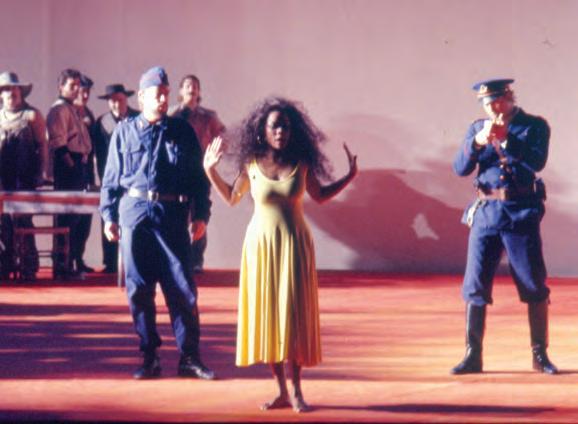
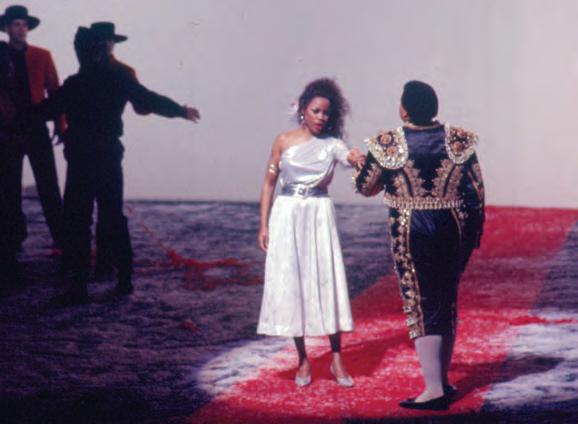
special as a season finale. But the money wasn’t there. So with no good alternatives, the company moved its tour production of Così over to the World Theater (now the Fitzgerald) and everyone crossed their fingers. “There’s little charm and no wit to the production,” said Mike Steele in the Star Tribune.
MINNESOTA OPERA OPENED its 1991–92 season in a mood of confidence. Then came the infamous Halloween blizzard of 1991, which dumped thirty-one inches of snow on the brave


citizens of the Twin Cities, keeping them stranded at home for the weekend playing board games and listening to their old opera records. If there was good news, it was that the company’s audience had begun to grow substantially. Ten years earlier, at the start of the 1981–82 season, the company had 1,809 subscribers; the number now was roughly 4,800. And the upcoming season looked promising too. There were to be four mainstage productions, one of which was a new work, plus a national tour and a classic Broadway musical that would be housed in the remodeled State Theater in downtown Minneapolis. What could go wrong?
The touring production of The Magic Flute, which opened September 12, 1991, at Central College in Pella, Iowa, was larger than usual. A cast of sixteen and a twenty-five-piece orchestra were scheduled to play forty-two dates throughout the Midwest, New England, and portions of the South, including Florida and Texas, with the final performances back in Minneapolis at the State Theater December 6–8. The production was important for two reasons. First, it happened at a time when opera companies had mostly given up on touring, largely because it had become too expensive to take a sizeable company like this one out on the road, which was the main reason the Metropolitan Opera pulled the plug on its annual tour five years earlier. The only way an opera tour could be feasible at this late date was for it to be well funded, which this one was, or very small scale, which this one wasn’t. The tour was put together by Rena Shagan Associates of New York City. A series of tour dates had opened up when the Texas Opera Theater, the touring arm of the Houston Grand Opera, folded. The other notable feature of The Magic Flute tour was that it was staged by Eric Simonson, who was making his company debut with this production. Simonson, an actor and playwright who was then an artistic associate with the Steppenwolf Theater in Chicago, would go on to direct more than a dozen productions for Minnesota Opera, many of them new works that he had a hand in creating. Simonson reminisced about the production in an interview in 2018. “We were a scrappy little production of fledgling actors just starting their careers,” he said.
ANYONE REMEMBERS the good qualities of the season opener, Minnesota Opera’s 1991 production of Tosca. They ignore George Manahan’s dramatically paced conducting and they say very little about Kimm Julian’s commanding portrayal of the evil Scarpia or tenor James Hoback’s heroic singing in the role of Caravadossi. When opera fans get together there’s barely a mention of British director Timothy
Coleman’s thoughtful, though sometimes overly busy, staging or Allen Moyers’s idiosyncratic set designs. And when the talk turns to Elizabeth Knighton Printy’s intense evocation of the headstrong actress Floria Tosca, we seldom hear about the singer’s clear, sweet voice and dramatic temperament. What we hear instead—and what will forever mark this production—is what has come to be called simply “The Accident.”
At the end of the opera, when Tosca leaps through the window with the aim of taking her own life, Printy made the jump that she had rehearsed so many times. On this occasion, the fourth and penultimate performance of the run, instead of safely landing on a mattress resting on a platform two feet below, she fell fourteen feet, suffering a fractured pelvis and two cracked ribs. Because the leap was through a window at the rear of the set, the audience never saw the fall. The curtain came down, as expected, and the applause started. The soldiers from the final scene took their curtain call, turned to the wings, and no one came out—no supporting cast, no lead singers, no conductor. Instead, the curtain went down, the house lights came up and the audience filed out, looking puzzled. There was no general announcement that anything odd had happened. But when the ambulance and the St. Paul Fire Department paramedics came, the most reasonable guess was that something had gone wrong with Tosca’s leap.
Several crew and cast members recalled the accident. Fred Sewell, concertmaster, said, “We played the last chord,

and the audience started clapping. We stood there looking up at the stage, and the singers didn’t come out for their bow. We didn’t know what happened until we got out of the pit and someone told us.”
Company manager Roxanne Stouffer Cruz, who was then production coordinator, was in the titles booth where for each performance she cued the surtitles that appeared above the stage. After Tosca made her final jump, Cruz saw one of the two stagehands (who each evening were positioned to spot Tosca) leap and reach toward stage right. “I thought, ‘What happened?’” said Cruz. “As I made my way downstairs to the backstage area, no curtain came up, no cast members came out for curtain call. I hurried behind the set and saw the looks on everyone’s faces. There was a feeling of horror at first because the last thing you want is for someone to be hurt.”
Captain Pat Donnelly of St. Paul Fire Truck No. 1 said later that Printy was unconscious for a couple of minutes and didn’t know who she was when she came to. “She can move her arms and legs,” he said, “but we don’t know yet about internal injuries.” When the paramedics carried her to the ambulance, she was still in costume and was receiving oxygen and fluids. Printy, thirty-nine, was listed in fair condition the next day at St. Paul Ramsey Medical Center. Kevin Smith said the medical reports were encouraging. “She has no head, internal or spinal injuries, and they expect complete recovery,” he said. Her husband, David Printy, a businessman who ran for Minnesota governor in 1990, was at her side.
Kathy Davis Graves recalled, “In those days we didn’t have cell phones or internet or email, and I got a call at midnight from a reporter from the St. Paul paper who said, ‘Would you like to comment on the accident?’ I didn’t know what he was talking about, and that set off this media frenzy. Every television station around the country was calling. It was a crazy time.”
Within twelve hours of the accident, dozens of newspapers in the United States and Europe carried reports of Printy’s fall. The accounts varied, especially concerning the extent of the drop. Some said fourteen feet, which was probably correct. Others said sixteen feet, and a few reported this as a record-setting fall of thirty feet.
Tosca program, 1991, courtesy Minnesota Opera Archives
Allowing for a few months recovery, Printy’s performing career continued in January when she appeared with the New York Chamber Symphony as a soloist in Shostakovich’s Symphony No. 14. She continued giving opera and recital performances in the United States and Europe, and as of 2021 she was on the voice faculty at Bowdoin College in Maine.
WAS IT INEVITABLE that the New Music-Theater Ensemble would split from its parent organization, Minnesota Opera? Center Opera, after all, had done the same thing back in 1969, leaving its parent, Walker Art Center, to go off on its own and conquer the world under the name Minnesota Opera. In the earlier case, “growing pains” was the excuse everyone cited. Center Opera had gotten busy and ambitious, and the Walker could neither contain it nor pay for it any longer. Growing pains weren't the issue with the New MusicTheater Ensemble. What the rumble was all about was that the Ensemble and its parent were going in different directions. Minnesota Opera had emerged from a period of soulsearching and had come up with the understanding that it was an opera company. The product it hoped to sell to its customers wasn’t Broadway musicals or the newer varieties of music theater but opera—mostly standard works combined with an occasional new or seldom-performed piece, all of it staged in an interesting way. That, at least, was the plan. So no, the split wasn’t inevitable. There was—and is—nothing irrational about an opera company having an appendage devoted to new and unusual work. Such a format might end up expanding the audience for both. Members of the Ensemble’s younger audience might be induced to see La traviata, while an elderly couple who have listened to the Metropolitan Opera broadcasts for forty years might be intrigued and amused by an avant-garde doo-wop theater piece with synthesizer backing. But the administration and the board of Minnesota Opera didn’t see it that way.
Kevin Smith said:
Initially we decided to continue Wesley Balk’s legacy of training and new works through the New Music-Theater Ensemble. But after a few years they were doing their own thing. They had become a separate artistic entity, and I finally said this doesn’t make any sense. “You guys need to do your own thing.” There was really no connection between us other than we were kind of an umbrella under which they could function and make grant applications. So on that basis we set them free.
Ben Krywosz agreed, saying, “I wouldn’t say the split was acrimonious. Let me put it this way: it was as amicable as a divorce can be.” In the summer of 1992, Krywosz filed tax forms to make the Ensemble its own nonprofit organization. The Ensemble staff kept an office in the Opera Center for the next two years.
Of the twenty or so works that the Ensemble presented up
to that point, the most admired was probably Snow Leopard, an intense one-act opera composed by William Harper to a text by Roger Nieboer. Rhoda Levine directed the work’s premiere at the Southern Theater in 1989, after which Harper and Nieboer revised the opera, and the new version was put on at the Seventh Place Theater in downtown St. Paul, and Krywosz staged it. What was novel and exciting about Snow Leopard the first time around remained intact. Harper’s electronic score seamlessly weaved pop idioms into the fabric of extended and intricately detailed musical structures that enhanced Nieboer’s hot-off-the presses tale of Pentagon treachery and covert operations in Tibet, where Buddhism and Christianity collide. What had improved was the production, which was partly a matter of a more flexible stage facility. It may also be that Krywosz has a more musical ear than the previous director, in whose production the music seemed either background or counterpoint to the action. Blondell Cummings’s choreography added atmosphere, and the look of the show had changed radically. Victoria Petrovich, who did the sets and costumes, and Michael Murnane the lights, moved in the direction of realism while still providing poetic, resonating images.
The story is told as a dream. An American military officer is engaged in the building of a dam in Tibet, a covert operation that will solidify China’s hold on Tibet. The officer, known simply as Man, is a true believer, a military missionary whose gospel is technological progress, consumerism, and domination, not just over nature but over the supposedly backward people of Tibet. “All you need,” he says, “are three Bibles and a can of Drano.” The project falls apart, and the officer goes on trial, forced to take the rap for his superiors. (This was taken at the time to be an allusion to Col. Oliver North.) The officer suffers a breakdown and loses his identity. Whereas before, he saw the world as simply a reflection of himself, he no longer can even see his face in a mirror. In the final, pathetic tableau, having experienced a rebirth of consciousness aided by Buddhist spirits, he sits on stage holding an empty bowl. In Buddhist terms, he has achieved at least the beginnings of enlightenment. In Western terms, he has ceased being a dominating control freak and has given up the religion—Christianity—that separated him from his body and from nature. He can now look up and see the stars.
MINNESOTA OPERA OPENED a second show during that first week in November, a production of Rodgers and Hammerstein’s classic Broadway musical Carousel at the newly—and splendidly—restored State Theater in downtown Minneapolis. The production was originally planned
to be put on at the Ordway, but the dates suddenly became unavailable. The Ordway, it turned out, had a show of its own it wanted to present at that time, which left the opera company scrambling for a venue. The State Theater in downtown Minneapolis, a venerable old-style movie palace, proved to be the solution. Built in 1921 at a cost of $1 million, the State had fallen on hard times. The Jesus People, a religious group, bought it in 1978 and then abandoned it in 1985, after which the theater sat empty and boarded up for five years. At that point the building’s owner, the Minneapolis Community Development Agency, a branch of the City of Minneapolis, committed $9.8 million to restore the facility to its former opulence, putting in new seats, enlarging the orchestra pit, and creating new dressing rooms for as many as forty-eight performers. And the best news was that the theater could, if necessary, be ready for occupancy in the autumn of 1991, and so, after some negotiating, it was agreed that the restored theater’s opening presentation would be the Minnesota Opera production of Carousel. The arrangement at the time was that, though the City owned the facility, it would be operated by the Historic Theater Group, a private management company. Later, in 2000, the Hennepin Theater Trust was established as a nonprofit organization to assume responsibility and guarantee the future of the State and its companion theaters on Hennepin Avenue, the Orpheum, and the smaller Pantages. In 2005, the Trust executed a long-term financing arrangement with the City of Minneapolis to shift ownership from the City to the Trust.
Some wondered at the time whether the State would—or could—become a second home for Minnesota Opera, or even a first home, an idea that was explored briefly in the 1970s. The State had advantages over the Ordway: more convenient parking, Skyway access, and a bigger seating capacity—2,176 compared to the Ordway’s 1,892. The Ordway, on the other hand, had a large, opulent lobby, which the State didn’t have, and a deeper stage—forty-three feet compared to the State’s thirtytwo feet—an important consideration for the bigger touring shows. Kevin Smith was probably right when he contrasted the two facilities. “The Ordway is essentially an opera house,” he said at the time. “The State lends itself to smaller, lighter kinds of things. I can’t see us doing grand opera at the State, but I could see us doing operettas, musicals, that kind of thing.”

ited one of the speakeasies that dotted Hennepin Avenue. Overall, this was a handsome production, staged by Julia Carey with realistic but not overcrowded scenery by Michael Yeargan and a strong cast. Cynthia Lohman brought a layer of toughness to the main role of Julie Jordan, which made her all the more credible, and her understated delivery of her biggest solo number, “What’s the Use of Wond’rin’,” was one of the evening’s highlights. Vocally, Robert Cuccioli’s Billy Bigelow was uneven, but he managed to make this complicated character believable and even sympathetic.
The interior of the theater looked spectacular on opening night. The intricate plaster work, the gilding, the ceiling paintings—this must have been the way the theater looked on opening night in 1921 when fashionable flappers and their escorts came to see and be seen and afterward perhaps vis-
MINNESOTA OPERA’S AUDIENCE first encountered the music of Robert Moran with The Juniper Tree in 1989. This was an opera based on a Grimm fairy tale full of mayhem and murder and things that go bump in the night. Moran
composed half of the opera and Philip Glass the other half. In the case of From the Towers of the Moon, which the company commissioned and premiered at the Ordway March 27, 1992, Moran wrote the whole thing, all eighty minutes of it, to a text by Michael John LaChiusa, who in later years became a prominent theater composer. It’s a love story, tender and passionate—perfect for operatic treatment—based on an ancient Japanese tale about a young goddess who is sent to earth from the moon. She is discovered by a peasant couple whose own child has just died, and they raise her as their daughter. The girl is beautiful and has magic powers. The Emperor, who becomes interested in her, sends intermediaries to woo her, but she rejects them. The Emperor himself finally shows up, falls under her spell, and discovers the love within himself. But she must return to the moon, and though the Emperor and her peasant family beg her to stay, she goes, leaving a legacy of love and spirit. Moran, who described his score as “baroque minimalism,” wrote music both sensitive and lyrical. It’s easy to listen to, though Moran writes punishingly high passages for his singers. Elisabeth Comeaux was a commanding presence as the Goddess, her singing remarkably poised and articulate, and her opposite, Peter Halverson, sang the part of the Emperor bravely and gently. Director Nicholas Muni, who staged the previous season’s premiere of Frankenstein, did a virtuoso job with the rapidly shifting scenes. Derek McLane’s scenery was minimal but evocative. Elisabeth Comeaux, who sang the lead role of the Girl: “Looking back, From the Towers of the Moon was a great experience, but it was an incredibly difficult score with a [lot] of high notes. It was good that my character had to move in slow motion because all I could do was count. Nick Muni directed and was changing things right up to the preview performance.”
A PRODUCTION OF The Marriage of Figaro that everyone liked rounded out the season. Writing in the Star Tribune, Mike Steele described the production as “light, sunny, buoyant, well-balanced, and unfussy.” Albert Takazauckas directed it, and George Manahan, leading the St. Paul Chamber Orchestra, conducted with ease and spirit. The simple decorative sets were on loan from the Banff Center for the Arts, reflecting more the eighteenth-century France of Beaumarchais’ original novel than Mozart’s Seville. And the cast was close to perfect. Kathryn Gamborini’s Susanna radiated intelligence and spunk, while Andrew Wentzel’s easygoing Figaro, a good match for her, spun out his tunes with a flexible agility. Emily Manhart as Cherubino was restrained
enough to bring out the painful, boyish goofiness of first love. Christopher Robertson’s Almaviva was aptly forceful and swaggering, and Dominique Labelle’s Countess, a bit stiff at the start, eventually dropped the grand style of her position in society and showed us her earnest obsession with revenge. Tenor Dan Dressen was a hilarious Don Basilio.
George Manahan said of Takazauckas, “Albert was a great colleague. We did many things together. Sadly, he died last year. Albert had a way of keeping the cast entertained. He was an actor’s director, and he had a great flair for comedy.”
At the annual board meeting on June 30 it was announced that the company’s board—and its whole governing structure—was reorganized. The eighty-member, two-tiered board was consolidated into a single board of thirty members, board meetings were to be held monthly rather than quarterly, and the executive committee was replaced by a committee of the whole. Karen Bachman was named board chairman, Phillip Heasley vice-chairman, Lucy Rosenberry Jones secretary, and Timothy J. Admonius treasurer.
TO KICK OFF ITS THIRTIETH season, Minnesota Opera took up Wagner for the first time, The Flying Dutchman, and the result, in the words of one critic, was “a great, dazzling, often hilarious mess.” British director Keith Warner, who staged the company’s stunning Carmen in the spring of 1991, offered a new look at this tale about a lonely Dutchman fated to sail the world eternally unless he can be redeemed by the selfless love of a woman. He finds just such a woman, Senta, on the coast of Norway, and she pledges eternal faithfulness. But when the Dutchman finds that she had previously pledged her love to someone else, the Dutchman, feeling betrayed, returns to his ship. To prove her love, Senta leaps to her death, and the two rise into the heavens. Warner turned the narrative into a series of scenes that are essentially Senta’s dreams, the wish fulfillment of a young woman weary of provincial life. There were striking moments in Warner’s production, which he also designed. The appearances of the Dutchman, for instance— powerfully sung by Roger Roloff, a veteran Wagnerian— gaunt and sepulchral, bathed in blinding white light. Senta’s desperate and libidinous pursuit of the Dutchman in the second act, however, chasing him all over the stage, got laughs on opening night. Wagner shouldn’t get laughs.
Conducting an orchestra of fifty-three players, George Manahan proved to be a persuasive Wagnerian, a conductor
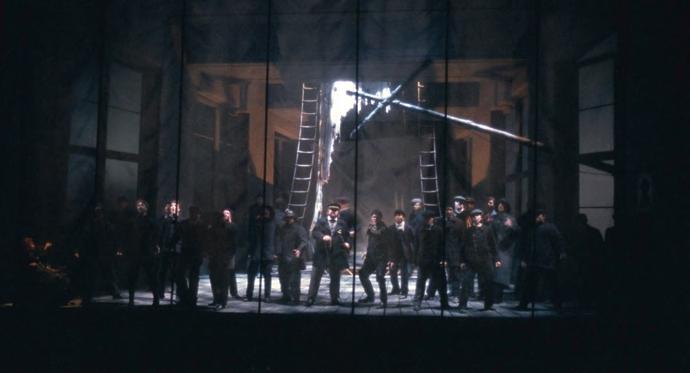
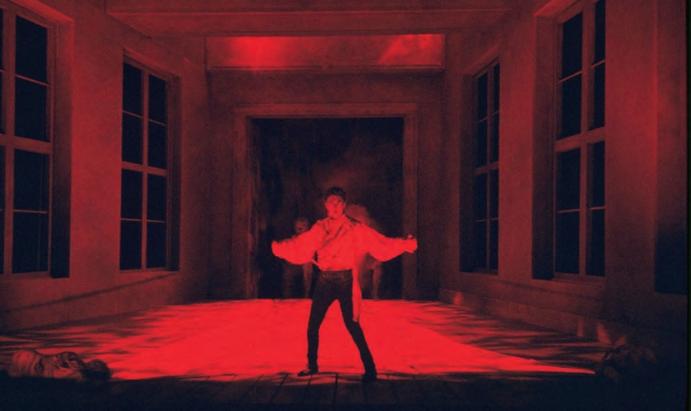
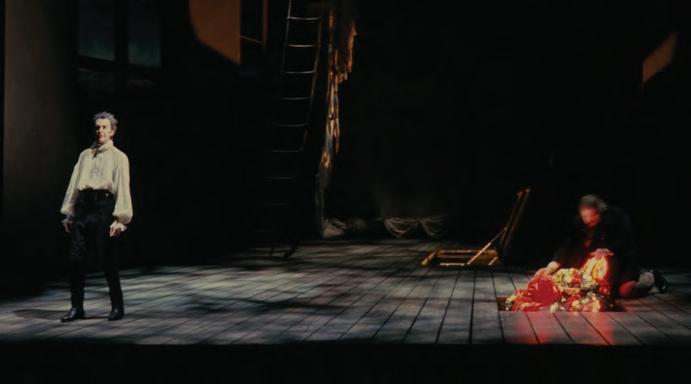
with an assured sense of the music’s special flow and color. Manahan said of the production: “We weren’t cramped in the pit the way we would be for the later Wagner operas, like Tristan or The Ring. Puccini’s orchestration is actually bigger and takes up more room. Partly it’s all that percussion. We were actually cramped doing Puccini.”
ARMIDA , A RARITY BY ROSSINI that opened at the Ordway January 22, 1993, received a lively multimedia production staged by Nicholas Muni and starring, in the title role and making her company debut, Brenda Harris, who was to become Minnesota Opera’s favored soprano, an accomplished exponent of numerous demanding roles, including two of the three lead parts in Donizetti’s Tudor Trilogy. Set during the Crusades, Armida tells the tale of the temptress Armida who plots to weaken the French by luring their greatest warrior, Rinaldo, to her enchanted island, where he is to be killed. Naturally, she falls in love with him instead, at which point the plot thickens. Muni cast the show in a series of striking tableaux rather than a continuously flowing narrative, and John Boesche put together the computerized projections and the abstract film that took the place of the ballet that was de rigueur in Rossini’s time. Jeffrey Frances was an impressive Rinaldo, but the evening basically belonged to Harris, a singer of spectacular ease in a wickedly difficult part and a commanding actress. Ransom Wilson, the flutist-turnedconductor, led the St. Paul Chamber Orchestra in a trim and happily bustling reading of Rossini’s ebullient score.
Artistic director Dale Johnson recalled Brenda Harris’s audition for the title role in Armida:
So we announced that we were doing Armida, and various women came in to audition for it. And Brenda showed up and we were a little surprised because we didn’t know she did that kind of thing. We thought of her as a lyric soprano, and I knew that the voice moved because I had heard her sing Donna Anna. But she came in with this Rossini piece, actually three pieces, one from The Siege of Corinth. So we said, “OK, well, let’s hear it.” Well, I tell you, I had never heard anything like that other than maybe Joan Sutherland. My jaw dropped. I forget who was playing the piano for her, but it was like, “What is this?” We said, “How come you don’t ever use this to audition?” She said, “Well, most companies in the United States don’t do this kind of music.” And she was right. Nobody really did do this kind of music. Well, she got the job, and that led to a many, many-year friendship and love.
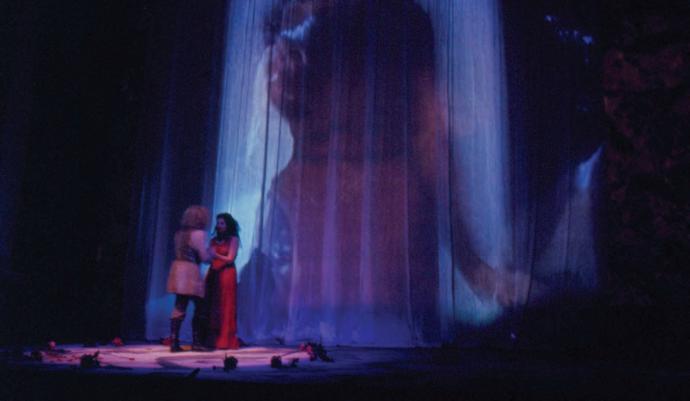

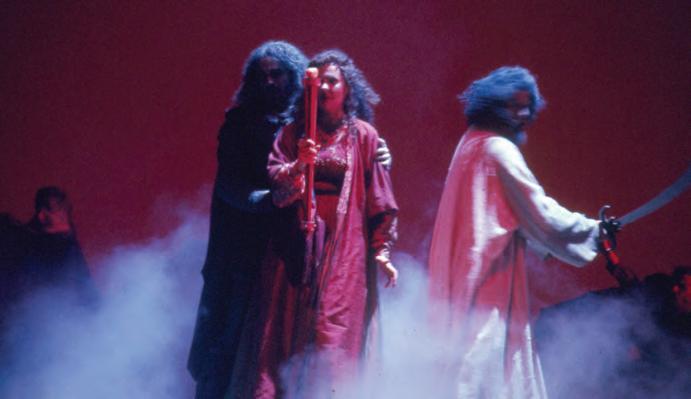
Brenda Harris said, “Dale took a chance on me because I really hadn’t done much yet. I had worked with a number of opera companies, but this was a new production, and Nick Muni was directing. It was a lot. I remember it being a big hurray and a sigh of relief to get the part. And over the years, I’d have to say that Dale Johnson and Kevin Smith were the dream team of opera. They were amazing together. The time I spent there with those two guys was so exemplary both from the business aspect and the artistic aspect. I thought they were fantastic.”
Dale Johnson remembered the response to Harris’s role:
I remember by the end of the first performance people were screaming for Brenda. She became, overnight, the biggest singer we’d ever had, and she pretty much remained that all the way through. She and Denyce Graves and Greer Grimsley and Bruce Ford and Vivica Genaux: those were our big stars. Brenda sold tickets for us and we started planning things for her. The thing is, she knows the notes and all that, but she comes into rehearsal and works so hard on things like ornamentation with her husband, who’s her coach. He’s a singer, too. She works harder than anyone I know.
PUCCINI’S MADAME BUTTERFLY has been thought for decades to be thrilling musical drama and a chance to shed a few tears, but the opera has become problematic to stage for a modern audience. To many Asian Americans, the fragile, victimized Cio-Cio-San is nothing but a racial stereotype: the submissive Asian willing to give up religion, family, and cultural identity to become the wife of an American naval officer, who soon abandons her with tragic results.
As Minnesota Opera’s production of Madame Butterfly got underway at the Ordway March 12, people voiced their opinions on a subject that had become increasingly contentious. “Frankly, the opera should not be done,” Ken Choy, a member of the Asian American Renaissance, a Twin Cities organization, said at a panel discussion on cultural stereotypes that the company hosted a week before the show opened. “The opera perpetuates the idea of Asian expendability.” The veteran director Colin Graham, who staged the production, defended the opera, saying it has something to teach today’s audiences. “I look at it now as a drama about what is wrong with society,” he said, “about how money rules life, about how selfish pleasure destroys. In the end, Pinkerton’s selfishness, which reflects today’s pleasure-seeking attitudes, destroys not only her but himself.” General director Kevin Smith said
his goal was to “transcend the notion of Butterfly simply as a victim, a cute doll-like, vulnerable thing, and make her multidimensional. If the opera isn’t politically correct, I don’t think it’s morally incorrect.”
The outcome of these differing views was a protest by Choy and an associate, Juliana Pegues, at a Friday-night performance. During the finale of act one, Choy, dressed in women’s clothing, and Pegues tried to simulate their own deaths and shouted “No more Butterfly” in front of the theater’s orchestra pit, and were quickly ushered out by Smith and the theater’s house manager. They were taken by St. Paul police to a holding cell in Ramsey County Jail and were released ninety minutes later. The show was not halted because of the protest.
For this new production, Graham used the Brescia version of the score and text, Puccini’s 1904 revision in which Pinkerton comes across as more callous and vulgar than in other versions, and his wife Kate is more insensitive and Butterfly less passive. The result, enhanced by designer Marie Anne Chiment’s Japanese screens and wooden platforms, was a kind of intimate chamber-opera take on Butterfly with simple, clear lines and gestures rather than big melodramatic passions, and one that certainly avoided the Kabuki-style allusions that have been popular with this opera in recent years. The fine tenor Tonio Di Paolo’s Pinkerton wasn’t evil so much as fun-loving and naïve, a nice match for soprano Christiane Riel’s Butterfly, brave and determined rather than an object of pity and with an appropriate touch of steel in her big expressive voice.
THERE WAS REASON to look forward to Minnesota Opera’s season finale, The Pirates of Penzance, Gilbert and Sullivan’s funniest show. The company’s 1980 production, staged by Robert Moulton, was a gem, and the hope was that this new production at the State Theater—now the Historic State Theater—would be just as much of a crowd-pleaser. The cast was strong, and the director, Dorothy Danner, who had staged the company’s witty Kiss Me Kate in 1983, had a flair for stage comedy.
The musicians of the orchestra, however, had gone on strike and were picketing the theater. Stagehands and various technical unions had refused to cross the picket lines, and so backstage work was handled by members of the company’s administrative staff. The orchestra consisted of twelve nonunion musicians and included piano and two synthesizers. The chief problem on opening night was an inept sound system that badly mixed orchestra and vocal sounds into a stew of hisses
Minnesota Opera 1992–1993 season program, courtesy Minnesota Opera Archives
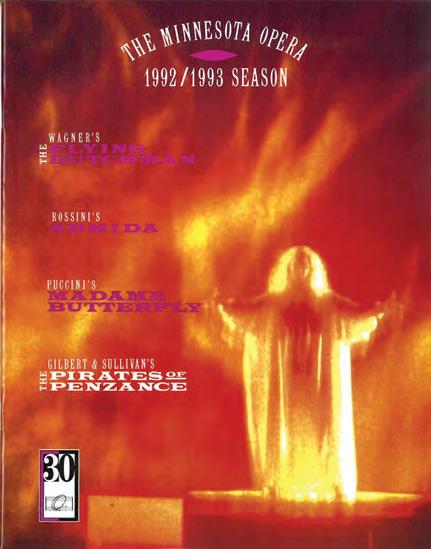
and pops and loud squeaks. Voices went in and out, soft and loud, and the keyboards dominated the sound. Danner’s staging, in contrast, was bright and clever, full of sight gags and whimsy. Robert Cuccioli’s bumbling Pirate King was continually on the brink of stabbing himself with his own sword, and Jon Whittier as the Major General handled his tongue-twisting patter song with virtuosic ease and performed the role with great flair. The two romantic leads, Peggy Joyce and Jeffrey Lentz as Mabel and Frederic, looked adorably earnest and sang with effortless charm. And conductor Dale Johnson kept his small ensemble playing in a tidy manner.
Even so, there was something spooky about the way the company ended its thirtieth season. Raucous laughter erupted from inside the ornate Historic State Theater while on the sidewalk outside a handful of the company’s orchestra musicians walked sullenly back and forth carrying signs that said, “Minnesota Opera Musicians on Strike: Stay Away!”
By September, the situation was worse. Negotiations were stalled. The orchestra was still on strike. The grandiose plan to create an Alliance, as it was called—a merger of the Ordway, the St. Paul Chamber Orchestra, and Minnesota Opera that would kill off the opera company’s own orchestra—had exploded like a firecracker, leaving little pieces of burnt paper floating aimlessly over much of downtown St. Paul. The company’s intention to open the season in October with a new
production of The Merry Widow had to be scrapped and postponed till the spring of 1994. But the tour production of Don Giovanni hit the road as planned, giving its first performance in Fairmont, Minnesota, and continuing with dates in Texas and Florida, but with the orchestra parts rescored for synthesizers and played by nonunion musicians, since, under the terms of the strike, union musicians were forbidden to play for any Minnesota Opera production, and the company, as a result, was listed on the “International Unfair List” of the American Federation of Musicians. Brad Eggen, president of the Twin Cities Musicians Union, said, “We’re intending to have advertisements in the newspapers of every city in which they perform to advise the public that this organization is on strike and that they have displaced a professional orchestra with synthetic machines. We also hope to gain the assistance of other unions in those cities.”
ON JANUARY 21, 1994, three months later than had originally been planned, the company poured eleven tons of sand on the Ordway stage and opened its thirty-first season with a production of Handel’s Julius Caesar, which takes place in the Egyptian desert. After nearly a year of haggling over a contract with its orchestra, a period that included a strike and increasing enmity on both sides, representatives of the company and its musicians finally came to an agreement they could live with. A ratified contract had yet to be presented to the board of directors, but it was assumed, as the season officially began, that the contract would be affirmed.
Chas Rader-Shieber, artistic director of the Skylight Opera Theater in Milwaukee and a baroque specialist, staged Julius Caesar, the company’s first presentation of a Handel opera, doing so in a postmodern manner involving mixed styles and periods. David Zinn’s costumes paired Roman togas with contemporary suits and ties. David Birn’s set design called for a steeply raked stage floor covered with sand and contemporary pop art carpets, the whole thing framed by tall windows in three sides, suggesting an eighteenth-century drawing room into which a touch of ancient Egypt had somehow drifted. Rader-Shieber’s extravagantly theatrical production often seemed to be making fun of the conventions of baroque opera and the ancient world, though Handel clearly thought of this as a serious opera about lust and treachery. Derek Lee Ragin’s well-placed, expressively sung countertenor portrayed Caesar as noble and dignified, and Brenda
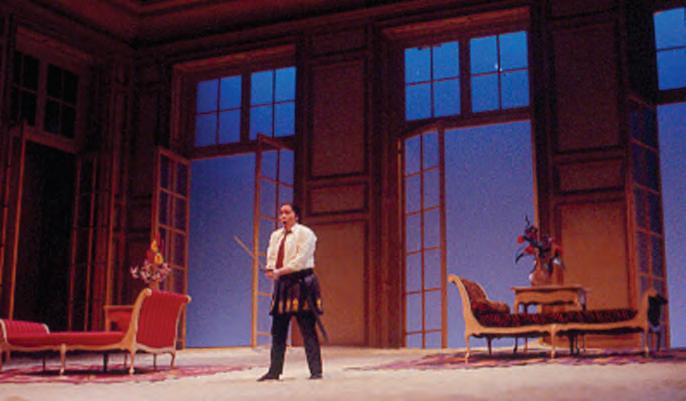
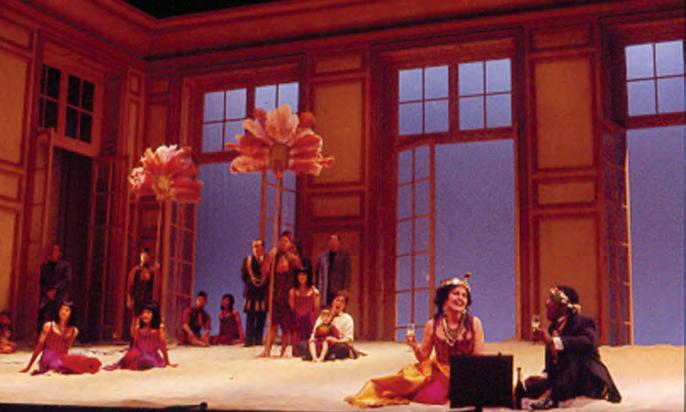
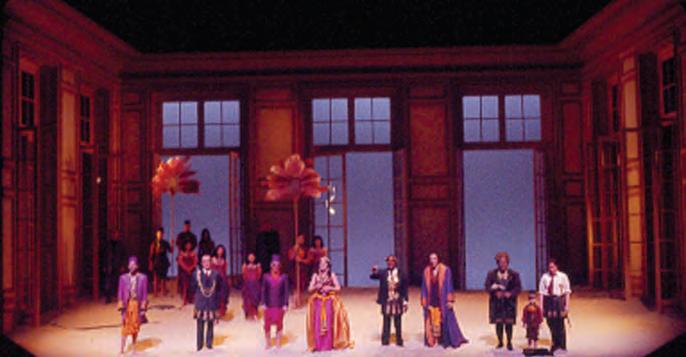
Harris put forth a compelling interpretation of Cleopatra as a grasping, vain woman who gets what she wants (a role made famous in the 1970s by Beverly Sills).
Philip Brunelle, who had for years been conducting the Handel oratorios as part of his Plymouth Music Series, was the perfect choice for conductor. Working with a score that was prudently trimmed, Brunelle led the St. Paul Chamber Orchestra in assured, idiomatic playing that contributed a great deal to the evening’s impact. Brunelle recalled: “I certainly remember all that sand. Fortunately, none of it fell into the orchestra pit. Brenda Harris was marvelous, as were the countertenors. I did the trimming of recitatives and several da capo arias. There were no crises, but, as it was Handel, I loved conducting it.”
Brenda Harris also had good memories of the production. “I actually had done quite a lot of Baroque repertoire, especially in concert,” she said. “It matched my voice at that time really well. And it was a fun production. I remember I fell on my butt during one of the dress rehearsals. I was wearing these sexy little mules, and they were high heels, and whoop. I fell right down. They were all going, ‘Oh, my God. Are you OK?’ And we all had a good laugh about it.”
Dale Johnson, though, remembered that the audience didn’t love the show. “Marietta Simpson sang so beautifully in that show, and I think the show was really well done, but we discovered something with that production, which is that our audience doesn’t love Handel and the whole da capo aria style,” he said. “They didn’t show up. We had the same problem with King Croesus, which was beautifully done, I thought, and beautifully sung. But, again, they didn’t show up for it, and that’s cool. The Seattle Opera did Wagner all the time, and Santa Fe did Strauss. And we did a lot of bel canto opera and a lot of new music, and our audience liked it. But they didn’t like Baroque.”
THE HEALING POWER OF MUSIC , an idea as old as the myth of Orpheus, was evoked in a jazz context in Diary of an African American, a new work for the stage by jazz trumpeter and composer Marvin “Hannibal” Peterson, presented by Minnesota Opera and the Music Theater Group in six performances at the World Theater starting March 4. The instrument that serves to revive Peterson’s ailing body and soul in this autobiographical tale is a kalimba, an African thumb piano that, as he told us onstage, he was given upon his arrival in 1979, ill with pneumonia, at the homeland of his ancestors, Nairobi. The giver is a little boy identified as Murasi, “the keeper of the souls that were from

Africa.” For years, Peterson had dreams of just such a boy playing a kalimba. In a touching moment at the end of Diary, he gives his own son the kalimba to insure that “there will always be the spirits who dance and play the music.” The circular nature of the narrative—son to father to son—is echoed in the circular African rhythms that infuse the early scenes in Peterson’s Diary. Its form, in which memories are interspersed with music, had become a staple of nightclub acts and autobiographical plays with music in the 1980s and ’90s, the exemplar being Lena Horne’s Broadway show, A Lady and Her Music. Diary proved to be an engaging evening. Diane Wondisford directed the show.
CARUSO ONCE SAID THAT all it takes to make Il trovatore work is to hire the four finest singers in the world. The Minnesota Opera production of the opera, which opened April 8, 1994, at the Ordway, didn’t have that magic four on hand, but it did have three good singers onstage and, except for some bad luck, it would have had a fourth.
First, in the role of Count di Luna there was the normally

excellent baritone Kimm Julian, who on this occasion was suffering from a bronchial malady. Julian sent out his apologies beforehand on opening night but said he would go on anyway. By then the show was already in trouble. Thursday morning, the day before the opening, the tenor Timothy Tobin (Manrico) became ill and bailed out. Another young tenor, Scott Flaherty, who had never sung the role onstage, flew in from New York City and spent most of Friday learning the blocking and other specifics of the production. However, Flaherty said he still felt unsure of the role, so a local tenor, Dennis Peterson, was hired to stand in the wings and sing the parts Flaherty was unsure of, which included several arias and most of the last act, which Flaherty only mouthed. Peterson sang quite well from backstage, though having his voice emerge on the opposite side of the stage from where his character was standing robbed the scenes of any dramatic coherence. Fortunately, the other three principals—besides Julian, the amazing Dulce Reyes as Azucena and a confident Dong-Jian Gong as Ferrando—were all in good form, singing with passion and skill. Director Christopher Mattaliano’s production was simple and straightforward, a wise approach in so flamboyant an opera.
THOUGH IT WAS NOT FORMALLY announced, Minnesota Opera experienced an important change in administration during the 1993–94 season. Dale Johnson was named artistic director. Since joining Minnesota Opera in 1984, Johnson, who grew up on a farm in Ohio, had served in a number of functions: music administrator, vocal coach, chorus master, and
artistic director of the company’s touring and education programs. His influence on the company over the next twentyfive years—in repertoire, in the creation of new works, and in the development of the Resident Artist program—cannot be overstated. Given that the company’s 1993–94 season was widely considered to be a failure, Johnson’s promotion was seen as a step in the right direction, a pathway to higher production values, a rising national profile, and a clarifying of the company’s mission.
Kevin Smith, president and general director, said Johnson’s appointment was a turning point for the company. “We had just started another capital campaign,” he said in 2018.
We front-loaded it. We put some money into it and we opened the 1994–95 season with Turandot, the one with projections. That was Dale’s first season as artistic director. We had ended the prior season with Diary of an African American. For Turandot, we put together a consortium of opera companies, which ended up being one of the great coproductions in the history of American opera production. It must have been used by at least fifteen opera companies around the country.
A WORD TO INVESTORS: Don’t buy gold. Buy an opera company.
That seemed like sound advice in January 1995, as Minnesota Opera launched its thirty-second season. Opera in the United States had become a growth industry. True, connoisseurs might look down on the Three Tenors, likening them, perhaps unfairly, to the Three Stooges. Even so, it’s worth noting that the estimated worldwide audience for the concert at Dodger Stadium in July 1994, by Luciano Pavarotti, Placido Domingo, and Jose Carreras, when cable, audio, and video recordings were tallied, was close to one billion opera lovers. Consider, too, that between 1962 and 1987, the number of opera companies in the United States with budgets exceeding $100,000 rose from 27 to 154, and box office earnings among professional American companies increased in the 1992–93 season by 9 percent over the previous season and totaled $189.5 million. Opera, moreover, had become a staple on television and in movie soundtracks.
The local picture was similar. Minnesota Opera opened its 1995 season with a subscription base of 5,200—more than twice the number of subscribers it had in 1986, the final year
of the Metropolitan Opera tour. That year, the company presented four performances each of three operas at the Ordway. This year, with Puccini’s Turandot as the season-opener, the company gave six performances each of four operas and planned soon to go to five.
Giant search lights probed the sky above the Ordway Music Theater on the night of January 20, 1995, signaling the opening of Minnesota Opera’s thirty-second season and its new production of Turandot. Given that it was ten degrees below zero, people moved quickly into the theater. But where was Turandot, our favorite Chinese princess? Was that who the search lights were searching for? The royal daughter with the heart of ice? Suzanne Murphy, the audience learned, had a cold and wouldn’t be performing. In normal circumstances, such a development would have spelled disaster, pushing the audience back out into the cold. However, the schedule of performances had been tight enough to require double casting both in the title role and in the main tenor part, that of the prince, Calaf. So Kathleen Broderick, a Canadian soprano who was scheduled to sing the role in the Sunday matinee, some eighteen hours later, and in two subsequent performances, agreed to go on Saturday night in Murphy’s place. She would, in fact, sing the title role in both performances the first weekend, an almost unheardof feat in this taxing role. Murphy, it was hoped, would return the following Thursday.
It’s possible that the opening-night audience missed a great performance when Murphy had to bow out. As it happened, they got one anyway. Here, for once, in Broderick’s compelling portrayal, was a princess alluring and intriguing enough to justify Calaf’s reckless infatuation and his willingness to risk his life by becoming her suitor. This was not your standard Turandot. Broderick’s soprano, lustrous and flexible—rather than trumpety in the manner of Birgit Nilsson, who practically owned the part for a decade or more—was big enough to encompass “In questa reggia” and melting enough for the character’s sudden capitulation to love at the end of the opera. And where many sopranos focus entirely on the princess’s unalloyed anger, Broderick tempered her portrayal with a touch of vulnerability, which made her softening in the final scene more believable than it usually is.
Overall, the production was a mixed blessing, though by the end it carried considerable dramatic weight, thanks mainly to Broderick but also to the powerfully sung Timur (Dong Jian-Gong); the witty renderings of the courtiers Ping, Pang, and Pong (Peter Halvorson, Jon Kolbet, and Mark Schowalter); and some effective singing by Geraldine McMillian in the role of Liù.



James Robinson, who staged the production, was aiming at a darker, more abstract, and, presumably, timeless—even placeless—feeling. The problem was that the movable towers and geometric stairways designed by Anita Stewart, though enhanced by John Boesche’s projections, lacked atmosphere and, at times, looked like something from the bargain basement at Walmart. There were compensations, however, even in the bargain basement. The slowly rising “dawn” projection during the final duet, for example, symbolizing the awakening of Turandot’s love. Another was the Emperor’s eyecatching costume, which made him look like a golden mechanical bird. Anna Oliver designed the imaginative costumes. And as much as one missed the old-style, fairy-tale Turandot design, Robinson almost made up for it in the strong sense of hierarchy and brutal authority that he was obviously emphasizing in the society the opera depicts: the few at the top and all the crowds below. It’s easy to forget that Turandot is a love story set in a very cruel society. Conductor George Manahan displayed his usual skill both in the illumination of orchestral detail and in the expert exploitation of the grand, sweeping line that is so recognizably a part of Puccini’s music. Whatever reservations one might have had about this production’s décor, those sets and costumes ended up seeing a lot of territory. Vaudeville performers in an earlier day used to run ads in the trade papers when they were looking for work. They stated their particulars and then usually added a final note: “Have tux, will travel.” An ad for this Turandot might have said, “Have movable flats, will travel.” At least fifteen opera companies over the course of a decade rented the production.
IF THERE IS SUCH A THING as a perfect opera, Rossini’s The Barber of Seville, with its effervescent music and amusing situations, is the prime example. Rossini’s wittiest efforts grow directly out of his score, however, and need to be treated as musical jokes in the best sense, not as gags that are simply grafted onto the surface of the work. Christopher Mattaliano, who staged Minnesota Opera’s Barber, which opened March 25, 1995, hit the mark more often than not in a genuinely funny and attractive production that boasted a cast of singers who, in nearly every instance, could handle comedy and music with equal flair. Near the end of the evening, when our heroine, Rosina, thinks—wrongly—that she has been misused by her beloved Almaviva, she slaps him in the face, then bursts into tears. The sharpness of the slap comes as a surprise. We feel its pain and suddenly sympathize with both characters. It’s a telling moment in any production of Barber. If we
feel something there, then we’ve come to believe in these characters. Mattaliano moved the action from seventeenthcentury Seville to Rossini’s own time, the early nineteenth century. This is hardly novel. Guenther Rennert’s famous production in Hamburg in the late 1940s, which ended up in San Francisco, did the same thing. But Mattaliano took it further, adopting a nineteenth-century performance style that allowed the singers to occasionally address the audience and even bow after certain solo numbers, and all this was housed in Allen Moyer’s whimsical sets with their painted drops and French neoclassical proscenium arch. Even the lighting suggested old-style footlights. Mostly, this worked well and created a lively, spirited atmosphere. But why did the director have those intrusive mimes come on in the middle of Figaro’s “Largo al factotum”? No nineteenth-century star baritone would have put up with that. And while the clock-like movements of the characters in the first-act finale, the so-called stupefaction scene, were fun to watch, surely Rossini’s idea was better: the characters are frozen in place because they’re stymied. They don’t know what to do, which happens in real life.
Occasional excesses aside, Mattaliano seemed, to his credit, to be bent on taking a fresh look at the characters in the opera, and, happily, his cast was eager to do the same. The two heavies in the tale, Dr. Bartolo and Don Basilio, are in most productions about as funny as tooth decay. Here it was different. Charles Austin turned Basilio’s “La Calunnia” into an explosion of venom and conspiratorial spookiness, whispering parts of it rather than screaming, while Donald Sherrill, whose bald dome suggested a used bowling ball, managed to make Bartolo so believably mean-spirited that he became almost sympathetic. And both were accomplished singers as well. Emily Manhart, a mezzosoprano with a solid coloratura technique and a winning stage personality, was Rosina, portraying a nice blend of cunning and innocence. Her counterpart, Mark Calkins, who played Almaviva, wasn’t quite in Manhart’s league vocally. He had the character just right—boyish and impetuous—along with an appropriately light tone, but his florid singing was breathy and labored. Christopher Trakas made an appealing Figaro, stronger on charm than on the bravado swagger that usually goes with the role, and not as big vocally as is customary. But, like everyone else on stage, he was equal to the part. Conductor George Manahan led the St. Paul Chamber Orchestra in a smooth, buoyant performance.
in the Twin Cities in early April to stage Verdi’s dark masterpiece Rigoletto, his sixth production for Minnesota Opera. From 1988 to 1993, Muni was artistic director of the Tulsa Opera, but most of his work in recent years had been in Canada and Europe. “The practice in Europe is to rehearse a lot longer than they do in this country,” Muni said in an interview. “In the American system directors get paid very poorly and rehearsal periods are short. The period here at Minnesota Opera is actually long: three weeks. So the combination of short periods and poor pay forces you to accept a lot of work. In the years before Tulsa, I would do as many as eight or ten projects a year, which is way too much. Now I do five or six.”
In 1992, when Muni was engaged by the Canadian Opera in Toronto to direct a new production of Rigoletto, he tried something new. What was missing from standard productions of the opera, he thought, was “a moment-to-moment relationship where the audience is confronted by a man who can’t do what the other people onstage can do. That is, he can’t be just a hunchback. He needs a stronger reason for the development of his mental and verbal skills.” Gradually, Muni evolved the idea that Rigoletto can’t walk and has to get around in, what? A cart? A wheelchair? But wheelchairs, as we know them, weren’t in use in sixteenth-century Europe. The answer Muni came up with was a mechanical chair, which Rigoletto would have had constructed for himself. The result was a widely praised production that had since been done by two other companies before coming to Minnesota, where two baritones, Kimm Julian and Philip Kraus, alternated in the title role in a production that opened April 22, 1995.
OPERA PREMIERES HAVE THEIR OWN well-established rituals: brief, polite applause from the audience, a quick dash to the parking ramp, and the opera itself, to the relief of nearly everyone but the composer, is never heard again.
There was reason to think that the fate of Bok Choy Variations, which Minnesota Opera unveiled at the Ordway

Music Theater June 10, 1995, would be different. This powerful and engaging work, a tale of Chinese immigrants who find themselves “restless in Eden” after their perilous journey to America, was greeted by a standing ovation on opening night, a sign that this might be one of the new operas of recent years that would be heard again.
Composer Evan Chen and librettist Fifi Servoss, both first-generation Chinese Americans living in Chicago, tell the story of four young men whom we first encounter as children in Communist China. Put off by the mass conformities of Chairman Mao’s Cultural Revolution, they dream of freedom in the United States, only to find, after they get their wish, that America—and life itself—is more complicated than they had surmised. Fong, one of the four, ends up running a restaurant. He admits with resignation, “You grin and you bow to keep a roof over your head.” Lee, a painter, is forced to do sidewalk portraits in Times Square. Zhang Guo, a social activist, gets involved in smuggling Chinese immigrants to America and thinks of returning to China. “I wanted to change the world, but I think it changed me first,” he says. Da Wei, a composer—and the main character—falls in love with May, a Chinese student, then has a dalliance with Sophia, an American, who takes him to Greece. Later, in America, he finds himself blocked creatively, distracted by noise and too many choices. The end of the opera is tender rather than bitter as Da Wei comes to terms with his past in a touching tableau: Da Wei’s mother, taken from him by the Red Guards when he was a child, returns to sing an aria of solace. Da Wei the child walks onstage, and the adult Da Wei gestures toward him as the lights fade. (In a curious parallel, Chen’s father, whom he hadn’t seen in thirteen years, was able to leave Shanghai and attend the opening.)
Though this was his first opera, Chen brought to it an assured sense of pacing, an ability to set words clearly, a flair for attractive melody, and an ear for vivid orchestral detail in a score that deftly mixes jazz and popular idioms with


occasional modernist touches, both electronic and acoustic, and, in the first act, allusions to Chinese music. (“Bok Choy” is a lullaby that Da Wei’s mother sings to him and that recurs in the score.)
Eric Simonson, who in later years became one of Minnesota Opera’s most important directors, presided over this imaginative $450,000 production and shared credit for the libretto with Ms. Servoss. Among Simonson’s colleagues were conductor Jeffrey Lewis, set designers Robert Brill and Royd Climenhaga, costumer Allison Reeds, lighting designer Kevin Ramach, and sound designer John Robinson. The superb cast included Jason Ma (Da Wei), Alan Muraoka (Lee), Edmund Eng (Zhang Guo), Scott Watanabe (Fong), and Chloe Stewart (May).
A few scenes in the opera ended too abruptly and needed fleshing out. Bok Choy remained a work in progress. Despite its early acclaim, it failed to find a life after its premiere. The opera brought to a close Minnesota Opera’s biggest-selling season. Nearly 10,000 tickets were sold for each of the company’s four productions, an increase of 40 percent over the 1993–94 season.
FOR THE START OF THE COMPANY’S own 1995–96 season, the duo responsible for the prior season’s premiere of Bok Choy Variations, director Eric Simonson and designer Robert Brill, returned with a new production of Puccini’s La bohème conducted by Carol Crawford. Defying the trend of the moment—ever bigger, football-field size bohèmes with a cast of hundreds—Simonson and Brill turned the telescope around, and what they saw was a tale of doomed love in nineteenth-century Paris, essentially an ensemble piece of chamber-music proportions in which a bunch of young singers are allowed to interact on a human scale and create a sense of life onstage rather than simply hurling high notes into the balcony. In that vein, instead of glamorizing the young Bohemians’ garret, Brill gave us a small, gritty space that looked to be in the low-rent district of the Latin Quarter. Kärin Kopischke’s costumes might have come from Ragstock, except for those of the irrepressible Musetta. Even the Café Momus scene had the look of urban squalor (and, in fact, resembled sketches of the original production, first given at the Teatro Regio in Turin, Italy, on February 1, 1896). Simonson’s concept called for actors rather than sticks with
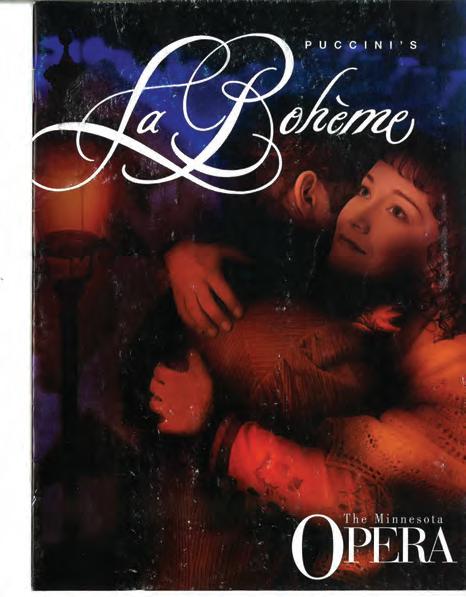
big voices, and, happily, his opening-night cast was almost always up to the task. As Rodolfo, Hong-Shen Li gave us a believable, appealing, and ardent young writer, lovestruck from the moment he sees Mimì. Li’s voice rang out excitingly at all the right times—he took the alternate high-C ending to “Che gelida manina.” And he proved to have taste, caressing the vocal line in tender passages and pointing the text sensitively. As for Mimì, the best performers of this role produce a bigger sound than Jee Hyun Lim’s slender, silvery tone could muster. Even so, Lim rode the climaxes effectively, if not excitingly, and her soft singing was delicately handled. The death scene was poignantly understated. The other singers gave consistently strong performances.
NICHOLAS MUNI’S DARK, almost macabre production of Mozart’s Don Giovanni for Minnesota Opera was a success in 1988 and seemed ripe for a second look. James Robinson took over the staging for this revival, which opened at the Ordway March 9, 1996, and added a few touches of his own; except for Mark Thomsen’s Don Ottavio and Elisabeth Comeaux’s Zerlina, he had a new cast to work with, the most compelling of whom was British baritone Robert Hayward in the title role.
Hayward’s portrayal of the licentious Don was so malevolent that it made conventional accounts of the role look like goodwill ambassadors from the United Nations. He is a world-weary melancholic, and violence is second nature to him. He doesn’t just sing prettily to Zerlina, the peasant girl, during their first-act duet; he stalks her. His rough handling of her during the first-act party scene isn’t just high spirits, it’s the prelude to sexual assault; and at the end of the act, when swords are pointed at him, he taunts his enemies, daring them to kill him, then walks off in disgust. And yet we never forget for a moment that he is an aristocrat. Hayward’s posture always kept us in mind of his high station in life. Vocally, he was an aristocrat too, using his big, resonant baritone with suave intelligence. He fired off the "Champagne Aria"’s breathtaking staccato with elegant ease on opening night, and he sang a refined version of the second-act "Serenade."
THE TIME IS LONG GONE when an encounter with Debussy’s operatic masterpiece Pelleas and Melisande involves a visit to a hazy, vaguely medieval kingdom adorned with dark forests, enchanted towers, and a mysterious maiden who engages in a chaste but illicit love affair with her brother-in-law. The pro -
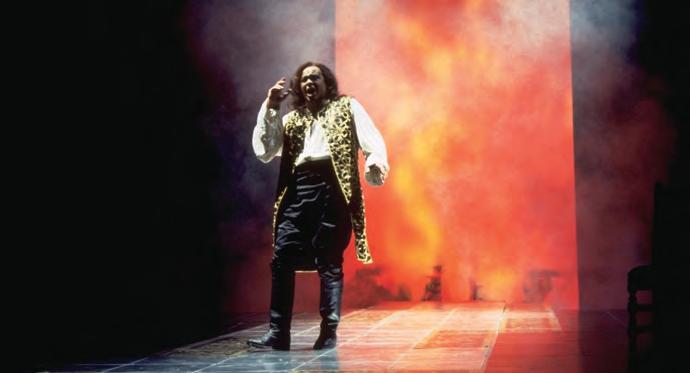



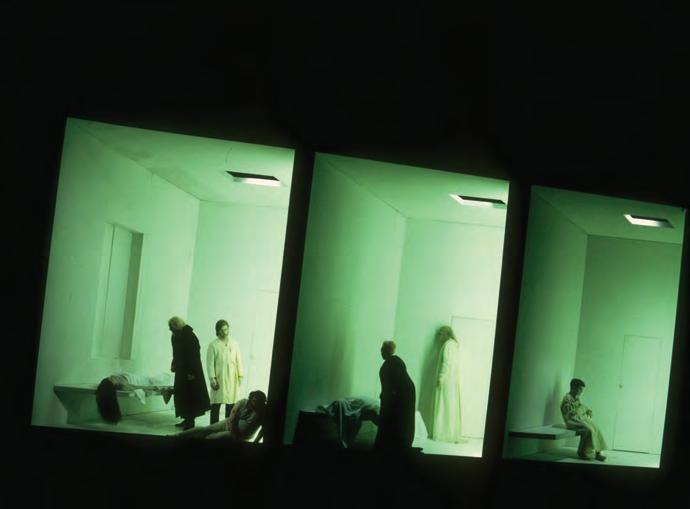
duction by Richard Jones that Minnesota Opera presented at the Ordway April 26, 1996, was typical of this new, usually anti-Romantic view of the opera. Jones staged it for a company in England, Opera North, and Matthias Janser adapted it for the performances at the Ordway. Instead of a medieval castle, set designer Antony McDonald gave us three harshly lit rooms that looked like hospital recovery spaces. Instead of a magical grotto, we were treated to a neutral, all-purpose upturned disc. We got sharp angles and planes and superrealistic painted drops and no real indication of time and place. The mood of the production was gloomy and alienating. Jones and his colleagues were probing the darker implications of the libretto, which Debussy drew from the play of the same title by Maurice Maeterlinck.
MINNESOTA OPERA BROUGHT to a close its thirty-third season—and a fine season it was—with a bright and sparkling production of Offenbach’s The Tales of Hoffmann, a coproduction with Portland Opera that was thoughtfully staged, intelligently acted, expertly sung, and, with the exception of a dull tavern set in the prologue and epilogue, a feast for the eyes.
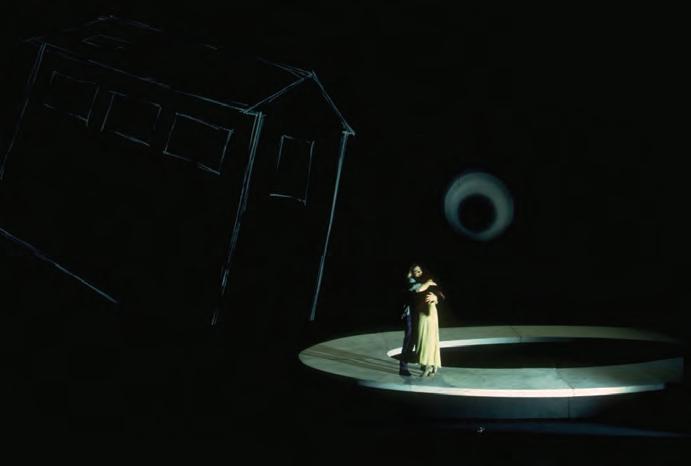
Director Richard D. Thompson aimed sensibly for a kind of dramatic truth and urgency, and he had the advantage of working with singers who could act, while Loy Arcenas made a plausible case for updating the action to the early twentieth century. His laboratory set looked like something from Fritz Lang’s Metropolis
The versatile soprano Brenda Harris seemed more petulant than sensual as the courtesan Giulietta, but her Olympia, the mechanical doll, was almost poignantly funny, and deftly sung, with easy agility, even above high C. Her Antonia was especially touching, especially during the opening aria. And where others camp it up playing the four villains, Greer Grimsley gave us four distinct figures of power and menace. Grimsley’s house-filling bass-baritone made suave work of the “Diamond Aria” and hit the final high E without strain. Fernando de la Mora, who looked like a young Placido Domingo (and sang like one) probed no depths in his characterization of Hoffmann but did convey a certain ardent impulsiveness, which was effective in a role so demanding. Emily Manhart made a charming Nicklausse. George Manahan, who guided the proceedings intelligently and drew sumptuous sounds from the orchestra, remembered: “They wanted a very theatrical approach to the show, and what was great was we managed to get the whole show down to under three hours, with lots of cuts, and that’s still plenty of Hoffmann. If you do the whole bloody thing, it goes on for six hours. It’s just too much. Brenda Harris did all the heroines and was just amazing. And Greer Grimsley was terrific. What a presence onstage.”
As it happened, The Tales of Hoffmann served as Manahan’s farewell to this company of which he had been principal conductor for eight seasons. Most likely, Manahan would have remained a few more years with Minnesota Opera had he not received an offer too good to refuse: music director of the New York City Opera, a high-profile organization that seemed to thrive on crisis but also one that could boast of a long and distinguished record of commissioning and premiering new works, a record almost as impressive as Minnesota Opera’s. Manahan started in New York in 1997 and remained until the music director position was eliminated in 2011. He became music director of the Portland Opera in the 2012–13 season, and in July of 2021 he assumed the title of music director emeritus with the American Composers Orchestra.
Recalling his years in Minnesota in an interview in the summer of 2021, Manahan said he found the orchestra to be in good shape overall when he first conducted it, in Stephen Paulus’s steamy The Postman Always Rings Twice. “These are fine players,” he said. “What I think I brought to it was a certain consistency, because I always conducted at least two of the productions each year. And there were some openings that happened during my tenure there—first trumpet and

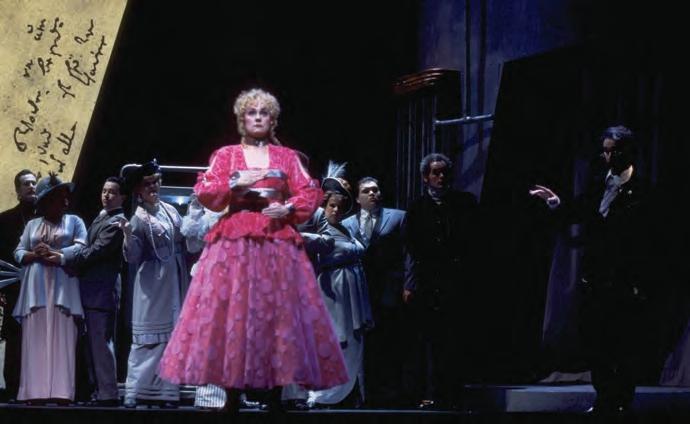

various woodwind changes. And those were always formal auditions with the committee and the music director. So I brought in a lot of stronger personnel. We always got better.”
With more difficult scores, he often asked permission from the management to have at least one extra rehearsal for the orchestra or a sectional rehearsal, which might involve just the string players or only the woodwinds. “I don’t think the orchestra had ever had a string sectional, because the previous conductors would come and go. And that made a big difference,” he said.
He also cleaned house. Against the back wall of the orchestra pit he discovered rolls of carpeting and towels and odd debris, all of which he had removed, and suddenly the muffled quality that had characterized the orchestra’s sound coming out of the Ordway pit got brighter, more detailed. “Yeah, I remember that,” Manahan said. “It got a little bit more resonant. That was gratifying because the orchestra began to have its own profile.”
And he got on well with the musicians. “I thought George was great,” said Camilla Heller, the principal cello starting in the early ’70s. Fred Sewell, who served as concertmaster off and on for several decades going back to the company’s premiere as Center Opera in January 1964, said, “You know, when you’re right in the middle of something, it’s hard to tell, but I know the orchestra improved under George’s guidance.”
Board chairman C. Marc Whitehead issued a report on the 1995–96 season that lit up the sky: the entire season—twentytwo performances—was sold out. And single-ticket revenue increased 130 percent from just two years prior, though some of the latter increase was due to rising ticket prices. In addition, the following January, the company announced that it had raised $8 million toward its goal of $10 million for its Artistic Development Campaign. The goals of the campaign included expanding the repertoire and, by the year 2000, adding a fifth production to the season, also engaging singers, directors, and designers of international renown, and extending national and international coproduction activities. Company president Kevin Smith said he expected the remaining $2 million to be raised in the next eighteen months. Karen Bachman and Judy Dayton led the campaign, which was launched in the summer of 1995.
JONATHAN MILLER, THE FORMIDABLE COMEDIAN , physician, Shakespeare expert, and opera director, hatched the idea of staging Verdi’s La traviata in a pared-down, ultra-
realistic manner, much in the style of Eric Simonson’s bohème the previous season. The idea won considerable acclaim in a production at the English National Opera, and there was reason to think it would be an interesting way for Minnesota Opera to open its thirty-fourth season January 31, 1997.
But something must have happened during the voyage from England, or perhaps Leah Hausman, who was entrusted with translating the director’s concept onto the Ordway stage, didn’t get the message. It’s one thing to suggest that the courtesans of mid-nineteenth-century Paris didn’t live as lavishly as Hollywood—or the Metropolitan Opera—would have us think. It’s another for designer Bernard Culshaw to give us, as décor, characterless, gray-green wall panels in scene after scene that evoke no mood or atmosphere and are dimly lit, to boot. True, our heroine Violetta has been selling off her possessions when we encounter her at the start of act two, but then why does Germont walk in and say, “Who pays for all this luxury?” when he’s looking at an almost empty room. As Violetta, Brenda Harris made her strongest impression in her final-act death scene, singing a poignant “Addio del passato” and acting appropriately delirious. Stephen O’Mara’s Alfredo was refreshingly free of tenorial cliches, and he sang with firm tone and bright, ringing top notes. It was really Germont, Alfredo’s father, who went against type and against the text as well. In his act two scene with Violetta, where he has to convince her to give up Alfredo, Gaetan Laperriere played him hard as nails. For this Germont, it’s purely a business matter. He’s a solid nineteenthcentury Republican. The family’s reputation is at stake, so she has to go.
HAVING OPENED ITS SEASON with a dour-looking La traviata, Minnesota Opera brought up the lights and opened the windows in order to deliver a charming, thoughtful production of Mozart’s The Magic Flute staged by Kelly Robinson and conducted by Richard Bonynge. It opened at the Ordway March 1, 1997.
La traviata program, 1997, courtesy Minnesota Opera Archives

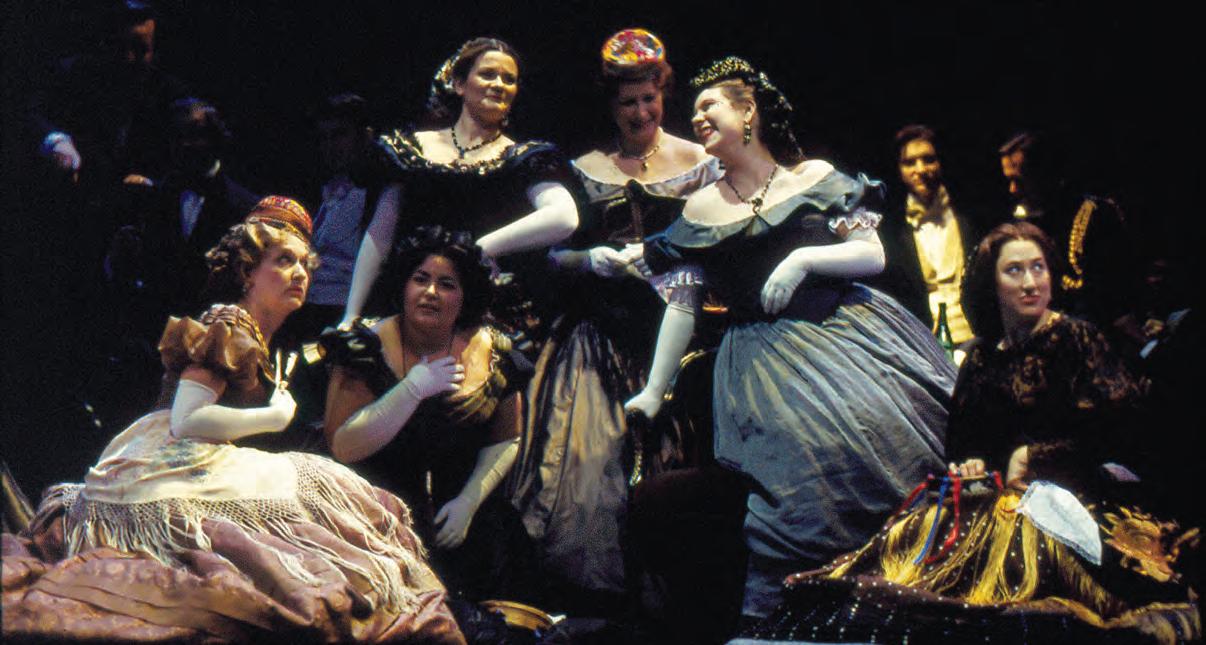

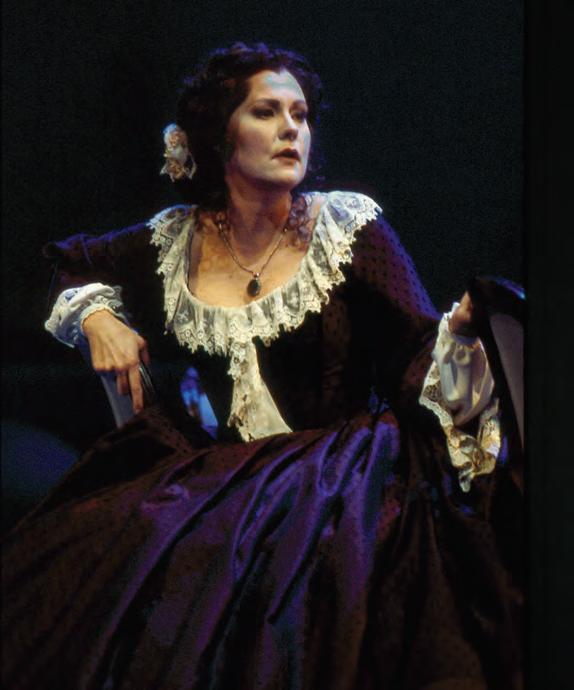



Mozart and his librettist Emanuel Schikaneder, seeking an exotic locale, placed the action in Egypt. Robinson moved the proceedings to China. Mozart’s Masonic priests became Chinese factory workers, and, though we might think we’ve wandered onto the set of Turandot by mistake, designer Susan Benson gave us delicate Chinese courtyards and puppets, towering factory interiors, and the persistent visual motif of interlocking wheels, as if we’re looking at the inside of a clock.
The production nicely balanced the comic and the sublime, the personal and the ritualistic, and treated the characters as flesh-and-blood human beings. Mark Thomsen and Rebecca Langhurst made a winning hero and heroine. Thomsen sang the role of Tamino with a pleasing sweetness while Langhurst’s Pamina embodied dignity and sympathy, and she sang with persistent ease and roundness of tone. Helen Todd’s Queen of the Night acted appropriately fierce as the evil mom, and her two big arias were stunningly sung in a voice that on opening night was crystalline in timbre and remarkably controlled. Bojan Knezvic, playing Papageno, the show’s top banana, made the character funny and appealing without turning him into a nitwit, as often happens with this bumpkin. Cynthia Lohman created a charming Papagena.
STRAVINSKY’S THE RAKE’S PROGRESS is “supercharged Mozart,” to quote the composer Virgil Thomson. It’s a work that makes heavy demands on the director, the conductor, the orchestra, and the singers, who must be alert, stylish actors as well as virtuoso vocalists. Minnesota Opera’s production, which opened at the Ordway on April 12, scored well on all counts.
Director James Robinson and designer Bruno Schwengl moved the story gradually from light to dark, from bright humor to poetic sadness, achieving both tones convincingly, and conductor Richard Buckley paced the proceedings with an expert hand. In the central role of Tom Rakewell, tenor William Burden sounded all the Rake’s moods: his youthful nonchalance followed by his increasing disillusion as a man of the world and culminating in his final disintegration and madness. Among the others, Nancy Allen Lundy offered an attractive, well-acted account of our heroine, the appropriately named Anne Trulove, who floated some lovely, soft high notes in the first act on opening night. Richard Byrne brought impressive stage presence to the part of the villain, Nick Shadow, and a big, expressive baritone, though the character needed a stronger touch of menace. Tenor Dan Dressen was much appreciated for his wildly comic Selim, the auctioneer,
as was mezzo Joyce Campana’s worldly, skillfully sung Baba, the bearded lady, who, incidentally, needed a longer beard.
Denyce Graves?
More precisely, is there a Carmen after Denyce Graves? Graves’s compelling portrayal of the cigarette girl—sensuous, alluring, fearless—dominated Keith Warner’s provocative 1991 production, which itself became Minnesota Opera’s lodestar, its ideal—opera as exciting theater—the goal the company claimed it had been striving for over the course of more than three decades. It was this production that propelled Graves to international fame, making her, for most of the decade, something close to the definitive Carmen.
Then came Jean Stilwell, a mezzo from Toronto. Stilwell was no second-best. On the Ordway stage, she was magnetic. It wasn’t a matter of which was the better Carmen, rather that their interpretations were different. Stilwell’s doom-haunted Carmen was the free spirit she needs to be, but she’s no earthy urchin as Graves was. Stilwell’s Carmen was a cool, calculating manipulator. She has no love for José, nor for Escamillo, the toreador. José is a challenge, someone to dominate. Stilwell moves like a dancer. You couldn’t keep your eyes off her. One thing is clear: the old-style Carmens are gone forever, the feisty heroine who swivels her hips and plays castanets with a rose in her teeth.
FOR MINNESOTA OPERA, presenting Aida, Verdi’s grandest opera, was more than a challenge. It was a betrayal. Back in the 1970s, company manager Charles Fullmer vowed that Minnesota Opera would never do Aida, an opera that
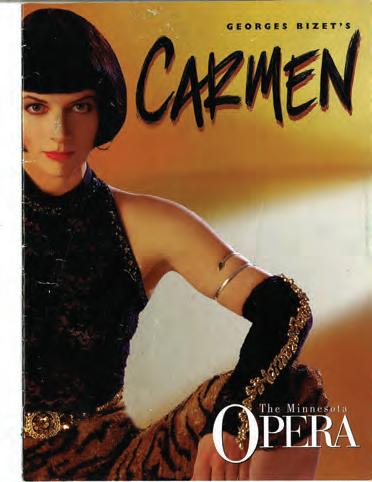

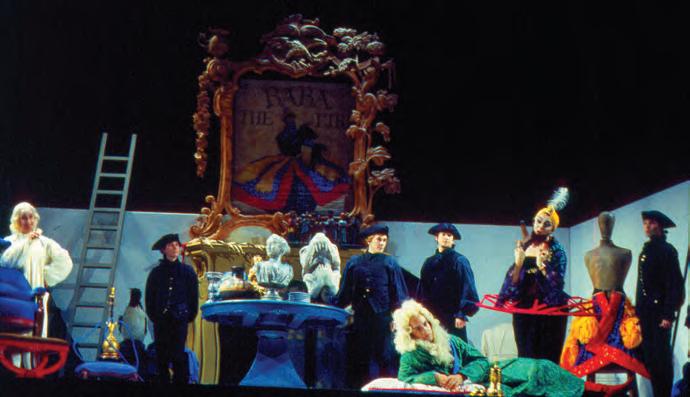

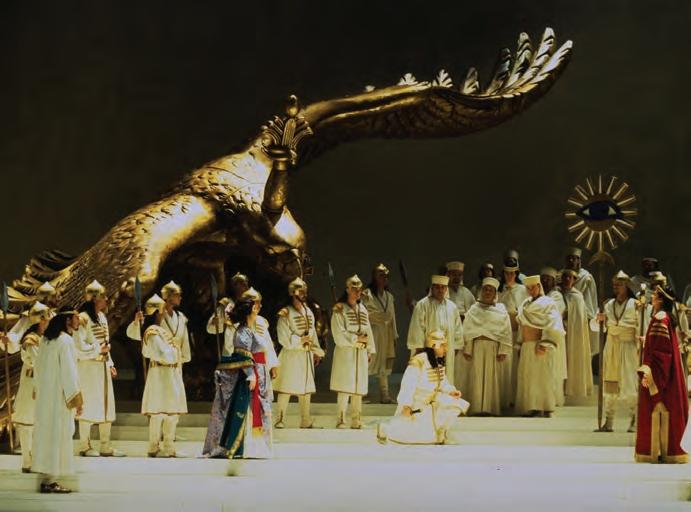

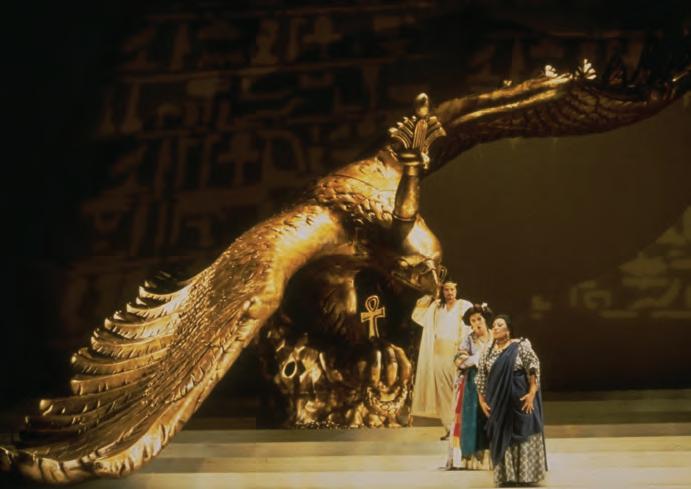

symbolized extravagance and spectacle, qualities that went against everything the company stood for, at least in its first decade. What was the company’s slogan back then? “Opera Without Elephants.” Everyone knew that “elephants” meant Aida. The feisty little opera company attached to the Walker Art Center didn’t want spectacle. It wanted small, provocative, but tasteful and dramatically coherent productions of new and unusual works—chamber operas, by and large—performed two or three times before what Dominick Argento described as a “discerning audience.” This, it turned out, was largely a fantasy. As a young company, Minnesota Opera couldn’t have put on Aida if it wanted to. It had neither the voices, the venue, nor the budget for such an enterprise. The Aida that Minnesota Opera opened at the Ordway on January 31, 1998, cost $1 million. The entire budget of the company’s first season, as Center Opera, was a little more than $42,000. And, as far as a steady diet of chamber operas, the founder of the company, Norton Hintz, admitted after Center Opera’s third season that there weren’t many good chamber operas.

He had looked for them, he said, and had found, maybe, six.
Aida was the largest and most expensive production in the company’s history up to that time. Nearly half its cost—close to $500,000—went for sets and costumes alone. It was a coproduction with eleven other companies in North America, from Charlotte, North Carolina, which would see it in late 1998, to Irvine, California, where the production wouldn’t arrive until the spring of 2001. Designed by Gerard Howland and staged by Colin Graham, the production traveled back and forth across the continent in three fifty-three-foot trucks. Graham and his team allowed for ample grandeur. The centerpiece of Howland’s set was a statue of the Egyptian god Horus, a gigantic golden falcon with a thirty-eight-foot wingspan. Costume designer David Wollard went for what Graham called “a kind of exotic ethnicity,” incorporating what people in Europe in 1871, the year of the opera’s premiere in Cairo, thought ancient Egyptians looked like. Fortunately, the big scenes failed to engulf the heart of the work, which is the love triangle of the Egyptians Radames and Amneris and the Ethiopian princess Aida. In this instance, Graham seemed to be making this Aida more a contest of wills between Aida (Geraldine McMillian) and Amneris (Nancy Maultsby) than a love story concerning Aida and Radames (Neil Wilson). The singers were able to make this focus convincing. Without doubt, it was the women who carried the evening. McMillian sang with sharp focus, clear enunciation, and impressive emotive force, and her body language always made it clear that this is a woman of royal blood. It was obvious that Amneris, too, given Maultsby’s regal bearing, is a princess, and there
was nobility in her singing as well as a wide expressive range and ample color. Conductor Richard Buckley paced the Triumphal Scene too quickly, as if the parade permit from the City of Cairo was about to run out, but he drew fine performances from both orchestra and chorus.
WORKING AS A CONCERT PIANIST in Europe in the 1920s, the young American composer George Antheil used to walk onstage and place a loaded revolver on the piano to coerce audiences into being quiet. Antheil’s jazzy, satiric 1930 opera Transatlantic, which received a dazzling production by Minnesota Opera at the Ordway starting April 18, 1998, conveyed much the same spirit as the gun on the piano: bold, impudent, supremely confident, and a trifle reckless. One of the virtues of the production—the first fully orchestrated staging of the work in this country—was that it drew Antheil himself out of obscurity. The music of this odd figure, born in Trenton, New Jersey, in 1900, is largely forgotten. Memory of him is sustained, if at all, by his quixotic autobiography, Bad Boy of Music Transatlantic suggests that Antheil, whose later years were spent writing film scores in Los Angeles, was a better composer than we might have thought and that, had he been encouraged to write more operas, he might have added something important to the repertoire, which is to say he might have developed an authentic American style of opera—or at least contributed to it. The vivid moments in his big, bustling score—and there are many of them—have patches of Stravinsky-like neoclassicism and polytonality and an easy, fluid command of blues and jazz idioms along with the percussive “machine music” that became his trademark. Writing his own libretto, he often crowded too many words into a phrase. Moreover, his cinematic style, with its short scenes that seem rather up to date today, tends to keep the long lyric moments from developing effectively.
In what is surely the most complicated production this company had put together up to this time, director James Robinson and designer John Conklin sustained effectively the nervous, edgy, fast-paced, satiric quality of the work and its era, the 1920s, when, as the libretto puts it, “honesty was out of date.” Conklin mixed art deco, Russian movie posters, and newspaper headlines and added a nice irony at the end, projecting onto the screen the familiar commercial drawing of Mom, Pop, Sis, and Junior beaming contentedly in the family car (“World’s Highest Standard of Living”) when, in fact, the United States was headed for the stock market crash and the Great Depression. Aside from the visual allure of the production, what made the show work was the command and charisma, both vocally and dramatically, of veteran baritone
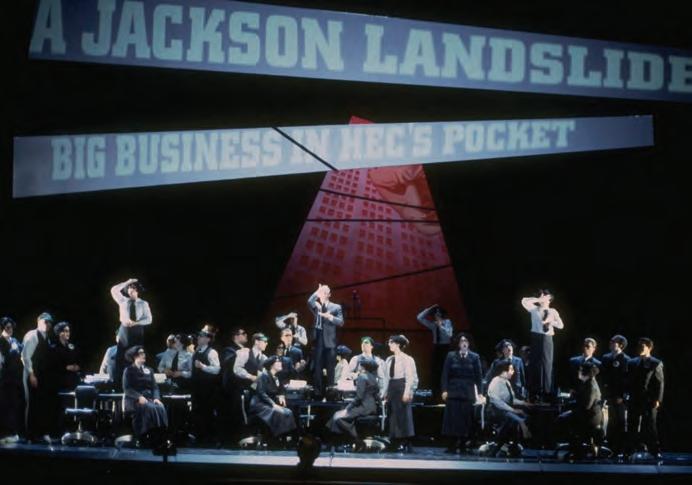

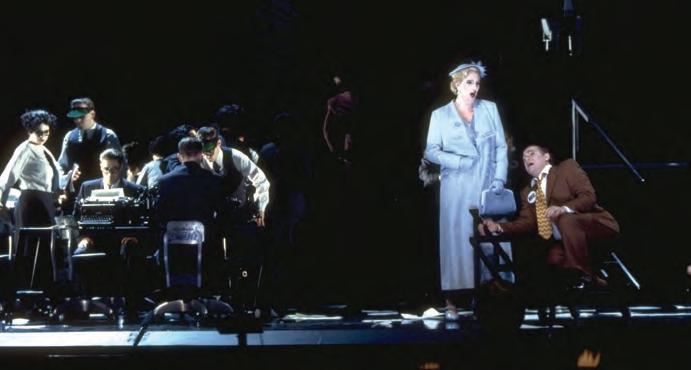
Sherrill Milnes as the wily plutocrat, Ajax, who tries to buy an election; and of the gifted young Welsh baritone Karl Draymond, making his American debut as Ajax’s presidential puppet, Hector.
The show was a big success for Minnesota Opera. It was seen by five hundred or so members of the service organization Opera America, which held its annual convention in the Twin Cities at this time. These were company managers, composers, conductors, directors, and publicists from opera companies in North America.
Contrary to plans, Transatlantic didn’t continue on to the New York City Opera the following year. Its only other complete staging since then was in Flensburg, Germany, in 2002.
SOME OPERA PRODUCTIONS AGE better than others, as do the people who watch them. Judging by the racket from behind the curtain at the Ordway on the night of March 7, 1998, as set pieces were moved back and forth, it seemed that Minnesota Opera’s production of Rossini’s Cinderella might have dated back to before the invention of the wheel.
Despite its age, this Cinderella looked just fine once the sets were noisily put in place. Jean-Pierre Ponnelle first designed and staged the production in 1969 for the San Francisco Opera, and it had seen considerable use in ensuing years. The witty black-and-white-line-drawing sets, resembling pop-up book illustrations, suggested the delicate balance of whimsy and pathos at the heart of the opera. Director Christopher Alden wisely stayed within the romantic-comic stylistic framework outlined by both Rossini and Ponnelle, which is to say that he went for charm rather than slapstick; and he was greatly aided in this respect by Vivica Genaux, whose portrayal of Cinderella combined vocal and visual allure and made her the focus of every scene she appeared in. Genaux, who made her company debut with this production and would go on to become an international star, is that rare bird, a true coloratura alto. Her voice, smooth all the way from resonant low notes to a firm high B, moved easily and fluently through Rossini’s most elaborate roulades and scale passages.
MINNESOTA OPERA CONCLUDED its thirty-fifth season with a splendid production of Tosca that opened at the Ordway May 16, 1998. The cast was strong, and the opulent scenery and costumes, on loan from Dallas Opera, were designed by Ulisse Santicchi. Elizabeth Byrne and Geraldine MacMillian alternated in the part of Tosca, Tonio di Paolo
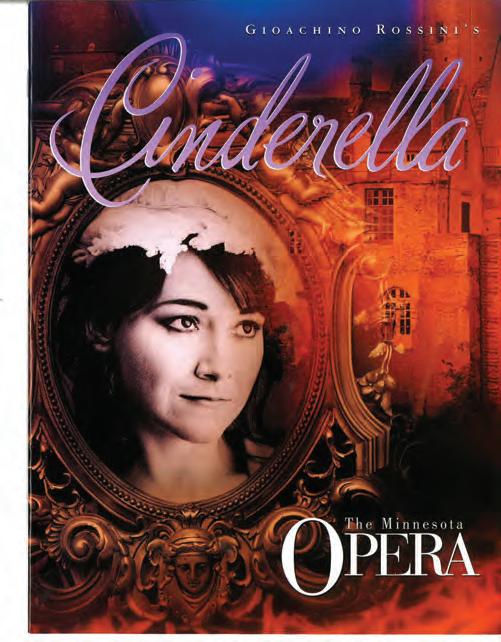
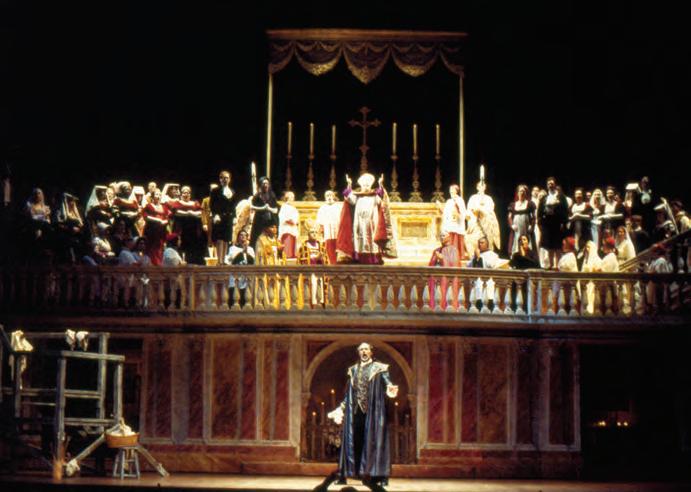
and Patrick Denniston took turns singing Cavaradossi, and two accomplished baritones, Greer Grimsley and Kimm Julian—neither of them a stranger to Minnesota Opera audiences—played the evil Baron Scarpia. David Roth directed and John Keenan conducted.
This had been one of the company’s most successful seasons. High artistic achievement matched financial stability. For the prior season, 1996–97, the company reported 101 percent of seats sold. (The extra percentage point comes from tickets bought, turned back, and resold.) Demand for tickets to Aida, the 1997–98 season-opener, was so brisk that when single tickets went on sale the company added another performance—and that, too, sold out. And in March 1998, the company announced that it had raised $11.3 million for its artistic endowment campaign, going beyond its original goal of $10 million. Launched in 1994, the fund would go toward production costs. According to company spokesperson Laura Silver, “It’s basically to make our productions bigger and better and to bring in bigger-name singers and designers.”
The company’s only failure of the season wasn’t realized until late September, when people were given the opportunity to receive Minnesota Public Radio’s broadcast of Tosca on the internet, viewing an online libretto with images relating to the story or browsing through collections of images from the production or catching interviews with the singers.
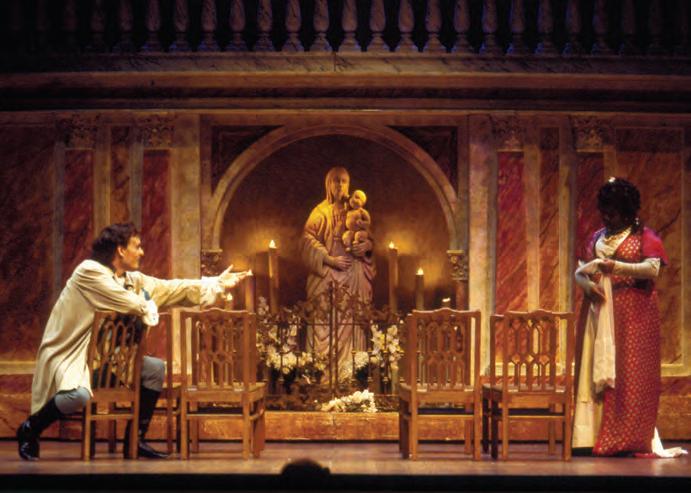

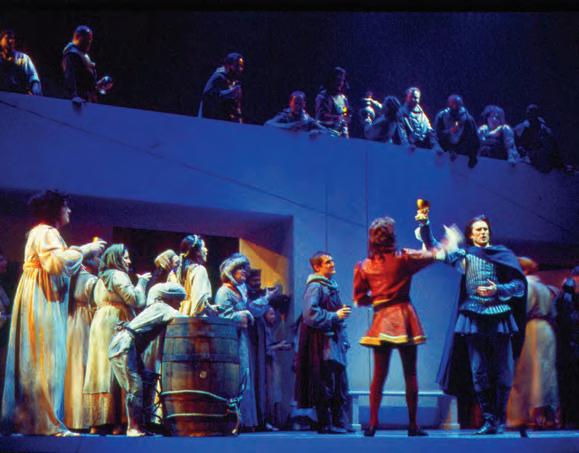

This merger of opera and the internet was so new no one was sure what to call it. “Tosca Goes Online” was one option. “The major thing is we got permission to stream the musical part of the performance from our website, so that it can be heard anywhere in the world,” said a programming director at MPR. “And while the audio quality won’t yet be CD quality, so far as we can tell, nobody has done this before for any opera house.”
Being first sometimes means you fall off the cliff before anyone else does. There were, as one wag called them, “in-opera-ble difficulties” in this bold, new, and vastly overhyped venture. The biggest problem: there was no video, only still photos. The second biggest: only one hundred users worldwide could log on to hear the audio.
FOR ITS FINAL SEASON BEFORE the end of the twentieth century, Minnesota Opera presented three works new to its repertory: Verdi’s Otello, Gounod’s Faust, and Britten’s The Turn of the Screw. The fourth offering was a revival of the company’s 1993 production of Madame Butterfly staged by Colin Graham. As part of an educational tour, the company also planned to present an alternate version of Madame Butterfly, a ninety-minute reduction of Puccini’s score for nine singers, in schools in Minnesota, Wisconsin, Iowa, and Michigan. Peter Rothstein was engaged to adapt and stage the production.
In the lore surrounding Otello, and the Shakespeare play on which it is based, is the tale of a Wild West production during which an audience member, incensed at the skullduggery of the villain Iago, leapt to his feet, pulled out a gun, and shot the actor dead. Villains have always commanded our attention in a way the good guys never do. Verdi thought about calling his opera Iago, and anyone who saw the Minnesota Opera production that opened the company’s thirty-sixth season at the Ordway January 30, 1999, with its commanding portrayal of Iago, might conclude that Verdi was right. It is Iago who sets the plot in motion, who inflames Otello’s jealousy to the point where Otello murders his innocent wife Desdemona, only to find out that he has been duped by “honest Iago.” Leah Hausman, who staged this thoughtful, though flawed, production, took this a step further. She made Iago almost a supernatural figure, or maybe the dark side of Otello’s psyche. This Iago hovered about in places we don’t usually see him— during the overture and just before the final death scene—as if he were stage-managing the events as they happened.
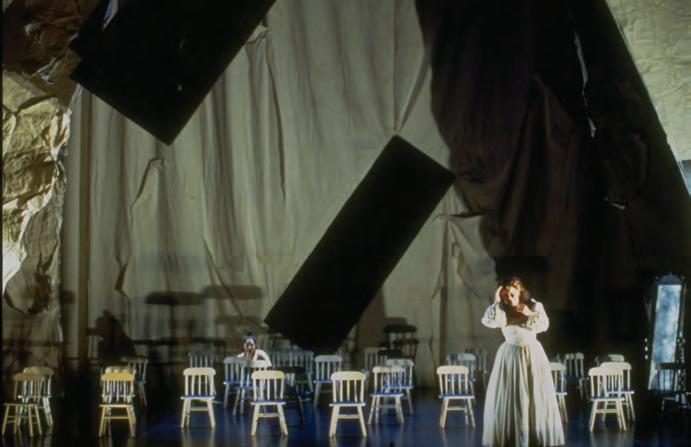

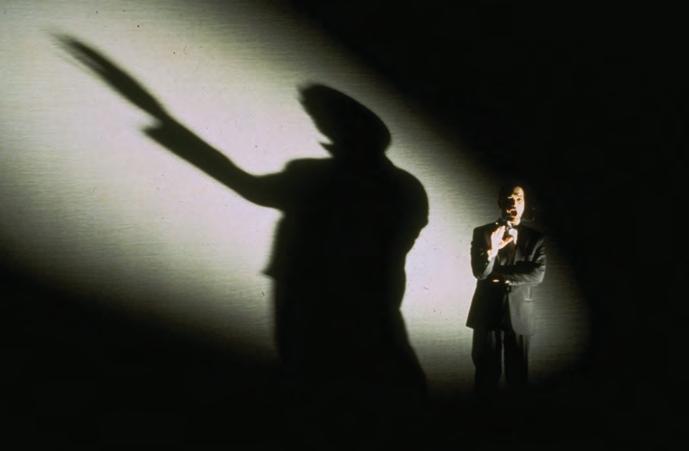
People who saw the English bass-baritone Robert Hayward’s electrifying portrayal of Don Giovanni for this company in 1996 weren’t surprised by his charismatic Iago. This was no melodrama villain but a smooth, suave manipulator, and the singer’s powerful baritone turned the “Credo” into a riveting moment wherein Iago explains that he was born to do evil. Nicolle Foland made a persuasive Desdemona, especially poignant in the “Willow Song.” The always reliable Emily Manhart sang a sympathetic Emilia. Christopher McCollum’s set, which came from the Austin (Texas) Lyric Opera, mixed abstract panels and surfaces with screens of vaguely Moorish design. Though Gale Bakkom’s costumes nicely adorned the stage, the set lacked atmosphere and caused a special problem during the act one love duet, which had Otello and his bride making love out on the street, thereby adding an extreme case of exhibitionism to Desdemona’s crime of marrying out of her class and race. Conductor John Keenan paced the music persuasively and drew lovely sounds from the lower strings of the orchestra.
GOING BACK TO THE BEGINNINGS of Minnesota Opera—the much-admired production of Albert Herring during the first season, in 1964—the operas of Benjamin Britten have occupied a small but welcome place in the company’s programming, and so it was perhaps inevitable that The Turn of the Screw, an opera based on the ghost story by Henry James, would find its way onto the Ordway stage. Like a number of Britten’s works, The Turn of the Screw deals with the corruption of innocence and the subverting power of sex. Myfanwy Piper, Britten’s librettist, adheres closely to James’s tale about a governess who accepts a job in an English country house raising and educating two orphan children, Miles and Flora. She soon encounters the ghosts of Peter Quint, the house owner’s former valet, and Miss Jessel, the prior governess. When she learns that both had close, possibly sexual, relationships with the children, she assumes that her charges are under the ghosts’ evil influence. James allows that the ghosts are manifestations of the governess’s repressed sexuality. The ghosts in the opera, however, are real, and they do sing, which makes the focus of the libretto a battle between the governess and the two evil spirits for the souls of the children.
For better or worse, David Roth, who staged the Minnesota Opera production, which is based on Mark Lamos’s staging for the Glimmerglass Opera, with designs by John Conklin, returns to James—or, more accurately, to Freud, as envisioned by Salvador Dali—and focuses on the governess’s tortured psyche, and it’s not a pretty picture. Suffering from
hysteria, Freud’s favorite malady, the governess is a hothouse of yearning, as she swoons in a big easy chair and imagines she is subject to attack from just about anyone on the premises. Even Miss Jessel makes a pass at her. Our genteel country estate becomes a surreal dreamscape, full of distorted, twisted images and non sequitur visual motifs. The design turns the story on its head—or leaves us with no story at all. With the line blurred between natural and supernatural, the ghosts lose their reality. This leaves Miles’s death at the end unaccounted for, unless that, too, is part of the dream, in which case, where’s the conflict?
IN TERMS OF STAGING AND DESIGN , the company’s production of Gounod’s Faust, which closed the 1998–99 season, was the opposite of The Turn of the Screw. The latter, a jumble of repressed sexuality and heavy breathing, spoke fluent Freud. David Roth’s Faust, on the other hand, proudly traditional and old-fashioned, wisely turned back the clock, looking like something the Met might have presented in 1950. Here was a novel idea: singers stood in one place while performing their set pieces, and the overture was played with the curtain down, as if we were supposed to actually listen to the music without having to put up with visual distractions conceived in the fevered brain of a director. And Earl Staley’s sets, created originally for the Houston Grand Opera, evoked memories of the old Victor Book of the Opera, all of it enhanced by Gale Bakkom’s attractive costumes. This was, in a word, great. It’s exactly what one hopes for in a production of Faust, Gounod’s sentimental, romanticized take on Goethe’s philosophical poem, an opera that doesn’t easily support extra images and weighty concepts, an opera that carries on as if irony had never been invented. Only in the final act, which is far more bleak in tone and focuses more on our heroine Marguerite as the victim of the tale, did Roth depart from the perfumed prettiness of the décor, and sensibly, he cut the whole “Walpurgis Night” sequence, bringing us more swiftly to the climax. What Faust fanciers crave, above all, is top-notch singing, and that’s what they got, a cast headed by the stunning Polish soprano Isabel Labuda, who sang throughout the evening with lyrical poise, articulating her French elegantly, and even delivering perfectly poised trills in the Jewel Song. Tenor Paul Charles Clarke brought freshness and ardor to the title role, singing with a firm line, ample dynamic shading, and capping “Salut! Demeure” with an effortless high C. And while there have surely been more menacing Devils in Faust productions, Daniel Sumegi gave his Mephistopheles a welcome mix of cunning and bluster


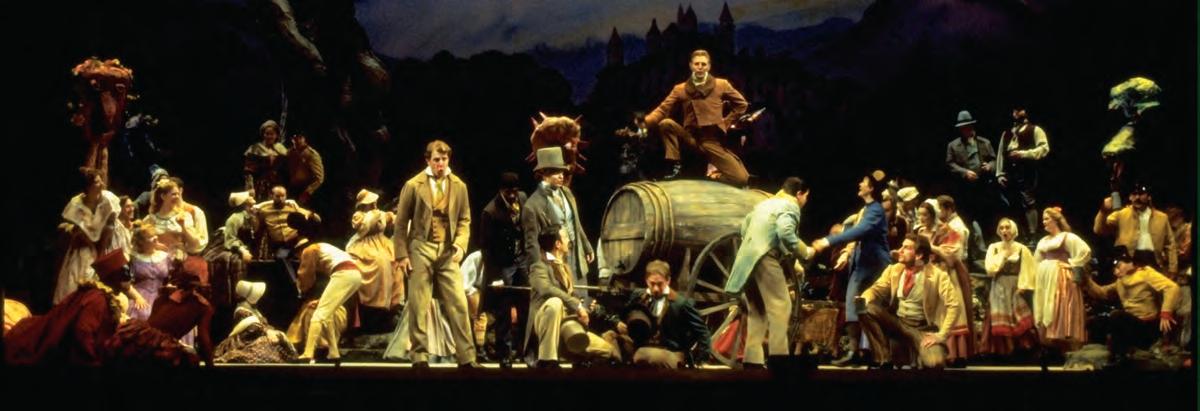
along with a touch of buffoonery. Roth’s only misstep in this fine production was giving the Devil four assistants: mimes in red leotards with veiled faces who looked like terrorists disguised as ballet dancers.
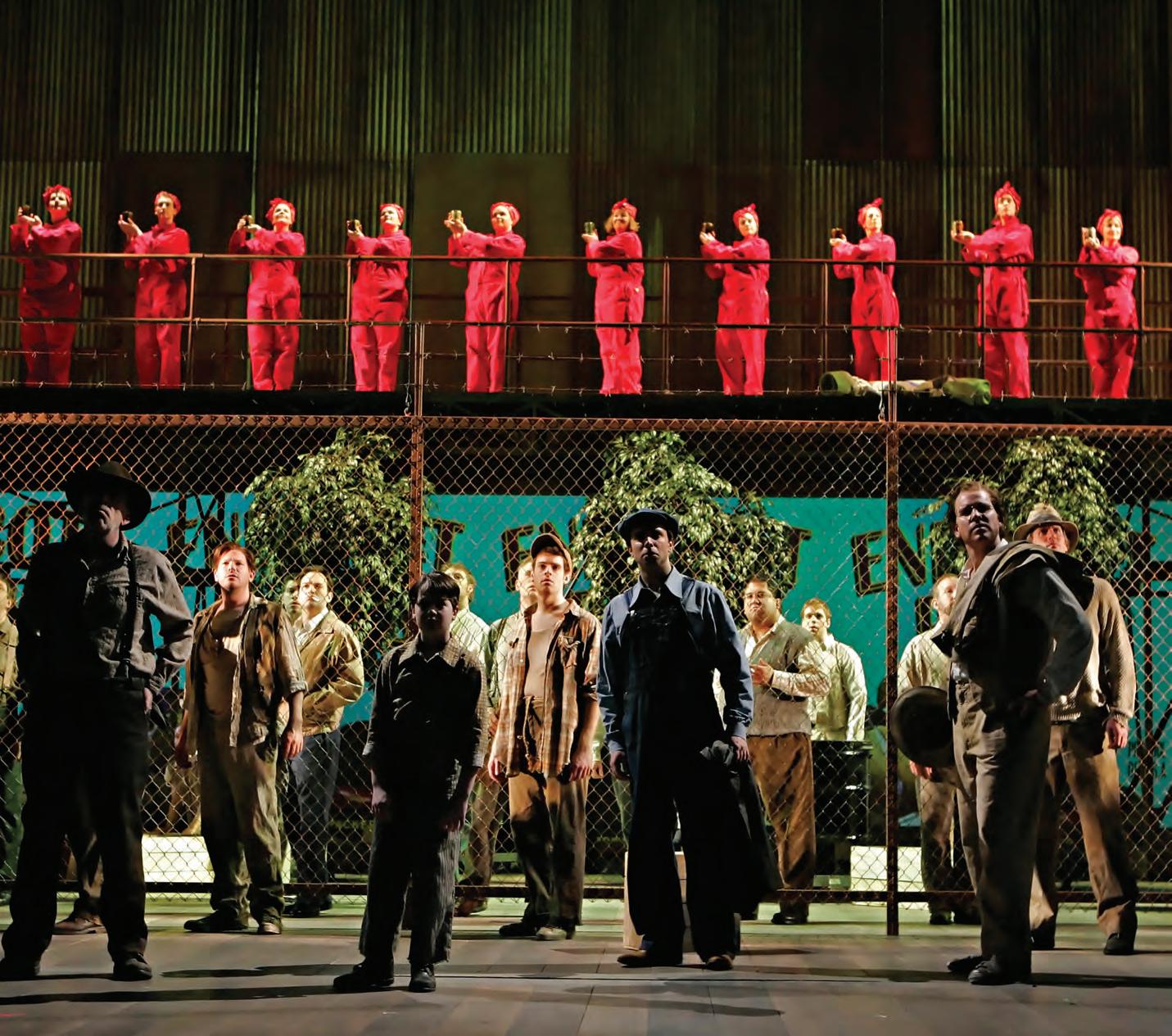
Season Thirty-Seven Season Thirty-Eight Season Thirty-Nine Season Forty Season Forty-One Season Forty-Two Season Forty-Three Season Forty-Four Season Forty-Five Season Forty-Six
BY THE TIME MINNESOTA OPERA began its fifth decade, an achievement that coincided with the start of a new century and a new millennium, the company was busy retooling itself, or so it said, articulating a new artistic philosophy inspired by the concept of bel canto—Italian for fine or beautiful singing. The term refers to the Italian repertoire of the late eighteenth and early nineteenth centuries, principally the operas of Rossini, Donizetti, and Bellini, along with a style of singing associated with that era and those composers. Rossini himself, in a conversation reported to have taken place in Paris in 1858, long after he had given up composing, named three requirements of a bel canto singer: a naturally beautiful voice that is even in tone throughout its range, careful training that encourages effortless delivery of highly florid music, and a mastery of style that can’t be taught but only assimilated from listening to the best Italian exponents.
Dale Johnson hatched the idea. Bel canto was more than a pet project of his. It was an obsession. He spoke of it in an interview in his office in 2018. “I would say that, because I was an opera coach and worked for many years as an assistant to a voice teacher, singing is the center of everything we do
here,” he said. “The bel canto philosophy was always, for me, the core of what I wanted to do, to make sure that we had the right singer singing in the right style and supported by the right conductor, by the right acoustics. I would say if there is a Minnesota Opera style, it is singer-based.”
The company had been director-based during its first two decades. H. Wesley Balk’s ideas about repertoire and performance informed the company’s identity, both as to how it thought about itself and as to how it presented itself to its audiences and to the world. This was Regietheater, director's theater, a modern practice—loved by some, hated by others—begun in Germany after World War Two. It meant allowing the director freedom to devise the way a play or opera is staged or interpreted, regardless of whether that interpretation differs from the creator’s original intent, should that be known. The director becomes not just a recreator but a creator in his own right.
An alternate view of Minnesota Opera’s earliest years is that the company didn’t evolve into director’s theater until after it separated from its parent, Walker Art Center, and that before that, under the name Center Opera, it had been something rare in opera history: designer’s theater. Perhaps we could call it “Designerintheater.” Walker’s director, Martin
Friedman, viewed Center Opera less as an arena for various forms of music theater than as a platform for the painters and sculptors he favored. He hired them to design sets and costumes for specific productions, even though most of them had never worked in the theater before. The designs, not surprisingly, were unconventional, and their connection to the operas that they were illustrating or visualizing was not always apparent.
DALE’S CHOICE TO INAUGURATE his ongoing bel canto festival, Rossini’s Semiramide, which opened at the Ordway April 8, 2000, had merit. This tale of love, murder, and incest in ancient Babylonia is a legitimate example of bel canto and an opera that hasn’t been done to death like The Barber of Seville. Dale’s casting decisions paid off nicely, especially in the two main female roles, Queen Semiramide and Arsace— roles that Joan Sutherland and Marilyn Horne famously sang back in the ’70s—here performed by Brenda Harris and Vivica Genaux. Harris was a regal queen, singing with skill and flex-
ibility (and that rarity these days, an honest-to-goodness trill), while Ms. Genaux made an intense Arsace, displaying an agility and richness of tone that recalled the young Horne. And making his Minnesota Opera debut, conductor Marco Guidarini showed an astute sense of pacing and a firm command of Rossini’s unique idiom.
Given all these felicities, why did the opening-night audience boo the director, Travis Preston, when he walked onstage to take a bow during the curtain calls? Minnesotans, it might be remembered, rarely boo anything. The last time— and perhaps the only other time—a Minnesota Opera audience booed, was for another director, Wesley Balk, for his unconventional 1983 Lucia. The tendency in productions of Semiramide has been to treat it as a singers’ opera, given that it’s hard to take seriously a story about a young warrior, Arsace, who, in echoes of Oedipus and Hamlet, seeks to avenge the murder of his father and very nearly marries his mother, the queen Semiramide. Preston took the story seriously and gave it a life of its own. He updated the action
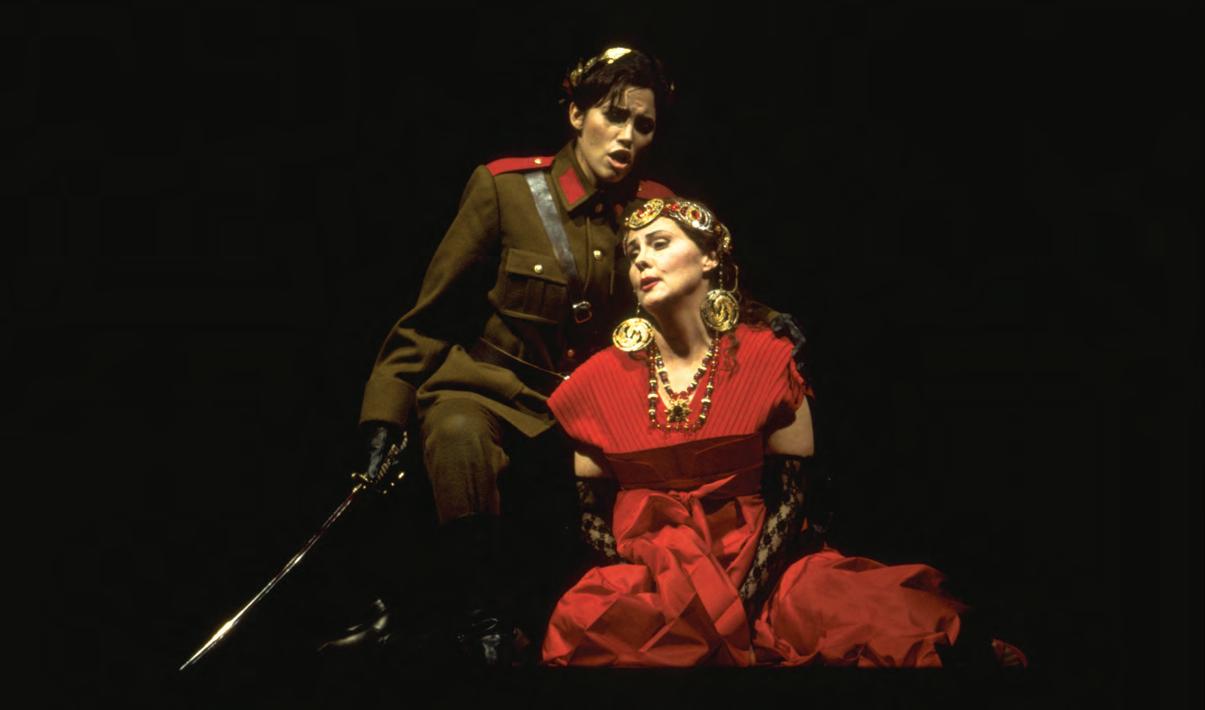
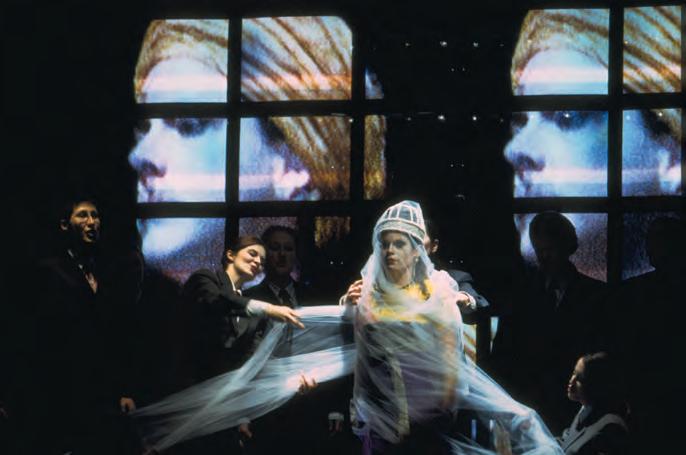

to just after the Russian revolution and filled the stage with images from Soviet Constructivist art but with a postmodern twist that deliberately mixed up our time sense, drawing us into the story while at the same time distancing us from it.
To be sure, some of this was interesting to look at. Assur, our villain, in a powerful performance by the Israeli bass Denis Sedov, enacted his mental breakdown in the center of a half circle of spotlights, and only gradually did we notice the ominous figures standing behind the lights. It was intriguing, too, to see tenor Bruce Fowler’s face on thirty TV screens as he sang Idreno’s big second-act aria, a number that is usually cut—and should be, because it stops the action dead. Many of these staging ideas and conceits got in the way, however, serving to distract from the music and failing to illuminate either the character or the situation. Moreover, the Soviet setting offered little or no sensible context for the period of Babylonian history that Semiramide depicts.
Dale Johnson said, “I thought this was the most magical singing. With Marco Guidarini conducting the SPCO and with Vivica and Brenda and Denis Sedov, the Russian bass, this was some of the best singing in the world on those particular nights. But we miscalculated on the production. The video repetitions were just too much. But, you know, you get to a certain point and it’s full speed ahead. You can’t fix it.”
Brenda Harris agreed, saying:
It was very controversial, that production. Half the audience absolutely loved it and wrote in about it, and the other half hated it and did the same. I love that it got such a reaction. It got people excited in one way or another.
That was one of my earliest bel canto roles. I owe Minnesota Opera for such a big, beautiful chunk of my career in bel canto because I dragged myself kicking and screaming into that world, and I don’t know if I would have gotten into it if Dale hadn’t pushed me. You know, other companies imitate Minnesota Opera all the time. Would the Met be coming back with a big bel canto push if Minnesota Opera hadn’t been so successful doing it? Would they be doing their new composers thing if Minnesota Opera hadn’t had its New Works Initiative? They were always looking for the cutting-edge thing.

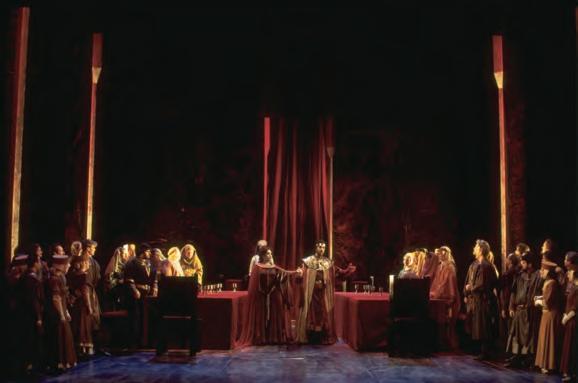

As far as the remainder of the company’s thirty-seventh season, there was much to admire, starting with the great American bass James Morris’s compelling portrayal of the title role in Verdi’s Macbeth, which opened February 26, 2000. Morris pretty much owned the role at this stage of his career, though it had been five years since he had sung it. (He was also at this time the preferred Wotan in Wagner’s Ring.) In an intriguing staging by Jonathan Alver, Morris dominated the stage, delivering a portrait of dignified torment, a man wracked by the consequences of his ambition and, on opening night, a singer in full control of his large-scale bass and sensitive to every nuance in the score. And for her part, Suzanne Murphy’s Lady Macbeth effectively conveyed the notion of a behind-the-scenes manipulator in high places,
a Nancy Reagan type. Concerning the Weird Sisters, Alver took the view that they’re not real creatures but phantoms of Macbeth’s fevered imagination—they actually hand him the knife with which to kill Duncan, the king. This was sensible, though costume designer Janice Pullen (aided by Gail Bakkom) dressed the sisters in green leotards, which made them look like tadpoles, and, let’s face it, tadpoles don’t scare anybody.
THE SEASON HAD OPENED with a production of Der Rosenkavalier on the Ordway stage the night of January 22, 2000—in Richard Buckley’s flexible, eloquent conducting, in Sandra Bernard’s detailed, thoughtful staging, and in the often-illuminating portrayals of the opera’s complicated

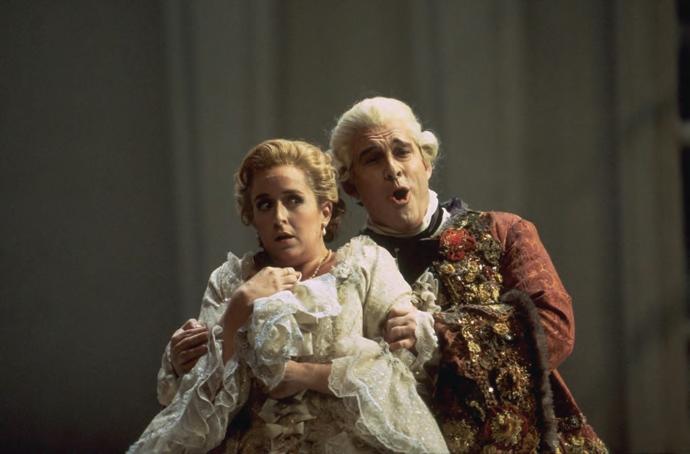
principal characters, one of which was Yvonne Kenny in the role of the Marschallin. This was a compelling characterization, nonetheless, quite convincing as the noble Viennese princess who knows that her passionate affair with Octavian, her seventeen-year-old cousin, must end, and that for her—and for Octavian as well—there will be other young lovers waiting around the corner. As Octavian, Emily Manhart effortlessly embodied the impetuous young count in the first act, and conveyed the aura of a romantic young hero in the Presentation of the Rose in the second act. Elisabeth Comeaux as Sophie soared exquisitely in the rapturous vocal flights of the second act and conveyed a welcome aura of plucky rebellion when disappointed by her rude suitor, Baron Ochs. And here was the evening’s most novel characterization, Peter Rose’s Ochs, a role usually played as if the Baron were a Viennese hillbilly. Rose did away with all the standard buffoonery. The Baron is a vulgarian, to be sure, but he’s also a nobleman. He’s used to getting what he wants, and he’s also a man with a streak of meanness in him. Rose conveyed all that. His voice wasn’t the barking basso we’re accustomed to in this part, but he sang with ease in the proper parlando style and even hit the final note in act two, a low E, with real resonance. The season was rounded out with productions of Macbeth, Semiramide, and The Marriage of Figaro
THE COMPANY PICKED UP the bel canto thread a year later in January 2001, with a fine production of a rarity, Bellini’s The Capulets and the Montagues, which is based on Shakespeare’s Romeo and Juliet. The opera lacks Shakespeare’s subtlety of plot and characterization, but it moves quickly and has nicely written set pieces, many of which Bellini, under intense deadline pressure, lifted from his own earlier works. The key to presenting it successfully is finding two strong vocal and dramatic presences in the lead roles. Without that, the opera falls flat, and no amount of clever direction or inspired batonwaving can save it. The most admired pairing in these roles in a prior decade was Beverly Sills and Tatiana Troyanos, and happily, Minnesota Opera engaged two equally compelling performers, the Alaskan-born mezzo-soprano Vivica Genaux and the Korean soprano Sumi Jo. Remembered fondly for her forceful Arsace in the previous season’s Semiramide, Genaux put forth an ardent Romeo, a fiery young warrior whose intense love for Juliet takes over his life. Genaux sang with fresh tone and unforced power, delivering even the role’s more florid writing clearly and evenly. Singing the part of Juliet, Jo portrayed a young woman both vulnerable and sensitive yet determined to choose honor over love until, at the end, love wins out. And she, too, showed absolute ease singing the most elaborate roulades, shading the vocal line delicately and climbing with no effort to a high C, hitting the note dead center.
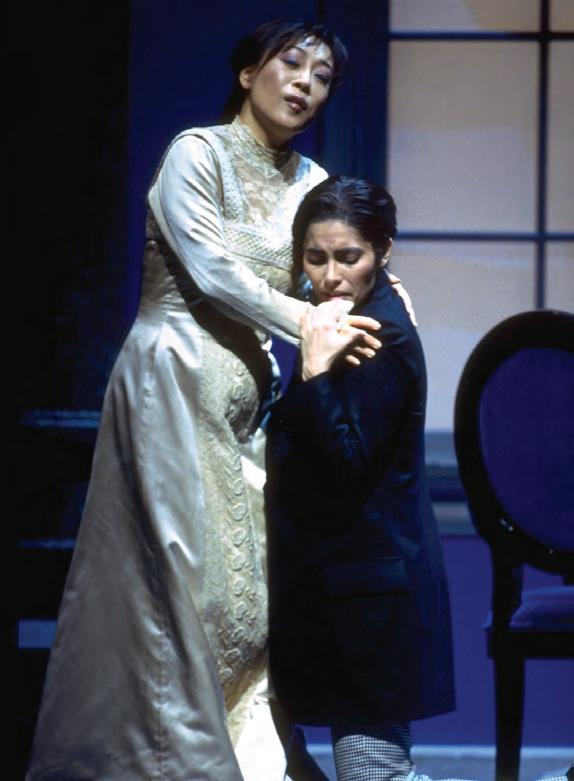
The production, scheduled to go to the New York City Opera the following season, having had its premiere in Los Angeles, moved the action to early twentieth-century Italy, adding hints of Mussolini and protofascism. The attractive sets by Robert Israel, whose career as a designer began in the early days of Center Opera, veered more in the direction of abstraction and geometry—modular columns, scrims, and rear-screen projections. Director Thor Steingraber moved his characters and his crowds fluently and smartly and with nice touches of style, though even he couldn’t keep the Tybalt-Romeo duel from looking silly, proving that old military adage: “Never try to sing during a sword fight.”
Unlike the previous exercise in bel canto, the largely unlikable Semiramide , this one, The Capulets and the Montagues , provoked no angry letters or phone calls. And no one booed.
THE COMPANY’S 2000–01 SEASON , its thirty-eighth, offered for the first time five mainstage productions rather than the usual four. One of these was a first-rate production of Kurt Weill’s Street Scene, which had opened on Broadway in 1947. Weill considered it his finest work for the stage, and it’s a mystery as to why it isn’t done more often. Certainly this production, created for the Houston Grand Opera in 1994, with its strong cast and persuasive staging by Michael Ehrman, made a good case for the composer’s assessment. There were a few bumps in the road, nonetheless. Conductor Rob Fisher displayed an aptly expansive feeling for the romance in Weill’s score, but the up-tempo numbers needed more rhythmic bounce. On a brighter side was Adrianne Lobel’s amazingly detailed set, a tenement rising as far as the eye could see, a structure that almost became a character in the show, a prison of the spirit for the young romantic leads. One of them was Rose Maurrant, played so winningly by Elisabeth Comeaux. The other was Sam Kaplan, given just the right sort of achingly ardent sincerity by Brandon Jovanovich, who sang a sweetly nuanced rendition of the haunting “Lonely Town.” The other couple was equally appealing. As Anna Maurrant, Maria Plette, with her pliant dramatic soprano, embodied the frustrations of a bad marriage and a carload of dreams deferred in “Somehow I Never Could Believe,” while Kimm Julian etched a complicated portrait of the tormented Frank, whose growing anger masks his fear of a changing world.

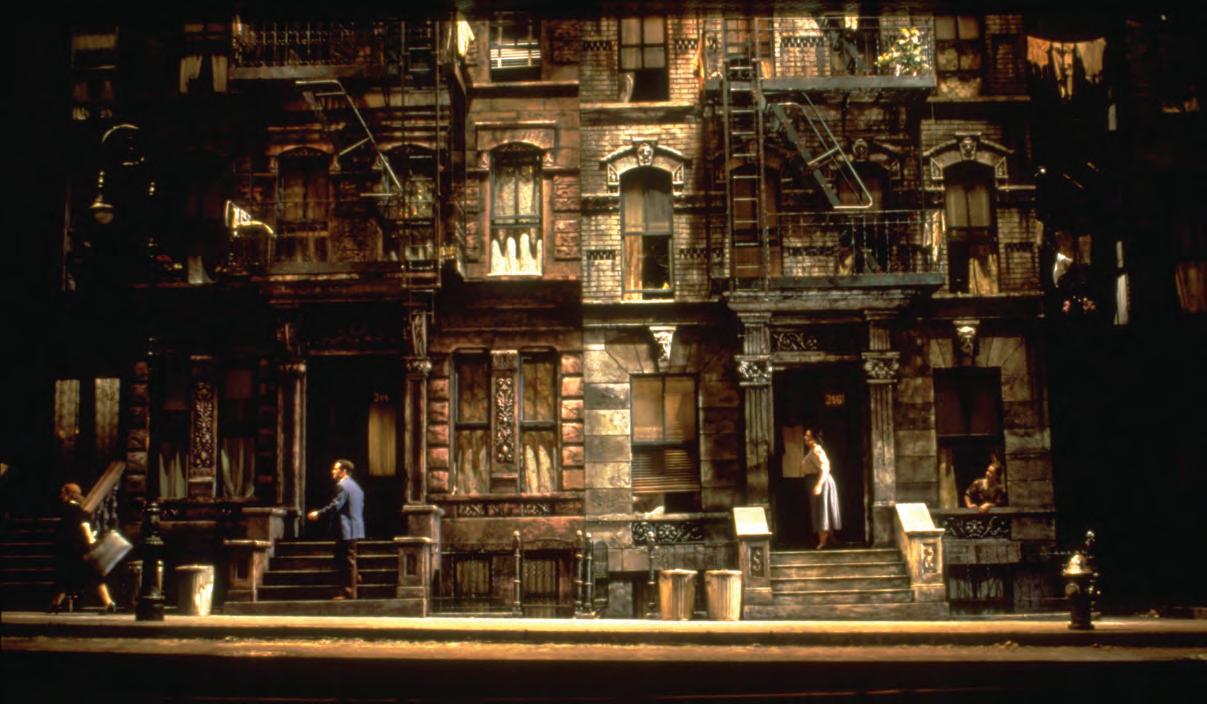
THE REST OF THE SEASON included two successful productions, Turandot and The Barber of Seville. The first is notable because it marked Ryan Taylor’s debut. A pairing of Pagliacci and Carmina Burana opened on May 12, 2001. The first one is Leoncavallo’s sweaty verismo opera about marital infidelity and crying clowns; the other is Carl Orff’s popular oratorio, a collection of lusty medieval-inspired songs arranged for orchestra, chorus, and soloists. The veteran director Christopher Mattaliano created this double bill in 1997 for the Portland Opera and BodyVox, a Portland-based dance company. He linked the two works. Nedda and Silvio, the lovers killed by the jealous Canio at the end of Pagliacci, are brought to life at the start of Carmina and then gently led offstage, as if by attendants in some sort of afterlife. The two reemerge as the baritone and soprano soloists of Carmina, and they don’t shed their Pagliacci identities until the very end. The thread between the two works is more a theme than a narrative, the idea of fate or luck (“Luck, empress of the world,” sings the chorus) and how we’re tempted and teased not just by Dame Fortune but by the promise and temptation of love—lust, in the case of the medieval poems. Carmina became more like a rumination on Pagliacci than a continuation of it.
Mattaliano had a strong cast to work with. Tonio di Paolo was an unsubtle but honest Canio, a figure gripped by insane jealousy. His powerful tenor with its ringing top notes reached a peak, both dramatic and musical, in a gutsy “Vesti la giubba,” which stopped just an inch short of hysterical. Rosalind Sutherland added a welcome touch of playfulness to Nedda’s numerous mood swings, and her big, agile voice was used to good effect in every scene. Kimm Julian managed to turn the hulking Tonio into a desperate and ultimately sympathetic character. As for Carmina, BodyVox’s precise but earthy dancing, highlighted by the fluid work of dancerchoreographers James Hampton and Ashley Roland, kept the second half of the program afloat.
ARE THE MARCH SISTERS—Jo, Meg, Amy, and Beth—as well known as the Marx Brothers—Groucho, Chico, Harpo, and Zeppo? (It’s so easy to forget Zeppo.) Who can say for sure? Little Women, Louisa May Alcott’s novel about the tribulations of the March family during and after the Civil War, is

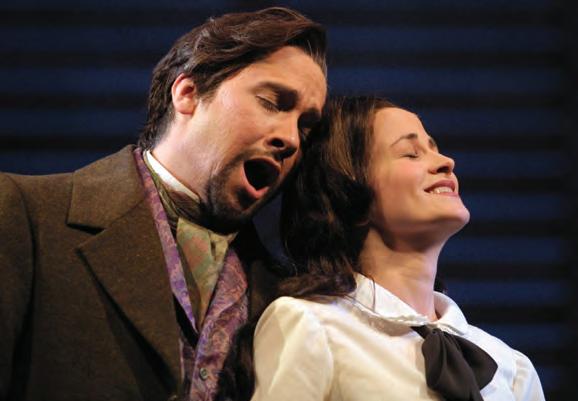

probably not as avidly read by teenage girls, or anybody else, as it used to be, and the various movie versions of the book haven’t been recast as classics the way the Marx Brothers movies have. Add to this Alcott’s sentimentality and greetingcard moralizing (“Poverty enriches those who live above it”), qualities that don’t go over as well as they used to. When Marc Adamo, a young composer from New Jersey, was asked if he would be interested in writing an opera on Little Women, he turned it down, saying it would be about as interesting as one on the life of William Howard Taft. Three years later, in March of 1998, Adamo had composed an operatic version of the Alcott novel, set to his own libretto, and the opera, commissioned by the Opera Studio of the Houston Grand Opera, had been premiered to wide acclaim. The thirty-six-year-old composer was suddenly a star in the opera world.
By 2002, when Minnesota Opera staged its own production of Little Women, a collaboration with the Indiana University Opera Theater, the opera had been presented on both National Public Radio and PBS, and eight new domestic productions were scheduled through 2003. (By 2021, the number of productions around the world had risen to sixty-five.) In Adamo’s version of the story, Jo is the central character, and the spine of the plot becomes her struggle with the past. She tries to retain the idealized world of her childhood, only to be forced, through the death of her sister Beth, to accept the reality that everyone else, including her other sisters, has managed to outgrow their sheltered existence. Two musical themes, “Perfect as we are” and “Things change,” are threads out of which the whole tapestry of the score is woven, building to what is almost a vocal symphony in the sextet that closes act one and is referred to again in the opulent Richard Strauss–like quartet for the four sisters that concludes the opera.
Colin Graham’s thoughtful staging of the show, which opened at the Ordway April 13, 2002, made more of the work’s comic elements than was the case in the Houston production that was televised. Rich old Aunt March, played amusingly by Dorothy Byrne, nods off during Meg’s wedding, and earlier there is considerable laughter in the tutor Brooke’s clumsy attempt to propose to Meg. The cast was excellent. Voices soared and blended as the score shifted effortlessly from arias to ensembles. Deanne Meek unveiled a great deal of Jo’s complexity and restlessness and sang with assurance throughout. Ana Rodriguez made Beth’s death scene touching rather than maudlin. Genevieve Christianson proved to be a cute and feisty Amy, and Adriana Zabala was a strong, vocally adroit Meg. Robert O’Hearn’s first-act set seemed
overly spare, but there were nice touches in the second act. Conductor Jeffrey Domoto drew rich sounds from the orchestra and gave special weight to the score’s lyrical passages. And it was an encouraging sign on opening night that Adamo, who joined the cast onstage during the bows, received the biggest applause of all—a standing ovation, in fact.
ONE OF THE SURPRISES of Minnesota Opera’s 2001–02 season was that opera seria, that stately, sometimes static form of music drama that ruled Europe through the first half of the eighteenth century, is big box office. The company’s production of La clemenza di Tito, Mozart’s exercise in this baroque form, didn’t just sell out at the Ordway. It sold 102.3 percent of capacity, due to turned-back tickets being resold. Apparently, people today like those obvious melodies of old-fashioned cut. And they also liked Minnesota Opera’s strong production of the work staged by Stephen Lawless and conducted by Harry Bicket that opened at the Ordway January 26, 2002.
As is the habit lately in productions of this work, Lawless and his designers, Benoit Dugardyn (sets) and Sue Willmington (costumes), updated the story to the time of its composition, the era of the French Revolution, when Europe was hopeful—and worried—about the possibility of an enlightened monarch. This allowed Titus (Tito), the clement Roman emperor, to be seen as Leopold II, and for the brilliantly bright stage lighting at the end of the opera to symbolize the dawning of the Enlightenment, an era of rationality and progress, a notion that Mozart would have applauded. Lawless had a fine cast to work with, and some of the characterizations were unusual. Instead of playing the opera’s villainess, Vitellia, as a scheming shrew, Brenda Harris underlined the character’s vanity to the point where it became comic, which made her big final aria especially effective as an exercise in self-examination, all of it sung with expert agility and gleaming high notes. Sesto, portrayed with winning conviction and great vocal allure by Susanne Mentzer in her debut with this company, is the opera’s hardest character to realize. As Vitellia’s love and Tito’s friend, Sesto is torn between love and moral duty. Sesto is a wimp, but Mentzer turned him into a sympathetic wimp, truly stymied by the jam he’s in and quite touching in his demanding final aria. Bruce Ford was a commanding but never stiff Tito, kind-hearted and genuinely baffled by Sesto’s betrayal, and his singing was always fluent, firmly supported, and lyrical. Harry Bicket, no stranger to this opera, gave the music a sense of urgency while supplying sensitive support for the singers.
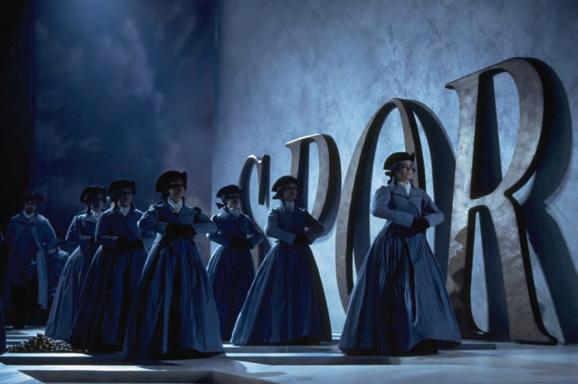

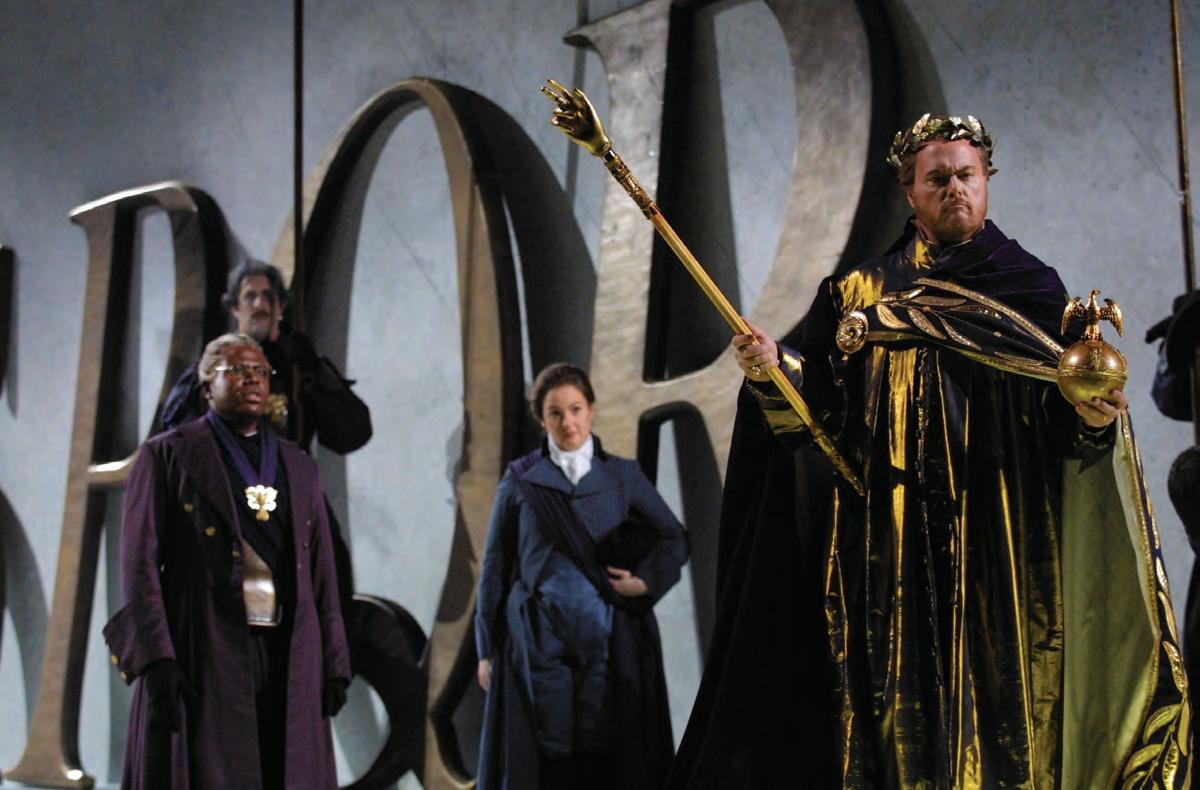
FOR THE FINAL PRODUCTION of the season, Minnesota Opera took on Don Carlos, the most dramatically challenging of Verdi’s operas, a dark, sprawling, quasihistorical look at sixteenth-century Spain through the conflict between King Philip II and Carlos, his rebellious son, set in the context of the Spanish Inquisition. The production, on loan from Opera North, a company in Leeds, England, had sets by Hildegard Bechtler that were almost uniformly ugly. Bechtler aimed toward abstraction—huge standing slabs that looked like hardened chewing gum. The ladies-inwaiting sang in act two of trees and a fountain, but there was no fountain. Carlos’s prison in the final act was yet another gray slab, but there were no walls, so we presume it’s a minimumsecurity prison. Clearly, mood rather than place was the goal, a mood of gloom and despair brought on by the tyranny of both church and state. And to Bechtler’s credit, she did come up with a stunning picture at the end of the first act: an autoda-fé of flames and smoke with the condemned heretics, all young girls, climbing a ladder, a visualizing, presumably, of their souls rising to heaven or somewhere nearby. What Verdi, who was an agnostic, would have thought of this can be debated. And yet, this turned out to be a powerful production. The cast was more than up to the task, dramatically and vocally, and director Tim Albery managed to infuse the key scenes with such passion and commitment that the

story, complicated as it is, came alive. He managed, too, to heighten the sense of oppression enforced on the people in this unjust society: the rough handling of the peasants by the hooded henchmen of the Inquisition and the way the peasants reach out to touch the queen during the processional, much the way fans today gather to watch—and maybe even touch—movie stars as they parade into award ceremonies. Indra Thomas was a striking Elisabeth de Valois, beloved by both father and son, Philip and Carlos, a dignified and most human portrayal that scored all the right vocal points. Paul Charles Clarke made an ardent and winning Carlos, giving the character just a hint of mental instability. Jason Howard, as Carlos’s idealistic friend Rodrigue, displayed a warm, even-timbred lyric baritone and a convincing character. Especially impressive was Dean Peterson’s commanding and complex embodiment of Philip, the tragic, tortured king who feels he can trust no one. Conductor Marco Zambelli paced the proceedings with skill and understanding and drew impressive singing from the chorus. Of the many editions of this score, Minnesota Opera used the four-act version of 1884, which eliminates the original first act, thereby losing the explanation of the story’s central conflict. It was still a long evening, nearly four hours with just one intermission. Yet the performances were so compelling that the time moved quickly.


MINNESOTA OPERA opened its fortieth season November 9, 2002, with a turn toward the light and festive, The Merry Widow, the world’s most popular operetta—and this time the production really was light and festive. The company had tried to go in that direction at the end of the 1993–94 season, offering audiences a major rewrite titled The Merry Widow and the Hollywood Tycoon, which moved the action from turn-ofthe-century Paris to Los Angeles in the 1930s. However, given the absurd characters, lifeless staging, and ugly set, many in the audience, so it was said, considered it a distinct disadvantage to be facing the stage.
The new Merry Widow, on loan from the Utah Opera, wisely returned the setting to Paris, offering Chuck Hudson’s breezy and clever staging and Michael Matthew Ferrell’s witty choreography along with engaging performances by tenor Jeffrey Lentz (Camille), soprano Elisabeth Comeaux (Valencienne), baritone Karl Draymond (Danillo), and soprano Maureen O’Flynn, who gave us a shrewd, sophisticated Widow, well sung on opening night despite a throat infection announced before the show.

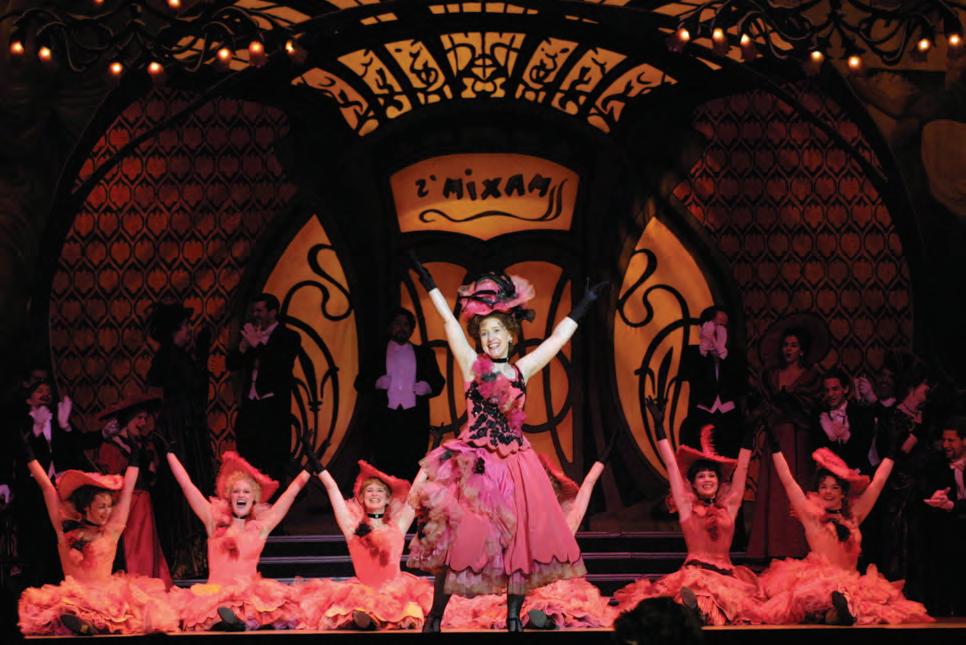
THE REMAINDER OF the 2002–03 season offered the American premiere of The Handmaid’s Tale and two revivals: Norma from 1990 and The Flying Dutchman, first seen at the Ordway in 1992. The replay of Norma, which opened at the Ordway January 25, 2003, was an improvement on the original staging of the production, chiefly because the two main female roles were performed with such force and finesse as to practically leave one breathless. Singing the part of Norma, that almost impossibly demanding dramatic coloratura soprano role, Brenda Harris managed to realize, with almost equal allure, the three conflicting characters that exist within Norma: mother, priestess, and lover scorned. And vocally, too, she proved to be a near-master of the role’s rainbow of colors, getting the proper steel in her voice in the opening scene, where she reigns as priestess, but later turning soft and vulnerable, floating shimmering top notes in her scenes with Monica Colonna, who sang the part of Adalgisa, the “celestial virgin.” The finest moments on opening night were the two big female duets: Norma, who has borne two children in secret to Pollione, proconsul for the conquering Romans, and Adalgisa, the temple virgin for whom the Roman has abandoned Norma. Colonna, beautiful and appealing onstage, never lost control of the florid line or the broad dramatic contour of the character. Director Casey Stangl added a few touches of her own—hints of ritual movement from the chorus, for instance—to the original production, which was staged by Christopher Mattaliano, and she knew how to focus the essential conflicts. The best that could be said about Allen Moyer’s set this time around is that it left plenty of room for the action since it offered no mood or atmosphere. The all-important sacred tree was a piece of wood dropped horizontally over an expressionist slab that was supposed to be an altar, and where Norma should have a rather spectacular entrance, she was simply there already with her back to the audience, suggesting that this could have been simply a concert in costume, except that James Scott’s costumes for the male druids were odd: a mix of Star Trek and Che Guevara’s guerrilla outfits.



IN KEITH WARNER’S quasi-novel concept for The Flying Dutchman, which opened February 22, 2003, it is Senta rather than the Dutchman who is the active agent. It turns out that Senta dreams the whole story. This is moderately believable, though it should be admitted that few of the characters in our dreams ever sing for three or four hours nonstop, and almost never in German. There’s no denying, however, that Warner’s idea is more politically correct, given Wagner’s lifelong obsession with the notion that a woman’s function is to sacrifice herself for the man in her life. Instead, in this case, Senta is a bold young woman, rebelling against the confines of her bourgeois life in a Norwegian fishing village and fantasizing about the Dutchman who represents for her, not enslavement, but liberation, even though liberation might mean death. This justified, if one wants to be generous, the blandness of Warner’s set—Senta’s trapped within the walls of a gloomy world. And at the end, this world—or is it her psyche?—shatters. The set literally pulled itself apart, revealing the demons beneath, an image Freud would have appreciated. David Roth, who took over the staging for this revival, handled all this with considerable skill. His Senta, the fine young Finnish soprano Eilana Lappalainen, played the role as if possessed, relating to the Dutchman’s painting the way a young girl today might gaze at a photo of Justin Timberlake. Roger Roloff was the impressive Dutchman in 1992; here it was Greer Grimsley. Apart from James Morris, Grimsley, with his powerful, resonant bass-baritone and compelling stage presence, was at this time probably the chief exponent of the role. A menacing figure in a black cape, throwing off a hint of Mephistopheles to say nothing of Dracula, Grimsley added desperation to anger in his big opening aria, so commandingly sung, and he continued, offering a portrayal both subtle and full-bodied. Conductor Guido Johannes Rumstadt brought a welcome sense of flexibility and flow to Wagner’s throbbing music.
DO WE DO WHEN fundamentalist Christians take over the government, kill the president and the members of Congress—an atrocity they blame on Muslims—and then annul the Constitution and set up a brutal theocracy called the Republic of Gilead in which women are enslaved and brainwashed and “the eyes of God are everywhere”? What we do is we head for Canada, specifically, Toronto, where Margaret Atwood lives. Atwood, after all, wrote the novel, The Handmaid’s Tale, that describes this dystopian society, certain elements of which might be taken from today’s headlines. Published in 1985, and showered with
awards, the book was made into a feature film five years later with Natasha Richardson and Faye Dunaway in the main roles, and in 2000 the Royal Danish Opera premiered an opera version by Poul Ruders with a libretto by Paul Bentley. Three years later Minnesota Opera gave the work its North American premiere in a stunning production staged by Eric Simonson with sets and costumes by Robert Israel. Atwood, who was present at the Ordway on opening night, May 7, 2003, said she wrote The Handmaid’s Tale in response to the rise of the Moral Majority in the United States along with the emergence of Islamic fundamentalism and the policing of birth rates in Romania and China. In Atwood’s Christian republic, women have been deprived of education, property ownership, and civil rights. Men have returned to their traditional roles of warriors, while women, at least those who remain fertile after the proliferation of nuclear waste, become breeders or “handmaids,” a reference to the handmaid in the Book of Genesis who fulfills this function for the barren Rachel. Once a month the handmaids are impregnated by the husband while they lie between his wife’s legs.
Asked whether he had come to see The Handmaid’s Tale as a forecast come true, Ruders said in an email from Copenhagen that he hopes we’re not in the time of Gilead. “But the spirit has never been more willing among the extreme Christian right in the United States, and Puritanism has always been a potent feature in America all the way back to Plymouth Rock. But intolerance is a global affair,” he added. “The particularly gruesome regime of the Taliban in Afghanistan is a living version of Gilead, albeit more primitive.” The opera doesn’t try to tone down Atwood’s vision. There are images of the White House exploding, of women being forced to look at pornography to appreciate their newfound security, and of Offred, the main character, sung and acted with compelling grace by mezzo-soprano Elizabeth Bishop, who has both sex and a gynecological exam onstage. The women, the handmaids, lose their own names. Instead, they’re named for the men who own them. Offred is of-Fred.
Ruders’s score is wildly eclectic, ranging from an intense, brutal expressionism to soft, pulsating minimalist touches. In one scene he uses “Amazing Grace,” distorting it to capture the twisted fervor of the fundamentalists. In the new world order, the hymn has become the national anthem. It’s played as Offred is being forced to have sex with the Commander, her hands held back by his own wife. Ruders’s orchestration, which makes use of digital sampling and thunder machines, dazzles with color and detail and peaks in the second-act nightclub scene, where big-band jazz is thrown into the mix.

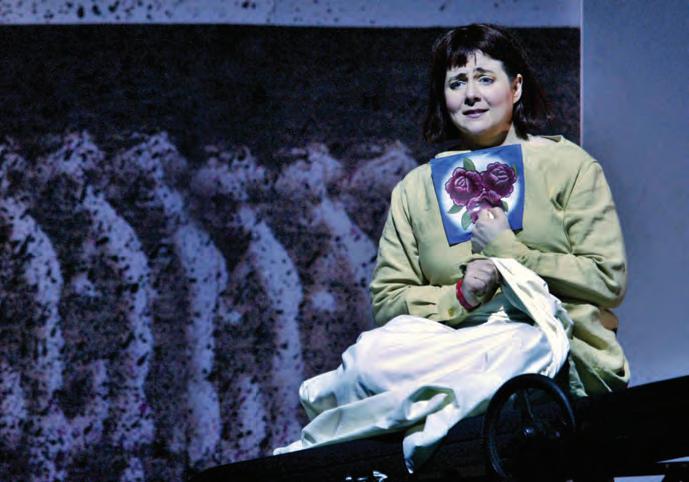
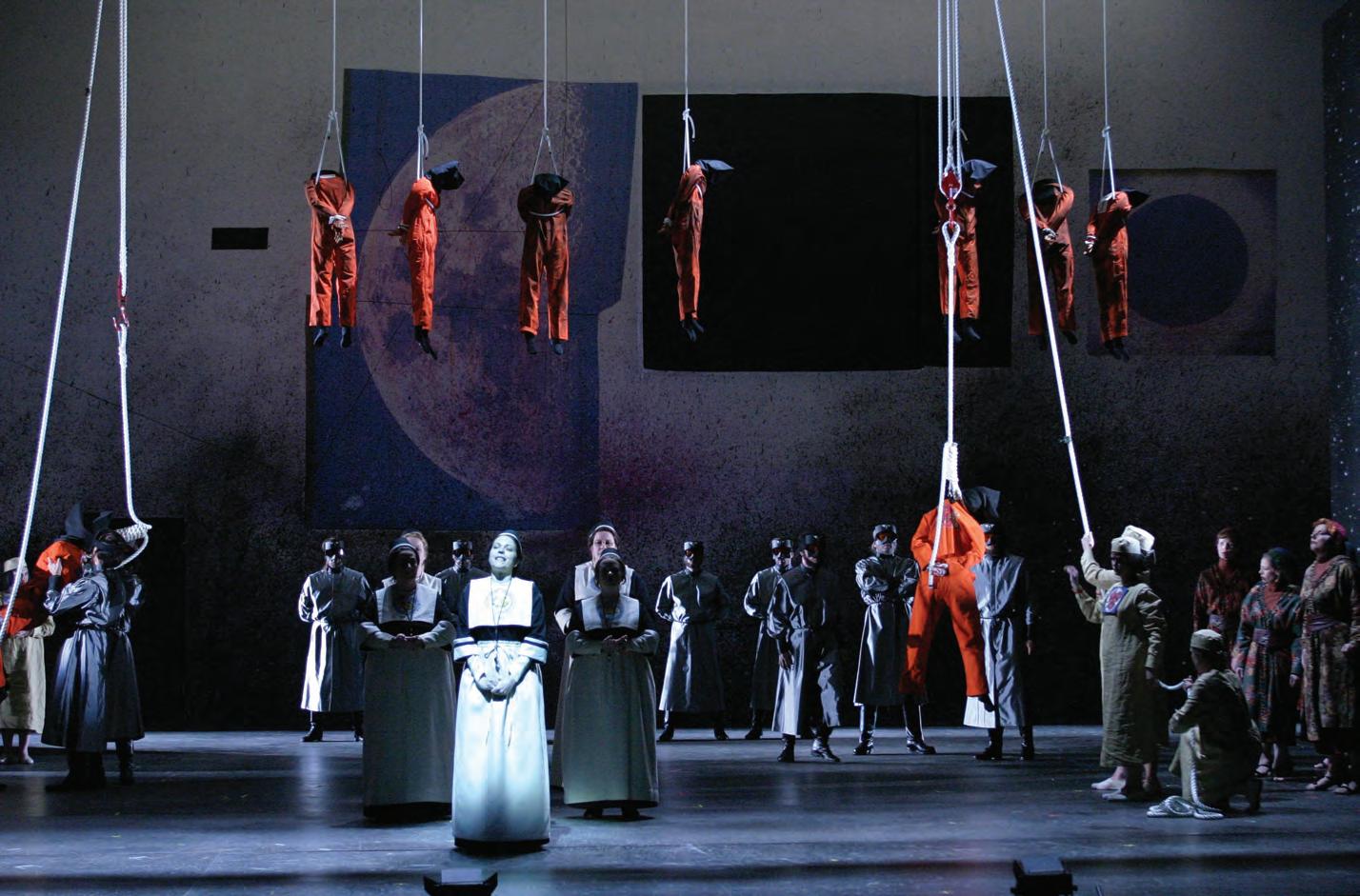
Staging a work comprising fifty short scenes and three timelines was no small challenge, but Simonson and his team met the challenge capably, bringing to life a world of paranoia, subterfuge, and brutality where divorce, abortion, and homosexuality (“gender treachery”) are capital crimes, and managing to turn it all into darkly compelling theater. Robert Israel came up with the inventive postmodern sets that included wall paintings that dripped with irony, so to speak: the Madonna and Child mural above the heroine’s bed and, later, a painting of Dante and his guide Virgil going to hell in a small boat. The excellent cast included Gabor Andrasy as the lust-driven Commander and Joyce Castle as his wife Serena Joy, a former televangelist.
The Handmaid’s Tale was a large success for Minnesota Opera, a distinctive production of a thoughtful albeit grim new work that had then—and continues to have—much to say about the political and cultural currents of our own time. (The five-season television version on Hulu, featuring Elisabeth Moss in the role of Offred, now concluded, has won numerous awards.) The Handmaid’s Tale was the company’s first American premiere since Transatlantic in 1998. Without doubt, The Handmaid’s Tale and The Grapes of Wrath, the opera that would be premiered at the Ordway in 2007, were the twin peaks of the company’s presentations in the first decade of the twenty-first century, both signs of the new spirit that would soon revitalize Minnesota Opera and renew its reputation as an innovator.
CONSIDERING MINNESOTA OPERA’S 2003–04 season, the old Zen Buddhist question seemed relevant: What is the sound of a belt being tightened? You could hear that sound in the offices of more than a few American opera companies in the years immediately after the attacks of 9/11, when people weren’t going out as often as they used to. While orchestras in North America had been singing the economic blues for quite some time, opera, until now, had been a growth industry. Most dramatically, the San Francisco Opera reported a deficit of $6 million for the 2003 fiscal year, and current figures from Opera America indicated that seven out of sixty companies were cutting back on the number of productions, and six were reducing the number of performances.
Even though Minnesota Opera’s audience had remained steady in numbers, company president Kevin Smith said in an
interview that the company was feeling a crunch and would do just four productions in the 2003–04 season compared to the five it had done in each of the prior three seasons. “People are waiting longer to buy tickets, and our rush lines are longer,” Kevin said. “We’re filling the seats but not bringing in as much revenue as before.” In addition, after nine years of balanced budgets, the company had begun running deficits: $161,000 in 2002 and $675,000 in 2003. Then, in January 2004, the company announced another cost-saving move. It eliminated the position of general manager held by John Humleker, who had worked for the company for thirteen years. The plan was to distribute Humleker’s responsibilities among the rest of the staff.
“People on the board were very upset about dropping down to four productions,” recalled Susan Boren, who was board chair at the time. “And Dale, especially. I think he felt like he was under siege. But we laid it out factually, explaining what the situation was. And to my mind, there wasn’t really any choice. The board is responsible for the fiduciary aspects of the organization, and we just didn’t have the money to produce five operas. So there you have it.”
EVENTS OF THE WEEK leading up to the season-opener, a new production of Rigoletto scheduled to debut November 15, 2003, confirmed once again that opera is the most accident-prone of art forms. Within days of the opening, two of the opera’s three principal singers had dropped out, claiming illness. Luck won out, however. Scott Piper, already on hand as the alternate Duke, took over, and a baritone, Jason Howard, was flown in to sing Rigoletto. And all went well, mostly. Piper turned out to be a talented young tenor whose tone was rich, firmly produced, and free at the top, while for his part—and a complicated part it is—Howard captured much of the range of Rigoletto’s twisted emotional world, earning both sympathy and revulsion.
As for the role of Gilda, light, chirping coloraturas in the manner of Lily Pons are usually cast in this role, ignoring Verdi’s own preference for a more dramatic spinto soprano. Evelyn Pollock was an exception. She displayed ample agility at the top—the wide leaps of “Caro nome” were taken effortlessly and squarely on pitch. But she also demonstrated the weight and color of a lyric soprano, which added body to both her singing and her character. Eric Owens, who would soon become one of the Metropolitan Opera’s busiest and most admired stars, created a fearsome Sparafucile.
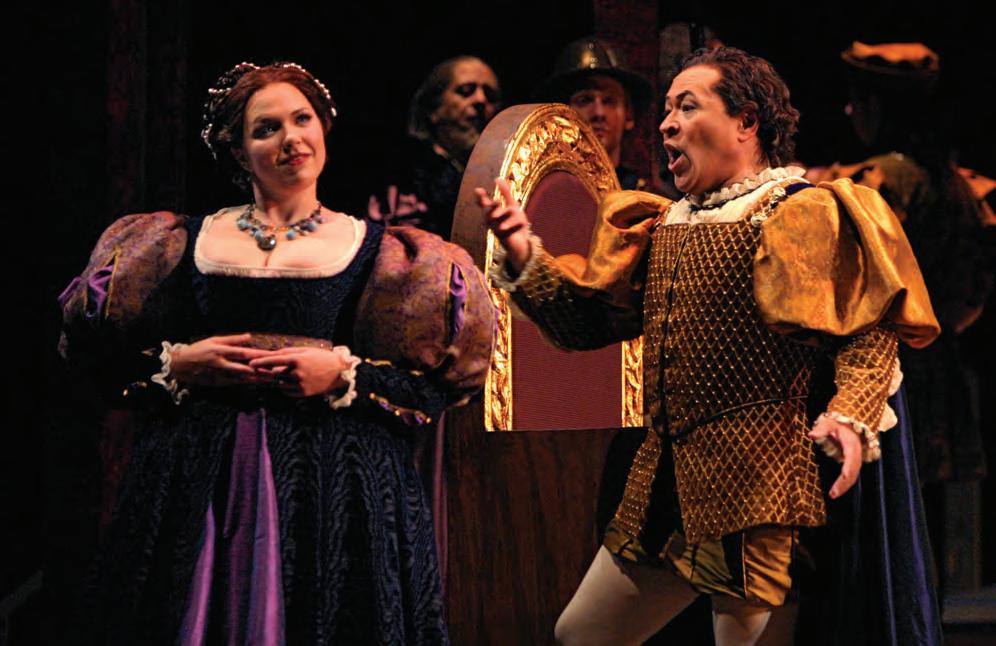
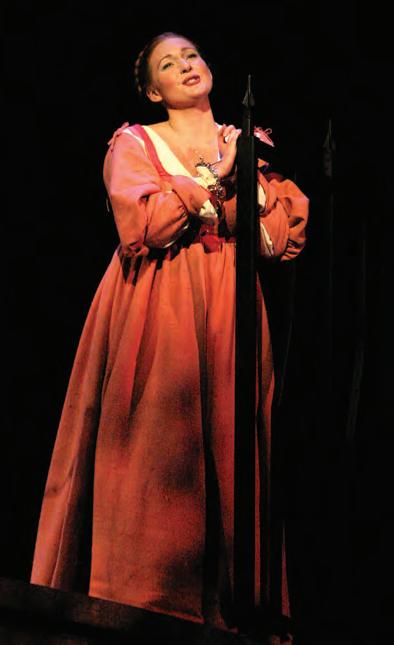
THE REMAINDER OF THE SEASON consisted of a revival of the company’s elegant 1997 production of The Magic Flute and new productions of two intriguing and seldom encountered works—Donizetti’s Lucrezia Borgia and Stephen Sondheim’s Passion both of them dark tales of obsession, thwarted love and, in the case of Lucrezia, murder, usually by poisoning, a tale spiced with not-so-subtle hints of incest. Despite offering in its title role a spectacular showpiece for a dramatic coloratura, a role that has attracted the likes of Montserrat Caballe, Beverly Sills, and Joan Sutherland, Donizetti’s Lucrezia may simply be too grim for audiences to take to their heart. It offers no opportunities for stage spectacle and no love interest, except that of Gennero, who is attracted to the beautiful stranger who wakes him with a kiss. He finds out only at the end—and too late—that she, Lucrezia, is his mother. And here, to address all that, was the young Greek dramatic soprano Irini Tsirakidis—tall, slim, and glamorous—
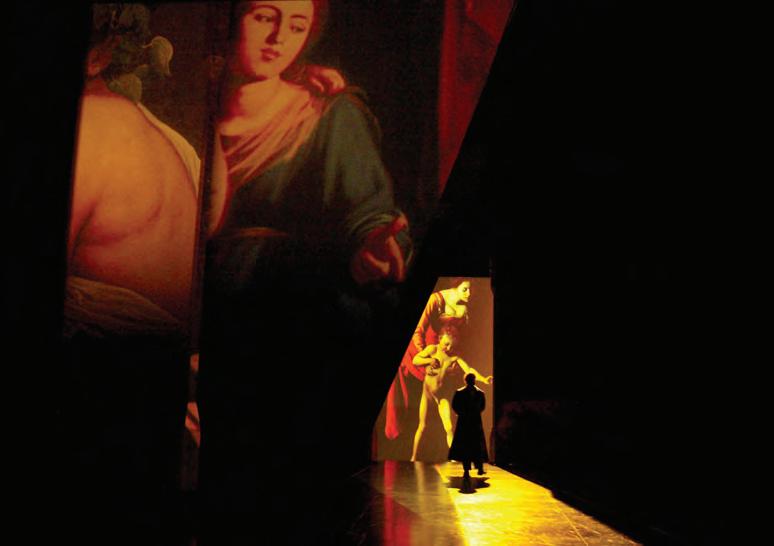
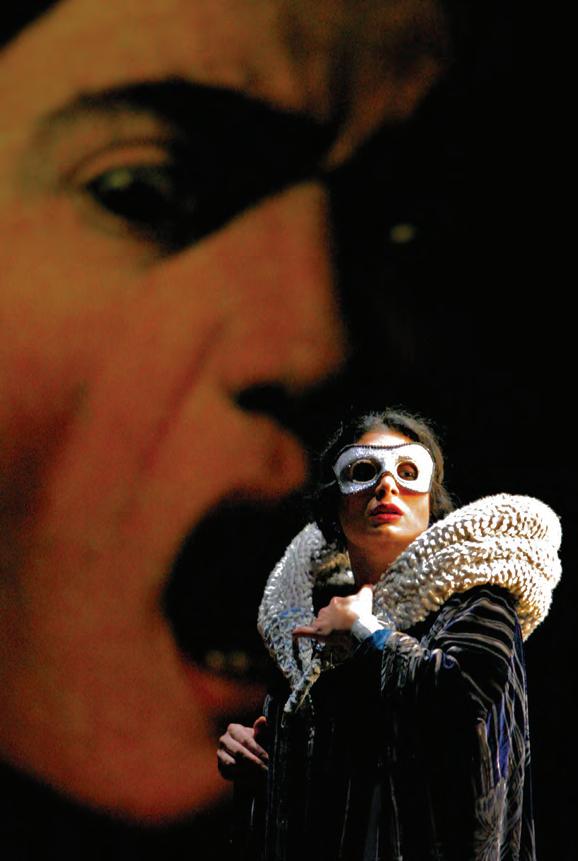

displaying by turns, and quite convincingly, mother love, fear, hatred, triumph, and finally, on realizing she has killed her own son, grief. And what a voice! Tsirakidis proved to have both the agility in the upper register and the richer, darker, lower tones that are this role’s chief hurdles, qualities seldom found in one voice. In what was a strong cast all around, mezzo Vivica Genaux brought her customary vocal aplomb to the pants role of Orsini, making him a more sensitive character than one normally finds in this part. There were more elements to praise in this production, among them the smart staging by David Edwards and the spirited, stylish conducting of Camil Marinescu.
Staging, in contrast, was the main problem in Passion, which opened February 28, 2004, the first production of this work by a major opera company. (Passion opened on Broadway in 1994 and won four Tony Awards.) The Ordway stage was too big for what is essentially a chamber musical about a strange romantic triangle in nineteenth-century Italy, and director Tim Albery made matters worse by staging so many key scenes way upstage, where characters that should loom large in our consciousness became little stick figures off in the distance and important dialogue couldn’t be heard. (Fortunately, the song lyrics were projected above the stage as surtitles.) We should, that is, feel the kind of claustrophobia that our young army officer Georgio feels when he becomes increasingly enmeshed in the obsessive love of his commanding officer’s cousin, the sickly and unattractive Fosca. Offering a carefully detailed characterization and deft singing, tenor William Burden skillfully traced Georgio’s progression from shallow amiability to a deep understanding of what love is, that it is “without pride or shame.” On a parallel track, Fosca, played compellingly by Patricia Racette, sacrifices herself while gaining everlasting life in Giorgio’s heart, having realized that “to die loved is to have lived.”
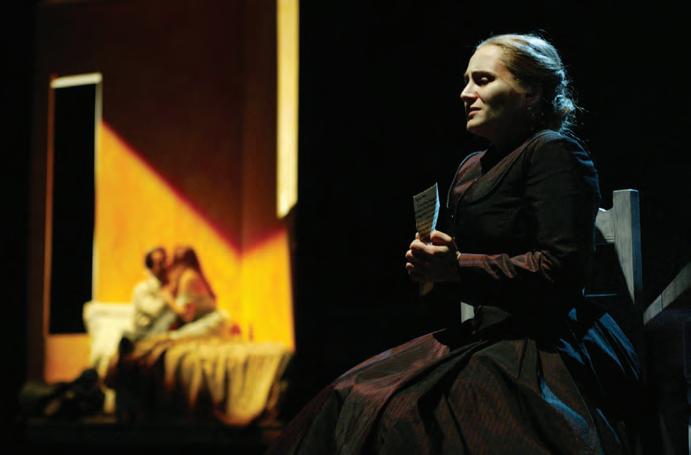
THE MAIN EVENT of the 2004–05 season was a production of John Adams’s Nixon in China at the Ordway in May 2005. By 1987, when the Houston Grand Opera gave the premiere of the work, Adams was already a much performed, widely admired composer of orchestral music and probably the leading proponent of the postminimalist style, which incorporated the patterns and rhythmic drive of minimalism while making use of a wider expressive and emotional vocabulary along with elements of jazz and popular idioms. Adams’s music was unmistakably American in the way that the music of Gershwin and Ives was—and is—and, not surprisingly, Americans liked Adams’s music. Adams was on his way to becoming the most popular living American composer.
This was the work’s first professional staging in the United States since the Houston premiere, which Peter Sellars directed. That production went on tour to the East Coast, Los Angeles, and Europe and was recorded and shown on PBS. (The recording, a sparkling performance conducted by Edo de Waart during the time he was music director of the Minnesota Orchestra, won a Grammy in 1988.) The subject was Richard Nixon’s trip to China in 1972, the result being not so much a history of the event as a rumination on the event’s meaning. Adams described the work as “part epic, part satire, part a parody of political posturing, and part serious examination of historical, philosophical, and even gender
issues.” More than a few people back in 1987 were surprised at how sympathetically Nixon and First Lady Pat Nixon are portrayed by Adams’s tuneful, shimmering score and Alice Goodman’s allusive, poetic libretto.
The Minnesota Opera production, staged by James Robinson and first seen a year earlier at the Opera Theater of St. Louis, took a different path, emphasizing not just the personal and the private in these bigger-than-life figures—the Nixons, Chou En-lai, Chairman Mao, and his wife— but also the vein of sadness that runs through Goodman’s libretto, the sense that life is a dream and that most events are beyond our control. Robinson’s chief innovation—rows of ’70s-style TV consoles showing home movies and video clips of the trip along with representations of each character’s past life—added the suggestion that the public and private are ever more intertwined and that TV has become the stuff of our dreams. This became comic in the case of the “typical” American family—Mom, Dad, Sis, and Junior—watching the Nixons’ trip at home while eating their TV dinners and grinning maniacally, the notion being that they’re only happy when they’re watching TV. It becomes wistful, though, at the end, when these powerful world leaders stare at younger versions of themselves on TV and wonder what happened to all that promise.
Robinson’s impressive cast included Carlos Archuleta, a firm-voiced baritone who not only looked like Nixon but provided a carbon copy of the former president’s hunched-shouldered physical awkwardness and his nervous vanity. Soprano Angela Fout might have shown us a little more of Pat Nixon’s always-in-control stiffness, her public self. What we got instead was gratifying enough: a warmhearted, dreamy character and lovely singing. Simon O’Neill’s Mao was really something: a huge, powerful tenor leaping out of this old, sleepy figure who looked like an Egyptian mummy. Helen Todd’s equally impressive Madame Mao was the fearsome tyrant she’s meant to be: a Queen of the Night in factory fatigues. Andrew Wilkowske, though he looked more like Al Franken than Henry Kissinger, got ample fun out of the show’s only real comic character.
John Adams was in the audience on opening night. He had a special interest in seeing the first act, he said during intermission. He had flown to St. Louis the previous summer to see the production’s premiere, but his plane was late, so he missed the first act. He said the Ordway was a better space for Nixon than the smaller venue in St. Louis. Adams was no stranger to the Ordway. For two years, starting in 1988, he served as creative chair of the St. Paul Chamber Orchestra, a


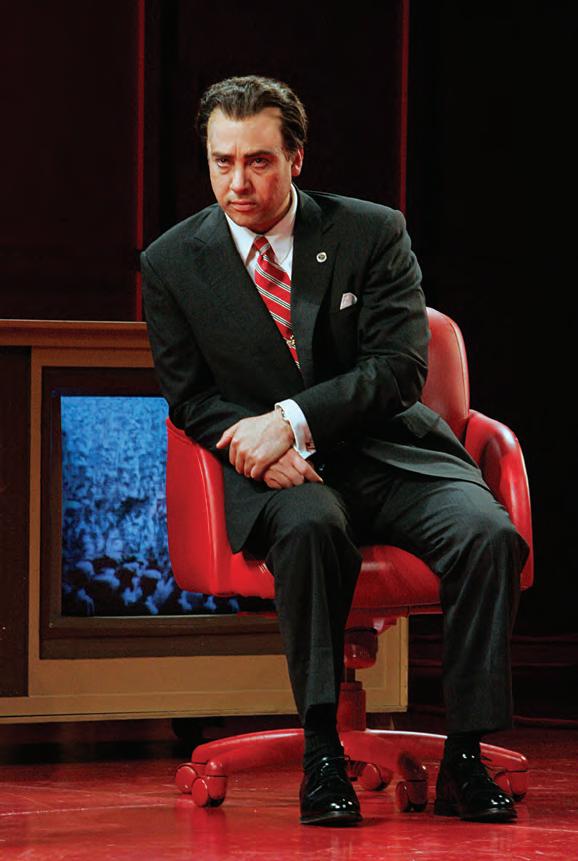
unique position created by the orchestra’s manager Deborah Borda, which had Adams frequently conducting the orchestra and advising on contemporary programming.
As a prelude to the production and an exploration of the geopolitical background to the China trip, Minnesota Opera hosted a public discussion at the Humphrey Institute of Public Affairs at the University of Minnesota with someone who witnessed the event up close, Walter Mondale, then a US senator, who went along on the trip.
“The US spent several million dollars making sure the trip was broadcast live,” said Mondale in a discussion onstage with Robert Marx. “Television had been used before, but not
to this extent, and now, of course, television rules the game.”
For Nixon, the trip was a risk. From 1949 to 1972, only twelve Americans had been officially allowed inside mainland China. Mao had called Nixon “a bloody butcher.” But Nixon needed China to help end the war in Vietnam, and he was also up for reelection, Mondale said. “The trip turned out to be a massive political triumph for Nixon,” he said. “In the opera, Nixon talks about changing the world, and he did.”
“I thought the reenactment in the opera was better than the original,” Mondale said, getting a big laugh.
Lani Willis, who was then the company’s director of communications, organized the event and secured the vice
president’s cooperation. “Mr. Mondale not only said he would participate but that he wanted to read the libretto, and he did read it,” she said. “He came with a curiosity and an awareness of what the opera was about and how the characters were drawn and how they differed from the real-life characters. I remember him being this towering person, both in stature and size, and yet he had a warmth that was very genuine.”
THE SEASON OPENED with Colin Graham’s delicately etched production of Madame Butterfly, a presentation that was as gratifying to look at as it was to listen to. Neil Patel’s set, all rice paper with simple but elegant designs, and David Wooland’s costumes evoked the aura of turn-of-thecentury Japan, a feeling enhanced by Graham’s considerable experience with Japanese theater. Two gifted singers, Judith Howarth and Kelly Kaduce, alternated in the role of Cio-Cio-

San. Howarth, who sang the role on opening night, seemed to fully occupy the character of the betrayed and abandoned geisha. This singer, whose Violetta in the previous season’s La Traviata lit up the stage, managed to be totally believable as a girlish and shy fifteen-year-old who grows into a figure of tragic stature when, at the end, she kills herself so that the American naval officer Pinkerton and his wife can take her child home to America. Her voice, essentially a spinto lyric soprano with a silvery tone, proved to be both flexible and attractive. Singing the role of Pinkerton, Marc Herieuve’s big expansive tenor was another asset. His character wasn’t a cad at the start but simply an arrogant and impatient young man, totally distraught at the end when he realizes what he has done. Baritone Ryan Taylor, who would go on to lead the company, made a seamlessly sung, reassuringly humane Sharpless, the antithesis to Pinkerton’s “Ugly American.”
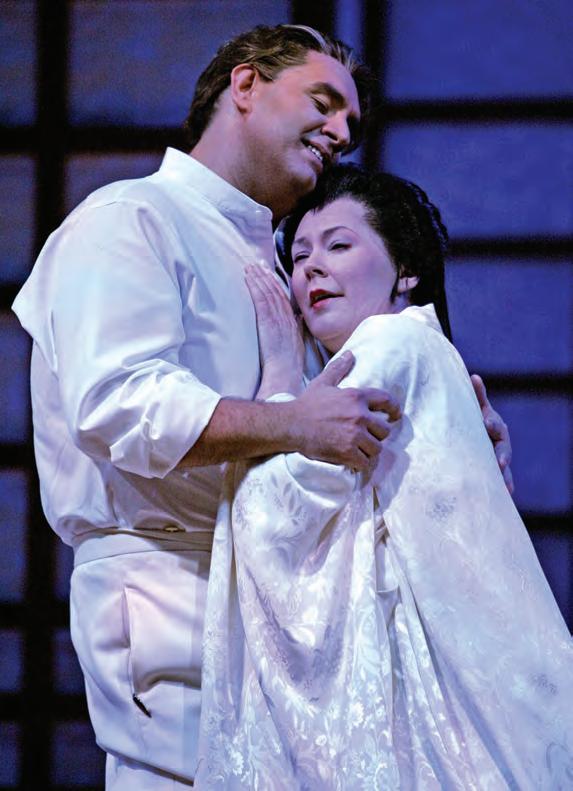
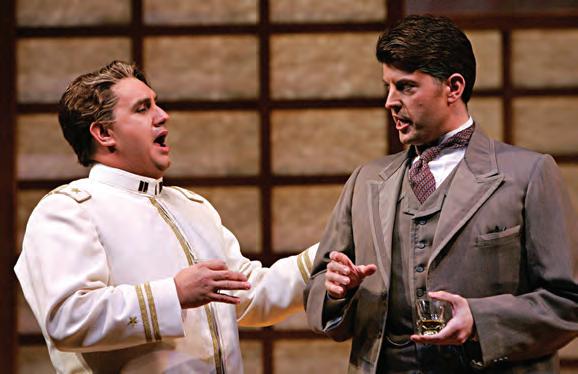
A WHILE IT MIGHT HAVE seemed as if Minnesota Opera’s much-hyped commitment to the bel canto operas of the early nineteenth century was chiefly an excuse to present standard works that everyone else was doing, Norma and The Barber of Seville among them. But then, on March 6, 2005, came the company’s production of Donizetti’s seldomperformed Maria Padilla, which gave that commitment some credibility. This product of Donizetti’s later years turned out to be something close to a long-lost masterpiece, as its handful of champions, among them the company’s artistic director, Dale Johnson, had been claiming for quite some time. Certainly Minnesota Opera’s production, staged thoughtfully by Jose Maria Condemi, conducted with flair by Francesco Maria Columbo, and offering an impressive Brenda Harris in the title role, made a convincing case for this dark drama of conflicted love in the royal court of fourteenth-century Castile. Cameron Anderson’s intriguing designs added a touch of mannerist distortion to an essentially realistic approach. Her chief symbols were cages and picture frames: images of confinement suggesting that each of our main characters—Maria; her father, Don Ruiz; and her husband-to-be, Don Pedro—is trapped by conflicting desires. Bruce Ford was the imposing Don Ruiz, moving from forcefully irate to pathetically deranged, bringing to mind King Lear in his final scene, and marshaling his opulent but flexible tenor with subtlety and power. Karin Wolverton made a strong impression as Maria’s sister, Inez, showing fresh coloratura agility both in her opening aria and in the great second-act duet with Maria.
Brenda Harris recalled: “The director was Jose Maria Condemi, the conductor was Francesco Maria Columbo. So they called me Brenda Maria because everybody had to have a middle name of Maria. But that role—I did it one other time at a festival in England—is really evil to sing. It’s essentially unsingable. It’s like Donizetti a third higher. We were all like, ‘What was this guy thinking?’”
IN APRIL, THE COMPANY said goodbye to its venerable 1991 production of Carmen. The production set a new standard for artistic achievement while enhancing the company’s profile as an innovator and reconnecting it, in some sense, with the spirit, if not the letter, of its earliest days as the feisty, unpredictable Center Opera. And while this particular Carmen can’t be said to have launched the career of
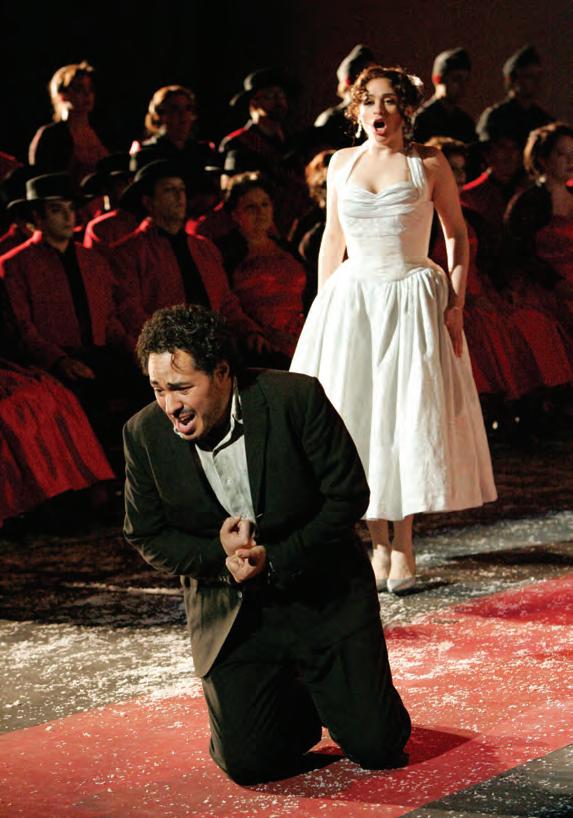

the brilliant mezzo-soprano Denyce Graves, whose renown in the early ’90s was already in ascendance, the production certainly gave her professional life a boost and established her as the Carmen of choice for at least the next decade.
As a final bonus, the production itself—the sets and costumes—were rented out to more than a dozen companies in the United States, Canada, and Europe, thereby establishing relationships with many of these companies that led to cost-saving collaborations on new productions.
As it turned out, the audience on opening night got to hear two tenors for the price of one—two Don Josés. Scott Piper, normally a strong singer and a convincing actor, started the show while suffering from a cold, but had to throw in the towel after the third act, and Jay Hunter Morris,
who was alternating in the role, finished the evening as Don José. Piper’s singing was bronchially challenged, but Morris sang with authority, displaying an impressive tenor with a truly heroic top. The Carmen, Rinat Shaham, a mezzo from Israel, operated on Graves’s high level of charisma, beauty, and vocal allure. Strutting around haughtily onstage in high heels and leopard-skin Capri pants, Shaham’s Carmen made the "Habanera" an irresistible tease. Here was, as with Graves, a star in the making.
Two months later, the company closed the books on its 2005 fiscal year, showing a boost in revenue of 11 percent over the previous year and an increase of 15 percent in contributions. In addition, the company raised $10.6 million of a $20 million endowment fund drive.
RIDING ON A WAVE OF SUCCESS , both artistic and financial, an emboldened Minnesota Opera courted some risk in the programming of its 2005–06 season, offering, alongside a pair of chestnuts (Tosca and Don Giovanni ), two unusual items, one of them a rarity by a little-known nineteenthcentury composer, the other a sad but possibly illuminating opera of recent vintage. The first was Orazi and Curiazi by Severio Mercadante, a tense drama of ancient Rome being given its US premiere—maybe. (No one was sure about this.)
The other was Joseph Merrick, the Elephant Man by the French composer Laurent Petitgirard with a libretto by Eric Nonn, a work premiered in Prague in 2002 that received its North American premiere May 10, 2006, at the Ordway courtesy of Minnesota Opera. The story concerns the grotesquely deformed Joseph Merrick, who was billed as “Elephant Man” in the freak show he appeared in in the purlieus of London in the 1880s. Suffering what is now thought to be Proteus syndrome, abnormal growth of bones, Merrick became first a medical celebrity, then an attraction in high society, and eventually, at twenty-seven, took his own life, doing so by the simple act of lying back on his bed, which broke his neck. Normally, he slept sitting up. His head by the time of his death was three feet in circumference.
A woman, a contralto, sang the part of Merrick in the Prague production. Minnesota Opera cast a countertenor in the role, David Walker, though without any changes in the vocal line. As in the play performed on Broadway in 1979 that, for a while, starred David Bowie, Merrick first appears as a normal man, his body gradually contorting as the story progresses. Petitgirard’s tuneful, occasionally dissonant but assuredly dramatic score nods occasionally at French tradition—Fauré, for instance, in the touching “In Prayer.” He also sets Nonn’s text clearly, and in expert fashion weaves subtle leitmotifs throughout the piece. Many of Nonn’s scenes are effective, especially those between Merrick and Mary, the nurse, with its undercurrent of Beauty and the Beast. But his opening act, with its windy perorations by Tom Norman, Merrick’s freak show manager, go on much too long. The production, though, with its imaginative staging and choreography by Doug Varone (performed by members of his own dance company), along with the clever sets and costumes by Christine Jones and James Schuette (lighting by Jane Cox, video by Darrel Maloney), and a remarkable performance in the title role by Walker, done with no masks or prosthetics, bridged any gaps in the libretto and made this a production to remember.
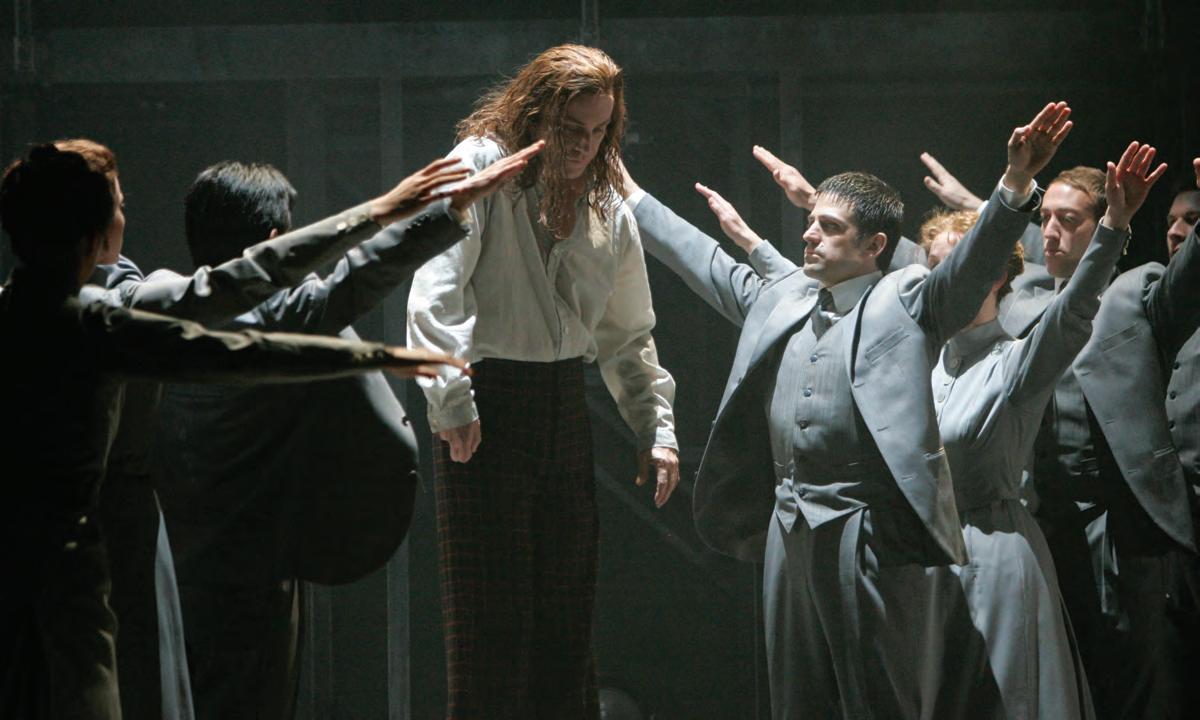


OPERA FANS STILL don’t appear to be clamoring for a revival of the works of Severio Mercadante, even though Minnesota Opera made a good case in April 2006 for the viability of this obscure composer’s Orazi and Curiazi, which had been sitting on the shelf gathering dust the past 150 years. Historians usually see Mercadante as a link between the bel canto style of the early nineteenth century and Verdi, whose ascent Mercadante is believed to have resented. What is most striking about Mercadante is how dramatic his music is. He wasn’t much of a tunesmith, but he knew how to make a scene move, how to articulate dramatic gestures, both in the vocal line and in the orchestra, and, if Orazi is typical of his work, he knew how to write bright, exciting choral music. The Minnesota Opera production, conceived by Eric Simonson (but staged by Peter Kozma when Simonson had to leave town because of a family emergency), moved the

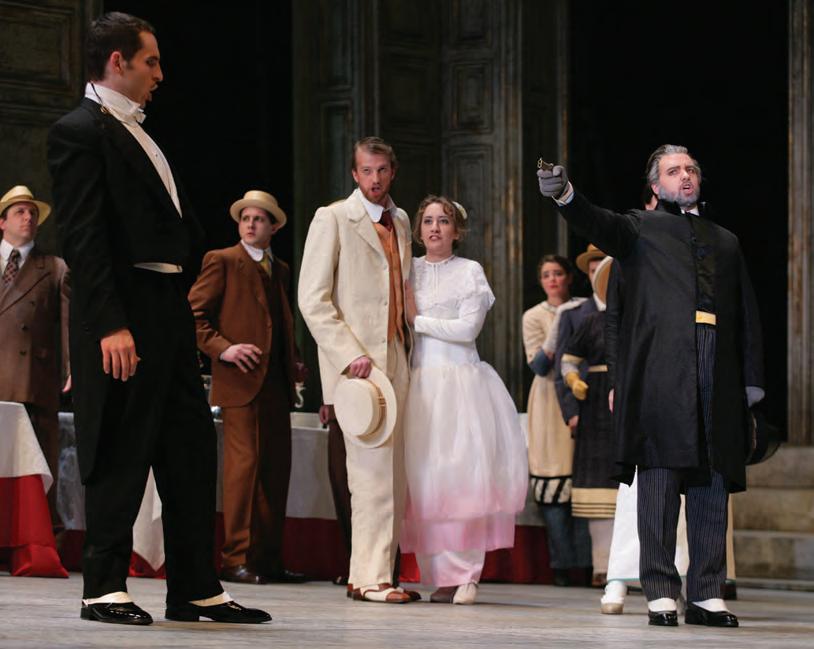
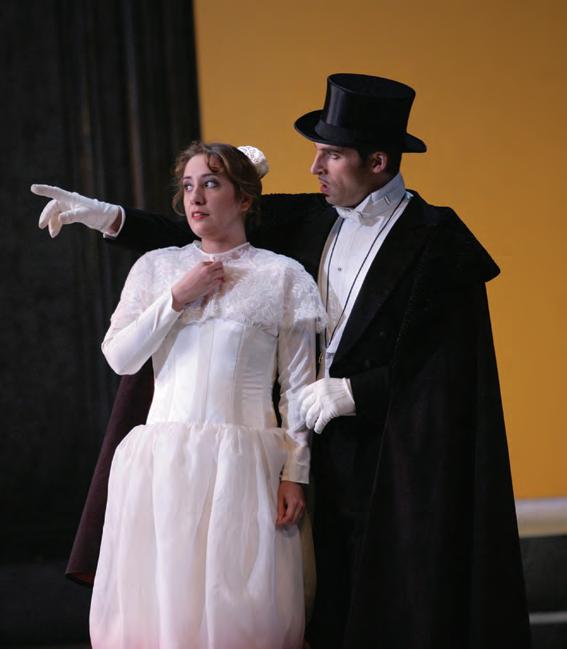
action from the seventh century BC, and its conflict between Rome and its neighboring city-state Alba, to the American Civil War. And in a witty touch, he staged the act two treaty-signing to resemble our image of Appomattox, though, so as not to take the updating literally, he had the winners, the Romans, in gray uniforms, the losers in blue.
Mercadante demanded a lot from his singers, none more so than from the soprano who sings the role of Camilla, and here Brenda Harris, who had done impressive work for this company, really topped herself, giving a performance on opening night of gripping dramatic weight coupled with vocal virtuosity. The rest of the cast was generally strong. Karin Wolverton was a commanding Sabina, and Christopher Dickerson (Old Orazi) gave firm voice in the third act to what is without doubt the opera’s dullest aria.
IT’S EASY TO FORGET that Mozart subtitled his Don Giovanni a “dramma giocoso,” a comic drama. Most productions of the work have their strengths, but humor isn’t one of them. Perhaps to remedy that, Minnesota Opera opened a new production of the work at the Ordway March 4, 2006— its third look at this opera since the 1970s—that tipped the
often-unwieldy balance in this tale in the direction of farce while still retaining, at the end, the essential chill of a morality play. It’s refreshing, too, to see our title character, the great seducer, not having to look macho in pink stockings and knee breeches. Patrick Mailler, who staged and designed this production, moved the setting to early twentiethcentury Spain, and here our Don, in spats and a top hat, wasn’t an especially commanding figure, at least not right away. In fact, he’s short of stature but full of cunning. He’s mercurial, a trickster, a smooth operator, at least in his own eyes, and he’s capable of real cruelty. At the same time, he’s all frustration. Nothing’s going right. We got all these crosscurrents from Kyle Ketelsen in what turned out to be an interesting nonstandard characterization suggesting that this particular Don wouldn’t have scored with those 1,003 women without his retainer Leporello’s help. And, throughout it all, Ketelsen sang with suave intelligence. Mailler added another nice touch: he had Donna Elvira appear pregnant, which gave her pursuit of the Don an extra level of desperation, all of this convincingly acted and sung by Patricia Risley. Mailler’s weird set, the Don’s crumbling villa seen at an angle, was meant to suggest the declining fortunes of the aristocracy.
THE PREMIERE OF The Grapes of Wrath, Minnesota Opera’s first commission in more than a decade, dominated the 2006–07 season to such an extent and was such a success that it’s easy to forget that there were other productions given that season—four others— that, in varying degrees, had something to offer. Designer Robert A. Dahlstrom, for instance, came up with one striking scene after another in the company’s new production of The Tales of Hoffmann, which opened October 28, 2006. There was in the prologue, for example, a bar obviously designed for the serious drinker that stretched nearly the entire width of the Ordway stage; later, in the Munich act, we saw a living room with shrouded furniture suggesting claustrophobia and death; while for the Venice act Dahlstrom gave us a lush, sensual panorama of Venice with a gondola gently gliding across the stage. The superior cast was headed by Richard Troxell, whose performance in the demanding title role was just about ideal. His nemesis was the scene-dominating actor Dean Peterson, who played all four villains, looking as Lindorf like Erich von Stroheim in sunglasses and displaying a rich, booming, dark-toned baritone. Among the women, Karin Wolverton portrayed a touchingly poignant Antonia. Chris Alexander staged the production at its premiere in Seattle a year earlier. Helena Binder handled the staging—very capably—at the Ordway.
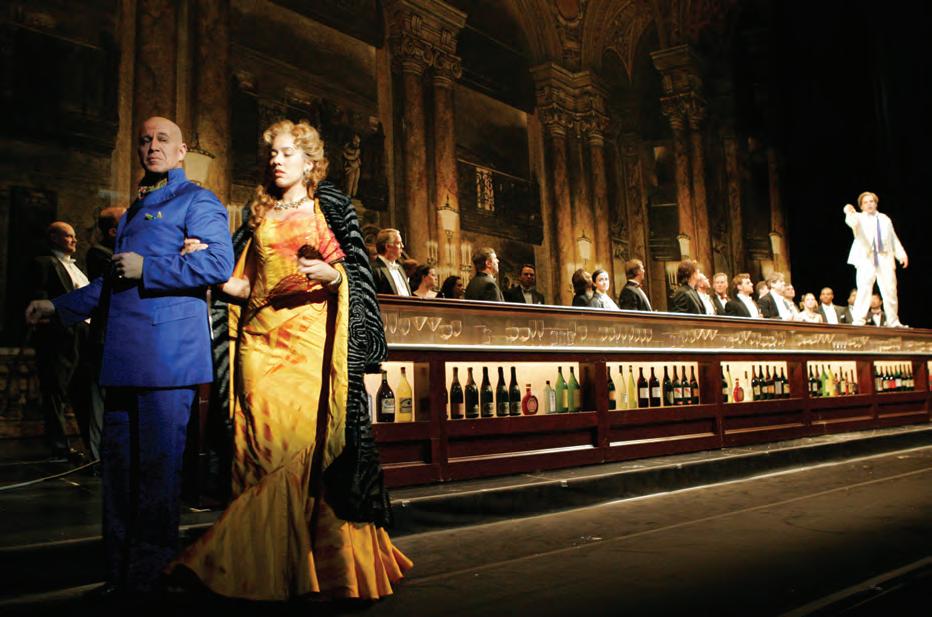

TWO WORDS EXPLAIN the success of Minnesota Opera’s production of La donna del lago: Ewa Podles. Real contraltos are the rarest voice type of all. It isn’t just that they can sing lower than sopranos or altos. They also have high notes, as much as an octave above what the average alto can sing, and the flexibility of a coloratura soprano. “I have an amazing voice,” Podles, a native of Poland, said during an interview at the Opera Center. “It used to be that people couldn’t understand how I could sing like this. They thought it had to be artificial. But it wasn’t. It was my real voice.”
Podles sang the trouser role of Malcolm in La donna, an opera by Rossini based on Sir Walter Scott’s romantic poem “The Lady of the Lake.” This was a coproduction with the New York City Opera, and though it had its strengths, it wasn’t much to look at. Where Scott and Rossini call for sunny, colorful scenes full of painterly wistfulness, designer David Zinn and his lighting designer, Lenore Doxsee, gave us shades of gray along with a series of crumbling stone ramparts and nearly continual snowfall. Even worse, Zinn and Doxsee deprived us of the story’s loveliest image: our heroine Elena rowing across the lake, at which time she is spotted by the King, who immediately falls in love with her. In this production, poor Elena
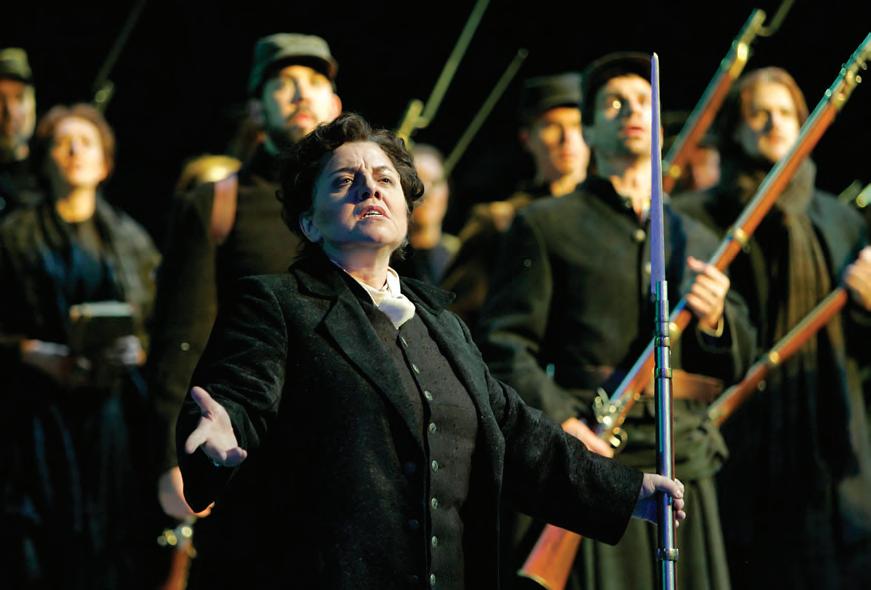
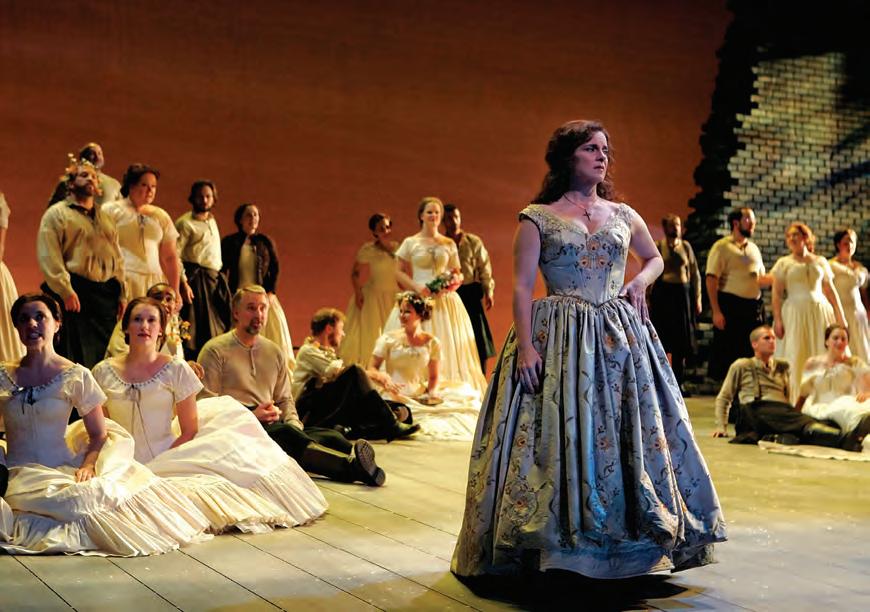

(Maureen O’Flynn), looking downhearted, has to sing her opening aria standing on a rock. No wonder she’s depressed. The cast, however, was strong, and Podles was magnificent. Her remarkably resonant chest voice filled the hall with low notes she never had to grab for, and her coloratura flights were embroidered in glittering fashion. Her first-act duet with Elena, sung by Maureen O’Flynn, was magic, with impeccable intonation from both. And, for her part, O’Flynn made a beguiling heroine—a pale, wan, brooding figure that evoked paintings of the late nineteenth century.
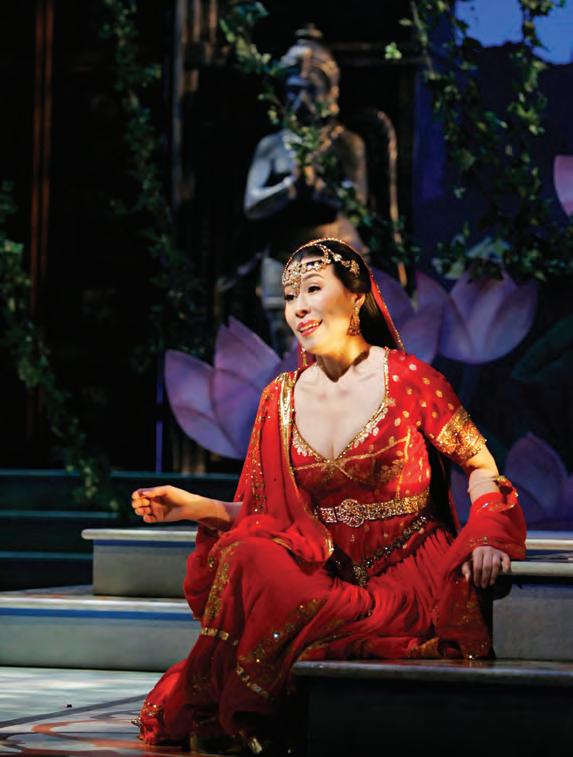
DESPITE ITS FAMOUS “Bell Song,” Leo Delibes’s opera Lakmé is what George Bernard Shaw called it, “pretty nonsense.” Minnesota Opera’s production of the opera, which opened March 31, 2007, didn’t try to hide the opera’s weaknesses, but it did play up its strengths—the work’s charm and the fragile elegance of those half-tunes that Delibes, who was better at ballet than opera, specialized in. A stage adorned by designer Mark Thompson with bamboo, Hindu statues, huge painted flowers, and a central upstage pagoda suggests, probably wisely, that we take these goings-on strictly as a fairy tale rather than as an example of nineteenth-century colonialism, wherein all Indian maidens, to quote the libretto, “tremble with passion.” Our Lakmé, Youngok Shin, trembled at all the right moments, looked appropriately innocent, and displayed a remarkably free and agile coloratura that gained in amplitude as she soared above the staff all the way to a high E-flat. Her “Bell Song” was a knockout. Although Lakmé is thought to be a “singer’s opera,” meaning it has all the intellectual content of a tractor pull, conductor Michael Guttler’s sensitive pacing of the show, leading a beefed-up St. Paul Chamber Orchestra, proved that a strong conductor is equally important.
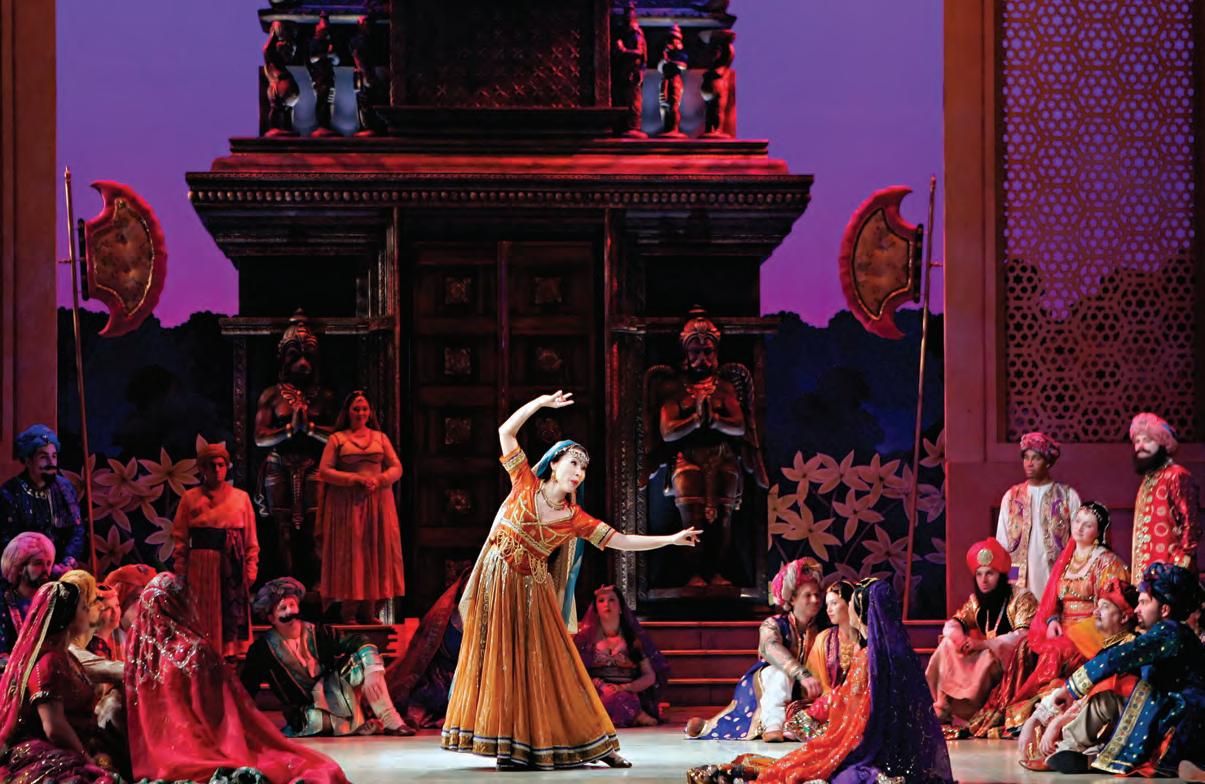

THE RUSSIAN BARITONE Denis Sedov made an unusual Figaro in Kevin Newbury’s production of The Marriage of Figaro, which concluded the company’s forty-fourth season. This wasn’t the jolly trickster that we’re used to. Sedov is tall and dour-looking, and in his first-act aria he showed real anger at his boss, the Count, who is bent on his “first-night privilege” with Figaro’s betrothed, Susanna. The production was traditional in the best sense. Carl Friedrich Oberle’s unit set—classical arches repeated in perspective—suggested not merely the meticulously balanced harmony of Mozart’s music but the reconciliation of conflict among all the characters at the end. There was clarity and balance, too, in Newbury’s staging, with hardly any of the forced jokes that so often mar productions of this opera.
MINNESOTA OPERA BALANCED its budget for the fourth consecutive year, according to figures released in June. The budget came to $9.5 million. The company played to 84 percent capacity during 2006–07, down from the 90 percent of recent seasons. Company president Kevin Smith attributed the drop to slow ticket sales at the start of the season and to the move to five productions per season from four. The Grapes of Wrath was sold out for all five performances. The biggest seller of the season was The Marriage of Figaro, which received eight performances. Board member Karen Bachman also announced that the company’s Opera at the Ordway endowment campaign achieved its goal of $20 million. “That’s something to celebrate,” said Smith. “The year we went into the Ordway, in 1985, our assets were negative, and we had no endowment. Today we’ve got assets of $25 million.”

Without doubt, the event of the decade for Minnesota Opera was the premiere of The Grapes of Wrath, an opera by composer Ricky Ian Gordon and librettist Michael Korie, based on John Steinbeck’s classic novel about the Joad family’s struggle to find work and maintain dignity in the orchards of California. The Grapes of Wrath, which took nearly ten years to bring to life, turned out to be a rousing success, both a critical success and, if the standing ovation the work received at its premiere was any indication, a hit with audiences. The opera was recorded and later broadcast nationally on public television. Other companies have performed it, and a new, shorter two-act version that the composer helped put together is likely to reach even more audiences.
Patrick Dewane, the company’s development director during the years the opera was being created and financed, recalled seeing the opera in its entirety for the first time at the final dress rehearsal with a small audience of mostly staff people at the Ordway in March 2007. “The opera starts with this fanfare,” he said. “And I thought, ‘Well, that sounds very Coplandesque.' And then it just unfolds with the set design and the costumes. And when it came to the end of the act, when Andy Wilkowske’s character, Noah, kills himself, basically to save the others—I’m going to tear up right now thinking about it—and then the mother sings that song about the innocent child, and then the lights go down and then come back up and we were all looking at each other like, holy shit, this is really something. We’re not just kidding ourselves about how fun this has been and, oh, wouldn’t it be great if this turned out to be the Great American Opera? And then two nights later, the audience saw it and went crazy for it.”
The impact of The Grapes of Wrath on Minnesota Opera was to renew the company’s dedication to the commissioning of new works, a dedication expressed in the creation the following year of its New Works Initiative. The opera’s impact on Gordon was to enlarge the scope of his work and propel him to the front rank of opera composers.
“My whole life changed with that opera,” Gordon said in an interview in 2021. “By the time I finished the opera and it had been staged in Minnesota, I was another person. I had never written anything that big, and it was so mind-blowing. I said yes to it with complete terror in my soul. Writing it took hold of me. It gripped me for five years. And I just think it’s so beautiful. I’m so proud of that opera. I’m so grateful that I got the opportunity to set that magnificent, heartbreaking text to music.”
The production was the biggest and most expensive (about $1.5 million) in the company’s history. Ruth and John Huss, longtime arts patrons in the Twin Cities, provided the start-up capital for the commission. Ameriprise Financial served as the national sponsor, and other funding came from the National Endowment for the Arts, Opera America, and Utah Symphony & Opera, acting as co-commissioners, and both the Pittsburgh Opera and Houston Grand Opera, coproducers.
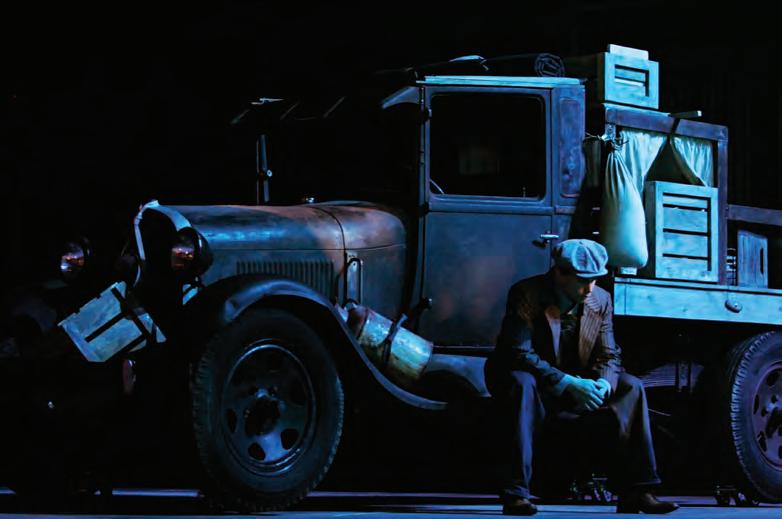
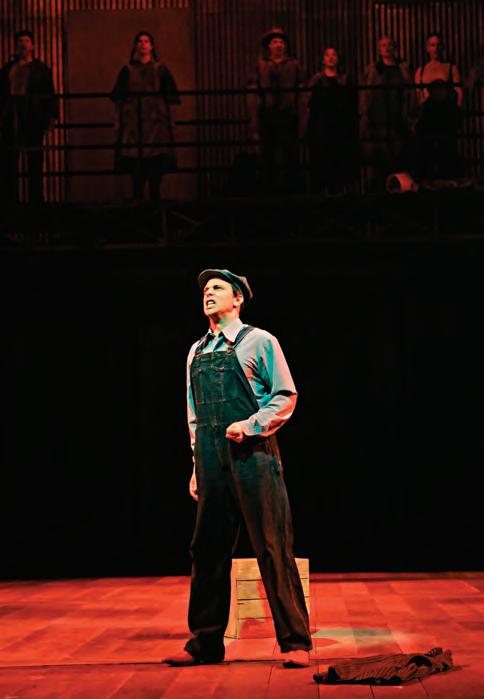
Opening night wasn’t quite sold out. But the remaining performances played to full houses. Jane Confer, who was then board chairman, saw the production on opening night. “Grapes of Wrath changed my whole perspective on opera,” she said. “I was one of those who had fallen comfortably into the ten Italian operas and how many ways can you do them idea. “Grapes of Wrath brought me to my knees. Every time I see Andy Wilkowske, I say, ‘You broke my heart with that scene.’”
Asked what it is that keeps this story alive, the dramaturg Eric Simonson said, “I think it’s that Steinbeck drew from a mythic source, the Bible: crossing the desert, Rose of Sharon (Rosasharn) is the Madonna, Jim Casey (the preacher turned union organizer) with the initials J. C. is Jesus Christ, and Tom Joad is Doubting Thomas. It’s about transformation, about the collective soul in all of us.”
The original production of the opera in Minnesota was unique. The entire opera, which ran nearly four hours, and its staging, with thirty scene changes, was elaborate and expensive. “That was when opera companies still had money,” Gordon said. “But every time it was done after that, it was cut or changed.” The solution was a new two-act version,

a rethinking of the work devised by Gordon, librettist Michael Korie, and James Robinson, who staged it at the Opera Theater of St. Louis in 2017. What exists now are two authorized versions, the big three-act version first presented at the Ordway in 2007 and the smaller one premiered a decade later in St. Louis. “It’s better for a company to do the new version than the first one with all those random cuts that were driving me crazy,” said Gordon. The many versions of The Grapes of Wrath —the book, the movie, the play, the two operas—tell a story that seems never to lose relevance. Gordon said, “The tragedy of The Grapes of Wrath is there hasn’t been a day since it was written that it wasn’t earth-shatteringly relevant. It’s about the refugee crisis right now, you know, separating children from their families. And it’s not just in America. It’s everywhere. The world is one big refugee crisis of people trying to escape a bad situation going toward one they think is better, but it usually turns out to be worse. That’s where we are in the world right now.”
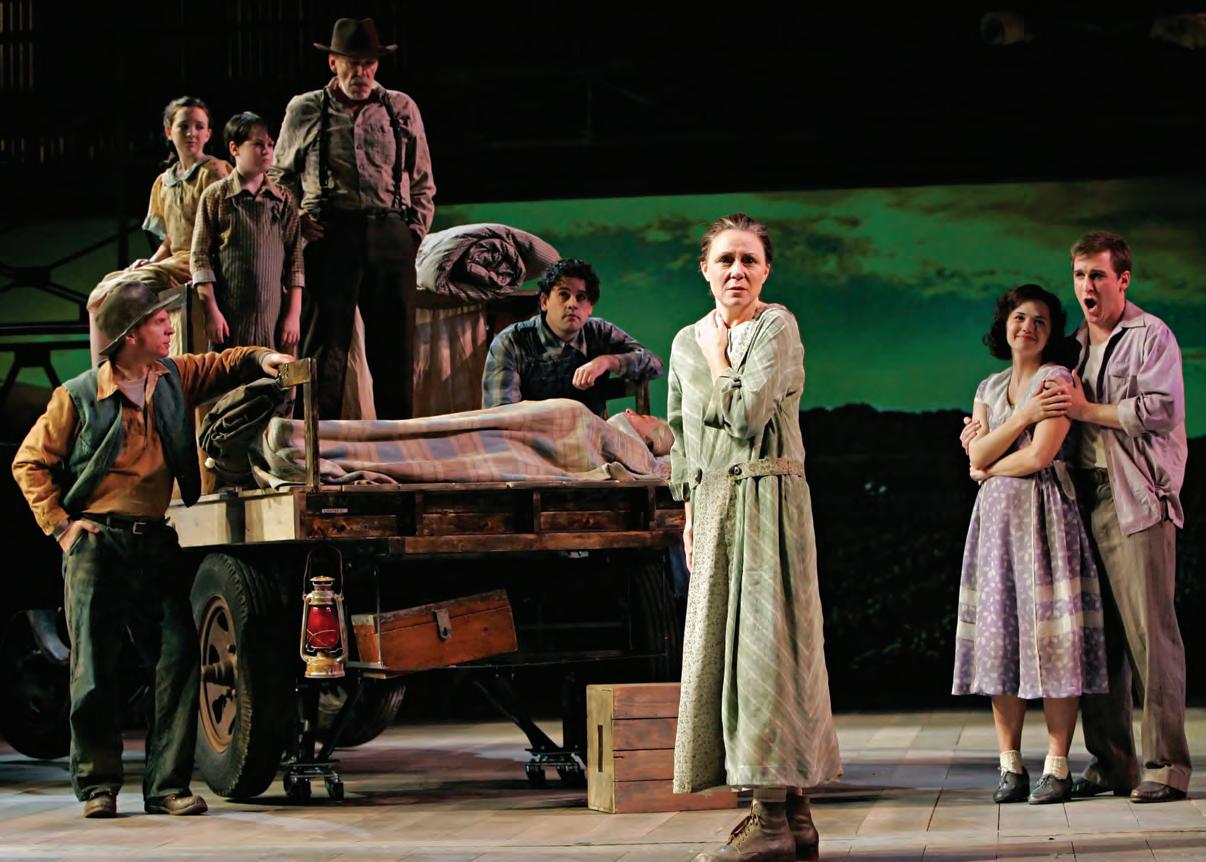
FRENCH REPERTOIRE HAS never been a strong focus for Minnesota Opera, so there was just the slightest sense of occasion when the company unveiled its new production of Gounod’s Romeo and Juliet at the Ordway on January 26, 2008. An earlier production, a collaboration with Opera Omaha staged by Leon Major and presented at the Ordway in 1990, hadn’t been well received. A critic described it as an “ill-designed, dramatically static, indifferently sung affair that doesn’t make much of a case for this third-rate war horse.”
Optimists in the audience were no doubt hoping that the new production would be better and might even raise the status of the work itself to something closer to second-rate. That said, there were things to admire in this new production. The director and choreographer David Lefkowich moved his key players about the stage sensibly and gracefully, defining mood as well as character and creating, in most cases, attractive stage pictures. And there was no denying the allure of Erhard Rom’s sets, which offered an effective kind of Renaissance minimalism, along with Jennifer Caprio’s eye-filling costumes. And the cast was uniformly strong starting with the attractive and well-matched young singers in the title roles, James Valenti and Ellie Dehn. Though few sopranos can suggest a teenaged Juliet, Dehn, a native of Anoka, Minnesota, brought an engagingly youthful beauty and energy to her portrayal, all of which evolved into a kind of tragic grace in the opera’s final moments, and her singing was radiant throughout, full-bodied yet agile at the top. Valenti, a graduate of the company’s Resident Artists training program, had been singing big roles at major opera houses in recent seasons. He’s that rarity, a tall, thin tenor, and he found both the heroic and the vulnerable sides of Roméo, who is a serious young man as Valenti sees him. The singer’s open, wide-ranging voice rose to the high climaxes with thrilling, Italianate bravado. Not surprisingly, both Valenti and Dehn went on to large careers. Among the others, Kelly Markgraf tossed off Mercutio’s Mab scherzo with impressive ease and clear articulation. And Ari Peltro conducted a supple, cogently paced performance that included the kind of committed, articulate singing that has become the norm for this chorus.
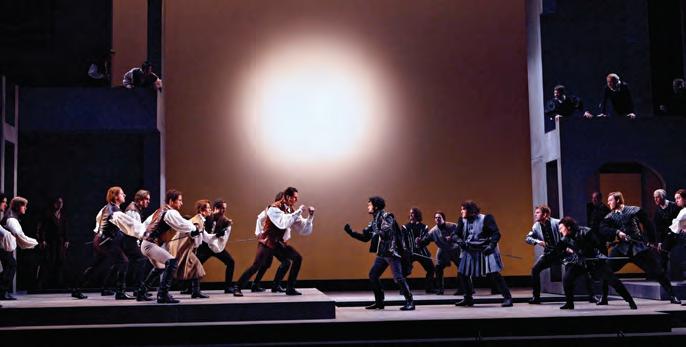

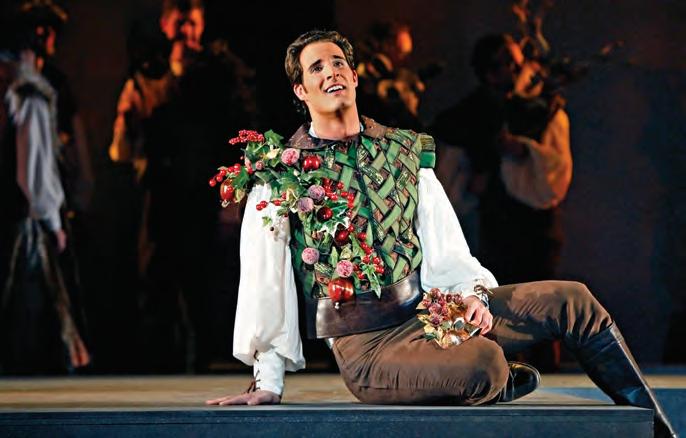

IT TOOK A MERE 297 YEARS for Reinhard Keiser’s The Fortunes of King Croesus to receive—from Minnesota Opera—its North American premiere, and the surprise was how good it is—that this obscure opera by a largely forgotten composer turned out to be an engaging, even alluring piece of music theater, a work composed in a style none of us has seen much of: German Baroque. The opposing style, if it can be called that, the Italian Baroque that Handel took up—opera seria, with its showy, formulaic da capo arias—is perhaps a purer, more sophisticated form than what can be found in Croesus, which was conceived not for a court audience but for the Hamburg public. Keiser’s notion of plot is looser, more varied than the Italian model. He mixes high and low, comedy and poignance, laughter and tears. This, after all, was a public, commercial theater—the first outside Venice. It aimed at pleasing its audience, which meant that Keiser had to write real tunes—short, attractive numbers that tell a story, capture a mood, and keep the plot moving. The opera’s main character isn’t Croesus, the wealthy king of Lydia in the sixth century BC (source of the phrase “rich as Croesus”), but his son Atis, who is mute in the first act. Hiding out from the enemy Persians, Atis disguises himself as his own servant, and as a result his girlfriend Elmira falls in love with him all over
again, thinking he’s the servant, and she feels guilty, since it means she has betrayed Atis.
The approach that director Tim Albery and his smart design team—Leslie Travers for sets and costumes, Thomas C. Hase for lights, Tim Claydon handling choreography—used to tell this complicated tale was decidedly postmodern, and the result was as engaging to look at as it was suggestive of multiple meanings and allusions. The costumes suggested several eras before landing somewhere in the vicinity of World War Two, and the entire stage during the second act was dominated by the wreckage of one of the king’s fighter planes that was shot down in the first act. In another evocative touch, Albery had the wise Solon, sung by the fine young baritone Christopher Job, wandering in and out of scenes, a lonely figure looking on in despair at the follies of the human race. Also impressive was Susanna Phillips, a soprano from Alabama who gave dignity, emotional focus, and superb singing to the role of the long-suffering Elmira. Vale Rideout was the sensitive, energetic Atis. Harry Bicket, one of the early, music movement’s most admired conductors, underlined both the energy and the lyricism in this music in a performance that featured the St. Paul Chamber Orchestra.
THE BEST PRODUCTIONS of Verdi’s A Masked Ball share, regardless of the quality of the singing on a given night, the suggestion that the life onstage, as the title puts it, is something of a masquerade. Our heroine Amelia conceals an illicit passion while our hero, the King, runs around incognito, and the opera itself culminates in a fancy-dress ball at the Swedish court with everyone in disguise and potential killers lurking behind every pillar.
James Robinson’s production of A Masked Ball, a coproduction with Opera Colorado and Boston Lyric Opera that opened Minnesota Opera’s forty-fifth season at the Ordway on September 22, 2007, continually played with notions of appearance versus reality. Stick puppets act out the murder of the king just before the killing happens in the ball scene, and earlier, in act one, Allen Moyer’s set changed—rather magically—from the king’s chamber to the fortune-teller Ulrica’s den of iniquity as a backdrop rose slowly, then turned and rested at an angle, moving us, psychologically,
from rule to misrule. At other times, emotions exploded into violence, as if long suppressed. During the ball scene one of the conspirators suddenly punches the page Oscar for not revealing where the King is, and earlier, in Ulrica’s hideout, Robinson has the King suddenly fall dead when he hears the fortune-teller’s dire prediction. But it’s a joke. The King, who’s kind of a frat house prankster, leaps to his feet and guffaws.
All this was effective, adding both tension and character to the proceedings. The same can be said for Duane Schuler’s lighting design, with its alternations of light and shadow, along with the designs of Moyer and costumer James Schuette. Moyer’s spare and plain sets seemed cramped, and appropriately so in a tale about people hiding things from one another. The ball scene, though, was too plain. This is the Swedish court, after all, not a barn dance. (As is common practice these days, the production places the action where Verdi originally set it, in Sweden in the late eighteenth century.)
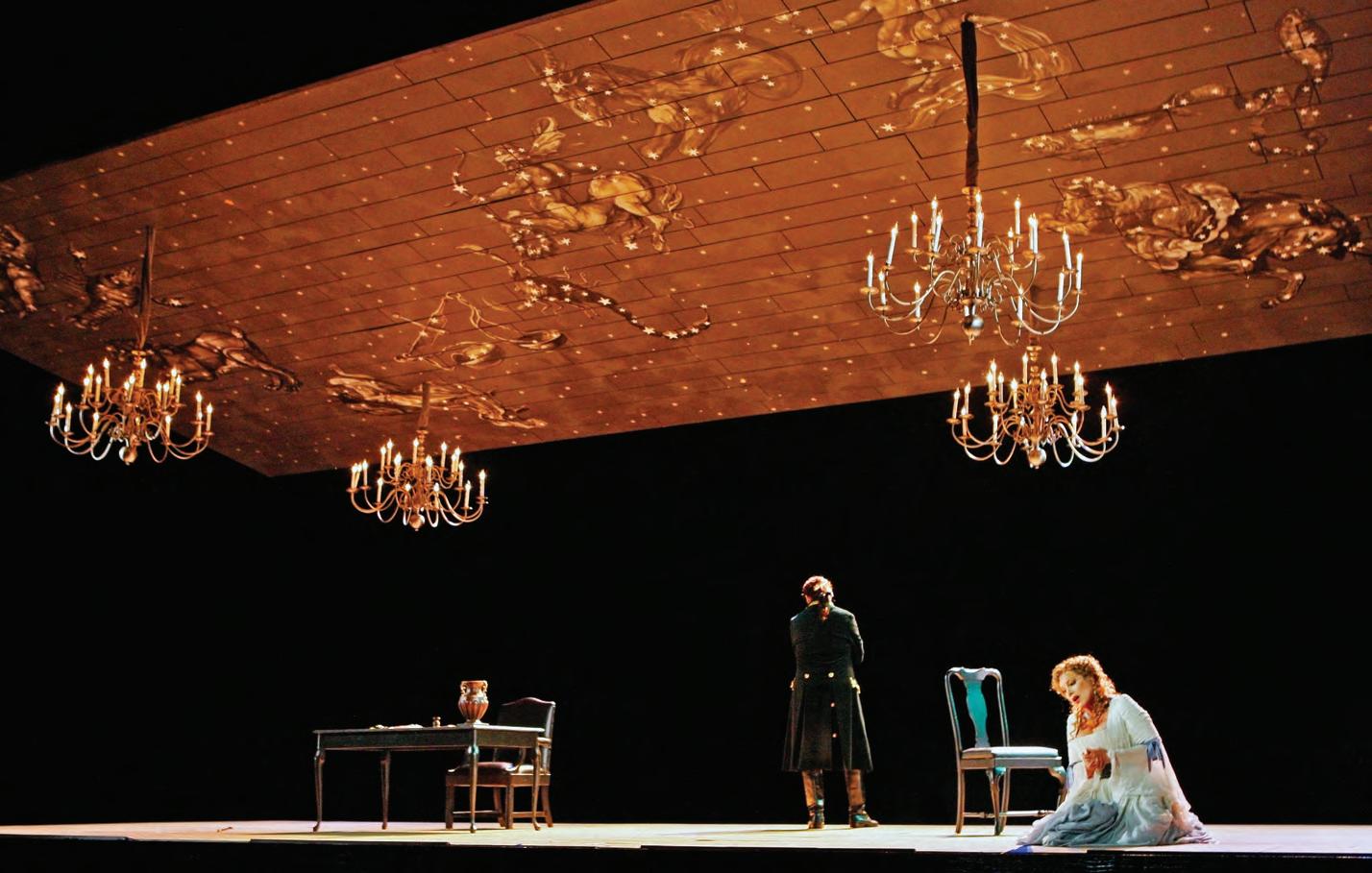

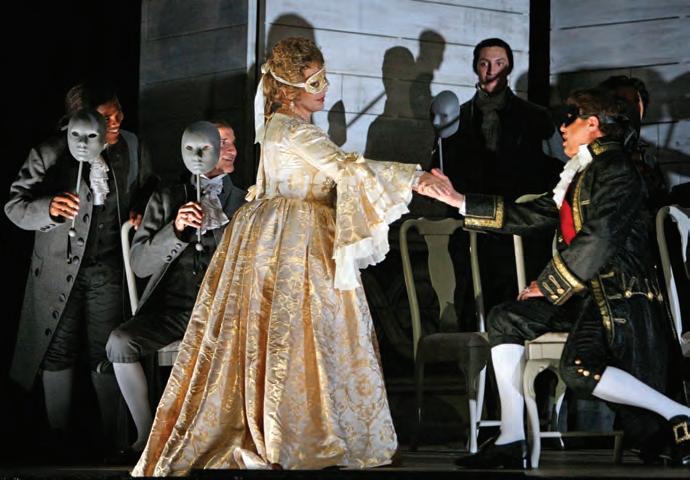
Robinson had a capable cast to work with and impressive voices, though the common practice among the principals on opening night was to oversing. Charles Taylor’s mighty bass-baritone gave the role of Anckarstrom (Renato) both force and weight, though what was needed was a more nuanced treatment of the vocal line. Evan Powers brought a fine, ringing tenor to the part of the King and, at the very least, an eager earnestness to what is one of Verdi’s most interesting tenor roles. Cynthia Lawrence showed dignity and pathos in the part of Amelia, molding her phrases with natural warmth and assured understanding of the character. Nili Riemer was a sprightly, vocally agile Oscar. Conductor Miguel Harth-Bedoya drew forth both the sweep and the rhythmic pulse of the score but seemed at times too stiff, too unyielding, in the lyrical moments, as in the King’s aria in the first scene.
CONSIDERABLY MORE PLAYFUL was Minnesota Opera’s production of The Italian Girl in Algiers, Rossini’s comic opera about a feisty and resourceful young woman who is captured by pirates, enslaved by a despot, and yet manages to wheedle her way out of a tough situation through cleverness and pluck. Marilyn Horne basically owned the role of Isabella
in the 1970s and ’80s and sang it at Northrop Auditorium during one of the Metropolitan Opera tours. Vivica Genaux, the Alaskan-born mezzo-soprano, had become the Isabella of choice by the time Minnesota Opera took up The Italian Girl for the first time in a lively production on loan from the Santa Fe Opera. Helena Binder (who staged the company’s imaginative Tales of Hoffmann in 2006) demonstrated a flair for comedy and comic timing in this production. Everybody in the cast got to show off their vocal and comedic skills, starting with the Polish bass Wojtek Gierlach who, as Mustafa, the ruling Bey of Algiers, started out as a tough villain but was eventually seduced into submission by Isabella. Alison Bates as Mustafa’s jilted wife, Elvira, showed off a brilliant soprano voice, and Andrew Wilkowske was a riot as Taddeo, Isabella’s fellow castaway who is reluctantly turned into an Islamic holy man. Good as they all were, it was really Genaux’s show. Her singing in this classic coloratura mezzo-soprano role was stupendous. Her florid sweeps into her highest register and her forays into the lower, darker areas of her voice were thrilling to hear, and she easily captured the character’s sprightly resourcefulness. David Woolard’s rainbow-colored costumes and Robert Innes Hopkins’s clever oversized toy box set added to the charm of the evening.

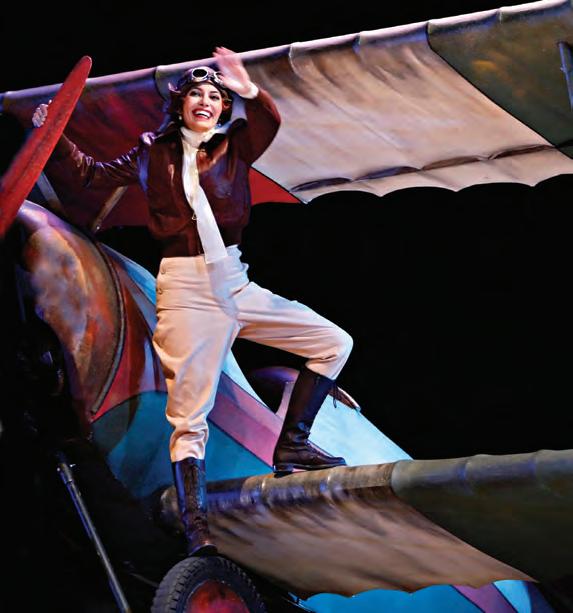
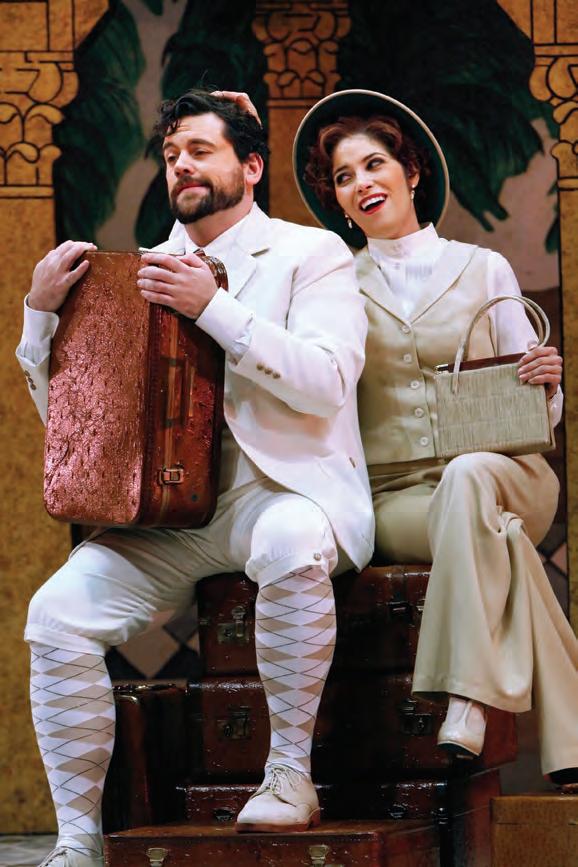
PERHAPS THE SADDEST TALE in all of opera is that of Rusalka, the little water sprite who enters the human world in search of love, specifically the love of a certain prince, who eventually betrays her. Rusalka enacts a fearsome revenge: she literally kisses the prince to death, after which she wanders the world forever as a homeless spirit. Dvořák, calling this his “lyric fairytale,” filled his operatic version of the story with some of the most lush, vibrant music he ever wrote, and even though Rusalka has never quite made it into the operatic mainstream, the opera can, in the right hands, offer a rare and evocative experience, as it did in early April 2008, in a new production, the finale of the company’s forty-fifth season.
Part of the evening’s allure came in the sheer beauty of the production—the work of veteran director Eric Simonson, set designer Erhard Rom, costumer Kärin Kopischke, and, certainly not least, projections designer Wendell K. Harrington, whose imaginative blend of slides and video (enhanced by Robert Werzel’s deft lighting) seemed to pull us right into the leafy world of nature that Dvořák and his librettist depict so engagingly in the first and final acts of this dreamlike opera. The forest background was in constant motion, offering frequent surprises. At one point in the first act a deer standing amid the trees began to move, as if it were about to step out of the picture, jump across the orchestra pit, walk down the aisle, and autograph a few programs. Moreover, we were presented more clearly than in most productions of this work with the two distinct worlds: the timeless natural world that Rusalka lives in, a world of brilliant colors, contrasted with the human environment of act two, all gray and jagged and icy, a world in which Rusalka—a fish out of water, as it were—can never feel at home.
Minnesota-born Kelly Kaduce was the attractive and appealing Rusalka. Kaduce sang from start to finish with telling clarity and pure, focused tone. She rose to the role’s big moments thrillingly, especially in her hypnotic apostrophe to the moon, the opera’s most famous
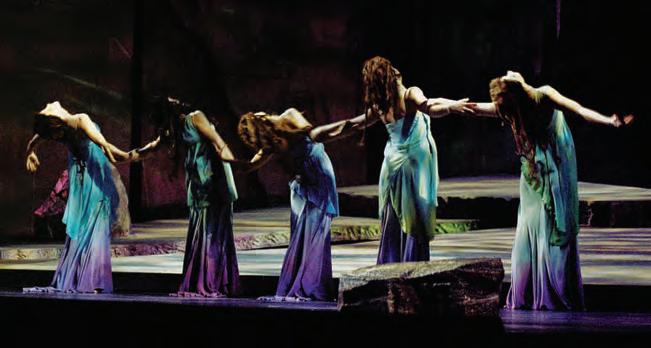

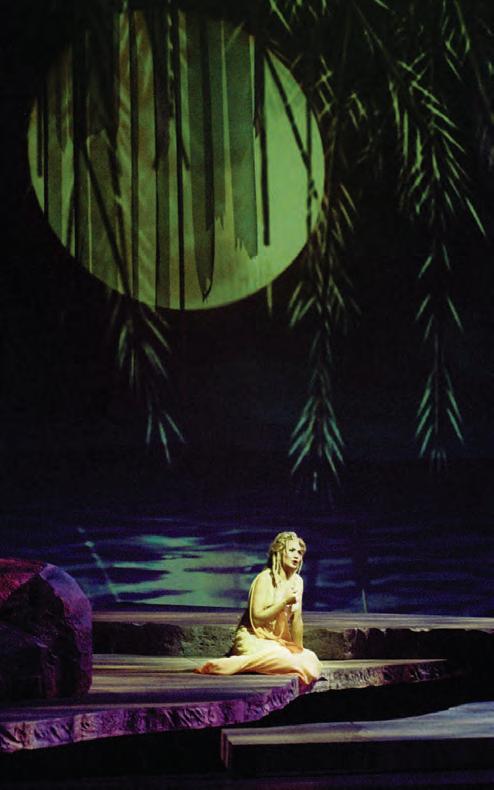
aria, as well as in her final duet with the wayward prince, while poignantly conveying in the second act the character’s growing frustration. Her counterpart, the feckless prince, Brandon Jovanovich, winner of the 2007 Richard Tucker Award, was not so feckless in this production. Here he’s just as attracted to the water sprite as she is to him, at least at first. Moreover, Simonson makes the prince a figure of brooding melancholy. We see him staring anxiously into the water as if searching not just for Rusalka but for relief for what troubles him, as if he seeks death right from the start. Jovanovich revealed a sound that’s perfect for this dark-colored music: a rich, vibrant tenor with baritone-textured high notes.
WHAT WILL PROBABLY BE the season’s most lasting accomplishment, however, took place not on stage but in the Ordway foyer October 9, 2007, as leaders of four of the Twin Cities’ major arts organizations signed a cultural armistice that they claimed would end nearly a quarter century of stressful competition, bad blood, and obstinacy. What they signed is called a “master agreement,” but the thirtyfour-page document was more like a peace treaty among the four: the Ordway Center for the Performing Arts, the St. Paul Chamber Orchestra, Minnesota Opera, and Schubert Club. The foundation of the agreement was a new rent structure for the Ordway’s users and a fixed yearly calendar that would distribute use of the Ordway’s main theater among the organizations. The agreement also created a nonprofit organization, the Arts Partnership, to mediate disputes among the members and raise money for improvements in the Ordway. The agreement was the culmination of two years of conversations aimed at bringing an end to what Ordway president Patricia Mitchell called “the areas of conflict that have plagued us for the last two and a half decades.” The question of how time in the hall should be divided up and who should pay what had been contentious issues since the Ordway opened in 1985. Tensions rose so high in some years that Minnesota Opera and the Chamber Orchestra considered abandoning the Ordway to build their own facilities, which was eventually resolved with the creation of the Concert Hall, which was completed in 2015. Minnesota Opera president Kevin Smith was to be the first to chair the partnership, with leadership chores rotating among the groups each year.
IT’S NEVER ALL THAT EASY to be a good little boy, and it’s even harder if you’re a puppet like Pinocchio, who would like to be a real boy but is a little short on what it takes: willpower, studiousness, forethought, and self-esteem. And now, thanks to Jonathan Dove and Alasdair Middleton, he has to sing too. For their new opera version of the story, The Adventures of Pinocchio, which received its North American premiere at the Ordway February 28, 2009, by Minnesota Opera—the first installment in the company’s seven-year New Works Initiative—Dove and Middleton, composer and librettist, adhered more closely to the original book by Carlo Collodi, published in 1883, than did Disney in the beloved 1940 animated movie. Disney’s puppet is just as cute as a bug’s ear, and his maker, Geppetto, is a kind, lonely old duffer looking for company. Collodi’s Pinocchio, on the other hand, is an annoying kid, while the impoverished Geppetto is hoping to make a few bucks taking his creation around to puppet shows. Though there is ample wit in Middleton’s libretto, with its many short, fast-moving scenes, the darker, even sinister, undercurrent in the tale is unmistakable. In short order, despite the earnest efforts of our old friend, the Blue Fairy, to save him, Pinocchio, pursued relentlessly by villains, is alternately pummeled, burned, robbed, hanged, ridiculed, eaten, and turned into a donkey, and that was on a good day. And yet the tale never stays dark for long, thanks to Dove’s colorful, ever-shifting score. Dove was an experienced opera composer, this being his twenty-first opera. A composer who knows how to sustain and build dramatic tension, Dove writes gracefully for the voice, both solo lines and in the big choral numbers that conclude each of the two acts. His orchestration is deft and playful. There are echoes of Prokofiev, along with a couple of Wagnerian climaxes and, in the staccato brass figures, a hint of John Adams, but the mix is Dove’s own polyglot idiom.
The production by Martin Duncan with sets and costumes by Francis O’Connor was first seen in Leeds at the work’s premiere in 2007. It’s an eyeful. Over the course of nearly two dozen smooth scene changes, O’Connor shrewdly mixed the human and the fantastic, such as Pinocchio’s ever-elongating nose when he’s lying to the Blue Fairy, or the stupendous Big Green Fisherman looming over the stage or the amazing bellyof-the-fish scene near the end. As Pinocchio, Adriana Zabala was onstage almost the entire evening, bounding about with restless, boyish energy and displaying a firmly focused mezzosoprano that sustained an even tone from top notes to bottom.

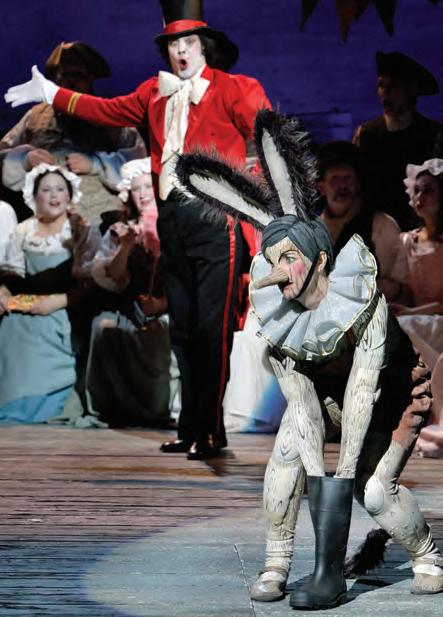
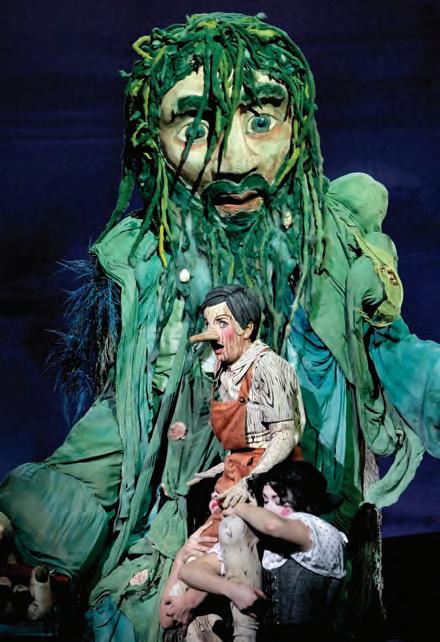

Baritone Andrew Wilkowske was a sympathetic and expertly sung Geppetto, a younger version of the character than we’re used to. Maureen O’Flynn showed off an agile coloratura playing the Blue Fairy, and tenor Brad Benoit brought a gentle poignance to the wayward Lampwick’s death scene. Making her company debut, conductor Anne Manson paced the proceedings smartly and drew opulent sounds from the orchestra, especially from the brass players. Pinocchio was commissioned by Opera North and Sadler’s Wells, both of whom call this “a family opera.” Minnesota Opera concurred, but added that the opera is “suitable for children who aren’t afraid of the dark.”
VERDI’S IL TROVATORE has always ranked high in the esteem of opera fans. Its music and its plot, which concerns a woman who absentmindedly throws the wrong baby into a fire, are so well known that when the Marx Brothers wanted to make fun of opera, they chose Il trovatore for their classic comedy A Night at the Opera. Even so, Il trovatore isn’t programmed quite so often these days—Minnesota Opera had presented the work only once before, in 1994—and that is most likely because there are so few dramatic sopranos capable of singing a creditable Leonora, the opera’s main female role.
That may be the reason Minnesota Opera decided to open its 2008–09 season with a new production of Il trovatore. The company had found its Leonora, and she was sitting right in its backyard, the town of Holmen, Wisconsin, near La Crosse. This was the Russian dramatic soprano Mlada Khudoley, who was born in Moscow, studied at the St. Petersburg Conservatory, and had been enjoying an international career while living with her husband and three-year-old daughter in Holmen (pop. 9,000). She produced columns of full-bodied sound without strain, as if she could have sung the role twice on opening night. Her top notes were free and unforced, the high soft notes spinning out without turning metallic.
Two other Russians were making their company debut and did so with distinction: Avgust Amonov, who, as Manrico, had the dashing manner and the ringing tones to carry off an exciting “Di quella pira,” and Olga Savova, whose Azucena offered singing of all-out intensity and discriminating intelligence. Playing the villain, Count di Luna, Lester Lynch proved to be a vigorous and stylistically assured Verdi baritone. Staged evocatively by Kevin Newbury, the production gained much of its spooky character through Greg Emetaz’s large-size projections, with their recurring images of a burning woman and a huge owl’s face rolling by like clouds in a nighttime sky.
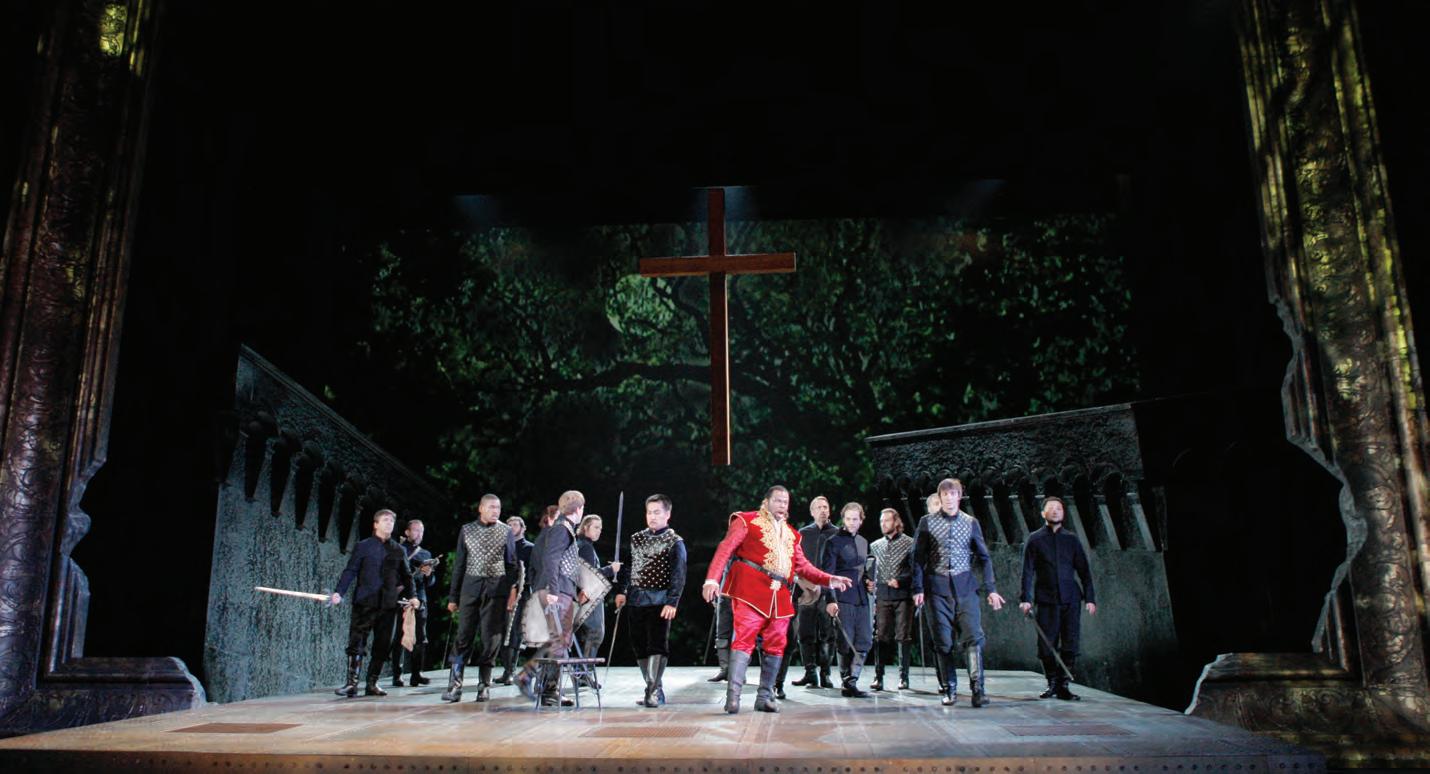
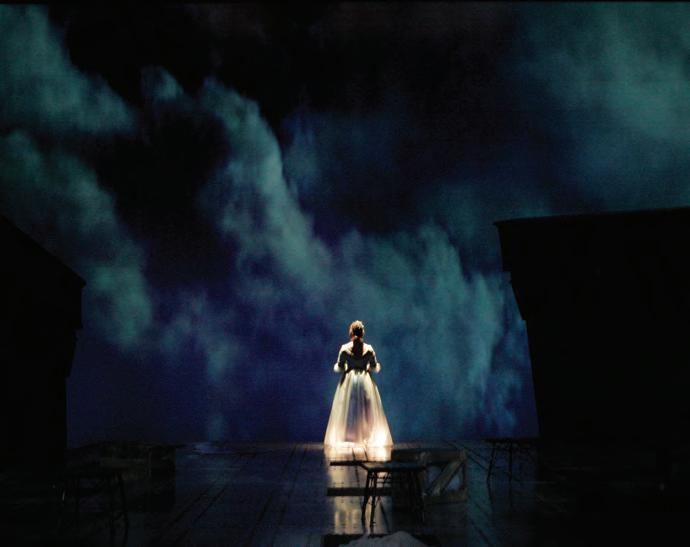
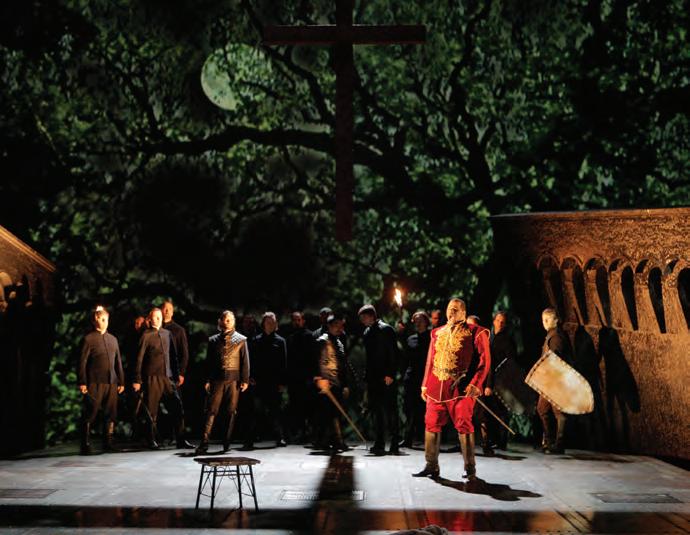
GOUNOD’S FAUST is a coat of many colors. The Minnesota Opera production seen at the Ordway in 1999, on loan from the Houston Grand Opera, was so traditional that it looked like a page from the old Victor Book of the Opera: romantic postcards from a bygone era, and quite a good production, as a matter of fact.
The company’s new Faust, unveiled January 24, 2009, went in a different direction, almost the opposite. This was a deromanticized, frankly sexual take on the familiar story that gave us, instead of pretty postcards, the jagged outlines of World War One–era Dadaist collage, along with an especially sinister Mephistopheles—clearly the center of attention this time around—and scenes peopled with extra dancers. Doug Varone, the New York choreographer who staged the production, used the nine dancers from his own troupe. More than assistants, the dancers were really emanations of the Devil’s psyche, much like the Daemons in Philip Portman’s His Dark Materials books. They do what he’s thinking and, as such, they’re up to no good. No peasant maiden is safe from them.
The dancers contributed to what Varone seemed to have in mind: taking evil more seriously than is usually the case in an opera often thought of these days as a silly story with good tunes. And happily, he had at his disposal a singer-actor with the strength and charisma to embody that evil, bass-baritone
Kyle Ketelsen, who was the impressive Don Giovanni for this company in 2006. This Mephistopheles was no jaunty boulevardier with a flower in his lapel, rather a sinister force of nature, humorless, confident of his powers, and unstoppable. Ketelsen dominated every scene he was in, and his singing was equally impressive—robust, incisive, and polished. No one else was quite in his league, though in the case of Faust, so often portrayed as weak and vacillating, the excellent tenor Paul Groves gave the character an appealing vigor that was almost heroic, and his singing combined elegance with power. Judith Howarth traced a convincing Marguerite as the beleaguered young woman progresses from tormented innocent to a woman betrayed and to final salvation, and she sang throughout with lyrical poise.
The look of the production, with its abstract sets designed by Andromache Chalifant (costumes by James Schuette, lights by Jane Cox), was not its strong suit. If there was a connection between this fifteenth-century tale, often updated to Gounod’s time, and the zeitgeist and artwork of the teen years of the twentieth century—chiefly the work of the painter Kurt Schwitters, according to a program note—that connection was not made clear. Beyond that, much credit went to conductor Jean-Yves Ossonce, who sustained momentum, clarity, and expressive profile on Gounod’s perfumed score.


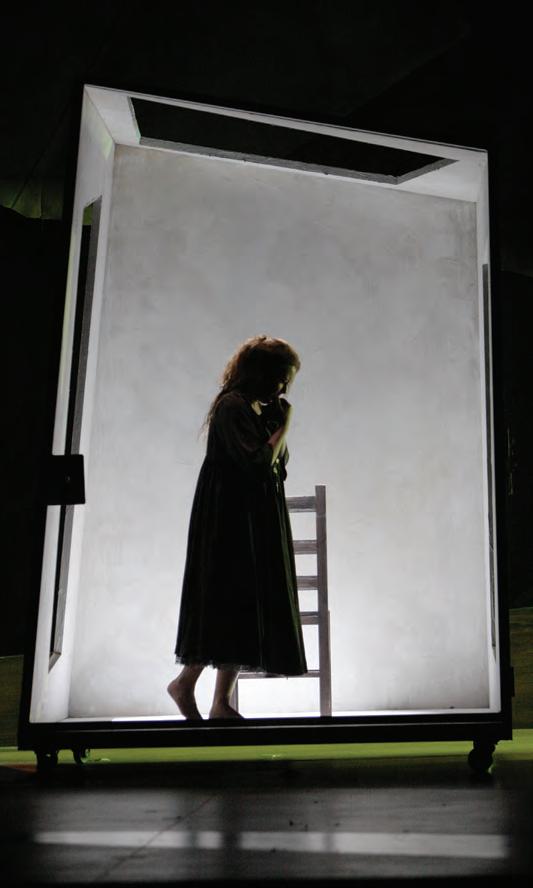

WRAPPING UP Minnesota Opera’s 2008–09 season in April, Kevin Newbury took over the company’s lively production of The Barber of Seville and made it just a little bit better before it faded away. This was to be the final revival of Chuck Hudson’s 2001 production, though the show’s sets and costumes would continue to be available to other companies as a rental. It had already been rented out to more than a dozen North American companies, including those in Omaha, Ontario, and Detroit.
Newbury allowed the evening’s humor to emerge from the characters and the situations—and the music—rather than imposing gags on the proceedings. He was especially good in the ensemble numbers, where the movement becomes increasingly intricate, like the wheels in a clock, all in keeping with the growing intensity of Rossini’s music.
WHEN THE BOOKS WERE TALLIED in June at the end of the 2009 fiscal year, Minnesota Opera managed to finish in the black, despite the onslaught of a recession. The company played to 92.5 percent capacity at the Ordway, up from 87 percent in 2008 and 81.3 percent the previous year. As far as contributions, the company hit its target of $3.4 million for its annual fund, with Increases in corporate, foundation, and government support. In addition, the company raised $4 million toward its goal of $7 million to finance its sevenyear New Works Initiative, which aims to present new and seldom-heard recent works, at least one each season. These accomplishments allowed Minnesota Opera to start the new decade with a guarded sense of confidence and accomplishment. The years 2010 through 2020 would prove to be a time of expansion and increased international acclaim mixed with the tremors of internal strife and indecision, and at the end of the decade, the challenge of a worldwide health crisis.
In 2007, on the Monday after the final performance of The Grapes of Wrath, Patrick Dewane walked into company president Kevin Smith’s office and said, “So what’s next? We’re really good at this.”
As Minnesota Opera’s development director and chief fundraiser, Patrick Dewane had played a large part in raising the money to commission and produce this new opera, which, by all measures, had been a rousing success and had brought a new enthusiasm and energy to a company that had built its reputation on doing new and unusual work. But that was then. The company’s last commission was Bok Choy Variations in 1995, more than a decade ago. In some eyes, Minnesota Opera had turned into yet another regional opera company, unsurprising and bland, churning out the same old standard rep for the benefit of the same ever-aging audience eager to show off their new outfits on opening night and trying desperately to stay awake.
“I told Kevin [Smith] we can’t wait another ten years to do a new opera,” Dewane said. “That’s when I mentioned Ardis’s ‘Toward the Twenty-first Century.’ She created that program in response to heat from the field about the big companies just giving work to dead composers. And I also pushed for a fund for digital distribution because it annoyed me that the Met was using twenty-first-century technology to distribute nineteenth-century opera. My vision was to take it a step further: to distribute twenty-first-century opera with twenty-first-century technology and to focus on living composers for a change.”
Kevin Smith talked to artistic director Dale Johnson about Patrick’s idea. Both of them liked it, as did various staff members and board chair Jane Confer. “Jane was absolutely the right person to be board chair at the time because she embraced it,” Dewane said.
“Well, I was probably in their camp to begin with,” Jane Confer said, “because of how successful Grapes of Wrath had been, and I felt there were other stories and other opportunities out there that we could make an equally strong impact with. I mean, the company had done some really fine work the past few years. They were well chosen and well cast, but they weren’t new. I thought it was time to change that.”
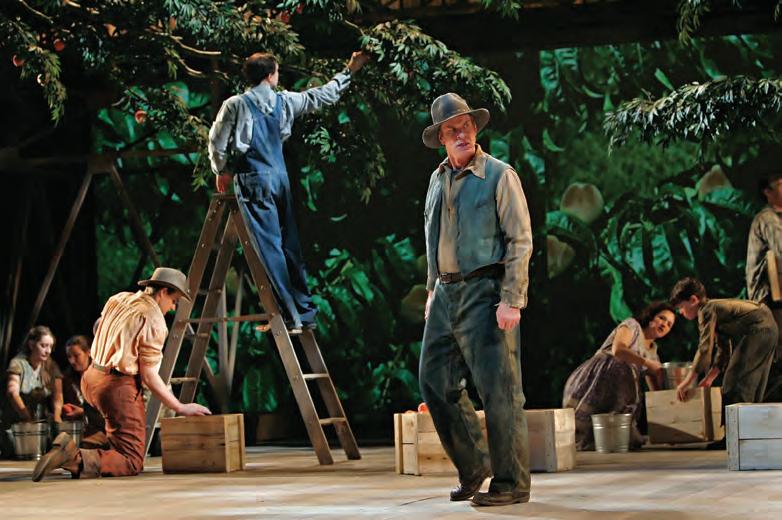
With Smith’s go-ahead, Dewane formed a committee that would oversee the project, which was called the New Works Initiative. Tom McBurney was the committee chair. The plan called for three commissioned works and four revivals of important recent operas, one each year. The original funding goal was $5 million, which quickly became $5.5 million, then $7 million. Dewane made the case to Kevin Smith that if the New Works committee raised $7 million, then none of the money for these new works would have to come out of the company’s budget.
The first installment, unveiled at the Ordway February 28, 2009, was from England, the American premiere of The Adventures of Pinocchio by Jonathan Dove, a work of considerable charm with a libretto by Alasdair Middleton, cleverly staged by Martin Duncan with imaginative sets and costumes by Francis O’Connor. Pinocchio wasn’t a blockbuster in the manner of The Grapes of Wrath, but it was an enjoyable work, and Dove’s score was full of pungent effects and happy surprises. Two of the biggest New Works Initiative productions were Kevin Puts’s Silent Night, which won the Pulitzer Prize in Music, and Doubt, which was adapted by Douglas J. Cuomo from the popular play and movie and premiered in 2013.
In July 2014, the Andrew W. Mellon Foundation gave Minnesota Opera a grant of $750,000 to support upcoming commissions of three works, The Manchurian Candidate, The Shining, and Dinner at Eight. The gift, which was planned to stretch over three years, completed fundraising for the company’s $7 million New Works Initiative. Marc Campbell would write the libretto for all three works.
Joel Puckett took a swing at writing a baseball opera with The Fix, and Paola Prestini, the New Works Initiative’s first female composer, composed Edward Tulane, a story based on the novel by Minnesota-based author Kate DiCamillo, which was postponed by the pandemic and finally had its premiere in October 2022.
“The real burn on the money is commissioning and then developing the work,” Dewane said, “because then you’re flying in all the people. You’re putting them up. They’re workshopping it, and then there’s the rehearsals and everything. In the case of Pinocchio, most of that was paid for by the Brits. But then we had to pay the coproduction fee.” The set was designed and built in England, then shipped to Minnesota.
Having the money in hand before even the commissions were handed out was a circumstance almost unheard of in the American opera world. It relieved the New Works team, including Dale Johnson and Kevin Smith, of any anxiety about whether they could pay for the works they had already commissioned and had begun developing.
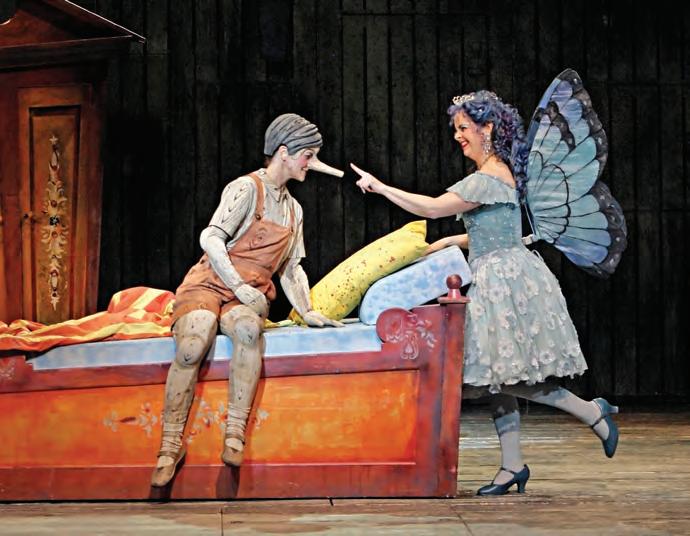
In an interview in 2018, Kevin Smith described the process in creating new works. “Dale’s job was to come up with artistic plans, which included repertoire and new works,” he said. “And when it came to new works, he would formulate a series of ideas, like, I’m really interested in this book or this subject. He would talk about that and then about composers and librettists and all those things. He took the lead on all that stuff. That was his job as artistic director. [. . .] We had to raise money and we had to produce them. I was out there looking for coproducers and dealing with rights. But it was a collaborative process.”
Margaret Wurtele replaced Tom McBurney as chair of the New Works Initiative committee in 2009. “As far as the New Works Initiative, it was really Dale’s baby,” Wurtele said. “He was the artistic director. At our meetings, he would bring maybe four or five ideas he was exploring or getting the rights to. And we would react to it. We were there mainly to raise money. The people on the committee had either contributed or were likely to contribute. And for the first round we raised $7 million that went into these pieces. So it was an education for the people on the committee, a fascinating education. We were entirely supportive. We gave our opinions—he could feel from us how things would be received— but it was very much his thing.”

Season Forty-Seven Season Forty-Eight Season Forty-Nine Season Fifty Season Fifty-One Season Fifty-Two Season Fifty-Three Season Fifty-Four Season Fifty-Five Season Fifty-Six Season Fifty-Seven Season Fifty-Eight Season Fifty-Nine Season Sixty
OPERAGOERS LOVED Casanova’s Homecoming when it premiered at the Ordway April 12, 1985. “Triumphant” was the key word in one of the local headlines. And the opera was equally well received the following season when it was presented by the New York City Opera, which had cocommissioned the work. Writing in the New York Times, Donal Henahan called the opera “an inspired account of one of the great lover’s autumnal escapades,” a “thorough-going delight,” and “a witty theater piece that should go on charming audiences for many years.”
A quarter of a century later, as part of its 2009–10 season, Minnesota Opera programmed a revival of Casanova to honor the Ordway’s twenty-fifth season and to present the work in a new production staged by James Robinson with imaginative sets by Paul Steinberg and bright costumes by James Schuette, a coproduction with the Opera Theater of St. Louis. It was also meant to be the second installment in Minnesota Opera’s New Works Initiative. The subject of the opera is Giacomo Casanova, the legendary eighteenthcentury voluptuary who wrote about his adventures and conquests in twelve steamy volumes that these days, steamy
or not, tend to sit on a shelf gathering dust until an opera composer happens to stop by. Writing his own libretto, Argento drew on several episodes from the memoir, centering on the bon vivant ’s return to Venice after years of exile in the European capitals. Old rivals trick him into seducing a castrato, whom he discovers is a woman in disguise, and together they hatch their own scheme to save his reputation and protect her identity.
In some respects, the revival at the Ordway was a better production than what was seen there in 1985. Where, in the earlier instance, Arthur Masella and designer Franco Colavecchia aimed at a realistic view of Venice in 1774 and brought a somber tone to the proceedings, Robinson and Steinberg gave their production an aura of abstract whimsey—eyes peering down on the action from large movable panels—and they underlined and clarified the humor in Argento’s libretto. An opera that felt a bit too long in 1985, and the plot overcomplicated, seemed just right this time around. Robinson had the additional advantage of an attractive cast headed by John Fanning, whose Casanova struck just the right balance between sensuality and mature, worldly wisdom. Fanning’s ample, expressive baritone retained its strength and color throughout the evening—the character

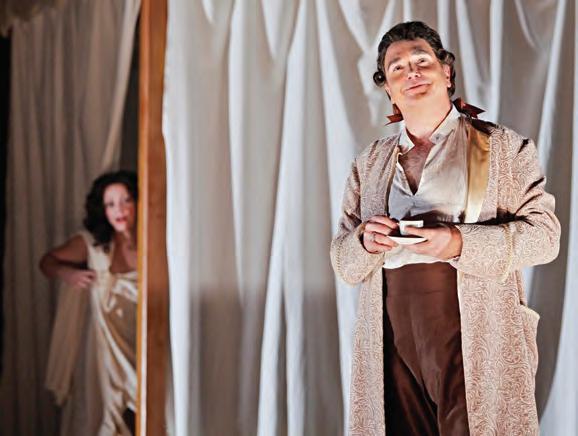
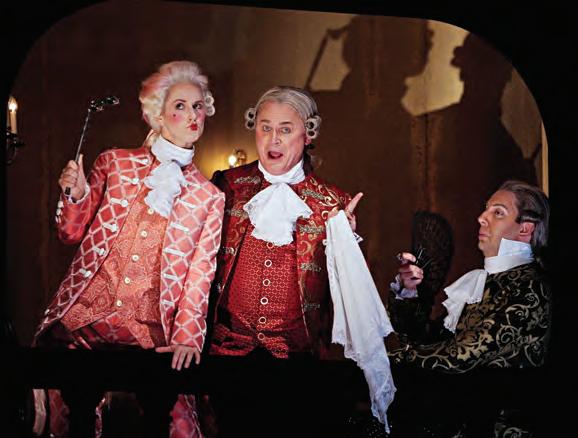
is seldom off the stage. When needed, there was sufficient force in the voice, but Fanning’s tone turned convincingly suave at the end of act one during his seduction of Teresa (the appealing Lauren McNeese), the opera singer who, for career reasons, has disguised herself as a castrato. Mezzosoprano Jean Stillwell was a madcap, vocally adroit Madame d’Urfe, the crazed, rich old lady whom Casanova tricks to win a dowry for his goddaughter. Tenor Dan Dressen, a veteran with this company, brought impressive red-faced fury to the part of the Marquis, the Madam’s greedy nephew. Leonardo Voldoni led the St. Paul Chamber Orchestra in the pit, giving the music energetic pacing and flavor.
Argento’s attractive and dramatically efficient score, with its autumnal echoes of late Richard Strauss, deftly mixes eighteenth-century textures with his own tonal, voice-friendly twentieth-century idiom and especially opulent orchestration. Above all, in Casanova he created a serious, sophisticated, and believable character. Seeing the opera perhaps made many in the audience want to join the aging roué in advising the young lovers, as he does near the end of the opera, that, “the most important thing is to live, to love, and most of all to love living.”
THE OTHER PEAK EVENT of the season was the start of an ambitious project, the first installment in the Tudor Trilogy, the three operas by Donizetti that survey the long life of Queen Elizabeth I: Roberto Devereux, Maria Stuarda, and Anna Bolena. Looked at in the context of an uncertain economy when many theater and opera companies were trimming expenses and cutting productions, Minnesota Opera seemed adventurous as it proceeded full speed ahead with all its projects intact, including its commitment to new works.
Even though it’s unlikely that Donizetti thought of these operas, composed over the course of seven years, as a unified progression, they have been seen that way ever since Beverly Sills sang all three at the New York City Opera in the early 1970s and recorded them. The Turkish soprano Leyla Gencer had sung the three parts at different times and places in Europe in the 1960s, but Sills went her one better in 1974, singing all three roles in one season at the City Opera. Sills claimed in her memoir that Devereux “was both the greatest artistic challenge and the finest achievement” of her career. She also acknowledged that it had shortened her career by at least four years, a price she was happy to pay. Despite her vocal limitations—ever more apparent as time went on— Sills’s Devereux at the City Opera in 1970 was a triumph that put her on the cover of TIME magazine. This left it to Harold
Schonberg of the New York Times to file the minority report, saying that Sills on opening night “sounded shrill and nervous and was constantly having pitch trouble.” The problem for Sills was that Elizabeth is one of the most challenging roles in the bel canto repertoire, encompassing both extravagantly ornamented singing and forceful declamation and requiring power over a wide range, to say nothing of the acting facility the work requires. Few have met all its demands.
Brenda Harris met nearly all those demands in her compelling portrayal of Elizabeth given at the Ordway, on the cold night of January 30, 2010. This Devereux was one of those rare occasions when drama and music, along with meaningful décor and a strong cast, conspire at nearly the highest level to produce an exciting evening from start to finish. Where Sills’s voice was coming apart by the time of her first Devereux, Harris was entering her vocal prime when she took on the role, even though she had been singing major parts for Minnesota Opera since her debut with the company in 1993 in the title role of Rossini’s Armida. Being a true spinto with a free and flexible top, Harris was able to bring ample weight to the role’s big pronouncements, turning shrill only occasionally, while giving affecting sweetness and agility to the softer, more lyrical moments. In later seasons she would take on heavier roles such as Lady Macbeth and Abigaille in Nabucco
Wisely, to suggest a unity in these works, Minnesota Opera engaged the same production team for all three. Neil Patel’s eye-filling designs were paired with Kevin Newbury’s uncluttered but provocative staging and Jessica Jahn’s bright period costumes to give these productions atmosphere and resonance. The operas describe Elizabeth’s long life in three parts, from the arrest of her mother, Anne Boleyn, to the imprisonment of her cousin, Mary Stuart, and finally to the trial and execution of her once favorite, Robert Devereux, Earl of Essex. Minnesota Opera presented the history in reverse order: Roberto Devereux in the 2009–10 season; Maria Stuarda in 2010–11; and Anna Bolena in 2012–13 with Keri Alkema as Anna. As Newbury and his colleagues saw it, contrasts between public and private spaces onstage, between the court’s rigid hierarchy and the fluid intimacy of the Queen’s emotional life, underlie the central conflict of the opera: Elizabeth’s irreconcilable roles, as woman and queen. At the end, in one of the production’s many telling images, Elizabeth, now an old lady in whiteface, sits alone on a throne. We view her through a picture frame, as if she is finally trapped in her public role as monarch, all the life drained from her. Conveying all this, Harris dominated the stage, as any singer must who takes on this demanding role,
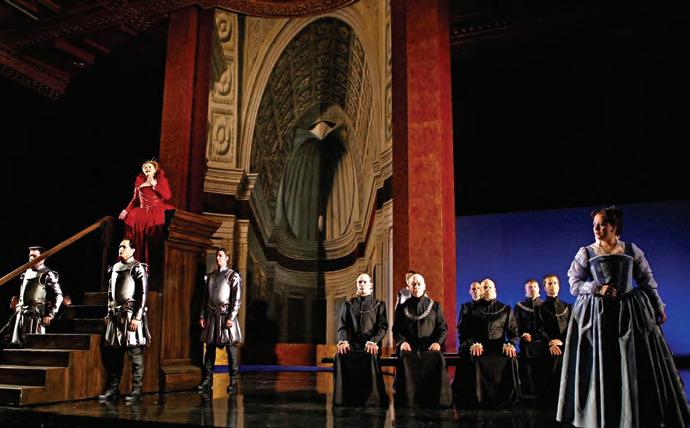

If there was something missing, it was the flaw in every Devereux. Donizetti’s librettist, Salvadore Cammarano, drew a vivid, three-dimensional portrait of England’s troubled Queen, but he neglected to give much character to the rest of the cast. The cuckolded Duke of Nottingham is the familiar outraged husband, while Roberto is a passive figure, always on the defensive. Even so, though Lester Lynch failed to avoid bluster in the role of Nottingham, the young Portuguese tenor Bruno Ribeiro, with his virile, ringing high notes, managed to turn Roberto’s passivity into a sensual, catlike presence, a young man, we can imagine, who would have no trouble capturing the Queen’s fancy. Another impressive voice was that of Tamara Klivadenko, who used her full, warm mezzo to good effect as the pathetic Sara, Nottingham’s wife. Brad Benoit and Jonathan Kimple shone brightly in the smaller roles of Cecil and Raleigh. Conductor Francesco Maria Columbo’s incisive accompaniment showed him time and again to be sympathetically in tune with Donizetti’s bel canto style.
The evening’s success raised expectations for the remaining episodes of the Tudor Trilogy. Dale Johnson recalled: “I think, of all the things Brenda did here, Devereux was her best role. That final scene is a killer. The emotional toll it takes on a singer to be out there and made up like that, Brenda seized it and it was just breathtaking. And she did it at the right time in her career. She figured out how to do it, and the director, Kevin Newbury, just let her go with it. Kevin’s a very collaborative, organic kind of director. He isn’t a dictator. They worked very closely on this. It was very moving.”
THE SEASON-OPENER, though hardly a peak event, was at least a rarity: Bizet’s The Pearl Fishers, this time in a production on loan from the San Diego Opera. Zandra Rhodes, known chiefly as a fashion designer, created the zippy sets and costumes, which, along with the pink and saffron robes of the priests, displayed a cartoon-like surf-and-sand aura enhanced by bikini-clad natives bouncing around on the beach.
and the result was a gripping performance. There was a chill in the air when, as Elizabeth, she condemned Devereux to death, saying, “It would have been better for you to incite the wrath of God than to incite the wrath of the daughter of the terrible Henry the Eighth.”
All of this suggested that we not take the story seriously, even though Andrew Sinclair, who staged the production, with John Malashock devising the athletic yet graceful choreography, had his singers play their parts realistically. As a result, on opening night, September 26, there was a sense of dramatic urgency onstage from these two devoted pals, Nadir and Zurga, sung by Jesus Garcia and Philip Cutlip, as they become rivals in love for the priestess, Leila, portrayed— and sung—convincingly by the young Armenian soprano Isabel Bayrakdarian, whose clear, forward tone and agile top provided much of the evening’s allure.
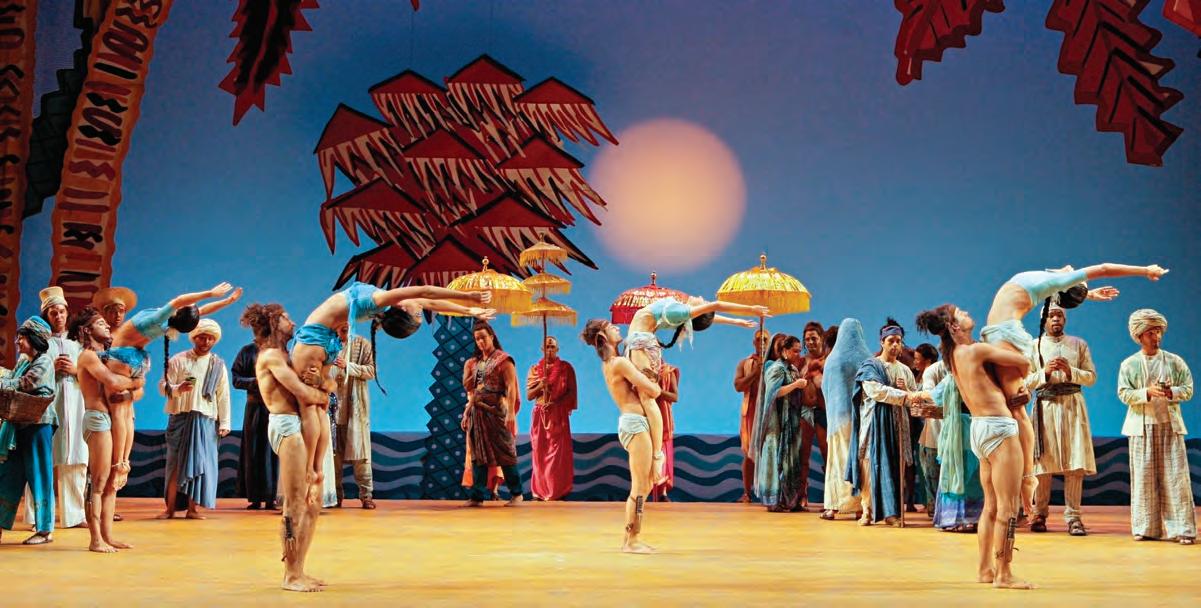
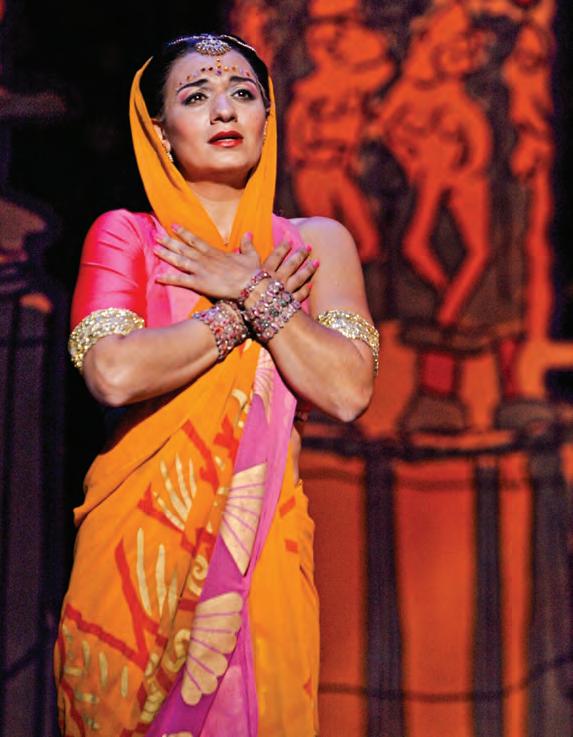
THE 2009–10 SEASON ENDED with two announcements. First, the company finished the fiscal year with a balanced budget for the eighth year in a row. Strong ticket sales were a major factor. The productions at the Ordway played to 90.5 percent capacity.
The other announcement was a jolt. Kevin Smith, the company’s president and CEO, would retire from the position he had held since 1987 but would stay on into the next season until a successor was in place. Smith, fifty-nine, joined the company in 1981 as production stage manager and rose to the leadership position five years later. During his tenure the number of productions rose from three to five, the annual budget grew from $1.5 million to $9 million, attendance doubled, and net assets grew from a negative $36,000 in 1986 to a positive $28,750,000 as of June 30, 2010.
It wasn’t known at the time, but it would take the company at least a half decade to find its way after Kevin Smith’s departure.
MINNESOTA OPERA MARCHED into its forty-eighth season like a troupe of drum majorettes leading a parade, turning cartwheels and tossing sparkling batons high into the air. What’s not to cheer about? A new president would soon be named, it was hoped, and the company, its budget securely balanced, was about to present five strong productions at the Ordway, three of them new.
The new president and managing director, announced in November, was thirty-eight-year-old Allan Naplan, a singer and composer who for the past six years had been general director of the Madison Opera in Wisconsin and before that had worked at the Pittsburgh Opera and the Houston Grand Opera. He would start March 1, 2011.
The 2010–11 season consisted of one fine production after another. The casting, the work of Dale Johnson, couldn’t have been better, most notably in the case of two especially demanding roles: countertenor David Daniels playing Orpheus in Gluck’s Orpheus and Eurydice and soprano Brenda Harris portraying Queen Elizabeth I in Donizetti’s Mary Stuart
English director Lee Blakeley staged Orpheus, which opened the season September 22, 2010, offering a thoughtful retelling of the timeless tale of art’s power to overcome death. Aided by the intriguing sets and costumes of Adrian Linford, Blakeley placed the action in an eighteenth-century court theater, with Orpheus wandering backstage in search of Eurydice or some more complete version of himself. The staging suggested an ambiguous, uneasy relationship between illusion and reality. In one of the production’s several evocative images—chorus members in masks slowly dropping from the ceiling into the afterworld, the supposedly blissful Elysian Fields—there was the hint that life after death is not so serene as myth and religion promise. And Blakeley solved the problem that confounds most productions of Orpheus : what to do with those boring dances at the end. Using the dancers of the excellent Zenon Dance Company and the choreography of Arthur Pita, Blakeley evoked the old theatrical tradition of the afterpiece, which satirizes the story we’ve just seen. Here it was both funny and disturbing. Eurydice, sung exquisitely by Susanna Phillips, watches the dance and is herself disturbed by it, as is the audi-




ence. As for Daniels, by then the world’s most revered countertenor in one of his trademark roles, his Orpheus was both intensely dramatic and vocally accomplished. Where many countertenors emit a steely sound that can be off-putting, Daniels makes his wide-ranging, agile, warm-toned voice seem natural. The character’s grief over the death of his beloved Eurydice in the first scene came across with touching poignancy. Meanwhile, down in the pit, early-music expert Harry Bicket led the St. Paul Chamber Orchestra in a sensitive and incisive performance of Gluck’s luminous score.
THE OTHER STAR PERFORMANCE of the season, Brenda Harris’s fiery portrayal of Queen Elizabeth, was a follow-up to her indelible portrait of the same character in the previous season’s Roberto Devereux. While the Elizabeth of Maria Stuarda is usually portrayed as a cold-blooded villain, Harris managed to make the character at least partially sympathetic, and her scenes with Judith Howarth, who sang the part of Mary, were explosive. These were bel canto singers of the highest order. As in the previous opera, Kevin Newbury’s staging was smart and sensible, as was Anne Manson’s conducting.
THE FILM COMPOSER Bernard Herrmann, best remembered for his scores for Citizen Kane, Vertigo, and Taxi Driver, among many others, visited Minneapolis in 1948, in hot pursuit of a young woman, a Miss Lucy Anderson. At the time he was working on an opera version of Wuthering Heights, the classic novel by Emily Brontë. Herrmann and Anderson were married a year later, but the opera wasn’t finished until June of 1951. Herrmann wrote some of it while staying at the Nicollet Hotel at the corner of Hennepin and Washington Avenues. Lucy was Herrmann’s second wife. He apparently remained on good terms with his first wife—another Lucy—Lucille Fletcher, who wrote the opera’s libretto, a skillful piece of work. Herrmann’s efforts to get the opera produced—it was his first—came to nothing, partly because he refused to make changes. When Portland Opera gave the work its premiere in 1982, Herrmann had been dead for seven years.
As with the classic 1939 film version starring Lawrence Olivier and Merle Oberon as Heathcliff and Cathy, the doomed lovers, the opera deals only with the first half of Brontë’s novel, ending the story with Cathy’s death. For the Minnesota Opera production, which closed the 2010–11 season—the third installment in the company’s New Works Initiative—director Eric Simonson and his creative team made shrewd use of multimedia, the most notable examples being Wendall K. Harrington’s evocative video and slide projections, which served to open up the story. Nature, as both friend and foe, was a constant presence—a foe certainly in the case of the gloomy Christianity represented by the other family members. In contrast, Cathy and Heathcliff are identified with nature. They are mid-nineteenth-century flower children. By marrying Edgar Linton, Cathy seals her doom. She settles for a bourgeois—for her, unnatural—life, a life


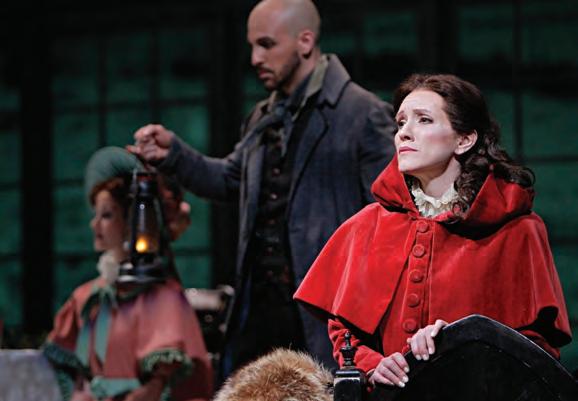
embodied cleverly by Neil Patel’s tidy Hollywood Hills–style set for Thrushcross Grange, which is contrasted with the wild, increasingly unkempt house she and Heathcliff grew up in, Wuthering Heights.
Despite occasional flaws, the opera is a rich and rewarding endeavor, as compelling in dramatic terms as it is musically accomplished, and the thoughtful production it received under Eric Simonson’s direction only served to make the opera’s strengths abundantly clear. Few first operas are this strong. Leading the excellent cast was Lee Poulis, a handsome Heathcliff and a brooding, powerful presence onstage. The character’s wounded pride and aristocratic bearing gave weight to Simonson’s theory, put forth in a program note, that Heathcliff is the love child of the elder Earnshaw and is therefore Cathy’s half-brother, a relation that Brontë could only hint at. Incest was not an acceptable subject in nineteenthcentury literature, especially in England. Poulis’s rich baritone was a perfect match for Sara Jakubiak’s soaring, firm-toned soprano, and, as Cathy, another compelling characterization, a woman torn between conflicting impulses, nature versus respectability. Among the others, Ben Wager was convincing as the dissolute Hindley, Adriana Zabala a sweet Isabella, and Jesse Blumberg a believably nervous Lockwood. Conductor Michael Christie drew a polished, passionate performance from the orchestra.
IN NOVEMBER Doug Varone staged Minnesota Opera’s lighthearted, elegant, and truly funny production of Rossini’s La cenerentola, a production that boasted the American stage debut of the Romanian mezzo-soprano Roxana Constantinescu, who delivered a winning, sympathetic portrayal of the “maid of ashes” enhanced by singing that was as refined as it was expressive. Varone’s staging was full of surprises and witty light-as-air touches that managed to take the familiar story seriously while allowing ample opportunity for laughs. The Canadian tenor John Tessier was an ardent, handsome Prince, and his light, agile voice—what was once called a tenorino —was the perfect sound for this role. Andrew Wilkowske, a familiar voice to these audiences, made the most of his role as Dandini, the valet who portrays the Prince, and he sang with impressive resonance.
Another distinctive performer—and performance—this season was Elizabeth Futral, whose Violetta in a revival of the company’s 2003 production of La traviata was exquisitely sung from start to finish while offering a convincing portrait of a conflicted courtesan who gives it all up for love and loses everything.

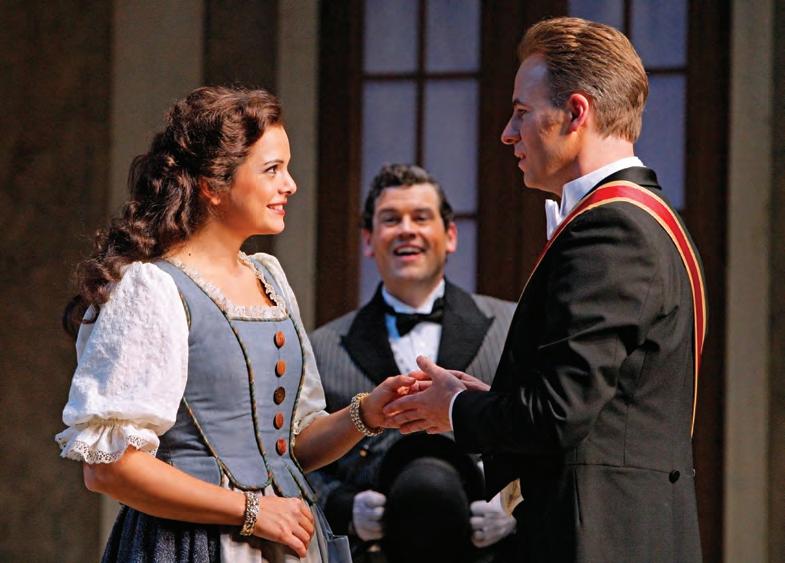
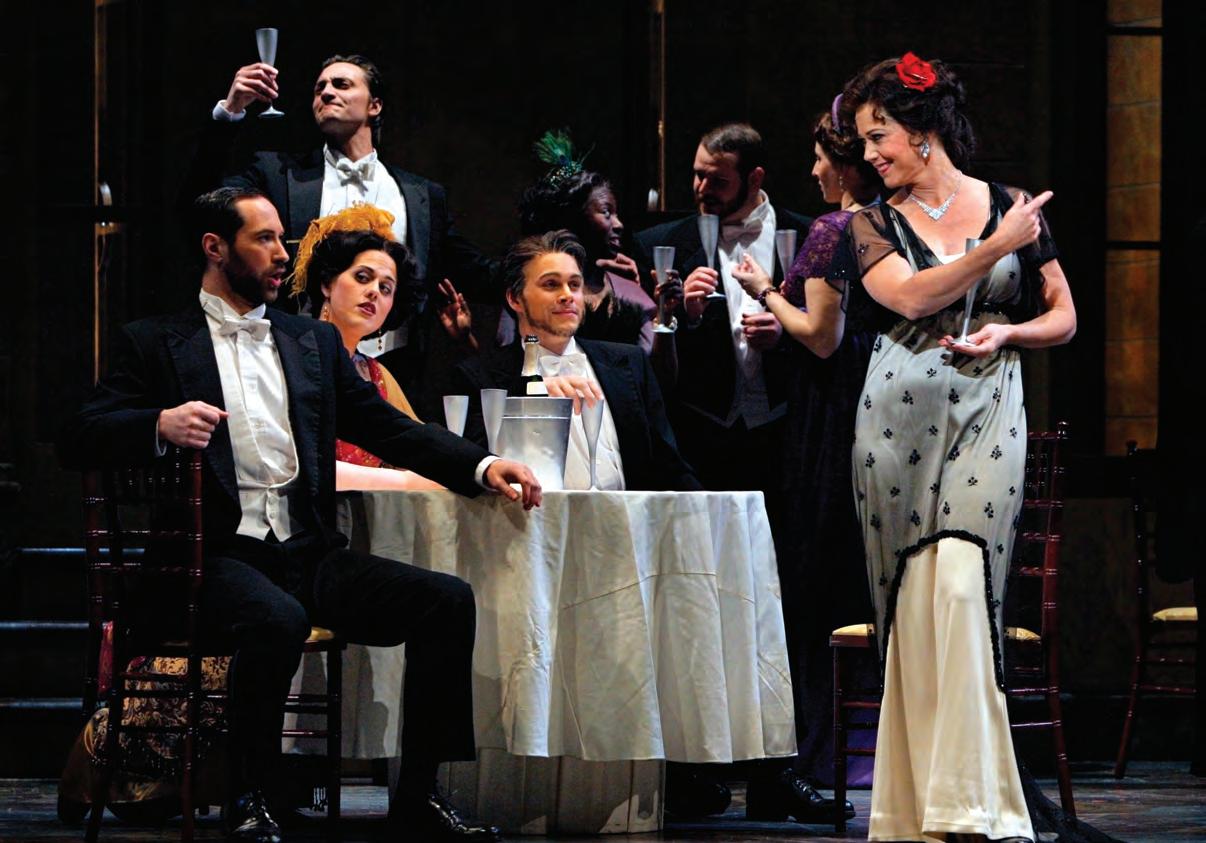
FOR THE NINTH YEAR in a row, the company ended its fiscal year with a surplus. Donations for the annual fund reached $2.89 million, a 1.8 percent increase over the previous year, and a new fund was initiated, the Kevin Smith Legacy Fund, named in honor of the company’s retiring president. The season’s five productions attracted 42,562 patrons, an increase of 3.2 percent over the previous year.
Nearly two hundred guests attended Kevin’s retirement party at the company’s Minneapolis headquarters on February 27. Among the gifts given was the severed head of John the Baptist that was used as a prop in the 2009–10 production of Salome. One of the guests, Marc A. Scorca, president and CEO of Opera America, hailed Minnesota Opera as “one of the strongest opera companies in the United States with the best board in the country.”
THE 2011–12 SEASON was a gift-wrapped bundle of surprises, not all of them happy. In January, Michael Christie was named music director. Allan Naplan, the company’s new president and managing director, resigned after just twelve months in office, and the storm clouds on the horizon looked more threatening than usual.
And yet, considering what the company put on the Ordway stage during these months, it was a fine season: five engaging productions topped by the premiere in November of Silent Night, an opera about the Christmas truce of 1914 that turned out to be one of the most important and satisfying works the company had ever commissioned. And then, to top it off, came the news in April that Silent Night—music by Kevin Puts,
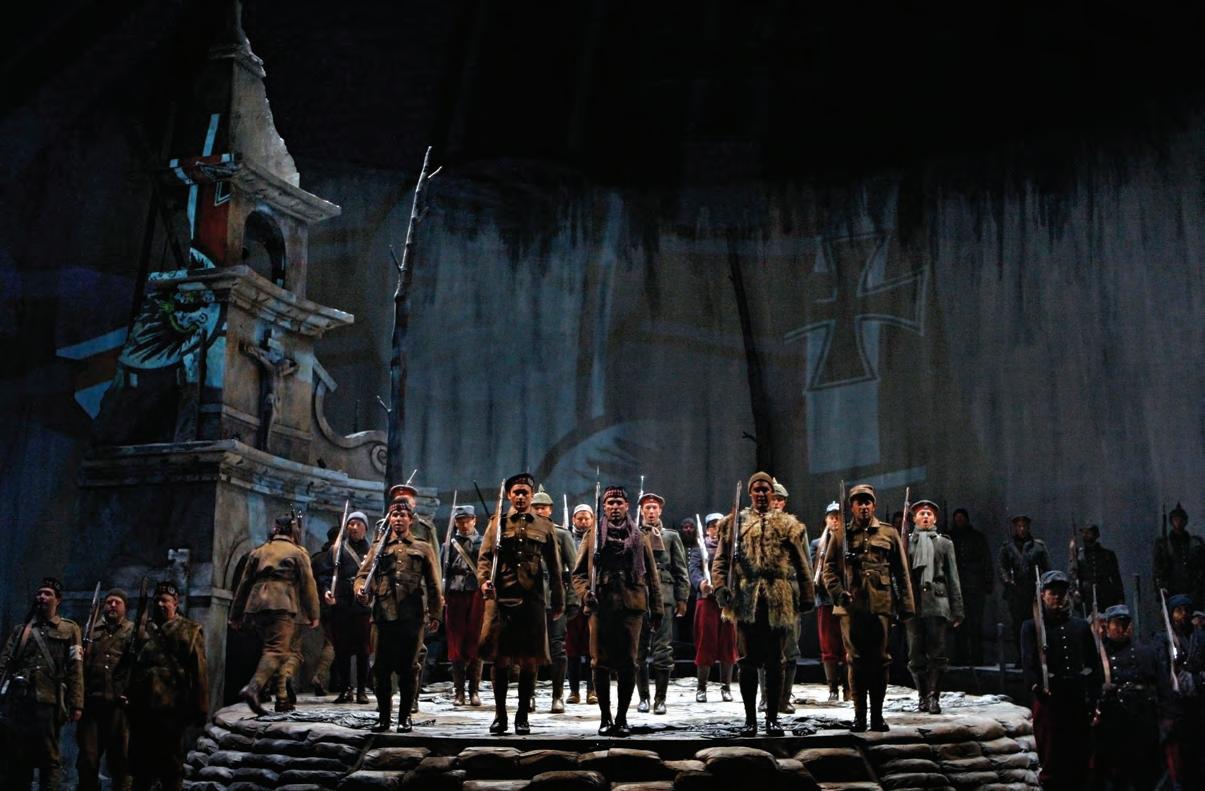
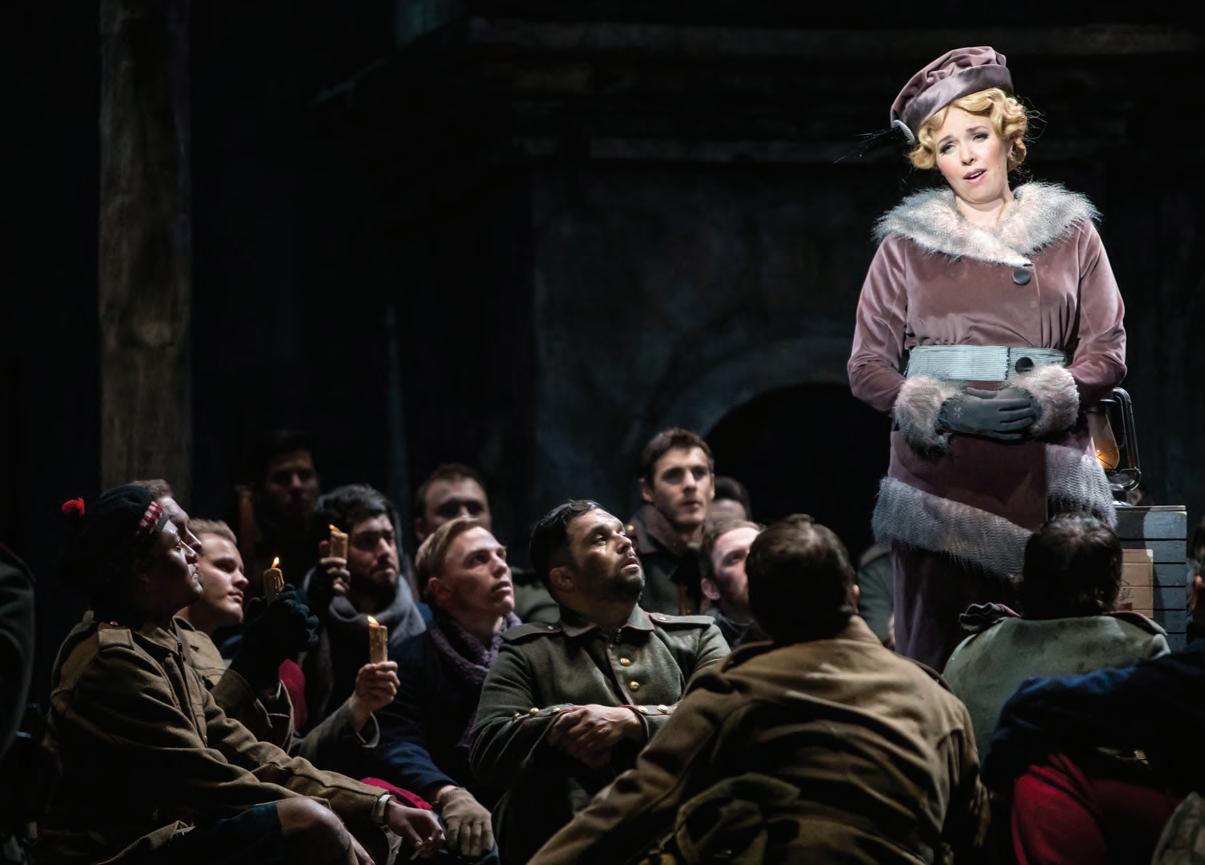
libretto by Marc Campbell—had been awarded the Pulitzer Prize in Music. This was no small accomplishment, given that operas seldom win the Pulitzer—just seven had won since 1943. Moreover, although Campbell had written eight or nine librettos of various types, Silent Night was Puts’s first opera, and first operas seldom succeed. Has anybody seen Verdi’s Oberto lately?
As for Silent Night and its origin, military historians have largely forgotten the ceasefire of 1914 or have quickly passed over it in their accounts of the Great War. However, the acclaimed film of 2005, Joyeux Noël (“Merry Christmas”) by Christian Carion, brought the story to a worldwide public in a screenplay that utilized fictional characters while adhering to the basic facts of this bizarre event. The opera by Puts and Campbell that Minnesota Opera premiered at the Ordway November 12, 2011, draws on the characters and events of
Carion’s screenplay, and the result is a strangely haunting and powerful opera, a work staged brilliantly by Eric Simonson and his creative team. Though not without flaws, this work, quite possibly, will go on to have as big an impact—and maybe even as big an audience—as the film on which it is based. The opera is traditional in form in that it consists of clearly distinct solo, ensemble, and choral numbers, all flowing together easily and naturally. Puts’s vocal writing moves easily too, from declamation to a kind of flexible arioso to big ensembles, the tone varying from extreme violence in the battle scene of act one (staged convincingly by Doug Schotz-Carlson) to a tender wistfulness in later scenes, along with original carols, marching tunes, and clever evocations of Mozart and Schubert. (No “Silent Night,” unfortunately.) Touches of Prokofiev and John Adams can be heard, as well as maybe a hint of Britten’s Peter Grimes in the four atmo -
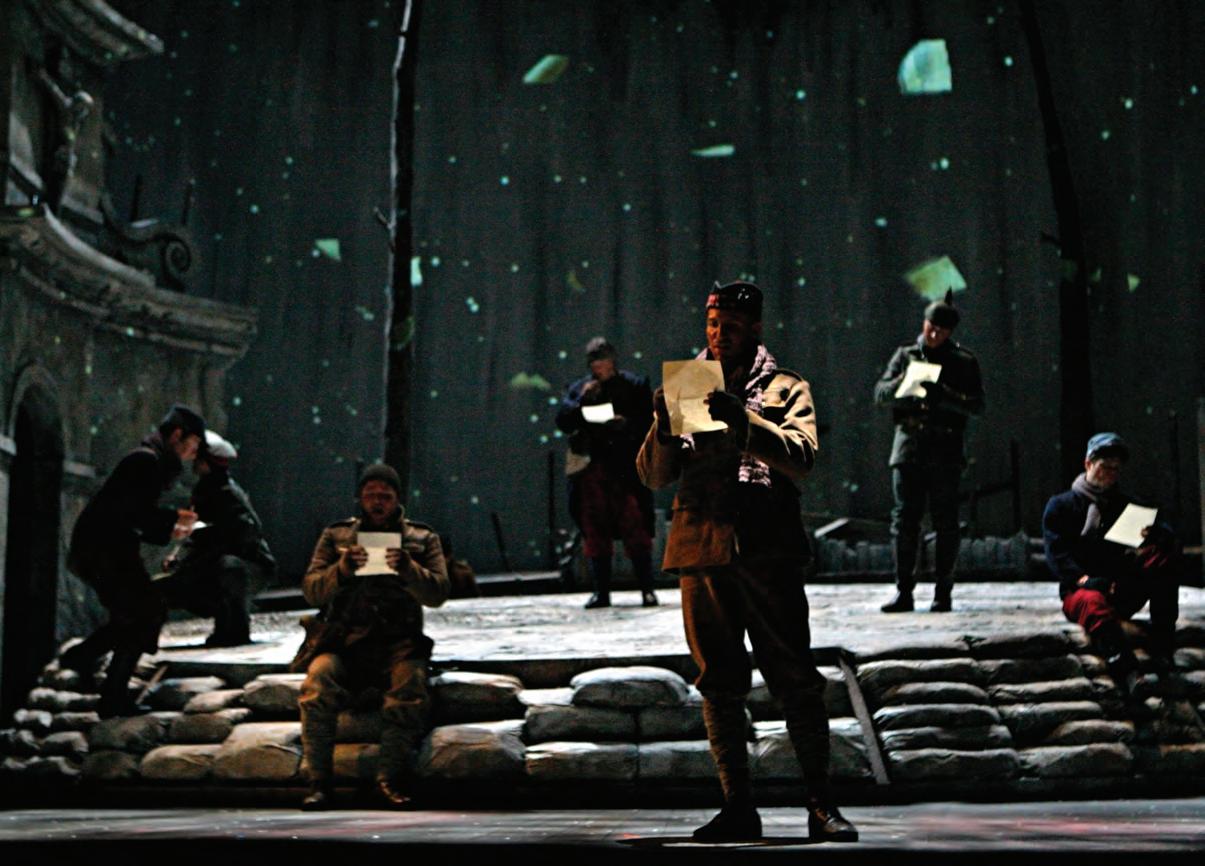
spheric interludes for orchestra that bridge some of the scenes. But Puts has his own expressive idiom: a rich lyricism sprinkled with dissonance and an ability to chart the dramatic line and the emotions of a scene with a minimum of notes. In turn, Campbell made shrewd choices in his adaptation of the screenplay, dropping some characters and enhancing others, and he introduced welcome humor that the film lacks. And though he tries, what Campbell couldn’t do is give act two much dramatic weight. As in the film, there’s no real climax. The truce, which concludes act one, is already over. It’s a flaw for which there is no apparent solution. It’s a story, in other words, and an engaging one, rather than a drama. The opera ends as the soldiers, being punished, are moved to another part of the Front. As the snow falls, the music fades out delicately, as if it had all been a dream.
Rotating set pieces can be a nightmare for all concerned,
but the one designed for Silent Night by Francis O’Connor, surrounded by a cyclorama on which slides were projected, with a Bayreuth-style tilted disc in the center, was as eyecatching as it was useful in giving us the three encampments: the French, English, and German. Kärin Kopishke’s period costumes were thoughtfully detailed, and Marcus Dilliard’s lighting added atmosphere, as did the projections by Andrzej Goulding. With the exception of tenor William Burden (who, suffering from laryngitis on opening night, walked through the part of Sprink while Brad Benoit sang the role at the side of the stage), the cast was in fine voice, among them Karin Wolverton, John Robert Lindsey, Liam Bonner, Andrew Wilkowske, and Craig Irvin. Michael Christie conducted with fervor and skill, and the chorus of forty voices made rich, committed sounds all evening. The opening-night audience responded at the end with a standing ovation.
Dale Johnson, Minnesota Opera’s artistic director for more than two decades, often did his serious listening to music while driving. On one occasion, in 2007, the music he heard was so compelling he had to pull over. It was Symphony No. 2 by Kevin Puts, a young American composer from St. Louis. He knew that Puts had never written an opera, but concluded that “he knows how to build tension into music, and that’s a key.”
Johnson had been looking for a follow-up to The Grapes of Wrath, an operatic version of the John Steinbeck novel that the company premiered to wide acclaim the previous winter. Now he was convinced that he had a good idea: an opera based on a French film he had seen recently, Joyeux Noël. The film tells the true story of the “Christmas Truce,” when, during the first year of World War One, on Christmas Eve, 1914, some 100,000 German, French, English, and Scottish soldiers threw down their weapons, climbed out of their trenches, and made the frightening walk across no-man’s-land, where they mingled with their enemies, exchanged food and souvenirs, sang carols and, at one point, played a game of soccer, the Germans beating the English three to two. In some places along the Western Front, the truce lasted through Christmas Day, thereby allowing the troops to carry their

dead comrades back across the lines for burial. Fighting immediately resumed, continuing until 1918 and leaving some nine million soldiers dead. The ceasefire, unsanctioned and unplanned, wasn’t reported until a week later, first in the New York Times and then throughout Europe, and has largely been ignored in histories of the Great War.
Johnson called Puts and asked him to get a copy of Joyeux Noël, and then he called a librettist he knew, Mark Campbell, and asked him to listen to some of Puts’s music. Both were impressed. Puts liked the movie, and Campbell gave a thumbs-up to the music he heard. “Kevin’s music is dramatic,” Campbell said. “Many composers write brilliant symphonies, but don’t know how to compose an opera.”
Puts and Campbell, who also lives in New York, met, found each other compatible, and said yes to the project. Work began in the spring of 2009, the libretto, as always, coming first.
It’s not an easy story to tell. Beside the large number of characters and languages that need to be sorted out, the biggest problem was that the climax, which is normally near the end of a script or a screenplay, occurs early in the story. The truce is the climax. Campbell’s solution was to put the ceasefire at the end of the first act, while hinting that the truce is fragile and that therefore the second act will be full of complications. “It was when I finished the first act that I discovered what this story is really about,” he said. “It’s about how can you continue the nasty business of war when you know who your enemy is?”
Within a few months, Campbell sent Puts a finished text. “I was so excited when I got the libretto that my hands were shaking,” Puts said, “and then I realized I had no idea what to write.” He went to his piano later that day and envisioned the first scene in the libretto, an opera house in Germany, and he began to sing in the style of Mozart. “Suddenly, I was singing lines that were classical in an Italian vein,” he said. “And from there I just went from scene to scene. It all seemed easy and logical. We had a harder time with the second act.”
The production was tested in three workshops. The creative team at that point consisted of Puts, Campbell, and Johnson along with the director, Eric Simonson, who, as he did with The Grapes of Wrath, had a hand in shaping the work. Puts described the workshops as a luxury. “I revised like crazy after each workshop,” he said. “We had a lot of time with the singers and the orchestra. I’m not used to that. Usually, you show up four days before the premiere, you have three rehearsals and you can’t make any significant changes. It’s agony.”
Initial reviews were enthusiastic, and the opera has continued earning praise as it takes up residence in various cities. “One could only marvel at Puts’s multi-layered orchestral score, which turned on a dime from battle scenes—a cacophony of dissonances, edgy intervals and machine-gun sounds—to moments of serene, lyrical beauty,” Janelle Gelfand remarked on Cincinnati.com.
Campbell said he hopes that Silent Night will come to be associated with Christmas as Menotti’s Amahl and the Night Visitors has become so identified, or, in his words, becoming The Nutcracker of the opera world. The opera, he said, “has a message about war and how horrible it is. Maybe it can reach people and say, ‘Stop doing this.’ I hope we can influence history in some way.”
As it happened, Silent Night remained very much alive in the years after its premiere. A big boost came unexpectedly in April 2012, when the opera was awarded the Pulitzer Prize for Music. In 2013 the original production was broadcast on PBS. It was estimated that more people saw that broadcast than had seen all the Minnesota Opera productions since the company was founded in 1963. By 2019 no fewer than twenty opera companies had staged the opera. The opera had quickly moved to becoming a part of the repertoire, which doesn’t happen often.
Puts recalled first hearing that Silent Night had won the Pulitzer. “I got a call from a friend on an April afternoon. Another friend left a message: ‘Congratulations, man.’ Then I called the other number. It was the Associated Press. By then I guess it was on the Pulitzer website.”
Campbell heard about it in the office of the ad agency where he was then working. “I was refreshing my email, and there was a call from the publisher of Silent Night. Then I saw the email: ‘Silent Night Wins Pulitzer Prize.’ I yelled out loud. People came running in. They thought something bad had happened.”
Knowing he had a winning team on his hands, Dale Johnson soon commissioned Puts and Campbell to collaborate on another work, The Manchurian Candidate, the political thriller by Richard Condon that was adapted for the screen in a much-admired movie starring Frank Sinatra that was released in 1962. “I think Kevin Puts is perhaps the greatest opera composer of his generation,” Johnson said.



AS FAR AS THE REMAINDER of the season, there was much to praise, starting with the production of Così fan tutte that opened the company’s forty-ninth season. Among Mozart operas, Così may offer the greatest challenge to interpreters, especially stage directors. Here, in a tale by Lorenzo da Ponte, we have two young dudes who pretend to leave town, having bet an old “philosopher” that their girlfriends will remain faithful if they come back in disguise and make love to each other’s woman. Surprise, they aren’t faithful, though they do feel guilty about their betrayal. As the second act progresses, they undergo a process of growth and transformation, none of which they were expecting. The trick for the opera’s director is keeping these elements in balance. In his first effort for this company, Peter Rothstein got that balance right most of the time. He treated the opera with respect. He dispensed with the customary sight gags and pratfalls that give comic opera a bad name, instead letting the humor grow out of character. His chief conceit is that Don Alfonzo, our philosopher, acts as a stage manager who cues the events of the story, often from a position on a catwalk high above the stage, as if, like in a play, the events were all predetermined, and in which he himself enacts the role of the Don. This is in keeping with a darker view of the Don that has become common in opera productions in recent decades. No longer an amiable old cynic, the Don has turned sinister in varying degrees. He is a manipulator of puppets who happen to be flesh and blood. All the world’s a stage, in other words.
This is heavy baggage for comic opera. But Rothstein’s approach suggests a great deal while remaining entertaining. And there’s eye appeal too. Alexander Dodge’s set, enhanced by Marcus Dilliard’s atmospheric lighting, is a three-sided series of panels that rise and drop and are adorned with classical motifs. No particular time period is suggested, though Alejko Vietti’s bright costumes mix Mozart’s era with the Victorian period. Rothstein’s cast was mostly terrific: five attractive young people, all fine actors and singers, plus Daniel Mobbs as the Don, a smooth, chilly trickster with a dark, weighty baritone. And the two sisters were great. Jacquelyn Wagner could well be one of the finest Fiordiligis of our time. Wagner’s duets with Jennifer Holloway, who sang the role of Dorabella, made a perfect blend, and Holloway’s warm mezzo made lovely sounds all evening.
Later in the season, the Minnesota-born soprano Kelly Kaduce delivered an inspiring performance in the title role of Madame Butterfly. Here, in Colin Graham’s delicate production from 2004, was the center of the story, a teenage girl, fragile but resilient, introspective but passionate and all beau-
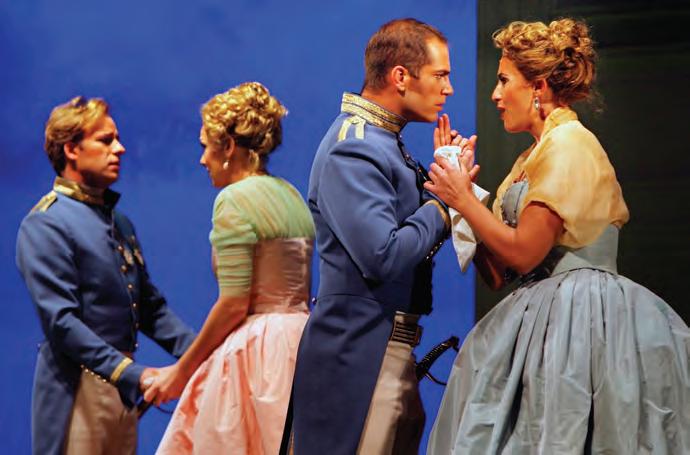
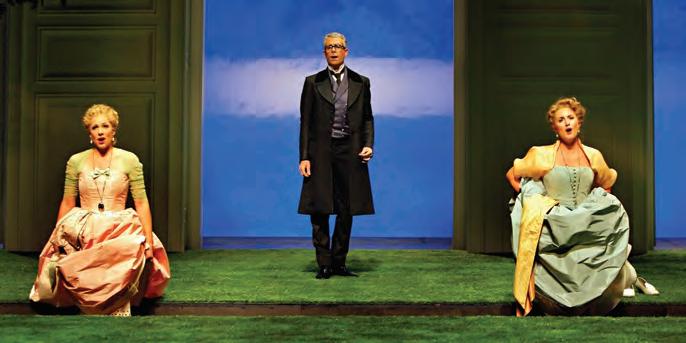
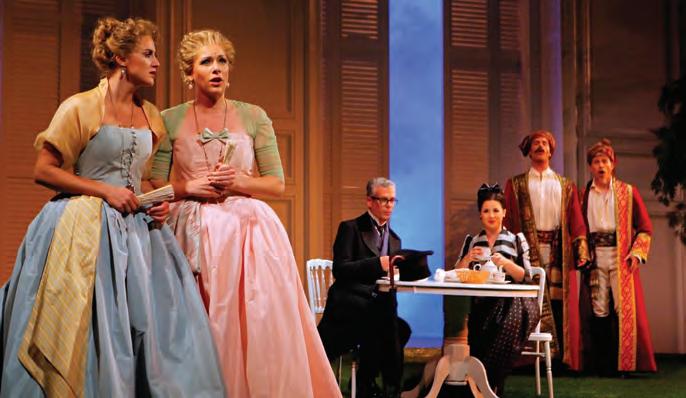
tifully sung, a characterization even more compelling than the one CioCio-San Kaduce sang for this company eight years earlier. Earlier in the season, tenor James Valenti and mezzosoprano Roxana Constantinescu lit up the Ordway stage as the young lovers in Massenet’s Werther, giving performances that combined magnificent singing with an impassioned, convincing portrayal of a great love affair that ends in tragedy.
erupted the morning of March 21, 2012, that company president and general director Allan Naplan was resigning after just twelve months in office, it confirmed rumors that Naplan’s leadership replacing the thirty-year reign of Kevin Smith had not been a smooth fit. Kevin Ramach, the company’s production director, would take over as interim managing director. Details of what went wrong weren’t revealed. Naplan was resigning for personal reasons, said a company announcement. Board chair Sidney Emery Jr. lauded Naplan as “a person of immense talent and ability” and quickly added that Minnesota Opera is in “fine shape.”
By midsummer, Ramach was named president and general director.
Better news came with the board’s annual meeting at the end of June. The company ended the fiscal year in the black for the ninth consecutive year. Ticket sales reached $2.7 million, and the productions played to 92.4 percent of capacity at the Ordway, a slight increase over 92.3 percent the previous year. The budget for the fiscal year reached $10.2 million— up from $9.4 million the prior year— which propelled Minnesota Opera into the first tier of major American opera companies, a group of twelve.

When a new CEO has to be named, opera companies might feel like they are singing “The Succession Blues.” In fact, it’s more a matter of frequent committee meetings along with intuitions and calculations aimed at finding the right person, someone with ability whose skills and sensitivities are a perfect—or almost perfect—match for what needs to be done. It’s guesswork, and sometimes people guess wrong.
On May 12, 2010, when fifty-nine-year-old Kevin Smith announced he would retire as president and managing director of Minnesota Opera, a company he had been a part of for twenty-nine years—twenty-three of them in his current position—a tremor was felt in the warehouse district of Minneapolis. A small cloud of dust rose and slowly floated back down onto the sidewalk in front of the Opera Center on First Street, a four-story building that had been the company’s home since 1990, a comfortable old structure with exposed wooden beams that, on occasion, when the spirit moved him, Kevin would dust with a vacuum sweeper, having climbed up near the ceiling, walking carefully and without a net, proving, as he once said, how much he loved the building.
The question, of course, was who would replace Kevin, who had said he would remain on the job until his successor had been named. Given his longevity riding in this particular saddle; given that his name and that of Minnesota Opera were by now firmly intertwined; and given, finally, that the company had risen to considerable success and renown under his leadership, it was thought that finding a replacement for Kevin, though definitely a challenge, was not entirely impossible.
And indeed, on November 11, 2010, board chair Chip Emery, speaking for the company, announced that an “extraordinary talent"—thirty-eight-year-old Allan Naplan, a singer and composer who had been for the past six years general director of the Madison Opera in Wisconsin—was the new president and general director of Minnesota Opera. Naplan, whom Emery predicted would become “an exceptional asset to the Twin Cities arts community,” would take office March 1 of the following year.
On March 21, 2012, one year and twenty-one days after Naplan took office, the company announced that he had resigned. No details were given except a brief statement from Emery, saying that Naplan’s decision was “personal and I have to respect his decision to move on.” The accompanying announcement was that Kevin Ramach, who had been the company’s production director the past six years, would replace Naplan as interim managing director. On July 25, dropping the word “interim” from the title, the company named Ramach president and general director. And then on November 20, 2014, some two and a half years later, Ramach resigned. In a statement released by the company, Ramach said he felt that his strong suit had always been the creative end of the business and that he often felt “removed” from that kind of activity in his role as general director. Nina Archabal, former director of the Minnesota Historical Society, was named interim president. A search for a permanent new president was immediately launched. Ryan Taylor was named to that position some eighteen months later.
These years, 2011 to 2016, proved to be difficult for the company. One prominent board member said that the company almost “went under” during these years. The company’s first serious crisis had occurred three decades earlier, in the spring and summer of 1982, when, in order to avoid bankruptcy, the company, for the month of June, laid off nearly the entire staff, retaining the services of just two of its employees, Peter Myers, who ran the company’s tours, and a young Kevin Smith, who had been hired the previous November as production stage manager. The company’s second crisis was this one, a crisis of leadership that began with the resignation—or perhaps with the appointment—of Allan Naplan.
In time, notably with the appointment on January 14, 2016, of Ryan Taylor as president and general director, the staff and board of Minnesota Opera stopped singing “The Succession Blues” and put the sheet music in a trunk up in the attic, where it continues to gather dust.
SEARCHLIGHTS ILLUMINATED the sky over the Ordway Music Theater the night of September 23, 2012, signaling perhaps a tractor pull at the nearby Xcel Energy Center. No, it was the start of Minnesota Opera’s fiftieth season, and a fairly bold season it was—no small accomplishment at a time when several opera companies around the country had folded, while others, in an effort to play it safe, had pulled back from programming anything unusual. Though over the years, there had been bumps in the road—periods of insolvency, questions of artistic identity—Minnesota Opera seemed to have proved that a company can thrive without always playing it safe.
It was still commissioning new works—or, more accurately, the company had recently gotten back to commissioning new works, and there would be another new work in January, Doubt, an opera based on the play and film by John Patrick Shanley with music by Douglas J. Cuomo.
Even the season-opener, Verdi’s seldom-heard Nabucco, given a colorful, ritzy staging by Thaddeus Strassberger, part Cecil B. DeMille kitsch and part historical rumination, could hardly be called a safe bet. Yet the capacity audience—black ties and evening gowns rubbing shoulders with blue jeans and plaid shirts—gave singers and the artistic team, as they lined up onstage at the end, a noisy standing ovation.
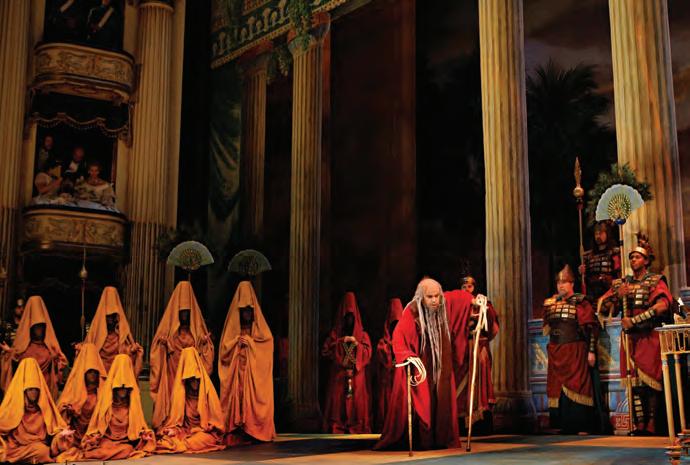
Strassberger took us back to Verdi’s time, to the opening night of Nabucco at La Scala in 1842, when, history tells us, this biblical epic of Hebrews in Babylonian captivity fired the imagination of patriotic Italians who themselves were trying to throw out an occupying army, the Austrians. One stirring chorus from the work, “Va pensiero,” beautifully sung by a splendid chorus on opening night, inflamed the Italian audience with passion and lived on to become a theme song of the rebellion. (“With this opera, my career can be said to have begun,” said Verdi some years later.)
Wisely, Strassberger didn’t go all the way with this idea. But Strassberger did place nervous-looking police officers to observe the stage from the top box to make sure that nothing subversive happened. And the sets—towering flats and painted drops, huge columns and bas-relief sculptures, candles in the footlights—gave a sense of the period. There were bolder steps too: a cluster of nineteenth-century working-class Italians listened to “Va pensiero” behind an upstage scrim, representing, presumably, the spirit of the Italian people. And Strassberger had the soprano Brenda Harris, so impressive in the main female role of Abigaille, lead the cast and the audience in a reprise of “Va pensiero” at the end of the curtain-call. The police, of course, would have shut down the theater in a minute had that happened in 1842.
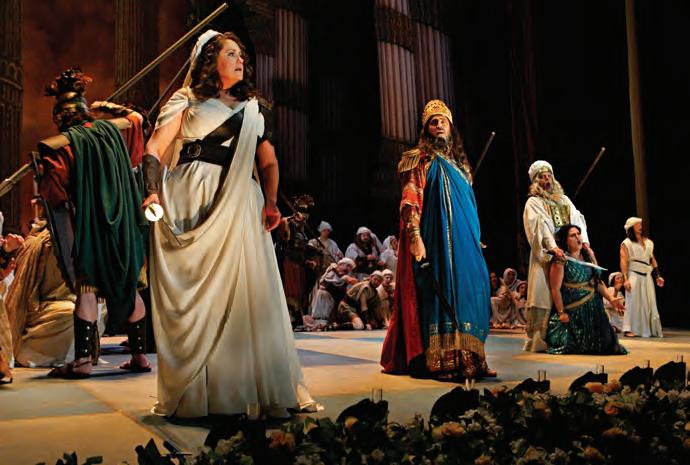
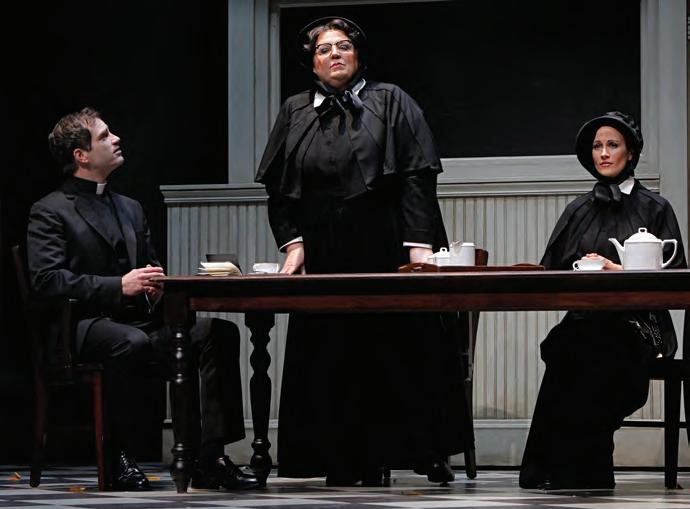
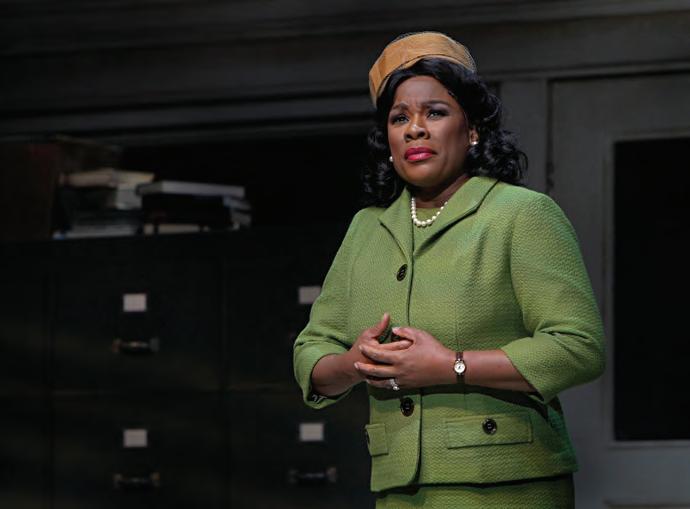
A STRONG PLAY OR FILM doesn’t necessarily make an effective—much less compelling—opera. And yet Doubt, an opera fashioned from John Patrick Shanley’s award-winning play and film of the same name, with music by Douglas C. Cuomo set to Shanley’s libretto, commissioned by Minnesota Opera for the company’s fiftieth season, proved to be a dramatically enticing and musically satisfying evening of music theater, superbly staged and sung, and enthusiastically received at its premiere January 26, 2013, at the Ordway Center.
Shanley’s tightly written one-act play debates whether Sister Aloysius, principal of a Bronx parochial school in 1964, a time of unsettling change in the church, is right to suspend a popular priest, Father Flynn, for getting too close to one of his students, the school’s first Black pupil. The play’s subject is doubt versus certainty and whether we can ever know the ultimate truth about anything, especially people’s motivations. Shanley offers no easy answers. The climax of the story is both ambiguous and unsettling.
Wisely, the libretto retains much of the dialectical tension of the original play while addressing the requirements of opera for lyrical expansion at appropriate points in solo
numbers, duets, trios, and a choral background supplied by a small chorus of young singers who play students in the school. Cuomo, who has one opera to his credit, Arjuna’s Dilemma, a deft mix of Eastern and Western idioms, draws sparingly but evocatively on his jazz background, a moody saxophone solo in the opening choral ensemble, for instance.
Displaying an opulent, flexible baritone, Matthew Worth gave an impressively layered portrayal of Father Flynn that hinted at murky undercurrents, and Adriana Zabala was the fetching, sweetly sung Sister James. And finally, in the opera’s key scene, the confrontation between Sister Aloysius and Mrs. Miller, mother of the boy in question, there was mezzo Denyce Graves’s searing, charismatic portrait—commandingly sung—of a woman desperate to provide for her son’s welfare. Much of the success of the production—the easy, cinematic flow, the dramatic conviction and visual allure—must go to Kevin Newbury, who staged it, guiding it through a series of workshops during the past year, as well as to his production team: Robert Brill (sets), Paul Carey (costumes), and Japhy Weidman (lighting). Christopher Franklin conducted with spirit and precision.

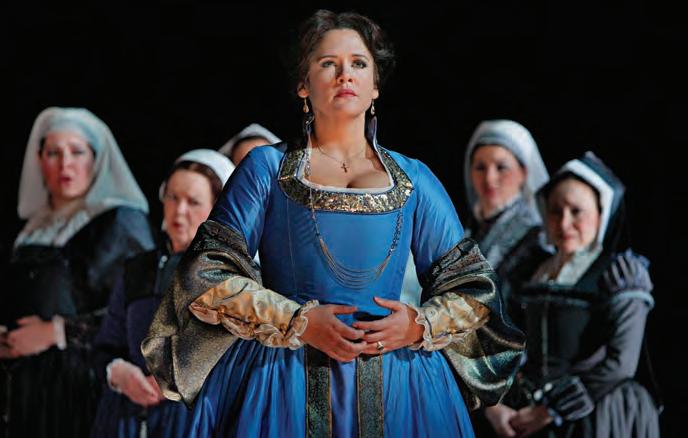

IN NOVEMBER, with Anna Bolena, the company brought its Tudor Trilogy to an end, and a grand finale it was, a festival of superb acting and singing. While the earlier operas focused on conflicts during the reign of Elizabeth I, Anna Bolena is her mother’s story. Anne Boleyn was the second wife of Henry VIII, a lustful king desperate for a male heir, which Anne wasn’t able to produce—and so Henry, having already picked her successor (Jane Seymour), had Anne executed. Keri Alkema’s Anne was a pillar of strength and compassion in what was a decisive, commanding portrayal of the doomed Queen, all of it sung affectingly with great expressive power and coloratura agility. The rest were equally strong: Kyle Ketelson as an angry, narcissistic Henry, Lauren McNeese’s sweet-tempered Jane, and David Portillo’s passionate Lord Percy. Michael Christie’s conducting proceeded with flair and sensitivity.
The whole project, the three operas, was a great success for Minnesota Opera, one of its finest achievements. Dale Johnson, who conceived the series as part of his bel canto focus, had the good sense to engage a single creative team for all three operas—director Kevin Newbury, designer Neil Patel, and costumer Jessica Jahn—which gave the trilogy a sense of unity that it doesn’t have with changing personnel.
THADDEUS STRASSBERGER, the inventive director and set designer who staged a thoughtfully political Nabucco for Minnesota Opera in September 2012, returned the following March to breathe life into Ambroise Thomas’s Hamlet, a worthy but much-neglected opera that was being revived with some frequency during these years. As with Nabucco, Strassberger added some intriguing perspectives to the proceedings, for instance, having the ghost of Hamlet’s father appear in unexpected places, as though these sightings were emanations of the melancholy Dane’s fevered imagination, which, in this case, with baritone Brian Mulligan’s wildly turbulent portrayal of Hamlet, is a disturbance close to madness. Mulligan was brilliant, but then so was Katherine Goeldner as a deeply conflicted Queen Gertrude, and Marie-Eve Munger, a convincingly disturbed Ophelia. Christopher Franklin conducted this thoughtful, thoroughly engaging production.

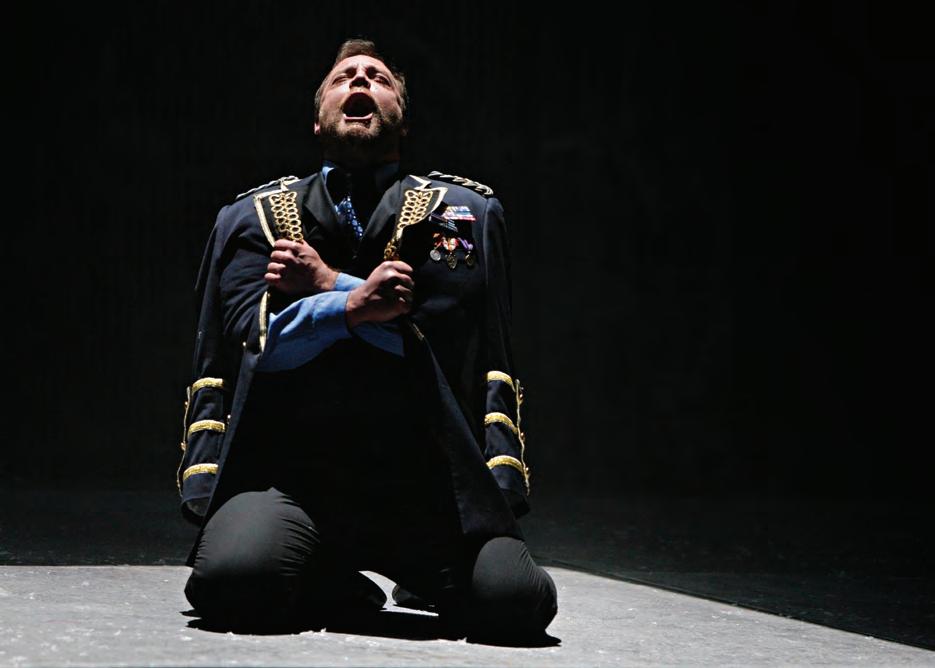

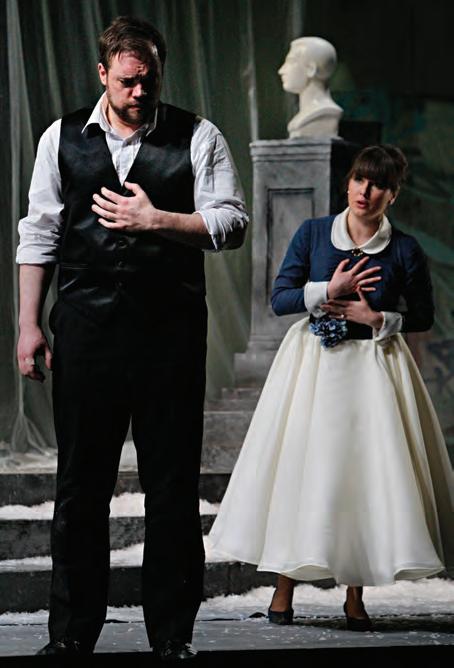


MINNESOTA OPERA CLOSED its fiftieth season—one of its most ambitious and successful in recent years—with an extravagant and provocative production of Puccini’s Turandot, featuring an impressive performance by the Russian dramatic soprano Irina Rindzuner in the title role.
The production was the work of the French Canadian director and design team Renaud Doucet and Andre Barbe. The outcome was a fairytale picture of ancient imperial China.
Adam Lawrence Herskowitz’s big, dark-toned tenor impressed with its ringing top notes (a tender “Nessun dorma”), coupled with an assured stage presence. Kelly Kaduce was a sweettoned, sympathetic Liù, while Vern Sutton (celebrating his fiftieth year with this company) portrayed an appropriately chilly, distant Emperor.
Minnesota Opera’s fiftieth anniversary season ended with a shortfall of $169,500, the company’s first deficit in ten years. Newly appointed president and general director Kevin Ramach attributed the loss to revenue shortfall and the costs of the three free outdoor performances of La bohème the company gave in June 2013, in Minneapolis, St. Paul, and Faribault, Minnesota.

MANON LESCAUT, the title character in the Puccini opera, like Papageno, undergoes a series of transformations, from teenage waif to femme fatale to tragic victim, and all this was brilliantly defined by the Minnesota-born soprano Kelly Kaduce in the fine production that opened Minnesota Opera’s fifty-first season September 21, 2013. Kaduce, no stranger to this audience, shaded the text with poignant, telling colors and looked gorgeous onstage: kittenish, wistful, sexy, petulant, vulnerable. Her opposite, Dinyar Vania’s des Grieux, brought a believable subtlety to his portrayal of a young man wrestling with devotion and betrayal.




An aura of melancholy, of Weltschmerz, infused Tim Albery’s staging of Richard Strauss’s Arabella, the second production of Minnesota Opera’s fifty-first season, a collaboration with Canadian Opera and Santa Fe Opera. Albery updated the action from 1860 to roughly 1910. While there was no substantial benefit in this, the change did allow Tobias Hoheisel’s costumes for the women to take on an extravagant, eye-appealing, Gustav Klimt–style glamor that suited the characters and their situations nicely. Jacquelyn Wagner, a young Detroit-born soprano who now lives in Berlin, made an attractive Arabella, and a lovely-sounding one, too, at once girlishly eager, yet with a natural dignity and vocal command that, all told, made her performance so gratifying. Her counterpart, Craig Irvin, whose ample baritone was heard to such good effect as Mandryka, gave his character a directness and nobility that turned out to be far more interesting than the way Mandryka is usually played, as a country bumpkin on the order of Baron Ochs. Looking like a smart graduate student, Elizabeth Futral was an engaging Zdenka, Arabella’s younger sister, who is forced to dress as a boy in order to reduce the family’s expenses.
Two equally accomplished, charismatic singers playing man and wife—Greer Grimsley and Brenda Harris—lit up the Ordway stage in January playing Macbeth and Lady Macbeth, the couple in Verdi’s opera who murder their way
to the Scottish throne. In a staging by Joel Ivany full of ominous shadows and ghostly whisperings, Harris’s sleepwalking scene was breathtaking, and Grimsley’s Macbeth was a bold mix of bragging self-confidence and crippling guilt. Ivani expanded the three “weird sisters” who prophesy Macbeth’s rise and fall into a coven of witches, and the women of the very fine Minnesota Opera chorus, prepared by Rob Ainsley, made them into a fearsome bunch, one of the production’s highlights.

SEATED IN HIS OFFICE at the Opera Center one afternoon in 2018, Dale Johnson recalled his visit to Dominick Argento’s house in the Kenwood area of Minneapolis some years earlier. He had phoned Argento, telling him he would like to talk to him about The Dream of Valentino, Argento’s opera about the silent screen star Rudolph Valentino that had been premiered by the National Opera in Washington, DC, in 1994, receiving positive reviews.
“I was all prepared,” Dale said.
I had written down my questions. I was going to ask him if we could do some edits on the show because I think it’s over-written a little bit. And dramaturgically, it wanders a certain amount. So I got there, and I said, “Dominick, we want to do Valentino, but I think we need to make some changes or revisions.” So he pulled out a notebook and a score and said, “Oh, like these?” He had made, like, forty-five minutes of changes, not just cuts but a rethinking of the piece. He had it perfectly done, and he had kept in all the good orchestral music. I said, “Well, that’s what I was going to ask you to do.” So he gave it to us, and his editor gave us the score.

The opera, as its title suggests, deals in dreams, and most of it takes place in the dream factory called Hollywood. Valentino, an Italian immigrant, came to California dreaming of becoming a great actor. It turns out he had a natural gift, a screen presence that projects a new kind of dangerous sensuality. Up on the big screen he inhabits people’s dreams and fantasies, and he does so in real life too. The movie studio head, known as the Mogul, wants Valentino for the money he will make for the studio. (“I see cash in that face.”) The screenwriter June Mathis, his only real friend, wants him to remain true to his vision (“Follow your dream, not theirs.”) The actress Alla Nazimova wants him to revive her fading career.
Charles Nolte’s libretto handles all this masterfully. Scenes unfold clearly and dramatically, one fading into the next in the manner of screen dissolves. There isn’t a wasted word or note, and yet the score is full of invention and playfulness—the way, for instance, in the opening scene, the bright Charleston rhythm gradually emerges from the crowd noise and laughter; the way the Mogul’s three secretaries sound like the Boswell Sisters singing an actual fugue; the authenticsounding Baroque passages the orchestra plays during the


“Monsieur Beaucaire” scene; the sultry tangos that dance through the score; and finally, in the touching and yet disturbing funeral scene, with the lush Sigmund Romberg–style tune coming out of the old Victrola onstage as the hordes of Valentino fans break through the barriers and scramble to the star’s coffin to worship him and maybe to grab a souvenir, a flower, or even a lock of hair.
As dark as the show is, it feels exhilarating because of the excellence of the production: its sharp cast, its evocative look, and the obvious care taken for musical and dramatic values, all this guided by the steady hand of Eric Simonson, who brought a vivid reality to the happenings onstage. James Valenti’s Valentino, handsome and charismatic, displaying an enveloping, husky tenor, gave equal play to the character’s insecurities and frustrations, suggesting that at some level Valentino knew that he would never be as big or as compelling as his screen image.
Valentino, the story of “a man who lost his way,” as June Mathis puts it, is good enough, especially in this new version, to make its way into the operatic repertoire. A longtime resident of Minneapolis, Argento was enthusiastically applauded when he joined the cast onstage on opening night. The sadness was that, at eighty-six, the composer was calling Valentino his final opera, and indeed, that’s what it turned out to be. Argento died five years later, having composed a few short pieces during these years but nothing for the stage. The other sadness was that Charles Nolte, Argento’s distinguished colleague for many years at the University of Minnesota—an actor, teacher, and playwright, who died in 2010—couldn’t have been at the Ordway to share in the much-deserved applause.
WHEN IT COMES TO MULTIMEDIA , we quote the great Al Jolson: “You ain’t seen nothin’ yet” until you see—or did see, and you’d remember if you did see it—the production of The Magic Flute that Minnesota Opera presented as the finale of its 2013–14 season. This rambunctious and witty reinvention of Mozart’s classic dissertation on Enlightenment through solemn Masonic ritual combined live action with animation and film along with references to Buster Keaton and Louise Brooks and a seemingly inexhaustible parade of


cartoon images: flying pink elephants, immense spiders, and fierce-looking monkeys with pitchforks. A nude fairy flutters by from time to time, looking like Tinkerbell’s naughty younger sister. Walt Disney, we think, would have approved of all this. Mozart, we suspect, would have loved it, and his collaborator on The Magic Flute, Emanuel Schikaneder, no stranger to baggy-pants comedy, would have wanted to be in it, playing Papageno, his favorite role.
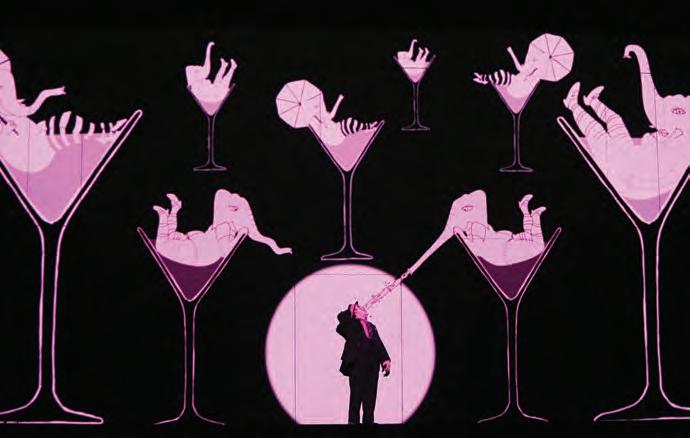

The production was a collaboration between the Australian opera director Barrie Kosky, artistic head of the Komische Oper Berlin, and the British avant-garde theater company 1927 led by Suzanne Andrade and Paul Barritt. The production debuted in Berlin in 2012, with Andrade and Kosky directing, and Barritt drawing the animation (which reportedly took eighteen months to sketch by hand). In the United States the work was a coproduction between Minnesota Opera and LA Opera. Tobias Ribitzki staged the production at the Ordway, and Esther Bialas designed the sets and the attractive 1920s-style costumes.
What was novel about this production is that the components interact. Film and video aren’t merely background. What the audience sees is a large screen in front of which live characters are positioned, sometimes on the floor, other times on platforms high above the stage. The screen is in constant motion, showing the characters’ thoughts, usually making jokes about them or embodying their essence. The Queen of the Night is an enormous spider with legs crossing the entire stage. The Three Spirits sing from a basket held aloft by a huge butterfly. The dialogues are rendered as silent-screen titles (“Take heart, Tamino!”) underscored by passages from Mozart piano sonatas. Tamino is dressed as a sad-faced Buster Keaton, Pamina as Louis Brooks in her Lulu phase. Papageno is Charlie Chaplin and Monastratos is a scary Nosferatu. There are ample images, too, that suggest George Melies’s early film fantasy A Trip to the Moon
And it’s not all jokes. To the credit of Kosky and his crew, at appropriate points, they do probe the work’s serious side. Behind Pamina’s lament “Ach, ich fühl’s” is projected the striking image of snow falling on a barren tree, a number immaculately sung by Christie Hageman Conover. Moreover, as required in this opera, we see Tamino’s growth from young prince at the mercy of his environment to a natural and capable leader, having been tested through his various trials. Julien Behr, with his slender, well-focused tenor, was excellent in the part.
IN SEPTEMBER, in the season-opener of Puccini’s La fanciulla del West (“The Girl of the Golden West”), which was simulcast in Rice Park, Claire Rutter brought bright, silvery tone and a wide range of expression to the lead role of Minnie, the feisty California girl who defends her lover with a revolver, teaches Bible classes to rugged gold miners, claims never to have been kissed, plays poker with the Sheriff, and rescues
her boyfriend when he’s about to be lynched. She did well, but Greer Grimsley, a cauldron of menace as the Sheriff who offers Minnie $1,000 for a kiss, basically stole the show, as he usually does, and his powerful bass-baritone rang out with awesome force. Director Doug Scholz-Carlson devised a nice flow to the complicated crowd scenes with the gaggle of miners stepping up to the bar and ordering “Whiskey per tutti.” Which of us, for that matter, hasn’t wished for the nerve to walk into a bar and say with great gusto to the bartender, gesturing to the crowd, “Whiskey per tutti.”
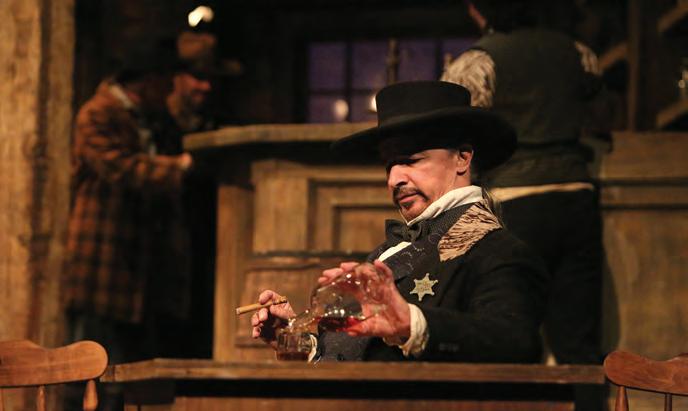
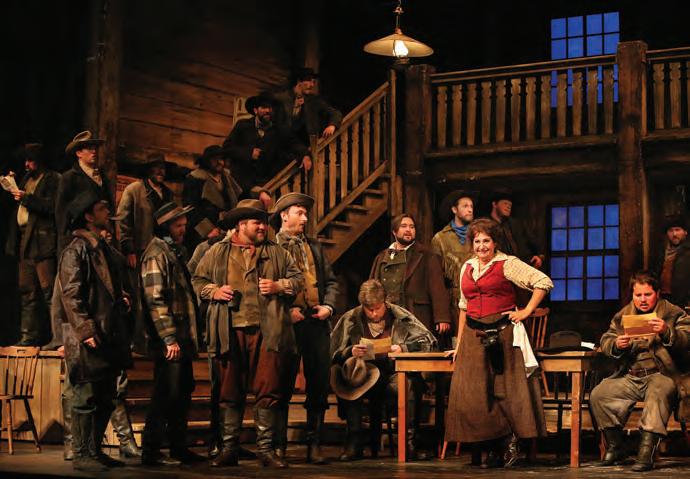
The standard line on Hansel and Gretel is that the composer Engelbert Humperdinck and his librettist Adelheid Wette—they were brother and sister—found the original tale by the brothers Grimm to be sadistic and scary, and so they softened it, dropping, among other things, the evil stepmother, replacing her with an overworked housewife who could use a day off. The result was a delightful, familyoriented opera about kidnapping, hunger, and cannibalism, for which Humperdinck composed a masterful score with lush Wagnerian textures and a sophisticated pastoral tone.
In recent years, however, stage directors have brought some of the grimness back. For Minnesota Opera, Doug Varone sauntered down an even darker street. He set the story in a middle-sized city during the Depression. The haunted forest became a sinister carnival, Playland, the stage dominated by a multicolored carousel, and the Witch was a circus clown, the Candy Lady, who’s up to no good. Our adorable kids, Hansel and Gretel, dream not of food and angels but of becoming dancers in movie musicals in the mold of Fred and Ginger, whose caricature adorns the proscenium arch. At the climax of the dream that ends act two, Shirley Temple hands each of them an Oscar statuette. The Dew Fairy is a Follies showgirl, and the Sandman, accompanied by a mime, engages in an old vaudeville-style Shadow Dance that’s quite lovely. On the nastier side, during the prelude to act two, a kid is murdered in the street by the Candy Lady’s minions, and the carousel is adorned with dead gingerbread children hanging upside down and waiting to be eaten.
Finally, one wonders, what is the moral of this boldly reimagined Hansel and Gretel ? Children’s tales always have a moral, and it’s usually the least interesting part of the story. For the traditional version it’s something like: “There’s evil in the world and God will lend a helping hand,” to quote the libretto. In this new version, since God seems to have left town, it must be, “Stay out of show biz or you will be eaten alive, and whatever you do, stop dancing.” The hope, apparently, is that Hansel and Gretel will opt instead for law school. The ending was Grimm. The less fortunate Witch comes out of the oven in the form of a cupcake, and the two-dozen or so children brought back to life and bent on revenge proceed to eat her. Kids, it’s a jungle out there.
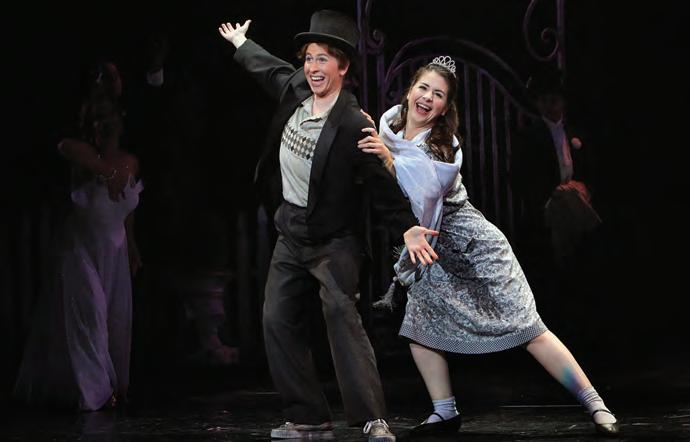

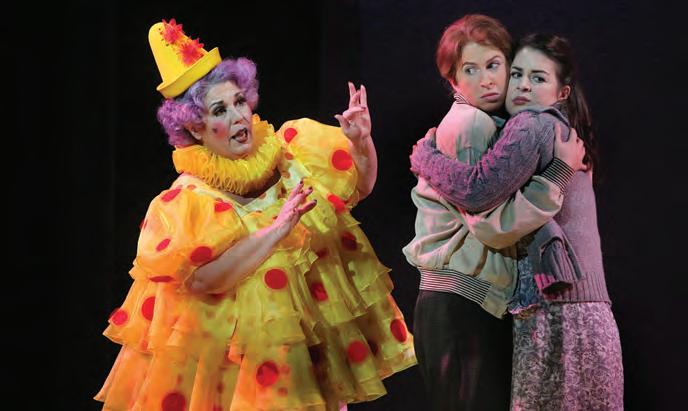
In January the young tenor Leonardo Capalbo, playing Nemorino in Minnesota Opera’s downright lovable production of The Elixir of Love, sang the opera’s biggest hit, “Una furtiva lagrima” (“A Furtive Tear”), with ripe, unforced tone, unaffected, effortless phrasing and heartfelt emotion and, on opening night, brought down the house. Playing Adina, the female lead, Nicole Cabell displayed an attractive, light, lyric soprano with bright, agile top notes.
Helena Binder was the shrewd director, Leonardo Voldoni the expert conductor.
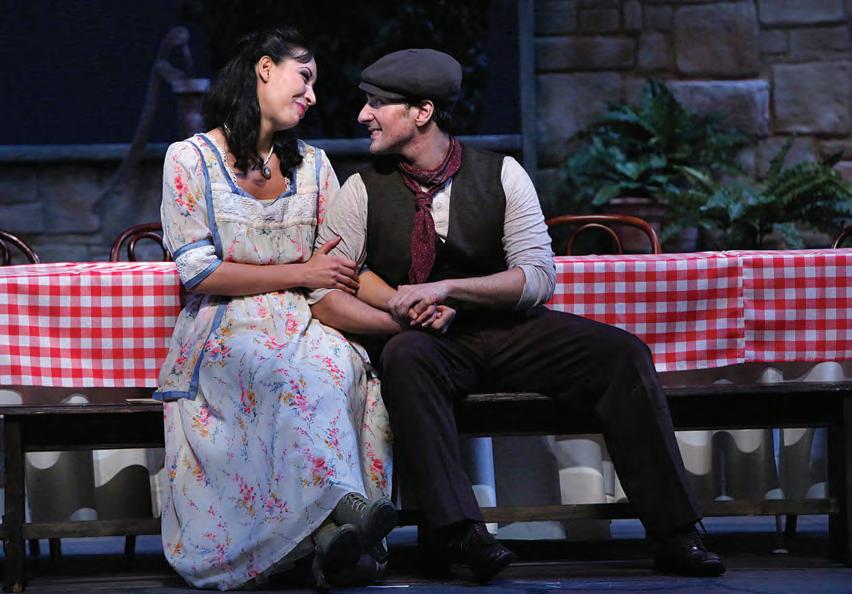


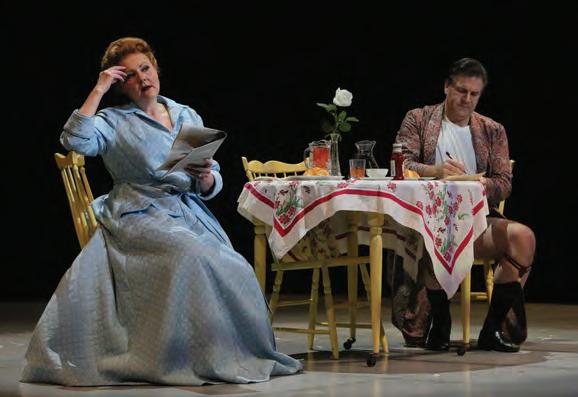

IN MARCH 2015, Mark Campbell told MinnPost , “Contemporary opera is very much alive. The opera companies that refuse to program new opera—and especially the opera companies in this country who do not program contemporary American opera—are the ones that are dying. It’s a bunch of old operas for old people, generally old white people. And if we’re going to get a new audience, we have to write new operas. And that’s what we’re doing.”
Concerning what Campbell was doing in November of 2011, the story begins in artistic director Dale Johnson’s office the day after the dress rehearsal of Silent Night. Johnson, impressed with Silent Night, which in just a few months would win the Pulitzer Prize, invited the two who created it, Campbell the librettist and Kevin Puts the composer, to a meeting to come up with ideas for another commissioned work. Other staffers were present. “A lot of ideas were thrown around,” Campbell recalled. “You look for the idea that galvanizes. When I said The Manchurian Candidate, everyone went ‘Wow!’ I could feel Kevin’s mind already starting to work.” Puts, it turned out, had seen both Manchurian Candidate films, both based on the 1959 Cold War thriller by Richard Condon. “The whole thing was exciting to me,” Puts said, “the idea of a political thriller.”
Campbell had been thinking about a musical treatment of the original movie ever since he saw it in 1994. The story concerns a former Korean War POW, Staff Sgt. Raymond Shaw, who is brainwashed by Communists into becoming a political assassin, the potential killer of a presidential candidate. Since Shaw would have no memory of having killed and therefore no guilt, he is the perfect assassin. He won’t ever be caught. But another former prisoner, Ben Marco, thinks he may know how to save him.
Campbell asked his agent to secure the rights to the book. He feared the book publisher, McGraw-Hill, and the Condon estate might be resistant. Instead, they were quite cooperative. Condon’s daughter, Wendy Condon Jackson, said she planned to see the production on opening night. Condon intended the book to be a satire on the Red Scare of the 1950s. His character Sen. John Iselin, Raymond’s stepfather, is clearly modeled on Sen. Joseph McCarthy. Prompted by his wife, Eleanor, Raymond’s mother and arguably the story’s main character, Iselin waves a list of “cardcarrying Communists” at a Senate hearing and vows to “launch a formal investigation of atheism in the Department of Agriculture.” Eleanor, played memorably in the 1962 film by Angela Lansbury, who received an Academy Award nomination for her portrayal, is bent on a “holy crusade” to
return the country to its “original purity.” She plots to have Raymond assassinate the Republican Party’s presidential candidate and to have her puppet, the perpetually inebriated Sen. Iselin, placed into the White House. Campbell saw the story as a warning about the perils of using paranoia in politics, a consistently relevant theme. “We’re still affected by what McCarthy did,” he said. “Plus with Eleanor you’ve got a tremendous operatic role, a real Lady Macbeth.”
Campbell wrote the libretto quickly. As he normally does, he first made an outline and then just kept on writing. One change they made was toning down the sex scene between Raymond and his mother. In the book Eleanor seduces Raymond, and we learn that she had been seduced by her father. In the first movie there’s a smoldering kiss and a fadeout. In the opera they simply kiss.
“I wanted to shock the audience,” Campbell said. “But I also thought that if Eleanor seduces Raymond early in the opera, that’s so off-putting. The audience will think that’s disgusting and won’t follow her at all. We also learn in that scene that she didn’t choose Raymond to be the assassin. The people in Korea chose him and brainwashed him to bind him to their cause. So there’s a moment when you might actually feel sorry for this woman.”
Raymond, too, becomes sympathetic in the opera, whereas in the book and the films he’s a blank—unlikable and resentful. “In opera you have to increase the sympathy of characters,” Campbell said. “There has to be a reason for someone to sing. If a character is just one note, emotionally, you won’t be on his side. Above all else, opera needs to have a heart. We have to care about the characters. Also, the text in opera is only part of it. It’s really Kevin’s genius that made Raymond more sympathetic. We hear things in his music that I couldn’t write in words. You hear the sadness and pain in Raymond’s soul much more in the music than in the words.”
When it came time to cast the show, never an easy process, the biggest question was who would play Eleanor. Dale Johnson thought it almost had to be Brenda Harris, and this discussion took place before Puts had written any of the music. “She’s the only soprano out there who I think would be great as Eleanor,” Dale said. “She has the voice—the range, the power, and the flexibility. She’s the only one. And so they did, they wrote it for her.”
The opera was premiered at the Ordway March 7, 2015, three years and four months after Mark Campbell suggested it at that meeting in Dale Johnson’s office on the afternoon of November 11, 2011.
The review in the Star Tribune called the opera “another winner” for Puts and Campbell:
An exciting roller-coaster ride that manages to make telling political points relevant to today, all wrapped in a superbly imaginative production directed by Kevin Newbury and conducted with flair by Michael Christie. Puts’s shrewdly inventive, polyglot score illuminates dramatic turns and adds ironies. The initial scene in Korea, where, as an experiment, Raymond is asked to murder two of his fellow soldiers, is sung by the chorus in the cheerful mode of the dwarves in “Snow White.” Later we hear a Sousa-style march and echoes of Stravinsky, Copland, and John Adams—all in Puts’s own voice—along with lush, lyrical orchestral writing as Raymond recalls his budding romance with his wife-to-be, Josie. Puts’s cleverest—and most dramatically effective—touch is an ostinato, a repeated phrase that opens the opera and recurs whenever Raymond’s post-hypnotic suggestions kick in, a perfect equivalent in sound of brainwashing and the paranoia that pervades the story. Campbell’s smart libretto remains true to the story while compressing certain scenes, creating ensemble numbers and always pushing the action forward in fast-moving cinematic episodes.
Newbury and his ace team (sets by Robert Brill, costumer Jessica Jahn, lights by Japhy Weidman) moved the opera’s short scenes with relentless precision. In a clever touch, robotic men in drab suits make scene changes. Video screens high above the stage (the work of Sean Nieuwenhuis) depict crowd scenes and, most important, Raymond’s unconscious mind when he goes into a trance.
The Manchurian Candidate accounted for most of the fireworks—and just about all the political intrigue—in the 2014–15 season. Nonetheless, the season-opener, Puccini’s The Girl of the Golden West, offered impressive performances, while the company’s The Elixir of Love provoked laughter and exuded charm—and then came the season-finale, yet another Carmen, this time looking and sounding surprisingly drab. Probably the most interesting of these was the new production of Hansel and Gretel that was given five performances at the Ordway in November 2014.


THE NEW CARMEN, unveiled in April and staged by Michael Cavanagh, was set in Franco-era Spain. In the opening scene, the cigarette girls simply walked to the edge of the stage and sang, like they used to do in the bad old days when operas were hardly directed at all. On the plus side, Nora Sourouzian was an alluring, sexy, confident Carmen who brought to the vocal line a deftly colored, evenly produced mezzo with sensitive inflexions of the text. And Kyle Ketelsen was an appropriately cocky Escamillo, singing with booming, resonant sound and no apparent strain. Rafael Davila’s Don José displayed a powerful tenor and unflagging stamina.
The company opened its books on October 13, 2014, and declared its second deficit in a row—$173,000 for the 2014 fiscal year, slightly more than the prior year’s shortfall of $169,600. In a prepared statement, Kevin Ramach, president and general manager, said, “We have engaged an external consultant to review our policies and procedures in the finance department to improve our productivity and efficiency.”
WE KNOW THESE PEOPLE, don’t we? There’s Jack Torrance, a recovering alcoholic writer who has taken the winter caretaker job at the Overlook Hotel. He’ll stay there with his wife, Wendy, and young son, Danny.
These are the characters of The Shining, the 1977 novel that made Stephen King famous. Even more people saw the movie released three years later that starred Jack Nicholson as a crazed Jack Torrance, who is bent on killing his family. Wisely, the creators of the opera, a group that included the director, Eric Simonson, who hatched the idea of an opera on The Shining back in 2010, drew on the novel rather than the movie for source material. The aim of the movie, with its flamboyant performance by Nicholson, was to scare the daylights out of everybody, and it succeeded. (King, we’re told, didn’t like the movie.) The novel tells a deeper story. Jack was an abused child, as was his own father, Mark, who appears onstage as a ghost, or, if one chooses, as a figment of Jack’s fevered imagination. In an effort to perpetuate the cycle of male-dominated violence that has poisoned the family for generations, Mark goads Jack into killing Danny, and even though Jack has gone over to the dark side, he realizes that he still has the power of choice. In Campbell’s sensitive libretto, Jack ponders in a monologue at the start of act two whether to blow up the
hotel, thereby saving his family but sacrificing himself. In the opera’s most moving moment, underscored by an insinuating chromatic passage in the orchestra, Danny, who is psychic—he has “the shining”—denounces Jack: “You are not my father,” meaning that Jack has changed into someone the boy can’t recognize. Devastated, Jack falls to the floor, grieving. Then, in what is the climax of the opera, Jack breaks his father’s cane—the symbol of patriarchy—that his father had beaten his mother with many years earlier. Then he blows up the hotel.
The orchestra interludes in the first act, Wendy’s heartfelt aria (“I never stopped loving you”) and ensuing lullaby, the 1940s swing band number with its gauzy sonority—all were effective touches in Moravec’s generous, abundant score, all
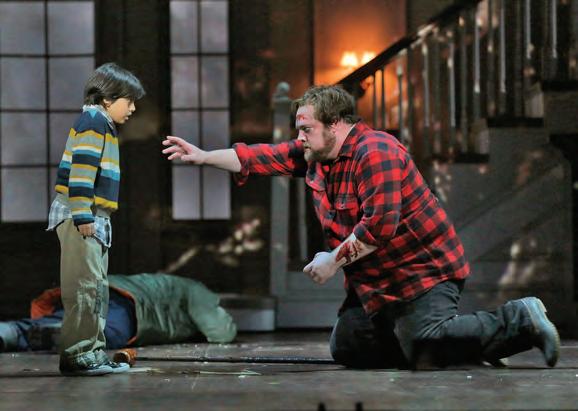
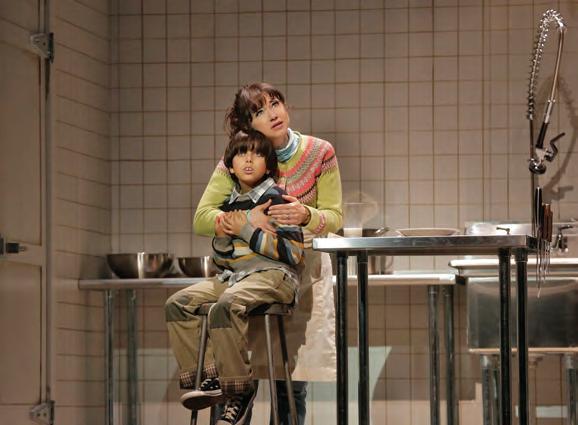
of which sounded wonderfully vivid under the guidance of conductor Michael Christie.
The cast could hardly have been better. Kelly Kaduce, with her bright lyric soprano, was a sexy, loving, sometimes desperate Wendy, a much stronger, more resilient character than in the movie. Brian Mulligan was an unforgettable Jack, alternately pathetic and terrifying and immaculately sung. As Halloran, who comes to rescue the family, Arthur Woodley brought warm tone to the lovely final aria. David Walton was a suavely menacing Grady, and Mark Walters an impressively louche Mark Torrance. Alejandro Vega, then a fifth grader from Hopkins, was sensational as Danny. This is a kid who knows how to shine.
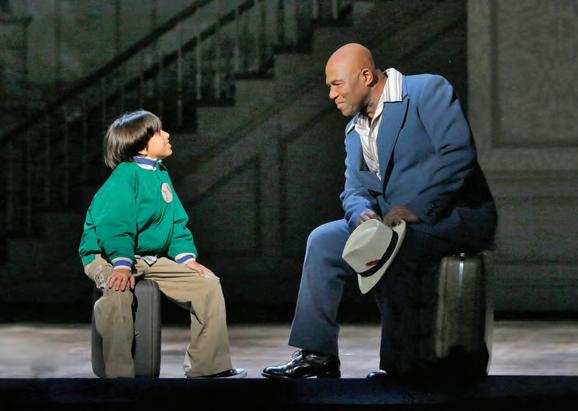
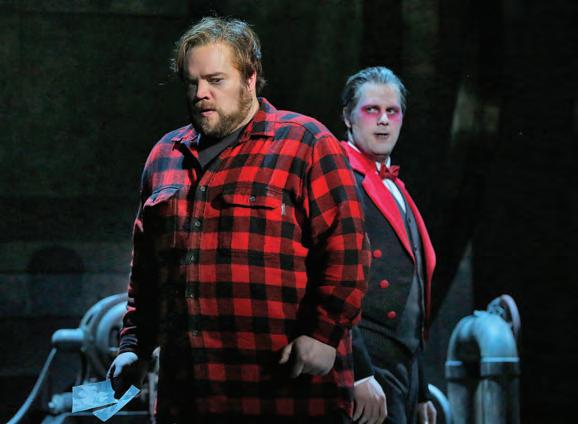
WHEN THE RICHEST guy in town double-books a group of pretentious opera singers and a band of bawdy comedians as dinner entertainment at his chic loft in what turns out to be downtown Minneapolis, the result is likely to be hair-pulling and bruised egos. The Prima Donna and her fellow singers, who had planned to perform their serious opera on the legend of Ariadne, must now include the saucy comedy troupe’s antics to finish the show in time for the evening’s fireworks display. This is Ariadne auf Naxos, Richard Strauss’s delectable but elusive opera about an opera, which opened the company’s fifty-third season on September 26, 2015. The work depends for its success chiefly on the casting of its three main female roles: the foxy Zerbinettta, the desolate Ariadne, and the whiney, self-important Composer.
All three were terrific in this case, in a production staged by Alan E. Hicks, designed by Robert A. Dahlstrom, and conducted by Michael Christie. Amber Wagner, a muchacclaimed soprano in the vein of Jessye Norman in her prime, was an engaging Ariadne, filling her phrases with sumptu-
ous sound, gleaming high notes, and consistency of delivery down to her chesty low tones and astonishing breath control. Erin Morley’s saucy Zerbinetta was Ariadne’s opposite—lighthearted and irreverent—and her delivery of the character’s big aria, one of the most strenuous ten minutes in all of opera, was sung with supple accuracy and grace. No less impressive was the Polish mezzo-soprano Hannah Hipp as an ardent and self-important Composer, singing clearly and with passion. The part of Bacchus, so difficult because it’s perched almost permanently at the top of the tenor range, was sung with the requisite heft and stamina by Brian Jagde. Others in this strong cast were Brad Benoit as the Dancing Master and Andrew Lovato as Harlequin. Christie paced Strauss’s sparkling score with ample pliancy and nuance.
The production, created for the Seattle Opera, updates the story to the present and is relocated from Vienna to a private art gallery in a condo near the Walker Art Center in Minneapolis. Dahlstrom’s Richard Serra–style sculpture in the second act was a treat for the eyes.
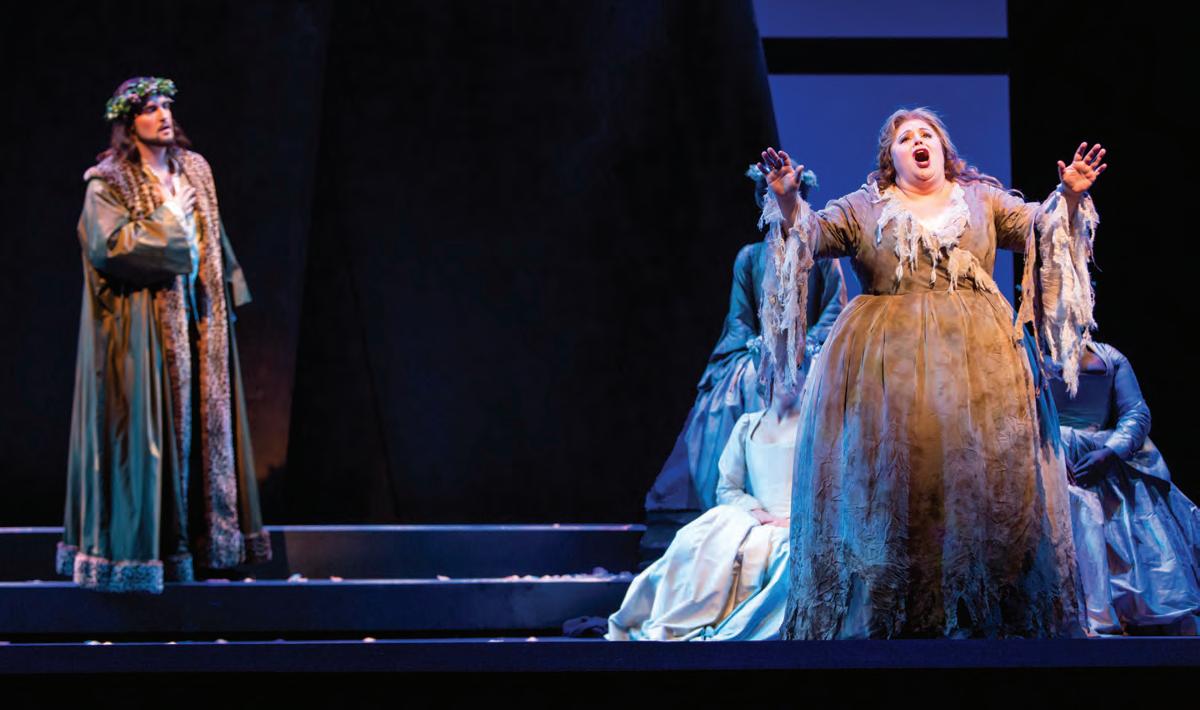

IN JANUARY the company revived its production of Dvořák’s Rusalka, first seen in 2008. It was a pleasure to report that none of its virtues were lost during the ensuing years. The revived Rusalka looked even better this time around. Design motifs had been expanded and enhanced. The projections had taken on a 3D perspective that put the viewer, seemingly, right in the middle of certain scenes.
Happily, Kaduce was back too. She sang the famous “Song to the Moon” with luminous phrasing, moving from tender plea to fierce desperation. This time around her lovesick sprite had the dimension of tragedy in the final scenes. It was if she were already dead and carrying out the curse put upon her. Kaduce dominated the stage on opening night. The essential idea of the production (with costumes by Kärin Kopischke and choreography by Heidi Spesard-Noble), the notion of two distinct worlds, came across even more clearly in this revival. We owe the notion chiefly to Rousseau. Nature is pure and unsullied whereas civilization and culture, represented mainly by the inhabitants of the city, are decadent and about ready to self-destruct.
The other revival in the 2015–16 season was the extravagantly clever multimedia production of Mozart’s The Magic Flute that set box office records for the company in the spring of 2014 and promised to do so again. The production, described by its creators as a “reimagining” of Mozart’s alternately serious and comic examination of love, truth, and the Enlightenment, was, except for a few cast changes, the same as what was seen on the Ordway stage eighteen months earlier.
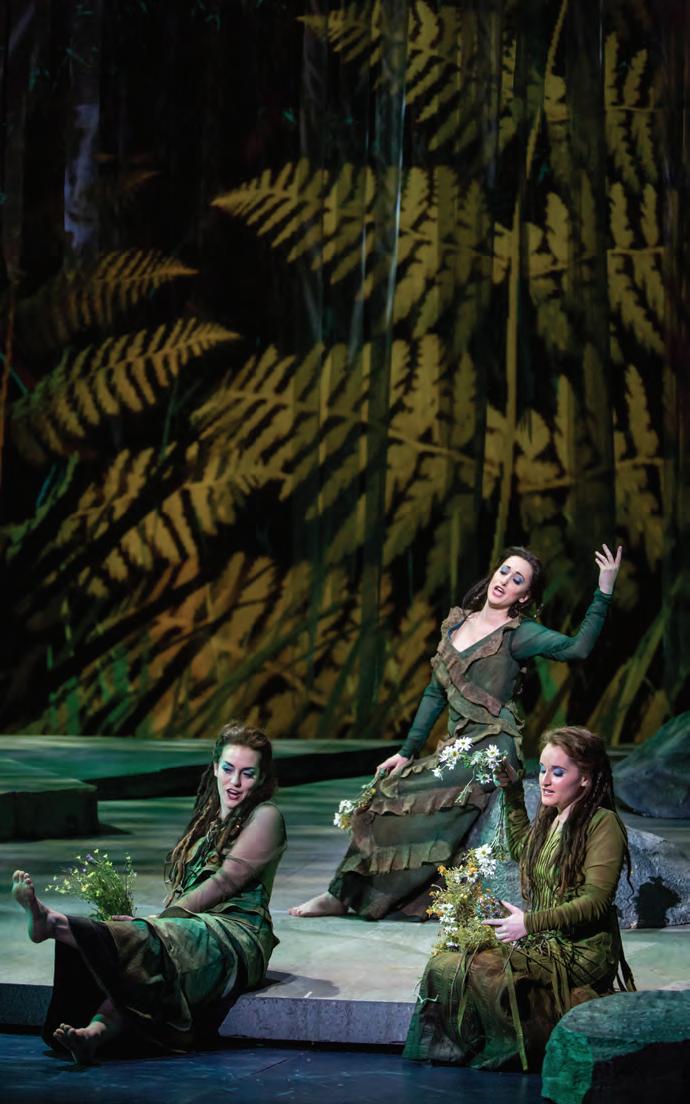
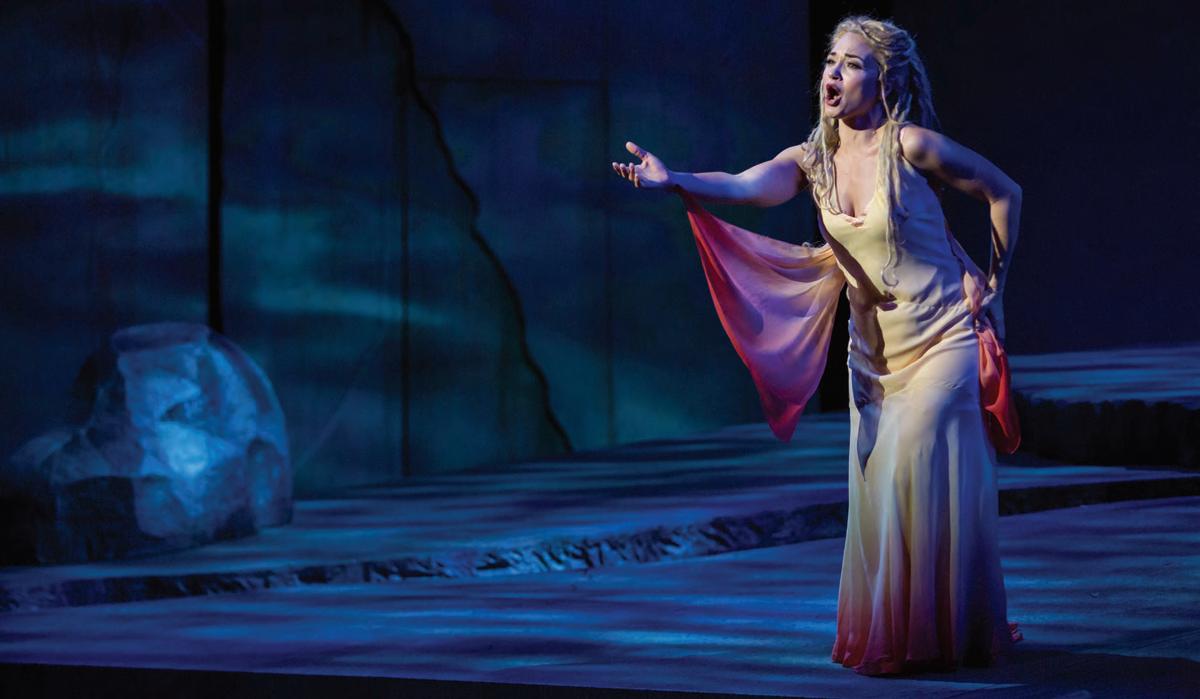

THE 2015–16 SEASON ended up being “The Kelly Kaduce Show,” starring none other than Miss Kelly Kaduce. It had been planned for quite some time that Kaduce would sing two big roles that season: Wendy, the beleaguered wife in the premiere of The Shining, and the title role of the lovelorn water sprite in the company’s revival of Rusalka. Then in March came the news that the Hungarian soprano Csilla Boross, who had been rehearsing the part of Tosca in the Puccini opera, had bowed out “for personal reasons” just a few days before the opening, and that her replacement would be Kaduce, who had sung the role just once, with the Houston Grand Opera, along with several school performances. This was three big roles in a row, a level of ubiquity not seen in Minnesota Opera’s casting since the 1970s, when an ensemble of singers performed nearly all the roles in a season. The role of Tosca is usually sung by voices that are darker than Kaduce’s light, flexible, and silvery— actually, a spinto -lyric—soprano. And yet it was clear on opening night that no excuses were necessary. Kaduce’s Tosca was vivid, tempestuous, and, in most regards, totally up to speed. She made a glamorous entrance—the character, after all, is Rome’s greatest actress. She was what we expect Tosca to be: a vain, demanding, and jealous diva. Moreover, as we seldom see so clearly defined, this Tosca progressed in stages, from giddy lover to distraught victim to heroic opponent of tyranny. The voice, true enough, needed a wider range of color. But Kaduce rode Puccini’s fevered climaxes with ease, and her “Vissi d’arte,” wildly applauded, was more than just a vocal showpiece. It was the interior monologue of a woman at the breaking point, as if, dropping to her knees, she were quoting from the New Testament: “My God, why hast Thou forsaken me?”
And Kaduce was in good company. Leonardo Capalbo made a believably sympathetic and defiant hero out of the one-dimensional Cavaradossi, and his duets with Kaduce nearly set the stage on fire. A true tenore di forza, Capalbo’s outbursts were bright and ringing, and his third-act aria was sensitively nuanced. Stephen Powell was a formidable Scarpia. His singing filled the hall, and the role was powerfully acted. Huge, partly abstract sculptures by Lorenzo Cutùli dominated the stage in the first



THE BIG NEWS CAME in January 2016. Ryan Taylor, general director of Arizona Opera, had been appointed president and general director of Minnesota Opera, effective May 1. An operatic baritone and an alumnus of Minnesota Opera’s Resident Artist program, the forty-three-year-old Taylor’s hiring was the result of a six-month search. It followed a fiveyear period of administrative instability for the company. Taylor succeeded Nina Archabal, who had been serving in an interim capacity since the resignation of Kevin Ramach in November of 2014. After a thorough interview process, the board unanimously approved Taylor’s five-year appointment on January 13.
and final acts. Though impressive, they made no sense. The golden sunburst encircling the Madonna was more pagan than Christian. Even so, the director Andrea Cigni brought some nice touches to the proceedings. For instance, the table knife with which Scarpia threatens his henchman is the weapon that Tosca uses to kill him. On the other hand, moving the action forward one hundred years to around 1900, while it provided a rationale for Cutùli’s beautiful costumes, clashed with references to Napoleon in the libretto. Still, overall, this was an exciting evening. Conductor Anne Manson’s pacing of the score displayed an assured feeling for Puccini’s unique idiom.
Among Taylor’s accomplishments in Arizona was a dramatic turnaround of the company’s finances, marked by record-breaking success with fundraising. A native of Atlanta, Taylor spent more than a decade as an operatic baritone, amassing more than thirty roles to his credit. He was invited to participate in Minnesota Opera’s Resident Artist Program during the 2000–01 season and returned in 2004 to sing the role of Sharpless in Madame Butterfly. Prior to coming to Arizona, he held positions as artist manager and public relations director for ADA Artist Management in New York, manager of community development for the Wolf Trap Opera Company, general director of the Berkshire Opera, and cofounder of the Southeastern Festival of Song.
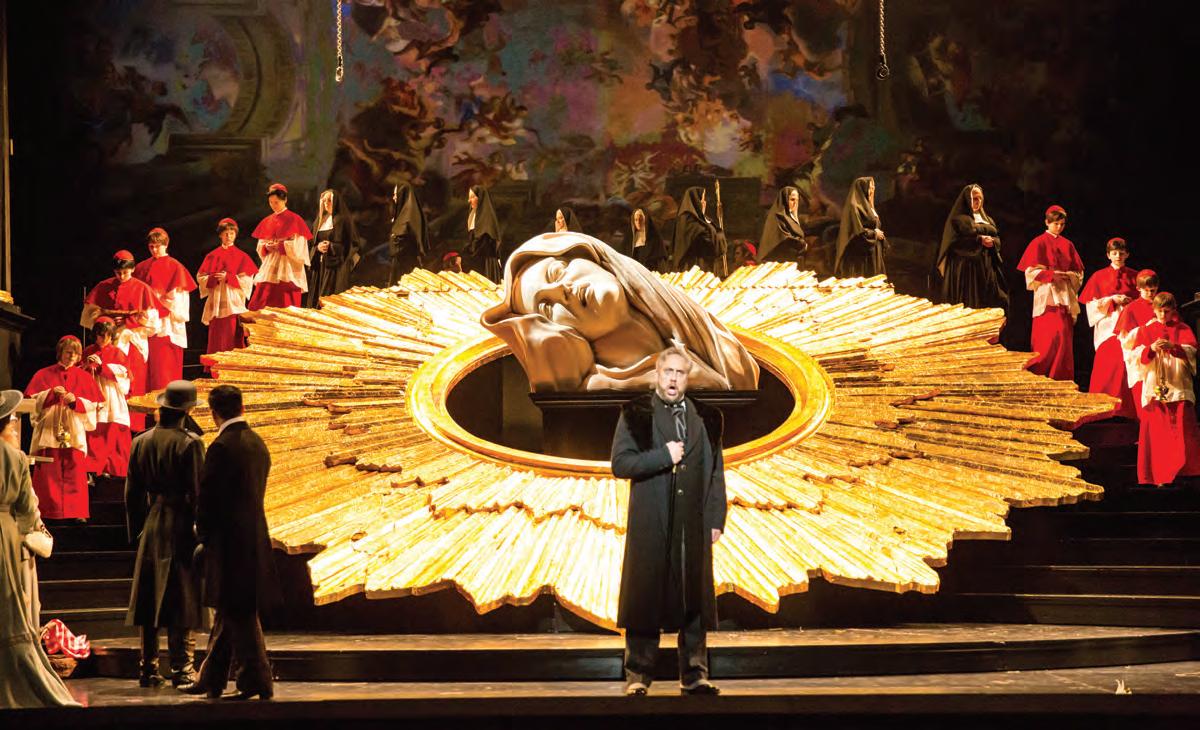
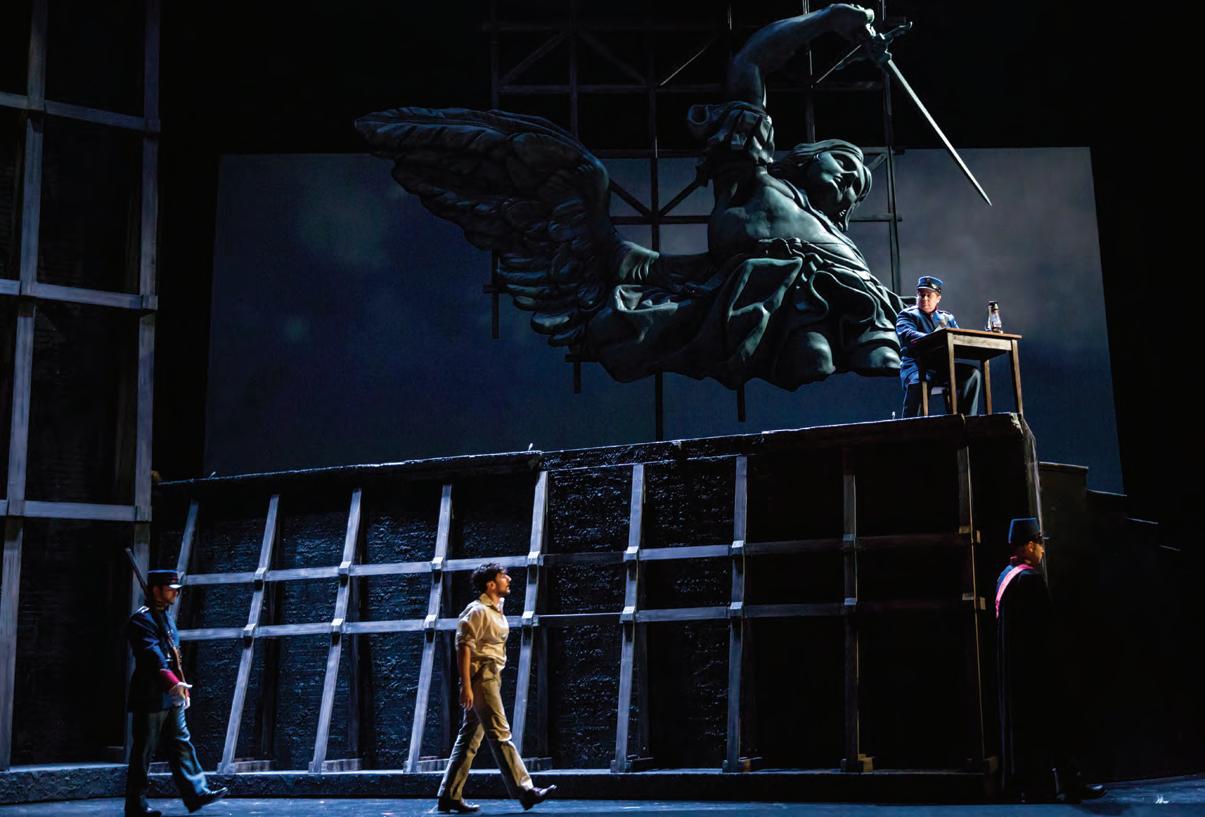
WITH HIGH HOPES and new leadership in place, Minnesota Opera confidently launched its 2016–17 season—its fiftyfourth—with a production of Gounod’s Romeo and Juliet, offering a first-rate production of a second-rate opera.
Gounod was a weak dramatist, and his librettists, Barbier and Carre, weren’t much help. With the aid of Gounod’s pleasant tunes, they turned Shakespeare’s masterpiece into a sentimental nineteenth-century melodrama with only two characters of any real substance, our star-crossed lovers. Nonetheless, the director, Andrew Ozawa, managed to incorporate a few nice touches. In the opening party scene, he made it clear that Juliet is being forced by her father to marry Paris. She’s property, in other words. And though there was nothing subtle about the symbols that adorned designer William Boles’s sets, symbols that he showed us over and over again—huge pink roses signifying, presumably, love, while swords, representing hate and violence, descended from the ceiling—were fun to watch. He set the opera in Shakespeare’s time rather than the medieval period,
which gave us ample opportunity to look at Sarah Bahr’s opulent costumes. And he staged an intriguing pantomime during the overture. Our Romeo and Juliet, Joshua Dennis and Angela Montellaro, dressed in contemporary garb, walk downstage and then are put into period costumes by chorus members. The suggestion is a play within a play but also that the opera’s central conflict—enmity and warfare between families, to say nothing of nations—continues up to the present day.
Dennis’s Romeo was more sincere than heroic, more high school class president than captain of the football team. But he made his sincerity believable, and his voice, a robust tenor with baritonal heft, rose to the high climaxes with ringing, ardent bravado. Montellaro, a former resident artist with this company who has gone on to a big career, was a Juliet both fragile and passionate. Thomas Glass was a confident Capulet, Phillip Addis an adroit, limber Mercutio, and Gina Perregrino a sprightly Stephano. Penelope Freeh choreographed the spidery dances, and Doug Scholz-Carlson’s staging of the big fight scene looked surprisingly realistic with just a hint of the Sharks and the Jets from West Side Story

For Ryan Taylor, the cancellation of two productions due to COVID-19 the week of March 9, 2020, was, he said, one of the darkest moments of his life. The context made it harder: He had returned Sunday, the 8th, from Phoenix, where he had learned an “exceptionally close friend,” the former board chair of Arizona Opera, was fatally ill. Two nights later, he attended the funeral of another close friend in Chicago.
He returned to Minneapolis on Wednesday and spoke the next day to the musicians of the opera orchestra, who were rehearsing Edward Tulane, to be premiered in nine days. It was thought at that time that rehearsals and performances of Edward Tulane would proceed as planned but that the season finale, Don Giovanni, might be affected. However, it became apparent that Edward Tulane would have to be canceled.
“That was a pretty rough moment,” Taylor said, recalling the experience some months later. “There was an awful lot of shared trust and fear and respect, and I think that was my least favorite day or series of days.”
Taylor’s calm demeanor—his zen leadership style, as it has been described—had impressed the search committee back in 2015 when Ryan was a candidate for the company’s top position, and it is the quality that has been most appreciated during the COVID crisis. Former board chair Bernt von Ohlen served on the search committee. “One of Ryan’s strengths,” he said, “one that he demonstrated during the pandemic, was his ability to maintain a steady hand in a crisis. He proved to be very good at keeping things going and keeping focused.”
“Ryan’s calm, cool, and collected,” said Eric Broker, the company’s marketing and communications director. “He makes space for people to lead and to really own their expertise and contribute.”
In his early twenties, Taylor was making serious money as a realtor. Yet the leaders of the Atlanta Opera, where he sang in the chorus, encouraged him to be an opera singer. He sought out the family’s oracle, his maternal grandfather, who said, “If you don’t try it, you’re always going to wonder if you could have done it.”
He quit wondering and in 1997 graduated with a degree in vocal performance at the San Francisco Conservatory of Music. His first big career step was his mainstage debut in the 2000–01 Minnesota Opera’s Resident Artists Program, singing the part of Ping, the Grand Chancellor in Turandot. He returned to the Ordway in 2004 to sing the role of Sharpless in Madame Butterfly. Over the next several years, Taylor sang some thirty roles with various opera companies around the country.
In 2008, while performing in La traviata at a music festival in Maine, Taylor got a call from a colleague asking him to take charge of the Berkshire Opera Company in Massachusetts. That evening, Taylor made two lists: one of everything he’d sung since high school and another of everything he had helped produce. Then he put a checkmark next to
those he enjoyed. When he finished the list of eighty-eight parts he’d sung, he found seven checkmarks; in the production list, he found thirty-one of the thirty-four. He called his manager and said, “I want to keep Dead Man Walking on the books, but I’m pulling out of almost everything else, and I’m going to apply for this job.”
This is a story that has valleys as well as hills. Taylor got the job, but within ten months the Berkshire Opera Company went belly-up. For the next three years, Taylor served concurrently as artist manager and public relations director for ADA Artist Management in New York and as manager of community development in the Wolf Trap Opera Company in Washington, DC. In January of 2012, he became director of artistic administration for Arizona Opera.
Fifteen months later, the company’s managing director resigned abruptly, leaving behind $4.2 million in debt. The board appointed Taylor interim managing director. Taylor’s first order of business in Arizona was a million-dollar fundraising campaign to address the debt crisis. When that was successful, he was offered the top job on a permanent basis. The good news on the financial front was that as of June 30, 2015, the company had paid off all its interest-bearing debt and declared surpluses of $1.2 million and $520,000 in the fiscal years 2013 and 2014.
This is the kind of good news the Minnesota Opera search committee loved to hear. In the summer of 2015, the committee were hiring a replacement for interim president Nina Archabal. This time they wanted a single executive who also filled the role of artistic director—an intendant, in the European tradition—whereas, for its entire history, Minnesota Opera had relied on a pair of leaders, an executive director and an artistic director. These roles, since 1994, had been filled by Kevin Smith and Dale Johnson. Ryan Taylor was the leader they were looking for. His appointment was announced on January 14, 2016.
Taylor’s first five years at the helm of Minnesota Opera were both calming and transformative. Finances were stabilized, a new team was assembled, and the company rebranded itself, articulating a new mission and image. The board’s approval of Taylor has remained fervent. Susan Boren, former board chair, said: “Ryan is one of the best natural leaders I have seen in the not-for-profit sector. He understands the craft. He was a performer. But he is also an incredibly fine leader. He has brought not only incredible sensitivity [but also] vision for the opera company, and his performance during COVID has been extraordinary.”
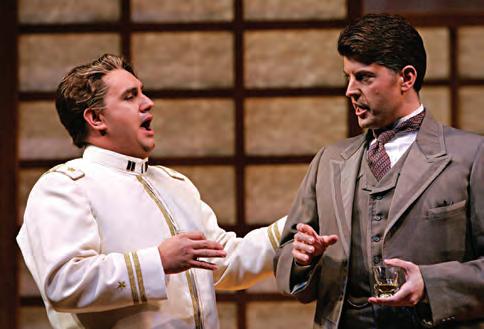



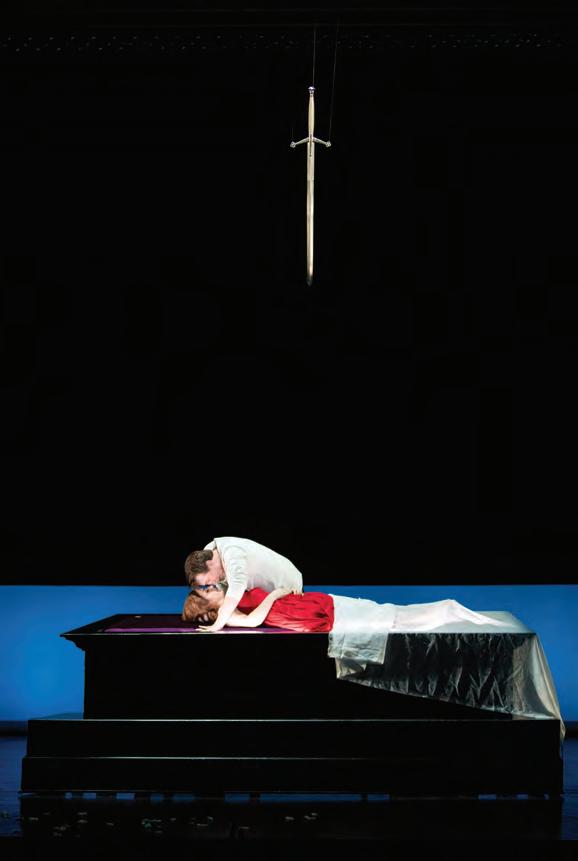
THE HIGHLIGHT OF THE SEASON was the premiere of Dinner at Eight, a work based on the revered Kaufman and Ferber play with music by William Bolcom and libretto by Mark Campbell—the prolific Campbell’s fifth opera for this company in less than a decade. The play, which chronicles the foibles of the rich during the darkest years of the Great Depression, opened on Broadway in 1932 and was followed a year later by an all-star movie version starring John and Lionel Barrymore, Wallace Berry, Marie Dressler, and Jean Harlow as the not-so-dumb gold digger Kitty Packard.
The story concerns a prominent New York socialite, Millicent Jordan, who throws a dinner party where everything goes wrong. The food is burned, the guests of honor cancel, and in short order we’re apprised of two failed marriages, a business swindle, a fatal illness, one or two instances of serial adultery, and a suicide. Bear in mind that these were supposed to be the happy people, the privileged ones, the ones who weren’t obliged to wander the streets, as we see in the old newsreels, people holding up homemade signs saying, “Why can’t you give my dad a job?” and “Four children for sale.”
Campbell’s smart libretto, which is based on the play rather than the movie, keeps these two attitudes—or emotional frames—in balance. To be sure, Dinner at Eight is a comedy, and there are plenty of laughs to demonstrate that. But the tone is one of sadness and regret. Each of the characters is losing something or is afraid of losing something. Bolcom’s subtle orchestration is especially effective in the darker moments.
Typical of Bolcom’s work, the score draws on a wide range of idioms—waltzes, marches, tangos—along with tangy harmonies and atmospheric etchings. Though this is definitely an opera, the music feels in places like a Broadway musical of the early ’30s.
The cast was outstanding: Mary Dunleavy and Stephen Powell as the Jordans, Craig Irvin and Susannah Biler as the Packards, Andrew Garland and Adriana Zabala as Dr. Talbot and his wife, Brenda Harris as Carlotta Vance, and Richard Troxell as Larry Renault. Victoria Tzykun designed the plush costumes and Robert Wierzel the lighting. Conductor David Agler paced the show expertly and drew a bright performance from the orchestra. The opera and the production were the latest installment in the company’s New Works Initiative. It was a coproduction with Atlanta Opera and the Wexford Festival in Ireland.
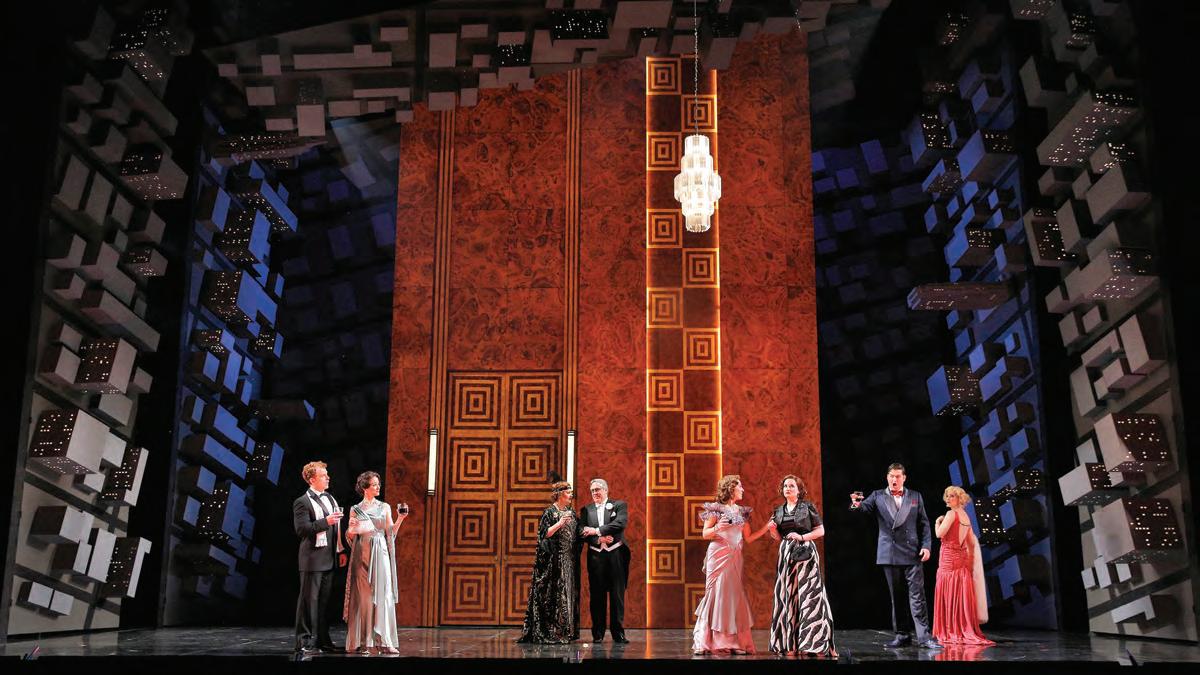
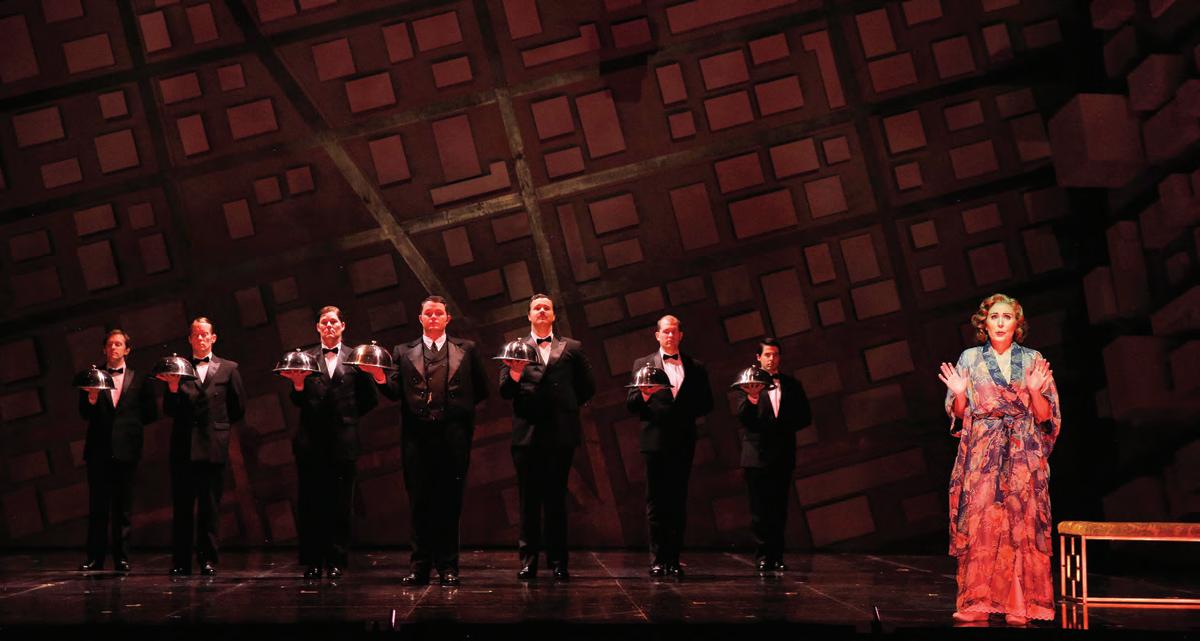
THE BIG HIT OF VIENNA in 1787 was Diana’s Garden by the prolific Spanish composer Vicente Martín y Soler, set to a racy libretto by Mozart’s favorite collaborator, Lorenzo da Ponte. The opera, which concerns a bunch of randy nymphs and swains cavorting on an island, ran for a couple of seasons in Vienna, then disappeared and spent the next two centuries sitting on a shelf gathering dust. It had been staged a few times more recently, and in January 2017, Minnesota Opera presented the work in a lively production staged by Peter Rothstein.
Da Ponte’s libretto draws on pastoral tales and Greek mythology. Amore (Cupid) and Diana, goddess of the hunt and virtue, are at odds, as is usually the case in what we like to call real life. Attended by her three Nymphs, Diana rules the island and guards the magic tree, a symbol of chastity and an enemy of all things sexual. In an amusing touch, designer Paul Whitaker has the tree looking pathetically barren and emaciated, suggesting that no one likes a prudish tree. To restore the natural order of things, Amore brings three lusty youths to the island to woo the maidens, and he engages a shepherd to make Diana fall in love.
Rothstein placed the action in urban America in the 1950s, a time, he says in a program note, “of clearly defined gen-
der roles and expectations, which means, at least for women, sexual repression and chastity before marriage.” Accordingly, Diana—wonderfully played and sung by Leah Partridge—was made up to look like Pat Nixon with hints of Phyllis Schlafly and Harriet Nelson. When we first encounter the Nymphs, they’re sneaking cigarettes, as if they were co-eds lighting up on the sly at Bob Jones University. Rothstein made the connection between sexual repression and violence explicit; Diana aims a rifle at anyone who thwarts her. Whitaker’s set, the interior of a weather-beaten monastery, conveys the idea of an old, corrupt, patriarchal social order giving way at the end of the opera to the sexual revolution of the 1960s and the restoration of a more natural order. Costume designer Alice Fredrickson provided a pungent image of fecundity: flowers bursting out of the costumes of Diana and Endimione, the shepherd.
The cast was consistently strong. Partridge stopped the show on opening night with her emotively sung first-act “rage aria,” and she clearly conveyed Diana’s vulnerability and confusion in the final scenes. Adriana Zabala was a fetching Amore, and the three men—Craig Cloclough, Alek Shrader, and David Walton—were in top form as singers and actors. The three Nymphs performed at the same high level: Alexandra Razskazoff, Gina Perregrino, and Nadia Fayad.
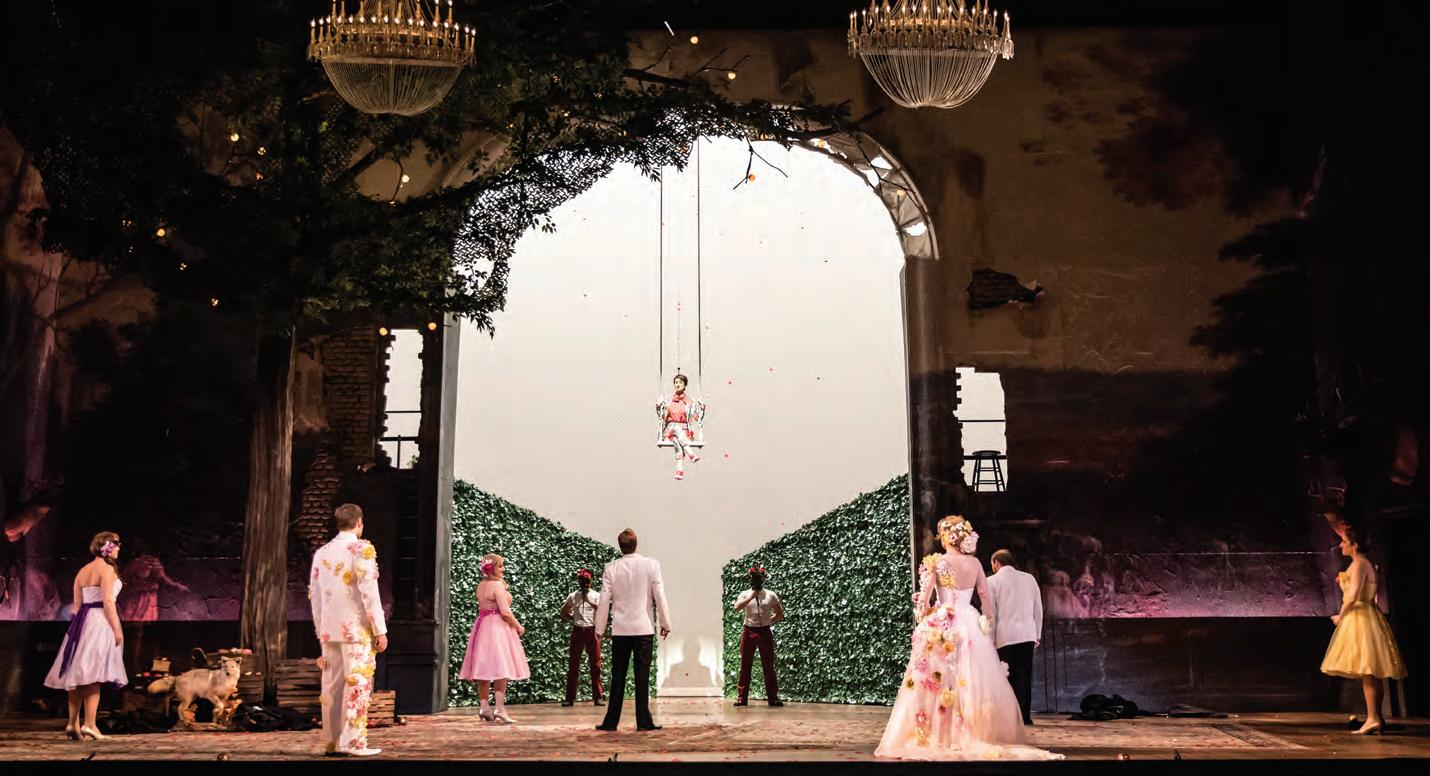
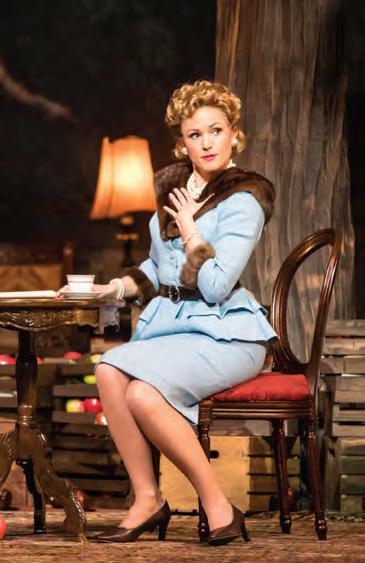
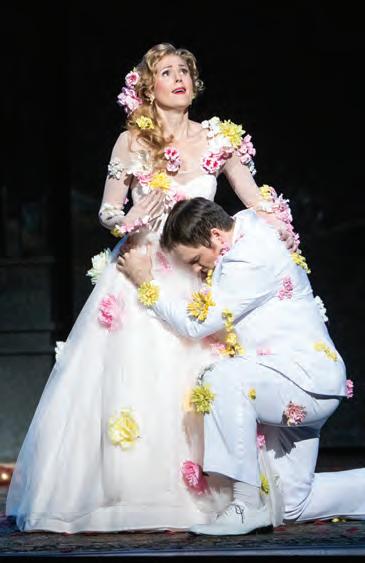


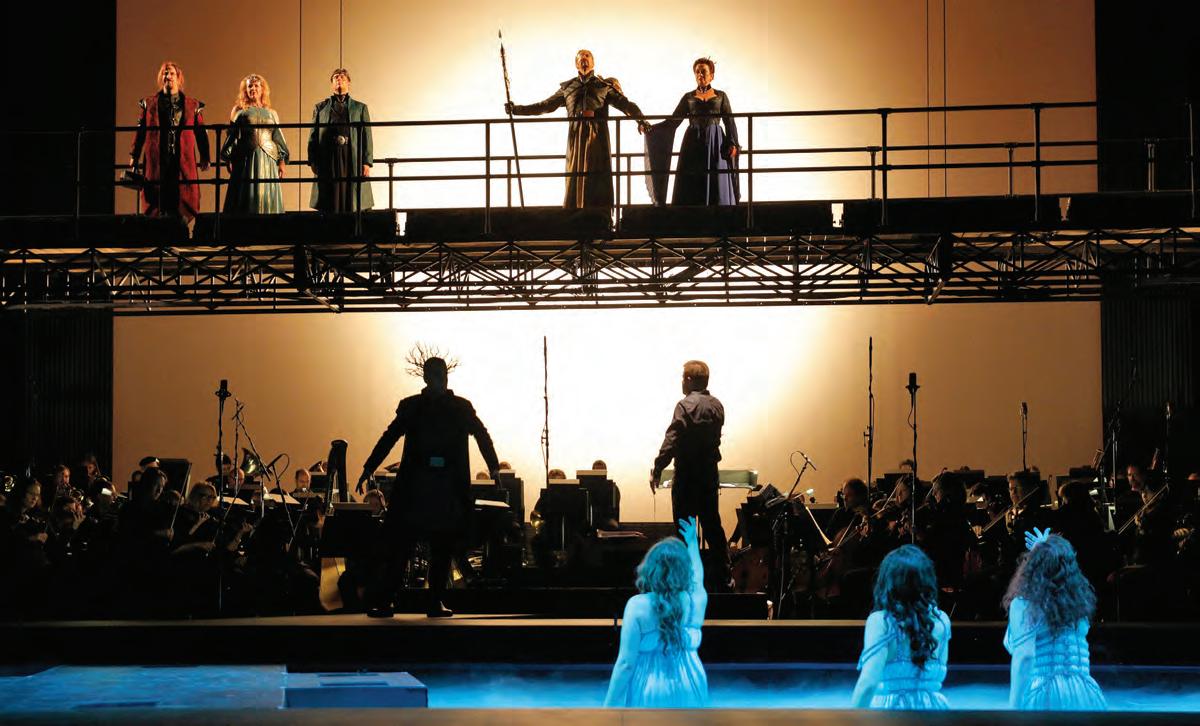
IN NOVEMBER, in a rare excursion into the world of Richard Wagner, the company presented a surprisingly effective production of Das Rheingold, the first of the four “Ring” operas, in a staging by Brian Staufenbiel with Michael Christie conducting.
It came as a surprise because, except for a rather wayward Flying Dutchman back in 2003, Minnesota Opera has shied away from Wagner. The Wagner operas are expensive to put on, and they’re difficult—sometimes impossible—to cast. The technical problem is that the orchestra pit at the Ordway is too small for Wagner, especially the later operas. Dutchman, an early instance of the composer’s work, was presented by this company in 2003 with an orchestra of about sixty players and seemed satisfactory. To put on Rheingold, which calls for bigger forces, the company took the bold step of putting the orchestra—some eighty players—onstage and turned the orchestra pit into the Rhine River. The activities of the gods
took place on a bridge above the orchestra, leaving the downstage area in front of the orchestra for the mere mortals.
This worked better than one might have expected. Sound balance between orchestra and singers, always a problem in Wagner, was enhanced. The singers, at least those on the lower level, didn’t have to sing over the orchestra, which is normally the case. And to avoid the impression that this was simply a concert presentation, the design included video projections, the clever work of David Murakami, which added both atmosphere and narrative thrust. Matthew LeFebvre’s imaginative costumes evoked sci-fi of the Mad Max variety. Creepy images of bugs proliferated. Greer Grimsley, as is usually the case, dominated the stage as Wotan, king of the gods. With his powerful baritone, Grimsley vividly charted the character’s obsessive but increasingly uncertain lust for power. The same could be said for Nathan Berg’s Alberich, the tortured troll who trades love for world domination and

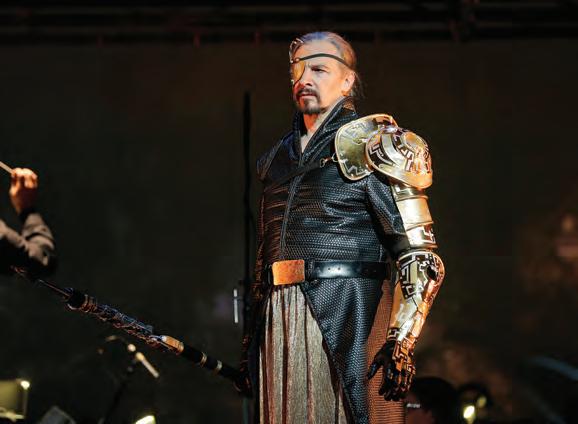

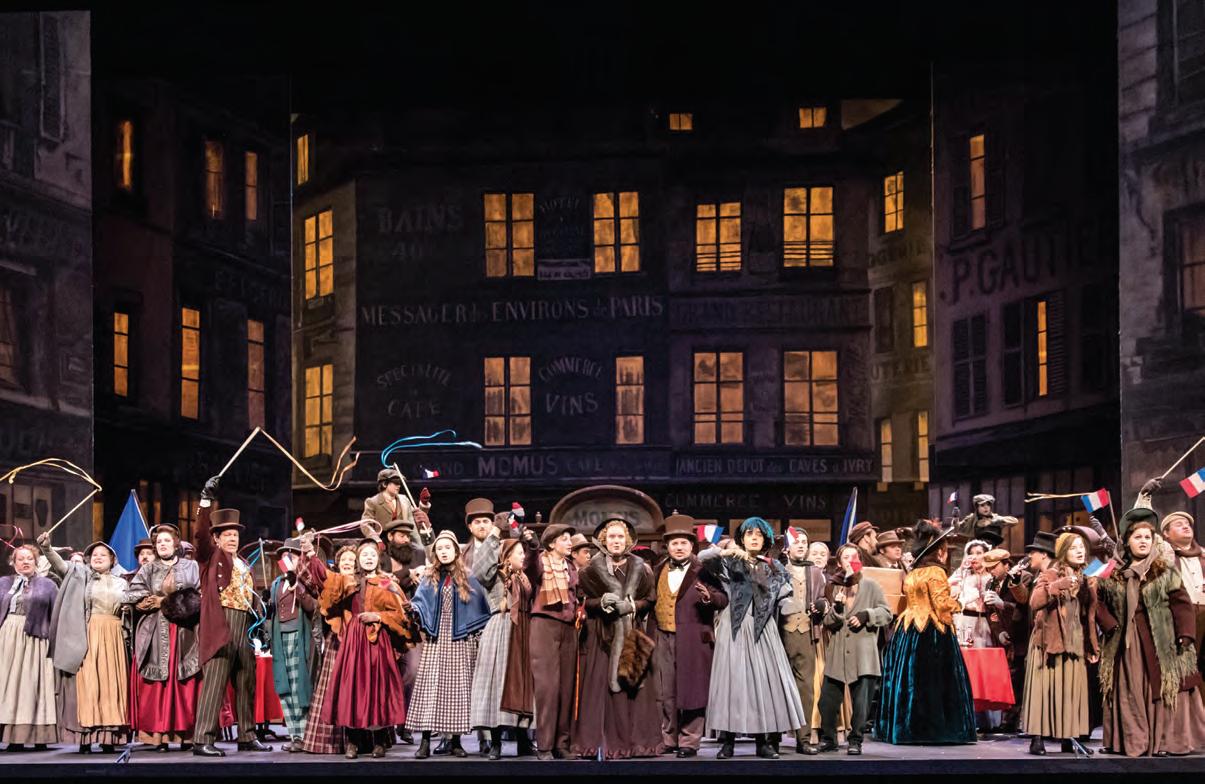
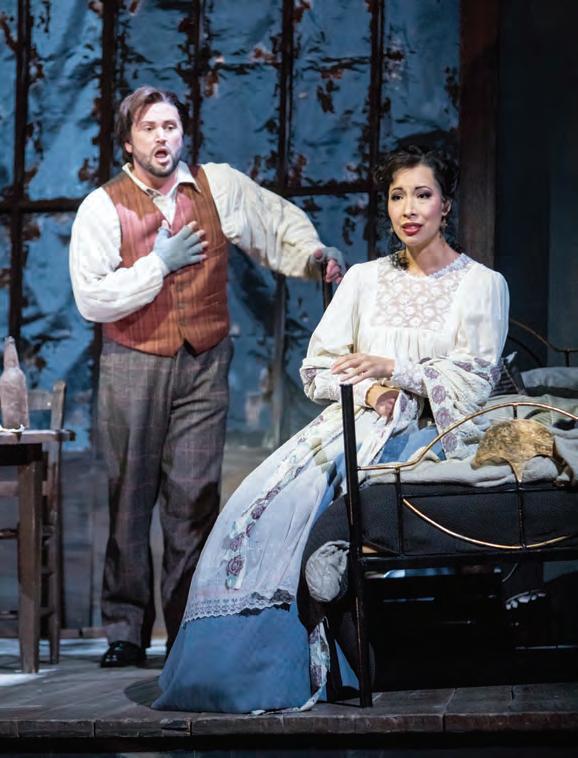
whose final curse was the evening’s most compelling moment. Richard Cox’s Loge, fervently sung, was sly and manipulative; Katherine Goeldner was an aptly whiny Fricka and Karin Wolverton a smartly vocalized Freia. Leading the orchestra, Michael Christie sustained tension and clarity throughout the nonstop two-and-a-half-hour production and drew polished playing from the musicians.
Octavio Cardenas staged the season finale, a small-scale but picturesque production of La bohème enhanced by the graceful singing of the lyric soprano Nicole Cabell as Mimì and Scott Quinn’s subtle but exciting vocalizing as Rodolfo.
THE AMBITIOUS 2017–18 season included two recent works: Dead Man Walking by Jake Heggie with a libretto by Terence McNally and Fellow Travelers by Gregory Spears with a text by Greg Pierce, an opera premiered to wide acclaim by Cincinnati Opera in 2016. Both are important works.
Premiered in San Francisco in 2000, Dead Man Walking is the most performed new opera of the twenty-first century. By 2018, it had been staged in nearly sixty productions in five countries. Its source is the bestselling 1993 memoir by Sister Helen Prejean, which tells of the author’s experiences on Louisiana’s death row and her relationship with a young man convicted of taking part in the murders of two teenagers. The work’s virtues—its dramatic force, tight construction, and telling moments of sadness and yearning—were made abundantly clear in this thoughtful, often gripping production from Vancouver Opera with vivid staging by Joel Ivany and deft pacing by conductor Michael Christie.
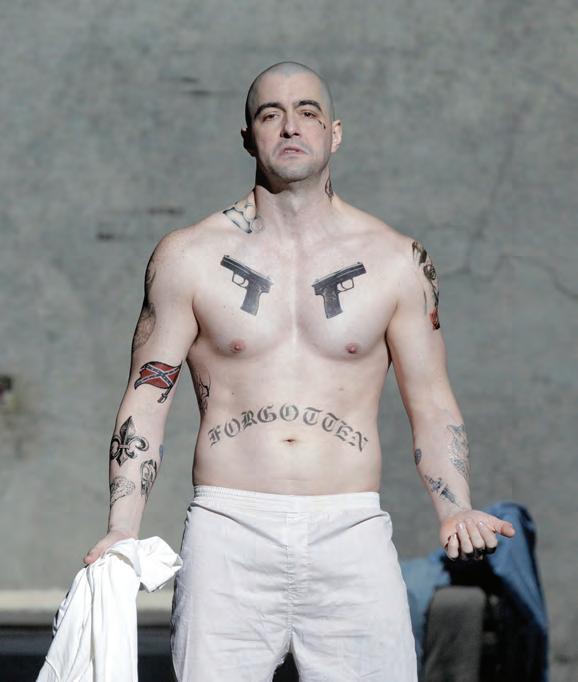


Though its setting, characters, and intensity are quite different, Fellow Travelers, based on the novel by Thomas Mallon, deals with the same emotions, sadness and yearning, both made eloquent in Spears’s engaging and dramatic score and Pierce’s illuminating text. The story concerns two federal government workers who have a secret love affair during the

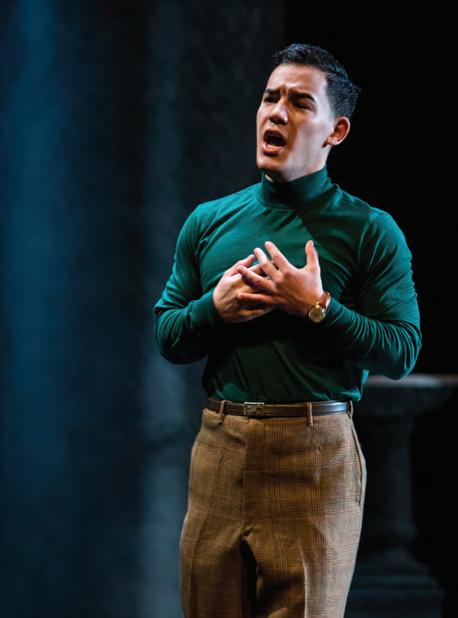


Lavender Scare of the 1950s, when some five thousand government employees were fired because they were suspected of being gay. To wrap up its fifty-fifth season, Minnesota Opera presented a new production of the work, offering a smart staging by Peter Rothstein, along with an effectively atmospheric design by Sara Brown and a strong cast that included, in memorably powerful performances, Andres Acosta and Hadleigh Adams in the two main roles.
Pierce, an experienced young playwright, wisely foregrounds the love affair between the two men, leaving out much of the minutely detailed political history that slows the novel down to a crawl. His scenes flow easily, from solo numbers to ensembles. Spears’s delicate, subtle music sustains a tone of longing and regret. The score, wistful rather than sentimental, mixes minimalist rhythmic patterns with a lyricism at times gentle, at other times pungent.
Acosta and Adams were an unlikely but perfect couple, both accomplished singers. Their scenes together sparkled with energy. Adams, playing Hawkins Fuller, the older and more experienced of the two—arrogant, smooth, and glib, definitely a predator—is nonetheless devastated at the end when he realizes he has lost the love of his lifetime. Tim Laughlin, as played by Acosta, is eager and vulnerable at the start, a hollow shell at the end, but still able to move on. Even so, the ending is devastating. The two not only had to suffer bigotry but had the burden of realizing that, ultimately, they weren’t right for each other.
Adriana Zabala sang superbly as Mary Johnson, the two lovers’ loyal friend, and Andrew Wilkowske, a much-favored baritone with this company, turned Joe McCarthy into a drunken but dangerous buffoon. This was the company’s first production at the Cowles Center in downtown Minneapolis, its first in that city since 1993.
McNally’s libretto for Dead Man is theatrical yet always direct and believable. The opera’s two acts build effortlessly toward stunning climaxes. Heggie is an opera composer of assurance who has written several other works for the theater in the years since 2000. His music moves the action along with a strong sense of flow. He uses motifs skillfully, and his handling of popular idioms—blues, gospel, rock ’n’ roll—comes across as natural. A skilled baritone, Seth Carico made Joseph de Rocher, the central character, a fierce, gritty, vulnerable, and ultimately frightened man. His “A Warm Night” aria hit just the right tone of sensuality. Catherine Martin’s Sister Helen displayed a similar kaleidoscope of emotions in a thoroughly convincing and majestically sung performance.
MUCH WAS OFFERED during the 2017–18 season, including three more operas and a chance for at least two directors to go a little bit wild and crazy. In Don Pasquale, a Donizetti favorite, director Chuck Hudson moved the action from Rome in the early nineteenth century to Hollywood in the 1950s. Our grumpy old Don became a former silent film star who’s trying to revive his career by appearing in bad sci-fi movies like Tentacles 2, which we see the trailer of. Craig Colclough was amusing in the title role, as was fellow bass-baritone Andrew Wilkowske as the doctor who launches the revenge plot propelling the story. Norina, our saucy heroine, sang her initial aria while doing a bubble bath commercial. Laughter ensued.

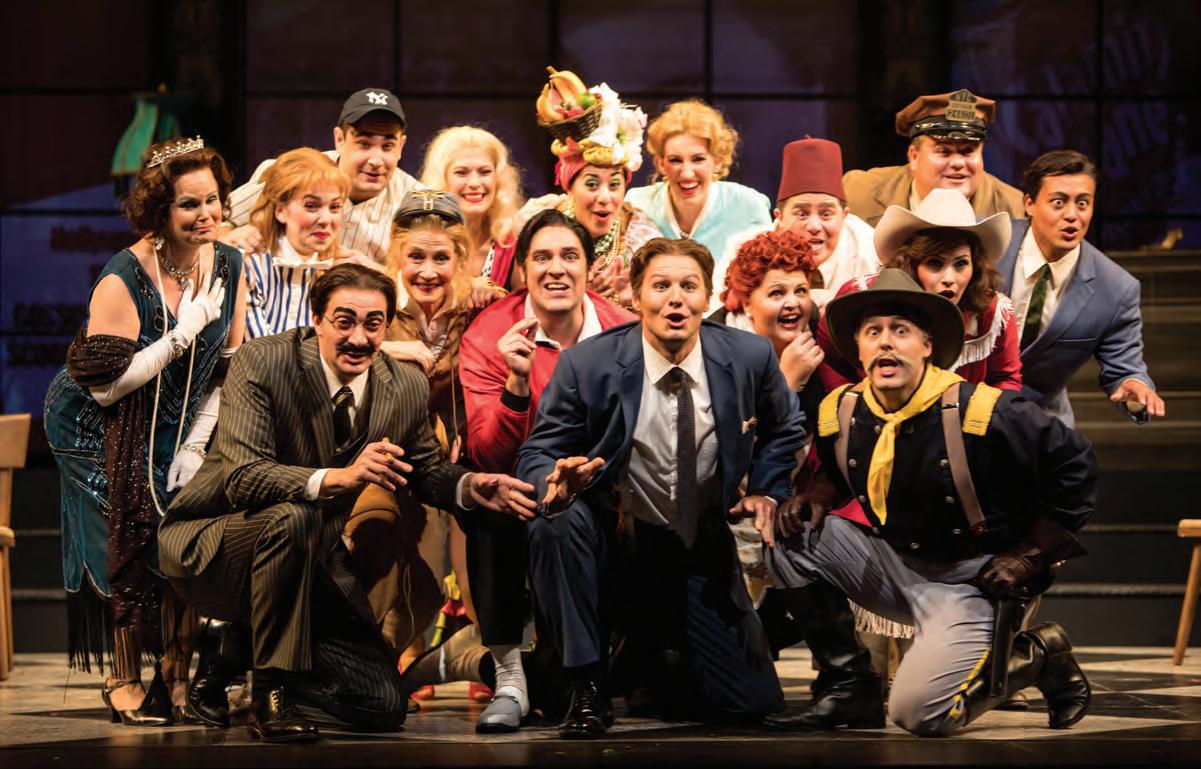
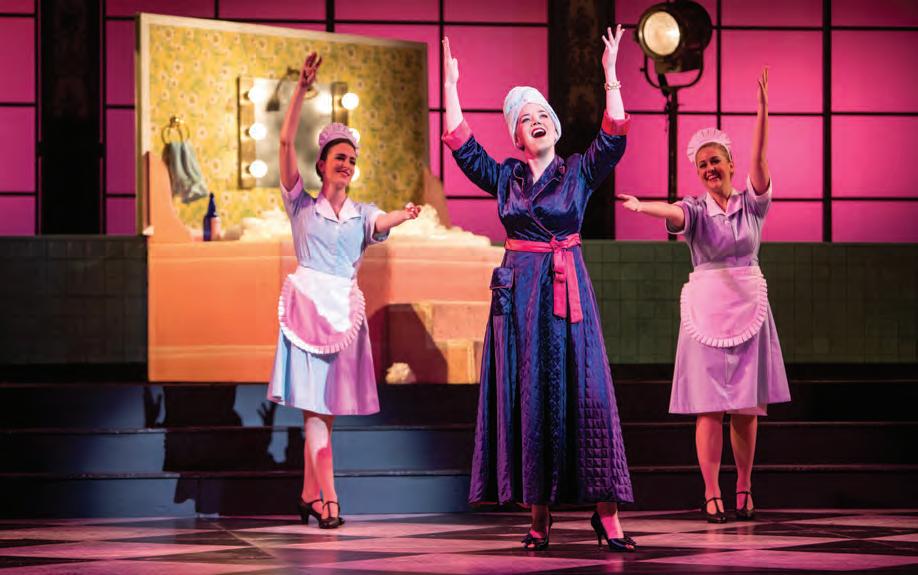
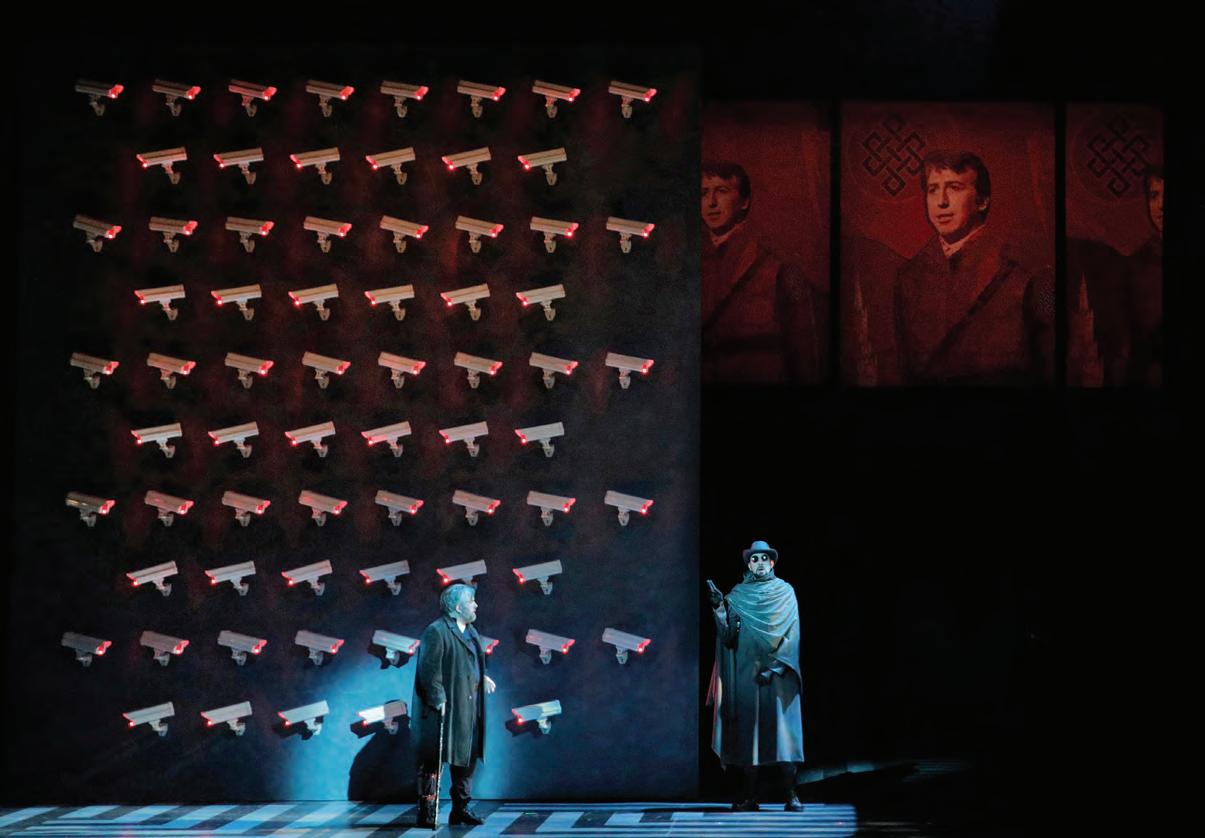
No laughter ensued on the evening of March 16, 2018, when the audience at the Ordway got a look at Austin Regan’s take on Rigoletto, which he moved from sixteenth-century Mantua to “now or a time much like now” in a totalitarian Nazi-like country under the absolute rule of the Duke. This was grim. But the singing was sensational, starting with Icelandic baritone Ólafur Sigurdson’s compelling portrayal of Rigoletto, Joshua Dennis’s cold-blooded Duke, and Marie-Eve Munder’s plaintive, sweet-voiced Gilda.
There was something else to mourn on this occasion: conductor Michael Christie’s departure after eight years as music director. Dale Johnson was leaving too, at the end of the season. The word the company was using was “transitioning,” which meant that Dale would cease being artistic director, a title he had held since 1994, to become creative adviser to Ryan Taylor, president and general director.

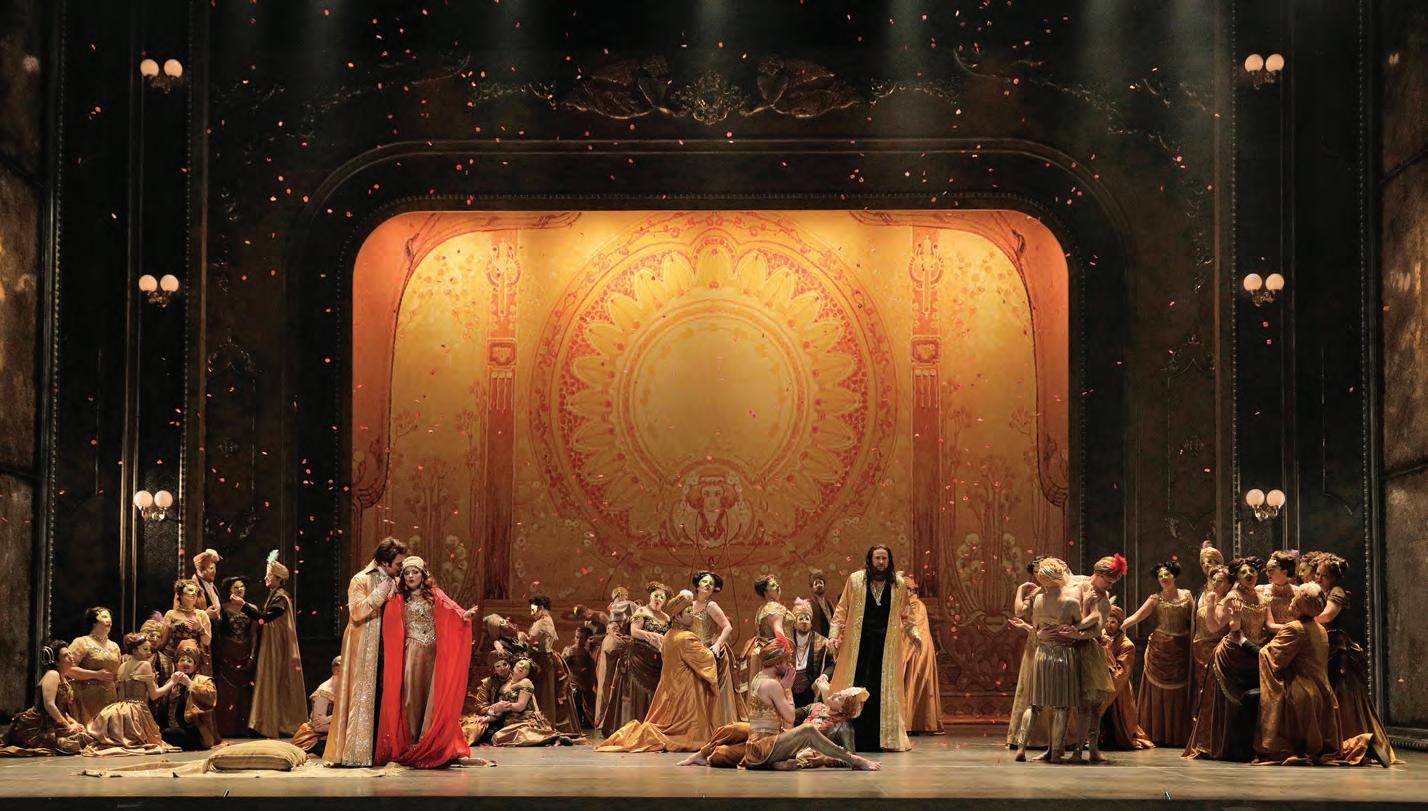
Back in the ’70s, at Northrop Auditorium, the Metropolitan Opera had presented Massenet’s Thaïs, with Beverly Sills singing the title role of the courtesan who worships Venus and sees sex as sacred. Nearly a half century later, as part of its 2017–18 season, Minnesota Opera offered Thaïs at the Ordway with Kelly Kaduce, who was terrific, bringing power and beauty to Massenet’s challenging vocal lines and a character both sensual and shrewd.

ON JULY 1, 2018, Margaret Wurtele stepped down as board chair, having served a two-year term, and was replaced by Bernt von Ohlen, a retired lawyer and lifelong opera fan who had been serving as vice-chair. Bernt von Ohlen said of this time:
In all honesty, I’d have to say that I inherited a reasonably stable situation. [. . .] We had the luxury of thinking about, where do we go from here? What’s the next chapter in the history of this company? There was certainly interest in the purchase of the Lab Theater, an important project that had been talked about for years but had never gotten beyond the talking stage. There were also some fairly serious discussions about capital campaigns and establishing more solid fiscal footing.
The company had managed to keep going, but every year there was some question about whether we would balance the budget. There was a need for some strategic thinking about getting away from that annual worry.
On August 1, 2017, the company announced a reformulated identity in four parts: Mission, Vision, Values, and a new, flexible logo. “Our new mission and vision better capture our core values: innovation, inclusivity, collaboration, and purpose,” said company president Ryan Taylor. The mission states that “Minnesota Opera changes lives by bringing together artists, audiences, and community, advancing the art of opera for today and for future generations.” The vision is that “Minnesota Opera will sing every story.”
The new logo consisted of a series of images based on the vibration pattern of a surface resonating at a specific frequency. As the frequency increases, the patterns become more complex. The figures are to be thought of as sound made visual.
The company’s new identity—“forging the future of opera”—expands on its original focus in the mid-1960s: seeing opera as a form of theater.
SEASON FIFTY-SIX started off with a new appointment: Priti Gandhi assumed the newly created role of chief artistic officer, coming to Minnesota Opera from San Diego Opera, where she was the company’s artistic administrator. The appointment came on the heels of a five-month search and completed the
Minnesota Opera creative team moving forward, along with President and General Director Ryan Taylor, Creative Advisor to the President Dale Johnson, and Chief Production Officer Karen Quisenberry. Gandhi had a twenty-year international opera career; San Diego Opera General Director David Bennet praised her collaborative approach, saying that “she brings a unique real-world experience to her role as an artistic leader” and that she made San Diego “a place where artists feel nurtured, are well cared for, and want to return.”
PUCCINI, WE KNOW, grew to hate La rondine, the opera he completed in 1917. He called it “this pig of an opera.” True, the libretto is heavily borrowed. From La traviata comes the central figure of Magda, a courtesan who longs for real love with a respectable country boy, Ruggero. From Fledermaus comes Lisette, Magda’s flirty maid, and from bohème comes the act two setting of a bustling bar in Paris as well as Lisette’s former lover, Prunier.
Indeed, La rondine remains the least often performed of this composer’s eight mature operas. But Puccini was too hard on it. It’s an excellent score by anybody’s standards. It was Puccini’s effort to mix his own brand of highly emotive lyricism with the bittersweet, nostalgic sentiment of Franz Lehar’s style of operetta, and in a good production, such as the one Minnesota Opera unveiled as the 2018–19 season-opener, it’s hard to resist.
The director, Octavio Cardenas, gave the story an extra structure. In this production, these are Magda’s reminiscences. Each act is framed by her wandering through a black-and-white palette that bursts into color as her memories come to life. Paris itself becomes almost a character in the story, thanks to Sara Brown’s colorful sets—the view through a bay window of the Cathedral of Notre Dame in the first act—Montana Levi Blanco’s bright costumes and Joshua Higgason’s atmospheric projections.
Singing the role of Magda, the banker’s mistress who finds true love with a provincial suitor only to have to give it up for his sake, Irish soprano Celine Byrne projected the aura of glamour that the character demands, especially in the first act, while negotiating the role’s high tessitura with great assurance, including that treacherous high A-flat at the very end. Leonardo Capalbo made a totally sympathetic Ruggero, absolutely undone when Magda hints that she will leave him. Christian Sanders and Lisa Marie Rogali offered welcome comic relief as Lisette and Prunier. Sergio Alapant was the excellent conductor.

IT MADE SENSE for Minnesota Opera to revive its muchadmired production of Silent Night, the opera by Kevin Puts and Mark Campbell that won the Pulitzer Prize in 2012. Winning the prize served to validate not only the work itself— Puts’s first opera—but also the bold effort that brought it to life, the company’s New Works Initiative, an ambitious and well-funded program, unprecedented among American opera companies, aimed at energizing the contemporary repertoire, creating new works as well as reviving worthy operas from the recent past.
The date of the opening was significant as well: November 10, just one day before the one-hundredth anniversary of the Armistice that ended World War One. The subject of
the opera is the “Christmas truce” of 1914, the brief ceasefire when British, French, German, and Scottish soldiers put down their weapons and found common humanity before going back to killing one another.
The opera remains a powerful experience, and the returning cast repeated the strong impression they made the first time around, among them Karin Wolverton as the Norwegian soprano who sings the tender a cappella “Dona Nobis Pacem.” By 2020 Silent Night had been seen in twenty cities in the United States and Europe. And that, it appears, was just the start. As Mark Stryker wrote in the Detroit Free Press in 2016, “Few operas of recent vintage have entered the repertory as swiftly as Silent Night.”
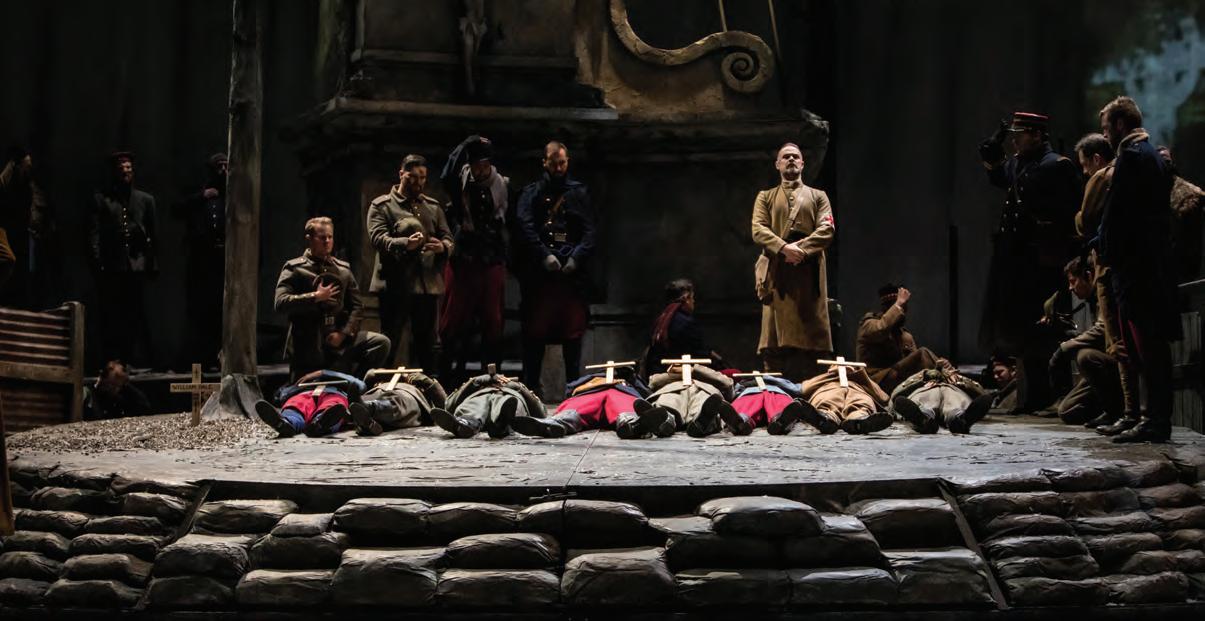
“I’M STRUCK DUMB with astonishment.”
That’s the chorus baring its soul during a frenzied moment in Nino Rota’s comic romp The Italian Straw Hat, which Minnesota Opera presented with appropriate zest and cunning on a cold evening in January of 2019.
Rota, a prolific Italian composer known chiefly for his film scores, of which he composed nearly 150, including the Oscarwinning music for The Godfather Part II, also wrote operas, ten of them. The one most often staged is based on a popular Parisian boulevard farce of the mid-nineteenth century by Eugene Labich and Marc-Michel, The Italian Straw Hat, which concerns the desperate efforts of a wealthy, soon-to-bewedded young bachelor to find the duplicate of a straw hat that was eaten by a horse. This dilemma our hero, Fadinard, faces—no hat, no marriage—is, need we say, preposterous. But the tale, in both the play and the libretto, is told with such gusto, and the characters are so amusing, that we go along for the ride and end up rooting for the hero. Rota’s score is an adroit mix of two elements: lighthearted comic gestures in the manner of Rossini and a richly melodic lyricism—the Viennese-style love duet in the first act, for instance, or the gentle nocturne for chorus at the end that gives the final scene a surprising tone of gentle nostalgia.
Andrea Cigni, who staged the production, updated the action to the 1950s, which, in fact, was when the opera was
premiered—in Palermo in 1955—and which allowed designer Lorenzo Cutùli to put the women in those twirling skirts with multiple petticoats you see in Doris Day movies. Cutùli’s set was a tilted platform that looked like a postcard, and the walls were festooned with posters of Parisian nightlife: “Follies” and “Casino de Paris.”
Perhaps the opera would be staged more often if, to play Fadinard, there were more good tenors with expert comic timing, as was the case with Andrew Stenson, a native of Rochester, Minnesota, whose light lyric tenor made a challenging vocal part seem effortless and whose instinct for comedy and nimble, rubbery body language made the character’s most frenzied moments seem both true to life and robustly funny. Lisa Marie Rogali was an appealing Elena, Fadinard’s betrothed, displaying a bright, agile soprano. Christian Thurston and Danielle Beckvermit were Emilio and Anaide, the young couple understandably nervous that their extramarital affair might be discovered, and then there was the commanding and vocally impressive Dale Travis as Elena’s blustery father who violated an important rule that we must all take to heart: never wear new shoes to a wedding. And not to be outdone and looking like a float in the Rose Bowl parade, Victoria Vargas was the flamboyant and very randy Baroness, a tiny part in the original play wisely expanded for the opera.
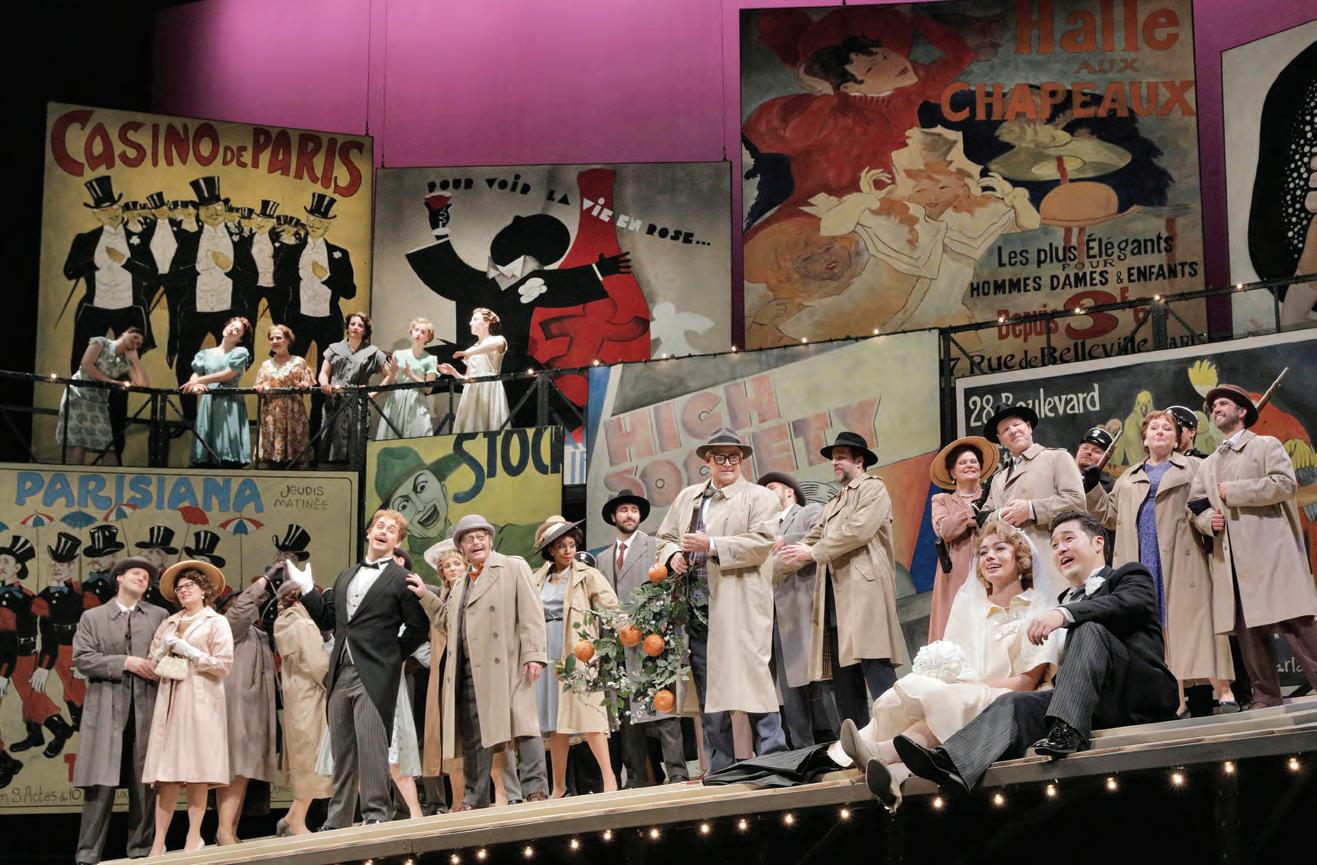
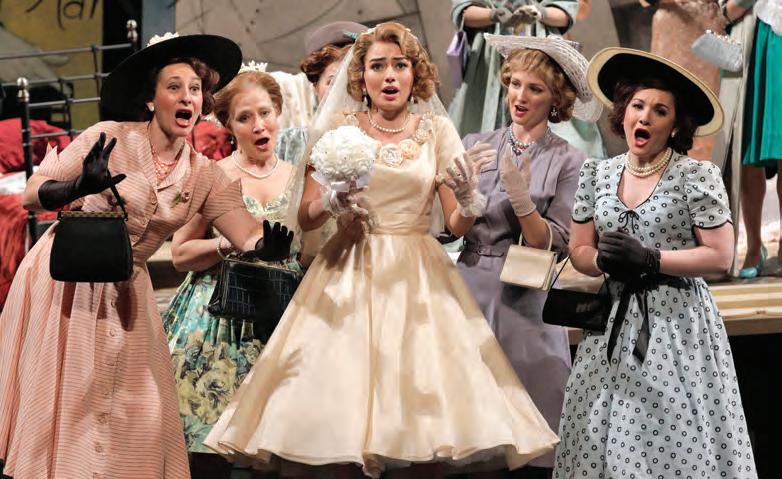
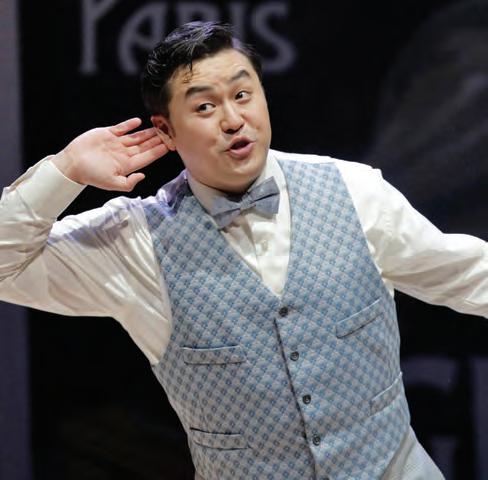
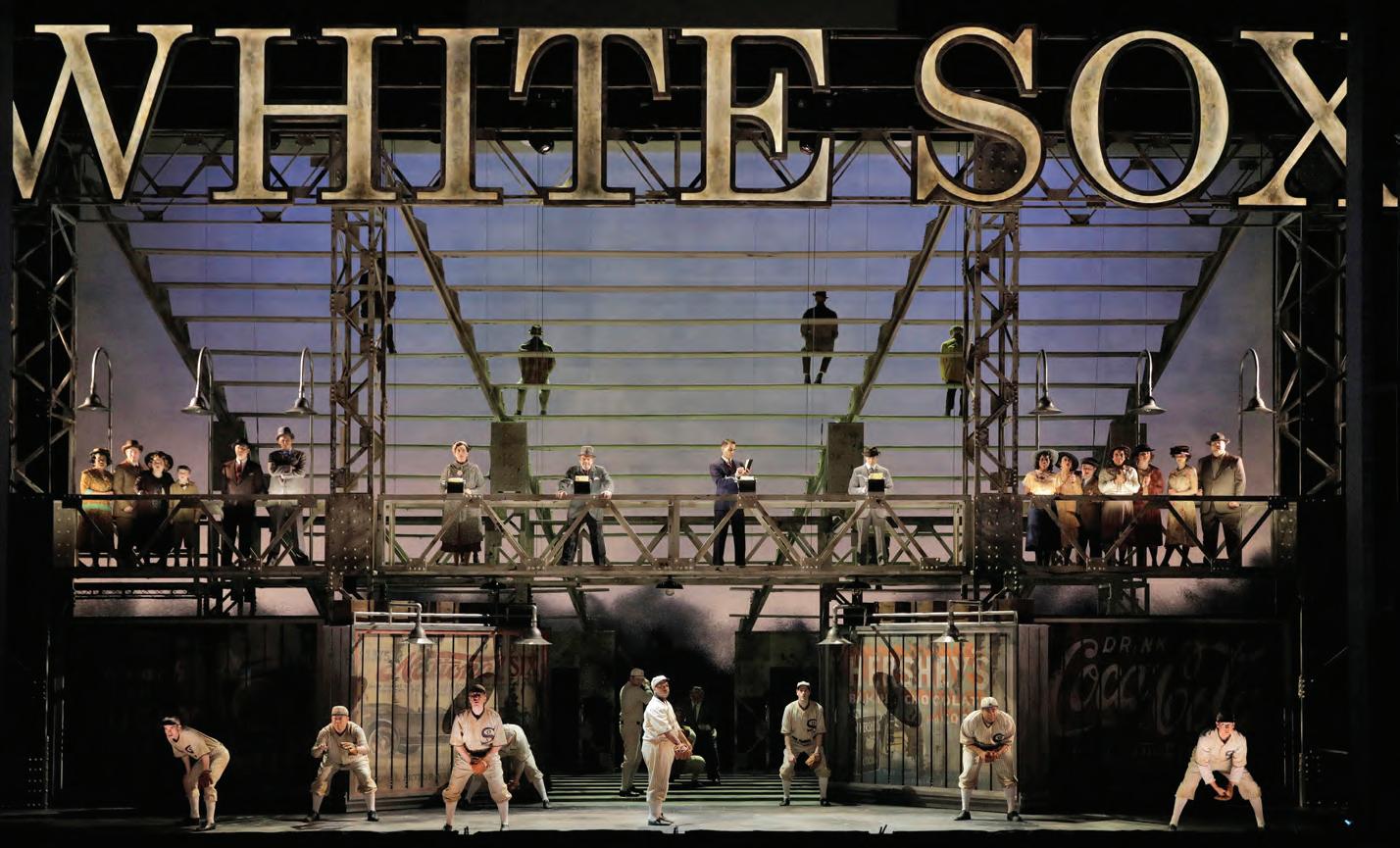
AN OPERA ABOUT baseball? How would that go? A slugger hits a four-bagger in the bottom of the ninth, then sings a dramatic aria as he races toward home plate.
Actually, the American composer William Schuman wrote a one-act opera, The Mighty Casey, based on the comic poem “Casey at the Bat,” that was premiered in Hartford, Connecticut, in 1953. And that was probably the first baseball opera. More recently, in 2017, the Pittsburgh Opera gave the first performances of The Summer King with a score by Daniel Sonenberg that tells the story of Josh Gibson, “the Black Babe Ruth,” as he was known. Gibson was only the second African American player to be inducted into the National Baseball Hall of Fame. As far as musicals, the best known is Damn Yankees, which racked up more than one thousand performances on Broadway starting in 1955 and was later turned into a film.
Minnesota Opera came up with the latest entry in this mini genre, The Fix, the first opera to deal with the Black Sox Scandal of 1919 and to focus on “Shoeless” Joe Jackson, the legendary slugger and outfielder whose banishment from baseball following a jury trial in 1921 is a decree worse than death. “Just let me play ball,” Jackson pleads to the team owner’s lawyer in one of the opera’s most powerful scenes. “It’s all I do. It’s all I know.”
The opera, unveiled at the Ordway March 16, 2019, in a deeply considered and detailed staging by Eric Simonson, who also wrote the libretto, to a score by Joel Puckett, recounts the fixing of the 1919 World Series by eight players of the Chicago White Sox who, having been promised payoffs by a group of crooked gamblers, hand the series to the Cincinnati Reds. Charged with nine counts of conspiracy to defraud, the players were acquitted following a jury trial
in 1921, but newly appointed baseball commissioner Judge Kenesaw “Mountain” Landis barred them for life from professional baseball. Ring Lardner, remembered today chiefly for his short stories—at that time a sports columnist for the Chicago Tribune —falls almost as hard as Joe does. Carried aloft by Puckett’s soaring lyricism, Lardner sings a rhapsodic aria in tribute to Jackson, saying Joe is “what we all dream to be: perfection, a god living on earth.” When he learns of the fix, Lardner falls apart. He becomes an alcoholic and never attends another baseball game, focusing his writing instead on boxing, where, he says, “They’re honest about being crooked.”
The story is told in brief, fast-moving scenes that flow easily in cinematic fashion, one into the next, from the ballpark to the hotel rooms where the deals are made to the speakeasies where the players and gamblers relax—Puckett has a sharp ear for period jazz—to the final scene where, thirteen years later, we see Joe, a broken man, running a liquor store in his home state, South Carolina. And here’s the opera’s only flaw. The final scene needs to be longer, more involving. We ought to see and hear more of Joe, more of his sadness and regret. He hasn’t fallen far enough to justify Lardner’s inflated lament at the end. Maybe Joe should have the final aria.
Displaying a bright, flexible tenor, Joshua Dennis portrayed Joe as gifted, vulnerable, and sincere. The strong
cast also included Jasmine Habersham—an elegant singer and a convincing actress—as Katie, Joe’s wife, and, in a fullblown portrait of a complicated character, Kelly Markgraf as Ring Lardner.
Walt Spangler’s ingenious shape-shifting set, a ballpark one minute, a raucous nightclub a minute later, was a treat to watch. The conductor Timothy Myers drew a dramatically paced, polished performance from the orchestra and the singers.
The Fix is a real opera about an unlikely subject, not just baseball. It concerns a privileged few—team owners and their lawyers—exploiting an underclass, the players, who, though decently paid, were treated back then like indentured servants. They either signed the contract offered them or they couldn’t play with any team.
Minnesota Opera—its staff, administration, and, for the most part, even its audience—ended the 2018–19 season in June of 2019, with a feeling of accomplishment and a sense of well-being. The company was solvent, the shows had been good, there was a lively season to look forward to, and they had just purchased the Lab Theater, which would give them a performance space in Minneapolis and preserve the theater as a resource for the community. Except that in just a few months, the company—and the world—would face the worst crisis in its history.


THE SEASON OPENED October 5 with a bold rethinking— or radical remodeling—of Richard Strauss’s Elektra, one of the greatest revenge dramas of all time. As told in the original play by Sophocles, Elektra’s father Agamemnon has been murdered by her mother Klytemnestra and her lover Aegisthus, and Elektra won’t be satisfied until they suffer the same fate. At the end, having exacted her bloody revenge, Elektra dances with joy as the orchestra explodes with driving rhythms—and drops dead. An opera, in the words of opera historian Robert Donnington, “not so much archetypal as pathological,” Elektra is a brilliant score riding on the back of one of the best of the old Greek tragedies. In good hands, it is immensely powerful.
What director Brian Staufenbiel and his design team did was to reframe the story. They created a scenario in which we encounter the German filmmaker Fritz Lang—presumably sometime in the 1920s—on the set of a silent-film adaptation of Sophocles’s play. At key moments a screen descends showing footage of the singers in Elektra: The Movie, scenes created by video designer David Murakami using digital tech-
nology. What happens is that the young woman portraying Elektra—that is, the film actress—gradually comes to identify with the character she is playing and becomes increasingly unhinged and tries to kill the woman playing Klytemnestra. Or did something else happen? The ending was vague, largely because the concept itself didn’t work. It might have made sense if the Sophocles play rather than the opera were being filmed, in which case the Fritz Lang character might have been given a certain amount of added dialogue. All he could do here was look frustrated and make big gestures; the German soprano Sabine Hogrefe, our Elektra, was similarly constrained. She had to sing what Strauss composed for her while speaking silently to those on the set, moving her mouth appropriately. Much of this was incoherent and lacking in focus. The story of Elektra gradually got swallowed up by Staufenbiel’s pantomime, if that’s what it was. The performances were intense and high-strung. Besides Hogrefe, there were Marcy Stonikas and Craig Irvin as Chrysothemis and Orest, and Jill Grove as Klytemnestra. Given the relatively small size of the Ordway pit, the orchestra led by Elias Grandy was placed onstage, thereby enhancing the aura of unreality to the production.
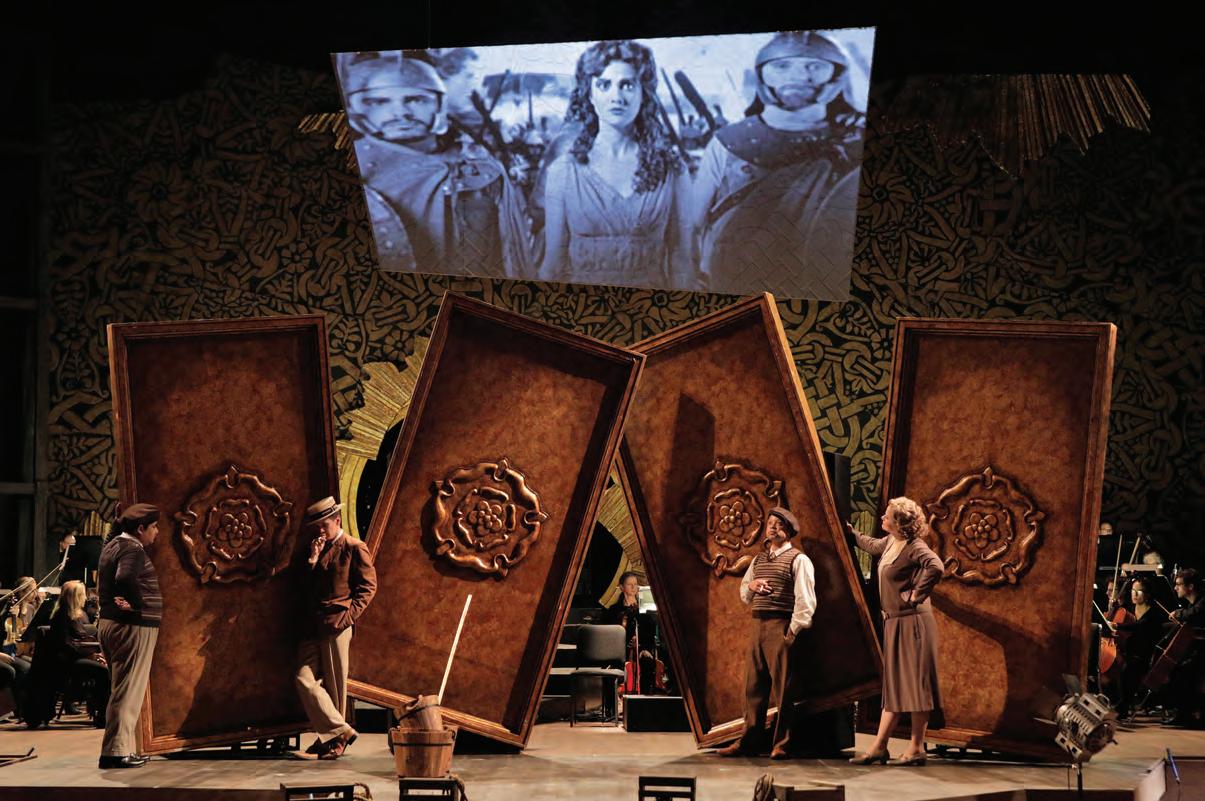
In 2019, Minnesota Opera bought the building next door to its home in the North Loop of Minneapolis, a building with a long and storied history then called the Lab Theater.
The Luminary Arts Center, a 6,000-square-foot stone box with a thirty-foot ceiling, was carved out of the foundation of one of the historic Itaska warehouses situated along the Mississippi River. Designed and developed for the Guthrie Theater as a laboratory for new works, the original Lab served as the Guthrie’s second stage until the completion of its new theater complex in 2006. Afterwards, under the guidance of executive producer Mary Kelley Leer, the Lab Theater became a busy and versatile stage for both emerging and established performing artists in theater, music, dance, cabaret, fashion, and even burlesque.
The purchase of the Luminary from the Leers—Mary and her husband Chuck, who had acquired the property in 2006—expanded Minnesota Opera’s North Loop campus and preserved the venue as a resource for use by performing artists in the Twin Cities. “The Luminary could be for Minnesota Opera what it was for the Guthrie, which is an incubation space and a place to try new operas,” said Mary Leer. “Minnesota Opera has got to reach out to new audiences . . . They’ve got to start building and trying new things to reach new audiences, and I think the Luminary will provide them with that kind of opportunity.”
The building, put up as a warehouse in 1886, was no more than a shell by the 1980s, when Chuck Leer was asked by a group of investors to figure out what to do with this broken-down warehouse. Mary Leer recalled, “Chuck said I needed to come over and see this hole in the ground that he had found. There were, literally, two lightbulbs hanging in the ceiling, and it was dank in there. We began having a conversation, and I said to Chuck, ‘Start backing away from me,' and as we backed apart from each other in this hundredfoot-long row, we could hear each other perfectly. And I said, ‘The acoustics in here are magical. This should be a theater.’”
Mary knew Garland Wright, the Guthrie’s new artistic director, was looking for a second stage, not so much for shows but as a laboratory for developing plays. “We brought Garland over one day in late spring,” said Chuck. “I’ll never forget the look in his eye. He loved it. The result was a kind of harmonic conversion between our vision of a theater and Garland’s aspirations for a second stage.” As it turned out, the Guthrie Lab did become a performance space. Its first presentation, the JoAnne Akalaitis staging of Genet’s The Screens, was a blockbuster. Jack Kroll of Newsweek saw it and proclaimed it the most important work in the American theater in twenty-five years. Among other memorable

shows was a production of Hamlet in military dress and a beautifully staged production of Tom Stoppard’s Arcadia.
The Lab, which Mary Leer ran from 2006 to 2021, was a rousing success. Among the most memorable shows during Mary’s era was a set of performances of Orff’s Carmina Burana by the Minnesota Dance Theater and the Minnesota Chorale with live video of the dancers and singers projected onto the back wall. The Lab also became the place to see the Moving Company, an inventive theatrical troupe.
In 1990, two years after the Lab opened, Minnesota Opera moved into its new home next door, a four-story building they named the Opera Center, at 620 N. First Street, for which Chuck was development consultant. For the opera company this was a major relief, as the company’s administrative offices were in downtown St. Paul and the costume shop and storage in Minneapolis, which meant the shows were rehearsed wherever possible. The Opera Center consolidated all these activities.
In 2019, Minnesota Opera bought the Lab for $1.8 million. To acknowledge the end of that era, and the passing of the baton to Minnesota Opera, the Leers on a certain warm night in May of 2021 threw a stupendous party at the Lab for an invited audience that included Minneapolis Mayor Jacob Frey and featured performances by many of the singers, dancers, and actors for whom the Lab had become a home.
Renovation, costing $6.1 million, began almost immediately in June of 2021 and would be, as defined by Julia Gallagher, Minnesota Opera’s Luminary Arts Center director, extensive. “But as we’ve designed it and as we’re looking at it,” Gallagher said in the autumn of 2021, “we aren’t building it to be an opera space but to be a flexible performance space, of which one of those types of performance is opera. This gives the company a different footprint than it has had in the past.”
Among the changes and additions: a reworking of the lobby, redoing of the dressing rooms and green room, new seating platforms and new seats, a new floor, and a freight lift at the back of the building that hadn’t been there before. Occupancy would be 350. Seating, depending on the configuration, would be 200 to 225 seats.
“The Luminary is such a different space than the Ordway, and it gives us opportunities in audience development and programming,” said Gallagher. “The sort of work that plays well at the Ordway isn’t the same that plays well at the Luminary. Smaller, more intimate works, more experimental—chamber operas—would work at the Luminary.” Construction was completed in June of 2022, and rentals began in September.


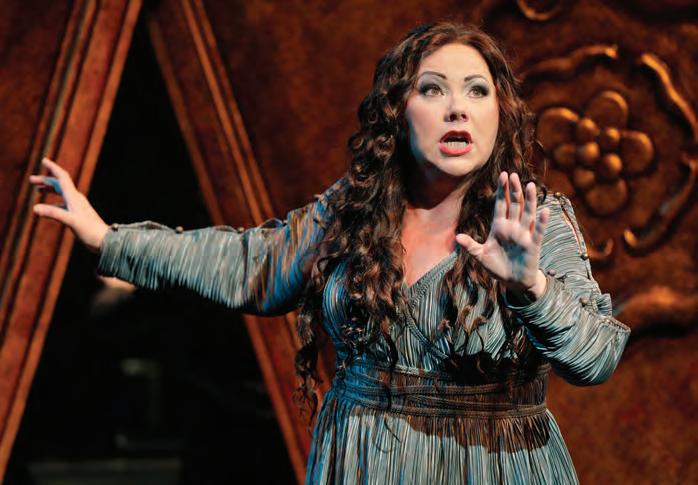
OFFERING MUCH-NEEDED relief from the gloom of a misbegotten Elektra, Francesca Zambello’s wacky, exuberant production of The Barber of Seville took over the Ordway stage for two weekends in November and made everyone laugh. The show had the feeling of commedia dell’arte: nimble trickery, fastmoving punch lines, and an improvisatory air that was full of surprises and an occasional pratfall. Rodion Pogossov, a Figaro with the swaggering confidence of a used-car salesman, began his famous self-identifying aria from the back of the theater, displaying a firm, flexible baritone and articulate command of Italian patter. Alek Shrader was a believably lovestruck Almaviva, and the accomplished mezzo Daniela Mack was a feisty Rosina. Conductor Joseph Mechavich captured Rossini’s jovial style with swift pacing and high spirits.
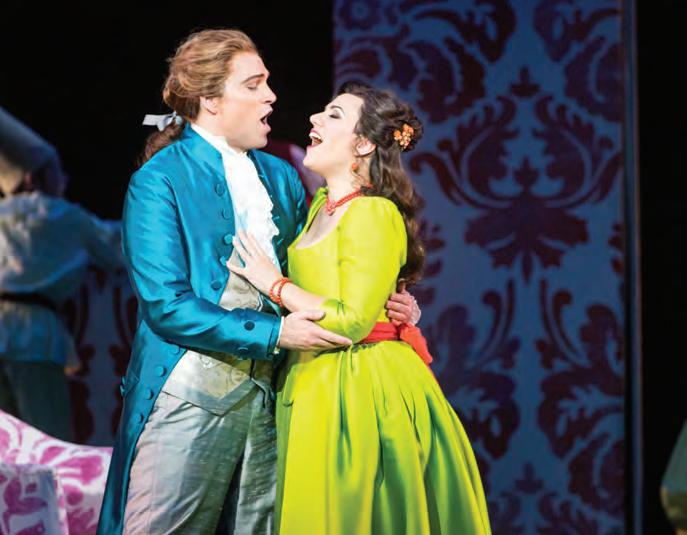
THE MANY PRODUCTIONS around the world of Flight, English composer Jonathan Dove’s first full-length opera, in the years since the work’s premiere at Glyndebourne in 1998, suggest that audiences identify to an extent with the plight of a roomful of desperate, lonely strangers stranded in an airport terminal during an electrical storm. Who among us, faced with a truckload of problems, hasn’t had an urge to chuck it all and fly away, leaving all that misery behind? That, in part, is what Flight is all about. For Bill and Tina, a middle-aged couple, flight is therapy, a vacation they hope will revive their stale marriage, especially their sex life. For Older Woman, as she is named, flight is the search for romance—and just about any young guy will do—whereas for Minskwoman, it’s the opposite: by refusing to board the plane bound for her new life in Minsk, she’s running away from her marriage. “I want to be free like I used to be,” she sings. “No ties.”
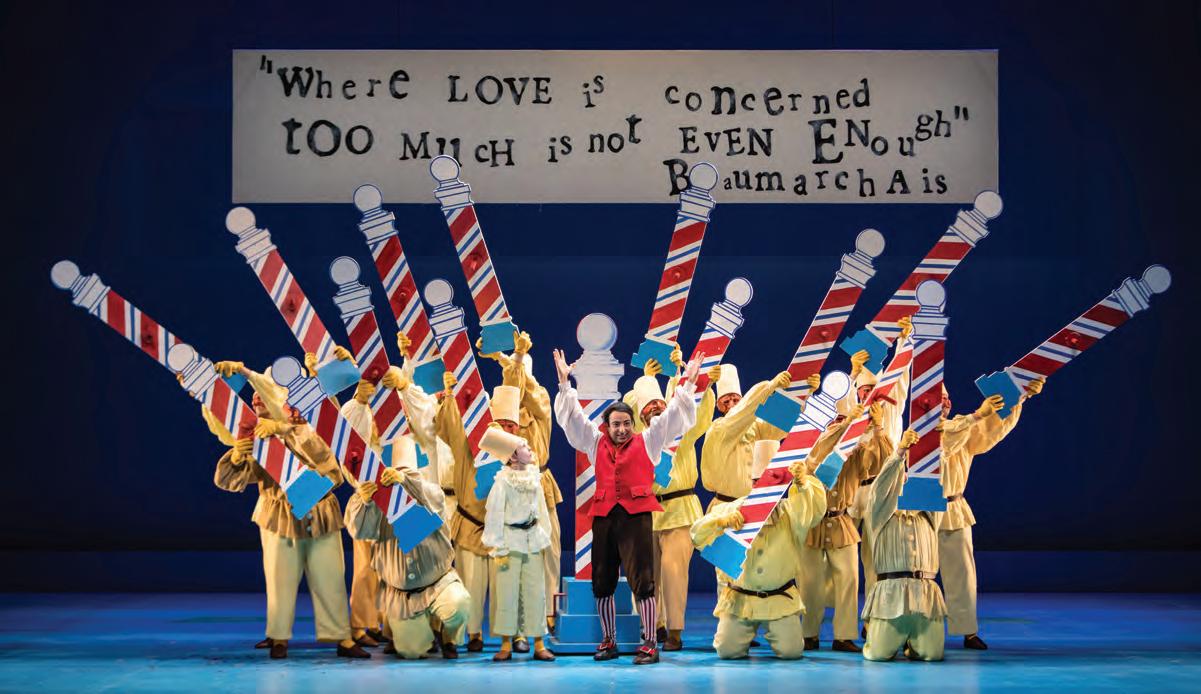
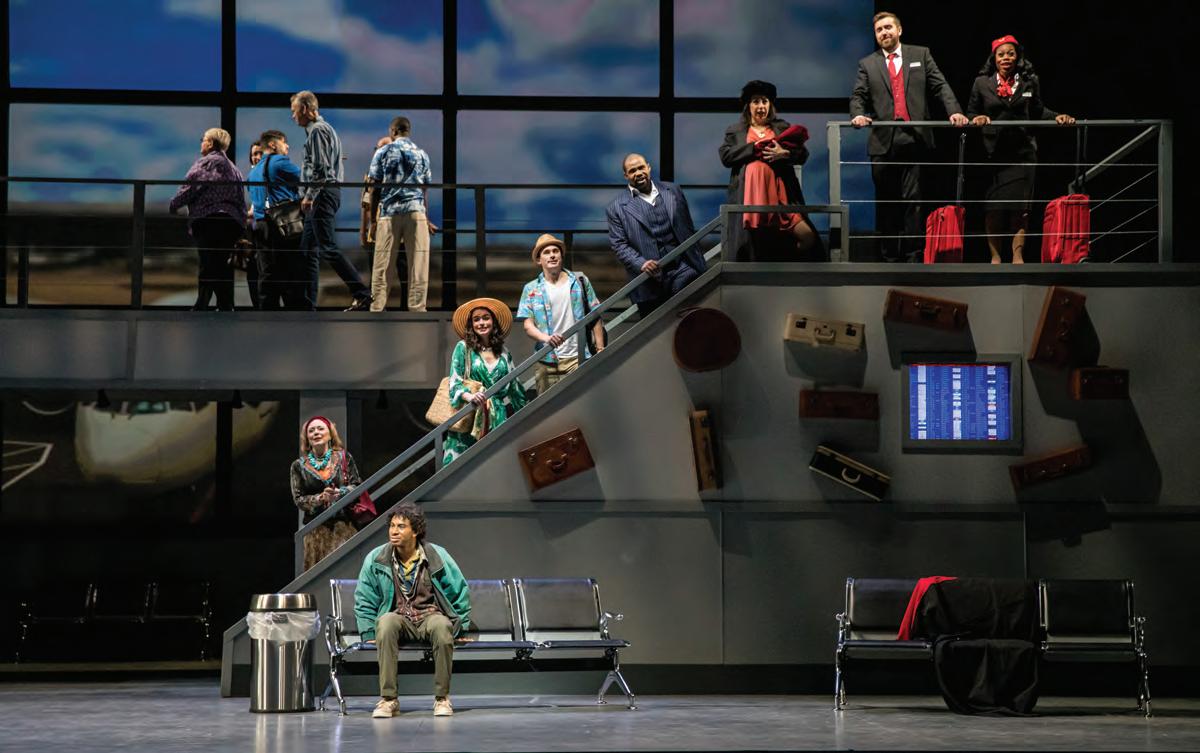
The characters are stereotypes, of course. We’ve run into them before. The opera’s libretto by April De Angelis paints this with a light stroke, though the persistent rhymes are strained at times. But they are funny, these characters— and that includes the randy and pansexual Steward and Stewardess—and much of that humor came across brightly in the production by Brian Staufenbiel that Minnesota Opera presented in five performances at the Ordway starting January 25, 2020.
The core of the story is not so funny, however. The main character, known simply as Refugee, has been living in the terminal for quite some time. Being without luggage or identification, he waits for his brother to arrive and bring him what he needs—or so he says. Meanwhile, he interacts with the travelers, begging for food and money, and most of the time they reject him.
The character, Dove has said, is based on the true story of Mehran Nasseri, an Iranian refugee who lived at the De Gaulle Airport in Paris for more than a decade and was finally released. (The Tom Hanks movie The Terminal was drawn from the same story.) The plight of the Refugee, played with winning sincerity and agile, expressive singing by the countertenor Cortez Mitchell, gives the opera a sense of unease that intensifies as the story reaches its sad and inevitable conclusion. Bought off by one of the travelers, the immigration officer allows the Refugee to remain in the airport but not to leave. Learning that his brother is dead, the refugee sings a bleak aria that is the opera’s emotional center. The muted ending—everyone except the Refugee catches their flight—is bold: believable but not very dramatic. But perhaps at a time when immigration is such a worrisome subject, this ending, offering no easy solutions, is the most realistic and believable.
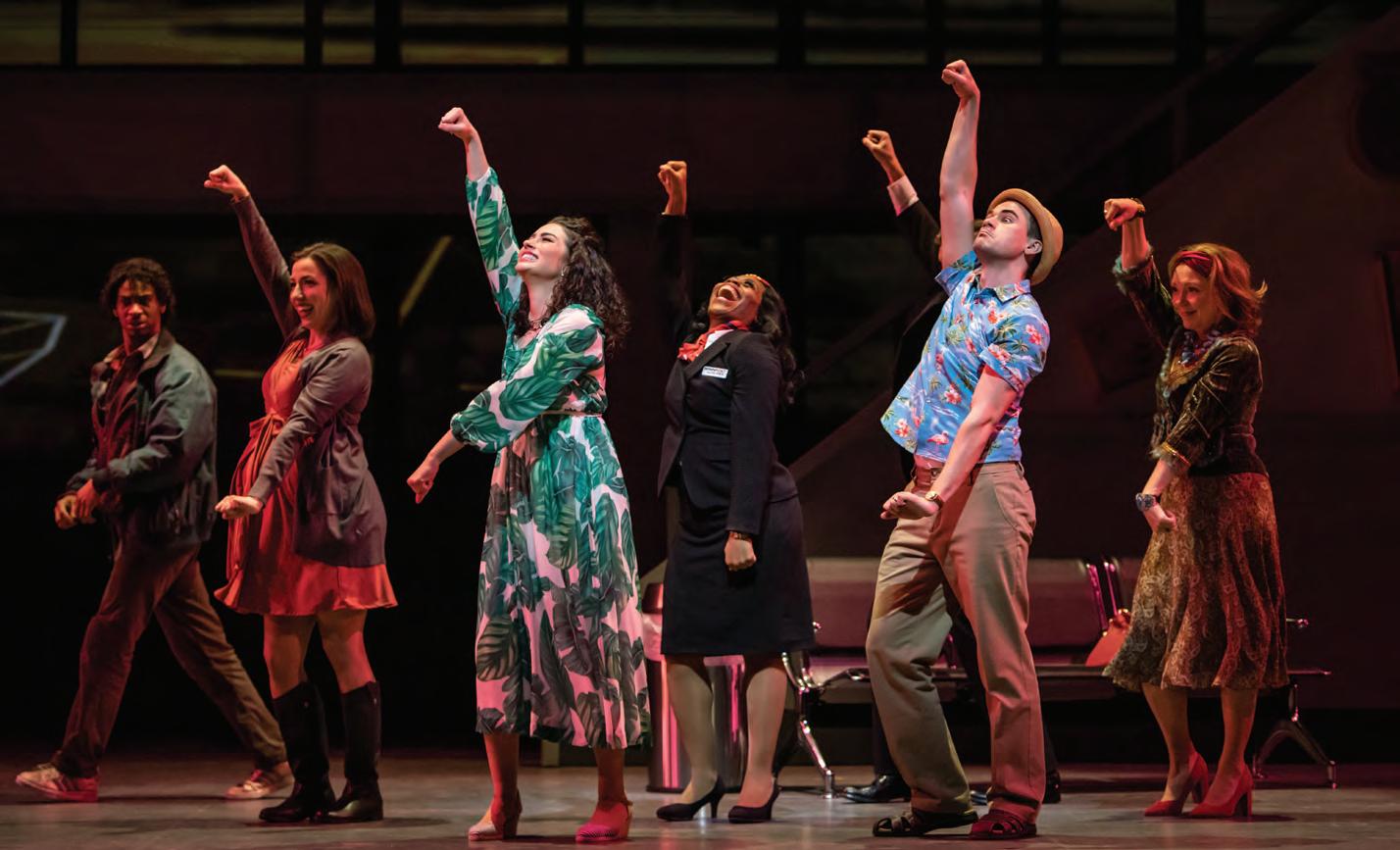

BY MARCH 1 OF 2020, people connected to Minnesota Opera had much to look forward to. In just a few weeks the company would present the premiere of a new opera, Edward Tulane, a work based on the bestselling book by Twin Cities author Kate DiCamillo with a score by Paola Prestini and libretto by Mark Campbell. Wrapping up the season in May would be a production of Don Giovanni featuring in the title role baritone Seth Carico, remembered for his charismatic portrayal of Joseph de Roger in Dead Man Walking in the 2017–18 season. On the horizon in the upcoming season were two works of considerable interest: Blue, a recent opera by composer Jeanine Tesori and librettist Tazewell Thompson about race in today’s urban America that was named Best Opera of 2020 by the Music Critics Association of North America; and also that season a reprise of The Shining, an operatic version of the Stephen King novel that Minnesota Opera premiered in 2015.
Then the world turned upside down, and it appeared that nothing would ever be the same. On Wednesday, March 11, 2020, the World Health Organization declared the virus COVID-19 a pandemic, and two days later, on Friday the thirteenth, the virus was pronounced a national emergency. That day, in an effort to slow the transmission of the infectious virus amid a growing awareness of its deadly reach, Minnesota Opera canceled the rest of its season. A statement released by the company that day and signed by company president Ryan Taylor said:
[The] decision was solidified under guidance from state officials to cancel or postpone all events involving 250 people or more. As we would care for members of our family at a time of crisis, we are diligently trying to care for not only our audiences but also our family of creators, ensuring that we are not putting the health of anyone at risk. While all of our artists, musicians, artisans, and staff were looking forward to sharing the joy and delight of the remaining two productions of our season with all of you, it is vital that we play our part in combating the spread of COVID-19 and encourage others to do the same. A situation of this magnitude is unprecedented for our organization and our community, and we are following the lead of our city, state, and federally elected officials in making this painful choice.
Dozens of people had already died of the disease in the United States. By Friday, fourteen cases of COVID were confirmed in Minnesota, with one patient in critical condition.
Friday morning, just hours before the cancellation was announced, the staff called all the board members informing them of the decision. Theresa Murray, vice president, administration and board relations, remembers first calling former board chair Jane Confer. “It was hard,” Theresa said. “She was very supportive and said it was the right thing to do and was disappointed, as we all were. But overall, the board members thought it was the right call and asked if there was anything they could do to help.”
Over the weekend, nearly all the major Twin Cities theaters and concert halls announced canceled performances for the next two or three weeks or for the remainder of the season: the Guthrie, the Children’s Theater Company, the Jungle, Chanhassen Dinner Theaters, History Theater, and the Cowles Center. By Monday, Walker Art Center, the Minneapolis Institute of Arts, the Weisman, the Science Museum, and the Minnesota Children’s Museum followed suit.
On Monday the sixteenth, Minnesota Opera’s leadership team met to decide whether to keep the Opera Center open. “We met in a rehearsal space rather than a conference room, so we could be at least six feet apart from each other,” Theresa said. “We decided to close the building, and we shut the doors that afternoon, not thinking it was going to be fifteen months before we stepped back into the building.” The staff didn’t return until July 12, 2021.
The company considered a plan to do at least one performance of Edward Tulane in an empty theater while streaming it live so audiences could watch it remotely. However, Taylor said so many people were involved in the production that it became a coronavirus concern in its own right. “We realized
that as we were to move forward in the enclosed theater space with just our artists and crew, then we are actually prioritizing the health and well-being of patrons and audience above that of our artists and crew,” he said. “And they should be equal.” The streaming proposal was dropped, and it was hoped that both Edward Tulane and Don Giovanni could be presented in an upcoming season.
To minimize the effects of the work stoppage, the company quickly established an Artist Support Fund for artists both on and off stage. Ticket holders for the two postponed productions and any ancillary events were given three options. They could request that the value of the ticket be reissued as a gift to the Artist Support Fund. They could request that the value of the ticket be placed on their MN Opera account to be used toward tickets in the 2020–21 season. A third option was to request a refund in the amount of the ticket.
By Friday, March 20, the staff was feeling understandably sad. Had it not been for a lethal virus that was bringing the entire world to a halt, the next night, Saturday, would have been festive. It would have been the opening night of Edward Tulane, a work about a toy rabbit that many on the staff had come to find especially appealing. Stickers in the form of rabbit footprints had appeared in stairwells in the Opera Center and on walls.
The thought was, wouldn’t it be nice not to be sad on what would have been the opening night? So all the staff members had a Zoom call by which they offered a toast to Edward Tulane. “We asked people to make it festive and bring whatever they wanted to drink,” said Ryan Taylor. “I held up the first stuffed animal I ever owned as a child. I still have it.”
DESPAIR SOMETIMES FUELS ingenuity. Within ten days of the cancellations, the company’s scenic and costume shops were putting their skills to work at home creating face masks in a partnership with HealthPartners in the Twin Cities. Ryan got the idea when he heard about Broadway artists, also out of work because of COVID-19 shutdowns, helping New York hospitals. He contacted Greg Weber, a gastroenterologist at Regions Hospital in Anoka and an opera patron, with an offer to help. Opera staff estimated they could create three hundred masks a day for the four large hospitals in the HealthPartners network, and eventually help coordinate the many volunteers offering to assist the hospitals. A process was set up to deliver materials and pick up the finished products.
On May 12, the company announced a digital opera series in partnership with Classical Minnesota Public Radio that would include radio broadcasts and on-demand audio streams. A new title would be released weekly through July 11. The series began May 14 with Wagner’s Das Rheingold. Two works that the company premiered in recent years were also included: The Shining on May 21 and The Fix on June 4. The remaining operas in the series were Massenet’s Thaïs and Mozart’s The Marriage of Figaro. Additionally, Douglas J. Cuomo’s Doubt was made available for video streaming through the partnership with PBS’s Great Performances.
The world was rocked again with the murder of George Floyd on May 25, which led to national and international protests of police brutality and racial injustice. The opera approved its new Diversity Charter, which had been in the works for over a year, on May 28. The charter outlined the organization’s commitment to antiracist and anti-oppressive values and built on equity, diversity, and inclusion work that had been occurring at the organization since 2016.
Since the summer of 2020, cultural institutions around the country have made changes as the Black Lives Matter demonstrations following the killing of George Floyd drew attention to racial inequities in virtually every corner of the arts world. Minnesota Opera had been formulating its Diversity Charter for quite some time. The board approved it on May 28, just three days after George Floyd was killed. “And now,” said Theresa Murray, vice president, administration and board relations, “a lot of other companies—opera companies and other nonprofits—have come to us, asking ‘How did you do it and was it a challenge to get the support of the board?’ For us, the board was behind it the whole way, which was terrific.”
This is the statement of intent from the Minnesota Opera Diversity Charter: Minnesota Opera’s vision and mission is to sing every story and to change lives by bringing together artists, audiences, and community, advancing the art for today and future generations.
We aim to inspire hope, empower all voices, and strengthen bonds between people of all backgrounds and identities. To this end, Minnesota Opera commits itself to continuously work to become an antiracist and anti-oppressive organization. We acknowledge that along our journey, our culture and the world around us are constantly evolving. We will inevitably make mistakes. We choose to accept that reality and will humbly begin again in order to lean into this practice.
The equity, diversity, and inclusion (EDI) effort goes back to 2016, the year Ryan Taylor became company president and general director. That year, Rocky Jones came aboard on the Opera’s communications team and later become the organization’s equity, diversity, and inclusion director. At that time the board was writing a new mission statement about bringing artists and community together, said Jones. “The board had the forethought to realize that unless we get younger people, people of color, and just a wider swath of the community into our spaces to enjoy our programming, both the education programs and the mainstage productions, we wouldn’t be living up to that mission.”
The first step was the creation of a task force of staff and board members who would come up with recommendations based on what other companies had done to diversify their audiences, staff, and artists. What they found was that a number of dance companies and theater ensembles were engaged in that pursuit but very few opera companies had attempted it.
A staff Diversity Council was created that would, every year, revise the company’s Diversity Charter. It then set goals and benchmarks for the following year. Julia Gallagher, Luminary Arts Center director, chaired the Diversity Council for its first two years, and Jones took over that position in 2019. “What we want to do,” he said, “is create spaces of
authentic belonging for people who want to come in, enjoy our programming, and feel that they can be themselves, that we are opening our doors and making these inclusive spaces for our entire community. If we’re going to call ourselves Minnesota Opera, then we have a responsibility to represent all Minnesotans.”
Even so, of all the performing arts, opera is probably the one most resistant to change. Its audiences and donors skew disproportionately older, whiter, and wealthier. Though Minnesota Opera has a history of presenting and commissioning new works, its audience typically favors the old chestnuts performed as they always have been performed.
Jones remains optimistic about change. “You hear a lot of traditionalists say this is what opera has to be, these museum pieces that are behind glass. I don’t believe that,” he said. “I believe we can expand the art form to create a new kind of opera. We have this incredible moment right now, especially here in Minnesota, where we’re living at the epicenter of a global movement for racial justice. Besides, opera is not going to survive if we keep doing the same things the same way.”
It was this focus on diversity and inclusion that drew Lani Willis back to Minnesota Opera. Willis was marketing and communications director when she left in 2014, having started in 1998. She returned in February of 2021 as vice president, advancement. “We’re looking at how we can do this work in an antiracist, anti-oppressive manner,” she said.
“That is now the daily conversation at Minnesota Opera. The conversation is, ‘Let’s sing every story.’ This is our vision statement. But what does that mean? How do you make authentic, reciprocal relationships with communities that have been historically excluded from the art form? How do you create new expressions of opera that don’t reject where we’ve been and its origins in Renaissance Italy? How do you expand that tradition so that it reflects the stories, the experiences, the creative ideas, the artistry of people who aren’t white?”
Some answers might be found among the facets of Minnesota Opera’s new EDI initiatives. One is a podcast called The Score that presents new shows every other Monday and is available on the company’s website. The format is a conversation about opera and classical music seen through an antiracist, anti-oppressive lens. Rocky Jones and two others on the staff act as hosts: Lee Bynum, vice president, impact, and Paige Reynolds, former civic engagement manager. The idea is to amplify the voices of those in the field who are pushing the boundaries of what opera is, who it is for, and how it can transform communities.
Among recent developments in this area is the elimination of fees for the company’s education. Fees for digital operas were pay-what-you-want. “We’re trying to incorporate the idea of inclusive marketing,” Jones said. This means creating programming that will attract younger people, people of color, or LGBTQ+ people as well as making the company’s venues more physically available spaces. “It seems obvious to me that as we continue into the twenty-first century, this is a new movement,” Jones said, “and we’ve got to get onboard with it or else we’re going to be left in the dust.”
DURING ALL THE MAJOR headlines of 2020, some positive developments were underway at the Opera. Foremost among these was the appointment of Nadege Souvenir, senior vice president of operations and learning at the St. Paul and Minnesota Foundation, as Minnesota Opera’s first person of color and first woman of color to lead the Board of Directors. Souvenir’s first involvement with the organization was with the young professionals’ group, Tempo, subsequently joining the Board of Directors, including serving on the search committee that hired Ryan Taylor.
On July 29, with no end in sight to restrictions imposed to combat the coronavirus, Minnesota Opera announced a revamping of the entire 2020–21 season, which meant canceling the five operas that had been planned: Mozart’s The Abduction from the Seraglio, Tchaikovsky’s Eugene Onegin, Rossini’s Cinderella, a revival of The Shining, and a production of Blue, the opera by composer Jeanine Tesori and librettist Tazewell Thompson that had been premiered at the Glimmerglass Festival in 2019.
In place of all this, the company split 2020–21 into two halves, a 2020 fall season and a 2021 spring season. For the season-opener, the company did something unusual: two evenings of Opera in the Outfield on September 24 and 26 at CHS Field in St. Paul, a program mixing live performance with digital images on the field’s giant video screen, among them some of the classic Warner Bros. cartoons that concern opera. Following this, in October, the company made
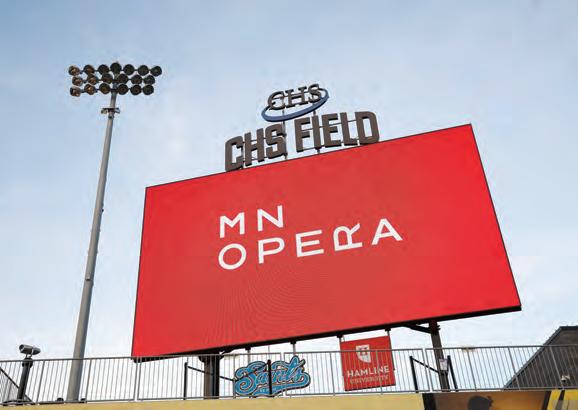
available for streaming its widely praised 2011 production of Wuthering Heights by Bernard Herrmann.
The second stream, available November 14–28, was the 2016 production of Das Rheingold recast in both 3D and virtual formats in addition to the conventional 2D version. Tickets included a pair of 3D glasses shipped to homes in Minnesota, Iowa, Wisconsin, North Dakota, and South Dakota. Two other past productions were broadcast on Classical Minnesota Public Radio: Dominick Argento’s Casanova’s Homecoming and Kevin Puts’s Silent Night
Concerning the financial situation, the company slashed $4 million from its $12.7 million budget for the 2020–21 season, in response to a projected drop of 33 percent in anticipated revenues. As for staff, 11 percent of full-time employees were laid off or had their hours reduced; all salaries were cut up to 15 percent starting July 1, 2020. Contract and part-time employees were hit harder; 61 percent of their work hours were cut.
Company president Ryan Taylor described the revamped season as an innovative approach that he hoped would bring “inspiration, income, healing, and security” at a time of national crisis. “We believe it provides a new path forward for our organization, as we look forward to returning to the Ordway in the spring.”
In a separate development, former artistic director and, for the past two years, creative adviser Dale Johnson announced that he would retire July 1 after more than thirty-five years with the company. At the end of August, the company announced the appointment of Lee Bynum to the newly

created position of vice president, impact. Bynum had been senior program associate and associate director of the Mellon Mays Undergraduate Fellowship Program at the Andrew W. Mellon Foundation. With Minnesota Opera he would oversee the company’s learning and training programs along with its equity, diversity, and inclusion efforts.
In December the company announced its 2021 spring season, which included a number of free digital programs, both new works and old. The first offering, MNiatures, scheduled for February, comprised four short ten-minute operas by four pairs of Minnesota artists. Later that month, February 27, the company presented a “virtual benefit,” the program of which included a newly commissioned operatic work, Art Is a Verb, performed by soprano Karen Slack, tenor Andres Acosta, baritone Sidney Outlaw, and baritone Andrew Wilkowske. Premiering in May was a new production of Benjamin Britten’s comic opera Albert Herring, the tale of an innocent young villager who breaks free from the conventions of small-town life. Minnesota Opera first presented Albert Herring in the spring of 1964 in a widely praised production at the Guthrie Theater.
Priti Gandhi announced her departure from the organization near the end of the season to move on to the role of artistic director at Portland Opera. Her tenure was characterized by a continued focus on diversity in casting and bringing new performers to Minnesota Opera; thoughtful explorations of how Minnesota Opera performs the inherited, traditional repertoire; and leading conversations around equity, diversity, and inclusion in opera.
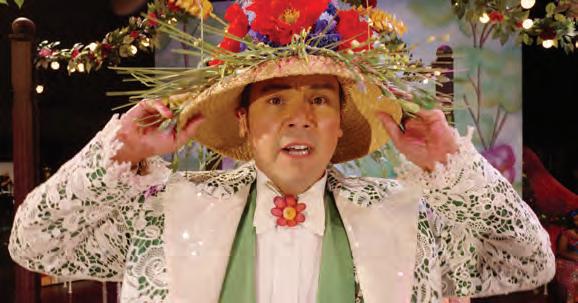
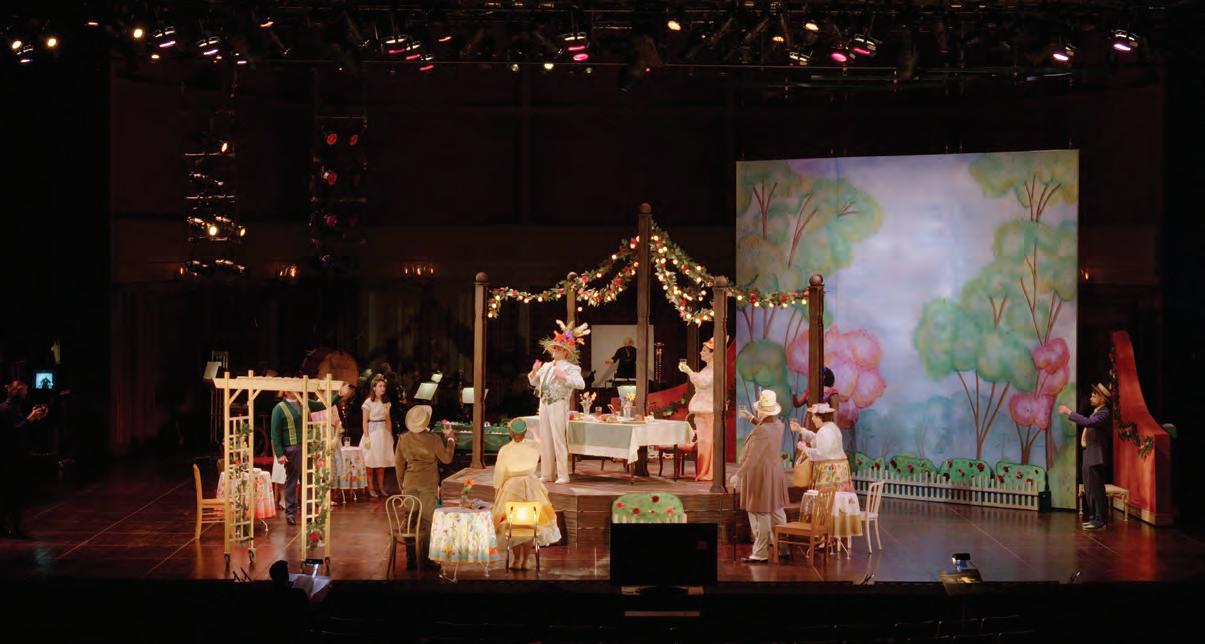
THE 2021–22 SEASON opened with a bang and two or three hot dogs September 22 at Allianz Field, the soccer stadium in St. Paul. The program, Ópera Afuera (Opera Outdoors), celebrated the music of the Spanish-speaking world through song, opera, and instrumental music. Miguel Harth-Bedoya conducted the Minnesota Opera orchestra in an elaborate production staged with flair and imagination by David Radamés Toro and featuring soloists Andres Acosta, Vanessa Alonzo, Vanessa Becerra, Levi Hernandez, and Zoie Reams. Starting with Spanish Zarzuelas and mariachi music from Mexico, the concert moved on to excerpts from nineteenth-century European repertoire (Rigoletto and Carmen) and concluded with samples of Latinx contributions to opera, among them works by Astor Piazzolla.
The season continued with three digital offerings in the fall. The first was the broadcast debut of Interstate, a new opera based on the life of serial killer Aileen Wuornos with music by Kamala Sankaram and a libretto by Jennifer Cresswell and Kathleen Kelly. The piece tells the story of Olivia, a prostitute in prison for murder, and Diane, her childhood friend. The second offering, released in October, was MNiatures, the company’s second round of short ten-minute operas. The third offering, released in December, was a sneak peek of the company’s COVID-delayed world premiere of Edward Tulane: the Edward Tulane Chorale Suite. The suite was combined with stop-motion animation to create a novel cinematic storytelling experience.
Joseph Li joined Minnesota Opera’s leadership team in November as vice president, artistic. Arriving from Baylor University School of Music and Wolf Trap Opera, Li joined

Lee Bynum (vice president, impact), Karen Quisenberry (vice president, production), and Ryan Taylor (president and general director) to form the company’s new artistic team, which was charged with planning and executing the annual performance seasons in accordance with the company’s standard of musical and dramatic quality as well as its Diversity Charter.
In December 2021, Ryan Taylor was named runner-up for 2021’s Artist of the Year by the Star Tribune. This was a signal that the digital initiatives produced during the pandemic resonated with the community. The Star Tribune said that under Taylor’s leadership the organization “came up with one imaginative idea after another for reshaping not only how opera can be presented amid a pandemic, but how it can address life experiences outside the purview of the dead European white men who dominate opera.” The paper went on to praise how the organization continued to challenge the status quo, saying that “Opera is righter for his efforts, and so are we.”
The revamped 2021–22 Ordway season comprised two productions. The first, presented in February 2022, was The Anonymous Lover, a comic romance by Joseph Bologne, Chevalier de Saint-George, a Black composer who was a contemporary of Mozart’s. The other, in May, was a new production of Bizet’s Carmen to be staged by Denyce Graves, who sang the role of Carmen in a fondly remembered production by this company in 1991.
THE ANONYMOUS LOVER was the second work by a Black composer to be presented by Minnesota Opera. The first, Diary of an African American by the jazz trumpeter Hannibal Peterson (now Hannibal Lokumbe), received its American premiere at the Fitzgerald Theater during the 1993–94 season.
Bologne was a creole violin virtuoso, composer, and conductor who forged a substantial career in Paris. Some of his instrumental works have been revived in recent years, but his operas have been neglected. Apparently, The Anonymous Lover is the only one for which there is a complete score. Premiered in Paris in 1780, the opera spins the romantic tale of Leontine, a beautiful young widow, doubtful she will ever find love again, who begins to get anonymous letters from a secret admirer, a shy young man who must work up the courage to confess his role as the sender.
No one would call The Anonymous Lover a major work for the lyric stage, but the story and the music came across well at the Ordway, though this is really a chamber opera that would have felt more at home in a smaller theater. Director Maria Todaro’s bright, lively staging underscored the opera’s frivolity. Steven Morvaski’s set—awash in pink and red—was
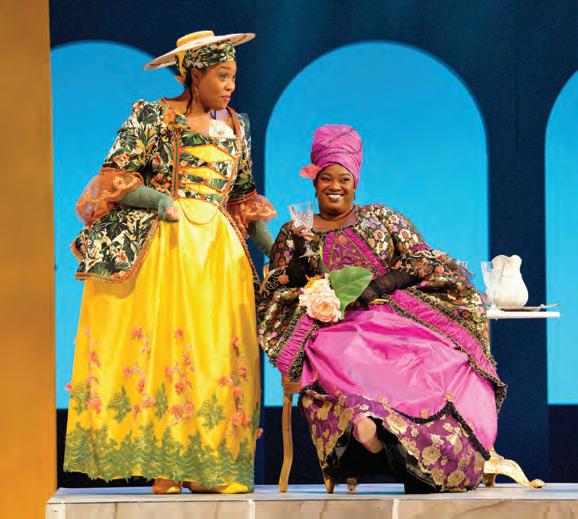
a valentine to and an apt setting for Ari Fulton’s imaginative costumes. Symone Harcum, a resident artist with this company, was an appealing Leontine with a lovely voice, and the accomplished tenor Carlos Santelli made an amusingly fretful Valcour—our anonymous lover. Christopher Franklin drew a fine performance from the orchestra and paced the show sensibly.
This was the company’s first production with a live audience in two years. The attendance, at about 60 percent of capacity for a four-performance run, was respectable. Some, no doubt, were nervous about sitting in a big theater with a lot of people, especially after the Omicron surge. Masks and verification of vaccination were required.
Immediately preceding the launch of the 2022–23 season in late February 2021, the Opera announced the new name of the venue located next door to the Minnesota Opera Center: the Luminary Arts Center, previously known as the Lab Theater. The Opera also announced its intention to present work at both the Ordway Center for the Performing Arts and at the Luminary in the future. President and general director Ryan Taylor said, “The new name for the venue speaks to the space’s role in revealing, discovering, and illuminating the work and ideas of artists in our community.”
The announcement shared the intention for the space to reopen to the public in September 2022 after a major
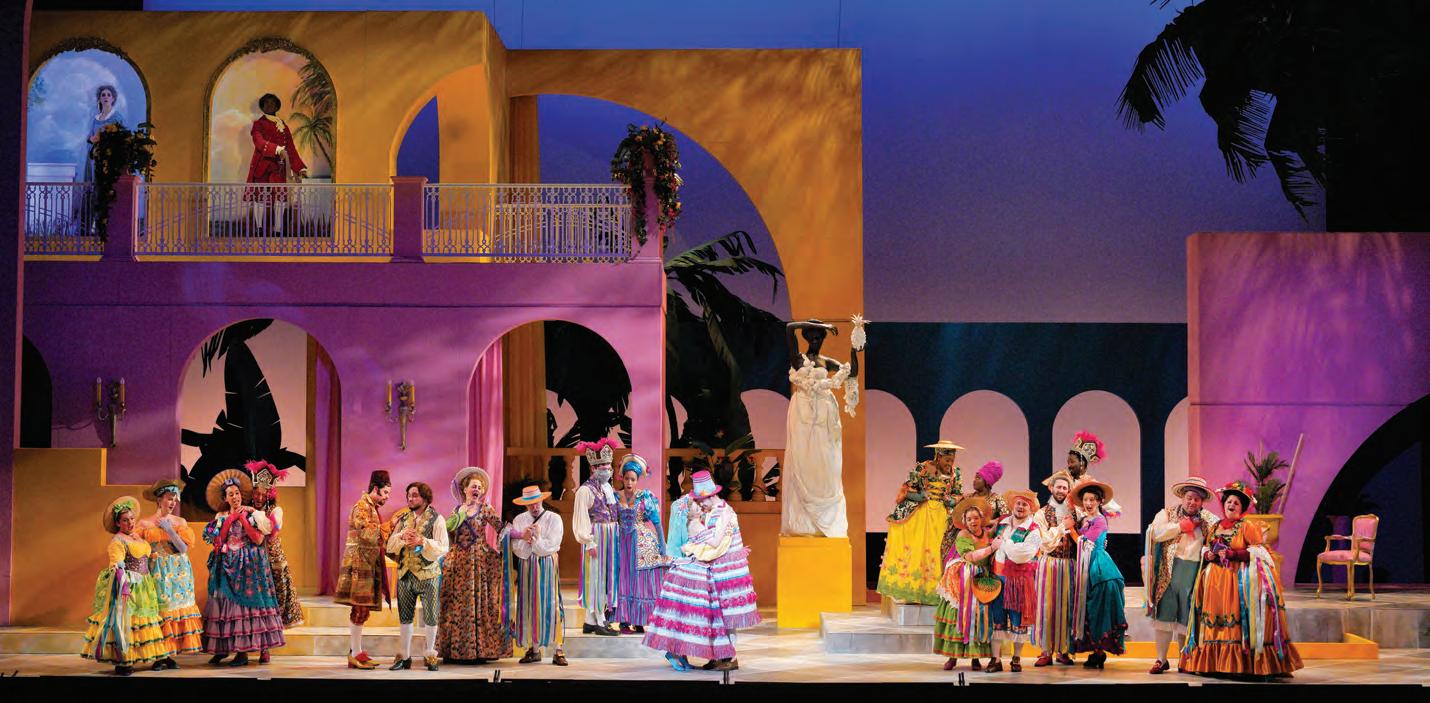
$6 million renovation led by Shelter Architecture that began in July 2021. The renovation includes enhancements to frontof-house facilities, structural and mechanical improvements, and improvements to the new 224-seat theater and its support spaces.
Carmen was the fourth-highest-grossing production in the company’s history. In a sense, Denyce Graves, making her directorial debut, was the star of the show. At least it felt that way on opening night, May 7. Company president Ryan Taylor introduced her in the audience before the curtain went up. When she stood, the audience gave her an ovation. By now it was common knowledge that her charismatic portrayal of the torrid woman from Seville in the Keith Warner production at the Ordway made her a star. Even though this had been her first Carmen, she quickly became the Carmen of choice for major opera companies in the United States and Europe, including the Met.
The production Graves presided over here, a collaboration with scenic designer Riccardo Hernandez, with its strong cast, suggested she has the instincts—and the eye—to be a superior
director. She certainly bought ideas to the stage and a point of view. Interestingly, the compelling performance in the title role on opening night, by Maya Lahyani, was quite different from Graves’s own characterization. Clearly, here is a director who lets her singers explore their own artistic impulses.
Graves’s Carmen was sensual, glamorous, and domineering. Lahyani’s was antiglamour. She’s punk, a Riot Grrrl, in contemporary usage. She’s dangerous. She comes from a society in decay, as Hernandez’s vividly decrepit set makes clear. She stalks the shy, obviously troubled Don José, all this conveyed convincingly by tenor Won Whi Choy. Don José sees Carmen as the Devil, which perhaps makes Micaëla the Virgin Mary. Torn between lust and his religious indoctrination, he eventually explodes. The death scene at the end, where Don José carries a Bible in one hand, is frightening.
The silvery-voiced Symone Harcum made a more interesting Micaëla than we usually see. Baritone Aaron Keeney was another departure from the norm. His preening Escamillo was polished and suave rather than brutish, and his singing was firm and resonant.

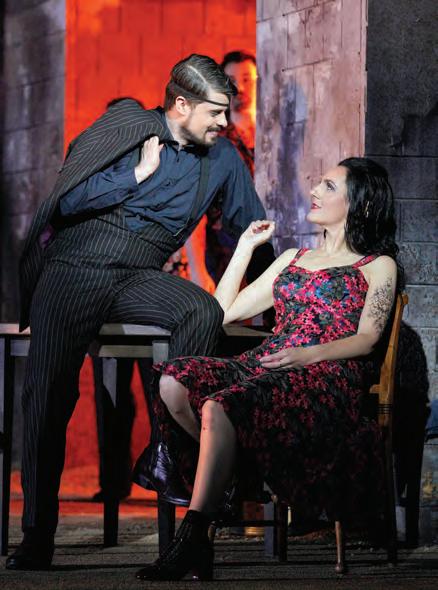
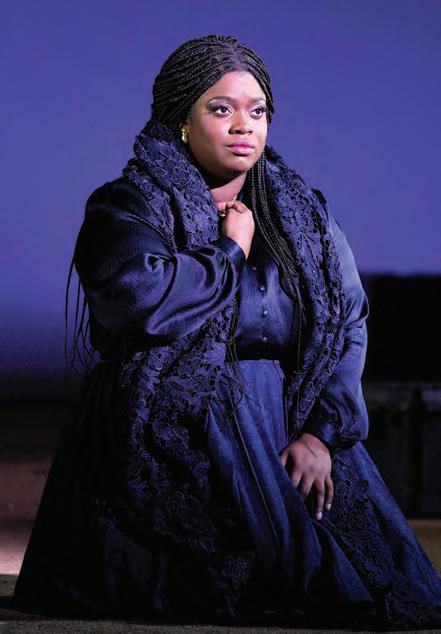


IF WE ASSESS reactions to the pandemic some eighteen months after its effects began, Minnesota Opera, though hit hard, seemed less devastated by the coronavirus than some of the other organizations. The Star Tribune reported that the Ordway, for example, was laying off 90 percent of its staff.
“We didn’t toot our horn about it very much,” said former board chair Bernt von Ohlen. “But there was some special fundraising done, the board was very generous, and we created an artist fund, because most of these people work contract by contract, including the singers, so they don’t have a steady source of income. And they had given up other opportunities in order to be here. People were concerned because nobody knew how long this was going to last and how big a problem it was going to be. So we made an effort, and we paid them a substantial amount, a substantial percentage of what they would have received had they completed the task.”
“This was a moment where I think we did really well,” said Eric Broker, director of marketing and communications.
For one thing, Ryan was the perfect leader for this pandemic. He is probably struggling internally, like all leaders are, but he doesn’t show it. We were in the beginning stages of a major endowment campaign when the pandemic hit, and we had just received a large gift from a donor, and so we didn’t have to lay off as many people as other organizations our size did. In contrast, we minimized our workforce by 11 percent. Some of that was Dale Johnson retiring and others leaving the organization and their roles not being replaced. It could have been a lot worse.
Broker made the point that Minnesota Opera, bold as it has been in the creation of digital presentations during
the COVID-19 crisis, has been relatively cautious—conservative might be the word—in putting on in-person events. In March 2020, most of the large arts organizations—the Guthrie Theater, the two orchestras—canceled just two or three weeks of performances, thinking the pandemic would soon be over, whereas Minnesota Opera canceled the rest of its season. And that summer, when other organizations announced seasons that would start in the autumn of 2020, and then later had to modify that, Minnesota Opera put on one outdoor event at Allianz Field in September along with streamed events followed by an in-person season that didn’t start until February of 2022.
WHAT’S AN APPROPRIATE sixtieth birthday gift for an opera company? The best gift would probably be a new building or a new theater or a new alternate space. Minnesota Opera got all three on August 20, 2022, the day the company officially opened its Luminary Arts Center (formerly the Lab Theater and before that the Guthrie Theater’s second stage). The first local arts organization to use the space was the Ten Thousand Things Theater, for its production of Euripides’s Iphigenia at Aulis in a modern staging by Marcela Lorca and music by JD Steele.
The Luminary Arts Center brought Minnesota Opera’s North Loop campus to a total of 62,500 square feet. The facility currently serves as a home for certain Minnesota Opera productions and as a rental space for other theater and musical organizations and troupes. Among the organizations that booked the facility for the 2022–23 season were Schubert Club, the Interact Center for the Performing Arts, Cantus, Minnesota Chorale, the Danger Committee, and the Minnesota Dance Theater.
Two of Minnesota Opera’s productions in the 2022–23 season were planned for the facility: Rinaldo in November and The Song Poet in March. The remaining three would be presented at the Ordway.
FEW RABBITS can carry a tune, let alone sing opera.
Despite that, to open its sixtieth season, Minnesota Opera put a stuffed rabbit onto the Ordway stage. He sang quite well, so the audience applauded lustily. The rabbit was none other than Edward Tulane, which is also the name of the opera that received its premiere on October 8. The opera, a creation of considerable charm, is the work of composer Paola Prestini and librettist Mark Campbell. Based on a popular children’s novel by the Minneapolis writer Kate DiCamillo, Edward Tulane tells of the adventures and misfortunes of a toy rabbit who must find his way back home. In the process, he changes from being indifferent toward others to feeling friendship and love. The opera was to have premiered in March of 2020 but, because of COVID, was cancelled two days before the scheduled opening night.
There is so much wit in Campbell’s text—Edward sounds at times like Noel Coward—and such variety in Prestini’s appealing score, all of this decked out in the imaginative and colorful staging by Eric Simonson and his team, that we willingly hop aboard the ride. Before long, we develop an affection for Edward, who was portrayed with sweet gusto and sung with impressive fervor by lyric tenor Jack Swanson, a Minnesota native and a 2018 Richard Tucker Career Grant winner, in his company debut.
Edward’s journey is long and treacherous. When, having been separated from his family, he suffers a confounding series of humiliations—being bitten by a dog in a junkyard, pecked at by crows in a cornfield, and outfitted by a fisherman’s wife in a shabby dress—he laments his “poor, useless, miserable, paltry, trifling little life,” then turns to the audience and says, “End of story. You can go home.” But there's more. In the eerie penultimate scene, Edward joins a group of dolls for sale in a toy shop, all of them desperately singing “Choose me! Choose me!,” reminding us that this is anything but a lighthearted show.
Prestini writes skillfully for choral voices, whether it be Christmas carols in a Victorian style or wordless choruses in two scenes in the first act. A big choral number, “One Bright Star,” acts as the first-act finale. The writing for orchestra is inventive. Recurring passages for high woodwinds, especially flutes, give a tone of unease and sadness to many of the scenes.
Visually, the production, with its many quick scene

changes, offered one surprise after another—the phosphorescent sea creatures in the underwater scene, for one.
Walt Spangler designed the sets, Victoria (Vita) Tzykun the eye-filling costumes, and Marcus Doshi the lighting. The large cast couldn’t be faulted. The young Russian-born conductor Lidiya Yankovskaya paced the production sensitively and drew polished playing from the orchestra.
AS FOR THE REST, the company offered an adventurous season that included, in November, a rare dip into the Baroque: Handel’s Rinaldo, a musical fantasy not seen here since 1984 when the Metropolitan Opera presented the work at Northrop Auditorium with Marilyn Horne singing the title role. This was the second Handel opera the company has offered, the first being Julius Caesar during the 1993–94 season. The fact that all seven shows were sold out suggests a craving among the locals for Handel operas and perhaps the entire genre of
highly stylized opera seria that dominated European opera houses in the eighteenth century. Others may have simply been curious to see the company’s new performance facility, the Luminary Arts Center, which opened its doors in August.
This particular Rinaldo was updated and radically revised by Mo Zhou, the Chinese-born director who recently joined the faculty of the School of Music, Theater and Dance at the University of Michigan. Zhou says in a program note that she and the conductor of the production, Emily Senturia, were bothered by “the biased and problematic portrayals of Muslims, which we find unacceptable.”
To that end, they edited out “antiquated and offensive” expressions from the original text and transformed the story into a fantasized corporate world in the mid-1980s. In this version, two groups vie for control of the stock market— Rinaldo’s clan, which includes his girlfriend, Almirena, who are “old money,” versus Argante and his lover Armida, normally



the villain of the piece, who here are nouveau riche of an especially vulgar sort and who inexplicably possess magical powers that apparently aren’t magical enough to get them a seat on the stock exchange.
Zhou and Senturia made ample cuts from the original and dropped a few minor characters but basically left the text alone. As a result, our hero Rinaldo walks around in stylish leisure wear saying things like “I burn, I flare, and I tremble with rage and fury.” Clearly, the concept doesn’t fit the work itself. The libretto needs to be rewritten or another opera chosen. And then there was that strange ending. In the original story of eleventh-century Crusaders capturing Jerusalem from the Saracens, Christianity triumphs. In this production, which could be called the Ayn Rand version, greed triumphs. The merger goes through, and money in the form of cash shoots into the air like a fountain.
Despite all this, Zhou had a strong cast to work with. Using his warm, varied tone with consistent imagination, along with crystal-clear articulation in the rapid-fire passages, countertenor Patrick Terry portrayed an amusing Rinaldo. He’s the kind of international playboy who even on good days is pissed off at just about everything and everybody, and yet Terry was capable of projecting deep feeling in “Cara sposa.” Symone Harcum was a most fetching Almirena, whose tearful rendering of the opera’s most famous aria, “Lascia ch’io
pianga,” was one of the evening’s highlights. Keely Futterer was a powerhouse onstage in the role of the evil Armida, as was her counterpart, Charles H. Eaton as Argante, who was dressed like one of the Klingons in Star Trek
Senturia’s work at the podium was impressive. Leading an orchestra of about twenty players, she brought out both the color and the vigor of Handel’s inspiration without ever seeming rushed.
THE THIRD OFFERING in its sixtieth season, opening February 4, 2023, at the Ordway, was the company’s first production of Donizetti’s romantic comedy The Daughter of the Regiment, a classic of the bel canto era. The production was a genuinely funny and at times tender one, the cast of which included a professional drag queen in the role of the Duchess of Krakenthorpe.
Since the Duchess is a nonsinging role and the character is seen only briefly in the second act, nonsingers have often been engaged to play the part. In this case, Kevin A. Bertin, a drag artiste, podcaster, and television personality whose alter ego is Monet X Change, is actually a trained bass with a certain amount of experience in opera. So it made sense, in what was billed as Miss Monet’s first professional operatic performance in full drag, to let the singer cut loose and display her vocal wares, which she did, singing “La calunnia,”
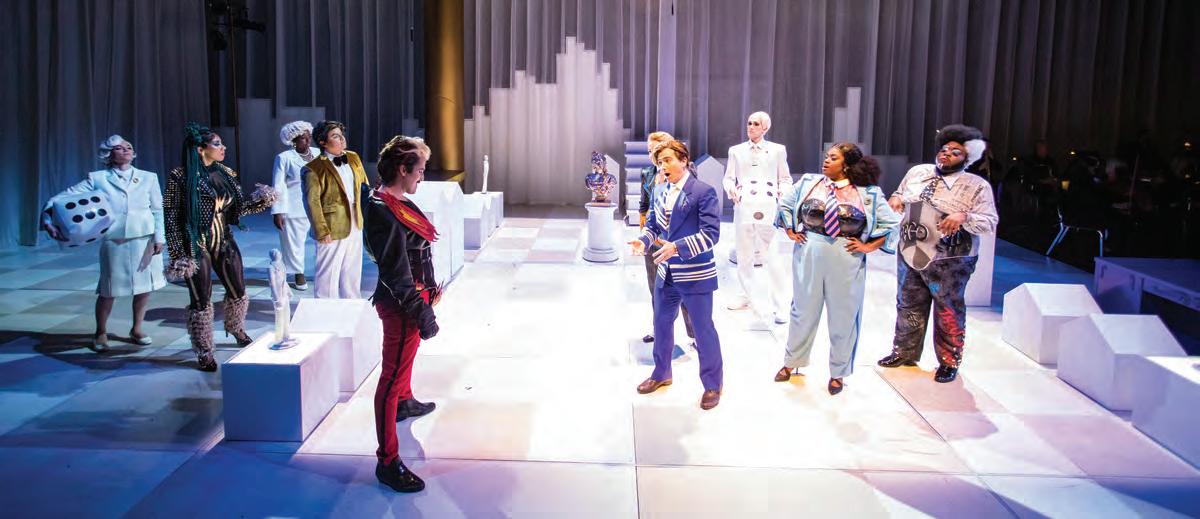

Don Basilio’s big solo from The Barber of Seville. And it wasn’t bad. The number didn’t build the way it might, but Monet has a voice with size and unforced resonance, and the opening night audience applauded wildly. Trevor Bowen, it should be mentioned, designed Miss Monet’s costume, which gave her the look of a float in the Rose Bowl parade.
The production, staged and choreographed by John De Los Santos, was performed in the original French version with dialogue, and, no matter which version is used, it’s a wacky tale. The tomboy Marie, a drum majorette in Napoleon’s scraggly twenty-first regiment, is forced to act like a future duchess, thereby losing not just Tonio, the young man she loves, but also the soldiers of the regiment, whom she considers her stepfathers. Marie loves war and practices stabbing her enemies with a sword. Clearly, this is neither a story nor a character one wants to probe too deeply. Understanding this, directors tend to push the comedy a little too hard. Santos is guilty of that. A few of his scenes are too busy, for one thing, and he lets Margaret Gawrysiak play the Marquise as perpetually hysterical, which made her final— and quite serious—confession that Marie is her daughter hard to believe.
But most of what Santos presided over was funny and not
without charm. Tonio, for instance, suddenly pulls a bouquet of flowers from behind a tree to give to Marie, and later, while singing her sad farewell at the end of the first act, Marie slowly walks down a line of soldiers, each one saluting her as she passes by. Santos moves the soldiers about the stage in clever patterns. The show had the whimsical feeling of early Gilbert and Sullivan. Andrew Wilkowske, a natural comedian and a fine singer, gave a winning performance as Sergeant Sulpice. Even Wilkowske’s body language was funny. He would have been a success in silent movies. Vanessa Becerra’s Marie was wonderful. Here was a bright, fun-loving character, especially amusing in the ballet scene of Act Two, where she’s trying so ineptly to learn to dance, offering a reminder that Beverly Sills once said the role of Marie is “Lucille Ball with high notes.” And those high notes in Becerra’s case were sung with impressive ease and confidence, her embellishments always skillfully and clearly articulated and always immaculately on pitch. David Portillo was an eager and appealing Tonio with a light, flexible tenor that suited his role perfectly. As for the character’s big hurdle, Portillo hit all nine high Cs in “Ah! Mes amis” dead center with minimal strain.
Visually, the show was no extravaganza, but Boyd Ostroff’s painted flats for the first act were appealingly picturesque.


Conductor Kelly Kuo led the orchestra in a fine, well-paced performance that showed intimate familiarity with Donizetti’s special idiom.
Continuing with the second half of Minnesota Opera’s sixtieth season, the company probed the everpressing subject of immigration, offering what was assumed to be the first Hmong story to be adapted for the operatic stage—and the company’s fiftieth world premiere. The Song Poet is based on Kao Kalia Yang’s acclaimed 2017 memoir about a Hmong family’s desperate escape from the war-torn mountains of Laos into a Thai refugee camp and ultimately to the United States, where the life of a refugee family proves to be full of challenges.
The opera’s Minnesota roots run deep. Both the composer, Jocelyn Hagen, and the librettist, Yang herself, are based in Minnesota, where by 2023 the Hmong community numbered some 66,000 people, most of them living in the Twin Cities. Rick Shiomi, a founding member of Theater Mu, the second-largest Asian American theater organization in the county, staged the production. To no one’s surprise, all ten performances of the opera were sold out.
The Song Poet is basically a chamber opera, a category enhanced by the intimate character of the venue, the Luminary Arts Center, the company’s new auxiliary space that sits alongside the Mississippi River just north of downtown Minneapolis. Mina Kinukawa’s set for the show was simple and abstract. Hagen’s orchestra—a dozen or so players conducted by Tiffany Chang—was positioned to the side of the playing area with the audience seated on bleachers lined up against one of the walls.
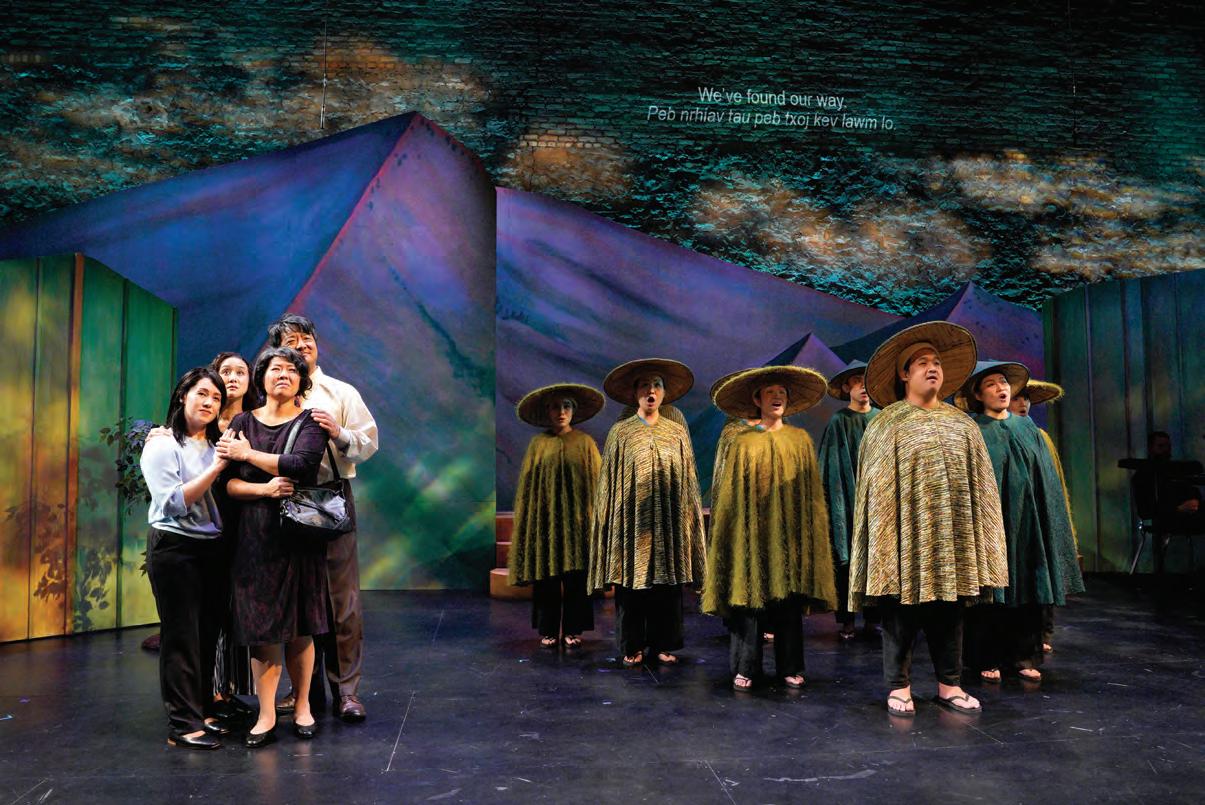
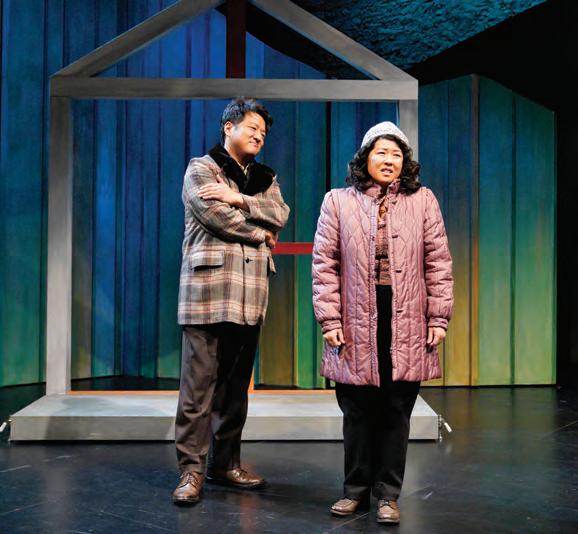

There are moments of frenzy in the early scenes, as the Laotians are attacked by both North Vietnamese and, by air, American bombs. But the tone of the show is chiefly wistful, at times wry. Bee Yang, the opera’s major character as the song poet and Kalia’s father, laments the loss of his singing voice. “No one knows the language of my heart in America,” he says. He wants his voice back, whereas his wife Chue wants a washing machine.
Yang’s book is darker, more detailed, than the libretto on which it is based, and this comes as no surprise. To make room for the music, an opera libretto must be an abridgement, a distillation of the original material, be it a novel, a play, or a film. But Yang has removed too much. She has rounded off so many of the book’s sharp edges, such that the book and the libretto are almost two different stories. In the book, the Yang family has a rough time in America, whereas in the libretto it’s more a matter of getting used to the cold weather, and before you know it Kalia’s a grown-up professional writer who gets the Minnesota Book Award and appreciative hugs from her parents. Near the end the family visits Laos, where, as might be expected, nothing is the same as it was, and in another minute or two they join the chorus to sing “We found our way.” Thank you and good night.
If the libretto seemed too concise, Hagen’s music offered what was almost the opposite: resonance and emotional weight. Hagen knows how to set words clearly and expressively—the text was sung in English and Hmong with captions in both languages projected onto an upstage wall—and her
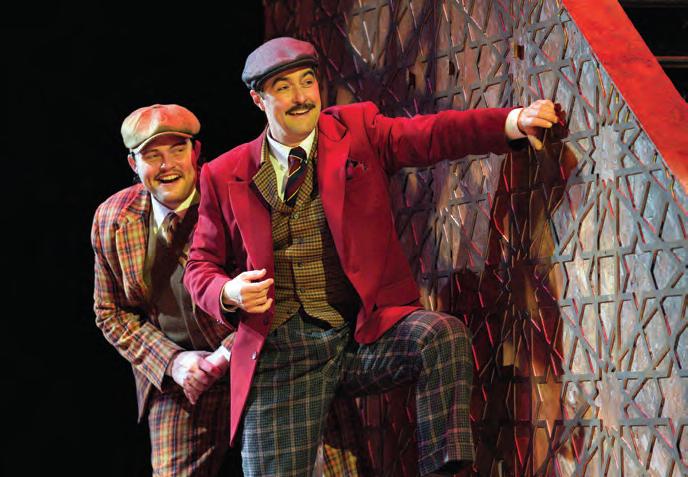
orchestration, sounding vaguely French, given its delicate colors, reliance on mallet instruments, and frequent use of harp and bassoon in solo passages, showed folk, pop, and minimalist touches. The lyrical interlude for orchestra that opens the second act was an especially evocative moment. Chang, a Taiwanese American conductor who was making her company debut, paced the show energetically and drew precise playing from the orchestra and articulate singing from the twelve-member chorus.
Shiomi, a much-admired director in these two cities, moved his singers smartly about the stage and, in a weird echo of Fritz Lang’s Metropolis, devised a clever staging of the factory scene in the second act, having the workers gradually turn into machines. The singing was uneven on opening night, but the acting was always convincing. Museop Kim and Corissa Bussian were impressive in the commanding roles of Bee and Chue, as were Laura Sanders as Kalia and Hai-Ting Chin as Kalia’s older sister Dawb. Huiyin Tan, playing Bee as a stressed-out teenager, gave the opening scene welcome urgency. Choreographer Penelope Freeh conceived the charming Fred-and-Ginger style duets featuring dancers Eliana Vesely and Cheng Xiong. Khamphian Vang designed the bright costumes and Karin Olson the lights.
Just a few days before Minnesota Opera unveiled its season finale, an intriguing new production of Don Giovanni, the company announced that a new four-year contract with the orchestra musicians had been ratified, a four-year contract that extended through the 2025–26 season and included the current season, 2022–23. Sighs of relief could be heard in many quarters, given that the musicians had been playing all season without a contract. They picketed in front of both the Ordway Music Theater and the Luminary Arts Center during performance nights and handed out leaflets stating their case.
Don Giovanni, suave aristocrat, virtuosic seducer, coldhearted rapist, and murderer—take your pick—has over the decades become a progressively more dangerous character whenever Minnesota Opera has taken up the subject. Back in the ’70s, in a production by H. Wesley Balk, the Don was portrayed as a hero rather than a villain. He was a nonconformist, a rebel against the sterility of bourgeois society, and therefore had to be eliminated. In subsequent productions, however, he got meaner and more sinister, as if he embodied what each generation fears the most.
In the company’s latest iteration, serving as the finale of Minnesota Opera’s sixtieth season—its fifth take on Mozart’s masterpiece—the Don, compellingly enacted by the baritone Seth Carico, turns out to be the usual coat of many colors: a
trickster, a con man, a playboy. But in this reading he’s also a sex addict and a charmer given to sudden eruptions of violence that he seemingly has no control over. He’s Dr. Jekyll and Mr. Hyde. He preys on women, and they find him irresistible, even though they’re afraid of him. In a graphic pantomime staged during the overture, the Don assaults and rapes Donna Anna, and there’s more than a hint of S&M in his encounter with Zerlina, who seems rather fond of the idea.
The difference this time around, in a staging by Keturah Stickann that might be called the #MeToo approach to Don Giovanni, is that the women, the Don’s victims, get their revenge. Here, in the finale, it’s the three women who bury the Don, not the Commendatore, whose function is more like that of a cheerleader. In the final scene, Elvira, Zerlina, and Anna link arms and push the Don onto his bed, which opens up like an old-style hide-a-bed, and he falls in, headed, presumably, toward his reward. Other women, looking like zombies, appear onstage at this point and are joined by three other women dressed like chamber maids who had been moving scenery during the show. These women shed their working clothes, and the entire cast, including chorus members, do the same thing. What this symbolized wasn’t apparent.
Stickann’s updating of the action from the seventeenth century to the mid-1930s offered no discernable benefit, except that it relieved the Don from the burden of trying to look fetching in knee breeches and polka-dot stockings. Besides that, the rigid class barriers inherent in the original story are surely less applicable to life in the 1930s.
The evening’s allure came less from the director’s concept than from the strong cast. Carico and Thomas Glass, the engaging Leporello, made a winning team. Here were two singer-actors so in tune with each other it seemed they might be doing a vaudeville act. In contrast to the rather grim tone of the production, much of what transpired, notably the balcony scene in act two, was quite funny. Carico’s rubbery body language recalled the antics of the early film comedian Charley Chase, whom Carico resembles, a characterization widely different from the intense portrayal he gave in 2018 of Joseph De Rocher, the convicted murderer in this company’s production of Dead Man Walking. Carico’s flexible baritone proved capable not only of the "Champagne Aria"’s breathtaking staccato but of a gracefully floated cantabile in the "Serenade" in the second act. Glass, too, was effective, offering a darkly humorous but suave character, whose Catalogue Aria was subtly timed and beautifully sung.
Among the women, Symone Harcum, a true spinto, brought an agile technique and a wide expressive range to the role of Donna Anna, qualities that on opening night made her big number “Non mi dir” one of the evening’s highlights. Sara Gartland sang glowingly as Donna Elvira, and Leah Brzyski was an appealing Zerlina. While bringing a sweet sincerity to the part of Don Ottavio, Efrain Corralejo showed some vocal strain in the second act, but his account earlier in the show of “Dalla sua pace” was lovely. Charles H. Eaton portrayed an impressingly hot-tempered and lovelorn Masetto, whereas Allen Michael Jones’s bass lacked some of the sepulchral resonance to make an impact as the Commendatore.
Liliana Duque Piñeiro designed the rotating set, an example of the minimalist abstraction that has come to be the dominant visual style of this company’s productions in recent seasons. Sarah Barr designed the elegant costumes. When the scheduled conductor bowed out during the rehearsal period, Mario Antonio Marra, the company’s head of music, replaced her, favoring relatively slow tempos while encouraging ample passion and elegant playing from the orchestra. This leaves us wondering what the next Don Giovanni—let’s call it Don six—will look like.
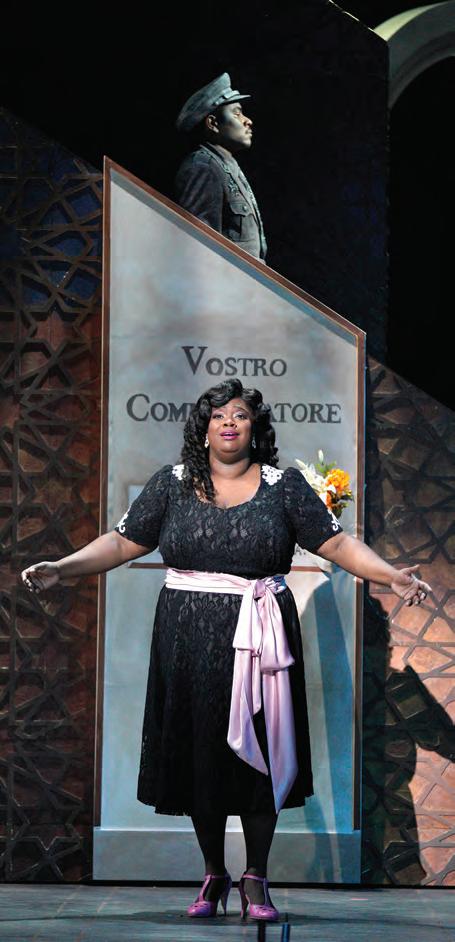
WHAT’S NEXT FOR THIS little opera company in the “the Bold North”? Current president and general director Ryan Taylor envisions a company that, as it continues its recovery from the pandemic, remains innovative, flexible, efficient, and responsive to its community. “MN Opera is a company that is inspired by our belief in the power of our art form to change lives with our artmaking. We are committed to promoting the creation of new works, developing talented artists, a strong bel-canto philosophy of singing, and the pursuit of our equity values,” he said. “These four elements are evidentiary strands of what has become Minnesota Opera’s DNA. They form a solid framework with which the Opera will greet the future.”
One clue to Minnesota Opera’s continued commitment to developing new work was revealed in May 2022, when the company announced the next phase of the New Works Initiative. It engaged six artists to produce work over several seasons: composers B. E. Boykin, David Hanlon, and Kamala Sankaram, and librettists Minita Gandhi, Harrison David Rivers, and John de los Santos. This so-called “creative cohort”—a group with diverse geographic, cultural, and artistic backgrounds—was intentionally assembled to bring new perspectives and voices to the creation of opera. The com-
missioning process will result in nine new works: three operas to premiere at the Ordway, three operas to premiere at the Luminary Arts Center, and three song cycles. The new model marries the company’s expertise in developing new work with a new model designed to cultivate and support its artists and artmaking process while reducing the risks for both their creators and the company.
The Luminary Arts Center—now owned and operated by Minnesota Opera—represents new possibilities for deeper connections with the arts organizations, artists, and audiences that will use it. This expansion to the company’s Minneapolis campus serves as the hub for the company’s youth opera programs, and Taylor envisions it will facilitate more community involvement in the workshop process for its future commissions.
The Luminary also provides opportunities to expand the range of repertoire that the company itself can produce thanks to the intimacy of the space. For some who recall the Center Opera days, seeing smaller-scale productions in the new venue may feel like a full-circle moment or a return to its innovative origins. For others, like the company’s board chair Nadege Souvenir, the space represents the company’s aspirations. “I see this beautiful space as the physical embodi-
ment of the company’s mission, vision, and values. It is rooted in community; a space to sing new and different stories.”
In keeping with the old Center Opera philosophy of “Operas without Elephants,” today’s Minnesota Opera is no longer focused on trying to get people to appreciate operas created in Italy two hundred years ago and being surprised— and a little bit miffed—when they don’t. Instead, it’s focused on stories. Every culture has them, and what they do—and have always done—is sing them, so it’s a matter of listening to other people’s stories.
Taylor is quick to point out that the company will not abandon popular repertoire like La bohème, but approaches its programming decisions by asking the question, “why this opera, and why this opera now?”
“We will continue to explore beloved works from our inherited repertoire, which comes from a tradition that we recognize was created by a dominantly Eurocentric, white, male creative field,” Taylor said. “It’s important to examine the context, traditions, and performance practice of each opera, as much of the repertoire we inherited was created in a time and place where cultural values didn’t match those we hold today. Our challenge is to determine how new approaches and perspectives can preserve or elevate the value of an existing
work, addressing its context without glorifying or perpetuating oppressive stereotypes or behaviors. So now we identify creative teams whose lived experiences and artistic viewpoints offer these pieces a fresh perspective that can inform and sharpen our artistic decisions. Our hope is that by taking this care in expanding the circle of storytelling, we can help these works continue to resonate with modern audiences.”
“As we find our way out of a global pandemic, Minnesota Opera has expanded our concept of just how powerful this art form could be,” Minnesota Opera Board Chair Nadege Souvenir shared during Opera America’s Opera Conference, which Minnesota Opera hosted in May of 2022. “We are expanding to reflect more experiences of people and communities historically excluded from opera—in the casting, the reinterpretation of the historical canon, the lifting up of untold stories, and the creation of new works from a multitude of perspectives. The stories we tell now will be a future generation’s history. And we all know that history—or at least the parts that were ‘allowed’—deeply informs our present. We have the power to use opera for change—to infuse our future history with the wholeness of who we are in such a way that no one can deny anyone’s right to be a part of the narrative.”
IT TAKES A VILLAGE, as a certain famous person has reminded us. Anyone who has suffered the rigors of writing a book will second that notion. It’s one thing to write a biography of a person, living or dead, and quite another to write one about an organization that’s nearly sixty years old. The sources are everywhere in the village, and quite a few of them are dead. It turned out, when I looked into it, that all the major American opera companies except one had been profiled in at least one book, and that exception was Minnesota Opera. This was odd because Minnesota Opera’s history was so unusual. Here was a determinedly avant-garde, lowbudget opera company presenting new and unusual repertoire adorned in wild and crazy sets and costumes. Seeing these shows, critics from New York, Chicago, and Los Angeles were impressed, but also dumbfounded that this was happening in the frozen Upper Midwest, which is not exactly opera country.
So many people have been supportive and generous with their help and encouragement in the research for and in the writing of this book. Eric Broker, director of marketing and communications at Minnesota Opera, and Darby Lunceford, the company’s former chief marketing officer, got this ball rolling and took a genuine interest in the complicated history of this company. My lawyer, Barbara Gislason, always the smartest person in the room, hammered out a contract that worked for all parties concerned, and my three readers—Janis Hardy, Gale Sharpe, and Pearl Bergad—provided encouragement and close readings of the sections and mini chapters as
I finished them. Without Pearl, whose computer skills tower high above mine, I’d still be writing the first chapter. She showed me how to upload my dozens of interviews into the mysterious cloud and then ended up doing them all herself. These went to Michael Marsh’s company, High Fidelity, which produced accurate transcriptions quicker than seemed possible. Research for the book began on a very high note at Janis’s house in October 2017, with three hours of revealing and funny and occasionally sad stories from Gale, Janis, and the incomparable Vern Sutton.
So many people shared memories of the early days of both Center Opera and Minnesota Opera, among them the brilliant designer Robert Israel, the amazing and always quotable Sue Weill, a trio of fine orchestra musicians (Camilla Heller, Fred Sewell, and Cynthia Stokes) and, in the last interview he ever gave, the composer Dominick Argento. When what we needed, rather desperately, were tales of St. Paul Opera, no one knew more than Alvina O’Brien, who chatted over lunch one day in St. Paul. Besides Argento, numerous composers talked about their craft and what it’s like to write an opera: Kevin Puts, Bill Bolcom, Paul Moravec, Douglas J. Cuomo, Joel Puckett, Paola Prestini, and, of course, the indomitable Libby Larsen, who shared vivid memories on a sunny afternoon and generously consented to write for this book her impressions of Erik Stokes’s Horspfal from fifty years ago. Add to this list that most prolific and articulate librettist, Mark Campbell, who by 2020 had written six librettos for Minnesota Opera productions (and, it is alleged, with his other hand, simulta-
neously wrote three musicals and a song cycle). And then, sharing his insights, was Eric Simonson, the company’s chief director in the most recent decades, who helped give birth to several new works while writing the libretto for The Fix, an opera about baseball.
Among the singers who became a part of this project were Dan Dressen, James McKeel, Elisabeth Comeaux, Brenda Harris, Jennifer Eckes, and, at eighty-six, a still vital Sherrill Milnes. George Manahan told great stories about being the company’s music director for eight years. Minnesota Opera staff members, past and present, were unfailingly helpful as well, among them Gail Bakkom, Dan Berg, Patrick Dewane, Julia Gallagher, Kathy Davis Graves, John Humleker, Rocky Jones, Severin Lier, Theresa Murray, Peter Myers, Roxy Stouffer-Cruz, and the always impressive Lani Willis. Board members, most of them former chairpersons, told revealing stories about the company’s issues and crises: Karen Bachman, Jane Confer, Chip Emery, Jim Johnson, Lucy Rosenberry Jones, Susan Boren King, Ann Pflaum, Bernt von Ohlen, and Margaret Wurtele.
Patricia Mitchell told what it was like being president of the Ordway, Chuck and Mary Leer revealed the history of the Lab and the Opera Center, and Gean Halstead bravely recounted the tender story of life with his mother Barbara Brandt and stepfather Wesley Balk. Allan Naplan and Kevin Ramach talked frankly about the travails of their short-lived company presidencies. A distinguished horn player, Herb Winslow, and a thoughtful lawyer, Brad Eggen, clarified the twisted
tale of the misbegotten Alliance, which almost shipwrecked both Minnesota Opera and the St. Paul Chamber Orchestra. Steve Woodward provided helpful editorial guidance. And, of course, Victoria Petelin at Wise Ink was a continued source of support and encouragement. Of great help in research were Jill Vuchetich, head of archives at Walker Art Center, and Kathryn Hudja and the other fine staff of the library at the Minnesota Historical Society.
Everyone was a key player in this story. Even so, the reflections and memories of four special people made this book possible. These were: Philip Brunelle, the company’s longtime music director (1968 to 1985), who tells better stories than anyone else; Dale Johnson, the artistic director for more than two decades who made the company’s New Works Initiative the envy of the opera world; Kevin Smith, the spine of the company for nearly three decades, its president and general director from 1986 to 2011; and Ryan Taylor, a protégé, one might say, of Smith’s, who, as president and CEO since 2016, has been a transformative presence in the life of the company and one who will, one would guess, take Minnesota Opera in lively and surprising new directions.
All four gave precious hours of their time to this project, answering my endless barrage of questions—and rephrasing of questions—with thoughtful and detailed answers. None of them ever looked at the floor and sighed. I pictured at one point Ryan Taylor seated on a plane. He looks out the window and sees me standing on the wing holding a tape recorder and a legal pad, shouting, “Ryan, just a few more questions.”
AThe Abandonment of Ariadne, 11
The Abduction from the Seraglio (Mozart), 5, 9, 11, 56, 60–61, 132–133, 364
The Abduction of Figaro (PDQ Bach), 9, 91, 157, 159–160
Acosta, Andres, 343
Adamo, Marc, 6, 245
Adams, John, 6, 255–256, 278, 298, 322
The Adventures of Pinocchio (Dove), 5, 278–279, 285
Aida (Verdi), 7, 21, 53, 187, 228–231
Akalaitis, JoAnne, 354
Albert Herring (Britten), 4, 10, 11, 26, 30, 32–33, 37–38, 40–43, 58, 60, 107–108, 234, 365
Alcorn, 6–7
Alifaris, James, 27, 29
Amberg, George, 29
Animalen (Werle), 9, 170–172
Anna Bolena (Donizetti), 5, 289, 310
The Anonymous Lover (Bologne), 4, 367–368
Antheil, George, 7, 19, 229
Arabella (Strauss), 5, 314
Archabal, Nina, 307, 329, 333
Argento, Dominick, 12, 23–24, 27, 30, 36–37, 46, 56, 58–59, 93, 99, 109, 112, 137, 142, 172–173, 201, 203, 228, 315, 364, 382
Ariadne auf Naxos (Strauss), 5, 8, 184, 196, 325–326
Arlan, 9
Armida (Rossini), 7, 211–212, 289
The Aspern Papers (Argento), 8, 201, 203
BBach, J.S. 9–10, 113, 115, 128
Bachman, Karen, 19, 155, 210, 224, 267, 383
Baile, Carolyn, 38
Bakkom, Gail, 145–147, 186, 240, 383
Baldwin, Christina, 50
Balk, Wesley, 2, 14–15, 19, 24, 45–47, 50–51, 53, 58, 64–65, 72, 78, 88–89, 96, 106, 109, 114, 120, 123, 125, 131, 133, 139, 145, 149–150, 153, 156, 163, 175–176, 182, 188, 191, 208, 237–238, 378, 383
Baltz, Ann, 50, 185
Barab, 9
The Barber of Seville (Rossini), 5–7, 9–10, 98, 148–149, 218, 238, 243, 256, 283, 356–357, 375
Barnes, Edward, 9, 149–150
The Bartered Bride (Smetana), 10, 37, 114
Bartók, Béla, 11, 82
Bates, Alison, 275
Beckvermit, Danielle, 349
Bellini, Vincenzo, 6, 8, 200, 203, 237, 241
Benoit, Brad, 280, 290, 299, 325
Berg, Dan, 196–197, 383
Bernstein, Leonard, 10, 113, 115
The Birds, the Beasts, and the Ball Game (Alcorn), 6
Birtwistle, Harrison, 11, 36, 65, 86
Bizet, Georges, 4–9, 184, 290, 367
Black River (Susa), 9–10, 79, 106, 109–11, 137, 139
Blackwood, Easley, 10, 107
Blitzstein, 11
Blossom Time 17
Blow, John, 11–12, 23, 32
Blue Bandits, 21
Bluebeard’s Castle (Bartok), 11, 82
Boesing, Martha, 11, 88
Boesing, Paul, 11, 88, 188
The Bohemians (Puccini), 7
Bok Choy Variations (Chen & Simonson), 7, 219–220, 284
Bolcom, Bill, 382
Bologne, Joseph, 4, 367
Book of Days (Monk), 8, 188
The Boor (Argento), 9
Boren, Susan, 252, 333, 383
Brandt, Barbara, 82, 97, 117, 121, 128, 139, 145, 383
Briggle, Gary, 47, 49, 133, 153, 175
Britten, Benjamin, 4, 7–8, 10–11, 18, 30–32, 40, 43, 45, 52, 58, 65, 76, 86, 188, 197–198, 233–234, 298, 365
Broker, Eric, 332, 370, 382
Brunelle, Philip, 19, 45, 47, 77, 78–80, 82, 86, 93, 98, 100–101, 106, 110, 112, 115, 120–121, 123, 125–126, 128, 134–138, 142, 150, 153–154, 156, 163, 171, 175, 215, 383
Brzyski, Leah, 379
The Business of Good Government (Marshall), 11
Bynum, Lee, 363–364, 367
CCallas, Maria, 47
Campbell, Marc, 285, 298
Campbell, Mark, 301, 322, 334, 348, 359, 371, 382
Candide (Bernstein), 10, 50, 115–116
The Capulets and the Montagues (Bellini), 6, 241–242
Cardenas, Octavio, 340, 347
Carmen (Bizet), 4–9, 137, 141, 147, 176, 189, 204–206, 210, 227, 258–259, 322–323, 366–370
Carousel (Rodgers & Hammerstein), 7, 193, 195, 209, 319
Casanova’s Homecoming (Argento), 5, 9, 36–37, 172–175, 287–288, 364
The Cat That Walked By Himself (Alcorn), 6
Center Arts Council, 26–32, 44, 82
Center Opera, 11–12, 18–20, 23–25, 29, 31–32, 34, 37, 40, 42–47, 56, 58, 60–62, 64, 68, 70, 72, 74, 77–80, 82–83, 85–86, 88–89, 92–94, 96, 99, 113, 132, 144, 146, 176, 187, 196, 208, 224, 229, 237–238, 242, 258, 380–382
Chanticleer (Barab), 374, 379
Chen, Evan, 7, 219–220
Christianson, Genevieve, 245
A Christmas Carol (Sandow), 9
Christmas Mummeries and Good Government (Marshall), 11
Christopher Columbus (Offenbach), 9, 120–121
Cinderella (Rossini), 5, 7–9, 162, 230–231, 296, 364
Clapp, Edward, 104
Claudia Legare (Ward), 9, 121
Comeaux, Elisabeth, 200
Condon, Richard, 302, 321
Confer, Jane, 269, 284, 360, 383
The Consul (Menotti), 9, 128–129
Corn, Ed, 131, 150–151, 160, 164, 166, 175–177, 182, 184, 195, 197
The Coronation of Poppea (Monteverdi), 11, 89
Corralejo, Efrain, 379
Così fan tutte (Mozart), 5, 8, 10–11, 50, 77–78, 80, 157, 206, 304 i ndex
Cowboy Lips (Greene & Madsen), 8, 188
Crawford-Livingston Theater, 20
Cuomo, Douglas J. 285, 308, 361, 382
DDas Rheingold (Wagner), 5, 338–339, 361, 364
The Daughter of the Regiment (Donizetti), 4, 374
Davies, Peter Maxwell, 10, 36, 106 Dayton, Ken, 167, 197
Dead Man Walking (Heggie), 5, 333, 341, 359, 379
A Death in the Family (Mayer), 9, 155–156
Debussy, Claude, 7, 222
Delibes, Leo, 6, 266
Der Rosenkavalier (Strauss), 6, 97, 240–241
Dewane, Patrick, 268, 284, 383
Diana’s Garden (Martín y Soler), 5, 336–337
Diary of an African American (Peterson), 7, 215, 367
Die Fledermaus (J. Strauss), 8 Dinner at Eight (Bolcom), 5, 285, 334–335
Dolmetsch, Arnold, 29
Domoto, Jeffrey, 245
Don Carlos (Verdi), 6, 187, 247
Don Giovanni (Mozart), 6–8, 10, 86, 121, 188–189, 214, 221, 234, 260, 262, 281, 332, 359–360, 378–379
Donizetti, Gaetano, 4–6, 8–9, 211, 237, 253, 258, 289–290, 292, 343, 374, 376
Don Pasquale (Donizetti), 5, 9, 343–344
Doubt (Cuomo), 5, 204, 361
Dove, Jonathan, 278, 285, 357
The Dream of Valentino (Argento), 5, 515–516
Dressen, Dan, 175, 188, 210, 227, 289, 383
Duncan, Martin, 278, 285
Dvořák, Antonin, 5–6, 8, 187, 277, 326
E
Eaton, Charles H. 374, 379
Eckes, Jennifer, 383
Eggen, Brad, 214, 383
Egk, Werner, 11, 86, 88
Eight Songs for a Mad King (Davies), 10, 36, 106 Elektra (Strauss), 4, 353, 356
El Capitan (Sousa), 10, 36, 100, 134
The Elixir of Love (Donizetti), 5, 8, 177, 181, 320, 322
Emery, Chip, 306, 383
The Fantasticks (Schmidt), 8
Faust Counter Faust (Gessner), 11, 48, 79, 89, 90–92, 94, 152, 154
Faust (Gounod), 5, 7, 234–235, 281
Fayad, Nadia, 336
Fellow Travelers (Spears), 5, 341–343
Feathertop (Barnes), 9, 149–150
Figaro’s Revenge (Rossini, Paisiello), 7
The Fix (Puckett), 4, 285, 351–352, 361, 383
Flight (Dove), 4, 357–359
Fly Away All (Hutchinson & Shank), 8, 188
The Flying Dutchman (Wagner), 6–7, 184, 210–211, 249–250
The Fortunes of King Croesus (Keiser), 6, 273
Four Saints in Three Acts (Thomson), 11 Frankenstein, or the Modern Prometheus (Libby Larson), 8, 198–200, 210
Friedman, Martin, 28, 30–31, 38, 44–45, 58–59, 64, 83, 99
The Frog Who Became a Prince (Barnes), 9
From the Towers of the Moon (Moran & La Chiusa), 7, 210
Futterer, Keely, 374
G
Gallagher, Julia, 355, 362, 383
Gallimaufry (Minnesota Opera), 10, 106
Gessner, John, 11, 89
Gianni Schicchi (Puccini), 9, 145
Gilbert, W. S., 7–9, 72, 120, 134, 190, 213, 375
Glass, Thomas, 331, 379
Gluck, Christoph, 5, 292–293 Goldman, Connie, 28–29
The Gondoliers (Sullivan), 11, 72
The Good Soldier Schweik (Kurka), 11, 36, 61, 63
Gordon, Ricky Ian, 268
Gounod, Charles, 5–8, 198, 233–234, 272, 281, 331
The Grapes of Wrath (Gordon), 6, 236, 252, 263, 267–271, 284–285, 300
Graves, Denyce, 147, 204, 212, 227, 259, 309, 367–368
Graves, Kathy Davis, 185, 187, 201, 204, 207, 383
Greenwald, Bradley, 50
Guthrie Theater, 12, 20, 23, 29–32, 44, 56, 58, 81, 85, 90, 96–97, 99, 126, 146, 148–149, 354, 365, 371
Gulliver (Blackwood, Kaplan, Lewin), 10, 106–108
H
Hagen, Jocelyn, 4, 376, 378
Halstead, Gean, 48, 383
Hamlet (Thomas), 5, 238, 310–311, 355
Hammerstein, Oscar, 8, 188, 195, 209
Handel, Georg Friedrich, 4, 7, 101, 164, 214–215, 273, 372, 374
The Handmaid’s Tale (Ruders), 6, 249–252
Hansel and Gretel (Humperdinck), 5, 8, 150, 152–153, 319, 322
Harcum, Symone, 367–368, 374, 379
Hardy, Janis, 100–101, 107, 110, 118, 120, 135, 17, 175, 187 Harper, William, 8, 208
The Harpies (Blitzstein), 11
Harris, Brenda, 147, 167, 211–212, 215, 223–224, 238–239, 245, 249, 258, 262, 289, 292–293, 308, 314, 322, 334, 383
Haydn, Joseph, 11, 75
Heggie, Jake, 5, 341, 343
Heller, Camilla, 104, 224, 382
Herrmann, Bernard, 5, 294, 364
Hintz, Norton, 26–27, 29–30, 44–45, 52, 99, 229
History Theater, 20, 260
Hoppenot, 11
Horspfal (Stokes), 11, 77, 81–82, 125, 382
How the Camel Got His Hump (Alcorn), 7
Humleker, John, 252, 383
Humperdinck, Engelbert, 5, 8–9, 319
IIl trovatore (Verdi), 5, 7, 216, 280–281
Israel, Robert, 52, 61, 67, 76, 81, 86, 97, 106–107, 146, 197, 242, 250, 252, 382
The Italian Girl in Algiers (Rossini), 6, 275–276
The Italian Straw Hat (Rota), 4, 349–350
JJargonauts, Ahoy! (McKeel), 8
The Jealous Cellist (Stokes), 9, 125, 129
Job, Christopher, 273
Johnson, Dale, 131, 167, 171, 175, 196, 200–201, 211–213, 215–216, 237, 239, 258, 284, 285, 290, 292, 300, 302, 310, 315, 321–322, 333, 345, 347, 364, 370, 383
Johnson, Jim, 383
Jones, Lucy Rosenberry, 2, 210, 383
Jones, Rocky, 362–363, 383
Joseph Merrick, the Elephant Man (Petitgirard), 6, 147, 260–261
Julius Caesar (Handel), 7, 164, 214, 372
The Juniper Tree (Glass & Moran), 8, 191–193, 210
KKaplan, Eliot, 10, 107
Kaprow, Allan, 28
Keeney, Aaron, 368
Keiser, Reinhard, 6, 273
Kimple, Jonathan, 290
The King and I (Rodgers & Hammerstein), 8, 177–178, 188, 195
Kiss Me, Kate (Porter), 9
Knussen, Oliver, 8, 177, 179–180
Korie, Michael, 268, 270
Kozma, Peter, 261
Knussen, Oliver, 8, 177, 179–180
Kroll, Jack, 354
Krywosz, Ben, 50, 144, 154, 182, 188, 196
Kunin, Dan, 167
Kurka, Robert, 36, 60–61, 64
LLa bohème (Puccini), 5, 7–9, 59, 65, 86, 103, 132, 135–136, 184, 197, 220, 312, 340, 381
The Lab Theater, 21, 202, 347, 352, 354, 367, 371
La cenerentola (Rossini), 9, 162, 295
La Chiusa, John, 7
La clemenza di Tito (Mozart), 6, 245–246
La donna del lago (Rossini), 6
La faniculla del West (Puccini), 5
Lakmé (Delibes), 6, 266
La rondine (Puccini), 4, 347–348
La traviata (Verdi), 4–9, 106, 126–128, 177, 180–181, 196, 208, 224–226, 257, 295–296, 332, 347
Leer, Chuck, 201, 354
Leer, Mary, 354–355, 383
Lehár, Franz, 6–7, 9, 347
Leoncavallo, Ruggero, 6, 243
Lerner, Alan Jay, 8
Lessac, Michael, 28
Lewis, Frank, 10, 107
L’heure espanole (Ravel), 11
Libby Larson, 8
The Liberation of Theseus, 11
Lier, Severin, 383
Lindsey, John Robert, 299
Little Women (Adamo), 6, 343–345
Loewe, Frederick, 8
Longo, Joe, 105
Lovato, Andrew, 325
The Love for Three Oranges (Prokofiev), 9, 123–124, 128
Lucia di Lammermoor (Donizetti), 5–6, 9, 15, 154
Lucrezia Borgia (Donizetti), 6, 253–254
Ludwig, John, 19, 37, 44–46, 58–59, 64–65, 67, 78, 80, 99, 103, 137, 154
Luminary Arts Center, 21, 202, 354–355, 362, 367, 371–372, 376, 378, 380
MMacbeth (Verdi), 5–6, 240–241, 289, 314, 322
Madame Butterfly (Puccini), 5–9, 20, 147, 161, 212, 233, 257–258, 304–305, 329, 332
The Magic Flute (Mozart), 5–11, 74, 106–107, 174, 206, 226, 253, 317, 326–327
The Rise and Fall of the City of Mahagonny (Weill), 10, 117 Manahan, George, 131, 186, 197–198, 203, 207, 210–211, 218–219, 223, 383
The Manchurian Candidate (Puts), 5, 285, 302, 321–322
The Man in the Moon (Haydn), 11, 75–76
Manon Lescaut (Puccini), 5, 313
Maria Padilla (Donizetti), 6, 258
Markgraf, Kelly, 272, 352
The Marriage of Figaro (Mozart), 5–7, 9, 11, 93, 121–122, 210, 241, 267, 361
Marshall, Yale, 11, 32, 38, 45, 72, 82, 88–90, 93, 110
Martín y Soler, Vicente, 5, 336
The Masque of Angels (Argento), 11, 23, 25, 34, 36–38, 40, 58–59
The Masque of Venus and Adonis (Blow), 11, 23, 32, 38
Mary Stuart (Donizetti), 5, 289, 292–293
The Mask of Evil (Mollicone), 9, 149–150
A Masked Ball (Verdi), 6, 274–275
Massenet, Jules, 5, 305, 346, 361 Mayer, WIlliam, 9, 155–156
McBurney, Tom, 167, 197, 285
McKeel, James, 46–47, 135, 145, 153, 174, 183, 190, 383
Meanwhile, Back at Cinderella’s (Arlan), 9
Menotti, Gian Carlo, 9, 29–30, 128, 302
Mercadante, Severio, 6, 260–262
The Merry Widow (Lehár), 6–7, 9, 137–138, 214, 248
The Merry Widow and The Hollywood Tycoon (Lehár), 7
Metropolitan Opera, 12, 18–19, 24, 26, 38, 48–49, 64, 78, 85, 98, 103, 131, 175, 184, 196, 206, 208, 217, 224, 252, 275, 346, 372
Middleton, Alasdair, 278, 285
A Midsummer Night’s Dream (Britten), 8, 11, 65, 76, 197–198
The Mikado (Gilbert & Sullivan), 8, 190
Milhaud, Darius, 11
Miller, Michelle, 167
Milnes, Sherrill, 230, 383
Minneapolis Auditorium, 20–21
Minneapolis Symphony, 17, 23, 72, 77–78, 96
Miss Havisham’s Wedding Night (Argento), 9, 142–143
Mitchell, Cortez, 358 Mitchell, Patricia, 278, 383
Mollicone, Henry, 9, 149
Monteverdi, Claudio, 11, 89
Moran, Robert, 7–8, 191, 210
Moravec, Paul, 5, 324, 382
The Mother of Us All (Thomson), 9, 11, 46–47, 67–70, 72, 89, 92–93, 118–119
Mozart, Wolfgang Amadeus, 4–11, 31, 46, 50, 56, 60–61, 77, 79–80, 101, 103, 121, 133, 157, 188, 206, 210, 221, 226, 245, 262, 267, 298, 301, 304, 317–318, 326, 336, 361, 364, 367
Murray, Theresa, 360, 362, 383
Music from the Court of George III, 10
The Music Shop (Wargo), 8
Myers, Peter, 105, 110, 128, 144, 150, 166, 307, 383
My Fair Lady (Lerner & Loewe), 193, 195
N
Naplan, Allan, 305, 383
Nabucco (Verdi), 5, 289, 308, 310
The Newest Opera in the World (Minnesota Opera), 10, 101
New Music-Theater Ensemble, 4, 6, 8, 49, 164, 188, 191, 208
Nieboer, Roger, 8, 208
Nolte, Charles, 50, 109, 126, 315–316
Norma (Bellini), 6, 8, 200–201, 249, 258
Northrop Auditorium, 12, 20, 24, 27, 72, 85, 103, 175, 275, 346, 372
North Star Opera, 20, 175
O
O’Brien, Alvina, 104
O’Connor, Francis, 278, 285, 299
Oedipus and the Sphinx (Marshall), 11, 88, 94, 101
Offenbach, Jacques, 6–7, 9, 120, 223
Oklahoma! (Rodgers & Hammerstein), 8
Oliver, Anna, 146, 218
Opera Afuera, 4, 366
Opera in the Outfield, 4, 364
Opera St. Paul, 20
Opera Tomorrow, 8, 144, 177, 182–184
Opera Without Elephants, 11, 31, 53, 144, 187, 228
Orazi & Curiazi (Mercadante), 6
Ordway Center, 37, 130, 166, 169, 278, 309, 367
Orff, Carl, 6, 11, 24, 45–46, 53, 253, 355
Orpheus and Eurydice (Gluck), 5, 292
Osmo Vänskä, 167, 177, 388
O’Shaughnessy Auditorium, 20, 86, 92–93, 106–107, 109, 114–115, 118, 128, 133, 139, 145
Otello (Verdi), 7, 232–234
PPagliacci/Carmina burana (Leoncavallo/Orff), 6
Paisiello, 7
Passion (Sondheim), 6, 253–255
The Pearl Fishers (Bizet), 5, 7–8, 184, 196, 290–291
Peden, Jennifer Baldwin, 50
Pelléas and Mélisande (Debussy), 7, 222
Perregrino, Gina, 331, 336
Peterson, Marvin, 7, 215–216
Petitgirard, Laurent, 6, 260
Pflaum, Ann, 383
The Pirates of Penzance (Gilbert & Sullivan), 7, 9, 132, 134, 213
Plymouth Music Series, 78, 215
Pollock, Evelyn, 252
Porter, Cole, 9, 156, 188
Postcard from Morocco (Argento), 10–11, 36–37, 59, 79, 93–95, 97, 152
The Postman Always Rings Twice (Paulus), 8, 144, 186, 197
Prestini, Paola, 285, 359, 371, 382
Prokofiev, Sergei, 9, 123, 128, 278, 298
Puccini, Giacomo, 4–9, 135, 145, 161, 182, 184, 197, 211–213, 217–218, 220, 233, 312, 318, 322, 328–329, 347
Puckett, Joel, 285, 351, 382
Punch and Judy (Birtwistle), 11, 36, 65, 67, 78, 79, 84, 86–88, 113
Puts, Kevin, 285, 297, 300, 302, 321, 348, 364, 382
The Rake’s Progress (Stravinsky), 7, 11, 93, 184, 201, 226–227
Ramach, Kevin, 220, 305, 307, 312, 323, 329, 383
The Rape of Europa, 11
The Rape of Lucretia (Britten), 11, 45, 52, 58
Ravel, Maurice, 11, 82, 93
Razskazoff, Alexandra, 336
Red Tide (Selig & Sherman), 8, 191 Reynolds, Paige, 363
Rice, Helen, 26, 29
Riemer, Nili, 275
Rigoletto (Verdi), 5–8, 187–188, 219, 252–253, 245, 366
Rinaldo (Handel), 4, 211, 371–372, 374
The Rise and Fall of the City of Mahagonny (Weill), 10, 117
Roberto Devereux (Donizetti), 5, 289–290, 293
Robinson, James, 15, 218, 221, 226, 229, 255, 270, 274, 287
Rodgers, Richard, 8, 188, 195, 209
Rogali, Lisa Marie, 347, 349
Romeo and Juliet (Gounod), 6, 241, 272, 331, 334
Rosina (Titus), 9, 132, 148
Rossini, Gioachino, 4–10, 98, 162, 211, 218, 230, 237–238, 264, 275, 283, 289, 295, 349, 356, 364
Rota, Nino, 4, 349
Roxy Stouffer-Cruz, 202, 383
Ruders, Poul, 6, 250
Rusalka (Dvořák), 5–6, 8, 187, 277–278, 326–328
S
Salome (Strauss), 5, 8, 189–190, 297
Sanders, Christian, 347
Sandow, 9
Satrie, 11
Schaefer, George, 19–20, 104
Schmidt, 8
Schonberg, Harold, 12, 47, 69, 86
Semiramide (Rossini), 6, 147, 238–239, 241–242
Sendak, Maurice, 8, 177, 180
17 Days and 4 Minutes, (Egk), 11
Sewell, Fred, 207, 224, 382
Shepherd, Sam, 29
The Shining (Moravec), 5, 285, 323–324, 328, 359, 361, 364
Show Boat (Kern & Hammerstein), 8, 193, 195
Silent Night (Puts), 4–5, 25, 285–286, 297–300, 302–303, 321, 348–349, 364
Simonson, Eric, 206, 220, 224, 250, 261, 269, 277, 294–295, 298, 301–302, 316, 323, 351, 371, 383
Sir John in Love (Vaughan Williams), 11, 80, 89, 99
Smetana, Bedřich, 10, 114
Smith, Kevin, 131, 150, 156, 164, 166–167, 175, 184–185, 188, 193, 195–197, 200–202, 204, 207–209, 212–213, 216, 224, 252, 267, 278, 284–285, 291, 297, 305–307, 333, 383
Snow Leopard (Harper & Nieboer), 8, 208
Socrates (Satrie), 11
Sondheim, Stephen, 6, 253
The Song Poet (Hagen), 4, 12, 371, 376–378
The Sorrows of Orpheus (Milhaud), 11
Sousa, John Phillip, 10, 36, 100, 134, 322 South Pacific (Rodgers & Hammerstein), 8, 188, 195
Souvenir, Nadege, 13, 364, 380–381
Spears, Gregory, 5, 341, 343
Stokes, Cynthia, 40, 82, 125, 382
Stokes, Eric, 75, 77, 81, 125 Stouffer-Cruz, Roxy, 202, 383
St. Paul Auditorium, 20–21, 36, 104
St. Paul Civic Opera, 18–20, 24, 27, 85
St. Paul Civic Opera Association, 19–20, 24
St. Paul Grand Opera House, 18
St. Paul Opera, 18–21, 24, 36, 86, 92, 104–106, 123, 131–132, 156, 382
Strauss, Richard, 4–6, 8, 184, 189, 215, 245, 289, 314, 325, 353
Stravinsky, Igor, 7, 93, 184, 201, 226, 229, 322
Street Scene (Weill), 6, 242–243
Sullivan, Arthur, 7–9, 72, 120, 134, 190, 213, 375
Susa, Conrad, 10, 79, 96–97, 106, 109–110, 137, 139
Swing on a Star (Winkler), 8
The Tales of Hoffmann (Offenbach), 6–7
Taylor, Ryan, 13, 167, 243, 257, 307, 329, 332–333, 345, 347, 360, 362, 364, 367–368, 380, 383
Thaïs (Massenet), 5, 346, 361
Thomas, Ambroise, 5, 310
Thompson, Sonja, 50
Thomson, Virgil, 9, 11, 68–72, 118, 226
The Threepenny Opera (Weill), 9–10
Thurston, Christian, 349
Tintypes (Kyte, Marvin, Pearle), 8
Titus, Hiram, 9, 132, 245
To Hellas, 11, 65, 72
Tobacco Road, 17
Toro, David Radamés, 366
Tosca (Puccini), 5–7, 207, 231, 233, 260, 328–330
Transformations (Susa), 10, 79, 96–97, 109, 128, 313
Transatlantic (Antheil), 7, 229–230, 252
Turandot (Puccini), 5–7, 36, 146, 175, 216–218, 226, 243, 312
The Turn of the Screw (Britten), 7, 233–234
Valenti, James, 272, 305, 216
Vargas, Victoria, 349
Vaughan Williams, Ralph, 11, 80, 89, 99
Verdi, Giuseppe, 4–9, 11, 80, 85, 89, 126, 182, 187–188, 219, 224, 228, 233, 240, 247, 252, 261, 274–275, 280, 298, 308, 314
The Village Singer (Paulus), 9, 144–145
Viva la Mamma (Donizetti), 9
Von Ohlen, Bernt, 332, 347, 370, 383
The Voyage of Edgar Allan Poe (Argento), 10, 109, 111
VocalEssence, 77–78
WWachtler, Irma, 17, 20, 175
Wagner, Richard, 5–7, 19, 104, 184, 189, 210–211, 215, 240, 250, 278, 319, 338, 361
Walker Art Center, 12, 18, 20, 22, 24–31, 33, 36, 38, 41–42, 44–45, 52, 62, 64, 67, 74, 80, 82–87, 96, 99, 106, 133, 141, 144, 208, 228, 237, 325, 360, 383
Walton, David, 324, 336
The Wanderer (Paul & Martha Boesing), 11, 88, 94
Ward, Robert, 9, 121
Wargo, 8
Warner, Keith, 205, 210, 227, 250, 368
A Water Bird Talk (Argento), 9, 137, 142–143
Weil, Suzanne, 28
Weill, Kurt, 6, 9–10, 117, 242
Werle, Lars Johan, 9, 170–171
Werther (Massenet), 5, 305
Where the Wild Things Are (Sendak & Knussen), 8, 177–178, 181
Where the Wild Things Are/Higglety Pigglety Pop! (Knussen & Sendak), 8
Wilkowske, Andrew, 275, 280, 243
Willis, Lani, 202, 256, 363, 383
Winkler, 8
Winslow, Herb, 383
The Wise Woman and the King (Orff), 8
Without Colors (Wellman & Shiflett), 8, 191
Wolverton, Karin, 258, 262–263, 299, 340, 348
Woolard, David, 147, 275
Wright, Garland, 354
Wurtele, Margaret, 285, 347, 383
Wuthering Heights (Herrmann), 5, 294–295, 364
ZZabala, Adriana, 245, 278, 295, 309, 334, 336, 343
Zetabet (Barnes), 9
Zgodava, Richard, 29
Michael Anthony, music critic of the Star Tribune for thirty years, is the author of Osmo Vänskä: Orchestra Builder, a winner of the Midwest Book Award in the Arts by the Midwest Independent Publishers Association. He is a contributor to MinnPost, American Record Guide, Los Angeles Times, New York Times, Opera News, and Musical America. His other honors include the National Endowment for the Humanities Fellowship for Journalists, the annual President’s Award from Cowles Media, a travel grant to New York City from the Center for Arts Criticism to study contemporary opera, and the Page One Award for arts and entertainment commentary from the Society for Professional Journalists. He received his bachelor’s degree in English from Macalester College and has pursued additional studies at the University of Minnesota and University of Michigan, Ann Arbor.
